ID: 1
Title: Abercrombie House
Description: Date Built: 1906
Architect: Aaron L. Lundquist
Common Name: Colonel William Abercrombie House
Built on Spokane's South Hill, the Abercrombie House is significant for its association with the early military history of Spokane. Arriving in Spokane in the summer of 1877, Colonel William R. Abercrombie was the first U.S. military leader brought to Spokane to make way for American expansion. After receiving assignments to various military outposts Colonel William R. Abercrombie and his wife, Lillian Kimball Abercrombie, made the home their first permanent Spokane residence and lived in it from 1908 until their deaths. Colonel Abercrombie was an active leader in the Indian wars and was named commander of Fort George Wright in 1910.
Location: 47.6443, -117.43193
Address: 1203 South Cedar Street, Spokane, WA 99204
PhotoURL: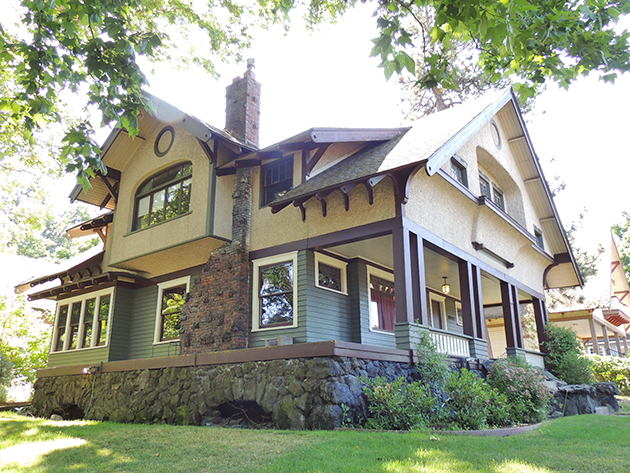
PhotoTitle: Colonel William Abercrombie House
PhotoAttribution: Spokane City/County Historic Preservation Office
Listing Status: Spokane Register
URL: http://properties.historicspokane.org/property/?PropertyID=1713
Display Marker: large_yellow
Title: Abercrombie House
Description: Date Built: 1906
Architect: Aaron L. Lundquist
Common Name: Colonel William Abercrombie House
Built on Spokane's South Hill, the Abercrombie House is significant for its association with the early military history of Spokane. Arriving in Spokane in the summer of 1877, Colonel William R. Abercrombie was the first U.S. military leader brought to Spokane to make way for American expansion. After receiving assignments to various military outposts Colonel William R. Abercrombie and his wife, Lillian Kimball Abercrombie, made the home their first permanent Spokane residence and lived in it from 1908 until their deaths. Colonel Abercrombie was an active leader in the Indian wars and was named commander of Fort George Wright in 1910.
Location: 47.6443, -117.43193
Address: 1203 South Cedar Street, Spokane, WA 99204
PhotoURL:

PhotoTitle: Colonel William Abercrombie House
PhotoAttribution: Spokane City/County Historic Preservation Office
Listing Status: Spokane Register
URL: http://properties.historicspokane.org/property/?PropertyID=1713
Display Marker: large_yellow
ID: 2
Title: Ackermann House
Description: Date Built: 1912
Architect: Earl Wilson Morrison
Common Name: O. M. Lilliequist House
The Ackermann House was completed in early 1912 and is an outstanding authentic example of Prairie School architecture by a young designer who, at the time, was an architectural student in Chicago. Horizontal lines, established by the layered hipped roofs, dominate the exterior and the pervasive use of stucco gives a monolithic, sculptural look to the house. The home was one of the earliest, most expensive and prestigious houses surrounding the southern focus of Rockwood Boulevard. Originally built as a speculative, high-end residential investment by Olof Malmberg Lilliequist, the home was purchased by David Ackermann, a local banker, and his wife, Edith, shortly after its completion.
Location: 47.63607, -117.39924
Address: 2020 South Rockwood Boulevard, Spokane, WA 99203
PhotoURL: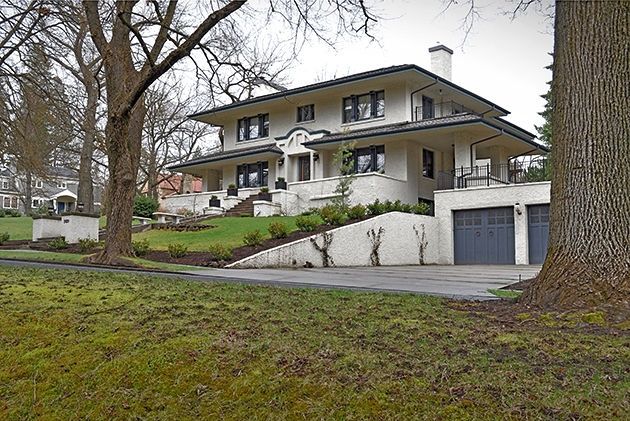
PhotoTitle: David and Edith Ackermann House
PhotoAttribution: Spokane City/County Historic Preservation Office
Listing Status: Spokane Register, National Register
URL: http://properties.historicspokane.org/property/?PropertyID=2044
Display Marker: large_yellow
Title: Ackermann House
Description: Date Built: 1912
Architect: Earl Wilson Morrison
Common Name: O. M. Lilliequist House
The Ackermann House was completed in early 1912 and is an outstanding authentic example of Prairie School architecture by a young designer who, at the time, was an architectural student in Chicago. Horizontal lines, established by the layered hipped roofs, dominate the exterior and the pervasive use of stucco gives a monolithic, sculptural look to the house. The home was one of the earliest, most expensive and prestigious houses surrounding the southern focus of Rockwood Boulevard. Originally built as a speculative, high-end residential investment by Olof Malmberg Lilliequist, the home was purchased by David Ackermann, a local banker, and his wife, Edith, shortly after its completion.
Location: 47.63607, -117.39924
Address: 2020 South Rockwood Boulevard, Spokane, WA 99203
PhotoURL:

PhotoTitle: David and Edith Ackermann House
PhotoAttribution: Spokane City/County Historic Preservation Office
Listing Status: Spokane Register, National Register
URL: http://properties.historicspokane.org/property/?PropertyID=2044
Display Marker: large_yellow
ID: 3
Title: Albert Apartments
Description: Date Built: 1903
Architect: Charles R. Wood
Common Name: Kensington Court
The Albert Apartments is an excellent example of early 20th-century apartment house construction and is one of only two remaining apartment buildings of the 15 apartment buildings that were once located in Saunder's Addition in east central Spokane during the early 1900s. The facade design of the Albert Apartments is a fine example of the Colonial Revival style while the interior of the building--remodeled in 1931 by noted Spokane architect Charles R. Wood--reveals Craftsman-style influence. The Albert Apartments was named after Albert Commellini, one of Spokane's most colorful businessmen and noted leaders of the city's Italian community. The building is architecturally as well as historically significant for its association with the development of early Spokane and for its role as one of the best remaining representations of the life of Albert Commellini.
Location: 47.65532, -117.41007
Address: 152 South Pine Street, Spokane, WA 99202
PhotoURL: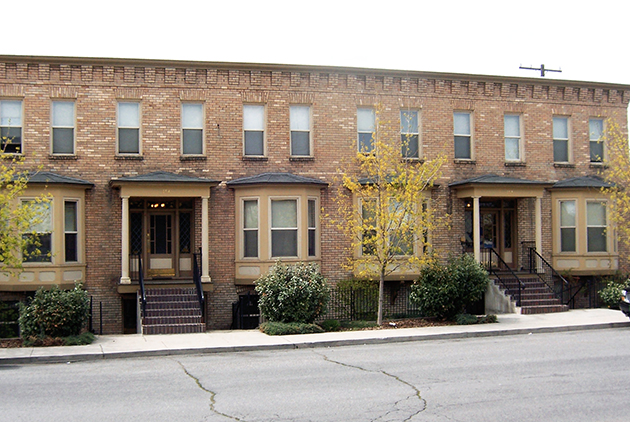
PhotoTitle: The Albert Apartments
PhotoAttribution: Spokane City/County Historic Preservation Office
Listing Status: Spokane Register
URL: http://properties.historicspokane.org/property/?PropertyID=1714
Display Marker: large_yellow
Title: Albert Apartments
Description: Date Built: 1903
Architect: Charles R. Wood
Common Name: Kensington Court
The Albert Apartments is an excellent example of early 20th-century apartment house construction and is one of only two remaining apartment buildings of the 15 apartment buildings that were once located in Saunder's Addition in east central Spokane during the early 1900s. The facade design of the Albert Apartments is a fine example of the Colonial Revival style while the interior of the building--remodeled in 1931 by noted Spokane architect Charles R. Wood--reveals Craftsman-style influence. The Albert Apartments was named after Albert Commellini, one of Spokane's most colorful businessmen and noted leaders of the city's Italian community. The building is architecturally as well as historically significant for its association with the development of early Spokane and for its role as one of the best remaining representations of the life of Albert Commellini.
Location: 47.65532, -117.41007
Address: 152 South Pine Street, Spokane, WA 99202
PhotoURL:

PhotoTitle: The Albert Apartments
PhotoAttribution: Spokane City/County Historic Preservation Office
Listing Status: Spokane Register
URL: http://properties.historicspokane.org/property/?PropertyID=1714
Display Marker: large_yellow
ID: 4
Title: Albi House
Description: Date Built: 1913
Architect: Walter L. Weld
Common Name: Joseph & Mazie Albi House
The Joseph Albi House is a fine example of a Craftsman style bungalow. Built by Spokane contractor Walter L. Weld as a "spec" home, the property was given to Joseph Albi and his wife Mazie as a wedding gift from Albi's parents. During the 43 years that Joseph Albi lived in the house, he became one of Spokane's most well-known and influential leaders. He was a successful attorney and businessman, philanthropist and civic benefactor, and an indomitable fund-raiser and sports-supporter. Implementing his ideas for the promotion of sports in Spokane, Albi helped found the Spokane Athletic Round Table and served as its president for 42 years. Backed by the organization, Albi spearheaded the fundraising, construction, and creation of the Esmeralda Golf Course and Clubhouse, and the Joe Albi Stadium in Spokane--public facilities that continue to be enjoyed by thousands of people in the Spokane community year after year. In addition, Albi was appointed to act as the Italian Consulate for Idaho and Eastern Washington from 1929 to 1941. A Spokesman-Review article on May 9, 1962 summed up Joe Albi's contributions to Spokane saying: He did more for Spokane and the Inland Empire sports world than any other man, ever.
Location: 47.64446, -117.40303
Address: 525 East 12th Avenue, Spokane, WA 99202
PhotoURL: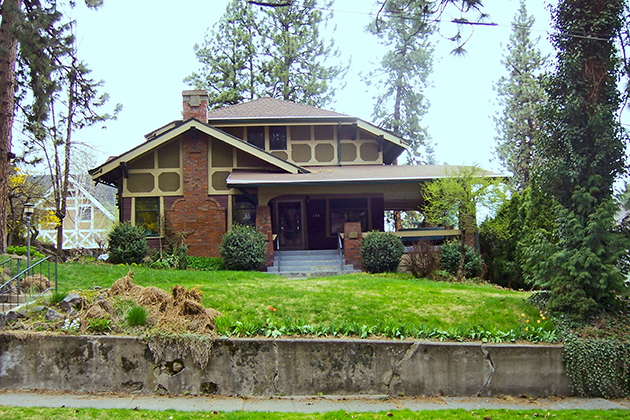
PhotoTitle: Joseph and Mazie Albi House
PhotoAttribution: Spokane City/County Historic Preservation Office
Listing Status: Spokane Register, National Register
URL: http://properties.historicspokane.org/property/?PropertyID=1715
Display Marker: large_yellow
Title: Albi House
Description: Date Built: 1913
Architect: Walter L. Weld
Common Name: Joseph & Mazie Albi House
The Joseph Albi House is a fine example of a Craftsman style bungalow. Built by Spokane contractor Walter L. Weld as a "spec" home, the property was given to Joseph Albi and his wife Mazie as a wedding gift from Albi's parents. During the 43 years that Joseph Albi lived in the house, he became one of Spokane's most well-known and influential leaders. He was a successful attorney and businessman, philanthropist and civic benefactor, and an indomitable fund-raiser and sports-supporter. Implementing his ideas for the promotion of sports in Spokane, Albi helped found the Spokane Athletic Round Table and served as its president for 42 years. Backed by the organization, Albi spearheaded the fundraising, construction, and creation of the Esmeralda Golf Course and Clubhouse, and the Joe Albi Stadium in Spokane--public facilities that continue to be enjoyed by thousands of people in the Spokane community year after year. In addition, Albi was appointed to act as the Italian Consulate for Idaho and Eastern Washington from 1929 to 1941. A Spokesman-Review article on May 9, 1962 summed up Joe Albi's contributions to Spokane saying: He did more for Spokane and the Inland Empire sports world than any other man, ever.
Location: 47.64446, -117.40303
Address: 525 East 12th Avenue, Spokane, WA 99202
PhotoURL:

PhotoTitle: Joseph and Mazie Albi House
PhotoAttribution: Spokane City/County Historic Preservation Office
Listing Status: Spokane Register, National Register
URL: http://properties.historicspokane.org/property/?PropertyID=1715
Display Marker: large_yellow
ID: 5
Title: Alger-Bristol Hotel
Description: Date Built: 1904
Architect: Unknown
Common Name: Alger-Bristol Hotel
The Alger-Bristol Hotel is a typical example of the property type "single room occupancy hotel." The three-story building is a rectangular box constructed of eighteen-inch-thick unreinforced brick masonry walls. It has a flat roof of built-up tar, a metal-capped brick parapet wall, and a basalt rock foundation. Symmetrically balanced exterior fenestration patterns located above street-level, a central light well, interior room configurations, and a separate door that opens to upper-story hotel rooms from the street embody features of the property type and convey the building's original use as an SRO.
Location: 47.65747, -117.41367
Address: 210 West Sprague Avenue, Spokane, WA 99201
PhotoURL: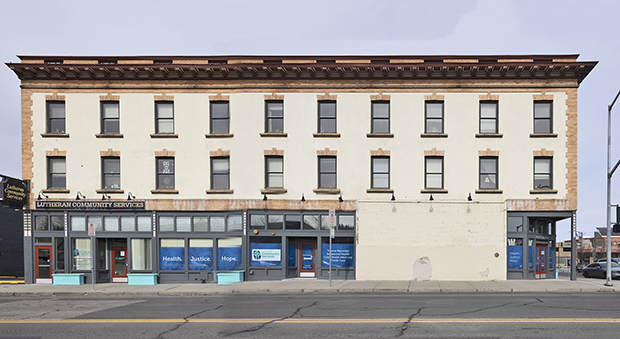
PhotoTitle: The Alger-Bristol Hotel
PhotoAttribution: Spokane City/County Historic Preservation Office
Listing Status: Spokane Register
URL: http://properties.historicspokane.org/property/?PropertyID=1716
Display Marker: large_yellow
Title: Alger-Bristol Hotel
Description: Date Built: 1904
Architect: Unknown
Common Name: Alger-Bristol Hotel
The Alger-Bristol Hotel is a typical example of the property type "single room occupancy hotel." The three-story building is a rectangular box constructed of eighteen-inch-thick unreinforced brick masonry walls. It has a flat roof of built-up tar, a metal-capped brick parapet wall, and a basalt rock foundation. Symmetrically balanced exterior fenestration patterns located above street-level, a central light well, interior room configurations, and a separate door that opens to upper-story hotel rooms from the street embody features of the property type and convey the building's original use as an SRO.
Location: 47.65747, -117.41367
Address: 210 West Sprague Avenue, Spokane, WA 99201
PhotoURL:

PhotoTitle: The Alger-Bristol Hotel
PhotoAttribution: Spokane City/County Historic Preservation Office
Listing Status: Spokane Register
URL: http://properties.historicspokane.org/property/?PropertyID=1716
Display Marker: large_yellow
ID: 6
Title: Alvis House
Description: Date Built: 1913
Builders: Franklin Manz, John Thomas and M. Endres Common Name: Harry and Dorothy Alvis House
The Alvis House is a fine example of the Arts & Crafts tradition with influences from the Craftsman, Prairie, and Swiss Chalet styles. It was erected as a "spec" house by a group of investors and builders who sold it one year after construction to Harry Alvis, an automobile salesman in Spokane, and his wife, Dorothy. LeRoy & Beta Beeson, owners/proprietors of Beeson Brothers automobile sales/service in Spokane, resided in the house for 13 years, and Marion & Robert Root, a Pacific Mutual Life Insurance agent and agency owner, lived at the property for 58 years. During its period of significance from 1913 to 1956, the Alvis House achieved importance in the areas of architecture and community planning & development. The property is architecturally significant as a fine depiction of the Arts & Crafts tradition and as a product of Spokane architect, Franklin Manz, and for its association with trends and patterns which led to the urban development and subsequent settlement of the Cannon Hill Park Addition on Spokane's South Hill.
Location: 47.63575, -117.41868
Address: 448 West 21st Avenue, Spokane, WA 99203
PhotoURL: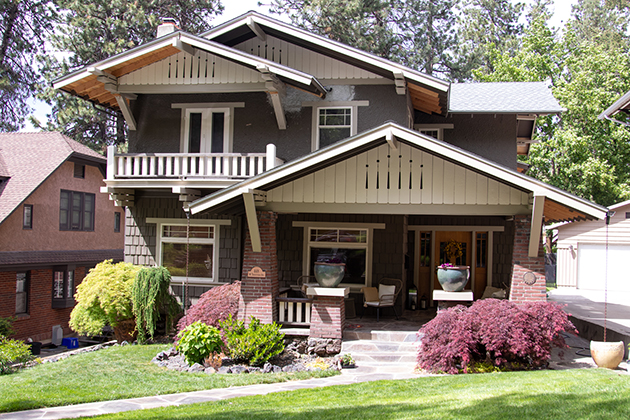
PhotoTitle: Harry and Dorothy Alvis House
PhotoAttribution: Spokane City/County Historic Preservation Office
Listing Status: Spokane Register
URL: http://properties.historicspokane.org/property/?PropertyID=1717
Display Marker: large_yellow
Title: Alvis House
Description: Date Built: 1913
Builders: Franklin Manz, John Thomas and M. Endres Common Name: Harry and Dorothy Alvis House
The Alvis House is a fine example of the Arts & Crafts tradition with influences from the Craftsman, Prairie, and Swiss Chalet styles. It was erected as a "spec" house by a group of investors and builders who sold it one year after construction to Harry Alvis, an automobile salesman in Spokane, and his wife, Dorothy. LeRoy & Beta Beeson, owners/proprietors of Beeson Brothers automobile sales/service in Spokane, resided in the house for 13 years, and Marion & Robert Root, a Pacific Mutual Life Insurance agent and agency owner, lived at the property for 58 years. During its period of significance from 1913 to 1956, the Alvis House achieved importance in the areas of architecture and community planning & development. The property is architecturally significant as a fine depiction of the Arts & Crafts tradition and as a product of Spokane architect, Franklin Manz, and for its association with trends and patterns which led to the urban development and subsequent settlement of the Cannon Hill Park Addition on Spokane's South Hill.
Location: 47.63575, -117.41868
Address: 448 West 21st Avenue, Spokane, WA 99203
PhotoURL:

PhotoTitle: Harry and Dorothy Alvis House
PhotoAttribution: Spokane City/County Historic Preservation Office
Listing Status: Spokane Register
URL: http://properties.historicspokane.org/property/?PropertyID=1717
Display Marker: large_yellow
ID: 7
Title: American Firebrick Company
Description: Date Built: 1902
Architect: Charles P. Oudin (founder)
Common Name: Interpace Corporation Mica Brickyard
Responding to the building boom and need for brick throughout the Spokane area after the devastating fire of 1889, brickyards were established in a number of locations. However, most of these yards did not last for more than a decade and the American Firebrick Company brickyard at Mica is the only remaining yard from the time. Much of the brick used in the buildings of Spokane, both now and in the past, was fired in the kilns at Mica. The brickyard was also responsible for the development of the Mica community and continues to function as a key economic contributor in the area. The beehive kilns are among the few remaining in the country that date back to the turn of the century. The unique architectural design of these kilns provides a rare glimpse of early industrial technology.
Location: 47.559344, -117.211243
Address: 10627 South Highway 27, Mica WA 99036
PhotoURL: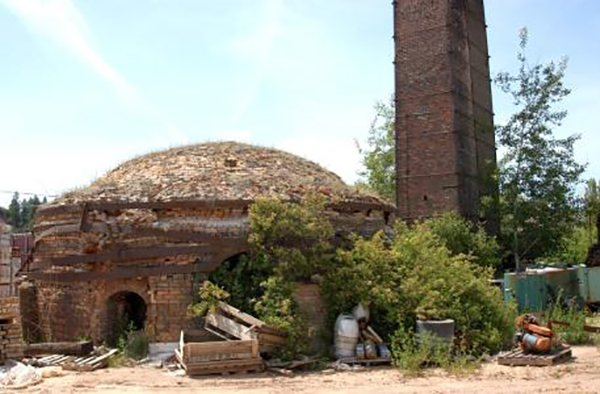
PhotoTitle: Beehive kiln of the American Firebrick Company
PhotoAttribution: Spokane City/County Historic Preservation Office
Listing Status: National Register
URL: http://properties.historicspokane.org/property/?PropertyID=1981
Display Marker: large_yellow
Title: American Firebrick Company
Description: Date Built: 1902
Architect: Charles P. Oudin (founder)
Common Name: Interpace Corporation Mica Brickyard
Responding to the building boom and need for brick throughout the Spokane area after the devastating fire of 1889, brickyards were established in a number of locations. However, most of these yards did not last for more than a decade and the American Firebrick Company brickyard at Mica is the only remaining yard from the time. Much of the brick used in the buildings of Spokane, both now and in the past, was fired in the kilns at Mica. The brickyard was also responsible for the development of the Mica community and continues to function as a key economic contributor in the area. The beehive kilns are among the few remaining in the country that date back to the turn of the century. The unique architectural design of these kilns provides a rare glimpse of early industrial technology.
Location: 47.559344, -117.211243
Address: 10627 South Highway 27, Mica WA 99036
PhotoURL:

PhotoTitle: Beehive kiln of the American Firebrick Company
PhotoAttribution: Spokane City/County Historic Preservation Office
Listing Status: National Register
URL: http://properties.historicspokane.org/property/?PropertyID=1981
Display Marker: large_yellow
ID: 8
Title: Legion Building
Description: Date Built: 1901
Architect: John K. Dow
Common Name: Metals Building
Located in Spokane's central business district, the Legion Building is a fine example of the commercial Renaissance Revival style. The five-story masonry block was built by businessman, mining tycoon and yachtsman, F. Lewis Clark, to house the Spokane Club. The building itself is a manifestation of the wealth generated in this area at the turn of the century. Clark's intent in hiring John K. Dow as architect was to build and furnish one of the finest club quarters on the west coast. Clad in Minnesota sandstone, blonde pressed brick veneer, creme-colored terra cotta embellishment and possessing a unique inset loggia with Corinthian capitals, Clark's vision certainly came true. Unfortunately for Spokane, Mr. Clark mysteriously disappeared in Santa Barbara on the night of January 16th, 1914. Only his hat was found in the surf the following day.
Location: 47.65829, -117.41775
Address: 108 North Washington Street, Spokane WA 99201
PhotoURL: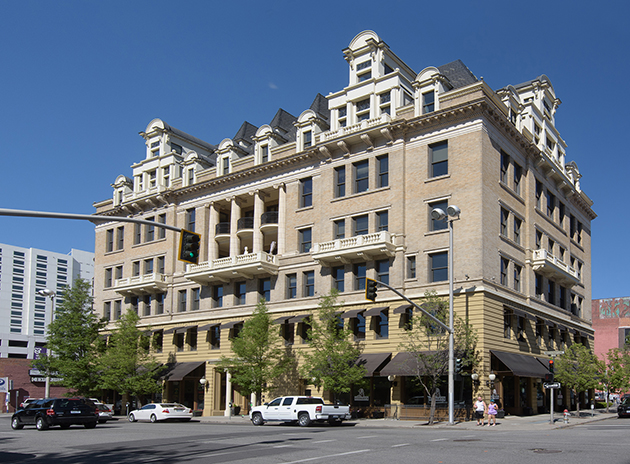
PhotoTitle: The Legion Building
PhotoAttribution: Spokane City/County Historic Preservation Office
Listing Status: Spokane Register, National Register
URL: http://properties.historicspokane.org/property/?PropertyID=1718
Display Marker: large_yellow
Title: Legion Building
Description: Date Built: 1901
Architect: John K. Dow
Common Name: Metals Building
Located in Spokane's central business district, the Legion Building is a fine example of the commercial Renaissance Revival style. The five-story masonry block was built by businessman, mining tycoon and yachtsman, F. Lewis Clark, to house the Spokane Club. The building itself is a manifestation of the wealth generated in this area at the turn of the century. Clark's intent in hiring John K. Dow as architect was to build and furnish one of the finest club quarters on the west coast. Clad in Minnesota sandstone, blonde pressed brick veneer, creme-colored terra cotta embellishment and possessing a unique inset loggia with Corinthian capitals, Clark's vision certainly came true. Unfortunately for Spokane, Mr. Clark mysteriously disappeared in Santa Barbara on the night of January 16th, 1914. Only his hat was found in the surf the following day.
Location: 47.65829, -117.41775
Address: 108 North Washington Street, Spokane WA 99201
PhotoURL:

PhotoTitle: The Legion Building
PhotoAttribution: Spokane City/County Historic Preservation Office
Listing Status: Spokane Register, National Register
URL: http://properties.historicspokane.org/property/?PropertyID=1718
Display Marker: large_yellow
ID: 9
Title: Amman Apartments
Description: Date Built: 1904
Architect: Albert Held
Common Name: Amman Apartments
While the Ammann is not as elaborate as the other apartment buildings designed by architect Albert Held (Breslin, Knickerbocker, San Marco), it was one of the first and is clearly representative of the architect's style. Held's apartment buildings are listed on the National Register collectively in a multiple property nomination. Handsome in its simplicity, the Amman is located along historic Riverside Avenue, one of the first areas where apartments were built in Spokane. The building is well-maintained and is presently used as an office building.
Location: 47.65691, -117.43472
Address: 1516 West Riverside Avenue, Spokane WA 99201
PhotoURL:
PhotoTitle: The Amman Apartments
PhotoAttribution: Spokane City/County Historic Preservation Office
Listing Status: National Register
URL: http://properties.historicspokane.org/property/?PropertyID=1982
Display Marker: large_yellow
Title: Amman Apartments
Description: Date Built: 1904
Architect: Albert Held
Common Name: Amman Apartments
While the Ammann is not as elaborate as the other apartment buildings designed by architect Albert Held (Breslin, Knickerbocker, San Marco), it was one of the first and is clearly representative of the architect's style. Held's apartment buildings are listed on the National Register collectively in a multiple property nomination. Handsome in its simplicity, the Amman is located along historic Riverside Avenue, one of the first areas where apartments were built in Spokane. The building is well-maintained and is presently used as an office building.
Location: 47.65691, -117.43472
Address: 1516 West Riverside Avenue, Spokane WA 99201
PhotoURL:

PhotoTitle: The Amman Apartments
PhotoAttribution: Spokane City/County Historic Preservation Office
Listing Status: National Register
URL: http://properties.historicspokane.org/property/?PropertyID=1982
Display Marker: large_yellow
ID: 10
Title: Anderson-Webster House
Description: Date Built: 1912
Architect: Ballard Plannary Company
Common Name: Anderson-Webster House
The Anderson-Webster House & Garage together reflect one of the finest and best-preserved examples of the Arts & Crafts tradition rendered in the Craftsman style on Spokane's South Hill. The property was listed on the National Register of Historic Places in 1978 as a contributing resource of the Marycliff-Cliff Park National Register Historic District. The home's Craftsman style features widely overhanging eaves, exposed scroll-sawn rafter tails, and robust use of false half-timbering with coarse-grained stucco infill, heavily textured cobbled clinker brick, and black basalt rock. The Anderson-Webster House achieved importance as an especially excellent example of the Craftsman style, as a product of the Ballard Plannary Company, as the home of Judge J. Stanley Webster, and for its association with the trends and patterns of urban residential development that led to the subsequent settlement of the Cliff Park neighborhood in the Marycliff-Cliff Park National Register Historic District.
Location: 47.64444, -117.42163
Address: 1217 South Wall Street, Spokane WA 99204
PhotoURL: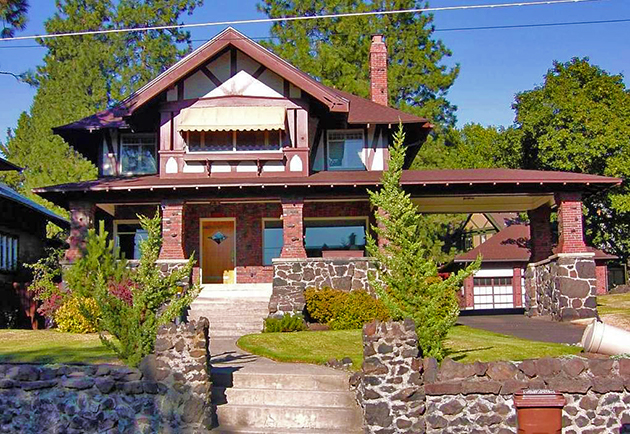
PhotoTitle: Anderson-Webster House
PhotoAttribution: Spokane City/County Historic Preservation Office
Listing Status: Spokane Register, National Register
URL: http://properties.historicspokane.org/property/?PropertyID=1719
Display Marker: large_yellow
Title: Anderson-Webster House
Description: Date Built: 1912
Architect: Ballard Plannary Company
Common Name: Anderson-Webster House
The Anderson-Webster House & Garage together reflect one of the finest and best-preserved examples of the Arts & Crafts tradition rendered in the Craftsman style on Spokane's South Hill. The property was listed on the National Register of Historic Places in 1978 as a contributing resource of the Marycliff-Cliff Park National Register Historic District. The home's Craftsman style features widely overhanging eaves, exposed scroll-sawn rafter tails, and robust use of false half-timbering with coarse-grained stucco infill, heavily textured cobbled clinker brick, and black basalt rock. The Anderson-Webster House achieved importance as an especially excellent example of the Craftsman style, as a product of the Ballard Plannary Company, as the home of Judge J. Stanley Webster, and for its association with the trends and patterns of urban residential development that led to the subsequent settlement of the Cliff Park neighborhood in the Marycliff-Cliff Park National Register Historic District.
Location: 47.64444, -117.42163
Address: 1217 South Wall Street, Spokane WA 99204
PhotoURL:

PhotoTitle: Anderson-Webster House
PhotoAttribution: Spokane City/County Historic Preservation Office
Listing Status: Spokane Register, National Register
URL: http://properties.historicspokane.org/property/?PropertyID=1719
Display Marker: large_yellow
ID: 11
Title: Andreasen House
Description: Date Built: 1927
Architect: Edward Hokanson
Common Name: Ove & Mary Andreasen House
Listed in 1997 as a contributing property in the Rockwood National Register Historic District, the Ove & Mary Andreasen House is an exemplary rendition of the Colonial Revival style with Georgian influence. The home was built on speculation in 1927 by Spokane contractor, Edward Hokanson, and was later purchased by Ove Andreasen, an investment entrepreneur, and his wife, Mary Hughes Andreasen, who together spent more than $10,000 on the property. Defining features of the Colonial Revival style include the home's two-story form, formal massing, side gable roof, prominent cornice and cornice returns, red brick veneer cladding, recessed front entrance, curved pediment entry hood, wood-shuttered multi-paned windows, and symmetrical design with symmetrical fenestration patterns. With remarkably few modifications, the Andreasen House is well-preserved with excellent exterior and interior architectural integrity in original location, design, materials, workmanship, and association as a single-family residence built in the early 1920s in Spokane, Washington.
Location: 47.64204, -117.40024
Address: 709 East Rockwood Boulevard, Spokane WA 99203
PhotoURL: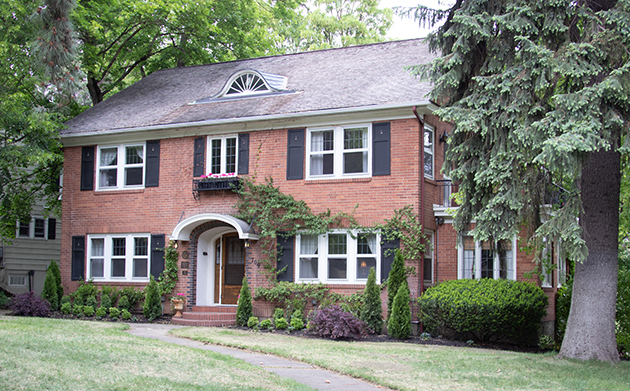
PhotoTitle: Ove and Mary Andreasen House
PhotoAttribution: Spokane City/County Historic Preservation Office
Listing Status: Spokane Register, National Register
URL: http://proper\ties.historicspokane.org/property/?PropertyID=1720
Display Marker: large_yellow
Title: Andreasen House
Description: Date Built: 1927
Architect: Edward Hokanson
Common Name: Ove & Mary Andreasen House
Listed in 1997 as a contributing property in the Rockwood National Register Historic District, the Ove & Mary Andreasen House is an exemplary rendition of the Colonial Revival style with Georgian influence. The home was built on speculation in 1927 by Spokane contractor, Edward Hokanson, and was later purchased by Ove Andreasen, an investment entrepreneur, and his wife, Mary Hughes Andreasen, who together spent more than $10,000 on the property. Defining features of the Colonial Revival style include the home's two-story form, formal massing, side gable roof, prominent cornice and cornice returns, red brick veneer cladding, recessed front entrance, curved pediment entry hood, wood-shuttered multi-paned windows, and symmetrical design with symmetrical fenestration patterns. With remarkably few modifications, the Andreasen House is well-preserved with excellent exterior and interior architectural integrity in original location, design, materials, workmanship, and association as a single-family residence built in the early 1920s in Spokane, Washington.
Location: 47.64204, -117.40024
Address: 709 East Rockwood Boulevard, Spokane WA 99203
PhotoURL:

PhotoTitle: Ove and Mary Andreasen House
PhotoAttribution: Spokane City/County Historic Preservation Office
Listing Status: Spokane Register, National Register
URL: http://proper\ties.historicspokane.org/property/?PropertyID=1720
Display Marker: large_yellow
ID: 12
Title: Armstrong House
Description: Date Built: 1910
Architect: Albert Held
Common Name: Major James Melville Armstrong House Located within the National Register Ninth Avenue Historic District, the majestic Armstrong House serves as a welcoming gateway to the area, and stands on the street for which the district is named. With its massive, prominent portico rising the full two-and-one-half stories of the house and supported by marble-white Ionic columns, the Armstrong House at 1022 West Ninth Avenue represents one of the best-preserved and finest examples of Neoclassical style architecture rarely found in Spokane. Built in 1910 for Lida B. and Major James Melville Armstrong, a Civil War veteran who lost his leg in the battle of Atlanta and an early Spokane entrepreneur, the house glistens a classic pristine-white against its red roof, red brick foundation, and the deep green trees and shrubs that envelope it. The 6000-square foot house sits squarely on three, large, tree-lined lots, and boasts a circular drive, a porte-cochere, and a 1910 outbuilding that once served as a carriage house.
Location: 47.64757, -117.42749
Address: 1022 West 9th Avenue, Spokane WA 99204
PhotoURL: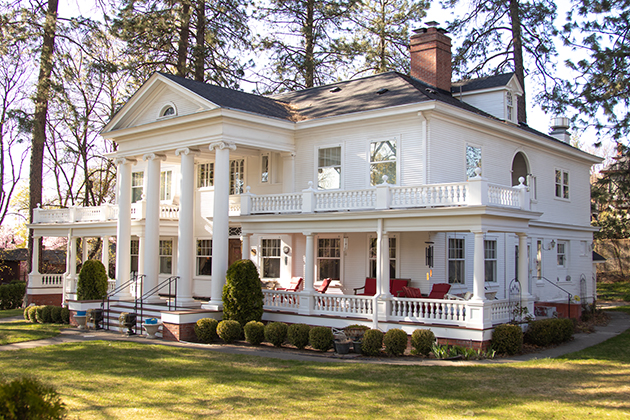
PhotoTitle: Major James Melville Armstrong House
PhotoAttribution: Spokane City/County Historic Preservation Office
Listing Status: Spokane Register, National Register
URL: http://properties.historicspokane.org/property/?PropertyID=1721
Display Marker: large_yellow
Title: Armstrong House
Description: Date Built: 1910
Architect: Albert Held
Common Name: Major James Melville Armstrong House Located within the National Register Ninth Avenue Historic District, the majestic Armstrong House serves as a welcoming gateway to the area, and stands on the street for which the district is named. With its massive, prominent portico rising the full two-and-one-half stories of the house and supported by marble-white Ionic columns, the Armstrong House at 1022 West Ninth Avenue represents one of the best-preserved and finest examples of Neoclassical style architecture rarely found in Spokane. Built in 1910 for Lida B. and Major James Melville Armstrong, a Civil War veteran who lost his leg in the battle of Atlanta and an early Spokane entrepreneur, the house glistens a classic pristine-white against its red roof, red brick foundation, and the deep green trees and shrubs that envelope it. The 6000-square foot house sits squarely on three, large, tree-lined lots, and boasts a circular drive, a porte-cochere, and a 1910 outbuilding that once served as a carriage house.
Location: 47.64757, -117.42749
Address: 1022 West 9th Avenue, Spokane WA 99204
PhotoURL:

PhotoTitle: Major James Melville Armstrong House
PhotoAttribution: Spokane City/County Historic Preservation Office
Listing Status: Spokane Register, National Register
URL: http://properties.historicspokane.org/property/?PropertyID=1721
Display Marker: large_yellow
ID: 13
Title: Avenida Apartments
Description: Date Built: 1909
Architect: W. W. Hyslop
Common Name: Avenida Apartments
W. W. Hyslop, prominent Spokane architect, designed this apartment building for paint store owner, Isaac Baum, who lived nearby at 1830 West Pacific Avenue in Browne's Addition. The large, three-story brick building possesses Classical Revival elements and was was initially designed with 14 units. Still operating as a multi-family residence, the Avenida Apartments was one of the first luxury apartment houses built in Browne's Addition during the 1900s. W. W. Hyslop also designed the Marlboro Apartments, Westminster Apartments and the Elm Apartments
Location: 47.65523, -117.4421
Address: 2009 West Pacific Avenue, Spokane WA 99201
PhotoURL:
PhotoTitle: The Avenida Apartments
PhotoAttribution: Spokane City/County Historic Preservation Office
Listing Status: Spokane Register, National Register
URL: http://properties.historicspokane.org/property/?PropertyID=1722
Display Marker: large_yellow
Title: Avenida Apartments
Description: Date Built: 1909
Architect: W. W. Hyslop
Common Name: Avenida Apartments
W. W. Hyslop, prominent Spokane architect, designed this apartment building for paint store owner, Isaac Baum, who lived nearby at 1830 West Pacific Avenue in Browne's Addition. The large, three-story brick building possesses Classical Revival elements and was was initially designed with 14 units. Still operating as a multi-family residence, the Avenida Apartments was one of the first luxury apartment houses built in Browne's Addition during the 1900s. W. W. Hyslop also designed the Marlboro Apartments, Westminster Apartments and the Elm Apartments
Location: 47.65523, -117.4421
Address: 2009 West Pacific Avenue, Spokane WA 99201
PhotoURL:

PhotoTitle: The Avenida Apartments
PhotoAttribution: Spokane City/County Historic Preservation Office
Listing Status: Spokane Register, National Register
URL: http://properties.historicspokane.org/property/?PropertyID=1722
Display Marker: large_yellow
ID: 14
Title: Avondale Court Apartments
Description: Date Built: 1905
Architect: Peter Anderson
Common Name: Avondale Court Apartments
Avondale Court was built in several stages in a residential/commercial sector of Spokane's central business distric starting in1905, and is historically significant for its association with the dramatic growth that Spokane experienced during the first decade of the 20th century. Unfortunately for the owners, a mill workers' strike in 1903 delayed construction and it took another two years to complete. Meanwhile, demand for housing in Spokane skyrocketed, as population swelled from 36,848 to 104,402 between 1900 and 1910. The Spokesman-Review reported on December 19, 1903: "Spokane leads the nation in percentage of residential building construction."
Location: 47.65429, -117.41621
Address: 229 West 2nd Avenue, Spokane WA 99201
PhotoURL: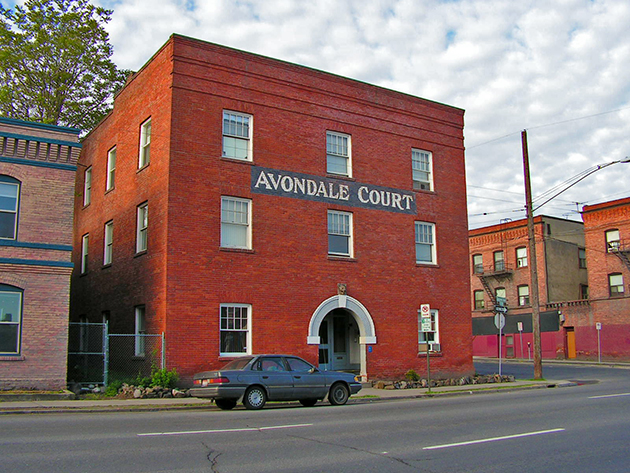
PhotoTitle: The Avondale Court Apartments
PhotoAttribution: Spokane City/County Historic Preservation Office
Listing Status: Spokane Register
URL: http://properties.historicspokane.org/property/?PropertyID=1723
Display Marker: large_yellow
Title: Avondale Court Apartments
Description: Date Built: 1905
Architect: Peter Anderson
Common Name: Avondale Court Apartments
Avondale Court was built in several stages in a residential/commercial sector of Spokane's central business distric starting in1905, and is historically significant for its association with the dramatic growth that Spokane experienced during the first decade of the 20th century. Unfortunately for the owners, a mill workers' strike in 1903 delayed construction and it took another two years to complete. Meanwhile, demand for housing in Spokane skyrocketed, as population swelled from 36,848 to 104,402 between 1900 and 1910. The Spokesman-Review reported on December 19, 1903: "Spokane leads the nation in percentage of residential building construction."
Location: 47.65429, -117.41621
Address: 229 West 2nd Avenue, Spokane WA 99201
PhotoURL:

PhotoTitle: The Avondale Court Apartments
PhotoAttribution: Spokane City/County Historic Preservation Office
Listing Status: Spokane Register
URL: http://properties.historicspokane.org/property/?PropertyID=1723
Display Marker: large_yellow
ID: 15
Title: Balkan Hotel
Description: Date Built: 1909
Architect: C. E. Wentzel
Common Name: Balkan Hotel
The Balkan Hotel is historically significant as a Single Room Occupancy Hotel, a particularly popular type of housing during the economic boom that fueled Spokane's explosive population growth in the first decade of the century. Single Room Occupancy Hotels like the Balkan, built in 1909, provided working class housing for the large numbers of itinerant laborers that flocked to Spokane to take advantage of expanding opportunities associated with the city's emergence as a regional transportation hub. The east downtown neighborhood where this SRO was located became an enclave for immigrants arriving in Spokane from the Balkan Peninsula, as the hotel's name suggests. Together with the Balkan Serbian Benevolent Society, located two blocks west, the Balkan Hotel served as a focal point for the neighborhood's Balkan immigrant community.
Location: 47.65875, -117.41254
Address: 31 West Main Avenue, Spokane WA 99201
PhotoURL: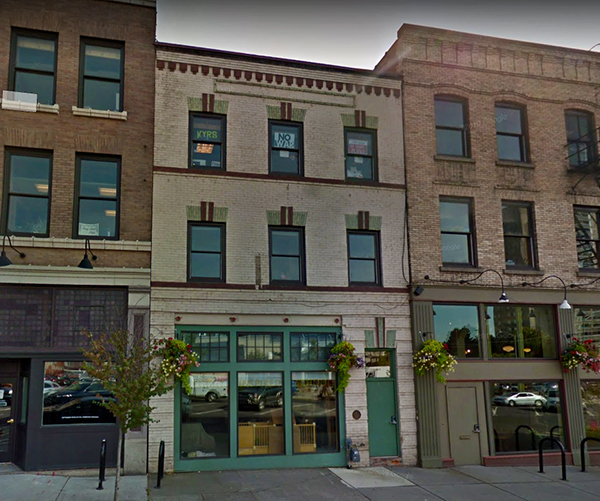
PhotoTitle: The Balkan Hotel
PhotoAttribution: Spokane City/County Historic Preservation Office
Listing Status: Spokane Register, National Register
URL: http://properties.historicspokane.org/property/?PropertyID=1724
Display Marker: large_yellow
Title: Balkan Hotel
Description: Date Built: 1909
Architect: C. E. Wentzel
Common Name: Balkan Hotel
The Balkan Hotel is historically significant as a Single Room Occupancy Hotel, a particularly popular type of housing during the economic boom that fueled Spokane's explosive population growth in the first decade of the century. Single Room Occupancy Hotels like the Balkan, built in 1909, provided working class housing for the large numbers of itinerant laborers that flocked to Spokane to take advantage of expanding opportunities associated with the city's emergence as a regional transportation hub. The east downtown neighborhood where this SRO was located became an enclave for immigrants arriving in Spokane from the Balkan Peninsula, as the hotel's name suggests. Together with the Balkan Serbian Benevolent Society, located two blocks west, the Balkan Hotel served as a focal point for the neighborhood's Balkan immigrant community.
Location: 47.65875, -117.41254
Address: 31 West Main Avenue, Spokane WA 99201
PhotoURL:

PhotoTitle: The Balkan Hotel
PhotoAttribution: Spokane City/County Historic Preservation Office
Listing Status: Spokane Register, National Register
URL: http://properties.historicspokane.org/property/?PropertyID=1724
Display Marker: large_yellow
ID: 16
Title: Barnett House
Description: Date Built: 1903
Architect: Arthur E. Saunders
Common Name: Alonzo & Louise Barnett House
The Alonzo and Louise Barnett House is an excellent example of the Free Classic Queen Anne style and is the only dwelling in the Mountain View Addition that features a combination of brick and frame construction, a round turret, and a wrap-around porch. In addition, the Barnett House is remarkably intact, conveying building techniques, materials and designs popularized by the Queen Anne style better than most homes in the neighborhood. Designed by Spokane architect Arthur E. Saunders, the house was featured in a Spokesman-Review newspaper article dated October 29, 1905 that explained the home's state-of-the-art design, lauding it as modern American architecture built of buff pressed brick with two-inch air spaces in the walls. The house was built for Louise and Alonzo Barnett, owners of the Spokane-based A. A. Barnett Company, a business that specialized in loans and real estate investments. The Barnetts lived there from 1903 to 1922.
Location: 47.67338, -117.42542
Address: 902 West Augusta Avenue, Spokane WA 99205
PhotoURL: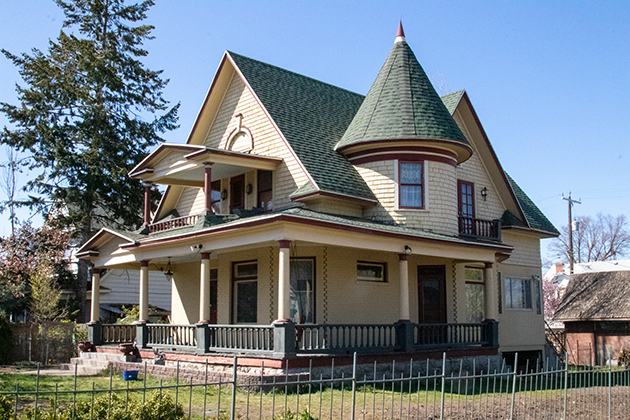
PhotoTitle: Alonzo and Louise Barnett House
PhotoAttribution: Spokane City/County Historic Preservation Office
Listing Status: Spokane Register, National Register
URL: http://properties.historicspokane.org/property/?PropertyID=1725
Display Marker: large_yellow
Title: Barnett House
Description: Date Built: 1903
Architect: Arthur E. Saunders
Common Name: Alonzo & Louise Barnett House
The Alonzo and Louise Barnett House is an excellent example of the Free Classic Queen Anne style and is the only dwelling in the Mountain View Addition that features a combination of brick and frame construction, a round turret, and a wrap-around porch. In addition, the Barnett House is remarkably intact, conveying building techniques, materials and designs popularized by the Queen Anne style better than most homes in the neighborhood. Designed by Spokane architect Arthur E. Saunders, the house was featured in a Spokesman-Review newspaper article dated October 29, 1905 that explained the home's state-of-the-art design, lauding it as modern American architecture built of buff pressed brick with two-inch air spaces in the walls. The house was built for Louise and Alonzo Barnett, owners of the Spokane-based A. A. Barnett Company, a business that specialized in loans and real estate investments. The Barnetts lived there from 1903 to 1922.
Location: 47.67338, -117.42542
Address: 902 West Augusta Avenue, Spokane WA 99205
PhotoURL:

PhotoTitle: Alonzo and Louise Barnett House
PhotoAttribution: Spokane City/County Historic Preservation Office
Listing Status: Spokane Register, National Register
URL: http://properties.historicspokane.org/property/?PropertyID=1725
Display Marker: large_yellow
ID: 17
Title: Battle of Four Lakes Monument
Description: Date Built: 1935
Architect: Unknown
Common Name: Battle of Four Lakes Monument
The Battle of Four Lakes Monument was erected in 1935 by Spokane County Pioneer Society, Medical Lake Commercial Club and Four Lakes Grange. The unassuming granite pyramid commemorates the 1858 battle between a confederation of Plateau Indian Tribes and a force commanded by Colonel George Wright. Wright was sent by General Newman Clarke to wage a punitive campaign in retaliation for the Tribe's attack on Lieutenant Colonel Edward Steptoe's forces earlier in the year. Armed with the latest automatic rifles, Wright's soldiers routed the native forces. Although the monument reads that 700 Army soldiers defeated "5000 allied Indians," contemporary research indicates that both sides were evenly matched, as Wright's fighting forces numbered around 500 and the Indian forces only slightly more than that.
Location: 47.56174, -117.5965
Address: 13219 W 1st Avenue, Four Lakes, WA 99014
PhotoURL: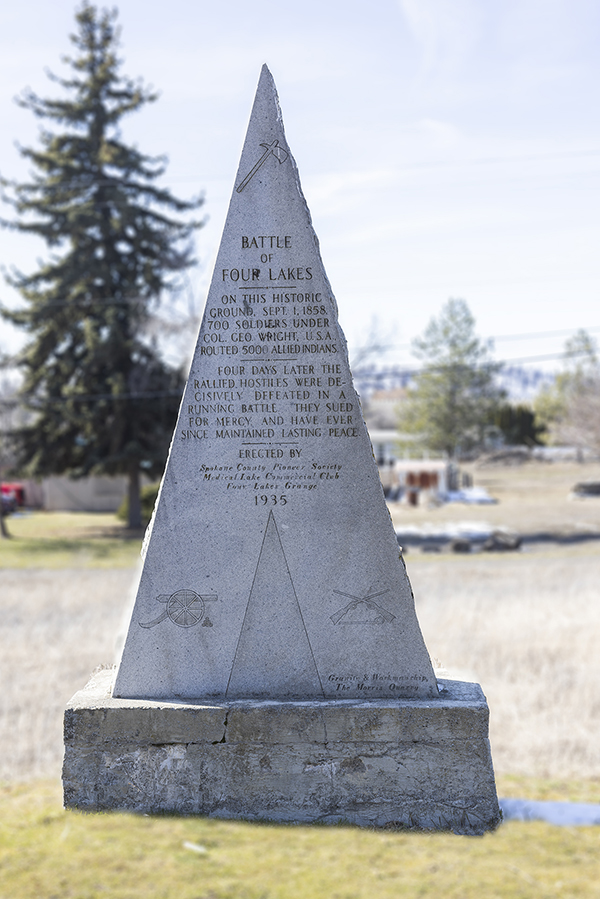
PhotoTitle: The Battle of Four Lakes Monument
PhotoAttribution: Spokane City/County Historic Preservation Office
Listing Status: N/A
URL: http://properties.historicspokane.org/property/?PropertyID=1984
Display Marker: large_yellow
Title: Battle of Four Lakes Monument
Description: Date Built: 1935
Architect: Unknown
Common Name: Battle of Four Lakes Monument
The Battle of Four Lakes Monument was erected in 1935 by Spokane County Pioneer Society, Medical Lake Commercial Club and Four Lakes Grange. The unassuming granite pyramid commemorates the 1858 battle between a confederation of Plateau Indian Tribes and a force commanded by Colonel George Wright. Wright was sent by General Newman Clarke to wage a punitive campaign in retaliation for the Tribe's attack on Lieutenant Colonel Edward Steptoe's forces earlier in the year. Armed with the latest automatic rifles, Wright's soldiers routed the native forces. Although the monument reads that 700 Army soldiers defeated "5000 allied Indians," contemporary research indicates that both sides were evenly matched, as Wright's fighting forces numbered around 500 and the Indian forces only slightly more than that.
Location: 47.56174, -117.5965
Address: 13219 W 1st Avenue, Four Lakes, WA 99014
PhotoURL:

PhotoTitle: The Battle of Four Lakes Monument
PhotoAttribution: Spokane City/County Historic Preservation Office
Listing Status: N/A
URL: http://properties.historicspokane.org/property/?PropertyID=1984
Display Marker: large_yellow
ID: 18
Title: Battle of Spokane Plains Monument
Description: Date Built: 1935
Architect: Unknown
Common Name: Battle of Spokane Plains State Park Monument
Composed of basaltic rock, the large pyramid sits on what is now the Battle of Spokane Plains State Park and offers impressive views of the surrounding flat lands. The Battle of Spokane Plains, known to the Spokane Tribe as the "Big Fight," was the culmination of a punitive expedition led by Colonel George Wright in the summer of 1858 in retribution for a skirmish that erupted when a party composed of Spokanes, Couer d'Alenes, Yakimas, Palouses and other tribes refused passage to a military expedition under Colonel E. J. Steptoe. After engaging and defeating the combined Indian forces in a running battle at Four Lakes, Wright's troops fought them again at Spokane Plains on September 5. After another victory, Wright wreaked havoc along the Spokane River in an effort to destroy the tribe's war-making capability. He burned food stores and lodges before gathering up and slaughtering a herd of approximately 600 Indian horses. After dictating the terms of peace, Wright summarily hanged Indians that he determined had committed depredations against whites, including Qualchan, the son of upper Yakima chief Owhi. On the last day of September, Wright declared: "The war is closed." The plaque reads: "Commemorative of the Battle of Spokane Plains, fought on September 5, 1858." A second plate on the monument further reads: "The Battle of Spokane Plains was fought near this spot on September 5, 1858, in which the U.S. Troops under command of Col. George Wright defeated the allied Coeur d'Alene, Palouse, and Spokane Indians."
Location: 47.643183, -117.648065
Address: 1399 South Dover Road, Medical Lake WA 99022
PhotoURL: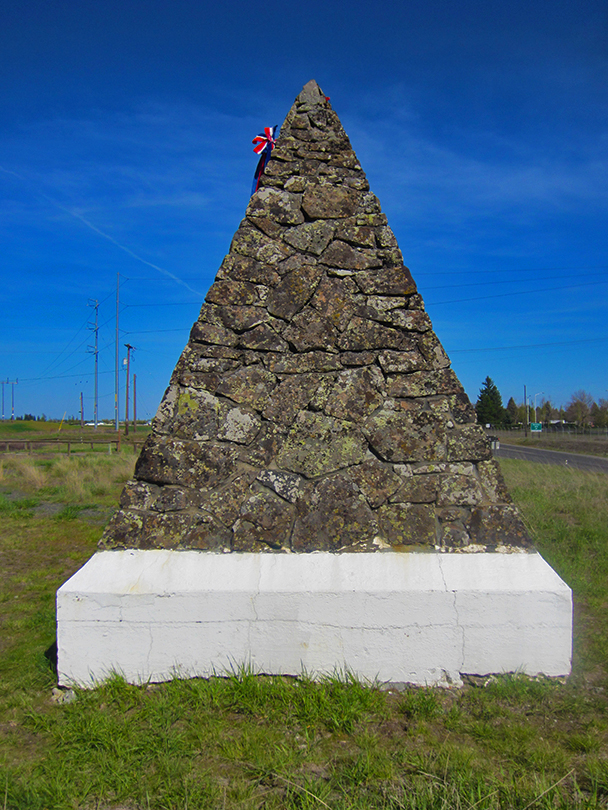
PhotoTitle: The Battle of Spokane Plains Monument
PhotoAttribution: Spokane City/County Historic Preservation Office
Listing Status: N/A
URL: http://properties.historicspokane.org/property/?PropertyID=1985
Display Marker: large_yellow
Title: Battle of Spokane Plains Monument
Description: Date Built: 1935
Architect: Unknown
Common Name: Battle of Spokane Plains State Park Monument
Composed of basaltic rock, the large pyramid sits on what is now the Battle of Spokane Plains State Park and offers impressive views of the surrounding flat lands. The Battle of Spokane Plains, known to the Spokane Tribe as the "Big Fight," was the culmination of a punitive expedition led by Colonel George Wright in the summer of 1858 in retribution for a skirmish that erupted when a party composed of Spokanes, Couer d'Alenes, Yakimas, Palouses and other tribes refused passage to a military expedition under Colonel E. J. Steptoe. After engaging and defeating the combined Indian forces in a running battle at Four Lakes, Wright's troops fought them again at Spokane Plains on September 5. After another victory, Wright wreaked havoc along the Spokane River in an effort to destroy the tribe's war-making capability. He burned food stores and lodges before gathering up and slaughtering a herd of approximately 600 Indian horses. After dictating the terms of peace, Wright summarily hanged Indians that he determined had committed depredations against whites, including Qualchan, the son of upper Yakima chief Owhi. On the last day of September, Wright declared: "The war is closed." The plaque reads: "Commemorative of the Battle of Spokane Plains, fought on September 5, 1858." A second plate on the monument further reads: "The Battle of Spokane Plains was fought near this spot on September 5, 1858, in which the U.S. Troops under command of Col. George Wright defeated the allied Coeur d'Alene, Palouse, and Spokane Indians."
Location: 47.643183, -117.648065
Address: 1399 South Dover Road, Medical Lake WA 99022
PhotoURL:

PhotoTitle: The Battle of Spokane Plains Monument
PhotoAttribution: Spokane City/County Historic Preservation Office
Listing Status: N/A
URL: http://properties.historicspokane.org/property/?PropertyID=1985
Display Marker: large_yellow
ID: 19
Title: Bauer House
Description: Date Built: 1914
Architect: Joseph T. Levesque
Common Name: Harvey & Mary Bauer House
Erected in 1914, the Bauer House is a hallmark example of the Craftsman style. Prominent Craftsman-style features include the low-slung, ground-hugging single-family house form with a low-pitched roof, widely overhanging eaves, exposed braces, decorative mortise-and-tenon joinery, and a battered brick-and-stone rubble mix foundation. Designed by noted Spokane architect Joseph T. Levesque, the home was built for Harvey Bauer, an employee of the Inland Refrigerator Works in Spokane, and his wife Mary. The home retains excellent exterior and interior integrity in original location, design, materials, workmanship and association.
Location: 47.63474, -117.4176
Address: 420 West 22nd Avenue, Spokane WA 99203
PhotoURL: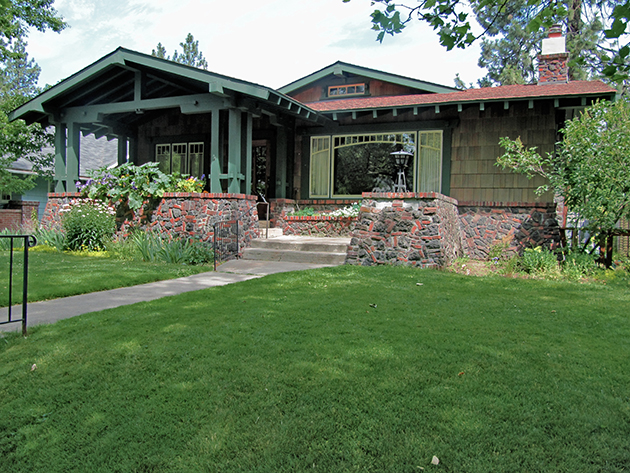
PhotoTitle: Harvey and Mary Bauer House
PhotoAttribution: Spokane City/County Historic Preservation Office
Listing Status: Spokane Register, National Register
URL: http://properties.historicspokane.org/property/?PropertyID=2045
Display Marker: large_yellow
Title: Bauer House
Description: Date Built: 1914
Architect: Joseph T. Levesque
Common Name: Harvey & Mary Bauer House
Erected in 1914, the Bauer House is a hallmark example of the Craftsman style. Prominent Craftsman-style features include the low-slung, ground-hugging single-family house form with a low-pitched roof, widely overhanging eaves, exposed braces, decorative mortise-and-tenon joinery, and a battered brick-and-stone rubble mix foundation. Designed by noted Spokane architect Joseph T. Levesque, the home was built for Harvey Bauer, an employee of the Inland Refrigerator Works in Spokane, and his wife Mary. The home retains excellent exterior and interior integrity in original location, design, materials, workmanship and association.
Location: 47.63474, -117.4176
Address: 420 West 22nd Avenue, Spokane WA 99203
PhotoURL:

PhotoTitle: Harvey and Mary Bauer House
PhotoAttribution: Spokane City/County Historic Preservation Office
Listing Status: Spokane Register, National Register
URL: http://properties.historicspokane.org/property/?PropertyID=2045
Display Marker: large_yellow
ID: 20
Title: Bear Frame & Axle Garage
Description: Date Built: 1930
Architect: Unknown
Common Name: Bear Frame & Axle Garage
The Bear Frame & Axle Garage has been a public service automobile garage since its construction in 1930 and is listed as a contributing structure in the National Register East Downtown Spokane Historic Business District. The structure is an excellent example of the industrial garage building type that evolved due to local, state, and national transportation trends that spurred the construction of hundreds of thousands of similar garages across the country. With original Art Deco-style detailing seen notably on the building's facade in pyramidal parapet corner projections and pilaster chevron motifs, the design of the Bear Frame & Axle Garage is typical of public service garages built during the 1920s, 1930s, and early 1940s in Spokane, WA. Sandwiched between two multi-story, brick-masonry single room occupancy hotels that were built in the early 1900s, the Bear Frame & Axle Garage reflects part of a contiguous historic building facade along West Sprague Avenue that conveys construction trends and designs, building practices, materials, and workmanship that were popular during the early decades of the 20th century in Spokane.
Location: 47.65759, -117.41479
Address: 232 West Sprague Avenue, Spokane WA 99201
PhotoURL: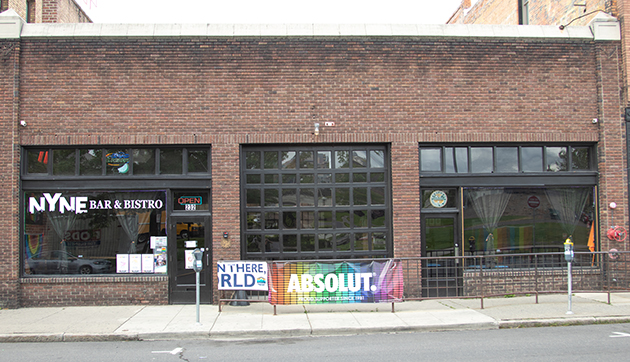
PhotoTitle: The Bear Frame and Axle Garage
PhotoAttribution: Spokane City/County Historic Preservation Office
Listing Status: Spokane Register, National Register
URL: http://properties.historicspokane.org/property/?PropertyID=1726
Display Marker: large_yellow
Title: Bear Frame & Axle Garage
Description: Date Built: 1930
Architect: Unknown
Common Name: Bear Frame & Axle Garage
The Bear Frame & Axle Garage has been a public service automobile garage since its construction in 1930 and is listed as a contributing structure in the National Register East Downtown Spokane Historic Business District. The structure is an excellent example of the industrial garage building type that evolved due to local, state, and national transportation trends that spurred the construction of hundreds of thousands of similar garages across the country. With original Art Deco-style detailing seen notably on the building's facade in pyramidal parapet corner projections and pilaster chevron motifs, the design of the Bear Frame & Axle Garage is typical of public service garages built during the 1920s, 1930s, and early 1940s in Spokane, WA. Sandwiched between two multi-story, brick-masonry single room occupancy hotels that were built in the early 1900s, the Bear Frame & Axle Garage reflects part of a contiguous historic building facade along West Sprague Avenue that conveys construction trends and designs, building practices, materials, and workmanship that were popular during the early decades of the 20th century in Spokane.
Location: 47.65759, -117.41479
Address: 232 West Sprague Avenue, Spokane WA 99201
PhotoURL:

PhotoTitle: The Bear Frame and Axle Garage
PhotoAttribution: Spokane City/County Historic Preservation Office
Listing Status: Spokane Register, National Register
URL: http://properties.historicspokane.org/property/?PropertyID=1726
Display Marker: large_yellow
ID: 21
Title: Bell House
Description: Date Built: 1908
Architect: Alonzo J. Glover
Common Name: Dr. Robert & Jessie Bell House
The Bell House and its single-car garage (built in 1912) embody identifying features of the American Foursquare and Craftsman traditions. The home was built for Dr. Robert Bell and his wife, Jessie Robertson Bell. Showcased in a July 26, 1908 Spokesman-Review newspaper article that featured a photograph of the house, floor plans of the interior, and a detailed description of the property, the newspaper article touted the home's design as an attractive example of the modern American house and a distinctive style of architecture built in the "American type." The Bell House was designed by Spokane architect Alonzo J. Glover and conveys building trends, incorporating styles and designs along with materials and construction methods that were popular during the early 20th century in Spokane.
Location: 47.64701, -117.42414
Address: 917 South Lincoln Street, Spokane WA 99204
PhotoURL: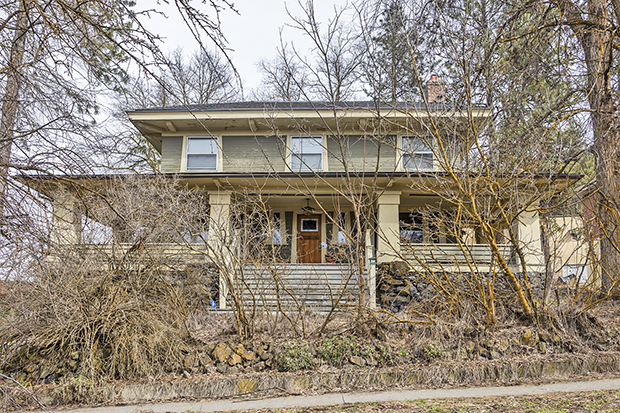
PhotoTitle: Dr. Robert and Jessie Bell House
PhotoAttribution: Spokane City/County Historic Preservation Office
Listing Status: Spokane Register, National Register
URL: http://properties.historicspokane.org/property/?PropertyID=1727
Display Marker: large_yellow
Title: Bell House
Description: Date Built: 1908
Architect: Alonzo J. Glover
Common Name: Dr. Robert & Jessie Bell House
The Bell House and its single-car garage (built in 1912) embody identifying features of the American Foursquare and Craftsman traditions. The home was built for Dr. Robert Bell and his wife, Jessie Robertson Bell. Showcased in a July 26, 1908 Spokesman-Review newspaper article that featured a photograph of the house, floor plans of the interior, and a detailed description of the property, the newspaper article touted the home's design as an attractive example of the modern American house and a distinctive style of architecture built in the "American type." The Bell House was designed by Spokane architect Alonzo J. Glover and conveys building trends, incorporating styles and designs along with materials and construction methods that were popular during the early 20th century in Spokane.
Location: 47.64701, -117.42414
Address: 917 South Lincoln Street, Spokane WA 99204
PhotoURL:

PhotoTitle: Dr. Robert and Jessie Bell House
PhotoAttribution: Spokane City/County Historic Preservation Office
Listing Status: Spokane Register, National Register
URL: http://properties.historicspokane.org/property/?PropertyID=1727
Display Marker: large_yellow
ID: 22
Title: Benewah Milk Bottle
Description: Date Built: 1934
Architect: Whitehouse and Price
Common Name: Benewah Milk Bottle
A favorite and familiar landmark in Spokane, the Benewah Milk Bottle Store was designed by the prestigious architectural firm Whitehouse and Price and built in 1935 by contractor W.G. Myers. The Milk Bottle, an example of mimetic literalism in advertising, was one of two of the whimsical retail outlets constructed for Paul E. Newport, a well-known creamery operator and merchant with five other outlet stores in the area in addition to his Benewah plant. The second Benewah Milk Bottle stands on the corner of Garland and Post.
Location: 47.6528, -117.43203
Address: 321 South Cedar Street, Spokane WA 99201
PhotoURL: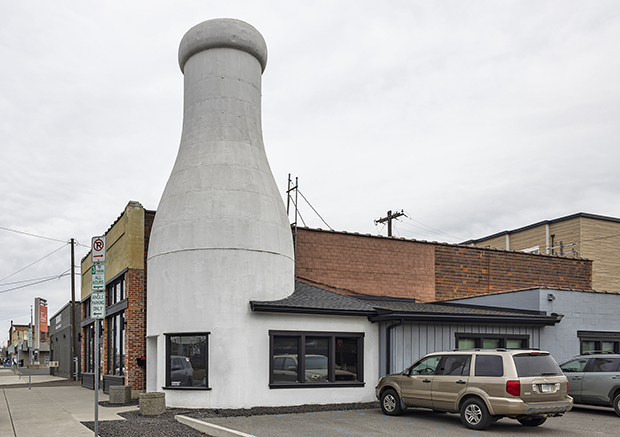
PhotoTitle: Behold the Benewah Milk Bottle!
PhotoAttribution: Spokane City/County Historic Preservation Office
Listing Status: Spokane Register, National Register
URL: http://properties.historicspokane.org/property/?PropertyID=1728
Display Marker: large_yellow
Title: Benewah Milk Bottle
Description: Date Built: 1934
Architect: Whitehouse and Price
Common Name: Benewah Milk Bottle
A favorite and familiar landmark in Spokane, the Benewah Milk Bottle Store was designed by the prestigious architectural firm Whitehouse and Price and built in 1935 by contractor W.G. Myers. The Milk Bottle, an example of mimetic literalism in advertising, was one of two of the whimsical retail outlets constructed for Paul E. Newport, a well-known creamery operator and merchant with five other outlet stores in the area in addition to his Benewah plant. The second Benewah Milk Bottle stands on the corner of Garland and Post.
Location: 47.6528, -117.43203
Address: 321 South Cedar Street, Spokane WA 99201
PhotoURL:

PhotoTitle: Behold the Benewah Milk Bottle!
PhotoAttribution: Spokane City/County Historic Preservation Office
Listing Status: Spokane Register, National Register
URL: http://properties.historicspokane.org/property/?PropertyID=1728
Display Marker: large_yellow
ID: 23
Title: Bennett Block
Description: Date Built: 1890
Architect: John K. Dow and Herman Preusse
Common Name: The Bennett Block, Mizuna
Built in 1890 and 1892, the Bennett Block is composed of three adjoined historic commercial buildings in downtown Spokane. Visually prominent due to its busy corner site and overall mass, the property is a fine example of vernacular masonry construction that is articulated with red pressed brick, shaped parapets, stained-glass windows and decorative granite and terra cotta embellishments. The Bennett Block was also one of the first group of buildings erected during the reconstruction of Spokane after the devastating fire of 1889. Originally owned by Bascomb H. Bennett, a shrewd businessman, Johann G. F. Hieber began buying financial interest in the property in 1909 and owned the entire block by 1928. After immigrating to the United States from Germany, Hieber, a certified brewmaster, built the Hieber Brewery in 1890 and continued to expand his landholdings until his death in 1941. The well-preserved and expansive Bennett Block has remained in the Hieber family ever since.
Location: 47.65939, -117.42074
Address: 530 West Main Avenue, Spokane WA 99201
PhotoURL: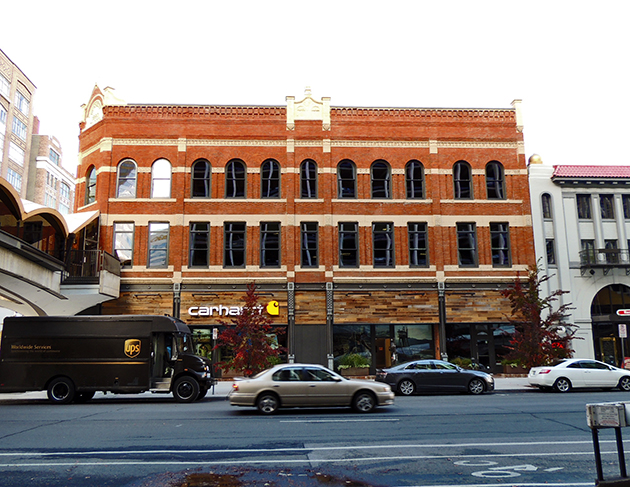
PhotoTitle: The Bennett Block
PhotoAttribution: Spokane City/County Historic Preservation Office
Listing Status: Spokane Register
URL: http://properties.historicspokane.org/property/?PropertyID=2080
Display Marker: large_yellow
Title: Bennett Block
Description: Date Built: 1890
Architect: John K. Dow and Herman Preusse
Common Name: The Bennett Block, Mizuna
Built in 1890 and 1892, the Bennett Block is composed of three adjoined historic commercial buildings in downtown Spokane. Visually prominent due to its busy corner site and overall mass, the property is a fine example of vernacular masonry construction that is articulated with red pressed brick, shaped parapets, stained-glass windows and decorative granite and terra cotta embellishments. The Bennett Block was also one of the first group of buildings erected during the reconstruction of Spokane after the devastating fire of 1889. Originally owned by Bascomb H. Bennett, a shrewd businessman, Johann G. F. Hieber began buying financial interest in the property in 1909 and owned the entire block by 1928. After immigrating to the United States from Germany, Hieber, a certified brewmaster, built the Hieber Brewery in 1890 and continued to expand his landholdings until his death in 1941. The well-preserved and expansive Bennett Block has remained in the Hieber family ever since.
Location: 47.65939, -117.42074
Address: 530 West Main Avenue, Spokane WA 99201
PhotoURL:

PhotoTitle: The Bennett Block
PhotoAttribution: Spokane City/County Historic Preservation Office
Listing Status: Spokane Register
URL: http://properties.historicspokane.org/property/?PropertyID=2080
Display Marker: large_yellow
ID: 24
Title: Binkley House
Description: Date Built: 1889
Architect: John W. Binkley
Common Name: J.W. Binkley House
This house was constructed in 1889 for John W. and Josephine Clarkson Binkley. J. W. Binkley served as a probate judge for Spokane County in 1885 and 1886. He had an active law practice, specializing in commercial and financial law, but came to concentrate more on his banking interests. Binkley was co-founder of the Northwestern and Pacific Mortgage Company, and later the North Pacific Loan and Trust Company, for which he also served as president. Binkley was active in the establishment of the Fort Wright Army Post and he was instrumental in the construction of the Montvale Block in downtown Spokane.
Location: 47.64974, -117.43605
Address: 628 South Maple Street, Spokane WA 99204
PhotoURL: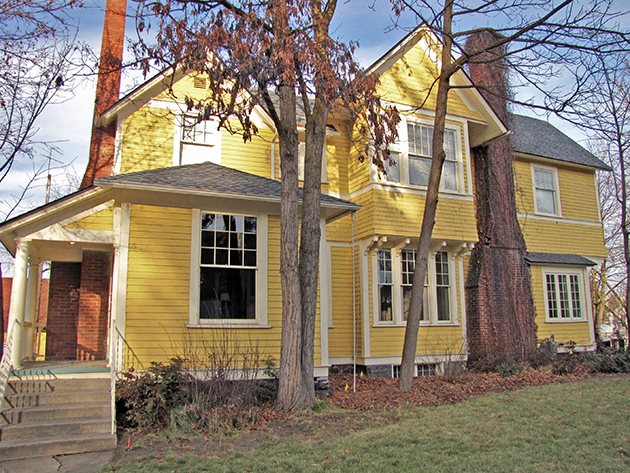
PhotoTitle: John and Josephine Binkley House
PhotoAttribution: Spokane City/County Historic Preservation Office
Listing Status: Spokane Register, National Register
URL: http://properties.historicspokane.org/property/?PropertyID=1729
Display Marker: large_yellow
Title: Binkley House
Description: Date Built: 1889
Architect: John W. Binkley
Common Name: J.W. Binkley House
This house was constructed in 1889 for John W. and Josephine Clarkson Binkley. J. W. Binkley served as a probate judge for Spokane County in 1885 and 1886. He had an active law practice, specializing in commercial and financial law, but came to concentrate more on his banking interests. Binkley was co-founder of the Northwestern and Pacific Mortgage Company, and later the North Pacific Loan and Trust Company, for which he also served as president. Binkley was active in the establishment of the Fort Wright Army Post and he was instrumental in the construction of the Montvale Block in downtown Spokane.
Location: 47.64974, -117.43605
Address: 628 South Maple Street, Spokane WA 99204
PhotoURL:

PhotoTitle: John and Josephine Binkley House
PhotoAttribution: Spokane City/County Historic Preservation Office
Listing Status: Spokane Register, National Register
URL: http://properties.historicspokane.org/property/?PropertyID=1729
Display Marker: large_yellow
ID: 25
Title: Blake-Ahlquist-Woolcott House
Description: Date Built: 1902
Architect: Unknown
Common Name: Blake-Ahlquist-Woolcott House
Built between 1902 and 1903, the Blake-Ahlquist House, commonly known as the Woolcott House, is a well-preserved Craftsman/Shingle style home that sits high above the Spokane River on Summit Boulevard. The house was built for Jacob M. Blake, son of the very prominent Judge Richard B. Blake, and retains excellent interior and exterior integrity. Craftsman style features depicted on the Blake-Ahlquist House include wood shingle cladding, exposed rafter ends, decorative notched-end fascia boards, and decorative triangular knee brackets. A second story was added to the house in 1917, though the designer remains unknown.
Location: 47.66898, -117.45764
Address: 1232 North Summit Boulevard, Spokane WA 99201
PhotoURL: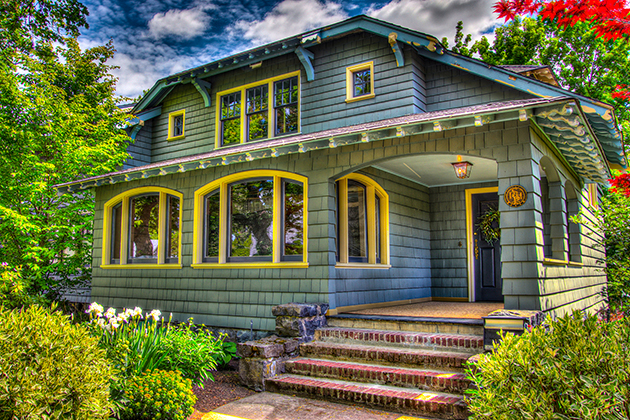
PhotoTitle: Blake-Ahlquist-Woolcott House
PhotoAttribution: Spokane City/County Historic Preservation Office
Listing Status: Spokane Register
URL: http://properties.historicspokane.org/property/?PropertyID=2069
Display Marker: large_yellow
Title: Blake-Ahlquist-Woolcott House
Description: Date Built: 1902
Architect: Unknown
Common Name: Blake-Ahlquist-Woolcott House
Built between 1902 and 1903, the Blake-Ahlquist House, commonly known as the Woolcott House, is a well-preserved Craftsman/Shingle style home that sits high above the Spokane River on Summit Boulevard. The house was built for Jacob M. Blake, son of the very prominent Judge Richard B. Blake, and retains excellent interior and exterior integrity. Craftsman style features depicted on the Blake-Ahlquist House include wood shingle cladding, exposed rafter ends, decorative notched-end fascia boards, and decorative triangular knee brackets. A second story was added to the house in 1917, though the designer remains unknown.
Location: 47.66898, -117.45764
Address: 1232 North Summit Boulevard, Spokane WA 99201
PhotoURL:

PhotoTitle: Blake-Ahlquist-Woolcott House
PhotoAttribution: Spokane City/County Historic Preservation Office
Listing Status: Spokane Register
URL: http://properties.historicspokane.org/property/?PropertyID=2069
Display Marker: large_yellow
ID: 26
Title: Bleecker House
Description: Date Built: 1909
Architect: C. Ferris White
Common Name: Harry and Katherine Bleecker House
The Bleecker House is a fine example of the Dutch Colonial Revival tradition with Craftsman-style influence. The home is a large two-story platform-frame dwelling with a medium-pitched, prominently-flared side gable roof with widely overhanging eaves, tongue-in-groove paneled wood soffits, and wood modillions. The house has a symmetrical faŤade design with symmetrical fenestration patterns, original louvered wood window shutters, a combination of original multi-paned casement and double-hung wood-sash windows, a covered center front porch, and double-course wood shingle siding. Well-preserved and in excellent condition, the Bleecker House retains good exterior and interior architectural integrity in original location, design, materials, workmanship, and association as an early twentieth-century single-family home built in northwest Spokane.
Location: 47.67313, -117.44673
Address: 1707 North West Point Road, Spokane WA 99201
PhotoURL: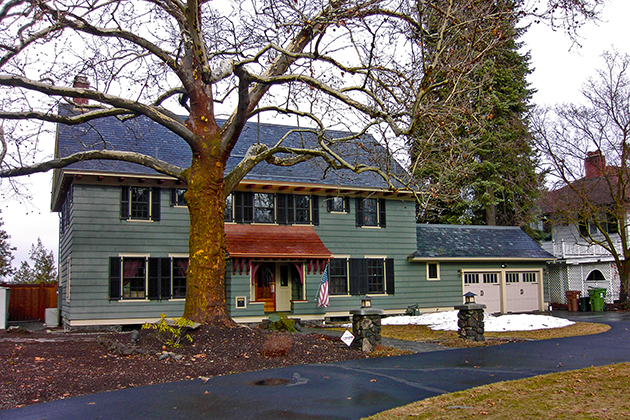
PhotoTitle: Harry and Katherine Bleecker House
PhotoAttribution: Spokane City/County Historic Preservation Office
Listing Status: Spokane Register
URL: http://properties.historicspokane.org/property/?PropertyID=1731
Display Marker: large_yellow
Title: Bleecker House
Description: Date Built: 1909
Architect: C. Ferris White
Common Name: Harry and Katherine Bleecker House
The Bleecker House is a fine example of the Dutch Colonial Revival tradition with Craftsman-style influence. The home is a large two-story platform-frame dwelling with a medium-pitched, prominently-flared side gable roof with widely overhanging eaves, tongue-in-groove paneled wood soffits, and wood modillions. The house has a symmetrical faŤade design with symmetrical fenestration patterns, original louvered wood window shutters, a combination of original multi-paned casement and double-hung wood-sash windows, a covered center front porch, and double-course wood shingle siding. Well-preserved and in excellent condition, the Bleecker House retains good exterior and interior architectural integrity in original location, design, materials, workmanship, and association as an early twentieth-century single-family home built in northwest Spokane.
Location: 47.67313, -117.44673
Address: 1707 North West Point Road, Spokane WA 99201
PhotoURL:

PhotoTitle: Harry and Katherine Bleecker House
PhotoAttribution: Spokane City/County Historic Preservation Office
Listing Status: Spokane Register
URL: http://properties.historicspokane.org/property/?PropertyID=1731
Display Marker: large_yellow
ID: 27
Title: Bodie Block
Description: Date Built: 1889
Architect: Richard T. Daniel, Antone Traut and Eugene Chamberlin
Common Name: 1889 Building, Mark Soss Block
Rising from a basalt, brick, and concrete basement, the Bodie Block/1889 Building is a three-story brick building and is the oldest remaining building from the post Great Spokane Fire era. The building exemplifies the exuberant rebirth of the city after its disastrous fire. Constructed in less than five months, the building represents the beginnings of the new business district of Spokane, the foundation of today's downtown. The Bodie Block is a vernacular building with references to Romanesque Revival, prominent semi-circular arches in the end and west facades, and richly detailed in brick and stone-face granite trim. Although the upper floors have been converted to offices, the commercial building was originally a single room occupancy hotel with commercial space on the ground floor and residential/commercial space on the second and third floors.
Location: 47.65878, -117.41934
Address: 427 West Main Avenue, Spokane WA 99201
PhotoURL: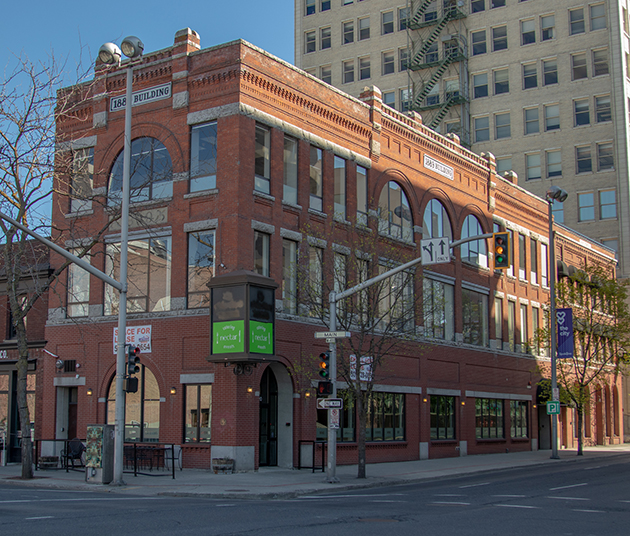
PhotoTitle: The Bodie Block
PhotoAttribution: Spokane City/County Historic Preservation Office
Listing Status: Spokane Register
URL: http://properties.historicspokane.org/property/?PropertyID=2042
Display Marker: large_yellow
Title: Bodie Block
Description: Date Built: 1889
Architect: Richard T. Daniel, Antone Traut and Eugene Chamberlin
Common Name: 1889 Building, Mark Soss Block
Rising from a basalt, brick, and concrete basement, the Bodie Block/1889 Building is a three-story brick building and is the oldest remaining building from the post Great Spokane Fire era. The building exemplifies the exuberant rebirth of the city after its disastrous fire. Constructed in less than five months, the building represents the beginnings of the new business district of Spokane, the foundation of today's downtown. The Bodie Block is a vernacular building with references to Romanesque Revival, prominent semi-circular arches in the end and west facades, and richly detailed in brick and stone-face granite trim. Although the upper floors have been converted to offices, the commercial building was originally a single room occupancy hotel with commercial space on the ground floor and residential/commercial space on the second and third floors.
Location: 47.65878, -117.41934
Address: 427 West Main Avenue, Spokane WA 99201
PhotoURL:

PhotoTitle: The Bodie Block
PhotoAttribution: Spokane City/County Historic Preservation Office
Listing Status: Spokane Register
URL: http://properties.historicspokane.org/property/?PropertyID=2042
Display Marker: large_yellow
ID: 28
Title: Boothe-McClintock Building
Description: Date Built: 1899
Architect: Kirtland Cutter and Malmgren
Common Name: Joel Building
Built in 1899, the Boothe-McClintock/Electro-Kold (Joel) Building is located in Spokane's central business district. The three-story, brick masonry-and-timber frame building (plus basement) is composed of two attached structures. They include the Post Street building at 165 S. Post, and an attached warehouse at 715 West Railroad Ave on the east side dating to around 1890. The buildings were originally designed, and then extensively renovated in 1910 by Cutter & Malmgren, Spokane's most celebrated architectural firm. Joel Inc., a gift store, moved into the 161 S. Post building (since burned) and remodeled the facade in the late 1960s. Joel E. Ferris Jr. was a community leader, and son of a very prominent community leader, who promoted the arts, downtown development, and philanthropy through the Joel E. Ferris Foundation. Inspired by retail stores he saw in Italy during WWII, Ferris started the gift store in 1950. Under the name of Joel Home Furnishings and Interior Design, the store expanded into Danish modern furnishings, contemporary artwork, and modernist design elements for home and office. Although the 165 S. Post structure has been altered for tenants over the years, it retains its historical integrity
Location: 47.65516, -117.42309
Address: 165 South Post Street, Spokane WA 99201
PhotoURL: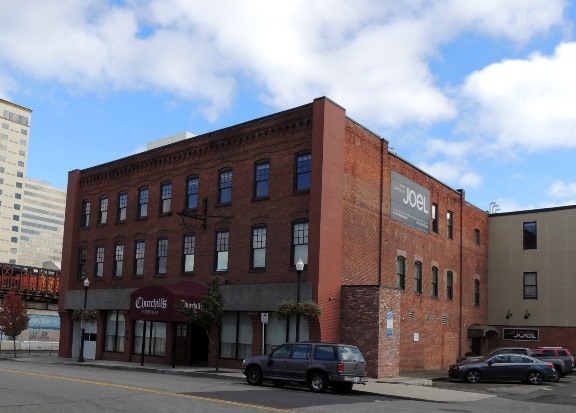
PhotoTitle: The Boothe-McClintock Building
PhotoAttribution: Spokane City/County Historic Preservation Office
Listing Status: Spokane Register
URL: http://properties.historicspokane.org/property/?PropertyID=1732
Display Marker: large_yellow
Title: Boothe-McClintock Building
Description: Date Built: 1899
Architect: Kirtland Cutter and Malmgren
Common Name: Joel Building
Built in 1899, the Boothe-McClintock/Electro-Kold (Joel) Building is located in Spokane's central business district. The three-story, brick masonry-and-timber frame building (plus basement) is composed of two attached structures. They include the Post Street building at 165 S. Post, and an attached warehouse at 715 West Railroad Ave on the east side dating to around 1890. The buildings were originally designed, and then extensively renovated in 1910 by Cutter & Malmgren, Spokane's most celebrated architectural firm. Joel Inc., a gift store, moved into the 161 S. Post building (since burned) and remodeled the facade in the late 1960s. Joel E. Ferris Jr. was a community leader, and son of a very prominent community leader, who promoted the arts, downtown development, and philanthropy through the Joel E. Ferris Foundation. Inspired by retail stores he saw in Italy during WWII, Ferris started the gift store in 1950. Under the name of Joel Home Furnishings and Interior Design, the store expanded into Danish modern furnishings, contemporary artwork, and modernist design elements for home and office. Although the 165 S. Post structure has been altered for tenants over the years, it retains its historical integrity
Location: 47.65516, -117.42309
Address: 165 South Post Street, Spokane WA 99201
PhotoURL:

PhotoTitle: The Boothe-McClintock Building
PhotoAttribution: Spokane City/County Historic Preservation Office
Listing Status: Spokane Register
URL: http://properties.historicspokane.org/property/?PropertyID=1732
Display Marker: large_yellow
ID: 29
Title: Breslin Apartments
Description: Date Built: 1910
Architect: Albert Held
Common Name: Breslin Apartments
The Breslin Building is one of four apartment buildings listed collectively on the National Register as a result of a 1987 thematic nomination for apartment buildings designed by prominent Spokane architect Albert Held. Together with the Amman, Knickerbocker, and San Marco, the Breslin reflects the coming of age of luxury multi-family housing in Spokane, and represents the range of Held's skills as an architect.
Location: 47.64868, -117.41602
Address: 729 South Bernard Street, Spokane WA 99204
PhotoURL: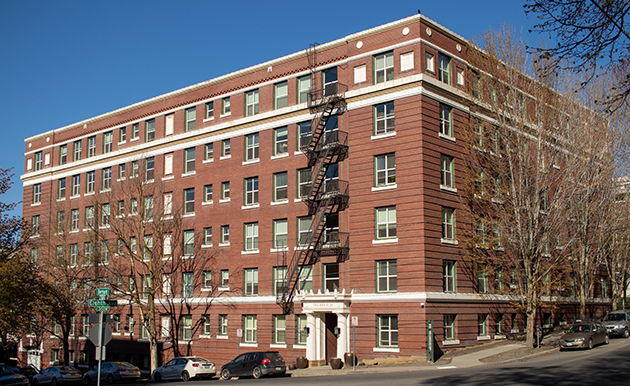
PhotoTitle: The Breslin Apartments
PhotoAttribution: Spokane City/County Historic Preservation Office
Listing Status: National Register
URL: http://properties.historicspokane.org/property/?PropertyID=1986
Display Marker: large_yellow
Title: Breslin Apartments
Description: Date Built: 1910
Architect: Albert Held
Common Name: Breslin Apartments
The Breslin Building is one of four apartment buildings listed collectively on the National Register as a result of a 1987 thematic nomination for apartment buildings designed by prominent Spokane architect Albert Held. Together with the Amman, Knickerbocker, and San Marco, the Breslin reflects the coming of age of luxury multi-family housing in Spokane, and represents the range of Held's skills as an architect.
Location: 47.64868, -117.41602
Address: 729 South Bernard Street, Spokane WA 99204
PhotoURL:

PhotoTitle: The Breslin Apartments
PhotoAttribution: Spokane City/County Historic Preservation Office
Listing Status: National Register
URL: http://properties.historicspokane.org/property/?PropertyID=1986
Display Marker: large_yellow
ID: 30
Title: Broadview Dairy
Description: Date Built: 1910
Architect: R. Edward Vincent
Common Name: Broadview Dairy
The Broadview Dairy was one of several commercial dairy operations established in the Spokane area around the turn of the 20th century, and it is the only local dairy business still in operation. Allen H. Flood, who first arrived in Spokane in 1889, the year of the Great Fire, founded Broadview between 1896 and 1897. Originally from Buxton, Maine, Flood helped survey Hays Park Addition and a part of what is now Hillyard, and also engaged in the lumber business before establishing his dairy. Under Flood's direction, Broadview Dairy was a leader in campaigns for dairy operations betterment; it was the first commercial dairy in the state to test for tuberculosis and get rid of infected cows, and also led the fight for pasteurization in the Inland Northwest. The operation was known as the Broadview Dairy from its inception to 1946, even though Carnation acquired Broadview in a stock exchange in 1929. Architect R. Edward Vincent designed the building.
Location: 47.66539, -117.41804
Address: 411 West Cataldo Avenue, Spokane WA 99201
PhotoURL: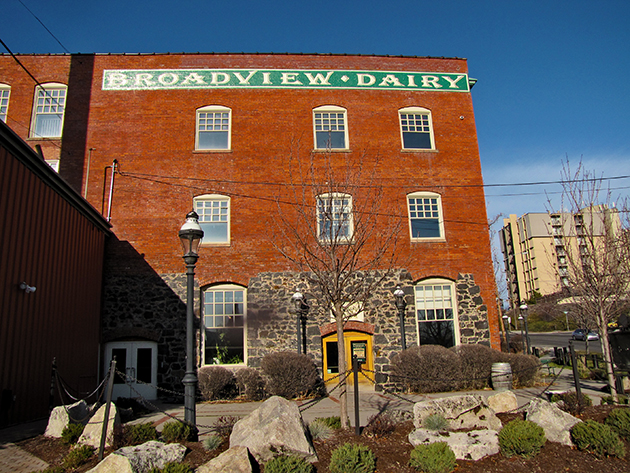
PhotoTitle: The Broadview Dairy
PhotoAttribution: Spokane City/County Historic Preservation Office
Listing Status: Spokane Register
URL: http://properties.historicspokane.org/property/?PropertyID=1733
Display Marker: large_yellow
Title: Broadview Dairy
Description: Date Built: 1910
Architect: R. Edward Vincent
Common Name: Broadview Dairy
The Broadview Dairy was one of several commercial dairy operations established in the Spokane area around the turn of the 20th century, and it is the only local dairy business still in operation. Allen H. Flood, who first arrived in Spokane in 1889, the year of the Great Fire, founded Broadview between 1896 and 1897. Originally from Buxton, Maine, Flood helped survey Hays Park Addition and a part of what is now Hillyard, and also engaged in the lumber business before establishing his dairy. Under Flood's direction, Broadview Dairy was a leader in campaigns for dairy operations betterment; it was the first commercial dairy in the state to test for tuberculosis and get rid of infected cows, and also led the fight for pasteurization in the Inland Northwest. The operation was known as the Broadview Dairy from its inception to 1946, even though Carnation acquired Broadview in a stock exchange in 1929. Architect R. Edward Vincent designed the building.
Location: 47.66539, -117.41804
Address: 411 West Cataldo Avenue, Spokane WA 99201
PhotoURL:

PhotoTitle: The Broadview Dairy
PhotoAttribution: Spokane City/County Historic Preservation Office
Listing Status: Spokane Register
URL: http://properties.historicspokane.org/property/?PropertyID=1733
Display Marker: large_yellow
ID: 31
Title: Broadway Pharmacy
Description: Date Built: 1910
Architect: Unknown
Common Name: Bryant Apartments
The Bryant Apartments/Broadway Pharmacy Building is historically significant for its association with the growth and development of the West Central Neighborhood, one of Spokane's oldest, and as one of the few remaining intact examples of commercial architecture in the West Broadway business district. In 1910, Stephen Morris, a motorman for W.W.P., had this building built, and then sold the property to Lydia Rogers in 1915. The property stayed with the Rogers family until 1979. This building once housed the Bryant Apartments, one of Charles Marr's grocery stores, and the Broadway Pharmacy. Charles Marr was a successful West Central businessman who owned more than seventy grocery stores at the peak of his career.
Location: 47.66462, -117.43719
Address: 1704 West Broadway Avenue, Spokane WA 99201
PhotoURL:
PhotoTitle: The Broadway Pharmacy
PhotoAttribution: Spokane City/County Historic Preservation Office
Listing Status: Spokane Register
URL: http://properties.historicspokane.org/property/?PropertyID=1734
Display Marker: large_yellow
Title: Broadway Pharmacy
Description: Date Built: 1910
Architect: Unknown
Common Name: Bryant Apartments
The Bryant Apartments/Broadway Pharmacy Building is historically significant for its association with the growth and development of the West Central Neighborhood, one of Spokane's oldest, and as one of the few remaining intact examples of commercial architecture in the West Broadway business district. In 1910, Stephen Morris, a motorman for W.W.P., had this building built, and then sold the property to Lydia Rogers in 1915. The property stayed with the Rogers family until 1979. This building once housed the Bryant Apartments, one of Charles Marr's grocery stores, and the Broadway Pharmacy. Charles Marr was a successful West Central businessman who owned more than seventy grocery stores at the peak of his career.
Location: 47.66462, -117.43719
Address: 1704 West Broadway Avenue, Spokane WA 99201
PhotoURL:

PhotoTitle: The Broadway Pharmacy
PhotoAttribution: Spokane City/County Historic Preservation Office
Listing Status: Spokane Register
URL: http://properties.historicspokane.org/property/?PropertyID=1734
Display Marker: large_yellow
ID: 32
Title: Brooks House
Description: Date Built: 1956
Architect: Kenneth W. Brooks
Common Name: Kenneth & Edna Brooks House
The Kenneth & Edna Brooks House embodies the distinctive characteristics of the modern movement in Spokane during the 1950s. Additionally, the 1956 home represents the early work of Spokane architect Kenneth W. Brooks, who was one of the prominent trendsetters in the local architectural community for over 30 years. Through his long and distinguished career, Brooks received architectural acclaim at the local, state, and national level, and in a variety of European publications. The Brooks house is significant as a resource that demonstrates Brooks' mastery of the language of architectural expression developed by Mies van der Rohe, a dominant force in American construction in the 1950s and 1960s.
Location: 47.64646, -117.42201
Address: 723 West Sumner Avenue, Spokane WA 99204
PhotoURL: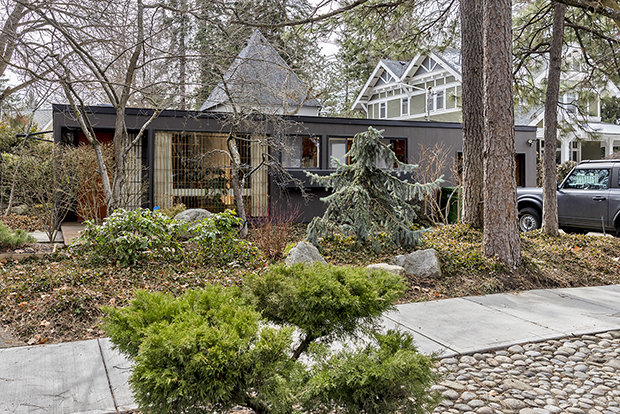
PhotoTitle: Kenneth and Edna Brooks House
PhotoAttribution: Spokane City/County Historic Preservation Office
Listing Status: National Register
URL: http://properties.historicspokane.org/property/?PropertyID=1987
Display Marker: large_yellow
Title: Brooks House
Description: Date Built: 1956
Architect: Kenneth W. Brooks
Common Name: Kenneth & Edna Brooks House
The Kenneth & Edna Brooks House embodies the distinctive characteristics of the modern movement in Spokane during the 1950s. Additionally, the 1956 home represents the early work of Spokane architect Kenneth W. Brooks, who was one of the prominent trendsetters in the local architectural community for over 30 years. Through his long and distinguished career, Brooks received architectural acclaim at the local, state, and national level, and in a variety of European publications. The Brooks house is significant as a resource that demonstrates Brooks' mastery of the language of architectural expression developed by Mies van der Rohe, a dominant force in American construction in the 1950s and 1960s.
Location: 47.64646, -117.42201
Address: 723 West Sumner Avenue, Spokane WA 99204
PhotoURL:

PhotoTitle: Kenneth and Edna Brooks House
PhotoAttribution: Spokane City/County Historic Preservation Office
Listing Status: National Register
URL: http://properties.historicspokane.org/property/?PropertyID=1987
Display Marker: large_yellow
ID: 33
Title: Buchanan Building
Description: Date Built: 1911
Architect: F. P. Rooney and Lewis R. Stritesky
Common Name: Buchanan Building
The Buchanan building is both architecturally and historically significant. Designed by local architects F. P. Rooney and Lewis Stritesky, the building was erected in 1911 to house James D. Buchanan's business ventures. Buchanan's mortuary, one of the finest establishments in the city, remained in the building until 1924, when it became the Hennessey and Calloway Funeral Home. The ornate entry marquee, elaborate lobby and impressive chapel remain as a testament to the prominence of this early Spokane business.
Location: 47.65383, -117.41255
Address: 28 West Third Avenue, Spokane WA 99201
PhotoURL: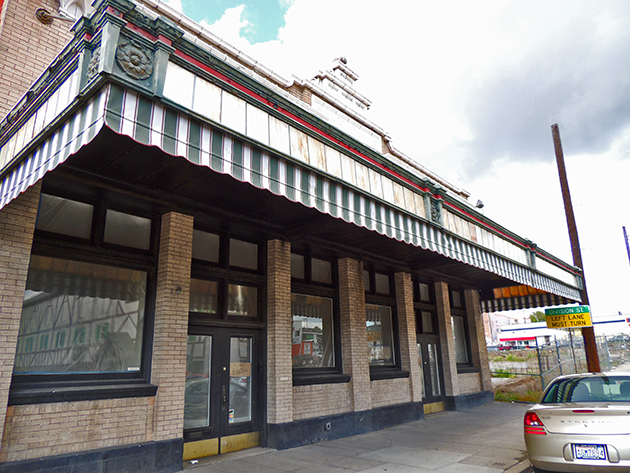
PhotoTitle: The Buchanan Building (date unknown)
PhotoAttribution: Spokane City/County Historic Preservation Office
Listing Status: Spokane Register
URL: http://properties.historicspokane.org/property/?PropertyID=1737
Display Marker: large_yellow
Title: Buchanan Building
Description: Date Built: 1911
Architect: F. P. Rooney and Lewis R. Stritesky
Common Name: Buchanan Building
The Buchanan building is both architecturally and historically significant. Designed by local architects F. P. Rooney and Lewis Stritesky, the building was erected in 1911 to house James D. Buchanan's business ventures. Buchanan's mortuary, one of the finest establishments in the city, remained in the building until 1924, when it became the Hennessey and Calloway Funeral Home. The ornate entry marquee, elaborate lobby and impressive chapel remain as a testament to the prominence of this early Spokane business.
Location: 47.65383, -117.41255
Address: 28 West Third Avenue, Spokane WA 99201
PhotoURL:

PhotoTitle: The Buchanan Building (date unknown)
PhotoAttribution: Spokane City/County Historic Preservation Office
Listing Status: Spokane Register
URL: http://properties.historicspokane.org/property/?PropertyID=1737
Display Marker: large_yellow
ID: 34
Title: Buena Vista Apartments
Description: Date Built: 1905
Architect: Unknown
Common Name: Buena Vista Apartments
The Buena Vista Apartment buildings were constructed as the Hotel Vallamont (11 S. Cedar) and the Buena Vista Apartments (5 S. Cedar) in 1905. The area in which the structure sits was originally a residential neighborhood near the center of the small town, but as the city's population increased, there was a demand for apartment and hotel space. Several three story structures, both hotel and apartment, were erected. Some were built as luxurious quarters, but others such as these two were for more moderate incomes. This neighborhood was convenient for the expanding downtown office and shopping center and eventually boasted Linden trees on grassy islands in the middle of the wide boulevards, resulting from landscaping suggestions made by noted landscape architects the Olmsted Brothers in their Park Board report to the City of Spokane
Location: 47.65694, -117.43218
Address: 5 South Cedar Street, Spokane WA 99201
PhotoURL: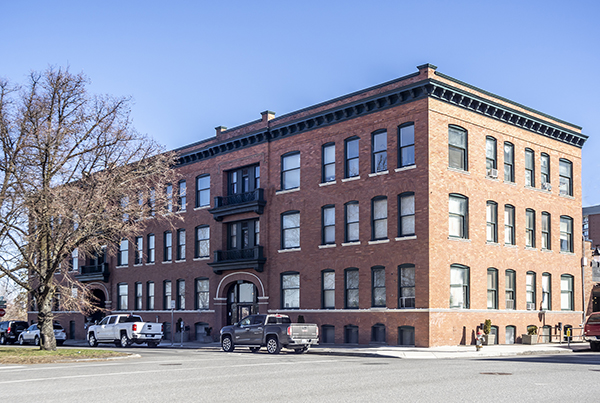
PhotoTitle: The Buena Vista Apartments
PhotoAttribution: Spokane City/County Historic Preservation Office
Listing Status: Spokane Register, National Register
URL: http://properties.historicspokane.org/property/?PropertyID=1738
Display Marker: large_yellow
Title: Buena Vista Apartments
Description: Date Built: 1905
Architect: Unknown
Common Name: Buena Vista Apartments
The Buena Vista Apartment buildings were constructed as the Hotel Vallamont (11 S. Cedar) and the Buena Vista Apartments (5 S. Cedar) in 1905. The area in which the structure sits was originally a residential neighborhood near the center of the small town, but as the city's population increased, there was a demand for apartment and hotel space. Several three story structures, both hotel and apartment, were erected. Some were built as luxurious quarters, but others such as these two were for more moderate incomes. This neighborhood was convenient for the expanding downtown office and shopping center and eventually boasted Linden trees on grassy islands in the middle of the wide boulevards, resulting from landscaping suggestions made by noted landscape architects the Olmsted Brothers in their Park Board report to the City of Spokane
Location: 47.65694, -117.43218
Address: 5 South Cedar Street, Spokane WA 99201
PhotoURL:

PhotoTitle: The Buena Vista Apartments
PhotoAttribution: Spokane City/County Historic Preservation Office
Listing Status: Spokane Register, National Register
URL: http://properties.historicspokane.org/property/?PropertyID=1738
Display Marker: large_yellow
ID: 35
Title: Bump Block
Description: Date Built: 1890
Architect: Rand and Dow (1890), Herman Preusse and Julius Zittel (1909)
Common Name: Hotel Carlyle
The Bump Block, located at the southwest corner of Second Avenue and Post Street, is a seven-story brick masonry structure with a basalt rubble foundation and a flat built-up roof. It exhibits characteristics of the Brick Commercial Style, distinguished as well by classically inspired elements such as the overhanging corona and modillion block of the cornice, and the round-arched windows with decorative keystones on the third floor. The building, constructed in 1890, was significantly enlarged in 1909. At that time, the original 50 foot (fronting Second Avenue) by 100 foot footprint was expanded southward along Post Street by forty feet. Also, the height of the building was raised by three stories, which entailed removal of the original roof and construction of a new cornice. These additions were designed in such a way as to replicate the original exterior appearance of the lower four floors and, through the use of similar Brick Commercial design elements on the upper floors, to create a new but cohesive structure.
Location: 47.65419, -117.42373
Address: 206 South Post Street, Spokane WA 99201
PhotoURL: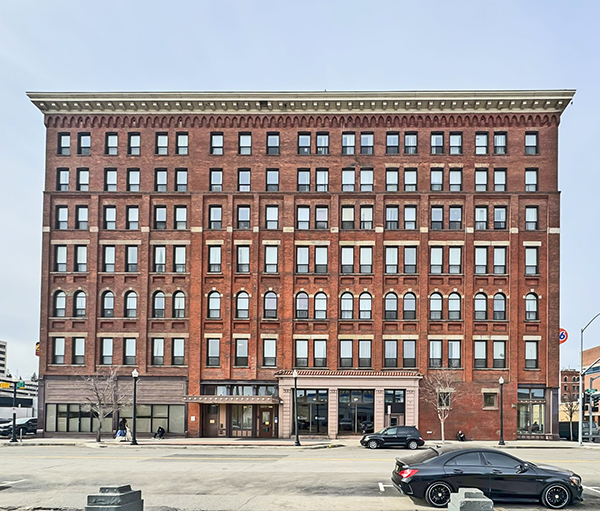
PhotoTitle: The Bump Block
PhotoAttribution: Spokane City/County Historic Preservation Office
Listing Status: Spokane Register, National Register
URL: http://properties.historicspokane.org/property/?PropertyID=1743
Display Marker: large_yellow
Title: Bump Block
Description: Date Built: 1890
Architect: Rand and Dow (1890), Herman Preusse and Julius Zittel (1909)
Common Name: Hotel Carlyle
The Bump Block, located at the southwest corner of Second Avenue and Post Street, is a seven-story brick masonry structure with a basalt rubble foundation and a flat built-up roof. It exhibits characteristics of the Brick Commercial Style, distinguished as well by classically inspired elements such as the overhanging corona and modillion block of the cornice, and the round-arched windows with decorative keystones on the third floor. The building, constructed in 1890, was significantly enlarged in 1909. At that time, the original 50 foot (fronting Second Avenue) by 100 foot footprint was expanded southward along Post Street by forty feet. Also, the height of the building was raised by three stories, which entailed removal of the original roof and construction of a new cornice. These additions were designed in such a way as to replicate the original exterior appearance of the lower four floors and, through the use of similar Brick Commercial design elements on the upper floors, to create a new but cohesive structure.
Location: 47.65419, -117.42373
Address: 206 South Post Street, Spokane WA 99201
PhotoURL:

PhotoTitle: The Bump Block
PhotoAttribution: Spokane City/County Historic Preservation Office
Listing Status: Spokane Register, National Register
URL: http://properties.historicspokane.org/property/?PropertyID=1743
Display Marker: large_yellow
ID: 36
Title: Earl Browne House
Description: Date Built: 1908
Architect: Unknown
Common Name: Earl Browne House
The Earl Browne House is architecturally significant for its well-preserved representation of the Craftsman style. Earl Browne, son of J.J. Browne, was an important contributor to the Browne family's early successes in Spokane. The Earl Browne House represents early development of rural Spokane County and serves as a landmark to the homestead of Spokane's premier pioneering families. The house grounds have remained largely unaltered and provide a unique preservation opportunity for Spokane County.
Location: 47.60102, -117.34332
Address: 5807 South Dearborn Road, Spokane WA 99223
PhotoURL: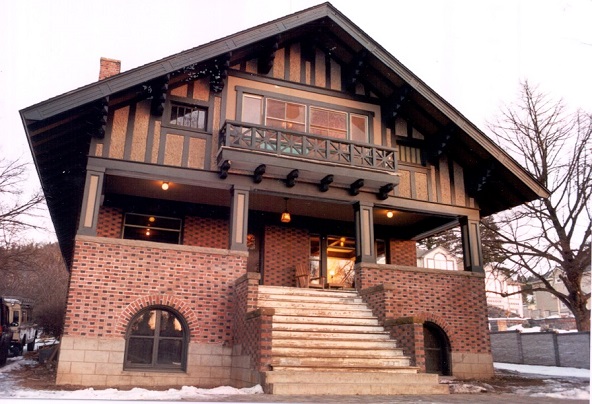
PhotoTitle: Earl Browne House
PhotoAttribution: Spokane City/County Historic Preservation Office
Listing Status: National Register
URL: http://properties.historicspokane.org/property/?PropertyID=1735
Display Marker: large_yellow
Title: Earl Browne House
Description: Date Built: 1908
Architect: Unknown
Common Name: Earl Browne House
The Earl Browne House is architecturally significant for its well-preserved representation of the Craftsman style. Earl Browne, son of J.J. Browne, was an important contributor to the Browne family's early successes in Spokane. The Earl Browne House represents early development of rural Spokane County and serves as a landmark to the homestead of Spokane's premier pioneering families. The house grounds have remained largely unaltered and provide a unique preservation opportunity for Spokane County.
Location: 47.60102, -117.34332
Address: 5807 South Dearborn Road, Spokane WA 99223
PhotoURL:

PhotoTitle: Earl Browne House
PhotoAttribution: Spokane City/County Historic Preservation Office
Listing Status: National Register
URL: http://properties.historicspokane.org/property/?PropertyID=1735
Display Marker: large_yellow
ID: 37
Title: Guy Browne House
Description: Date Built: 1908
Architect: Unknown
Common Name: Guy Browne House
The Guy Browne House is architecturally significant as one of Spokane County's earliest and best preserved examples of an American Foursquare style home. The home was designed for Guy Browne, who by the age of 35, had risen to the level of president of a successful banking and property investment empire started by his father, J.J. Browne. Guy Browne, with the rest of the influential Browne family, was instrumental in the development of Spokane and the Moran Prairie. Over a century old, the Guy Browne House stands as a reminder of the significant influence of the Browne family.
Location: 47.6017, -117.34066
Address: 5705 South Custer Road, Spokane WA 99223
PhotoURL: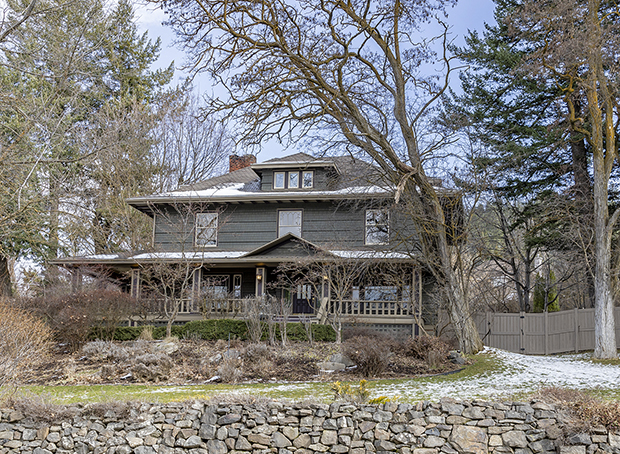
PhotoTitle: Guy Browne House
PhotoAttribution: Spokane City/County Historic Preservation Office
Listing Status: Spokane Register
URL: http://properties.historicspokane.org/property/?PropertyID=1736
Display Marker: large_yellow
Title: Guy Browne House
Description: Date Built: 1908
Architect: Unknown
Common Name: Guy Browne House
The Guy Browne House is architecturally significant as one of Spokane County's earliest and best preserved examples of an American Foursquare style home. The home was designed for Guy Browne, who by the age of 35, had risen to the level of president of a successful banking and property investment empire started by his father, J.J. Browne. Guy Browne, with the rest of the influential Browne family, was instrumental in the development of Spokane and the Moran Prairie. Over a century old, the Guy Browne House stands as a reminder of the significant influence of the Browne family.
Location: 47.6017, -117.34066
Address: 5705 South Custer Road, Spokane WA 99223
PhotoURL:

PhotoTitle: Guy Browne House
PhotoAttribution: Spokane City/County Historic Preservation Office
Listing Status: Spokane Register
URL: http://properties.historicspokane.org/property/?PropertyID=1736
Display Marker: large_yellow
ID: 38
Title: California Ranch
Description: Date Built: 1864
Architect: Unknown
Common Name: Scott's Dairy
The California Ranch is the oldest continually occupied ranch in Spokane County, having been settled around 1864, some eight years before the arrival of the first "permanent" settlers. As the only established ranch along the Kentuck Trail between the Palouse and Spokane rivers in the 1860s, the ranch also served as an important way station and resting place for miners, packers, and early settlers passing through the region throughout the frontier period. In addition, the barn at the California Ranch exhibits remarkable architectural significance in its own right. The design, craftsmanship and materials used in this barn make it an outstanding example of early agricultural construction techniques.
Location: 47.558374, -117.195108
Address: 10700 South Jackson Road, Mica Washington 99023
PhotoURL: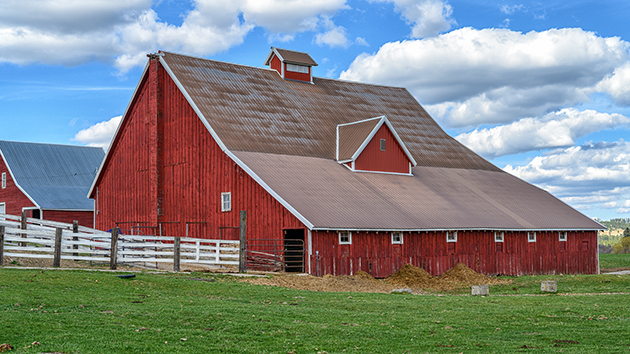
PhotoTitle: California Ranch
PhotoAttribution: Spokane City/County Historic Preservation Office
Listing Status: National Register
URL: http://properties.historicspokane.org/property/?PropertyID=1988
Display Marker: large_yellow
Title: California Ranch
Description: Date Built: 1864
Architect: Unknown
Common Name: Scott's Dairy
The California Ranch is the oldest continually occupied ranch in Spokane County, having been settled around 1864, some eight years before the arrival of the first "permanent" settlers. As the only established ranch along the Kentuck Trail between the Palouse and Spokane rivers in the 1860s, the ranch also served as an important way station and resting place for miners, packers, and early settlers passing through the region throughout the frontier period. In addition, the barn at the California Ranch exhibits remarkable architectural significance in its own right. The design, craftsmanship and materials used in this barn make it an outstanding example of early agricultural construction techniques.
Location: 47.558374, -117.195108
Address: 10700 South Jackson Road, Mica Washington 99023
PhotoURL:

PhotoTitle: California Ranch
PhotoAttribution: Spokane City/County Historic Preservation Office
Listing Status: National Register
URL: http://properties.historicspokane.org/property/?PropertyID=1988
Display Marker: large_yellow
ID: 39
Title: Cambern Dutch Shop Windmill
Description: Date Built: 1929
Architect: Charles R. Wood
Common Name: Lorien Herbs & Natural Foods
The Cambern Dutch Shop Windmill is a small commercial structure designed to evoke the form and character of a Dutch windmill. The shop is sited at a prominent intersection in a residential neighborhood on the south side of Spokane. Although residential in scale, the unusual form of the buildings is a striking architectural novelty in a neighborhood otherwise characterized by bungalows and cottages. The windmill is a frame structure composed of a one story, hipped roof, rectangular shop, and an octagonal tower to which is attached the four blades of the windmill. The windmill shop was a reflection of the expansion of the wholesale bakery and dairy established in Spokane in 1924 by the Cambern brothers.
Location: 47.64529, -117.39025
Address: 1102 South Perry Street, Spokane WA 99202
PhotoURL: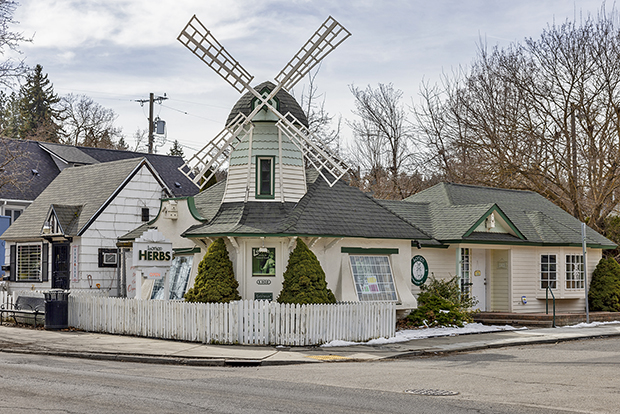
PhotoTitle: The Cambern Dutch Shop Windmill on a not so windy day
PhotoAttribution: Spokane City/County Historic Preservation Office
Listing Status: National Register
URL: http://properties.historicspokane.org/property/?PropertyID=1989
Display Marker: large_yellow
Title: Cambern Dutch Shop Windmill
Description: Date Built: 1929
Architect: Charles R. Wood
Common Name: Lorien Herbs & Natural Foods
The Cambern Dutch Shop Windmill is a small commercial structure designed to evoke the form and character of a Dutch windmill. The shop is sited at a prominent intersection in a residential neighborhood on the south side of Spokane. Although residential in scale, the unusual form of the buildings is a striking architectural novelty in a neighborhood otherwise characterized by bungalows and cottages. The windmill is a frame structure composed of a one story, hipped roof, rectangular shop, and an octagonal tower to which is attached the four blades of the windmill. The windmill shop was a reflection of the expansion of the wholesale bakery and dairy established in Spokane in 1924 by the Cambern brothers.
Location: 47.64529, -117.39025
Address: 1102 South Perry Street, Spokane WA 99202
PhotoURL:

PhotoTitle: The Cambern Dutch Shop Windmill on a not so windy day
PhotoAttribution: Spokane City/County Historic Preservation Office
Listing Status: National Register
URL: http://properties.historicspokane.org/property/?PropertyID=1989
Display Marker: large_yellow
ID: 40
Title: Campbell House
Description: Date Built: 1898
Architect: Kirtland Cutter and Malmgren
Common Name: Amasa B. Campbell House
The Campbell House was designed by Kirtland Cutter and Karl Malmgren and was built in 1898 for Amasa B. Campbell, his wife Grace, and their daughter Helen. Campbell made a fortune in mining exploration and operations in the Coeur d'Alene mining region northeast of Spokane. He partnered with John Finch, his neighbor living two houses to the west. Helen Campbell gave the Campbell House to the Eastern Washington State Historical Society in 1924. The house was later restored to serve as a historic home that operates in conjunction with the Northwest Museum of Arts & Culture. It is open for public tours and visitation.
Location: 47.656906, -117.446869
Address: 2316 West 1st Avenue, Spokane WA 99201
PhotoURL: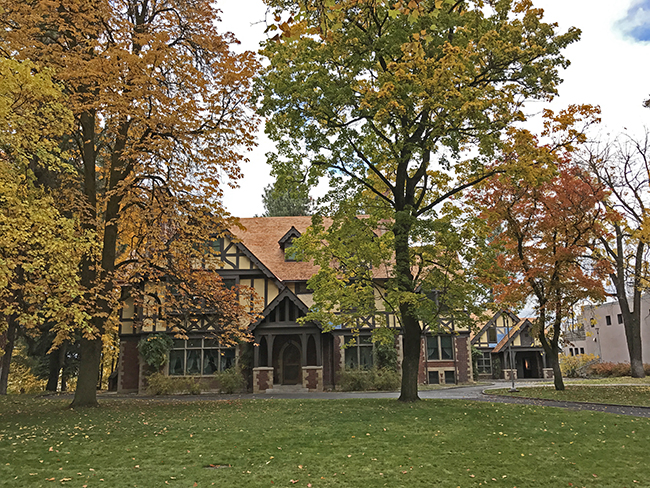
PhotoTitle: The Amasa B. Campbell House
PhotoAttribution: Spokane City/County Historic Preservation Office
Listing Status: Spokane Register, National Register
URL: http://properties.historicspokane.org/property/?PropertyID=1739
Display Marker: large_yellow
Title: Campbell House
Description: Date Built: 1898
Architect: Kirtland Cutter and Malmgren
Common Name: Amasa B. Campbell House
The Campbell House was designed by Kirtland Cutter and Karl Malmgren and was built in 1898 for Amasa B. Campbell, his wife Grace, and their daughter Helen. Campbell made a fortune in mining exploration and operations in the Coeur d'Alene mining region northeast of Spokane. He partnered with John Finch, his neighbor living two houses to the west. Helen Campbell gave the Campbell House to the Eastern Washington State Historical Society in 1924. The house was later restored to serve as a historic home that operates in conjunction with the Northwest Museum of Arts & Culture. It is open for public tours and visitation.
Location: 47.656906, -117.446869
Address: 2316 West 1st Avenue, Spokane WA 99201
PhotoURL:

PhotoTitle: The Amasa B. Campbell House
PhotoAttribution: Spokane City/County Historic Preservation Office
Listing Status: Spokane Register, National Register
URL: http://properties.historicspokane.org/property/?PropertyID=1739
Display Marker: large_yellow
ID: 41
Title: George and Nellie Canfield House
Description: Date Built: 1908
Architect: Unknown
Common Name: George and Nellie Canfield House
The George & Nellie Canfield House is a fine interpretation of the Arts & Crafts tradition executed in the Craftsman style. The house is distinguished from other homes of its style by the application of flared bargeboards and widely overhanging flared eaves that are embellished with unusual flared rafter tails that match the curve of the eaves. This design influence mimics rooflines of Japanese pagodas and was revered and adopted by Craftsman-style designers. The residence was erected for Spokane businessman and hydraulic engineer George S. Canfield and his wife Nellie, who maintained the property until George's death in 1921. The house is further significant as an example of the community planning and development that occurred in the early development and subsequent settlement of the Sherwood Addition in the Summit Boulevard neighborhood in northwest Spokane.
Location: 47.66918, -117.45688
Address: 1301 North Sherwood Street, Spokane WA 99201
PhotoURL: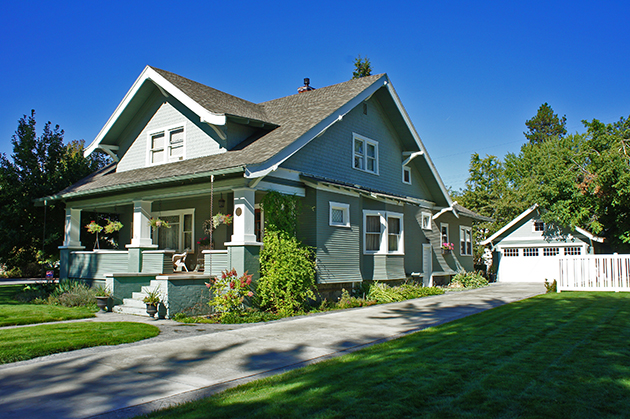
PhotoTitle: George and Nellie Canfield House
PhotoAttribution: Spokane City/County Historic Preservation Office
Listing Status: Spokane Register, National Register
URL: http://properties.historicspokane.org/property/?PropertyID=1740
Display Marker: large_yellow
Title: George and Nellie Canfield House
Description: Date Built: 1908
Architect: Unknown
Common Name: George and Nellie Canfield House
The George & Nellie Canfield House is a fine interpretation of the Arts & Crafts tradition executed in the Craftsman style. The house is distinguished from other homes of its style by the application of flared bargeboards and widely overhanging flared eaves that are embellished with unusual flared rafter tails that match the curve of the eaves. This design influence mimics rooflines of Japanese pagodas and was revered and adopted by Craftsman-style designers. The residence was erected for Spokane businessman and hydraulic engineer George S. Canfield and his wife Nellie, who maintained the property until George's death in 1921. The house is further significant as an example of the community planning and development that occurred in the early development and subsequent settlement of the Sherwood Addition in the Summit Boulevard neighborhood in northwest Spokane.
Location: 47.66918, -117.45688
Address: 1301 North Sherwood Street, Spokane WA 99201
PhotoURL:

PhotoTitle: George and Nellie Canfield House
PhotoAttribution: Spokane City/County Historic Preservation Office
Listing Status: Spokane Register, National Register
URL: http://properties.historicspokane.org/property/?PropertyID=1740
Display Marker: large_yellow
ID: 42
Title: Judge Henry and Alice Canfield House
Description: Date Built: 1911
Architect: Gus Bostrom
Common Name: Judge Henry and Alice Canfield House
The Judge & Alice Canfield House is a fine representation of the Craftsman Style expressed in the American Arts & Crafts tradition. The property reflects Craftsman-style details such as a side-gable roof, a full-width front porch covered by an extension of the principal roof and supported by massive porch piers and pillars, false half-timbering with stucco infill in the gable peaks, and use of natural organic building materials found in wood, stucco, brick, and indigenous black basalt rock. Gus Bostrom, an accomplished builder, built the house for Superior Court Judge Henry Ward Canfield and his wife Alice, who owned the property for more than 25 years until 1937. Historically and architecturally significant, the Judge Henry and Alice Canfield House is an example of the prescribed subdivision covenants written expressly to ensure successful and architecturally compatible residential development in the Cannon Hill Park Addition.
Location: 47.63569, -117.42197
Address: 628 West 21st Avenue, Spokane WA 99203
PhotoURL: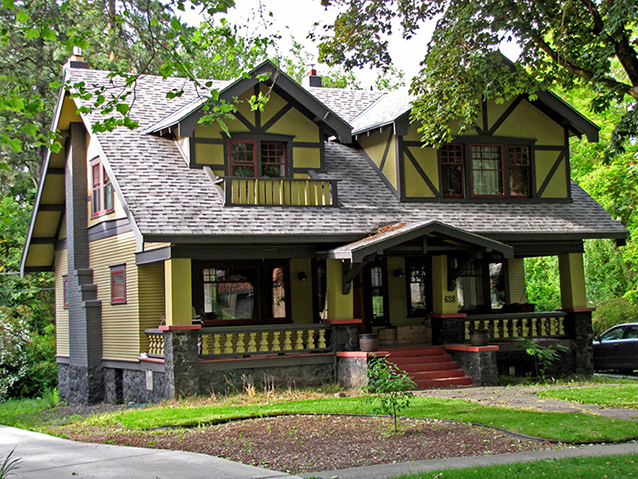
PhotoTitle: Judge Henry and Alice Canfield House
PhotoAttribution: Spokane City/County Historic Preservation Office
Listing Status: Spokane Register
URL: http://properties.historicspokane.org/property/?PropertyID=1741
Display Marker: large_yellow
Title: Judge Henry and Alice Canfield House
Description: Date Built: 1911
Architect: Gus Bostrom
Common Name: Judge Henry and Alice Canfield House
The Judge & Alice Canfield House is a fine representation of the Craftsman Style expressed in the American Arts & Crafts tradition. The property reflects Craftsman-style details such as a side-gable roof, a full-width front porch covered by an extension of the principal roof and supported by massive porch piers and pillars, false half-timbering with stucco infill in the gable peaks, and use of natural organic building materials found in wood, stucco, brick, and indigenous black basalt rock. Gus Bostrom, an accomplished builder, built the house for Superior Court Judge Henry Ward Canfield and his wife Alice, who owned the property for more than 25 years until 1937. Historically and architecturally significant, the Judge Henry and Alice Canfield House is an example of the prescribed subdivision covenants written expressly to ensure successful and architecturally compatible residential development in the Cannon Hill Park Addition.
Location: 47.63569, -117.42197
Address: 628 West 21st Avenue, Spokane WA 99203
PhotoURL:

PhotoTitle: Judge Henry and Alice Canfield House
PhotoAttribution: Spokane City/County Historic Preservation Office
Listing Status: Spokane Register
URL: http://properties.historicspokane.org/property/?PropertyID=1741
Display Marker: large_yellow
ID: 43
Title: Cannon House
Description: Date Built: 1911
Architect: Earl W. Morrison
Common Name: Edward & Helen Cannon House
The Edward and Helen Cannon Property was built for Edward J. Cannon, one of early Spokane's most noted lawyers, and his wife Helen. Lauded as "one of the brilliant members of the Spokane bar" at the time of his death in 1934, Cannon was also honored as a "model trial lawyer" by his peers, and was applauded for helping found and establish the Gonzaga University School of Law in 1912. The property, which includes the house, garage, front terrace/porch, and basalt rock retaining walls, is architecturally significant as an excellent example of the Colonial Revival style and as a product of Spokane architect and accomplished craftsman, Earl W. Morrison. The property represents specific building and development trends that led to prescribed residential settlement in the Rockwood neighborhood.
Location: 47.64351, -117.40467
Address: 416 East Rockwood Boulevard, Spokane WA 99202
PhotoURL: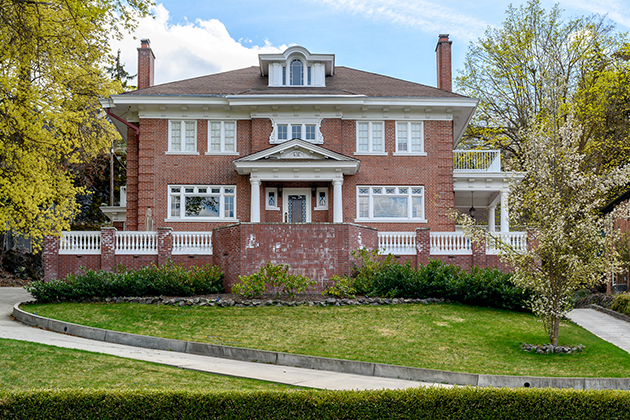
PhotoTitle: Edward and Helen Cannon House
PhotoAttribution: Spokane City/County Historic Preservation Office
Listing Status: Spokane Register, National Register
URL: http://properties.historicspokane.org/property/?PropertyID=1742
Display Marker: large_yellow
Title: Cannon House
Description: Date Built: 1911
Architect: Earl W. Morrison
Common Name: Edward & Helen Cannon House
The Edward and Helen Cannon Property was built for Edward J. Cannon, one of early Spokane's most noted lawyers, and his wife Helen. Lauded as "one of the brilliant members of the Spokane bar" at the time of his death in 1934, Cannon was also honored as a "model trial lawyer" by his peers, and was applauded for helping found and establish the Gonzaga University School of Law in 1912. The property, which includes the house, garage, front terrace/porch, and basalt rock retaining walls, is architecturally significant as an excellent example of the Colonial Revival style and as a product of Spokane architect and accomplished craftsman, Earl W. Morrison. The property represents specific building and development trends that led to prescribed residential settlement in the Rockwood neighborhood.
Location: 47.64351, -117.40467
Address: 416 East Rockwood Boulevard, Spokane WA 99202
PhotoURL:

PhotoTitle: Edward and Helen Cannon House
PhotoAttribution: Spokane City/County Historic Preservation Office
Listing Status: Spokane Register, National Register
URL: http://properties.historicspokane.org/property/?PropertyID=1742
Display Marker: large_yellow
ID: 44
Title: Carnegie Library East Side Branch
Description: Date Built: 1913
Architect: Albert Held
Common Name: East Side Library
The East Side Branch Library was built in 1913 with funds provided by United States philanthropist Andrew Carnegie, and is a tangible testament to his worldwide influence. The structure was designed by prominent Spokane architect Albert Held and was built by Spokane contractor Galbraith & Sons. For 66 years, the East Side Branch served the East Central Spokane community and residents in the Spokane Valley.
Location: 47.65656, -117.37487
Address: 25 South Altamont Street, Spokane WA 99202
PhotoURL: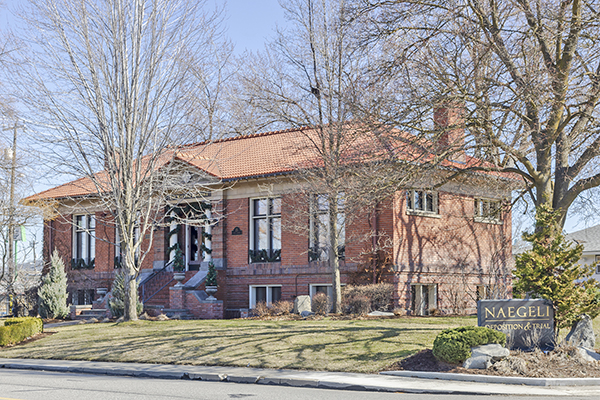
PhotoTitle: The Carnegie Library East Side Branch
PhotoAttribution: Spokane City/County Historic Preservation Office
Listing Status: Spokane Register, National Register
URL: http://properties.historicspokane.org/property/?PropertyID=1744
Display Marker: large_yellow
Title: Carnegie Library East Side Branch
Description: Date Built: 1913
Architect: Albert Held
Common Name: East Side Library
The East Side Branch Library was built in 1913 with funds provided by United States philanthropist Andrew Carnegie, and is a tangible testament to his worldwide influence. The structure was designed by prominent Spokane architect Albert Held and was built by Spokane contractor Galbraith & Sons. For 66 years, the East Side Branch served the East Central Spokane community and residents in the Spokane Valley.
Location: 47.65656, -117.37487
Address: 25 South Altamont Street, Spokane WA 99202
PhotoURL:

PhotoTitle: The Carnegie Library East Side Branch
PhotoAttribution: Spokane City/County Historic Preservation Office
Listing Status: Spokane Register, National Register
URL: http://properties.historicspokane.org/property/?PropertyID=1744
Display Marker: large_yellow
ID: 45
Title: Carnegie Library Heath Branch
Description: Date Built: 1914
Architect: Julius Zittel
Common Name: Sylvester Heath Library
The Heath Branch of the Carnegie Library is significant in the history of the Spokane Public Library system and served the surrounding community for nearly 70 years. Designed by prominent Spokane architect Julius Zittel, the Heath Branch also exhibits architectural significance.
Location: 47.67205, -117.40182
Address: 525 East Mission Avenue, Spokane WA 99202
PhotoURL: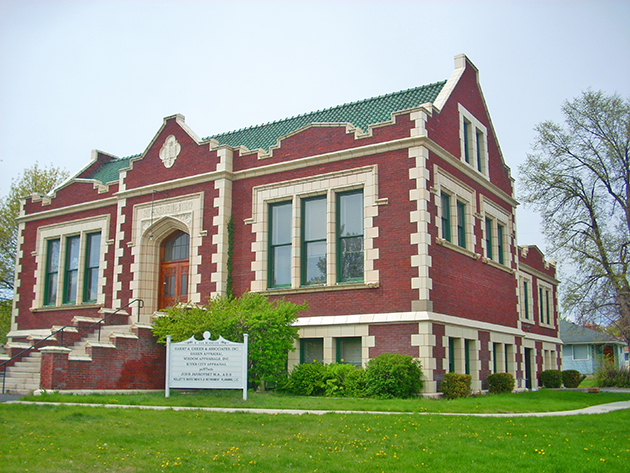
PhotoTitle: The Carnegie Library Heath Branch
PhotoAttribution: Spokane City/County Historic Preservation Office
Listing Status: Spokane Register, National Register
URL: http://properties.historicspokane.org/property/?PropertyID=1745
Display Marker: large_yellow
Title: Carnegie Library Heath Branch
Description: Date Built: 1914
Architect: Julius Zittel
Common Name: Sylvester Heath Library
The Heath Branch of the Carnegie Library is significant in the history of the Spokane Public Library system and served the surrounding community for nearly 70 years. Designed by prominent Spokane architect Julius Zittel, the Heath Branch also exhibits architectural significance.
Location: 47.67205, -117.40182
Address: 525 East Mission Avenue, Spokane WA 99202
PhotoURL:

PhotoTitle: The Carnegie Library Heath Branch
PhotoAttribution: Spokane City/County Historic Preservation Office
Listing Status: Spokane Register, National Register
URL: http://properties.historicspokane.org/property/?PropertyID=1745
Display Marker: large_yellow
ID: 46
Title: Carnegie Library Main Branch
Description: Date Built: 1904
Architect: Preusse and Julius Zittel
Common Name: Spokane Main Carnegie Library
Built in 1904, the Carnegie Library, Main Branch, was the first true library structure in the city, occupying an entire block at the east end of Browne's Addition. Philanthropist Andrew Carnegie funded construction of the building, and acclaimed Spokane architectural firm Preusse and Zittel designed it. The building is an excellent example of neo-classical styling, exhibiting several unique and well-preserved features. After over a decade of vacancy, Integrus Architects of Spokane renovated the building in the 1990s to serve as the firm's primary office building.
Location: 47.65677, -117.43315
Address: 10 South Cedar Street, Spokane WA 99201
PhotoURL: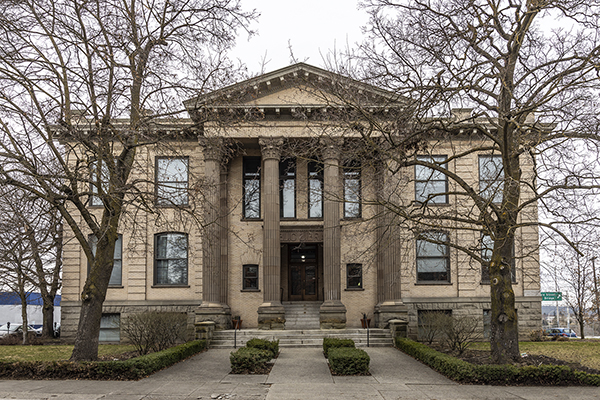
PhotoTitle: The Spokane Main Carnegie Library
PhotoAttribution: Spokane City/County Historic Preservation Office
Listing Status: Spokane Register, National Register
URL: http://properties.historicspokane.org/property/?PropertyID=1746
Display Marker: large_yellow
Title: Carnegie Library Main Branch
Description: Date Built: 1904
Architect: Preusse and Julius Zittel
Common Name: Spokane Main Carnegie Library
Built in 1904, the Carnegie Library, Main Branch, was the first true library structure in the city, occupying an entire block at the east end of Browne's Addition. Philanthropist Andrew Carnegie funded construction of the building, and acclaimed Spokane architectural firm Preusse and Zittel designed it. The building is an excellent example of neo-classical styling, exhibiting several unique and well-preserved features. After over a decade of vacancy, Integrus Architects of Spokane renovated the building in the 1990s to serve as the firm's primary office building.
Location: 47.65677, -117.43315
Address: 10 South Cedar Street, Spokane WA 99201
PhotoURL:

PhotoTitle: The Spokane Main Carnegie Library
PhotoAttribution: Spokane City/County Historic Preservation Office
Listing Status: Spokane Register, National Register
URL: http://properties.historicspokane.org/property/?PropertyID=1746
Display Marker: large_yellow
ID: 47
Title: Carnegie Library North Monroe Branch
Description: Date Built: 1914
Architect: Albert Held
Common Name: Carnegie Library, North Monroe Branch
The Carnegie Library, North Monroe Branch, was designed by noted Spokane architect Albert Held and built in 1914. In 1912, Andrew Carnegie promised $70,000 for construction of two permanent branches in Spokane. The Library Board and City Council disputed over where the new buildings should be located, and the compromise that emerged was that the money would be used for three branches. Of the original monetary designation, $17,500 was allocated for construction of the North Monroe Branch. The library served the local community until 1967, when the city sold the building to the local chapter of Veterans of Foreign Wars. The building was then used as a meeting hall, lounge, and bingo parlor.
Location: 47.67838, -117.42631
Address: 925 West Montgomery Avenue, Spokane WA 99205
PhotoURL: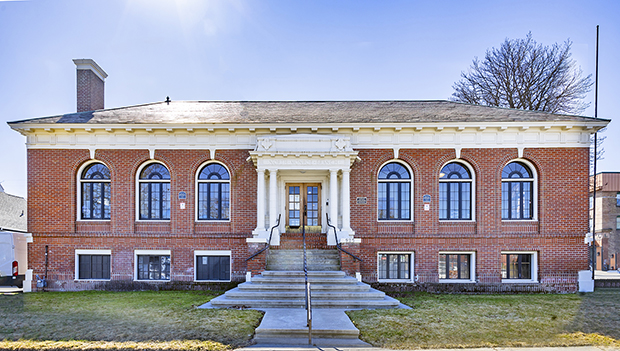
PhotoTitle: The Carnegie Library North Monroe Branch
PhotoAttribution: Spokane City/County Historic Preservation Office
Listing Status: Spokane Register, National Register
URL: http://properties.historicspokane.org/property/?PropertyID=1747
Display Marker: large_yellow
Title: Carnegie Library North Monroe Branch
Description: Date Built: 1914
Architect: Albert Held
Common Name: Carnegie Library, North Monroe Branch
The Carnegie Library, North Monroe Branch, was designed by noted Spokane architect Albert Held and built in 1914. In 1912, Andrew Carnegie promised $70,000 for construction of two permanent branches in Spokane. The Library Board and City Council disputed over where the new buildings should be located, and the compromise that emerged was that the money would be used for three branches. Of the original monetary designation, $17,500 was allocated for construction of the North Monroe Branch. The library served the local community until 1967, when the city sold the building to the local chapter of Veterans of Foreign Wars. The building was then used as a meeting hall, lounge, and bingo parlor.
Location: 47.67838, -117.42631
Address: 925 West Montgomery Avenue, Spokane WA 99205
PhotoURL:

PhotoTitle: The Carnegie Library North Monroe Branch
PhotoAttribution: Spokane City/County Historic Preservation Office
Listing Status: Spokane Register, National Register
URL: http://properties.historicspokane.org/property/?PropertyID=1747
Display Marker: large_yellow
ID: 48
Title: Carson-Clemmer-Larrabee House
Description: Date Built: 1905
Architect: John K. Dow
Common Name: Carson-Clemmer-Larrabee House
Constructed in 1905 on Spokane's South Hill, the Carson-Clemmer-Larrabee House is both architecturally and historically significant. A highly unusual local example of the Carpenter Gothic style, the house was designed by prominent Spokane architect John K. Dow for Maida Carson, a widow. Subsequent owners included Dr. Harold Clemmer, the dentist and entrepreneur who brought Spokane the Clemmer Theater (now the Met), as well as the Larrabee family, whose members played major roles in the mining and coal industries in the Inland Northwest.
Location: 47.64804, -117.42416
Address: 811 South Lincoln Street, Spokane WA 99204
PhotoURL: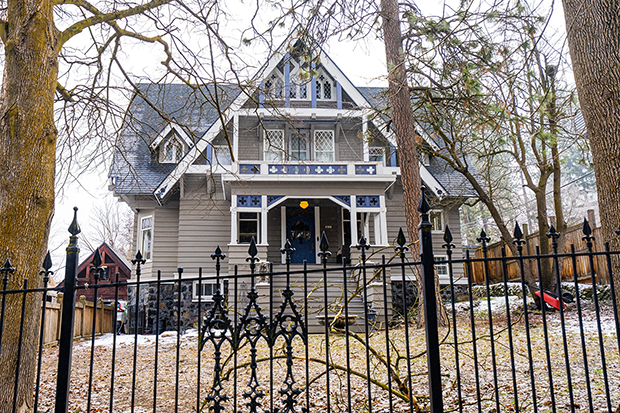
PhotoTitle: Maida Carson-Harold Clemmer-Larrabee House
PhotoAttribution: Spokane City/County Historic Preservation Office
Listing Status: Spokane Register
URL: http://properties.historicspokane.org/property/?PropertyID=1748
Display Marker: large_yellow
Title: Carson-Clemmer-Larrabee House
Description: Date Built: 1905
Architect: John K. Dow
Common Name: Carson-Clemmer-Larrabee House
Constructed in 1905 on Spokane's South Hill, the Carson-Clemmer-Larrabee House is both architecturally and historically significant. A highly unusual local example of the Carpenter Gothic style, the house was designed by prominent Spokane architect John K. Dow for Maida Carson, a widow. Subsequent owners included Dr. Harold Clemmer, the dentist and entrepreneur who brought Spokane the Clemmer Theater (now the Met), as well as the Larrabee family, whose members played major roles in the mining and coal industries in the Inland Northwest.
Location: 47.64804, -117.42416
Address: 811 South Lincoln Street, Spokane WA 99204
PhotoURL:

PhotoTitle: Maida Carson-Harold Clemmer-Larrabee House
PhotoAttribution: Spokane City/County Historic Preservation Office
Listing Status: Spokane Register
URL: http://properties.historicspokane.org/property/?PropertyID=1748
Display Marker: large_yellow
ID: 49
Title: Cascade Laundry Company
Description: Date Built: 1913
Architect: Loren L. Rand
Common Name: Riverwalk
Built in 1913, The Cascade Laundry Company, a two-story brick and concrete industrial building that lies parallel to the Spokane River, is a prominent structure on East Trent Avenue. Located immediately west of the Trent Avenue Bridge, the building sits at the juncture of east Spokane's industrial sites and downtown commercial and institutional uses. The Cascade Laundry Company building's basic form is rectangular, made irregular with a triangular front-facing office section, and a one-story wood-framed masonry annex located on the southeast elevation. A notable feature of the Cascade Laundry Company building is the large red brick piers framing divisions at the building's corners and offset entry. The exterior of both the small structure and its connecting section consists of red brick laid in common bond, with a concrete band below the cornice at eye level.
Location: 47.66266, -117.39441
Address: 1003 East Trent Avenue, Spokane WA 99202
PhotoURL: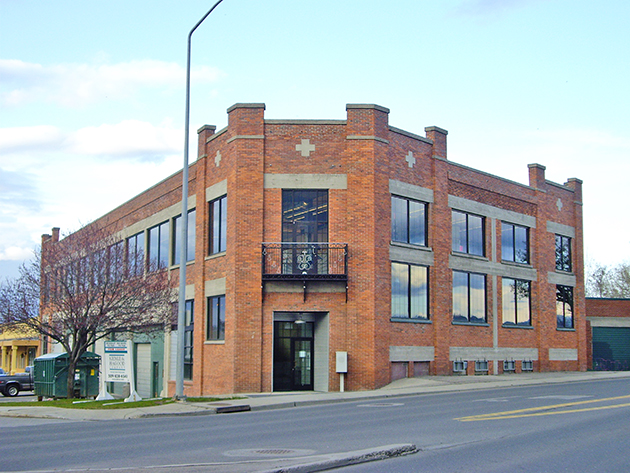
PhotoTitle: The Cascade Laundry Company
PhotoAttribution: Spokane City/County Historic Preservation Office
Listing Status: Spokane Register
URL: http://properties.historicspokane.org/property/?PropertyID=1990
Display Marker: large_yellow
Title: Cascade Laundry Company
Description: Date Built: 1913
Architect: Loren L. Rand
Common Name: Riverwalk
Built in 1913, The Cascade Laundry Company, a two-story brick and concrete industrial building that lies parallel to the Spokane River, is a prominent structure on East Trent Avenue. Located immediately west of the Trent Avenue Bridge, the building sits at the juncture of east Spokane's industrial sites and downtown commercial and institutional uses. The Cascade Laundry Company building's basic form is rectangular, made irregular with a triangular front-facing office section, and a one-story wood-framed masonry annex located on the southeast elevation. A notable feature of the Cascade Laundry Company building is the large red brick piers framing divisions at the building's corners and offset entry. The exterior of both the small structure and its connecting section consists of red brick laid in common bond, with a concrete band below the cornice at eye level.
Location: 47.66266, -117.39441
Address: 1003 East Trent Avenue, Spokane WA 99202
PhotoURL:

PhotoTitle: The Cascade Laundry Company
PhotoAttribution: Spokane City/County Historic Preservation Office
Listing Status: Spokane Register
URL: http://properties.historicspokane.org/property/?PropertyID=1990
Display Marker: large_yellow
ID: 50
Title: Cedars Apartments
Description: Date Built: 1911
Architect: Ehwald J. Baum
Common Name: Cedars Apartments
Reminiscent of large, rambling baronial manor halls built throughout the English countryside, the Cedars Apartments was built in 1911, and is an exemplary, artful expression of Tudor Revival styling adapted to a multi-family apartment house. A steeply pitched red tile roof, seven front-facing gables, clinker brick cladding, false half-timbering, and rich ebony-finished woodwork are a few of the building's architectural elements that are indigenous to the Tudor Revival style. Designed as a luxury apartment block with multiple rooms in each apartment suite, the Cedars Apartments was pictured in a 1911 Spokesman-Review newspaper article that described the building as "attractive English apartments." Designed by Ehwald J. Baum, the building was constructed for Hattie Jane Parsons, a "long time resident of Spokane" who was "prominent in community business circles." Well preserved, the Cedars Apartments has operated as a multi-family residence for nearly 100 years.
Location: 47.65118, -117.43295
Address: 508 South Cedar Street, Spokane WA 99204
PhotoURL: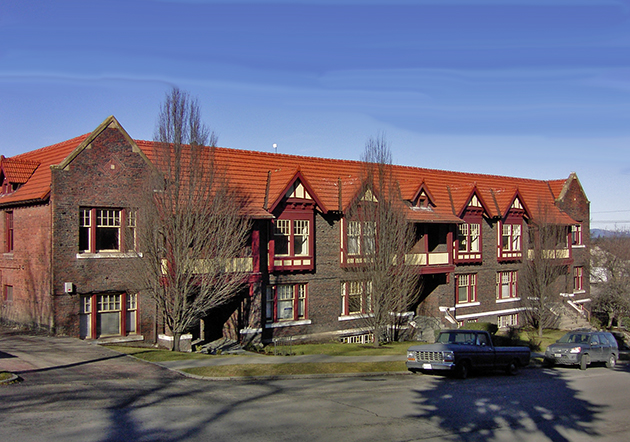
PhotoTitle: The Cedars Apartments
PhotoAttribution: Spokane City/County Historic Preservation Office
Listing Status: Spokane Register
URL: http://properties.historicspokane.org/property/?PropertyID=1750
Display Marker: large_yellow
Title: Cedars Apartments
Description: Date Built: 1911
Architect: Ehwald J. Baum
Common Name: Cedars Apartments
Reminiscent of large, rambling baronial manor halls built throughout the English countryside, the Cedars Apartments was built in 1911, and is an exemplary, artful expression of Tudor Revival styling adapted to a multi-family apartment house. A steeply pitched red tile roof, seven front-facing gables, clinker brick cladding, false half-timbering, and rich ebony-finished woodwork are a few of the building's architectural elements that are indigenous to the Tudor Revival style. Designed as a luxury apartment block with multiple rooms in each apartment suite, the Cedars Apartments was pictured in a 1911 Spokesman-Review newspaper article that described the building as "attractive English apartments." Designed by Ehwald J. Baum, the building was constructed for Hattie Jane Parsons, a "long time resident of Spokane" who was "prominent in community business circles." Well preserved, the Cedars Apartments has operated as a multi-family residence for nearly 100 years.
Location: 47.65118, -117.43295
Address: 508 South Cedar Street, Spokane WA 99204
PhotoURL:

PhotoTitle: The Cedars Apartments
PhotoAttribution: Spokane City/County Historic Preservation Office
Listing Status: Spokane Register
URL: http://properties.historicspokane.org/property/?PropertyID=1750
Display Marker: large_yellow
ID: 51
Title: Central Schoolhouse, District 49
Description: Date Built: 1913
Architect: R. C. Tapley and J. M. Starkey
Common Name: Central Schoolhouse, District 49
This one-room schoolhouse has served as a focal point for both educational and social activities in northwest Spokane County since the turn of the twentieth century. At the time of construction in 1900, there were a number of other one-room schoolhouses in the area, but this is the only one from that time that remains. The building served as a school continuously until 1956 when students at Central School were consolidated with those at Reardan. The Coulee Township acquired the building in 1958 as a meeting house, and today the building is owned by the West Greenwood Cemetery District No. 2 and serves as a center for community gatherings and events.
Location: 47.78867, -117.71316
Address: 22080 4 Mound Road, Nine Mile Falls WA 99026
PhotoURL: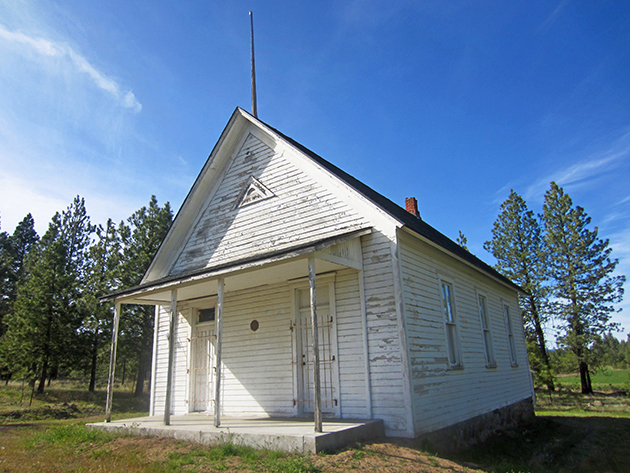
PhotoTitle: District 49 Central Schoolhouse
PhotoAttribution: Spokane City/County Historic Preservation Office
Listing Status: Spokane Register, National Register
URL: http://properties.historicspokane.org/property/?PropertyID=1751
Display Marker: large_yellow
Title: Central Schoolhouse, District 49
Description: Date Built: 1913
Architect: R. C. Tapley and J. M. Starkey
Common Name: Central Schoolhouse, District 49
This one-room schoolhouse has served as a focal point for both educational and social activities in northwest Spokane County since the turn of the twentieth century. At the time of construction in 1900, there were a number of other one-room schoolhouses in the area, but this is the only one from that time that remains. The building served as a school continuously until 1956 when students at Central School were consolidated with those at Reardan. The Coulee Township acquired the building in 1958 as a meeting house, and today the building is owned by the West Greenwood Cemetery District No. 2 and serves as a center for community gatherings and events.
Location: 47.78867, -117.71316
Address: 22080 4 Mound Road, Nine Mile Falls WA 99026
PhotoURL:

PhotoTitle: District 49 Central Schoolhouse
PhotoAttribution: Spokane City/County Historic Preservation Office
Listing Status: Spokane Register, National Register
URL: http://properties.historicspokane.org/property/?PropertyID=1751
Display Marker: large_yellow
ID: 52
Title: Central Steam Heat Plant
Description: Date Built: 1916
Architect: Kirtland Cutter and Malmgren
Common Name: Steam Plant Square
One of Spokane's most prominent skyline features, the Central Steam Heat Plant, with its graceful twin smokestacks, is historically significant for its role in the evolution of the power industry in the Inland Northwest, and its seventy-year contribution to sustaining a major share of downtown Spokane's buildings. Built in 1916, it provided heating to more than 300 Central Business District (CBD) structures. Designed by renowned Spokane architects Cutter & Malmgren, the Steam Plant's architecture is notable both for its engineering and design. It exhibits particular quality in its construction and attention to finished detail. The equipment was innovative in the Inland Northwest in 1916, when it began operation. Representative of an enterprise common but frequently short-lived in a number of cities across the northern states, the plant underwent a series of changes in the generation of heat and power and remained operational until 1986. After a period of vacancy it was renovated and reopened as Steam Plant Square, offering unique restaurant, office, and commercial spaces.
Location: 47.65522, -117.42438
Address: 823 West Railroad Avenue Spokane WA 99201
PhotoURL: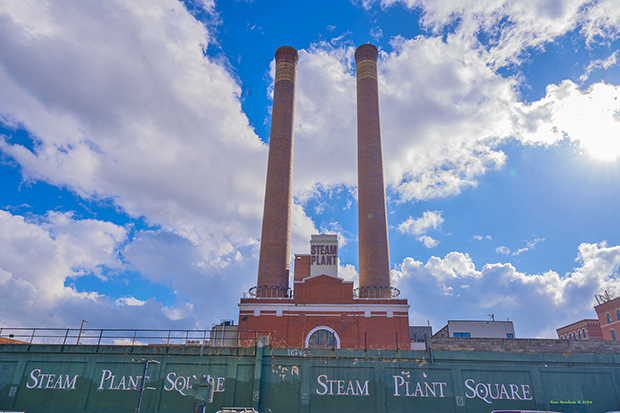
PhotoTitle: The Central Steam Heat Plant
PhotoAttribution: Spokane City/County Historic Preservation Office
Listing Status: Spokane Register, National Register
URL: http://properties.historicspokane.org/property/?PropertyID=1950
Display Marker: large_yellow
Title: Central Steam Heat Plant
Description: Date Built: 1916
Architect: Kirtland Cutter and Malmgren
Common Name: Steam Plant Square
One of Spokane's most prominent skyline features, the Central Steam Heat Plant, with its graceful twin smokestacks, is historically significant for its role in the evolution of the power industry in the Inland Northwest, and its seventy-year contribution to sustaining a major share of downtown Spokane's buildings. Built in 1916, it provided heating to more than 300 Central Business District (CBD) structures. Designed by renowned Spokane architects Cutter & Malmgren, the Steam Plant's architecture is notable both for its engineering and design. It exhibits particular quality in its construction and attention to finished detail. The equipment was innovative in the Inland Northwest in 1916, when it began operation. Representative of an enterprise common but frequently short-lived in a number of cities across the northern states, the plant underwent a series of changes in the generation of heat and power and remained operational until 1986. After a period of vacancy it was renovated and reopened as Steam Plant Square, offering unique restaurant, office, and commercial spaces.
Location: 47.65522, -117.42438
Address: 823 West Railroad Avenue Spokane WA 99201
PhotoURL:

PhotoTitle: The Central Steam Heat Plant
PhotoAttribution: Spokane City/County Historic Preservation Office
Listing Status: Spokane Register, National Register
URL: http://properties.historicspokane.org/property/?PropertyID=1950
Display Marker: large_yellow
ID: 53
Title: Chamberlin House
Description: Date Built: 1903
Architect: William Ballard
Common Name: Gilbert & Annie Chamberlin House
The Gilbert & Annie Chamberlin House is an excellent representation of the Free Classic Queen Anne style demonstrated in the home's pitched roof, multiple cross gables, beveled and boxed bays, corner boards and sunburst designs, a prominent facade gable, recessed balcony, and a full-width front porch. Chamberlin Real Estate & Improvement Company built the house for Annie Wickersham Chamberlin and her husband, Gilbert Lewis Chamberlin, the founder and president of the company. The house is architecturally significant for its well-preserved representation of the Free Classic Queen Anne style, and as a product of accomplished professionals W.J. Ballard and Chamberlin Real Estate & Improvement Company.
Location: 47.66683, -117.45095
Address: 2627 West Gardner Avenue, Spokane WA 99201
PhotoURL: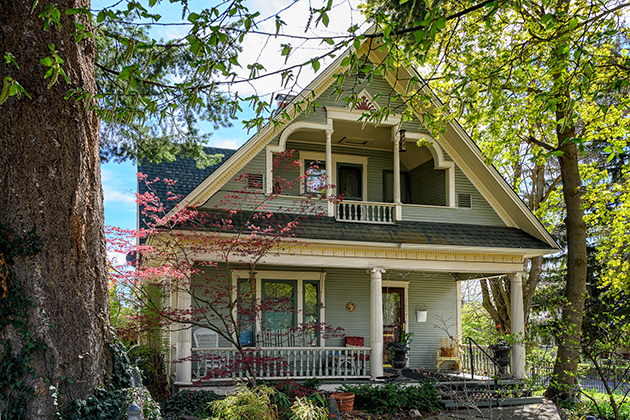
PhotoTitle: Gilbert and Annie Chamberlin House
PhotoAttribution: Spokane City/County Historic Preservation Office
Listing Status: Spokane Register, National Register
URL: http://properties.historicspokane.org/property/?PropertyID=1752
Display Marker: large_yellow
Title: Chamberlin House
Description: Date Built: 1903
Architect: William Ballard
Common Name: Gilbert & Annie Chamberlin House
The Gilbert & Annie Chamberlin House is an excellent representation of the Free Classic Queen Anne style demonstrated in the home's pitched roof, multiple cross gables, beveled and boxed bays, corner boards and sunburst designs, a prominent facade gable, recessed balcony, and a full-width front porch. Chamberlin Real Estate & Improvement Company built the house for Annie Wickersham Chamberlin and her husband, Gilbert Lewis Chamberlin, the founder and president of the company. The house is architecturally significant for its well-preserved representation of the Free Classic Queen Anne style, and as a product of accomplished professionals W.J. Ballard and Chamberlin Real Estate & Improvement Company.
Location: 47.66683, -117.45095
Address: 2627 West Gardner Avenue, Spokane WA 99201
PhotoURL:

PhotoTitle: Gilbert and Annie Chamberlin House
PhotoAttribution: Spokane City/County Historic Preservation Office
Listing Status: Spokane Register, National Register
URL: http://properties.historicspokane.org/property/?PropertyID=1752
Display Marker: large_yellow
ID: 54
Title: Chandler-Meadors-Anderson House
Description: Date Built: 1922
Architect: M. Randolph Smith
Common Name: The Chandler Sisters House
Built in 1922, the Chandler-Meadors-Anderson House is a fine example of the American Foursquare form. The house was designed by prominent award-winning Spokane architect and builder M. Randolph Smith, and erected for three sisters who lived in the home from 1923-1960. Louise Chandler Anderson, one of the three Chandler sisters, achieved particular historic significance in the community from 1915 to 1956 as a leading educator, department head, and professor emeritus at Eastern Washington University where she made a monumental contribution to the college and to education in the state of Washington.
Location: 47.62706, -117.40691
Address: 3003 South Manito Boulevard, Spokane WA 99203
PhotoURL: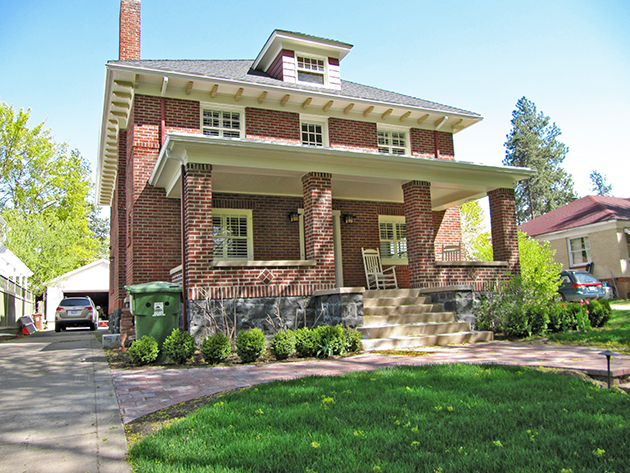
PhotoTitle: The Chandler Sisters House
PhotoAttribution: Spokane City/County Historic Preservation Office
Listing Status: Spokane Register, National Register
URL: http://properties.historicspokane.org/property/?PropertyID=1753
Display Marker: large_yellow
Title: Chandler-Meadors-Anderson House
Description: Date Built: 1922
Architect: M. Randolph Smith
Common Name: The Chandler Sisters House
Built in 1922, the Chandler-Meadors-Anderson House is a fine example of the American Foursquare form. The house was designed by prominent award-winning Spokane architect and builder M. Randolph Smith, and erected for three sisters who lived in the home from 1923-1960. Louise Chandler Anderson, one of the three Chandler sisters, achieved particular historic significance in the community from 1915 to 1956 as a leading educator, department head, and professor emeritus at Eastern Washington University where she made a monumental contribution to the college and to education in the state of Washington.
Location: 47.62706, -117.40691
Address: 3003 South Manito Boulevard, Spokane WA 99203
PhotoURL:

PhotoTitle: The Chandler Sisters House
PhotoAttribution: Spokane City/County Historic Preservation Office
Listing Status: Spokane Register, National Register
URL: http://properties.historicspokane.org/property/?PropertyID=1753
Display Marker: large_yellow
ID: 55
Title: Christensen House
Description: Date Built: 1926
Architect: John E. Anderson
Common Name: George & Blanche Christensen House
The George & Blanche Christensen House was built in 1926 on the edge of a steep bluff in the prominent, tree-lined Rockwood Terrace Addition. Mimicking style elements borrowed from medieval architecture and reminiscent of the whimsical dwellings and cozy cottages illustrated in children's nursery rhymes and storybooks of the 1920s, the Christensen House is an eclectic mix of Tudor Revival and Storybook styling. Characteristic architectural features include the home's irregular rambling footprint, steeply pitched roof with multiple lower cross gables, pointed and flared gable peak crockets, a front-facing full-height tapered brick chimney, an arched recessed front entrance, smooth stucco wall cladding, and leaded-glass casement windows. Celebrated Spokane craftsman and stone/brick mason John Anderson built the home for Blanche and George Christensen, the president and general manager for Western Piggly Wiggly grocery stores in the area.
Location: 47.63589, -117.39035
Address: 1329 East Overbluff Road, Spokane WA 99203
PhotoURL: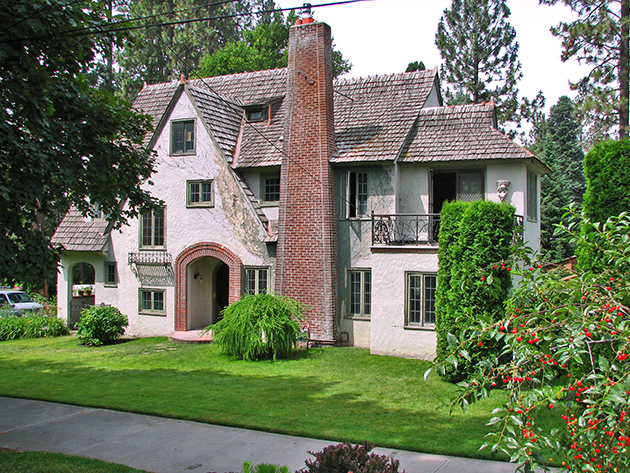
PhotoTitle: George and Blanche Christensen House
PhotoAttribution: Spokane City/County Historic Preservation Office
Listing Status: Spokane Register
URL: http://properties.historicspokane.org/property/?PropertyID=1754
Display Marker: large_yellow
Title: Christensen House
Description: Date Built: 1926
Architect: John E. Anderson
Common Name: George & Blanche Christensen House
The George & Blanche Christensen House was built in 1926 on the edge of a steep bluff in the prominent, tree-lined Rockwood Terrace Addition. Mimicking style elements borrowed from medieval architecture and reminiscent of the whimsical dwellings and cozy cottages illustrated in children's nursery rhymes and storybooks of the 1920s, the Christensen House is an eclectic mix of Tudor Revival and Storybook styling. Characteristic architectural features include the home's irregular rambling footprint, steeply pitched roof with multiple lower cross gables, pointed and flared gable peak crockets, a front-facing full-height tapered brick chimney, an arched recessed front entrance, smooth stucco wall cladding, and leaded-glass casement windows. Celebrated Spokane craftsman and stone/brick mason John Anderson built the home for Blanche and George Christensen, the president and general manager for Western Piggly Wiggly grocery stores in the area.
Location: 47.63589, -117.39035
Address: 1329 East Overbluff Road, Spokane WA 99203
PhotoURL:

PhotoTitle: George and Blanche Christensen House
PhotoAttribution: Spokane City/County Historic Preservation Office
Listing Status: Spokane Register
URL: http://properties.historicspokane.org/property/?PropertyID=1754
Display Marker: large_yellow
ID: 56
Title: City Ramp Garage
Description: Date Built: 1928
Architect: Harold Whitehouse
Common Name: City Ramp Garage
The City Ramp Garage in downtown Spokane, Washington was built in 1928 as the first multi-level, staggered-floor, ramp-type parking garage in the city. Originally constructed to house more than 350 automobiles, it is a six-story-and-basement fireproof reinforced concrete structure with a flat roof, a large recessed drive-in garage lobby, gasoline pumps and pump islands, and parking stalls built in the basement and upper floors.
Location: 47.65687, -117.41917
Address: 430 West 1st Avenue, Spokane WA 99201
PhotoURL: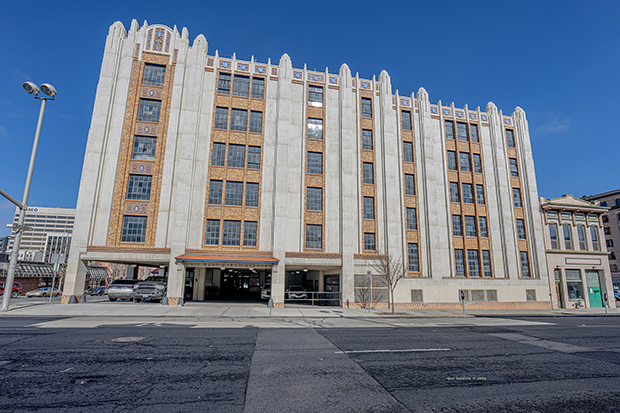
PhotoTitle: The City Ramp Garage
PhotoAttribution: Spokane City/County Historic Preservation Office
Listing Status: Spokane Register, National Register
URL: http://properties.historicspokane.org/property/?PropertyID=2040
Display Marker: large_yellow
Title: City Ramp Garage
Description: Date Built: 1928
Architect: Harold Whitehouse
Common Name: City Ramp Garage
The City Ramp Garage in downtown Spokane, Washington was built in 1928 as the first multi-level, staggered-floor, ramp-type parking garage in the city. Originally constructed to house more than 350 automobiles, it is a six-story-and-basement fireproof reinforced concrete structure with a flat roof, a large recessed drive-in garage lobby, gasoline pumps and pump islands, and parking stalls built in the basement and upper floors.
Location: 47.65687, -117.41917
Address: 430 West 1st Avenue, Spokane WA 99201
PhotoURL:

PhotoTitle: The City Ramp Garage
PhotoAttribution: Spokane City/County Historic Preservation Office
Listing Status: Spokane Register, National Register
URL: http://properties.historicspokane.org/property/?PropertyID=2040
Display Marker: large_yellow
ID: 57
Title: Clark House
Description: Date Built: 1903
Architect: Unknown
Common Name: George and Clara Clark House
Constructed in 1903, the George and Clara Clark House was built during the first phase of single-family construction along East Mission Avenue, between the 200 and 800 block, what is today identified as the Mission Avenue National Historic District. In 1986, the Clark House was designated as a contributing historic resource of the Mission Avenue District. The Clark House is an excellent example of the Free Classic Queen Anne style. The Clark House was constructed for George E. Clark, secretary/treasurer of the Spokane Casket Company that was located in Peaceful Valley and owned by the Smith Funeral Company, a pioneer firm in Spokane. F.W. Grace Harrington later acquired the property in the late 1910s. The Clark House achieved historic significance for its association with the architectural development and settlement of the Logan Neighborhood, specifically along East Mission Avenue, and is additionally architecturally significant as an example of the Free Classic Queen Anne style.
Location: 47.67205, -117.40232
Address: 511 East Mission Avenue, Spokane WA 99202
PhotoURL: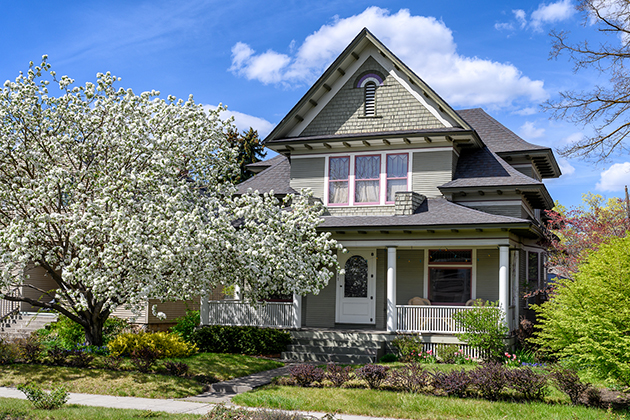
PhotoTitle: George and Clara Clark House
PhotoAttribution: Spokane City/County Historic Preservation Office
Listing Status: Spokane Register, National Register
URL: http://properties.historicspokane.org/property/?PropertyID=1755
Display Marker: large_yellow
Title: Clark House
Description: Date Built: 1903
Architect: Unknown
Common Name: George and Clara Clark House
Constructed in 1903, the George and Clara Clark House was built during the first phase of single-family construction along East Mission Avenue, between the 200 and 800 block, what is today identified as the Mission Avenue National Historic District. In 1986, the Clark House was designated as a contributing historic resource of the Mission Avenue District. The Clark House is an excellent example of the Free Classic Queen Anne style. The Clark House was constructed for George E. Clark, secretary/treasurer of the Spokane Casket Company that was located in Peaceful Valley and owned by the Smith Funeral Company, a pioneer firm in Spokane. F.W. Grace Harrington later acquired the property in the late 1910s. The Clark House achieved historic significance for its association with the architectural development and settlement of the Logan Neighborhood, specifically along East Mission Avenue, and is additionally architecturally significant as an example of the Free Classic Queen Anne style.
Location: 47.67205, -117.40232
Address: 511 East Mission Avenue, Spokane WA 99202
PhotoURL:

PhotoTitle: George and Clara Clark House
PhotoAttribution: Spokane City/County Historic Preservation Office
Listing Status: Spokane Register, National Register
URL: http://properties.historicspokane.org/property/?PropertyID=1755
Display Marker: large_yellow
ID: 58
Title: Clemmer Theater
Description: Date Built: 1915
Architect: E. W. Houghton and Kirtland Cutter
Common Name: Bing Crosby Theater
Excavation for this theater, built by mining magnate August Paulsen, began March 3, 1914. Known as both the Lincoln Theater and the Paulsen Theater during construction, the building became better known under the name of its first lessee, Dr. Howard S. Clemmer, a former dentist who recognized the potential of motion pictures through his father's work in the movie business. The Clemmer Theater opened for business February 22, 1915, and operated under that name until Ray Grombacher purchased it and renamed it the Audian in 1930. In 1932, it reopened as the State Theater, the name it bore until 1985. The Met, as it is currently known, features live performances and serves as the home of the Spokane Opera. The theater was not limited to motion picture features; Bing Crosby gave his last Spokane appearance at the Clemmer before going to Hollywood. In 1964-65, "Sound of Music" played for 54 straight weeks, the Spokane record for the longest-run motion picture. The English-born architect, E. W. Houghton, was well known for his theater and hotel design; his other works include the Seattle Opera House and the Rainier Hotel. Spokane's premier architect, Kirtland Cutter, served as the site architect for the building.
Location: 47.65696, -117.42538
Address: 901 West Sprague Avenue, Spokane WA 99201
PhotoURL: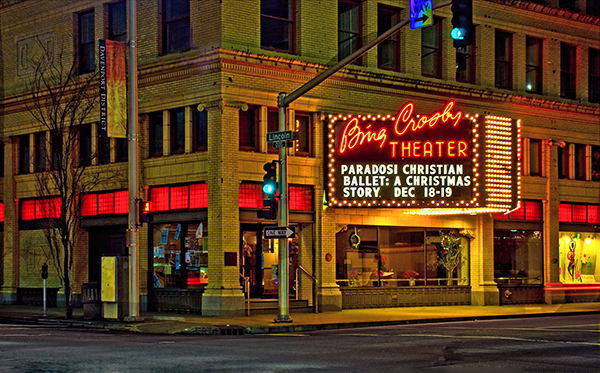
PhotoTitle: The Clemmer Theater now known as the Bing
PhotoAttribution: Spokane City/County Historic Preservation Office
Listing Status: Spokane Register, National Register
URL: http://properties.historicspokane.org/property/?PropertyID=1757
Display Marker: large_yellow
Title: Clemmer Theater
Description: Date Built: 1915
Architect: E. W. Houghton and Kirtland Cutter
Common Name: Bing Crosby Theater
Excavation for this theater, built by mining magnate August Paulsen, began March 3, 1914. Known as both the Lincoln Theater and the Paulsen Theater during construction, the building became better known under the name of its first lessee, Dr. Howard S. Clemmer, a former dentist who recognized the potential of motion pictures through his father's work in the movie business. The Clemmer Theater opened for business February 22, 1915, and operated under that name until Ray Grombacher purchased it and renamed it the Audian in 1930. In 1932, it reopened as the State Theater, the name it bore until 1985. The Met, as it is currently known, features live performances and serves as the home of the Spokane Opera. The theater was not limited to motion picture features; Bing Crosby gave his last Spokane appearance at the Clemmer before going to Hollywood. In 1964-65, "Sound of Music" played for 54 straight weeks, the Spokane record for the longest-run motion picture. The English-born architect, E. W. Houghton, was well known for his theater and hotel design; his other works include the Seattle Opera House and the Rainier Hotel. Spokane's premier architect, Kirtland Cutter, served as the site architect for the building.
Location: 47.65696, -117.42538
Address: 901 West Sprague Avenue, Spokane WA 99201
PhotoURL:

PhotoTitle: The Clemmer Theater now known as the Bing
PhotoAttribution: Spokane City/County Historic Preservation Office
Listing Status: Spokane Register, National Register
URL: http://properties.historicspokane.org/property/?PropertyID=1757
Display Marker: large_yellow
ID: 59
Title: Cohen House
Description: Date Built: 1911
Architect: Unknown
Common Name: Ralph & Ella Belle Cohen House
The Ralph & Ella Belle Cohen House is architecturally significant as an excellent interpretation of the Craftsman style. The home demonstrates trademark features of the Craftsman aesthetic, including an accentuated horizontal emphasis and the use of organically integrated building materials. These features are evident in widely overhanging eaves that cast horizontal shadows on the planar wall surface of the house, exposed rafter tails, a wide front porch, a combination of irregular black basalt rock/course, stucco/narrow width wood clapboard siding, decorative horizontal bands that separate exterior cladding materials, and original 1/1 and multi-paned windows. A fine blend of outdoor living and indoor open spaces, the design for the Cohen House epitomizes the Craftsman ideal with a large great room for living and dining that extends outside to a spacious covered front porch. Constructed for investor and mortgage broker Ralph Cohen and his wife, Ella Belle Cohen, the house was one of the first built in the Cannon Hill park neighborhood. The house reflects early twentieth century building and development trends associated with prominent residential neighborhoods in early Spokane.
Location: 47.63654, -117.41787
Address: 426 West Shoshone Place, Spokane WA 99203
PhotoURL: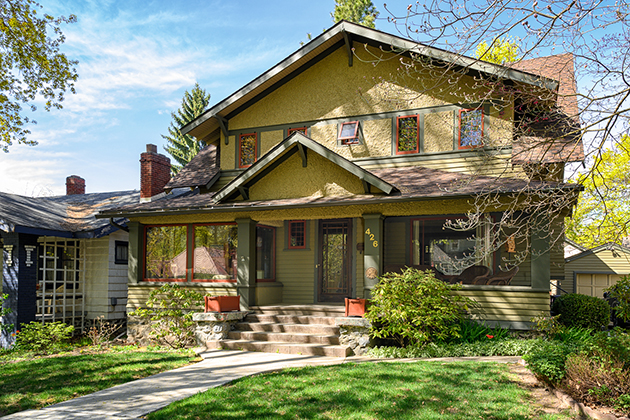
PhotoTitle: Ralph and Ella Belle Cohen House
PhotoAttribution: Spokane City/County Historic Preservation Office
Listing Status: Spokane Register
URL: http://properties.historicspokane.org/property/?PropertyID=1758
Display Marker: large_yellow
Title: Cohen House
Description: Date Built: 1911
Architect: Unknown
Common Name: Ralph & Ella Belle Cohen House
The Ralph & Ella Belle Cohen House is architecturally significant as an excellent interpretation of the Craftsman style. The home demonstrates trademark features of the Craftsman aesthetic, including an accentuated horizontal emphasis and the use of organically integrated building materials. These features are evident in widely overhanging eaves that cast horizontal shadows on the planar wall surface of the house, exposed rafter tails, a wide front porch, a combination of irregular black basalt rock/course, stucco/narrow width wood clapboard siding, decorative horizontal bands that separate exterior cladding materials, and original 1/1 and multi-paned windows. A fine blend of outdoor living and indoor open spaces, the design for the Cohen House epitomizes the Craftsman ideal with a large great room for living and dining that extends outside to a spacious covered front porch. Constructed for investor and mortgage broker Ralph Cohen and his wife, Ella Belle Cohen, the house was one of the first built in the Cannon Hill park neighborhood. The house reflects early twentieth century building and development trends associated with prominent residential neighborhoods in early Spokane.
Location: 47.63654, -117.41787
Address: 426 West Shoshone Place, Spokane WA 99203
PhotoURL:

PhotoTitle: Ralph and Ella Belle Cohen House
PhotoAttribution: Spokane City/County Historic Preservation Office
Listing Status: Spokane Register
URL: http://properties.historicspokane.org/property/?PropertyID=1758
Display Marker: large_yellow
ID: 60
Title: Commercial Block
Description: Date Built: 1906
Architect: Isaac J. Galbraith
Common Name: Commercial Hotel
Isaac J. Galbraith designed the Commercial Block for Dr. Joseph Gandy and his wife, Harriet Ross Gandy, on property Mrs. Gandy owned. It was one of the first mixed-use buildings in the neighborhood, built to serve Spokane's working class. Original tenants of the ground floor commercial space included the Palace Meat Market and the Crescent Furniture Store. The upper floors served as apartments until 1970 and as hotel space until the early 1980s. A 1910 survey of tenants showed them to be employed, unmarried males and females in their twenties and early thirties who stayed in the building for a year or less. The Commercial now serves as housing for formerly homeless people. The building is historically significant as a representative example of a Single Room Occupancy Hotel, a popular form of blue-collar housing in Spokane built in Spokane in the first decade of the 20th century.
Location: 47.65627, -117.42882
Address: 1111 West 1st Avenue, Spokane WA 99201
PhotoURL: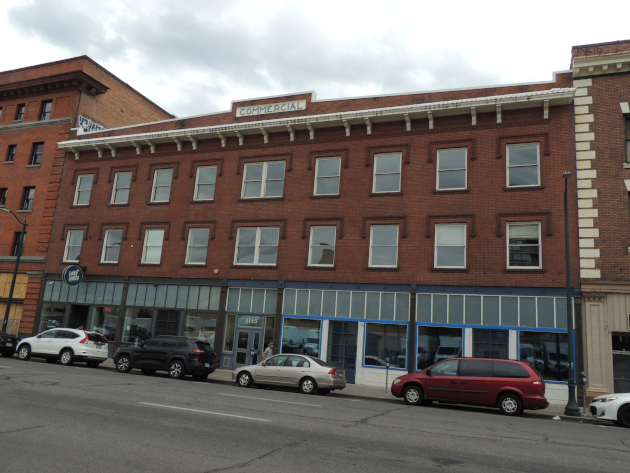
PhotoTitle: The Commercial Block
PhotoAttribution: Spokane City/County Historic Preservation Office
Listing Status: Spokane Register, National Register
URL: http://properties.historicspokane.org/property/?PropertyID=1760
Display Marker: large_yellow
Title: Commercial Block
Description: Date Built: 1906
Architect: Isaac J. Galbraith
Common Name: Commercial Hotel
Isaac J. Galbraith designed the Commercial Block for Dr. Joseph Gandy and his wife, Harriet Ross Gandy, on property Mrs. Gandy owned. It was one of the first mixed-use buildings in the neighborhood, built to serve Spokane's working class. Original tenants of the ground floor commercial space included the Palace Meat Market and the Crescent Furniture Store. The upper floors served as apartments until 1970 and as hotel space until the early 1980s. A 1910 survey of tenants showed them to be employed, unmarried males and females in their twenties and early thirties who stayed in the building for a year or less. The Commercial now serves as housing for formerly homeless people. The building is historically significant as a representative example of a Single Room Occupancy Hotel, a popular form of blue-collar housing in Spokane built in Spokane in the first decade of the 20th century.
Location: 47.65627, -117.42882
Address: 1111 West 1st Avenue, Spokane WA 99201
PhotoURL:

PhotoTitle: The Commercial Block
PhotoAttribution: Spokane City/County Historic Preservation Office
Listing Status: Spokane Register, National Register
URL: http://properties.historicspokane.org/property/?PropertyID=1760
Display Marker: large_yellow
ID: 61
Title: Commission Building
Description: Date Built: 1906
Architect: Unknown
Common Name: Commission Building
Local builder James M. Geraghty erected the Commission Building in the heart of Spokane's early Produce District for the Rasher-Kingman-Herrin Company in 1906. The company was created when Henry M. Herrin's wholesale fruit and produce company merged with partners C.E. Kingman and Huber Rasher. The Rasher-Kingman-Herrin Co. remained in the building until 1915. The Roundup Fisheries Company, later Roundup Grocery, occupied the Commission Building from 1919 into the 1950s, when it built a new headquarters to the east. The Commission Building also housed the Independent Grocers Association Headquarters during the 1930s. The building has more recently been converted to condominiums.
Location: 47.65545, -117.41576
Address: 216 West Pacific Avenue, Spokane WA 99201
PhotoURL:
PhotoTitle: The Commission Building
PhotoAttribution: Spokane City/County Historic Preservation Office
Listing Status: National Register
URL: http://properties.historicspokane.org/property/?PropertyID=1761
Display Marker: large_yellow
Title: Commission Building
Description: Date Built: 1906
Architect: Unknown
Common Name: Commission Building
Local builder James M. Geraghty erected the Commission Building in the heart of Spokane's early Produce District for the Rasher-Kingman-Herrin Company in 1906. The company was created when Henry M. Herrin's wholesale fruit and produce company merged with partners C.E. Kingman and Huber Rasher. The Rasher-Kingman-Herrin Co. remained in the building until 1915. The Roundup Fisheries Company, later Roundup Grocery, occupied the Commission Building from 1919 into the 1950s, when it built a new headquarters to the east. The Commission Building also housed the Independent Grocers Association Headquarters during the 1930s. The building has more recently been converted to condominiums.
Location: 47.65545, -117.41576
Address: 216 West Pacific Avenue, Spokane WA 99201
PhotoURL:

PhotoTitle: The Commission Building
PhotoAttribution: Spokane City/County Historic Preservation Office
Listing Status: National Register
URL: http://properties.historicspokane.org/property/?PropertyID=1761
Display Marker: large_yellow
ID: 62
Title: Comstock-Shadle House
Description: Date Built: 1910
Architect: Willis A. Ritchie
Common Name: Comstock-Shadle House
The Comstock-Shadle House, built for pioneer merchants James and Elizabeth Comstock, is one of the best preserved historic properties in Spokane. The house is a fantastic representation of the work of Willis Ritchie, a master architect who practiced in Spokane during the late 1890s and into the 20th century. Perhaps the most historically significant feature of the house is its association with the Comstock and Shadle families, widely recognized as among the most charitable benefactors living in early 20th century Spokane.
Location: 47.64757, -117.42826
Address: 1106 West 9th Avenue, Spokane WA 99204
PhotoURL: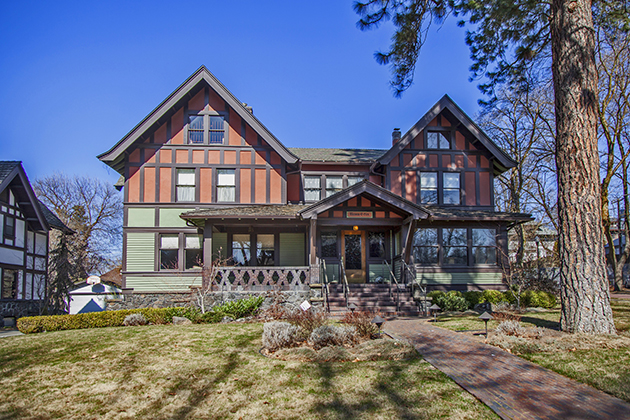
PhotoTitle: Comstock-Shadle House
PhotoAttribution: Spokane City/County Historic Preservation Office
Listing Status: Spokane Register, National Register
URL: http://properties.historicspokane.org/property/?PropertyID=1763
Display Marker: large_yellow
Title: Comstock-Shadle House
Description: Date Built: 1910
Architect: Willis A. Ritchie
Common Name: Comstock-Shadle House
The Comstock-Shadle House, built for pioneer merchants James and Elizabeth Comstock, is one of the best preserved historic properties in Spokane. The house is a fantastic representation of the work of Willis Ritchie, a master architect who practiced in Spokane during the late 1890s and into the 20th century. Perhaps the most historically significant feature of the house is its association with the Comstock and Shadle families, widely recognized as among the most charitable benefactors living in early 20th century Spokane.
Location: 47.64757, -117.42826
Address: 1106 West 9th Avenue, Spokane WA 99204
PhotoURL:

PhotoTitle: Comstock-Shadle House
PhotoAttribution: Spokane City/County Historic Preservation Office
Listing Status: Spokane Register, National Register
URL: http://properties.historicspokane.org/property/?PropertyID=1763
Display Marker: large_yellow
ID: 63
Title: Eugene and Josie Comstock-Shadle House
Description: Date Built: 1911
Architect: Willis A. Ritchie
Common Name: Eugene and Josie Comstock-Shadle House
The Eugene and Josie Comstock-Shadle House was built in 1911 and is a fine example of the Tudor Revival style. Characteristic of the style, the home displays a steeply pitched roof with a slight flare at the eaves, multiple cross gables, three prominent front-facing gables at the facade, a covered front porch and false half-timbering with stucco infill. The interior of the home features a center hall plan with formal massing, and retains original built-ins, hand-polished woodwork, and a formal fireplace with glazed ceramic tile manufactured by Earnest Batchelder (1875-1957), a leading designer of the American Arts & Crafts movement and founder of the Batchelder Tile Company in Pasadena, CA. The house was built by James M. Comstock, one-time mayor of Spokane, and designed by prominent architect Willis A. Ritchie. Eugene Shadle and Josie Comstock-Shadle, partner and daughter of Comstock, respectively, resided in the home
Location: 47.64756, -117.42856
Address: 1112 West 9th Avenue, Spokane WA 99204
PhotoURL: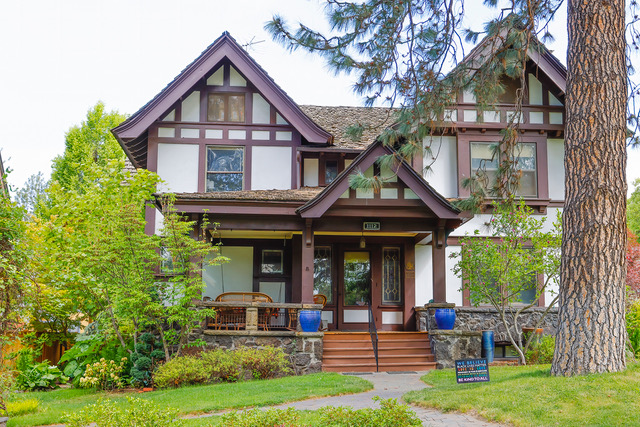
PhotoTitle: Eugene and Josie Comstock-Shadle House
PhotoAttribution: Spokane City/County Historic Preservation Office
Listing Status: Spokane Register, National Register
URL: http://properties.historicspokane.org/property/?PropertyID=1933
Display Marker: large_yellow
Title: Eugene and Josie Comstock-Shadle House
Description: Date Built: 1911
Architect: Willis A. Ritchie
Common Name: Eugene and Josie Comstock-Shadle House
The Eugene and Josie Comstock-Shadle House was built in 1911 and is a fine example of the Tudor Revival style. Characteristic of the style, the home displays a steeply pitched roof with a slight flare at the eaves, multiple cross gables, three prominent front-facing gables at the facade, a covered front porch and false half-timbering with stucco infill. The interior of the home features a center hall plan with formal massing, and retains original built-ins, hand-polished woodwork, and a formal fireplace with glazed ceramic tile manufactured by Earnest Batchelder (1875-1957), a leading designer of the American Arts & Crafts movement and founder of the Batchelder Tile Company in Pasadena, CA. The house was built by James M. Comstock, one-time mayor of Spokane, and designed by prominent architect Willis A. Ritchie. Eugene Shadle and Josie Comstock-Shadle, partner and daughter of Comstock, respectively, resided in the home
Location: 47.64756, -117.42856
Address: 1112 West 9th Avenue, Spokane WA 99204
PhotoURL:

PhotoTitle: Eugene and Josie Comstock-Shadle House
PhotoAttribution: Spokane City/County Historic Preservation Office
Listing Status: Spokane Register, National Register
URL: http://properties.historicspokane.org/property/?PropertyID=1933
Display Marker: large_yellow
ID: 64
Title: Cook House
Description: Date Built: 1905
Architect: John W. Cook
Common Name: John W. Cook House
The J.W. Cook House, a superb example of the free classic Queen Anne style, is the oldest house in the Lincoln Park Addition. Constructed during the turn of the century when most farm houses in the area were frame buildings, the brick masonry-supported Cook House is one of five remaining brick houses built in unincorporated Spokane County before 1910. In addition, the house is the product of master craftsman John W. Cook, and is the only house found in all of Spokane County that features a unique application of decorative stucco that simulates brick veneer. The property retains excellent exterior integrity in its original location, setting, materials, workmanship, and its association with early Spokane.
Location: 47.6229, -117.46532
Address: 3609 West Thorpe Road, Spokane WA 99224
PhotoURL: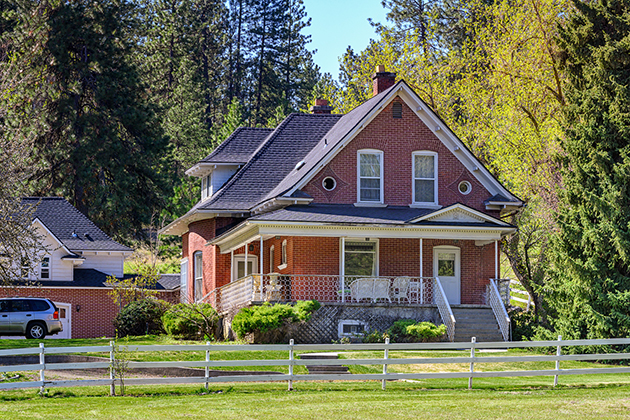
PhotoTitle: John W. Cook House
PhotoAttribution: Spokane City/County Historic Preservation Office
Listing Status: Spokane Register
URL: http://properties.historicspokane.org/property/?PropertyID=1764
Display Marker: large_yellow
Title: Cook House
Description: Date Built: 1905
Architect: John W. Cook
Common Name: John W. Cook House
The J.W. Cook House, a superb example of the free classic Queen Anne style, is the oldest house in the Lincoln Park Addition. Constructed during the turn of the century when most farm houses in the area were frame buildings, the brick masonry-supported Cook House is one of five remaining brick houses built in unincorporated Spokane County before 1910. In addition, the house is the product of master craftsman John W. Cook, and is the only house found in all of Spokane County that features a unique application of decorative stucco that simulates brick veneer. The property retains excellent exterior integrity in its original location, setting, materials, workmanship, and its association with early Spokane.
Location: 47.6229, -117.46532
Address: 3609 West Thorpe Road, Spokane WA 99224
PhotoURL:

PhotoTitle: John W. Cook House
PhotoAttribution: Spokane City/County Historic Preservation Office
Listing Status: Spokane Register
URL: http://properties.historicspokane.org/property/?PropertyID=1764
Display Marker: large_yellow
ID: 65
Title: Coolidge-Rising House
Description: Date Built: 1906
Architect: John K. Dow
Common Name: Coolidge-Rising House
The Coolidge-Rising house is a Craftsman-style residence located on a double lot on Spokane's lower South Hill. The house is characterized by the restrained structural features associated with the Craftsman style. The overhanging eaves of the roof are open with exposed decorative rafter tails. The house is historically significant for its associations with two leaders in the commercial development of the region during the early twentieth century. Financier Alfred Coolidge, who built the house, was a founder, president, and director of banks in both Spokane and Whitman counties, as well as an officer in an investment firm and a mining company. Henry Rising, who purchased the home in 1924, was the long-time editor of The Chronicle and president of the parent publishing company. As a prominent banker and journalist-publisher, the two men played influential roles in the development of the Inland Empire, and the well-preserved Craftsman style house reflects the status of the men and their achievements.
Location: 47.64694, -117.43276
Address: 1405 West 9th Avenue, Spokane WA 99204
PhotoURL: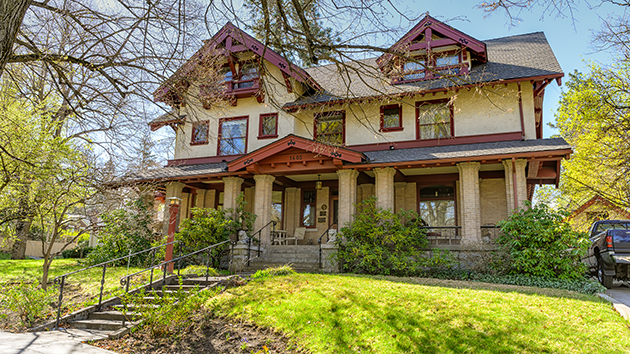
PhotoTitle: Alfred Coolidge-Henry Rising House
PhotoAttribution: Spokane City/County Historic Preservation Office
Listing Status: Spokane Register, National Register
URL: http://properties.historicspokane.org/property/?PropertyID=1765
Display Marker: large_yellow
Title: Coolidge-Rising House
Description: Date Built: 1906
Architect: John K. Dow
Common Name: Coolidge-Rising House
The Coolidge-Rising house is a Craftsman-style residence located on a double lot on Spokane's lower South Hill. The house is characterized by the restrained structural features associated with the Craftsman style. The overhanging eaves of the roof are open with exposed decorative rafter tails. The house is historically significant for its associations with two leaders in the commercial development of the region during the early twentieth century. Financier Alfred Coolidge, who built the house, was a founder, president, and director of banks in both Spokane and Whitman counties, as well as an officer in an investment firm and a mining company. Henry Rising, who purchased the home in 1924, was the long-time editor of The Chronicle and president of the parent publishing company. As a prominent banker and journalist-publisher, the two men played influential roles in the development of the Inland Empire, and the well-preserved Craftsman style house reflects the status of the men and their achievements.
Location: 47.64694, -117.43276
Address: 1405 West 9th Avenue, Spokane WA 99204
PhotoURL:

PhotoTitle: Alfred Coolidge-Henry Rising House
PhotoAttribution: Spokane City/County Historic Preservation Office
Listing Status: Spokane Register, National Register
URL: http://properties.historicspokane.org/property/?PropertyID=1765
Display Marker: large_yellow
ID: 66
Title: Cooper House
Description: Date Built: 1930
Architect: Fred Westcott
Common Name: J.L. Cooper House
Designed by Fred Westcott and built by John E. Anderson, this Tudor Revival style house was reported to have cost in excess of $20,000 when erected in 1930. The house was built for James Leonard Cooper, a pioneer Spokane financier, founder of J.L. Cooper and Company mortgage firm, and president of Spokane Savings Bank. Louis Wasmer, founder of Spokane's KHQ radio station, lived in the house from 1933-1949. The house is historically significant for its association with Cooper and Wasmer and architecturally significant as an example of the work of master architect Fred Westcott's interpretation of the Tudor Revival style.
Location: 47.63904, -117.39923
Address: 1729 South Upper Terrace Road, Spokane WA 99203
PhotoURL: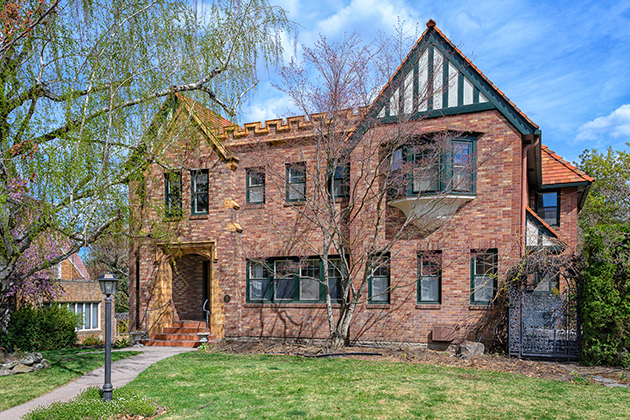
PhotoTitle: J. Louis Wasmer House
PhotoAttribution: Spokane City/County Historic Preservation Office
Listing Status: Spokane Register, National Register
URL: http://properties.historicspokane.org/property/?PropertyID=1766
Display Marker: large_yellow
Title: Cooper House
Description: Date Built: 1930
Architect: Fred Westcott
Common Name: J.L. Cooper House
Designed by Fred Westcott and built by John E. Anderson, this Tudor Revival style house was reported to have cost in excess of $20,000 when erected in 1930. The house was built for James Leonard Cooper, a pioneer Spokane financier, founder of J.L. Cooper and Company mortgage firm, and president of Spokane Savings Bank. Louis Wasmer, founder of Spokane's KHQ radio station, lived in the house from 1933-1949. The house is historically significant for its association with Cooper and Wasmer and architecturally significant as an example of the work of master architect Fred Westcott's interpretation of the Tudor Revival style.
Location: 47.63904, -117.39923
Address: 1729 South Upper Terrace Road, Spokane WA 99203
PhotoURL:

PhotoTitle: J. Louis Wasmer House
PhotoAttribution: Spokane City/County Historic Preservation Office
Listing Status: Spokane Register, National Register
URL: http://properties.historicspokane.org/property/?PropertyID=1766
Display Marker: large_yellow
ID: 67
Title: Corbet-Aspray House
Description: Date Built: 1908
Architect: Kirtland K. Cutter
Common Name: Corbet-Aspray House
The Corbet-Aspray House is one of Spokane's finest renditions of architectural eclecticism. Master craftsman Kirtland Cutter designed the house for noted Spokane mortgage banker James Corbet and his wife Ruth, and was later home to Melvin and Grace Aspray. A prominent medical practitioner, Dr. Melvin Aspray was one of the first in Spokane to specialize in radiology; he subsequently assisted in establishing the radiology department at Sacred Heart Medical Center. Grace Aspray was widely recognized for her service to the community as a civic benefactor and philanthropic leader. The Corbet-Aspray House demonstrates turn-of-the-century community development in Hill Park Addition along once-prestigious West Seventh Avenue and is one the few homes to survive the onslaught of commercial encroachment and demolition of the Hill Park neighborhood in the past fifty years.
Location: 47.64966, -117.42402
Address: 820 West 7th Avenue, Spokane WA 99204
PhotoURL: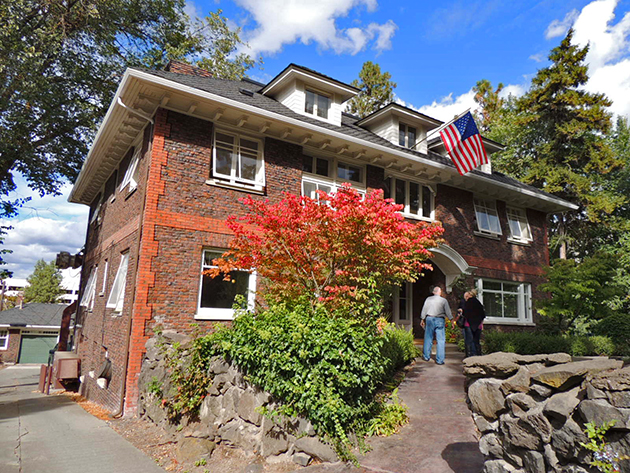
PhotoTitle: Corbet-Aspray House
PhotoAttribution: Spokane City/County Historic Preservation Office
Listing Status: Spokane Register, National Register
URL: http://properties.historicspokane.org/property/?PropertyID=1767
Display Marker: large_yellow
Title: Corbet-Aspray House
Description: Date Built: 1908
Architect: Kirtland K. Cutter
Common Name: Corbet-Aspray House
The Corbet-Aspray House is one of Spokane's finest renditions of architectural eclecticism. Master craftsman Kirtland Cutter designed the house for noted Spokane mortgage banker James Corbet and his wife Ruth, and was later home to Melvin and Grace Aspray. A prominent medical practitioner, Dr. Melvin Aspray was one of the first in Spokane to specialize in radiology; he subsequently assisted in establishing the radiology department at Sacred Heart Medical Center. Grace Aspray was widely recognized for her service to the community as a civic benefactor and philanthropic leader. The Corbet-Aspray House demonstrates turn-of-the-century community development in Hill Park Addition along once-prestigious West Seventh Avenue and is one the few homes to survive the onslaught of commercial encroachment and demolition of the Hill Park neighborhood in the past fifty years.
Location: 47.64966, -117.42402
Address: 820 West 7th Avenue, Spokane WA 99204
PhotoURL:

PhotoTitle: Corbet-Aspray House
PhotoAttribution: Spokane City/County Historic Preservation Office
Listing Status: Spokane Register, National Register
URL: http://properties.historicspokane.org/property/?PropertyID=1767
Display Marker: large_yellow
ID: 68
Title: Corbin House
Description: Date Built: 1898
Architect: Kirtland K. Cutter
Common Name: Corbin Art Center
As an 1898 Colonial Revival Residence built on a 4.5 acre site, the Daniel and Anna Corbin House is one of a series of mansions that once sat along the base of the north-facing slope of Seventh Avenue. The symmetrical facade has a central entry framed by Tuscan columns and a full-width porch that extends around each side elevation from octagonal corners. Over the entry portico on the second level is a porch with balustrades and a three-part center window. Above, on the hipped roof, are three dormers, the central boasting a Palladian window. The home is well-preserved and exhibits a high level of exterior and interior integrity. Its adaptive reuse as an art center after a 1921 fire has introduced only minor changes to the second floor rooms. A series of restorations included porch and foundation repair, replication of the once-missing second-level balustrade, and painting of exterior wood surfaces in original shades. The interior walls, woodwork, doors, and lighting fixtures have been returned to near-original condition as well.
Location: 47.648393, -117.419597
Address: 507 West 7th Avenue, Spokane WA 99204
PhotoURL: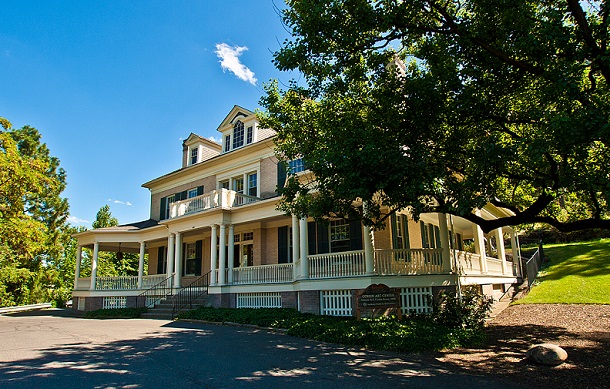
PhotoTitle: The Corbin House
PhotoAttribution: Spokane City/County Historic Preservation Office
Listing Status: Spokane Register, National Register
URL: http://properties.historicspokane.org/property/?PropertyID=1768
Display Marker: large_yellow
Title: Corbin House
Description: Date Built: 1898
Architect: Kirtland K. Cutter
Common Name: Corbin Art Center
As an 1898 Colonial Revival Residence built on a 4.5 acre site, the Daniel and Anna Corbin House is one of a series of mansions that once sat along the base of the north-facing slope of Seventh Avenue. The symmetrical facade has a central entry framed by Tuscan columns and a full-width porch that extends around each side elevation from octagonal corners. Over the entry portico on the second level is a porch with balustrades and a three-part center window. Above, on the hipped roof, are three dormers, the central boasting a Palladian window. The home is well-preserved and exhibits a high level of exterior and interior integrity. Its adaptive reuse as an art center after a 1921 fire has introduced only minor changes to the second floor rooms. A series of restorations included porch and foundation repair, replication of the once-missing second-level balustrade, and painting of exterior wood surfaces in original shades. The interior walls, woodwork, doors, and lighting fixtures have been returned to near-original condition as well.
Location: 47.648393, -117.419597
Address: 507 West 7th Avenue, Spokane WA 99204
PhotoURL:

PhotoTitle: The Corbin House
PhotoAttribution: Spokane City/County Historic Preservation Office
Listing Status: Spokane Register, National Register
URL: http://properties.historicspokane.org/property/?PropertyID=1768
Display Marker: large_yellow
ID: 69
Title: Cowley Park
Description: Located right outside the bustling downtown district of Spokane, Cowley Park exists today as a slightly rolling, wooded, well-cared-for two-acre park with visitor facilities and a monument describing the history of the area, although none of the historic buildings that surrounded the park remain. The Reverend Henry T. Cowley and his wife Abigail Peet Cowley, along with their three children, were one of the first four families to settle in Spokane Falls, arriving in 1874. Cowley Park exists today as a tribute to the work Cowley did to strength relations between settlers and the Spokane tribe.
Location: 47.64991, -117.41177
Address: 602 South Division Street, Spokane WA 99202
PhotoURL: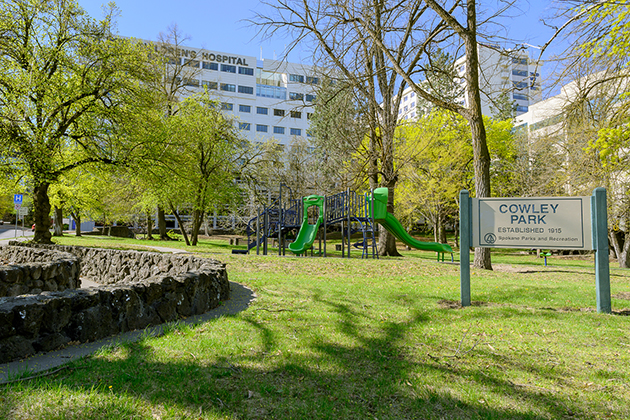
PhotoTitle: Cowley Park
PhotoAttribution: Spokane City/County Historic Preservation Office
Listing Status: National Register
URL: http://properties.historicspokane.org/property/?PropertyID=1991
Display Marker: large_yellow
Title: Cowley Park
Description: Located right outside the bustling downtown district of Spokane, Cowley Park exists today as a slightly rolling, wooded, well-cared-for two-acre park with visitor facilities and a monument describing the history of the area, although none of the historic buildings that surrounded the park remain. The Reverend Henry T. Cowley and his wife Abigail Peet Cowley, along with their three children, were one of the first four families to settle in Spokane Falls, arriving in 1874. Cowley Park exists today as a tribute to the work Cowley did to strength relations between settlers and the Spokane tribe.
Location: 47.64991, -117.41177
Address: 602 South Division Street, Spokane WA 99202
PhotoURL:

PhotoTitle: Cowley Park
PhotoAttribution: Spokane City/County Historic Preservation Office
Listing Status: National Register
URL: http://properties.historicspokane.org/property/?PropertyID=1991
Display Marker: large_yellow
ID: 70
Title: Cowley School
Description: Date Built: 1917
Architect: Unknown
Common Name: Cowley School
The Cowley School is a finely crafted vernacular example of a small schoolhouse with Collegiate Gothic-style elements identified in a stepped parapet, brick exterior wall cladding, and a Tudor-Gothic entry arch with sculpted tracery embellishment. The school building is the only public school ever constructed in Peaceful Valley and is one of few historic public schools remaining in Spokane. The building was named for Reverend Henry T. Cowley, one of Spokane's most accomplished leaders and one of the first pioneers to arrive in 1874 when settlement of the town was just beginning. Cowley's business and civic contributions span a wide range from missionary work with the region's Spokane Indian tribes to Presbyterian Church organization and leadership, real estate development, and the establishment of the Spokane Daily Chronicle.
Location: 47.65849, -117.43551
Address: 107 North Maple Street, Spokane WA 99201
PhotoURL: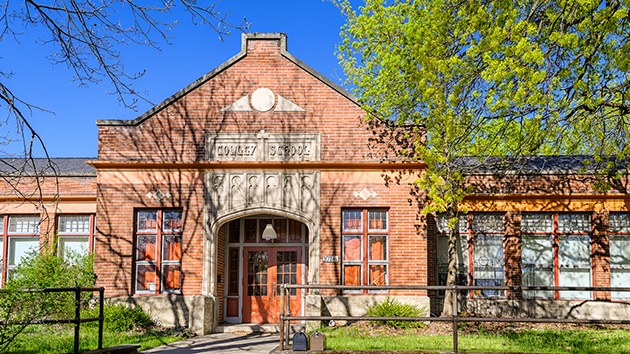
PhotoTitle: The Cowley School (date unknown)
PhotoAttribution: Spokane City/County Historic Preservation Office
Listing Status: Spokane Register, National Register
URL: http://properties.historicspokane.org/property/?PropertyID=1769
Display Marker: large_yellow
Title: Cowley School
Description: Date Built: 1917
Architect: Unknown
Common Name: Cowley School
The Cowley School is a finely crafted vernacular example of a small schoolhouse with Collegiate Gothic-style elements identified in a stepped parapet, brick exterior wall cladding, and a Tudor-Gothic entry arch with sculpted tracery embellishment. The school building is the only public school ever constructed in Peaceful Valley and is one of few historic public schools remaining in Spokane. The building was named for Reverend Henry T. Cowley, one of Spokane's most accomplished leaders and one of the first pioneers to arrive in 1874 when settlement of the town was just beginning. Cowley's business and civic contributions span a wide range from missionary work with the region's Spokane Indian tribes to Presbyterian Church organization and leadership, real estate development, and the establishment of the Spokane Daily Chronicle.
Location: 47.65849, -117.43551
Address: 107 North Maple Street, Spokane WA 99201
PhotoURL:

PhotoTitle: The Cowley School (date unknown)
PhotoAttribution: Spokane City/County Historic Preservation Office
Listing Status: Spokane Register, National Register
URL: http://properties.historicspokane.org/property/?PropertyID=1769
Display Marker: large_yellow
ID: 71
Title: Crescent Building
Description: Date Built: 1917
Architect: Loren L. Rand
Common Name: The Crescent
The Crescent Building sits in the heart of downtown Spokane and shares its historical traditions with such contemporaries as Old City Hall, the US Bank Building, and the Smith Funeral Home. The seven-story building was erected in 1919 to house the fast-growing Crescent Store. Owners Robert B. Paterson and Captain J.M. Comstock hired prominent Spokane architect L.L. Rand to design the building to fit the future needs of store customers. Bay windows covered the entire street level of the store, making window shopping a new and exciting experience for those visiting the Crescent. Windows also decorate every floor of the building, giving the store not only a unique quality, but also allowing a much more open and inviting look. Stylistically, the building reflects Rand's emphasis on detail, with brackets, cartouches, and cornice elements executed in white-glazed terracotta.
Location: 47.6587, -117.42264
Address: 707 West Main Avenue, Spokane WA 99201
PhotoURL: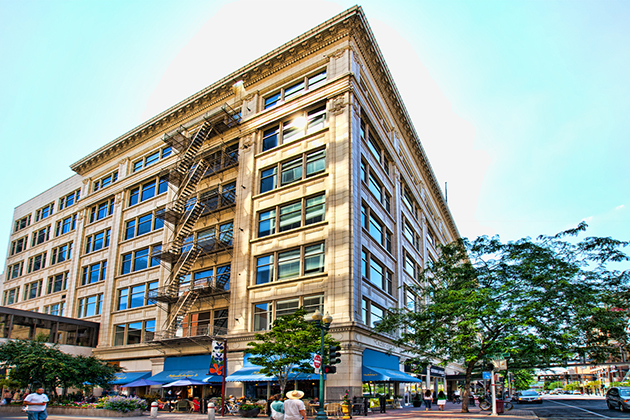
PhotoTitle: The Crescent
PhotoAttribution: Spokane City/County Historic Preservation Office
Listing Status: Spokane Register
URL: http://properties.historicspokane.org/property/?PropertyID=1770
Display Marker: large_yellow
Title: Crescent Building
Description: Date Built: 1917
Architect: Loren L. Rand
Common Name: The Crescent
The Crescent Building sits in the heart of downtown Spokane and shares its historical traditions with such contemporaries as Old City Hall, the US Bank Building, and the Smith Funeral Home. The seven-story building was erected in 1919 to house the fast-growing Crescent Store. Owners Robert B. Paterson and Captain J.M. Comstock hired prominent Spokane architect L.L. Rand to design the building to fit the future needs of store customers. Bay windows covered the entire street level of the store, making window shopping a new and exciting experience for those visiting the Crescent. Windows also decorate every floor of the building, giving the store not only a unique quality, but also allowing a much more open and inviting look. Stylistically, the building reflects Rand's emphasis on detail, with brackets, cartouches, and cornice elements executed in white-glazed terracotta.
Location: 47.6587, -117.42264
Address: 707 West Main Avenue, Spokane WA 99201
PhotoURL:

PhotoTitle: The Crescent
PhotoAttribution: Spokane City/County Historic Preservation Office
Listing Status: Spokane Register
URL: http://properties.historicspokane.org/property/?PropertyID=1770
Display Marker: large_yellow
ID: 72
Title: Crommelin House
Description: Date Built: 1908
Architect: Unknown
Common Name:Henri Crommelin House The Crommelin House was built for Henri Crommelin and his wife, Antoinette Wilder Broadwater Crommelin. After Antoinette's death in 1910, Henri married Elizabeth Schimmel in 1914 and the property remained their home for more than five decades. As a banker, Crommelin worked as a manager of the Holland Bank of Amsterdam in Spokane from 1906 to 1931 and was president/secretary of the Vermont Loan & Trust Company until his retirement in 1946. Crommelin was esteemed as a member of Spokane's Dutch colony, was a widely known businessman who helped build up the city, and as a contributing leader in local business, civic, social, and sports circles. The house is further architecturally significant as a fine depiction of the Tudor Revival style.
Location: 47.64624, -117.42026
Address: 603 West Sumner Avenue, Spokane WA 99204
PhotoURL: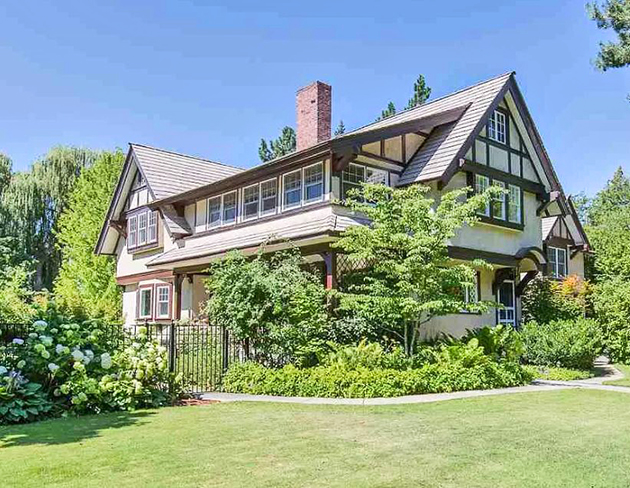
PhotoTitle: Henri Crommelin House
PhotoAttribution: Spokane City/County Historic Preservation Office
Listing Status: Spokane Register, National Register
URL: http://properties.historicspokane.org/property/?PropertyID=1771
Display Marker: large_yellow
Title: Crommelin House
Description: Date Built: 1908
Architect: Unknown
Common Name:Henri Crommelin House The Crommelin House was built for Henri Crommelin and his wife, Antoinette Wilder Broadwater Crommelin. After Antoinette's death in 1910, Henri married Elizabeth Schimmel in 1914 and the property remained their home for more than five decades. As a banker, Crommelin worked as a manager of the Holland Bank of Amsterdam in Spokane from 1906 to 1931 and was president/secretary of the Vermont Loan & Trust Company until his retirement in 1946. Crommelin was esteemed as a member of Spokane's Dutch colony, was a widely known businessman who helped build up the city, and as a contributing leader in local business, civic, social, and sports circles. The house is further architecturally significant as a fine depiction of the Tudor Revival style.
Location: 47.64624, -117.42026
Address: 603 West Sumner Avenue, Spokane WA 99204
PhotoURL:

PhotoTitle: Henri Crommelin House
PhotoAttribution: Spokane City/County Historic Preservation Office
Listing Status: Spokane Register, National Register
URL: http://properties.historicspokane.org/property/?PropertyID=1771
Display Marker: large_yellow
ID: 73
Title: Crowe & Company
Description: Date Built: 1909
Architect: Unknown
Common Name: Luminaria
The Crowe & Company Building, a formal rail corridor warehouse, served as a transfer point for materials shipped into Spokane via the Northern Pacific Railroad to serve the markets of Spokane and the Inland Northwest. The F.T. Crowe and Company, building and suppliers, constructed the building in 1909 and occupied the site through 1915. Pacific Hide and Fur, a materials salvage company, occupied the building between 1916 and 1965, and Luminaria between 1988 and 2004.
Location: 47.6552, -117.4283
Address: 154 South Madison Street, Spokane WA 99201
PhotoURL:
PhotoTitle: Crowe & Company
PhotoAttribution: Spokane City/County Historic Preservation Office
Listing Status: Spokane Register, National Register
URL: http://properties.historicspokane.org/property/?PropertyID=1772
Display Marker: large_yellow
Title: Crowe & Company
Description: Date Built: 1909
Architect: Unknown
Common Name: Luminaria
The Crowe & Company Building, a formal rail corridor warehouse, served as a transfer point for materials shipped into Spokane via the Northern Pacific Railroad to serve the markets of Spokane and the Inland Northwest. The F.T. Crowe and Company, building and suppliers, constructed the building in 1909 and occupied the site through 1915. Pacific Hide and Fur, a materials salvage company, occupied the building between 1916 and 1965, and Luminaria between 1988 and 2004.
Location: 47.6552, -117.4283
Address: 154 South Madison Street, Spokane WA 99201
PhotoURL:

PhotoTitle: Crowe & Company
PhotoAttribution: Spokane City/County Historic Preservation Office
Listing Status: Spokane Register, National Register
URL: http://properties.historicspokane.org/property/?PropertyID=1772
Display Marker: large_yellow
ID: 74
Title: Culton-Moylan-Reilly Auto Company and Fisk Rubber Company Buildings
Description: Date Built: 1911
Architect: Unknown
Common Name: Geeks on Wheels
The Culton-Moylan-Reilly Auto Company and the Fisk Rubber Company buildings served automobile-related uses until recently. Their long association with Spokane's automobile industry ties them to the development of this area's transportation history. Though not remarkable for their architecture, they are nonetheless representative of the type of buildings associated with the evolution of the automobile. Over eighty years old, they were among Spokane's earliest structures completed specifically for automobile sales and service. In recent years, the number of the one-story automobile-related buildings has diminished. They represent a building type that was once numerous, but is disappearing in the west downtown area. Their collective facades, designed as a visual unit, add to their architectural character. Daniel H. Dwight, a member of one of Spokane's earliest pioneer families, built the first two, and was associated with development of the third. Dwight heirs have maintained an ownership interest.
Location: 47.6549, -117.42546
Address: 916 West 2nd Avenue, Spokane WA 99201
PhotoURL: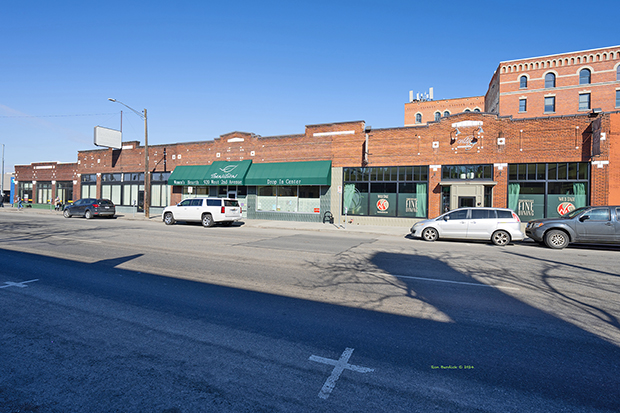
PhotoTitle: Auto and Rubber Company Buildings
PhotoAttribution: Spokane City/County Historic Preservation Office
Listing Status: Spokane Register, National Register
URL: http://properties.historicspokane.org/property/?PropertyID=1759
Display Marker: large_yellow
Title: Culton-Moylan-Reilly Auto Company and Fisk Rubber Company Buildings
Description: Date Built: 1911
Architect: Unknown
Common Name: Geeks on Wheels
The Culton-Moylan-Reilly Auto Company and the Fisk Rubber Company buildings served automobile-related uses until recently. Their long association with Spokane's automobile industry ties them to the development of this area's transportation history. Though not remarkable for their architecture, they are nonetheless representative of the type of buildings associated with the evolution of the automobile. Over eighty years old, they were among Spokane's earliest structures completed specifically for automobile sales and service. In recent years, the number of the one-story automobile-related buildings has diminished. They represent a building type that was once numerous, but is disappearing in the west downtown area. Their collective facades, designed as a visual unit, add to their architectural character. Daniel H. Dwight, a member of one of Spokane's earliest pioneer families, built the first two, and was associated with development of the third. Dwight heirs have maintained an ownership interest.
Location: 47.6549, -117.42546
Address: 916 West 2nd Avenue, Spokane WA 99201
PhotoURL:

PhotoTitle: Auto and Rubber Company Buildings
PhotoAttribution: Spokane City/County Historic Preservation Office
Listing Status: Spokane Register, National Register
URL: http://properties.historicspokane.org/property/?PropertyID=1759
Display Marker: large_yellow
ID: 75
Title: Currie House
Description: Date Built: 1889
Architect: William J. Carpenter
Common Name: John A. Currie House
The Currie House, one of the oldest houses in Spokane, is an exceptional example of Queen Anne architecture. Constructed in 1889, the home was designed by master architect William J. Carpenter and built for mining entrepreneur and city councilman John A. Currie. Historically, the home is a testament to the success of early development and settlement of the area. The two-and-one-half story home displays a variety of Queen Anne style elements including a steeply pitched roof with a large front-facing dormer, exterior wall cladding and trim depicting various patterns, materials, and colors, vertical windows with transom lights, and a full-width front porch with decorative brackets. Over 125 years old, the Currie House retains remarkable interior and exterior architectural integrity.
Location: 47.68607, -117.42556
Address: 908 West Frederick Avenue, Spokane WA 99205
PhotoURL: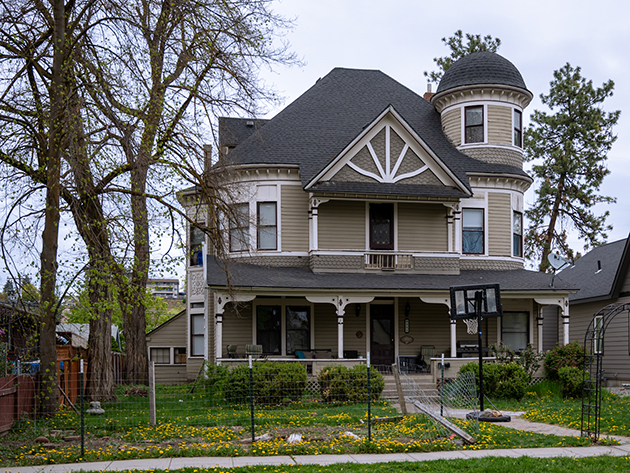
PhotoTitle: John A. Currie House
PhotoAttribution: Spokane City/County Historic Preservation Office
Listing Status: Spokane Register
URL: http://properties.historicspokane.org/property/?PropertyID=1773
Display Marker: large_yellow
Title: Currie House
Description: Date Built: 1889
Architect: William J. Carpenter
Common Name: John A. Currie House
The Currie House, one of the oldest houses in Spokane, is an exceptional example of Queen Anne architecture. Constructed in 1889, the home was designed by master architect William J. Carpenter and built for mining entrepreneur and city councilman John A. Currie. Historically, the home is a testament to the success of early development and settlement of the area. The two-and-one-half story home displays a variety of Queen Anne style elements including a steeply pitched roof with a large front-facing dormer, exterior wall cladding and trim depicting various patterns, materials, and colors, vertical windows with transom lights, and a full-width front porch with decorative brackets. Over 125 years old, the Currie House retains remarkable interior and exterior architectural integrity.
Location: 47.68607, -117.42556
Address: 908 West Frederick Avenue, Spokane WA 99205
PhotoURL:

PhotoTitle: John A. Currie House
PhotoAttribution: Spokane City/County Historic Preservation Office
Listing Status: Spokane Register
URL: http://properties.historicspokane.org/property/?PropertyID=1773
Display Marker: large_yellow
ID: 76
Title: Danson-Chase House
Description: Date Built: 1931
Architect: George M. Rasque
Common Name: Danson-Chase House
The Danson-Chase House is a fine example of the Tudor Revival style with English cottage "Storybook" elements including one and one-half story side-gable house form, asymmetrical design, steeply pitched roof, multiple prominent front-facing gables, massive brick chimney, recessed front entrance, multi-paned windows, and textured "raked" brick veneer. The property was listed in 1997 on the National Register of Historic Places as a contributing resource of the Rockwood National Register Historic District, one of Spokane's most historically and architecturally prominent residential neighborhoods. The house was built for noted Spokane attorney Robert J. Danson and his wife Ethel E. Danson, who owned it for more than twenty years. Robert Danson founded and organized at least four law firms in Spokane and was noted not only for his work in courts, but for his resourcefulness and capable management of business interests and investments.
Location: 47.63353, -117.39868
Address: 746 East 23rd Avenue, Spokane WA 99203
PhotoURL: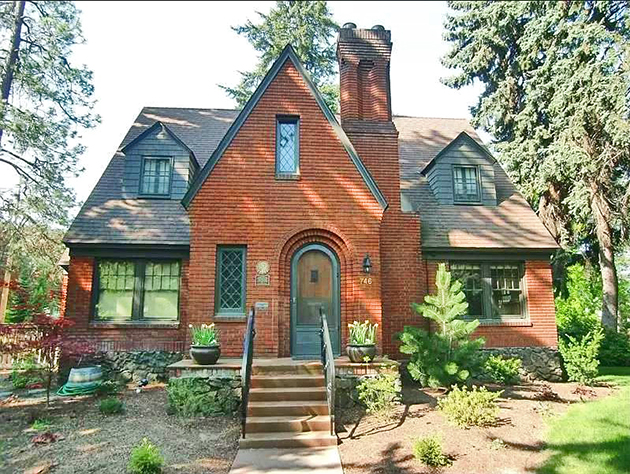
PhotoTitle: Danson-Chase House
PhotoAttribution: Spokane City/County Historic Preservation Office
Listing Status: Spokane Register, National Register
URL: http://properties.historicspokane.org/property/?PropertyID=1774
Display Marker: large_yellow
Title: Danson-Chase House
Description: Date Built: 1931
Architect: George M. Rasque
Common Name: Danson-Chase House
The Danson-Chase House is a fine example of the Tudor Revival style with English cottage "Storybook" elements including one and one-half story side-gable house form, asymmetrical design, steeply pitched roof, multiple prominent front-facing gables, massive brick chimney, recessed front entrance, multi-paned windows, and textured "raked" brick veneer. The property was listed in 1997 on the National Register of Historic Places as a contributing resource of the Rockwood National Register Historic District, one of Spokane's most historically and architecturally prominent residential neighborhoods. The house was built for noted Spokane attorney Robert J. Danson and his wife Ethel E. Danson, who owned it for more than twenty years. Robert Danson founded and organized at least four law firms in Spokane and was noted not only for his work in courts, but for his resourcefulness and capable management of business interests and investments.
Location: 47.63353, -117.39868
Address: 746 East 23rd Avenue, Spokane WA 99203
PhotoURL:

PhotoTitle: Danson-Chase House
PhotoAttribution: Spokane City/County Historic Preservation Office
Listing Status: Spokane Register, National Register
URL: http://properties.historicspokane.org/property/?PropertyID=1774
Display Marker: large_yellow
ID: 77
Title: Davenport Hotel
Description: Date Built: 1912
Architect: Kirkland K. Cutter
Common Name: The Davenport Hotel
Constructed in downtown Spokane within walking distance of the Spokane Falls and a multitude of shops and restaurants, the Davenport Hotel has anchored the city's core for over eighty years. The nearly square footprint of the hotel occupies the western two-thirds of the city block bounded by West Sprague Avenue on the north, West First Avenue to the south and flanked by South Post Street to the east and South Lincoln Street to the west. The first through third floors are oriented around the central lobby's natural lighting, featuring shops, offices and rooms around the building perimeter. Built in the waning years of the railroad era, the Davenport was an important measure of the urbanity and sophistication of Spokane and the inland empire of eastern Washington, Idaho, and the mining country of western Montana. Like the imposing baronial hotels of the Canadian Pacific Railroad, the Davenport was designed to present an outpost of elegance in a major city along the Northern Pacific and Great Northern Railroads.
Location: 47.65687, -117.42426
Address: 10 South Post Street, Spokane WA 99201
PhotoURL: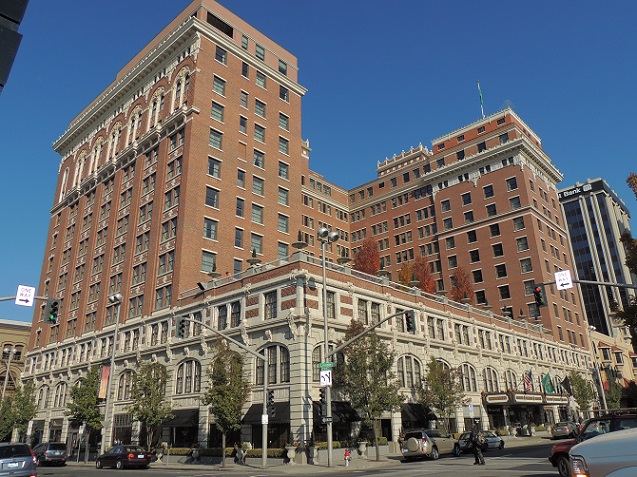
PhotoTitle: The Davenport Hotel
PhotoAttribution: Spokane City/County Historic Preservation Office
Listing Status: Spokane Register, National Register
URL: http://properties.historicspokane.org/property/?PropertyID=1775
Display Marker: large_yellow
Title: Davenport Hotel
Description: Date Built: 1912
Architect: Kirkland K. Cutter
Common Name: The Davenport Hotel
Constructed in downtown Spokane within walking distance of the Spokane Falls and a multitude of shops and restaurants, the Davenport Hotel has anchored the city's core for over eighty years. The nearly square footprint of the hotel occupies the western two-thirds of the city block bounded by West Sprague Avenue on the north, West First Avenue to the south and flanked by South Post Street to the east and South Lincoln Street to the west. The first through third floors are oriented around the central lobby's natural lighting, featuring shops, offices and rooms around the building perimeter. Built in the waning years of the railroad era, the Davenport was an important measure of the urbanity and sophistication of Spokane and the inland empire of eastern Washington, Idaho, and the mining country of western Montana. Like the imposing baronial hotels of the Canadian Pacific Railroad, the Davenport was designed to present an outpost of elegance in a major city along the Northern Pacific and Great Northern Railroads.
Location: 47.65687, -117.42426
Address: 10 South Post Street, Spokane WA 99201
PhotoURL:

PhotoTitle: The Davenport Hotel
PhotoAttribution: Spokane City/County Historic Preservation Office
Listing Status: Spokane Register, National Register
URL: http://properties.historicspokane.org/property/?PropertyID=1775
Display Marker: large_yellow
ID: 78
Title: Fotheringham Residence
Description: Date Built: 1891
Architect: David B. Fotheringham
Common Name: David B. Fotheringham Residence, Fotheringham Bed & Breakfast
This house is significant as a contributing building in the Browne's Addition Historic District and as the family home of David B. Fotheringham, a successful building contractor and community leader. Fotheringham lived in a temporary home situated next to this house as it was constructed. He finished in 1891, the same year he became Mayor of Spokane. After moving in, Fotheringham turned his attention to the lot across the street to the west, where he built the opulent Patrick Clark Mansion, designed by Spokane's best known architect, Kirtland Cutter. Fotheringham remained in this house until 1926 when Fay E. and Ina Dobson purchased the home and converted it into an apartment building. In 1984, the house was partially restored and remodeled to accommodate a bed and breakfast, which continues to exist today.
Location: 47.65484, -117.44439
Address: 2128 West 2nd Avenue, Spokane WA 99201
PhotoURL: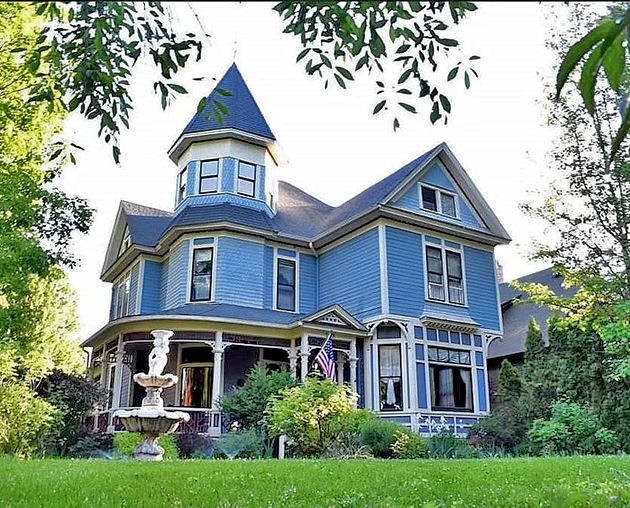
PhotoTitle: David B. Fotheringham Residence
PhotoAttribution: Spokane City/County Historic Preservation Office
Listing Status: Spokane Register, National Register
URL: http://properties.historicspokane.org/property/?PropertyID=1801
Display Marker: large_yellow
Title: Fotheringham Residence
Description: Date Built: 1891
Architect: David B. Fotheringham
Common Name: David B. Fotheringham Residence, Fotheringham Bed & Breakfast
This house is significant as a contributing building in the Browne's Addition Historic District and as the family home of David B. Fotheringham, a successful building contractor and community leader. Fotheringham lived in a temporary home situated next to this house as it was constructed. He finished in 1891, the same year he became Mayor of Spokane. After moving in, Fotheringham turned his attention to the lot across the street to the west, where he built the opulent Patrick Clark Mansion, designed by Spokane's best known architect, Kirtland Cutter. Fotheringham remained in this house until 1926 when Fay E. and Ina Dobson purchased the home and converted it into an apartment building. In 1984, the house was partially restored and remodeled to accommodate a bed and breakfast, which continues to exist today.
Location: 47.65484, -117.44439
Address: 2128 West 2nd Avenue, Spokane WA 99201
PhotoURL:

PhotoTitle: David B. Fotheringham Residence
PhotoAttribution: Spokane City/County Historic Preservation Office
Listing Status: Spokane Register, National Register
URL: http://properties.historicspokane.org/property/?PropertyID=1801
Display Marker: large_yellow
ID: 79
Title: Dessert House
Description: Date Built: 1936
Architect: Gustav A. Pehrson & Frank G. Hutchinson
Common Name: Victor and Georges Dessert House
Begun in 1913 and completed in 1936, the Dessert House is one of Spokane's most unique homes. The home was erected for Victor Dessert and his wife Georges Wilson Dessert, two prominent civic benefactors, city leaders, and founders of the Dessert Hotel chain which included seven hostelries built in Spokane, Ritzville, and Coeur d'Alene. Perched high atop a rocky precipice above Rockwood Boulevard, the home commands a spectacular view and is an excellent - and rare - representation of the Spanish Eclectic style. With its stucco cladding, multi-level red tile roof and multiple units, the Dessert House resembles the compound plans and varied roof forms associated with Spanish villages. The castle-like thick black basalt rock foundation, curved rock terraces, and rock stairways were designed by Frank G. Hutchinson while the house was designed by Gustave Albin Pehrson.
Location: 47.64119, -117.39751
Address: 1520 South Rockwood Boulevard, Spokane WA 99203
PhotoURL: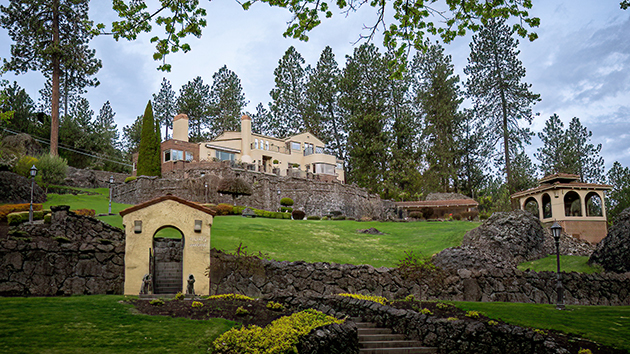
PhotoTitle: Victor and Georges Dessert House
PhotoAttribution: Spokane City/County Historic Preservation Office
Listing Status: Spokane Register, National Register
URL: http://properties.historicspokane.org/property/?PropertyID=1776
Display Marker: large_yellow
Title: Dessert House
Description: Date Built: 1936
Architect: Gustav A. Pehrson & Frank G. Hutchinson
Common Name: Victor and Georges Dessert House
Begun in 1913 and completed in 1936, the Dessert House is one of Spokane's most unique homes. The home was erected for Victor Dessert and his wife Georges Wilson Dessert, two prominent civic benefactors, city leaders, and founders of the Dessert Hotel chain which included seven hostelries built in Spokane, Ritzville, and Coeur d'Alene. Perched high atop a rocky precipice above Rockwood Boulevard, the home commands a spectacular view and is an excellent - and rare - representation of the Spanish Eclectic style. With its stucco cladding, multi-level red tile roof and multiple units, the Dessert House resembles the compound plans and varied roof forms associated with Spanish villages. The castle-like thick black basalt rock foundation, curved rock terraces, and rock stairways were designed by Frank G. Hutchinson while the house was designed by Gustave Albin Pehrson.
Location: 47.64119, -117.39751
Address: 1520 South Rockwood Boulevard, Spokane WA 99203
PhotoURL:

PhotoTitle: Victor and Georges Dessert House
PhotoAttribution: Spokane City/County Historic Preservation Office
Listing Status: Spokane Register, National Register
URL: http://properties.historicspokane.org/property/?PropertyID=1776
Display Marker: large_yellow
ID: 80
Title: Dill House
Description: Date Built: 1941
Architect: Frederick E. Westcott
Common Name: Senator Clarence & Mabel Dill House (Cliff Aerie)
The Senator Clarence and Mabel Dill House is a fine rendition of the Spanish Eclectic style and is one of the largest single-family dwellings in Spokane, WA. Resembling a block of homes in a Spanish village, the Dill House is grandiose with six stories, seven varying roof levels, and numerous wings, bays, balconies and decks. The Dill House is the largest and one of the best residential examples of the work of prominent architect Frederick E. Westcott. The house sits on a sheer cliff and commands of the most spectacular views of Spokane and surrounding northern mountain peaks and was constructed for prominent attorney and former United States senator Clarence Cleveland Dill, and his wife Mabel Dickson Dill, a dietician and educator who founded the home economics department at Whitworth College. During his tenure in Washington, D.C., Senator Dill spearheaded a plan and secured a promise from then-New York governor Franklin D. Roosevelt for the construction of the Grand Coulee Dam in eastern Washington.
Location: 47.64773, -117.42264
Address: 708 West Cliff Drive, Spokane WA 99204
PhotoURL: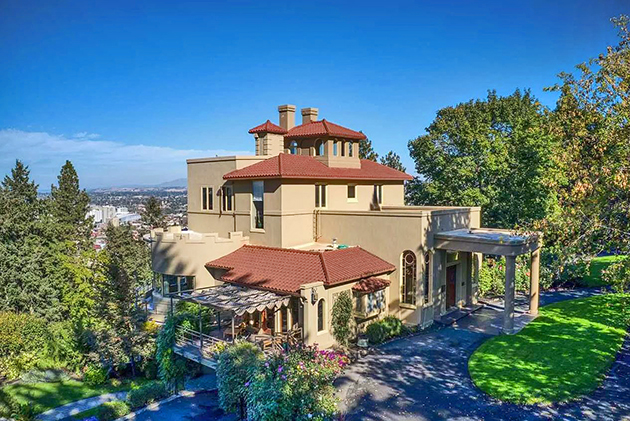
PhotoTitle: The Dill House also known as Cliff Aerie
PhotoAttribution: Spokane City/County Historic Preservation Office
Listing Status: Spokane Register
URL: http://properties.historicspokane.org/property/?PropertyID=1777
Display Marker: large_yellow
Title: Dill House
Description: Date Built: 1941
Architect: Frederick E. Westcott
Common Name: Senator Clarence & Mabel Dill House (Cliff Aerie)
The Senator Clarence and Mabel Dill House is a fine rendition of the Spanish Eclectic style and is one of the largest single-family dwellings in Spokane, WA. Resembling a block of homes in a Spanish village, the Dill House is grandiose with six stories, seven varying roof levels, and numerous wings, bays, balconies and decks. The Dill House is the largest and one of the best residential examples of the work of prominent architect Frederick E. Westcott. The house sits on a sheer cliff and commands of the most spectacular views of Spokane and surrounding northern mountain peaks and was constructed for prominent attorney and former United States senator Clarence Cleveland Dill, and his wife Mabel Dickson Dill, a dietician and educator who founded the home economics department at Whitworth College. During his tenure in Washington, D.C., Senator Dill spearheaded a plan and secured a promise from then-New York governor Franklin D. Roosevelt for the construction of the Grand Coulee Dam in eastern Washington.
Location: 47.64773, -117.42264
Address: 708 West Cliff Drive, Spokane WA 99204
PhotoURL:

PhotoTitle: The Dill House also known as Cliff Aerie
PhotoAttribution: Spokane City/County Historic Preservation Office
Listing Status: Spokane Register
URL: http://properties.historicspokane.org/property/?PropertyID=1777
Display Marker: large_yellow
ID: 81
Title: Dodd House
Description: Date Built: 1913
Architect: Unknown
Common Name: John and Sonora Smart Dodd House
Built in 1913 and 1922 respectively, the Dodd House & Garage are excellent examples of the Craftsman style. The property was built for John Bruce Dodd, a Prudential Insurance Company agent and Spokane businessman, and his wife, Sonora Smart Dodd, a prominent Spokane artist, poet, civic benefactor, philanthropist, and founder of Father's Day. From 1913 to 1950, the Dodd House achieved significance as the home of Sonora Smart Dodd, who is recognized around the world as the woman who created and promoted official city and federal recognition of Father's Day. Sonora Dodd's tireless work while residing in the Dodd House led to an official proclamation signed by United States President Richard Nixon in 1972 which made Father's Day an American holiday observed each year in June by millions of people throughout the country. Praised for enriching the religious, civic, and cultural life of Spokane, and for "giving Spokane credit in the eyes of the nation and the world," Sonora Smart Dodd's far-reaching contributions were summarized by the Spokesman-Review at her death: Honor for thousands of fathers everywhere and for her home city through [the] establishment of Father's Day is an everlasting epitaph for Mrs. John Bruce Dodd.
Location: 47.65091, -117.39485
Address: 603 South Arthur Street, Spokane WA 99202
PhotoURL: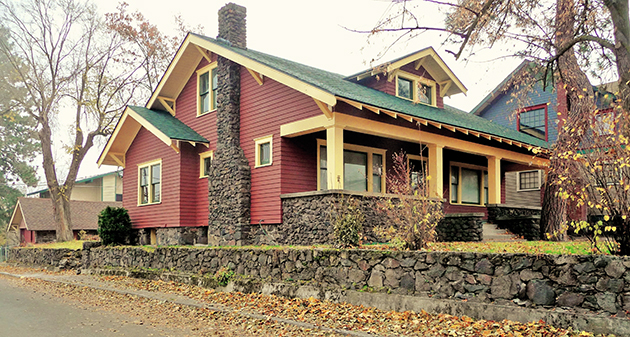
PhotoTitle: John and Sonora Smart Dodd House
PhotoAttribution: Spokane City/County Historic Preservation Office
Listing Status: Spokane Register, National Register
URL: http://properties.historicspokane.org/property/?PropertyID=1778
Display Marker: large_yellow
Title: Dodd House
Description: Date Built: 1913
Architect: Unknown
Common Name: John and Sonora Smart Dodd House
Built in 1913 and 1922 respectively, the Dodd House & Garage are excellent examples of the Craftsman style. The property was built for John Bruce Dodd, a Prudential Insurance Company agent and Spokane businessman, and his wife, Sonora Smart Dodd, a prominent Spokane artist, poet, civic benefactor, philanthropist, and founder of Father's Day. From 1913 to 1950, the Dodd House achieved significance as the home of Sonora Smart Dodd, who is recognized around the world as the woman who created and promoted official city and federal recognition of Father's Day. Sonora Dodd's tireless work while residing in the Dodd House led to an official proclamation signed by United States President Richard Nixon in 1972 which made Father's Day an American holiday observed each year in June by millions of people throughout the country. Praised for enriching the religious, civic, and cultural life of Spokane, and for "giving Spokane credit in the eyes of the nation and the world," Sonora Smart Dodd's far-reaching contributions were summarized by the Spokesman-Review at her death: Honor for thousands of fathers everywhere and for her home city through [the] establishment of Father's Day is an everlasting epitaph for Mrs. John Bruce Dodd.
Location: 47.65091, -117.39485
Address: 603 South Arthur Street, Spokane WA 99202
PhotoURL:

PhotoTitle: John and Sonora Smart Dodd House
PhotoAttribution: Spokane City/County Historic Preservation Office
Listing Status: Spokane Register, National Register
URL: http://properties.historicspokane.org/property/?PropertyID=1778
Display Marker: large_yellow
ID: 82
Title: Domke-Guse House
Description: Date Built: 1891
Architect: Loren L. Rand
Common Name: Domke-Guse House Built in 1891, the Domke-Guse House was one of the first homes erected in Browne's Addition and was built on West Pacific Avenue, the widest street in the neighborhood and one of the most prominent. The Domke-Guse House was built for William Augusta Domke and his wife, Julia H. Domke, owners and proprietors of the Domke Saloon in downtown Spokane. In 1895, prominent Spokane grocer (Guse Brothers Grocery) Fred Guse and his wife, Mary Guse, bought the property, and lived in the house with their four children for ten years. The Domke-Guse House is a good example of the Free Classic Queen Anne style and was designed by Loren L. Rand, a leading late 19th and early twentieth-century Spokane architect.
Location: 47.655796, -117.441099
Address: 1924 West Pacific Avenue, Spokane WA 99201
PhotoURL: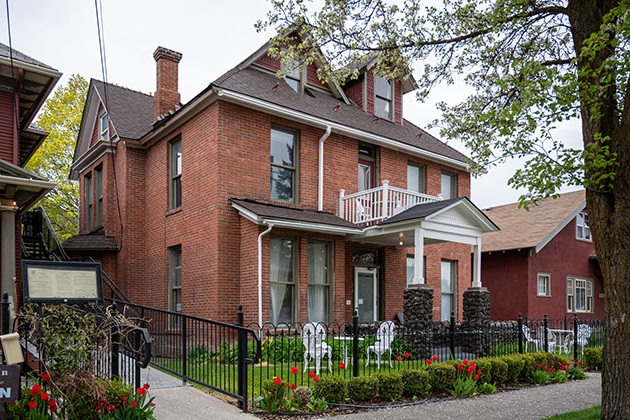
PhotoTitle: Domke-Guse House
PhotoAttribution: Spokane City/County Historic Preservation Office
Listing Status: Spokane Register, National Register
URL: http://properties.historicspokane.org/property/?PropertyID=1779
Display Marker: large_yellow
Title: Domke-Guse House
Description: Date Built: 1891
Architect: Loren L. Rand
Common Name: Domke-Guse House Built in 1891, the Domke-Guse House was one of the first homes erected in Browne's Addition and was built on West Pacific Avenue, the widest street in the neighborhood and one of the most prominent. The Domke-Guse House was built for William Augusta Domke and his wife, Julia H. Domke, owners and proprietors of the Domke Saloon in downtown Spokane. In 1895, prominent Spokane grocer (Guse Brothers Grocery) Fred Guse and his wife, Mary Guse, bought the property, and lived in the house with their four children for ten years. The Domke-Guse House is a good example of the Free Classic Queen Anne style and was designed by Loren L. Rand, a leading late 19th and early twentieth-century Spokane architect.
Location: 47.655796, -117.441099
Address: 1924 West Pacific Avenue, Spokane WA 99201
PhotoURL:

PhotoTitle: Domke-Guse House
PhotoAttribution: Spokane City/County Historic Preservation Office
Listing Status: Spokane Register, National Register
URL: http://properties.historicspokane.org/property/?PropertyID=1779
Display Marker: large_yellow
ID: 83
Title: Doran House
Description: Date Built: 1917
Architect: Unknown/Henry Lydell (builder) and Frank Stanek (landscape architect)
Common Name:John & Genevieve Doran House The Doran House is an excellent example of the Arts & Crafts tradition interpreted in the Craftsman style. The home was erected by Spokane builder Henry R. Lydell, who constructed at least seven homes in the Rockwood neighborhood as well as other homes throughout Spokane. The home's design, materials, and craftsmanship are typical of the early twentieth-century Craftsman style and are evident in the covered front porch, widely overhanging roof eaves, scroll-sawn brackets, wood shingle wall cladding, cut stone foundation, thick brick porch wall, and large square brick porch piers. The house was built for Genevieve Paterson Doran and her husband, John Doran, a noted civic leader, city benefactor, and successful businessman who owned and operated the John Doran Company.
Location: 47.63491, -117.39646
Address: 2207 South Rockwood Boulevard, Spokane WA 99203
PhotoURL: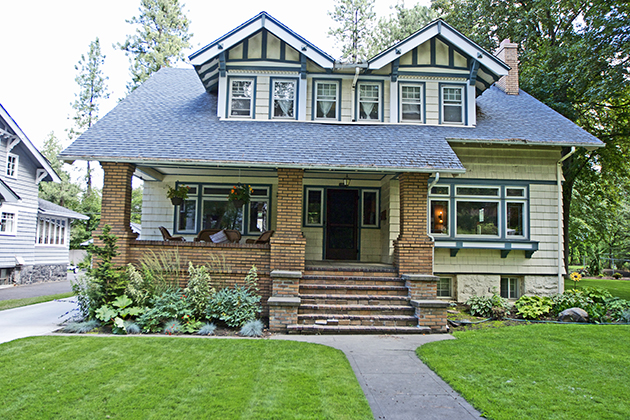
PhotoTitle: John and Genevieve Doran House
PhotoAttribution: Spokane City/County Historic Preservation Office
Listing Status: Spokane Register, National Register
URL: http://properties.historicspokane.org/property/?PropertyID=1780
Display Marker: large_yellow
Title: Doran House
Description: Date Built: 1917
Architect: Unknown/Henry Lydell (builder) and Frank Stanek (landscape architect)
Common Name:John & Genevieve Doran House The Doran House is an excellent example of the Arts & Crafts tradition interpreted in the Craftsman style. The home was erected by Spokane builder Henry R. Lydell, who constructed at least seven homes in the Rockwood neighborhood as well as other homes throughout Spokane. The home's design, materials, and craftsmanship are typical of the early twentieth-century Craftsman style and are evident in the covered front porch, widely overhanging roof eaves, scroll-sawn brackets, wood shingle wall cladding, cut stone foundation, thick brick porch wall, and large square brick porch piers. The house was built for Genevieve Paterson Doran and her husband, John Doran, a noted civic leader, city benefactor, and successful businessman who owned and operated the John Doran Company.
Location: 47.63491, -117.39646
Address: 2207 South Rockwood Boulevard, Spokane WA 99203
PhotoURL:

PhotoTitle: John and Genevieve Doran House
PhotoAttribution: Spokane City/County Historic Preservation Office
Listing Status: Spokane Register, National Register
URL: http://properties.historicspokane.org/property/?PropertyID=1780
Display Marker: large_yellow
ID: 84
Title: Dorothy Darby Smith House
Description: Date Built: 1910
Architect: Unknown
Common Name: Dorothy Darby Smith House
Dorothy Darby was born in Spokane on April 10, 1909, the only child of Ethel Standley and Hunter Darby. She was introduced to live performance as a teenager by way of vaudeville acts, touring road shows and the occasional play produced by local groups at the Hippodrome and Pantages theaters. For six decades, Dorothy Darby Smith nurtured community theater in Spokane with unmatched energy, passion and tenacity. As a co-founder of Spokane Civic Theatre and a driving force both behind the scene and onstage, she helped the group mature into one of the country's most respected amateur theatrical organizations. For more on Dorothy Darby Smith and her home see the Spokane Register Nomination.
Location: 47.63756, -117.40192
Address: 612 East 19th Avenue, Spokane WA 99203
PhotoURL: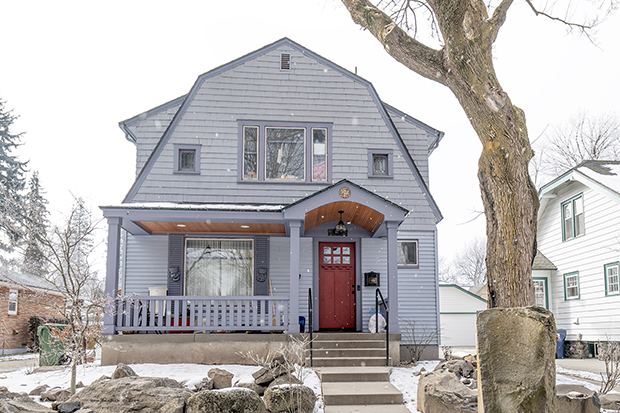
PhotoTitle: Dorothy Darby Smith House
PhotoAttribution: Spokane City/County Historic Preservation Office
Listing Status: Spokane Register
URL: http://properties.historicspokane.org/property/?PropertyID=1939
Display Marker: large_yellow
Title: Dorothy Darby Smith House
Description: Date Built: 1910
Architect: Unknown
Common Name: Dorothy Darby Smith House
Dorothy Darby was born in Spokane on April 10, 1909, the only child of Ethel Standley and Hunter Darby. She was introduced to live performance as a teenager by way of vaudeville acts, touring road shows and the occasional play produced by local groups at the Hippodrome and Pantages theaters. For six decades, Dorothy Darby Smith nurtured community theater in Spokane with unmatched energy, passion and tenacity. As a co-founder of Spokane Civic Theatre and a driving force both behind the scene and onstage, she helped the group mature into one of the country's most respected amateur theatrical organizations. For more on Dorothy Darby Smith and her home see the Spokane Register Nomination.
Location: 47.63756, -117.40192
Address: 612 East 19th Avenue, Spokane WA 99203
PhotoURL:

PhotoTitle: Dorothy Darby Smith House
PhotoAttribution: Spokane City/County Historic Preservation Office
Listing Status: Spokane Register
URL: http://properties.historicspokane.org/property/?PropertyID=1939
Display Marker: large_yellow
ID: 85
Title: Dowling & Cattle Warehouse
Description: Date Built: 1911
Architect: Unknown
Common Name: Dowling & Cattle Warehouse
Erected in 1911 as a plain two-story brick masonry building, the Dowling & Cattle Warehouse is a good representation of the industrial/commercial warehouse building type. The structure was built for plumber Patrick J. Dowling and real estate investor Alfred T. Cattle, business partners who use the building for storage and also leased the space to various renters. After 1936, the building served as a storage, drayage, and distribution headquarters for a number of local businesses. The Dowling & Cattle Warehouse exhibits architectural significance as part of a unique, contiguous facade of mostly two-story commercial vernacular industrial/commercial warehouse buildings that were erected in the first part of the twentieth century in east downtown Spokane.
Location: 47.65527, -117.41424
Address: 117 West Pacific Avenue, Spokane WA 99201
PhotoURL:
PhotoTitle: The Dowling & Cattle Warehouse
PhotoAttribution: Spokane City/County Historic Preservation Office
Listing Status: Spokane Register, National Register
URL: http://properties.historicspokane.org/property/?PropertyID=1781
Display Marker: large_yellow
Title: Dowling & Cattle Warehouse
Description: Date Built: 1911
Architect: Unknown
Common Name: Dowling & Cattle Warehouse
Erected in 1911 as a plain two-story brick masonry building, the Dowling & Cattle Warehouse is a good representation of the industrial/commercial warehouse building type. The structure was built for plumber Patrick J. Dowling and real estate investor Alfred T. Cattle, business partners who use the building for storage and also leased the space to various renters. After 1936, the building served as a storage, drayage, and distribution headquarters for a number of local businesses. The Dowling & Cattle Warehouse exhibits architectural significance as part of a unique, contiguous facade of mostly two-story commercial vernacular industrial/commercial warehouse buildings that were erected in the first part of the twentieth century in east downtown Spokane.
Location: 47.65527, -117.41424
Address: 117 West Pacific Avenue, Spokane WA 99201
PhotoURL:

PhotoTitle: The Dowling & Cattle Warehouse
PhotoAttribution: Spokane City/County Historic Preservation Office
Listing Status: Spokane Register, National Register
URL: http://properties.historicspokane.org/property/?PropertyID=1781
Display Marker: large_yellow
ID: 86
Title: Dry Goods Realty Building
Description: Date Built: 1909
Architect: Loren L. Rand/Frederick Phair
Common Name: Display House
The Dry Goods Realty Building is architecturally significant as an example of the restrained yet elegant styling of the industrial buildings constructed in Spokane at the turn of the century. The aesthetically attractive design and subtle architectural compatibility with the building's notable counterpart the Crescent Warehouse reflects the value merchants placed on the architectural styling of even working-class buildings. The building is historically significant for its association with James M. Comstock and Robert B. Paterson and their associates Eugene A. Shadle and James L. Paine, founder of the Crescent Department Store, one of Spokane's most eminent business enterprises. The Dry Goods Building demonstrates the development of Spokane's business district, as the building was used for both warehouse and retail purposes in the downtown transportation corridor.
Location: 47.6549, -117.42546
Address: 170 South Lincoln Street, Spokane WA 99201
PhotoURL: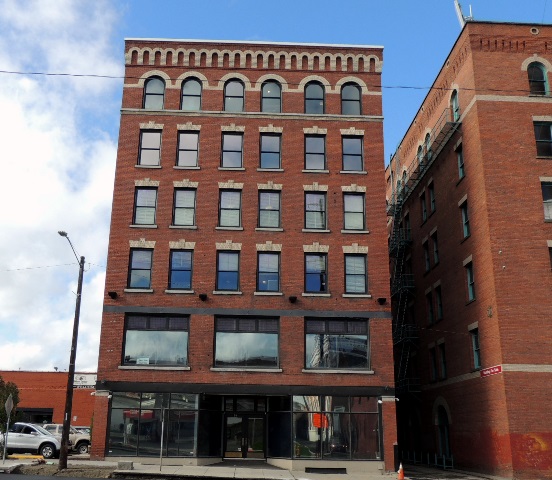
PhotoTitle: Dry Goods Realty Building
PhotoAttribution: Spokane City/County Historic Preservation Office
Listing Status: Spokane Register, National Register
URL: http://properties.historicspokane.org/property/?PropertyID=1783
Display Marker: large_yellow
Title: Dry Goods Realty Building
Description: Date Built: 1909
Architect: Loren L. Rand/Frederick Phair
Common Name: Display House
The Dry Goods Realty Building is architecturally significant as an example of the restrained yet elegant styling of the industrial buildings constructed in Spokane at the turn of the century. The aesthetically attractive design and subtle architectural compatibility with the building's notable counterpart the Crescent Warehouse reflects the value merchants placed on the architectural styling of even working-class buildings. The building is historically significant for its association with James M. Comstock and Robert B. Paterson and their associates Eugene A. Shadle and James L. Paine, founder of the Crescent Department Store, one of Spokane's most eminent business enterprises. The Dry Goods Building demonstrates the development of Spokane's business district, as the building was used for both warehouse and retail purposes in the downtown transportation corridor.
Location: 47.6549, -117.42546
Address: 170 South Lincoln Street, Spokane WA 99201
PhotoURL:

PhotoTitle: Dry Goods Realty Building
PhotoAttribution: Spokane City/County Historic Preservation Office
Listing Status: Spokane Register, National Register
URL: http://properties.historicspokane.org/property/?PropertyID=1783
Display Marker: large_yellow
ID: 87
Title: Duquesne Apartments
Description: Date Built: 1904
Architect: Unknown
Common Name: Duquesne Apartments
The Duquesne Apartments building is historically significant for its association with Spokane's most rapid period of growth from 1900 to 1910. Built in the Commercial Vernacular style essentially unaltered from the time of construction, the building exhibits the predominant characteristics of a single-room occupancy hotel, although the structure functioned as an apartment building. The living units were small rooms with no kitchen or bathroom, only a sink. The Duquesne has operated continuously as a lower to middle income apartment building from its construction in 1904 to ca. 2006. The building is a rare example in the downtown of a mid-block freestanding apartment building.
Location: 47.65535, -117.41267
Address: 29 West Pacific Avenue, Spokane WA 99201
PhotoURL: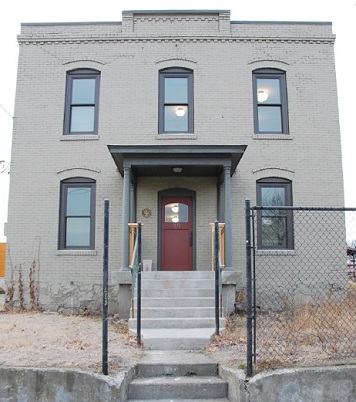
PhotoTitle: Duquesne Apartments
PhotoAttribution: Spokane City/County Historic Preservation Office
Listing Status: Spokane Register, National Register
URL: http://properties.historicspokane.org/property/?PropertyID=1784
Display Marker: large_yellow
Title: Duquesne Apartments
Description: Date Built: 1904
Architect: Unknown
Common Name: Duquesne Apartments
The Duquesne Apartments building is historically significant for its association with Spokane's most rapid period of growth from 1900 to 1910. Built in the Commercial Vernacular style essentially unaltered from the time of construction, the building exhibits the predominant characteristics of a single-room occupancy hotel, although the structure functioned as an apartment building. The living units were small rooms with no kitchen or bathroom, only a sink. The Duquesne has operated continuously as a lower to middle income apartment building from its construction in 1904 to ca. 2006. The building is a rare example in the downtown of a mid-block freestanding apartment building.
Location: 47.65535, -117.41267
Address: 29 West Pacific Avenue, Spokane WA 99201
PhotoURL:

PhotoTitle: Duquesne Apartments
PhotoAttribution: Spokane City/County Historic Preservation Office
Listing Status: Spokane Register, National Register
URL: http://properties.historicspokane.org/property/?PropertyID=1784
Display Marker: large_yellow
ID: 88
Title: Durkin House and Garage
Description: Date Built: 1910
Architect: William J. Ballard (House), Franklin Manz (Garage)
Common Name: Jimmie & Margaret Durkin House and Garage
Built in 1910 and 1915 respectively, the Jimmie & Margaret Durkin House & Garage are excellent examples of the American Arts & Crafts tradition expressed in the Craftsman style. Typical of many large homes built in this tradition, the Durkin House is a full two stories with a low-pitched hip roof and low-slung hip dormers. With an emphasis on horizontal lines and organic integration, the home is clad with "natural" building materials, including black basalt at the foundation, cobbled and coarse textured clinker brick at the first floor, false half-timbering and stucco infill on the second floor and gable peaks with wood trim, all typical of the Craftsman style. The home's facade is dominated by a full-width front porch on the first floor which renders a strong Craftsman-inspired horizontal orientation in both shadow and design. The house and garage retain excellent integrity in location, design, materials, workmanship, and association as Craftsman style buildings from the early twentieth century in Spokane.
Location: 47.64643, -117.42468
Address: 930 South Lincoln Street, Spokane WA 99204
PhotoURL: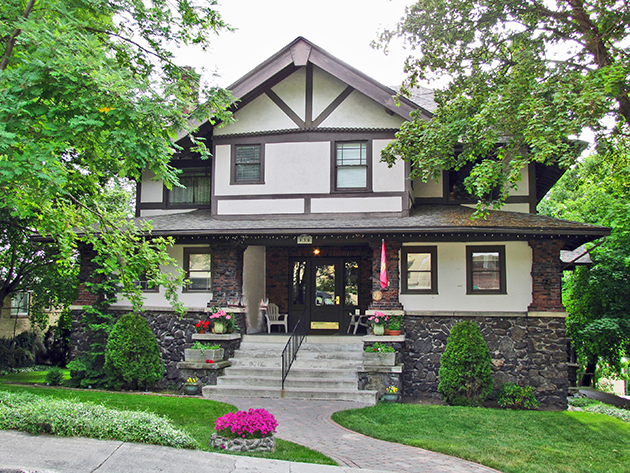
PhotoTitle: Jimmie and Margaret Durkin House
PhotoAttribution: Spokane City/County Historic Preservation Office
Listing Status: Spokane Register
URL: http://properties.historicspokane.org/property/?PropertyID=1785
Display Marker: large_yellow
Title: Durkin House and Garage
Description: Date Built: 1910
Architect: William J. Ballard (House), Franklin Manz (Garage)
Common Name: Jimmie & Margaret Durkin House and Garage
Built in 1910 and 1915 respectively, the Jimmie & Margaret Durkin House & Garage are excellent examples of the American Arts & Crafts tradition expressed in the Craftsman style. Typical of many large homes built in this tradition, the Durkin House is a full two stories with a low-pitched hip roof and low-slung hip dormers. With an emphasis on horizontal lines and organic integration, the home is clad with "natural" building materials, including black basalt at the foundation, cobbled and coarse textured clinker brick at the first floor, false half-timbering and stucco infill on the second floor and gable peaks with wood trim, all typical of the Craftsman style. The home's facade is dominated by a full-width front porch on the first floor which renders a strong Craftsman-inspired horizontal orientation in both shadow and design. The house and garage retain excellent integrity in location, design, materials, workmanship, and association as Craftsman style buildings from the early twentieth century in Spokane.
Location: 47.64643, -117.42468
Address: 930 South Lincoln Street, Spokane WA 99204
PhotoURL:

PhotoTitle: Jimmie and Margaret Durkin House
PhotoAttribution: Spokane City/County Historic Preservation Office
Listing Status: Spokane Register
URL: http://properties.historicspokane.org/property/?PropertyID=1785
Display Marker: large_yellow
ID: 89
Title: Dutton House
Description: Date Built: 1906
Architect: Isaac J. Galbraith
Common Name: Julius M. Dutton House
The Julius M. Dutton House demonstrates American Foursquare form with Colonial Revival and Craftsman influences. The form is named for the fact that both ground and second stories feature a room in each corner, creating a square, box-shaped footprint. The Dutton house is an unusual interpretation of the style, which compares favorably with other homes in the Sherwood Addition, a popular streetcar suburb in Spokane's West Central. The most prominent and unique features of the Dutton House are the half-round openings at the porch where other houses might display simple drain openings for an enclosed half porch, and the graceful oval window in the center of the upper facade. The Dutton house typifies one of the popular styles in the growing suburbs, often promoted in pattern books, although it was not as common in West Central. As such, it is a remaining embodiment of a phenomenon that was occurring throughout the city and across the nation at the turn of the century.
Location: 47.66916, -117.45464
Address: 2918 West Sharp Avenue, Spokane WA 99201
PhotoURL: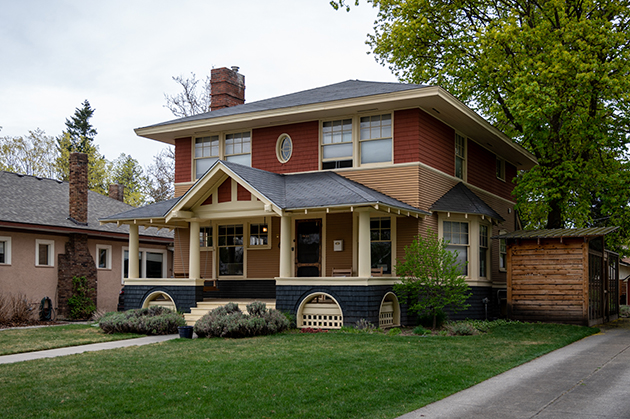
PhotoTitle: Julius M. Dutton House
PhotoAttribution: Spokane City/County Historic Preservation Office
Listing Status: Spokane Register
URL: http://properties.historicspokane.org/property/?PropertyID=1786
Display Marker: large_yellow
Title: Dutton House
Description: Date Built: 1906
Architect: Isaac J. Galbraith
Common Name: Julius M. Dutton House
The Julius M. Dutton House demonstrates American Foursquare form with Colonial Revival and Craftsman influences. The form is named for the fact that both ground and second stories feature a room in each corner, creating a square, box-shaped footprint. The Dutton house is an unusual interpretation of the style, which compares favorably with other homes in the Sherwood Addition, a popular streetcar suburb in Spokane's West Central. The most prominent and unique features of the Dutton House are the half-round openings at the porch where other houses might display simple drain openings for an enclosed half porch, and the graceful oval window in the center of the upper facade. The Dutton house typifies one of the popular styles in the growing suburbs, often promoted in pattern books, although it was not as common in West Central. As such, it is a remaining embodiment of a phenomenon that was occurring throughout the city and across the nation at the turn of the century.
Location: 47.66916, -117.45464
Address: 2918 West Sharp Avenue, Spokane WA 99201
PhotoURL:

PhotoTitle: Julius M. Dutton House
PhotoAttribution: Spokane City/County Historic Preservation Office
Listing Status: Spokane Register
URL: http://properties.historicspokane.org/property/?PropertyID=1786
Display Marker: large_yellow
ID: 90
Title: Dwight House
Description: Date Built: 1887
Architect: Herman Preusse
Common Name: Mary E. Dwight House Built in 1886-1887, the Dwight House is one of the earliest homes remaining in the Browne's Addition National Historic District. Prominent Spokane architect Herman Preusse designed the home and it is a high style example of Queen Anne design of the Victorian period. Mary P. Willis and Daniel H. Dwight, a real estate investor who owned property throughout Spokane, lived in the house until selling it to their daughter, Mary E. Dwight, who was born in the house on August 12, 1895. Mary was an accomplished and well-educated artist, poet and author who contributed to the arts in Spokane throughout her 91 year life. The home remains a single-family residence, despite a short stint as a restaurant, and is one of the most intact homes in Browne's Addition.
Location: 47.65522, -117.44044
Address: 1905 West Pacific Avenue, Spokane WA 99201
PhotoURL: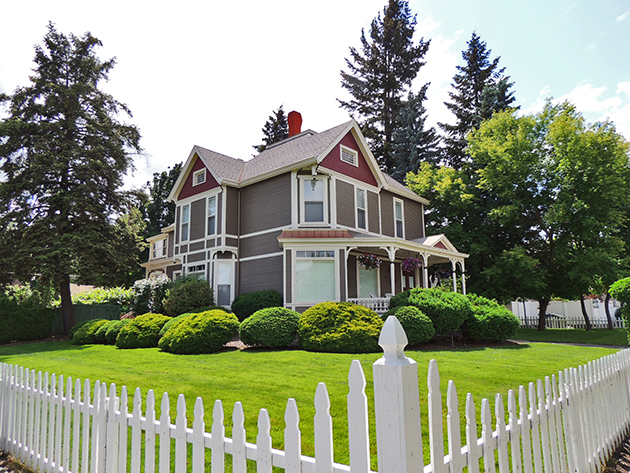
PhotoTitle: Mary E. Dwight House
PhotoAttribution: Spokane City/County Historic Preservation Office
Listing Status: Spokane Register, National Register
URL: http://properties.historicspokane.org/property/?PropertyID=1787
Display Marker: large_yellow
Title: Dwight House
Description: Date Built: 1887
Architect: Herman Preusse
Common Name: Mary E. Dwight House Built in 1886-1887, the Dwight House is one of the earliest homes remaining in the Browne's Addition National Historic District. Prominent Spokane architect Herman Preusse designed the home and it is a high style example of Queen Anne design of the Victorian period. Mary P. Willis and Daniel H. Dwight, a real estate investor who owned property throughout Spokane, lived in the house until selling it to their daughter, Mary E. Dwight, who was born in the house on August 12, 1895. Mary was an accomplished and well-educated artist, poet and author who contributed to the arts in Spokane throughout her 91 year life. The home remains a single-family residence, despite a short stint as a restaurant, and is one of the most intact homes in Browne's Addition.
Location: 47.65522, -117.44044
Address: 1905 West Pacific Avenue, Spokane WA 99201
PhotoURL:

PhotoTitle: Mary E. Dwight House
PhotoAttribution: Spokane City/County Historic Preservation Office
Listing Status: Spokane Register, National Register
URL: http://properties.historicspokane.org/property/?PropertyID=1787
Display Marker: large_yellow
ID: 91
Title: Dyar-Kiesling House
Description: Date Built: 1912
Architect: Franklin Manz/C.A. Landsdowne
Common Name: Dyar-Kiesling House
This unusual house was designed by Franklin Manz, prominent Spokane architect, and built by Rockwood home builder C.A. Lansdowne in 1912 for a reported $13,500 - a sizeable sum of money for that time. The American Foursquare-style home was purchased by Ralph E. Dyar, famed author, playwright and former director of the Spokesman-Review promotion and research department. Dyar, a descendant of one of the first passengers brought to America aboard the Mayflower, lived in the home for forty years together with his wife Else Kiesling Dyar. The house changed hands several times after the Else's death in 1967, and the property is currently owned by Vernon and Janine Arneson
Location: 47.64398, -117.40303
Address: 526 East 12th Avenue, Spokane WA 99202
PhotoURL: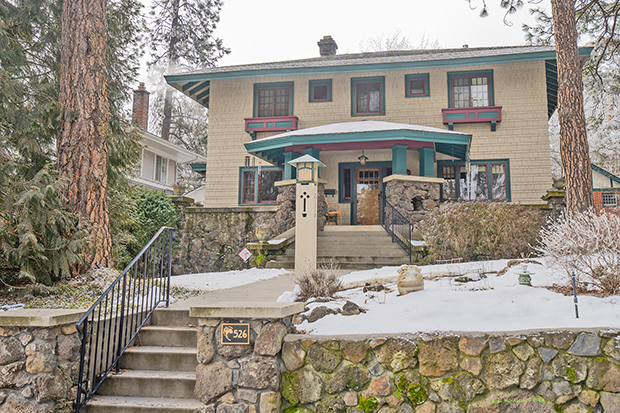
PhotoTitle: Dyar-Kiesling House
PhotoAttribution: Spokane City/County Historic Preservation Office
Listing Status: Spokane Register, National Register
URL: http://properties.historicspokane.org/property/?PropertyID=1788
Display Marker: large_yellow
Title: Dyar-Kiesling House
Description: Date Built: 1912
Architect: Franklin Manz/C.A. Landsdowne
Common Name: Dyar-Kiesling House
This unusual house was designed by Franklin Manz, prominent Spokane architect, and built by Rockwood home builder C.A. Lansdowne in 1912 for a reported $13,500 - a sizeable sum of money for that time. The American Foursquare-style home was purchased by Ralph E. Dyar, famed author, playwright and former director of the Spokesman-Review promotion and research department. Dyar, a descendant of one of the first passengers brought to America aboard the Mayflower, lived in the home for forty years together with his wife Else Kiesling Dyar. The house changed hands several times after the Else's death in 1967, and the property is currently owned by Vernon and Janine Arneson
Location: 47.64398, -117.40303
Address: 526 East 12th Avenue, Spokane WA 99202
PhotoURL:

PhotoTitle: Dyar-Kiesling House
PhotoAttribution: Spokane City/County Historic Preservation Office
Listing Status: Spokane Register, National Register
URL: http://properties.historicspokane.org/property/?PropertyID=1788
Display Marker: large_yellow
ID: 92
Title: Dybdall Grist Mill (collapsed)
Description: Date Built: 1897
Architect: Ole C. Dybdall
Common Name: Chapman Lake Mill
In 1896, Ole C. Dybdall purchased the sawmill and property on Chapman Lake from previous owners Fred Wagner and Henry Hinkney. The following year, Dybdall constructed a turbine-driven grist mill on Rock Creek, just below the southern tip of Chapman Lake. The mill stands today, with the original equipment in place. The site is a complex, multi-stage operation that required considerable technical understanding and engineering ability to assemble. Some supplemental machinery was installed in 1910, although the process itself remain basically unchanged. At its peak in the 1920s, the Dybdall Grist Mill produced 30 barrels of flour a day. As a result of its eight-stage roller grinding process (in comparison to the standard six-stage process), the mill was well-known throughout the area for the finest baking flour available.
Location: 47.3540776, -117.5647978
Address: 11300 West Chapman Lake Road, Cheney WA 99004
PhotoURL: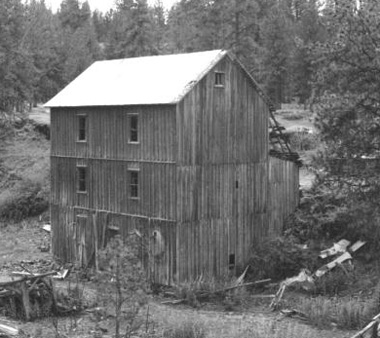
PhotoTitle: The once-standing Dybdall Grist Mill
PhotoAttribution: Spokane City/County Historic Preservation Office
Listing Status: National Register
URL: http://properties.historicspokane.org/property/?PropertyID=1992
Display Marker: large_yellow
Title: Dybdall Grist Mill (collapsed)
Description: Date Built: 1897
Architect: Ole C. Dybdall
Common Name: Chapman Lake Mill
In 1896, Ole C. Dybdall purchased the sawmill and property on Chapman Lake from previous owners Fred Wagner and Henry Hinkney. The following year, Dybdall constructed a turbine-driven grist mill on Rock Creek, just below the southern tip of Chapman Lake. The mill stands today, with the original equipment in place. The site is a complex, multi-stage operation that required considerable technical understanding and engineering ability to assemble. Some supplemental machinery was installed in 1910, although the process itself remain basically unchanged. At its peak in the 1920s, the Dybdall Grist Mill produced 30 barrels of flour a day. As a result of its eight-stage roller grinding process (in comparison to the standard six-stage process), the mill was well-known throughout the area for the finest baking flour available.
Location: 47.3540776, -117.5647978
Address: 11300 West Chapman Lake Road, Cheney WA 99004
PhotoURL:

PhotoTitle: The once-standing Dybdall Grist Mill
PhotoAttribution: Spokane City/County Historic Preservation Office
Listing Status: National Register
URL: http://properties.historicspokane.org/property/?PropertyID=1992
Display Marker: large_yellow
ID: 93
Title: Ehrenberg House
Description: Date Built: 1911
Architect: John Walter Ehrenberg
Common Name: Gus & Florence Ehrenberg House
The Gus & Florence Ehrenberg House was built in 1911 in the Ehrenberg Subdivision, part of the Altamont Addition in East Central Spokane. The home is in excellent condition and is a hallmark example of the Craftsman style applied to a single-family residence. Skillfully articulated, some of the windows have thick beveled-glass lights that are divided by lead strips, which form multi-faceted geometric diamond-shaped patterns. Interior Craftsman-style details include a spacious reception hall/living/dining room and handcrafted hand-polished fir woodwork. The home's original design, horizontal emphasis, and natural building materials (stucco, clinker brick, wood, metal) all work together to form the handcrafted "back to nature" aesthetic synonymous with the Craftsman tradition.
Location: 47.64355, -117.37382
Address: 1304 South Cook Street, Spokane WA 99202
PhotoURL: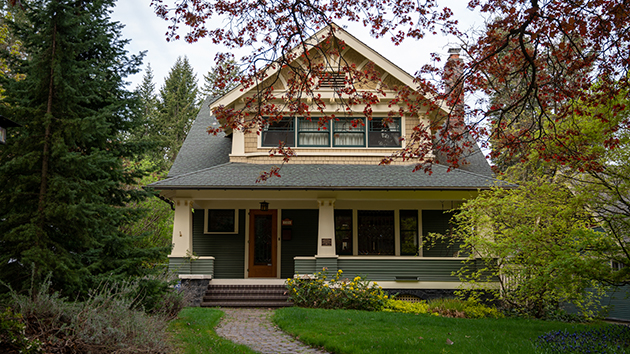
PhotoTitle: Gus and Florence Ehrenberg House
PhotoAttribution: Spokane City/County Historic Preservation Office
Listing Status: Spokane Register, National Register
URL: http://properties.historicspokane.org/property/?PropertyID=1789
Display Marker: large_yellow
Title: Ehrenberg House
Description: Date Built: 1911
Architect: John Walter Ehrenberg
Common Name: Gus & Florence Ehrenberg House
The Gus & Florence Ehrenberg House was built in 1911 in the Ehrenberg Subdivision, part of the Altamont Addition in East Central Spokane. The home is in excellent condition and is a hallmark example of the Craftsman style applied to a single-family residence. Skillfully articulated, some of the windows have thick beveled-glass lights that are divided by lead strips, which form multi-faceted geometric diamond-shaped patterns. Interior Craftsman-style details include a spacious reception hall/living/dining room and handcrafted hand-polished fir woodwork. The home's original design, horizontal emphasis, and natural building materials (stucco, clinker brick, wood, metal) all work together to form the handcrafted "back to nature" aesthetic synonymous with the Craftsman tradition.
Location: 47.64355, -117.37382
Address: 1304 South Cook Street, Spokane WA 99202
PhotoURL:

PhotoTitle: Gus and Florence Ehrenberg House
PhotoAttribution: Spokane City/County Historic Preservation Office
Listing Status: Spokane Register, National Register
URL: http://properties.historicspokane.org/property/?PropertyID=1789
Display Marker: large_yellow
ID: 94
Title: Eldridge Building
Description: Date Built: 1925
Architect: Gustav Pehrson
Common Name: Eldridge Building
The Eldridge Buildings is historically significant as a distinctive example of the commercial structures associated with the evolution of the automobile culture. Constructed in 1925 for one of the Northwest's leading Buick dealerships, the Eldridge Building was acclaimed as "The largest building in the state of Washington devoted to the sales and service of motor cars." Located on West First Avenue, the building established an anchor for an area of downtown Spokane historically linked to commercial transportation resources. Associated with the carriage trade before 1910, First Avenue, along with Sprague Avenue between Madison and Cedar, came to be known as "automobile row" by the mid-1920s. The building, which incorporated numerous modern features and innovations, is architecturally significant as an indicator of the versatility and skill of G. Albin Pehrson, one of Spokane's most influential architects.
Location: 47.6562, -117.43207
Address: 1325 West 1st Avenue, Spokane WA 99201
PhotoURL: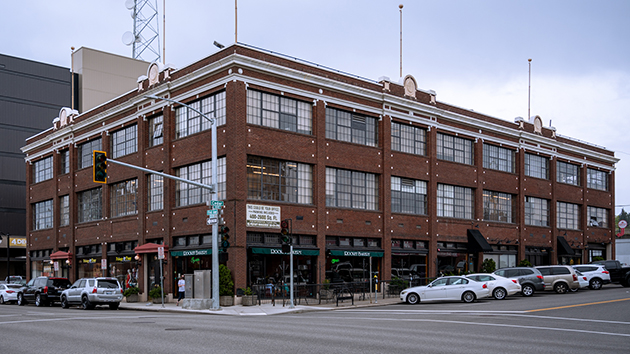
PhotoTitle: Eldridge Building
PhotoAttribution: Spokane City/County Historic Preservation Office
Listing Status: Spokane Register, National Register
URL: http://properties.historicspokane.org/property/?PropertyID=1790
Display Marker: large_yellow
Title: Eldridge Building
Description: Date Built: 1925
Architect: Gustav Pehrson
Common Name: Eldridge Building
The Eldridge Buildings is historically significant as a distinctive example of the commercial structures associated with the evolution of the automobile culture. Constructed in 1925 for one of the Northwest's leading Buick dealerships, the Eldridge Building was acclaimed as "The largest building in the state of Washington devoted to the sales and service of motor cars." Located on West First Avenue, the building established an anchor for an area of downtown Spokane historically linked to commercial transportation resources. Associated with the carriage trade before 1910, First Avenue, along with Sprague Avenue between Madison and Cedar, came to be known as "automobile row" by the mid-1920s. The building, which incorporated numerous modern features and innovations, is architecturally significant as an indicator of the versatility and skill of G. Albin Pehrson, one of Spokane's most influential architects.
Location: 47.6562, -117.43207
Address: 1325 West 1st Avenue, Spokane WA 99201
PhotoURL:

PhotoTitle: Eldridge Building
PhotoAttribution: Spokane City/County Historic Preservation Office
Listing Status: Spokane Register, National Register
URL: http://properties.historicspokane.org/property/?PropertyID=1790
Display Marker: large_yellow
ID: 95
Title: Elks Club
Description: Date Built:1919 Architect: Edward J. Baume & Kirtland K. Cutter
Common Name: North Coast Life
The Elk's Temple lies in the heart of the Riverside Avenue Historic District, along a serpentine section of Riverside Avenue designed in accordance with the recommendations the renowned Olmsted Brothers Landscape Architecture firm submitted to the Board of Park Commissioners. The Elks were the most popular organization in the city when the building was constructed in 1919. In fact, the Spokane lodge boasted membership second only to the club in Los Angeles. The building's ornate but dignified exterior, designed by Spokane's most celebrated architect Kirtland Cutter, is in the Second Renaissance Revival style. The property is now owned by the North Coast Life Insurance Company, which won an Award of Outstanding merit from the Washington Trust for Historic Preservation for its certified rehabilitation of the building in 1983.
Location: 47.65872, -117.42882
Address: 1116 West Riverside Avenue, Spokane WA 99201
PhotoURL: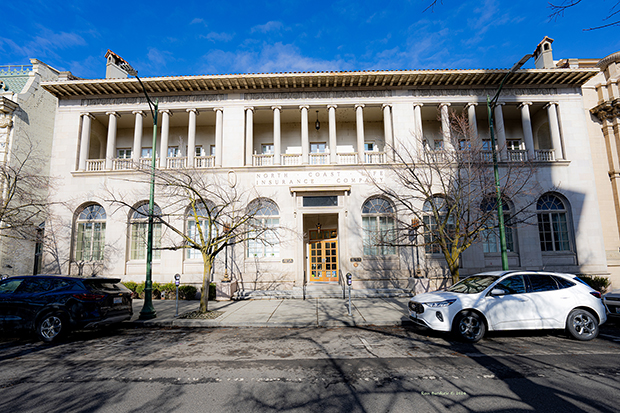
PhotoTitle: Elks Club
PhotoAttribution: Spokane City/County Historic Preservation Office
Listing Status: Spokane Register
URL: http://properties.historicspokane.org/property/?PropertyID=1791
Display Marker: large_yellow
Title: Elks Club
Description: Date Built:1919 Architect: Edward J. Baume & Kirtland K. Cutter
Common Name: North Coast Life
The Elk's Temple lies in the heart of the Riverside Avenue Historic District, along a serpentine section of Riverside Avenue designed in accordance with the recommendations the renowned Olmsted Brothers Landscape Architecture firm submitted to the Board of Park Commissioners. The Elks were the most popular organization in the city when the building was constructed in 1919. In fact, the Spokane lodge boasted membership second only to the club in Los Angeles. The building's ornate but dignified exterior, designed by Spokane's most celebrated architect Kirtland Cutter, is in the Second Renaissance Revival style. The property is now owned by the North Coast Life Insurance Company, which won an Award of Outstanding merit from the Washington Trust for Historic Preservation for its certified rehabilitation of the building in 1983.
Location: 47.65872, -117.42882
Address: 1116 West Riverside Avenue, Spokane WA 99201
PhotoURL:

PhotoTitle: Elks Club
PhotoAttribution: Spokane City/County Historic Preservation Office
Listing Status: Spokane Register
URL: http://properties.historicspokane.org/property/?PropertyID=1791
Display Marker: large_yellow
ID: 96
Title: Elmendorf House
Description: Date Built: 1903
Architect: Unknown
Common Name: Frederic Elmendorf House
The Elmendorf House is historically significant for its association with pioneer businessman and civic leader Frederic Elmendorf and architecturally significant as a rare local example of the Dutch Colonial Revival style. Arriving from New York before Spokane's Great Fire of 1889, Elmendorf founded Elmendorf and Elmendorf Real Estate, Loan and Insurance Company together with his brother. Upon his death, the company was one of the largest and oldest business of its kind in the city. Also notably identified with civic progress, Elmendorf was the original incorporator of the present Chamber of Commerce and was involved in the development of numerous other civic organizations.
Location: 47.64766, -117.40627
Address: 241 East 9th Avenue, Spokane WA 99202
PhotoURL: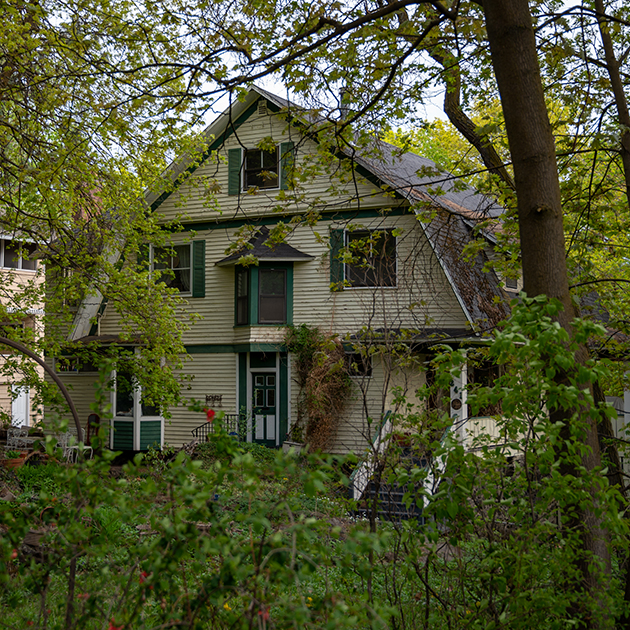
PhotoTitle: Frederic Elmendorf House
PhotoAttribution: Spokane City/County Historic Preservation Office
Listing Status: Spokane Register
URL: http://properties.historicspokane.org/property/?PropertyID=1792
Display Marker: large_yellow
Title: Elmendorf House
Description: Date Built: 1903
Architect: Unknown
Common Name: Frederic Elmendorf House
The Elmendorf House is historically significant for its association with pioneer businessman and civic leader Frederic Elmendorf and architecturally significant as a rare local example of the Dutch Colonial Revival style. Arriving from New York before Spokane's Great Fire of 1889, Elmendorf founded Elmendorf and Elmendorf Real Estate, Loan and Insurance Company together with his brother. Upon his death, the company was one of the largest and oldest business of its kind in the city. Also notably identified with civic progress, Elmendorf was the original incorporator of the present Chamber of Commerce and was involved in the development of numerous other civic organizations.
Location: 47.64766, -117.40627
Address: 241 East 9th Avenue, Spokane WA 99202
PhotoURL:

PhotoTitle: Frederic Elmendorf House
PhotoAttribution: Spokane City/County Historic Preservation Office
Listing Status: Spokane Register
URL: http://properties.historicspokane.org/property/?PropertyID=1792
Display Marker: large_yellow
ID: 97
Title: Empire State Building
Description: Date Built:1900
Architect:John K. Dow
Common Name: Great Western Building
The Empire State Building, known today as the Great Western Savings and Loan Building, is one of the most attractive buildings in Spokane's central business district. The six-story building is linked to one of the most historic architectural groupings in the city. The street elevations of the building are defined by continuous vertical piers and arcades from the third through fifth stories. Horizontal movement is achieved by string courses at second, third, and sixth floor levels and by an elaborate cornice along the roofline. In addition, a curved corner at the intersection of these elevations continues the horizontal line of decorative spandrels and fenestration. The use of buff brick facing is unusual in Spokane where the majority of older commercial structures are finished with red brick. Today the Empire State Building is the best remaining example of architect John K. Dow's skill in the design of business structures.
Location: 47.65766, -117.42538
Address: 901 West Riverside Avenue, Spokane WA 99201
PhotoURL: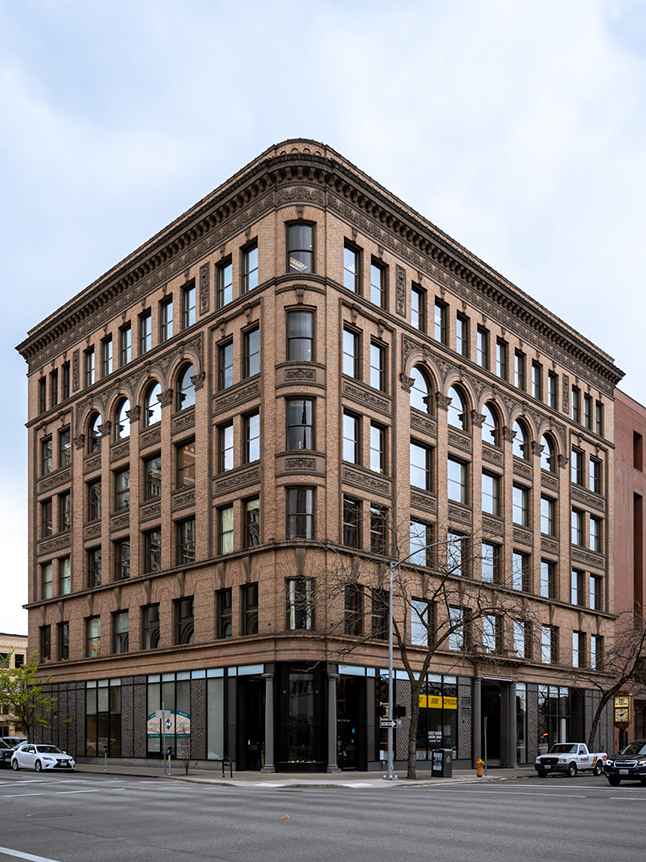
PhotoTitle: Empire State Building
PhotoAttribution: Spokane City/County Historic Preservation Office
Listing Status: National Register
URL: http://properties.historicspokane.org/property/?PropertyID=1993
Display Marker: large_yellow
Title: Empire State Building
Description: Date Built:1900
Architect:John K. Dow
Common Name: Great Western Building
The Empire State Building, known today as the Great Western Savings and Loan Building, is one of the most attractive buildings in Spokane's central business district. The six-story building is linked to one of the most historic architectural groupings in the city. The street elevations of the building are defined by continuous vertical piers and arcades from the third through fifth stories. Horizontal movement is achieved by string courses at second, third, and sixth floor levels and by an elaborate cornice along the roofline. In addition, a curved corner at the intersection of these elevations continues the horizontal line of decorative spandrels and fenestration. The use of buff brick facing is unusual in Spokane where the majority of older commercial structures are finished with red brick. Today the Empire State Building is the best remaining example of architect John K. Dow's skill in the design of business structures.
Location: 47.65766, -117.42538
Address: 901 West Riverside Avenue, Spokane WA 99201
PhotoURL:

PhotoTitle: Empire State Building
PhotoAttribution: Spokane City/County Historic Preservation Office
Listing Status: National Register
URL: http://properties.historicspokane.org/property/?PropertyID=1993
Display Marker: large_yellow
ID: 98
Title: Esmeralda-Greene Street Bridge
Description: Date Built: 1955
Architect: City of Spokane (designer)/ Henry Hagman Construction
Common Name: Bridge Number 53308
The Green Street Bridge was designed by the City of Spokane Engineering Department in 1954 with the lead engineer being B. J. Garnett. The bridge measures 434 feet long and consists of three reinforced concrete open-spandrel rib deck arch spans. This bridge is one of only two concrete arch bridges built in Washington in the 1950s and the only one with multiple arch spans. As such, it is an excellent example of this type of bridge designed and constructed using 1950s bridge engineering technology. It was dedicated on July 26, 1956 with over 500 people attending.
Location: 47.678388, -117.363797
Address: 2214 North Greene Street, Spokane WA 99217
PhotoURL: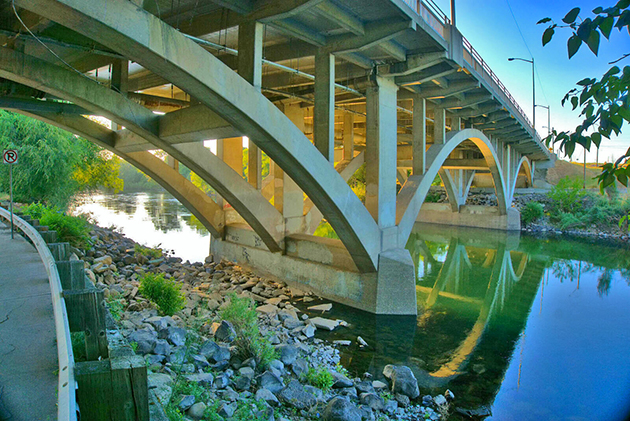
PhotoTitle: The Esmerelda-Greene Street Bridge
PhotoAttribution: Spokane City/County Historic Preservation Office
Listing Status: Washington Heritage Register
URL: http://properties.historicspokane.org/property/?PropertyID=2000
Display Marker: large_yellow
Title: Esmeralda-Greene Street Bridge
Description: Date Built: 1955
Architect: City of Spokane (designer)/ Henry Hagman Construction
Common Name: Bridge Number 53308
The Green Street Bridge was designed by the City of Spokane Engineering Department in 1954 with the lead engineer being B. J. Garnett. The bridge measures 434 feet long and consists of three reinforced concrete open-spandrel rib deck arch spans. This bridge is one of only two concrete arch bridges built in Washington in the 1950s and the only one with multiple arch spans. As such, it is an excellent example of this type of bridge designed and constructed using 1950s bridge engineering technology. It was dedicated on July 26, 1956 with over 500 people attending.
Location: 47.678388, -117.363797
Address: 2214 North Greene Street, Spokane WA 99217
PhotoURL:

PhotoTitle: The Esmerelda-Greene Street Bridge
PhotoAttribution: Spokane City/County Historic Preservation Office
Listing Status: Washington Heritage Register
URL: http://properties.historicspokane.org/property/?PropertyID=2000
Display Marker: large_yellow
ID: 99
Title: Family Treasures Building
Description: Date Built: 1948
Architect: Unknown
Common Name: Family Treasures Building
The Family Treasures Building is a simple one-story concrete block structure with tan brick veneer. Built in 1948, it originally housed Tip Top Variety and the Hillyard Donut Shop. For 51 years, from 1950 to 2001, the building housed Family Treasures, a business that specialized in antiques and collectibles. The building replaced the Gordon Motor Company, a service station that previously occupied the building site.
Location: 47.70574, -117.36445
Address: 5220 North Market Street, Spokane WA 99217
PhotoURL: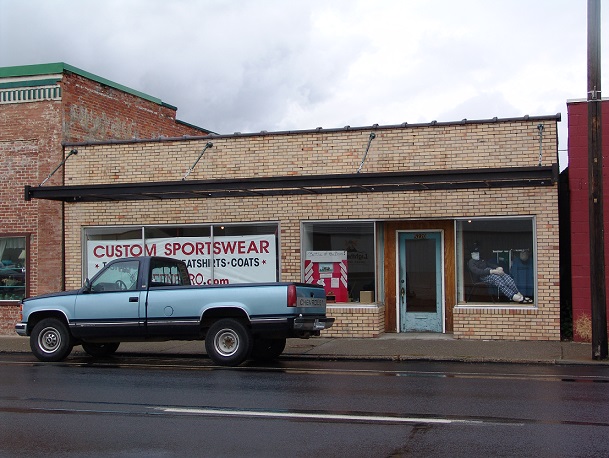
PhotoTitle: Family Treasures Building
PhotoAttribution: Spokane City/County Historic Preservation Office
Listing Status: Spokane Register, National Register
URL: http://properties.historicspokane.org/property/?PropertyID=2075
Display Marker: large_yellow
Title: Family Treasures Building
Description: Date Built: 1948
Architect: Unknown
Common Name: Family Treasures Building
The Family Treasures Building is a simple one-story concrete block structure with tan brick veneer. Built in 1948, it originally housed Tip Top Variety and the Hillyard Donut Shop. For 51 years, from 1950 to 2001, the building housed Family Treasures, a business that specialized in antiques and collectibles. The building replaced the Gordon Motor Company, a service station that previously occupied the building site.
Location: 47.70574, -117.36445
Address: 5220 North Market Street, Spokane WA 99217
PhotoURL:

PhotoTitle: Family Treasures Building
PhotoAttribution: Spokane City/County Historic Preservation Office
Listing Status: Spokane Register, National Register
URL: http://properties.historicspokane.org/property/?PropertyID=2075
Display Marker: large_yellow
ID: 100
Title: Fernwell Building
Description: Date Built: 1890
Architect: Herman Preusse/Rollin Charles Hyde
Common Name: The Fernwell Rollin Charles Hyde, brother of Eugene Hyde who built the Hyde Block, built this structure in the aftermath of the Spokane fire of 1889. Originally known as the Chamber of Commerce Building, the structure became known as the Fernwell in 1893 and has continued under that name. The building housed a men's clothing store on the ground floor for over ninety years. Preusse saw many of his first buildings destroyed by the 1889 fire, but those that remain today are almost exclusively brick and feature vernacular Romanesque theme. Born in Germany in 1847, Preusse received architectural training in Europe and was thoroughly skilled in design and drafting upon his arrival in Spokane Falls in 1882. Among his creations are several buildings in the central business district, the Gonzaga Administration Building, several Catholic churches, and private residences in the Logan neighborhood.
Location: 47.65767, -117.41988
Address: 505 West Riverside Avenue, Spokane WA 99201
PhotoURL: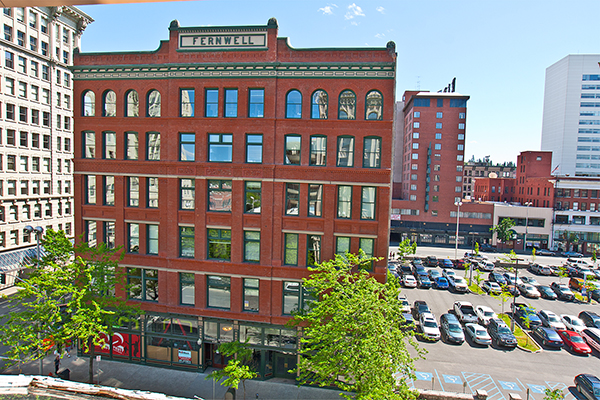
PhotoTitle: The Fernwell Building
PhotoAttribution: Spokane City/County Historic Preservation Office
Listing Status: Spokane Register
URL: http://properties.historicspokane.org/property/?PropertyID=1794
Display Marker: large_yellow
Title: Fernwell Building
Description: Date Built: 1890
Architect: Herman Preusse/Rollin Charles Hyde
Common Name: The Fernwell Rollin Charles Hyde, brother of Eugene Hyde who built the Hyde Block, built this structure in the aftermath of the Spokane fire of 1889. Originally known as the Chamber of Commerce Building, the structure became known as the Fernwell in 1893 and has continued under that name. The building housed a men's clothing store on the ground floor for over ninety years. Preusse saw many of his first buildings destroyed by the 1889 fire, but those that remain today are almost exclusively brick and feature vernacular Romanesque theme. Born in Germany in 1847, Preusse received architectural training in Europe and was thoroughly skilled in design and drafting upon his arrival in Spokane Falls in 1882. Among his creations are several buildings in the central business district, the Gonzaga Administration Building, several Catholic churches, and private residences in the Logan neighborhood.
Location: 47.65767, -117.41988
Address: 505 West Riverside Avenue, Spokane WA 99201
PhotoURL:

PhotoTitle: The Fernwell Building
PhotoAttribution: Spokane City/County Historic Preservation Office
Listing Status: Spokane Register
URL: http://properties.historicspokane.org/property/?PropertyID=1794
Display Marker: large_yellow
ID: 101
Title: Finch Mansion
Description: Date Built: 1898
Architect: Kirtland K. Cutter & Karl Malmgren
Common Name: Virginia Apartments and Annex
The John A. Finch house is a Georgian Revival mansion representing three interrelated aspects of Spokane's history: mining, wealth, architectural excellence and the development of Browne's Addition - Spokane's first society district. Kirtland Cutter, the city's most prolific and influential architect from 1889 to 1923, designed the house in 1898 for John Aylard Finch, developer of the Hecla Mine. The Georgian Revival was a relatively new departure for Cutter; only a few other Cutter houses were executed in the same style. One of three Cutter-designed houses built in 1898 on the same block of First Avenue in Browne's Addition, the Finch Mansion firmly established the elegance of the district, and helped to set the high architectural standard of district residences. The home was occupied by the Finch family until 1915, and continued as a private residence until 1927. More recently known as the Virginia Apartments, the house remained a luxury dwelling until the end of World War II when the original furnishings were auctioned. Despite alterations, the Finch Mansion retains enough of its original grandeur to very convincingly communicate the tremendous wealth and expressive lifestyle of its original owner.
Location: 47.65651, -117.44805
Address: 2340 West 1st Avenue, Spokane WA 99201
PhotoURL: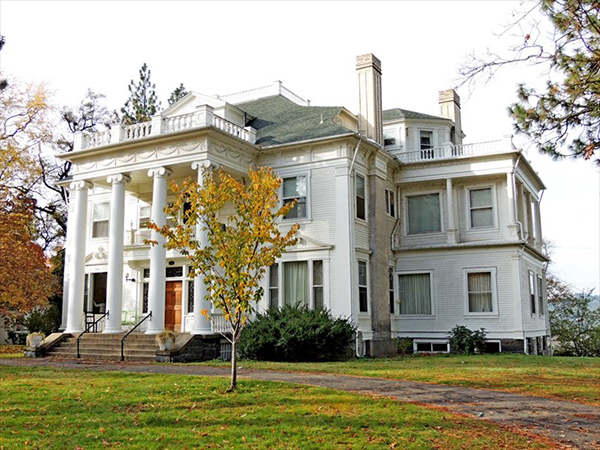
PhotoTitle: Finch Mansion
PhotoAttribution: Spokane City/County Historic Preservation Office
Listing Status: National Register
URL: http://properties.historicspokane.org/property/?PropertyID=1994
Display Marker: large_yellow
Title: Finch Mansion
Description: Date Built: 1898
Architect: Kirtland K. Cutter & Karl Malmgren
Common Name: Virginia Apartments and Annex
The John A. Finch house is a Georgian Revival mansion representing three interrelated aspects of Spokane's history: mining, wealth, architectural excellence and the development of Browne's Addition - Spokane's first society district. Kirtland Cutter, the city's most prolific and influential architect from 1889 to 1923, designed the house in 1898 for John Aylard Finch, developer of the Hecla Mine. The Georgian Revival was a relatively new departure for Cutter; only a few other Cutter houses were executed in the same style. One of three Cutter-designed houses built in 1898 on the same block of First Avenue in Browne's Addition, the Finch Mansion firmly established the elegance of the district, and helped to set the high architectural standard of district residences. The home was occupied by the Finch family until 1915, and continued as a private residence until 1927. More recently known as the Virginia Apartments, the house remained a luxury dwelling until the end of World War II when the original furnishings were auctioned. Despite alterations, the Finch Mansion retains enough of its original grandeur to very convincingly communicate the tremendous wealth and expressive lifestyle of its original owner.
Location: 47.65651, -117.44805
Address: 2340 West 1st Avenue, Spokane WA 99201
PhotoURL:

PhotoTitle: Finch Mansion
PhotoAttribution: Spokane City/County Historic Preservation Office
Listing Status: National Register
URL: http://properties.historicspokane.org/property/?PropertyID=1994
Display Marker: large_yellow
ID: 102
Title: Finch Memorial Nurses Home
Description: Date Built: 1929
Architect: Whitehouse & Price
Common Name: Finch Hall
The John A Finch Memorial Nurses Home is a three and one-half story rectangular building constructed of a reinforced concrete frame faced in buff and tan brick. The building is built on a rectangular plan with a symmetrical facade and reflects elements of the Romanesque Revival style, particularly reflected in the compound arch entry portal on the facade. Opened in 1929, the John A. Finch Memorial Nurses Home is the oldest remaining building and the last intact structure associated with the three diploma nursing schools that once existed in Spokane, a city considered a major medical center in the Pacific Northwest. The building retains excellent exterior integrity, good interior integrity, and strongly reflects the growth of professional nursing in Spokane.
Location: 47.66591, -117.45549
Address: 852 North Summit Boulevard, Spokane WA 99201
PhotoURL: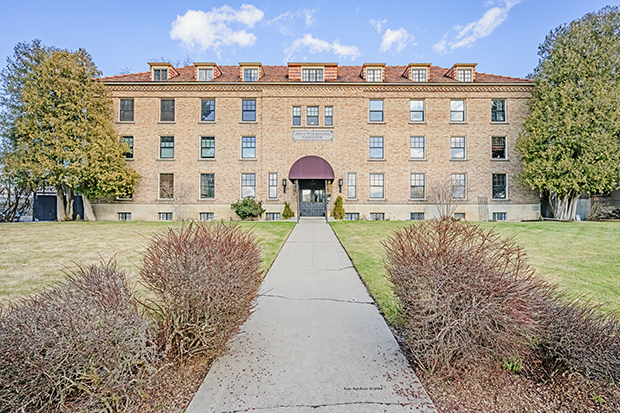
PhotoTitle: Finch Memorial Nurse Home
PhotoAttribution: Spokane City/County Historic Preservation Office
Listing Status: Spokane Register, National Register
URL: http://properties.historicspokane.org/property/?PropertyID=1795
Display Marker: large_yellow
Title: Finch Memorial Nurses Home
Description: Date Built: 1929
Architect: Whitehouse & Price
Common Name: Finch Hall
The John A Finch Memorial Nurses Home is a three and one-half story rectangular building constructed of a reinforced concrete frame faced in buff and tan brick. The building is built on a rectangular plan with a symmetrical facade and reflects elements of the Romanesque Revival style, particularly reflected in the compound arch entry portal on the facade. Opened in 1929, the John A. Finch Memorial Nurses Home is the oldest remaining building and the last intact structure associated with the three diploma nursing schools that once existed in Spokane, a city considered a major medical center in the Pacific Northwest. The building retains excellent exterior integrity, good interior integrity, and strongly reflects the growth of professional nursing in Spokane.
Location: 47.66591, -117.45549
Address: 852 North Summit Boulevard, Spokane WA 99201
PhotoURL:

PhotoTitle: Finch Memorial Nurse Home
PhotoAttribution: Spokane City/County Historic Preservation Office
Listing Status: Spokane Register, National Register
URL: http://properties.historicspokane.org/property/?PropertyID=1795
Display Marker: large_yellow
ID: 103
Title: First Congregational Church of Spokane
Description: Date Built: 1890
Architect: John K. Dow & Worthy Niver
Common Name: Westminster Congregational Church of Spokane The First Congregational Church of Spokane, built in 1890, is perhaps the most historically significant of Spokane's numerous churches. While few other congregations dared build more than a frame building, the First Congregationalists opted to build a lasting monument to their faith. The massive three-story Norman structure proved to be the standard of architecture for other Spokane churches. The rough cut granite building is one of the earliest stone churches in the Inland Empire and today is the oldest standing church in the City of Spokane. While of architectural merit, the history of this building has had a greater impact on Spokane by virtue of its pioneer development and continuity.
Location: 47.65217, -117.4176
Address: 411 South Washington Street, Spokane WA 99204
PhotoURL: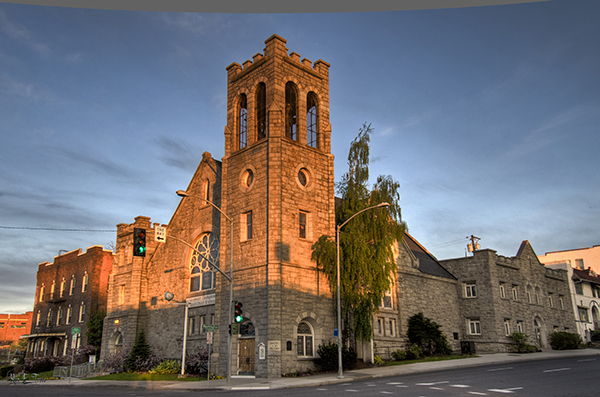
PhotoTitle: First Congregational Church of Spokane
PhotoAttribution: Spokane City/County Historic Preservation Office
Listing Status: National Register
URL: http://properties.historicspokane.org/property/?PropertyID=1997
Display Marker: large_yellow
Title: First Congregational Church of Spokane
Description: Date Built: 1890
Architect: John K. Dow & Worthy Niver
Common Name: Westminster Congregational Church of Spokane The First Congregational Church of Spokane, built in 1890, is perhaps the most historically significant of Spokane's numerous churches. While few other congregations dared build more than a frame building, the First Congregationalists opted to build a lasting monument to their faith. The massive three-story Norman structure proved to be the standard of architecture for other Spokane churches. The rough cut granite building is one of the earliest stone churches in the Inland Empire and today is the oldest standing church in the City of Spokane. While of architectural merit, the history of this building has had a greater impact on Spokane by virtue of its pioneer development and continuity.
Location: 47.65217, -117.4176
Address: 411 South Washington Street, Spokane WA 99204
PhotoURL:

PhotoTitle: First Congregational Church of Spokane
PhotoAttribution: Spokane City/County Historic Preservation Office
Listing Status: National Register
URL: http://properties.historicspokane.org/property/?PropertyID=1997
Display Marker: large_yellow
ID: 104
Title: First National Bank of Spokane
Description: Date Built: 1954
Architect: Bank Building and Equipment Co., McClure & Adkison
Common Name: Numerica Bank Building
Composed of stately black and red granite, the First National Bank of Spokane is one of downtown Spokane's prominent mid-century modern buildings. Built in 1954, the bank also represents a unique point in time with regards to post-WWII construction in Spokane, the evolution of bank architecture in America and the development of the skywalk system in the downtown core. Originally clad in a cream-colored glazed ceramic tile, the bank would receive an even more modern look in 1966 when the promising firm of McClure & Adkison designed the present day granite skin. Although not prominent in size, the sleek black granite and glass box exemplifies the characteristics of the mid-century period with its simple, yet elegant design of panels and glass.
Location: 47.65828, -117.41982
Address: 502 West Riverside Avenue, Spokane WA 99201
PhotoURL: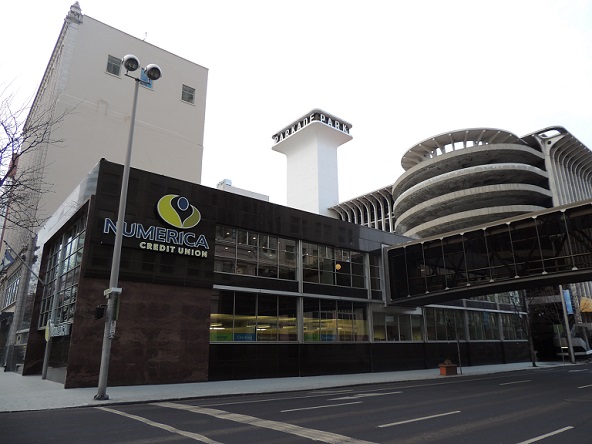
PhotoTitle: First National Bank of Spokane
PhotoAttribution: Spokane City/County Historic Preservation Office
Listing Status: Spokane Register
URL: http://properties.historicspokane.org/property/?PropertyID=2081
Display Marker: large_yellow
Title: First National Bank of Spokane
Description: Date Built: 1954
Architect: Bank Building and Equipment Co., McClure & Adkison
Common Name: Numerica Bank Building
Composed of stately black and red granite, the First National Bank of Spokane is one of downtown Spokane's prominent mid-century modern buildings. Built in 1954, the bank also represents a unique point in time with regards to post-WWII construction in Spokane, the evolution of bank architecture in America and the development of the skywalk system in the downtown core. Originally clad in a cream-colored glazed ceramic tile, the bank would receive an even more modern look in 1966 when the promising firm of McClure & Adkison designed the present day granite skin. Although not prominent in size, the sleek black granite and glass box exemplifies the characteristics of the mid-century period with its simple, yet elegant design of panels and glass.
Location: 47.65828, -117.41982
Address: 502 West Riverside Avenue, Spokane WA 99201
PhotoURL:

PhotoTitle: First National Bank of Spokane
PhotoAttribution: Spokane City/County Historic Preservation Office
Listing Status: Spokane Register
URL: http://properties.historicspokane.org/property/?PropertyID=2081
Display Marker: large_yellow
ID: 105
Title: Five Mile Prairie School
Description: Date Built: 1939
Architect: Charles Wood
Common Name: Five Mile Prairie School
Strategically centered in the heart of Five Mile Prairie, the Five Mile Prairie School is one of the oldest and best preserved two-room schoolhouses in north Spokane County. From 1939 until its closure in 1970, the school served the residents of the area as the community's public elementary school. The building not only provided public education to children on Five Mile Prairie, but also served as a community meeting place for political, religious, benevolent, athletic, and other civic social gatherings. The schoolhouse symbolizes the citizens' long-standing commitment to education and community development, and is a beloved public landmark. Associated with the evolution of public education in Spokane County and Washington State, the Five Mile Prairie School reflects early twentieth-century best practices in public school construction, including fire-resistant building materials and preferred school design for classrooms. Historically and architecturally significant, the Five Mile Prairie School gained importance in the areas of education and architecture during its period of significance from 1939 to 1954.
Location: 47.73677, -117.45449
Address: 8621 North 5 Mile Road, Spokane WA 99208
PhotoURL: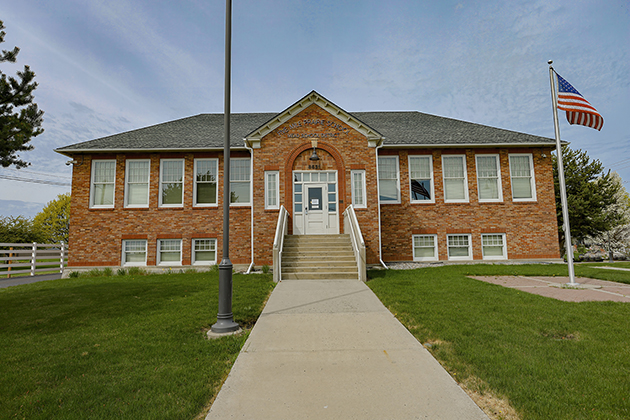
PhotoTitle: Five Mile Prairie School
PhotoAttribution: Spokane City/County Historic Preservation Office
Listing Status: Spokane Register, National Register
URL: http://properties.historicspokane.org/property/?PropertyID=1796
Display Marker: large_yellow
Title: Five Mile Prairie School
Description: Date Built: 1939
Architect: Charles Wood
Common Name: Five Mile Prairie School
Strategically centered in the heart of Five Mile Prairie, the Five Mile Prairie School is one of the oldest and best preserved two-room schoolhouses in north Spokane County. From 1939 until its closure in 1970, the school served the residents of the area as the community's public elementary school. The building not only provided public education to children on Five Mile Prairie, but also served as a community meeting place for political, religious, benevolent, athletic, and other civic social gatherings. The schoolhouse symbolizes the citizens' long-standing commitment to education and community development, and is a beloved public landmark. Associated with the evolution of public education in Spokane County and Washington State, the Five Mile Prairie School reflects early twentieth-century best practices in public school construction, including fire-resistant building materials and preferred school design for classrooms. Historically and architecturally significant, the Five Mile Prairie School gained importance in the areas of education and architecture during its period of significance from 1939 to 1954.
Location: 47.73677, -117.45449
Address: 8621 North 5 Mile Road, Spokane WA 99208
PhotoURL:

PhotoTitle: Five Mile Prairie School
PhotoAttribution: Spokane City/County Historic Preservation Office
Listing Status: Spokane Register, National Register
URL: http://properties.historicspokane.org/property/?PropertyID=1796
Display Marker: large_yellow
ID: 106
Title: Flint House
Description: Date Built: 1888
Architect: Unknown
Common Name: Fred J. and Alice Flint House
The Fred J. and Alice Flint House was constructed in 1888, soon after Nettleton's Addition was platted in the West Central neighborhood in 1897. Built for Fred J. Flint, president of the Flint Investment Company, the home is a fine early example of the Tudor Revival style. Flint came to Spokane in 1882 from Seattle and promptly began a lucrative real estate business with partner Fred B. Grinnell. In 1890, Flint married Alice L. Gray, the daughter of a Boxport, Maine ship captain. The home was sold to William T. Shelton in 1926, who lived there for nearly 30 years. From 1888 to 1926, the Flint House achieved historic significance for its association with the architectural development and settlement of the West Central neighborhood, and is architecturally significant as an example of the Tudor Revival style.
Location: 47.66774, -117.44682
Address: 2321 West Boone Avenue, Spokane WA 99201
PhotoURL: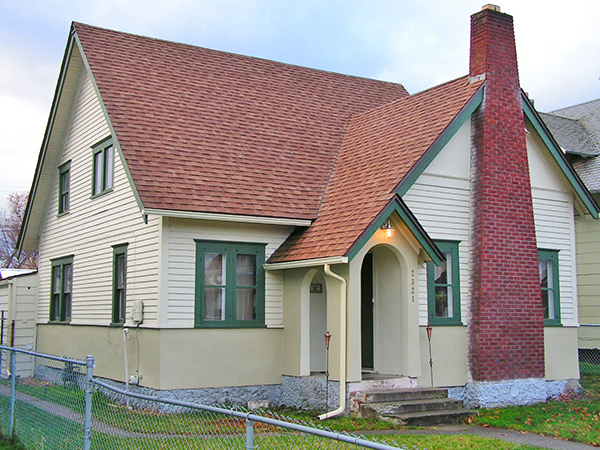
PhotoTitle: Fred and Alice Flint House
PhotoAttribution: Spokane City/County Historic Preservation Office
Listing Status: Spokane Register, National Register
URL: http://properties.historicspokane.org/property/?PropertyID=1797
Display Marker: large_yellow
Title: Flint House
Description: Date Built: 1888
Architect: Unknown
Common Name: Fred J. and Alice Flint House
The Fred J. and Alice Flint House was constructed in 1888, soon after Nettleton's Addition was platted in the West Central neighborhood in 1897. Built for Fred J. Flint, president of the Flint Investment Company, the home is a fine early example of the Tudor Revival style. Flint came to Spokane in 1882 from Seattle and promptly began a lucrative real estate business with partner Fred B. Grinnell. In 1890, Flint married Alice L. Gray, the daughter of a Boxport, Maine ship captain. The home was sold to William T. Shelton in 1926, who lived there for nearly 30 years. From 1888 to 1926, the Flint House achieved historic significance for its association with the architectural development and settlement of the West Central neighborhood, and is architecturally significant as an example of the Tudor Revival style.
Location: 47.66774, -117.44682
Address: 2321 West Boone Avenue, Spokane WA 99201
PhotoURL:

PhotoTitle: Fred and Alice Flint House
PhotoAttribution: Spokane City/County Historic Preservation Office
Listing Status: Spokane Register, National Register
URL: http://properties.historicspokane.org/property/?PropertyID=1797
Display Marker: large_yellow
ID: 107
Title: Folsom House
Description: Date Built: 1910
Architect: W.W. Hyslop
Common Name:Myron & Maud Folsom House Built in 1910, the Myron & Maude Folsom House is a particularly fine example of the Tudor Revival style with strong Storybook influence. Reminiscent of cottages clustered in valleys and hamlets throughout the English countryside, the Folsom House is articulated with prominent false half-timbering and multiple clipped jerkinhead gables, widely overhanging eaves, and deep bargeboards that simulate the look of thatched roof cottages. The house was designed by one of Spokane's most noteworthy and accomplished pioneer architects, W.W. Hyslop, and was featured in The Inland Empire Architect, Volume 1. The journal pictured a prominent photograph of the house, drawings of the home's floor plans, and a description that characterized the Folsom House as a "model residence" with a "carefully studied" interior and exterior. The property was custom-designed and built for Myron Archer Folsom and his wife Maud, who lived there from 1910-1917 during the zenith of Myron Folsom's professional career in Spokane. As a civic leader, pioneer lawyer, and prominent professional litigator in Spokane during the late 1890s and early 1900s, Myron Folsom was featured in The History of the City of Spokane and Spokane County. The Folsom House achieved importance in the area of significance of architecture, as a noteworthy example of the Tudor Revival style with Storybook influence and as a product of W.W. Hyslop.
Location: 47.64232, -117.4029
Address: 528 East 14th Avenue, Spokane WA 99202
PhotoURL: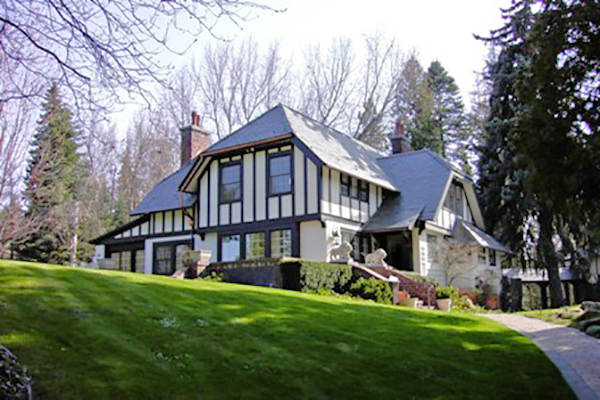
PhotoTitle: Myron and Maud Folsom House
PhotoAttribution: Spokane City/County Historic Preservation Office
Listing Status: Spokane Register, National Register
URL: http://properties.historicspokane.org/property/?PropertyID=1799
Display Marker: large_yellow
Title: Folsom House
Description: Date Built: 1910
Architect: W.W. Hyslop
Common Name:Myron & Maud Folsom House Built in 1910, the Myron & Maude Folsom House is a particularly fine example of the Tudor Revival style with strong Storybook influence. Reminiscent of cottages clustered in valleys and hamlets throughout the English countryside, the Folsom House is articulated with prominent false half-timbering and multiple clipped jerkinhead gables, widely overhanging eaves, and deep bargeboards that simulate the look of thatched roof cottages. The house was designed by one of Spokane's most noteworthy and accomplished pioneer architects, W.W. Hyslop, and was featured in The Inland Empire Architect, Volume 1. The journal pictured a prominent photograph of the house, drawings of the home's floor plans, and a description that characterized the Folsom House as a "model residence" with a "carefully studied" interior and exterior. The property was custom-designed and built for Myron Archer Folsom and his wife Maud, who lived there from 1910-1917 during the zenith of Myron Folsom's professional career in Spokane. As a civic leader, pioneer lawyer, and prominent professional litigator in Spokane during the late 1890s and early 1900s, Myron Folsom was featured in The History of the City of Spokane and Spokane County. The Folsom House achieved importance in the area of significance of architecture, as a noteworthy example of the Tudor Revival style with Storybook influence and as a product of W.W. Hyslop.
Location: 47.64232, -117.4029
Address: 528 East 14th Avenue, Spokane WA 99202
PhotoURL:

PhotoTitle: Myron and Maud Folsom House
PhotoAttribution: Spokane City/County Historic Preservation Office
Listing Status: Spokane Register, National Register
URL: http://properties.historicspokane.org/property/?PropertyID=1799
Display Marker: large_yellow
ID: 108
Title: Foltz House
Description: Date Built: 1958
Architect: Gil Bauer
Common Name: Walter & Barbara Foltz House
The Foltz House is characterized by its contemporary long, low, single-story asymmetrical design, flat roof, attached garage and breezeway, combination exterior cladding with vertical cedar board siding, smooth round river rock veneer, wide floor-to-ceiling window "curtain walls," indirect lighting, custom-designed Bangkok teakwood wall paneling, room dividers and built-in, mantle-less fireplaces, and well-groomed grounds and gardens at the front and back yards. Immaculately preserved with only one exterior modification since it was built, the Foltz House retains the highest degree of original exterior and interior architectural integrity in original location, design, materials, workmanship, and association as a Mid-Century Modern single-family home built during the 1950s in Spokane, WA.
Location: 47.62247, -117.37995
Address: 2116 East 35th Avenue, Spokane WA 99203
PhotoURL: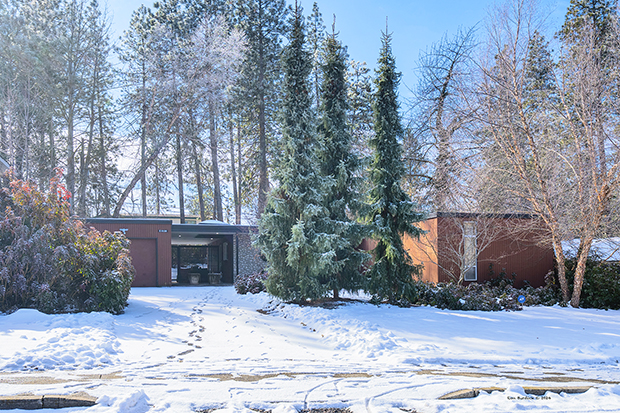
PhotoTitle: Walter and Barbara Foltz House
PhotoAttribution: Spokane City/County Historic Preservation Office
Listing Status: Spokane Register
URL: http://properties.historicspokane.org/property/?PropertyID=1800
Display Marker: large_yellow
Title: Foltz House
Description: Date Built: 1958
Architect: Gil Bauer
Common Name: Walter & Barbara Foltz House
The Foltz House is characterized by its contemporary long, low, single-story asymmetrical design, flat roof, attached garage and breezeway, combination exterior cladding with vertical cedar board siding, smooth round river rock veneer, wide floor-to-ceiling window "curtain walls," indirect lighting, custom-designed Bangkok teakwood wall paneling, room dividers and built-in, mantle-less fireplaces, and well-groomed grounds and gardens at the front and back yards. Immaculately preserved with only one exterior modification since it was built, the Foltz House retains the highest degree of original exterior and interior architectural integrity in original location, design, materials, workmanship, and association as a Mid-Century Modern single-family home built during the 1950s in Spokane, WA.
Location: 47.62247, -117.37995
Address: 2116 East 35th Avenue, Spokane WA 99203
PhotoURL:

PhotoTitle: Walter and Barbara Foltz House
PhotoAttribution: Spokane City/County Historic Preservation Office
Listing Status: Spokane Register
URL: http://properties.historicspokane.org/property/?PropertyID=1800
Display Marker: large_yellow
ID: 109
Title: Ford House
Description: Date Built: 1925
Architect: John Anderson
Common Name: Frank and Edith Ford House
Erected in 1925, the Frank and Edith Ford House is an excellent example of domestic architecture built in the Rockwood Terrace Addition, a neighborhood planned for upscale residential living on Spokane's South Hill. The house was constructed by John E. Anderson, a prominent designer and builder in the Spokane area who was responsible for constructing at least 46 homes in Spokane located in the Rockwood neighborhood. Featuring a glazed ceramic tile roof and exterior brick wall cladding, the Ford House is one of only eight Anderson-built homes to employ both trademark characteristics. The home conveys high artistic value and embodies distinctive characteristics designed in the Craftsman style. The home was built for Edith Janet Ford and Frank D. Ford, a successful Spokane broker who specialized in mining investments.
Location: 47.63576, -117.39457
Address: 1015 East Overbluff Road, Spokane WA 99203
PhotoURL: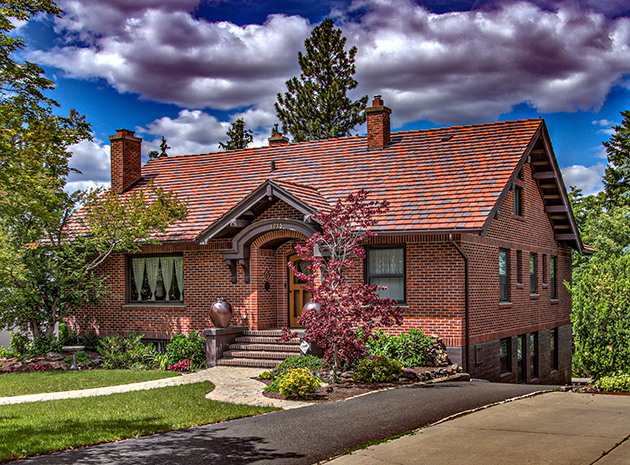
PhotoTitle: Frank and Edith Ford House
PhotoAttribution: Spokane City/County Historic Preservation Office
Listing Status: Spokane Register
URL: http://properties.historicspokane.org/property/?PropertyID=1798
Display Marker: large_yellow
Title: Ford House
Description: Date Built: 1925
Architect: John Anderson
Common Name: Frank and Edith Ford House
Erected in 1925, the Frank and Edith Ford House is an excellent example of domestic architecture built in the Rockwood Terrace Addition, a neighborhood planned for upscale residential living on Spokane's South Hill. The house was constructed by John E. Anderson, a prominent designer and builder in the Spokane area who was responsible for constructing at least 46 homes in Spokane located in the Rockwood neighborhood. Featuring a glazed ceramic tile roof and exterior brick wall cladding, the Ford House is one of only eight Anderson-built homes to employ both trademark characteristics. The home conveys high artistic value and embodies distinctive characteristics designed in the Craftsman style. The home was built for Edith Janet Ford and Frank D. Ford, a successful Spokane broker who specialized in mining investments.
Location: 47.63576, -117.39457
Address: 1015 East Overbluff Road, Spokane WA 99203
PhotoURL:

PhotoTitle: Frank and Edith Ford House
PhotoAttribution: Spokane City/County Historic Preservation Office
Listing Status: Spokane Register
URL: http://properties.historicspokane.org/property/?PropertyID=1798
Display Marker: large_yellow
ID: 110
Title: Foresters of America Hall
Description: Date Built: 1910
Architect: Albert Held
Common Name: The Grotto and Imperial Data Services
Built in 1910, the Foresters of America Hall is typical of Lodge Hall/Commercial Vernacular architecture, with a large open meeting room (lodge hall) on the second floor and commercial space on the ground floor. Rising from a basalt rubble basement, the two-story building is on the southeast corner of Pacific Avenue and Browne Street in the southeast quadrant of Spokane's central business district. Clad in red brick with terra cotta trim, the building exhibits decorative design features, specifically at the ground floor entrances and the second floor windows characteristic of a fraternal lodge hall. Although storefront window bays on the ground floor west elevation and corner entry have been altered, the building retains good integrity of design, setting, materials, workmanship, feeling, and association.
Location: 47.65534, -117.41313
Address: 39 West Pacific Avenue, Spokane WA 99201
PhotoURL: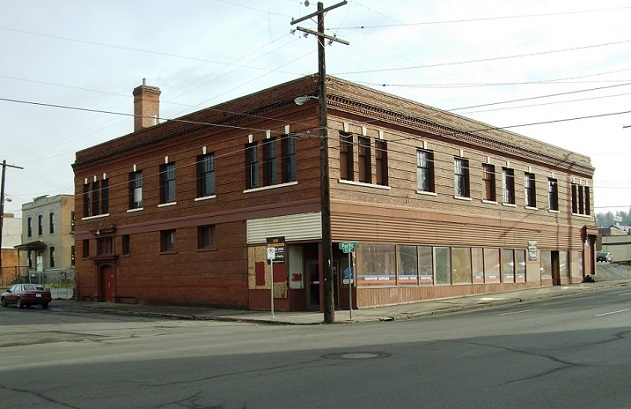
PhotoTitle: 2011 view of the Foresters of America Hall
PhotoAttribution: Spokane City/County Historic Preservation Office
Listing Status: Spokane Register
URL: http://properties.historicspokane.org/property/?PropertyID=2054
Display Marker: large_yellow
Title: Foresters of America Hall
Description: Date Built: 1910
Architect: Albert Held
Common Name: The Grotto and Imperial Data Services
Built in 1910, the Foresters of America Hall is typical of Lodge Hall/Commercial Vernacular architecture, with a large open meeting room (lodge hall) on the second floor and commercial space on the ground floor. Rising from a basalt rubble basement, the two-story building is on the southeast corner of Pacific Avenue and Browne Street in the southeast quadrant of Spokane's central business district. Clad in red brick with terra cotta trim, the building exhibits decorative design features, specifically at the ground floor entrances and the second floor windows characteristic of a fraternal lodge hall. Although storefront window bays on the ground floor west elevation and corner entry have been altered, the building retains good integrity of design, setting, materials, workmanship, feeling, and association.
Location: 47.65534, -117.41313
Address: 39 West Pacific Avenue, Spokane WA 99201
PhotoURL:

PhotoTitle: 2011 view of the Foresters of America Hall
PhotoAttribution: Spokane City/County Historic Preservation Office
Listing Status: Spokane Register
URL: http://properties.historicspokane.org/property/?PropertyID=2054
Display Marker: large_yellow
ID: 111
Title: Fort George Wright Barracks
Description: Date Built: 1906
Architect: Unknown
Common Name: Randolph Arms Apartments
The Fort George Wright Barracks, now Randolf Arms Apartments, is a part of former Fort George Wright, named for the officer who led the 1858 punitive expedition against the Spokanes, Coeur d'Alenes, Palouses, and other area tribes involved in a skirmish with troops under Colonel Steptoe some months earlier. The fort is a significant reminder of Spokane's long military history. The two barracks are U-shaped red brick neo-colonial Georgian structures with verandas extending along the front elevation on the first and second stories. Before being transformed into apartment buildings, the Barracks were used in the 1950s as a headquarters for SAC.
Location: 47.67434, -117.47087
Address: 3911 West Randolph Road, Spokane WA 99224
PhotoURL: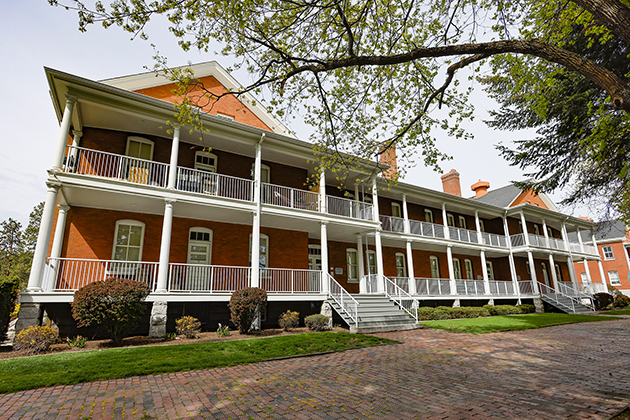
PhotoTitle: Fort George Wright Barracks
PhotoAttribution: Spokane City/County Historic Preservation Office
Listing Status: National Register
URL: http://properties.historicspokane.org/property/?PropertyID=2011
Display Marker: large_yellow
Title: Fort George Wright Barracks
Description: Date Built: 1906
Architect: Unknown
Common Name: Randolph Arms Apartments
The Fort George Wright Barracks, now Randolf Arms Apartments, is a part of former Fort George Wright, named for the officer who led the 1858 punitive expedition against the Spokanes, Coeur d'Alenes, Palouses, and other area tribes involved in a skirmish with troops under Colonel Steptoe some months earlier. The fort is a significant reminder of Spokane's long military history. The two barracks are U-shaped red brick neo-colonial Georgian structures with verandas extending along the front elevation on the first and second stories. Before being transformed into apartment buildings, the Barracks were used in the 1950s as a headquarters for SAC.
Location: 47.67434, -117.47087
Address: 3911 West Randolph Road, Spokane WA 99224
PhotoURL:

PhotoTitle: Fort George Wright Barracks
PhotoAttribution: Spokane City/County Historic Preservation Office
Listing Status: National Register
URL: http://properties.historicspokane.org/property/?PropertyID=2011
Display Marker: large_yellow
ID: 112
Title: Fotheringham House
Description: Date Built: 1889
Architect: Unknown (probably David Fotheringham)
Common Name: Red House
This house is significant as a contributing building in the Browne's Addition Historic District and for its association, though brief, with David B. Fotheringham, a successful building contractor and community leader who served as Mayor of Spokane. Fotheringham built this house in 1889 and occupied it with his wife Mary while he built his permanent home in the adjacent lot, completed in 1891. After building his house, Fotheringham turned his attention to the site across the street where he constructed the opulent Patrick Clark mansion. Mrs. Mabel C. Williamson, widow of Victor Williamson, bought Fotheringham's first house in 1915, remaining there until 1960. James L Red, a Spokane salesman, bought the house around 1970, and the property today remains in the hands of the Red family as a single-family residence.
Location: 47.65484, -117.44418
Address: 2124 West 2nd Avenue, Spokane WA 99201
PhotoURL: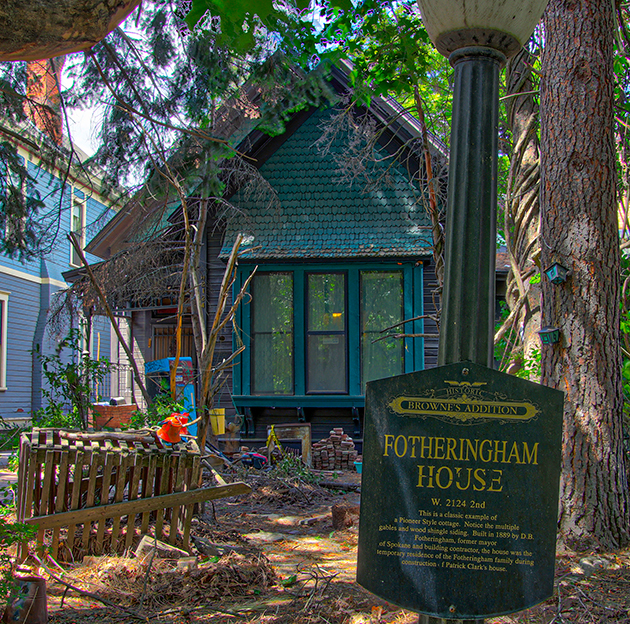
PhotoTitle: David B. Fotheringham's first residence
PhotoAttribution: Spokane City/County Historic Preservation Office
Listing Status: Spokane Register, National Register
URL: http://properties.historicspokane.org/property/?PropertyID=1802
Display Marker: large_yellow
Title: Fotheringham House
Description: Date Built: 1889
Architect: Unknown (probably David Fotheringham)
Common Name: Red House
This house is significant as a contributing building in the Browne's Addition Historic District and for its association, though brief, with David B. Fotheringham, a successful building contractor and community leader who served as Mayor of Spokane. Fotheringham built this house in 1889 and occupied it with his wife Mary while he built his permanent home in the adjacent lot, completed in 1891. After building his house, Fotheringham turned his attention to the site across the street where he constructed the opulent Patrick Clark mansion. Mrs. Mabel C. Williamson, widow of Victor Williamson, bought Fotheringham's first house in 1915, remaining there until 1960. James L Red, a Spokane salesman, bought the house around 1970, and the property today remains in the hands of the Red family as a single-family residence.
Location: 47.65484, -117.44418
Address: 2124 West 2nd Avenue, Spokane WA 99201
PhotoURL:

PhotoTitle: David B. Fotheringham's first residence
PhotoAttribution: Spokane City/County Historic Preservation Office
Listing Status: Spokane Register, National Register
URL: http://properties.historicspokane.org/property/?PropertyID=1802
Display Marker: large_yellow
ID: 113
Title: Fox Theater
Description: Date Built: 1930
Architect: Robert Reamer; Whitehouse & Price
Common Name: Fox Theater
Although movies had been shown in downtown theaters for some time, the construction of the Fox in 1920 marked the first time that a motion picture company had built its own theater in Spokane. Architecturally, the Fox is one of two significant and progressive buildings that mark the culmination of Seattle architect R.C. Reamer's distinguished career. The modernistic style, the use of poured in place concrete, and the abstract, stylized ornamentation was up-to-date and sophisticated. For the conservative Washington public, these experiments in softer modernism were received with mixed reviews at their opening, but were also recognized for their innovation for helping to place Spokane on the national map architecturally.
Location: 47.65686, -117.4272
Address: 1001 West Sprague Avenue, Spokane WA 99201
PhotoURL: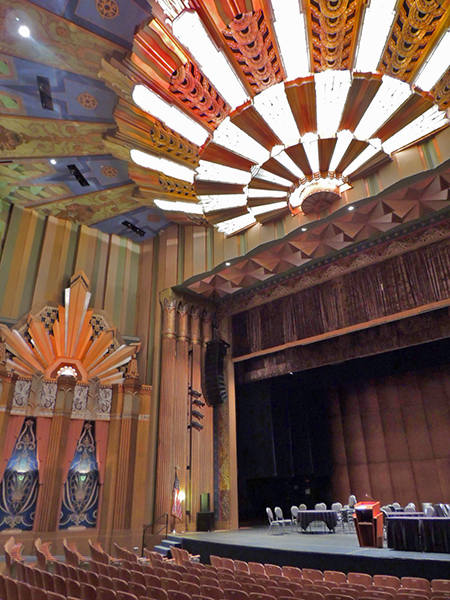
PhotoTitle: The Fox Theater
PhotoAttribution: Spokane City/County Historic Preservation Office
Listing Status: Spokane Register, National Register
URL: http://properties.historicspokane.org/property/?PropertyID=1803
Display Marker: large_yellow
Title: Fox Theater
Description: Date Built: 1930
Architect: Robert Reamer; Whitehouse & Price
Common Name: Fox Theater
Although movies had been shown in downtown theaters for some time, the construction of the Fox in 1920 marked the first time that a motion picture company had built its own theater in Spokane. Architecturally, the Fox is one of two significant and progressive buildings that mark the culmination of Seattle architect R.C. Reamer's distinguished career. The modernistic style, the use of poured in place concrete, and the abstract, stylized ornamentation was up-to-date and sophisticated. For the conservative Washington public, these experiments in softer modernism were received with mixed reviews at their opening, but were also recognized for their innovation for helping to place Spokane on the national map architecturally.
Location: 47.65686, -117.4272
Address: 1001 West Sprague Avenue, Spokane WA 99201
PhotoURL:

PhotoTitle: The Fox Theater
PhotoAttribution: Spokane City/County Historic Preservation Office
Listing Status: Spokane Register, National Register
URL: http://properties.historicspokane.org/property/?PropertyID=1803
Display Marker: large_yellow
ID: 114
Title: Frederick House
Description: Date Built: 1927
Architect: Leon L. Rood
Common Name: Walter and Mabel Frederick House
The Frederick House was constructed for Walter E. Frederick and his wife, Mabel, in 1927. Walter was employed as a salesman for Shaw & Borden Printing Company, a prominent printer-engraver-stationer in downtown Spokane. Mabel Rue Frederick was the granddaughter of Colonel David P. Jenkins, one of Spokane's earliest pioneers and the first settler on the north side of the Spokane river in 1879. Named "Woman Pioneer of the Year" in 1975, Mabel was praised for her civic contributions promoting growth of the Spokane Public Library's genealogical collection, and for encouraging the study of local and family history in the Spokane area. The Frederick House is also architecturally significant as a fine example of the Tudor Revival Cottage style, and as the prescribed product of protective subdivision regulations which were adopted as binding covenants in the Rockwood district in 1903. The property continues to demonstrate its association with covenants that are still in effect and run with the land in perpetuity.
Location: 47.63011, -117.39648
Address: 2707 South Rhyolite Road, Spokane WA 99203
PhotoURL: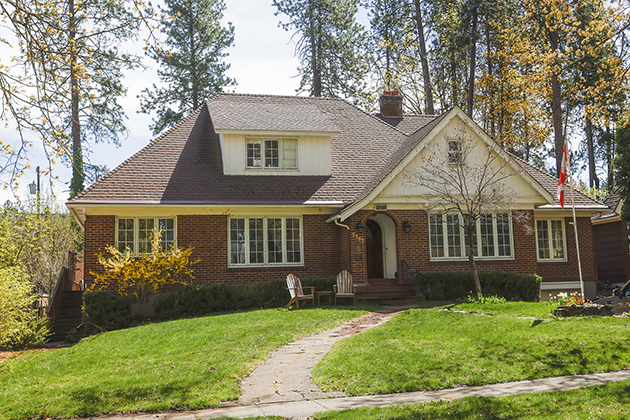
PhotoTitle: Walter and Mabel Frederick House
PhotoAttribution: Spokane City/County Historic Preservation Office
Listing Status: Spokane Register, National Register
URL: http://properties.historicspokane.org/property/?PropertyID=1804
Display Marker: large_yellow
Title: Frederick House
Description: Date Built: 1927
Architect: Leon L. Rood
Common Name: Walter and Mabel Frederick House
The Frederick House was constructed for Walter E. Frederick and his wife, Mabel, in 1927. Walter was employed as a salesman for Shaw & Borden Printing Company, a prominent printer-engraver-stationer in downtown Spokane. Mabel Rue Frederick was the granddaughter of Colonel David P. Jenkins, one of Spokane's earliest pioneers and the first settler on the north side of the Spokane river in 1879. Named "Woman Pioneer of the Year" in 1975, Mabel was praised for her civic contributions promoting growth of the Spokane Public Library's genealogical collection, and for encouraging the study of local and family history in the Spokane area. The Frederick House is also architecturally significant as a fine example of the Tudor Revival Cottage style, and as the prescribed product of protective subdivision regulations which were adopted as binding covenants in the Rockwood district in 1903. The property continues to demonstrate its association with covenants that are still in effect and run with the land in perpetuity.
Location: 47.63011, -117.39648
Address: 2707 South Rhyolite Road, Spokane WA 99203
PhotoURL:

PhotoTitle: Walter and Mabel Frederick House
PhotoAttribution: Spokane City/County Historic Preservation Office
Listing Status: Spokane Register, National Register
URL: http://properties.historicspokane.org/property/?PropertyID=1804
Display Marker: large_yellow
ID: 115
Title: Frequency Changing Station
Description: Date Built: 1908
Architect: Albert Held
Common Name: Frequency Changing Station
The Frequency Changing Station was an important part of an early electrical power and transportation conglomerate. The name most often associated with this development is J.P. Graves, who organized several small inter-urban lines into an extended system which connected Coeur d'Alene, Moscow, and Colfax with Spokane, a system known as the Spokane and Inland Empire Railroad Company and finally as the Spokane, Coeur d'Alene and Palouse Railway. Graves was also in the directorship of the Spokane Power Development Company, which supplied power for this rail system and sold power and light commercially as well.
Location: 47.65146, -117.38865
Address: 1421 East Celesta Avenue, Spokane WA 99202
PhotoURL:
PhotoTitle: Frequency Changing Station
PhotoAttribution: Spokane City/County Historic Preservation Office
Listing Status: Spokane Register, National Register
URL: http://properties.historicspokane.org/property/?PropertyID=1805
Display Marker: large_yellow
Title: Frequency Changing Station
Description: Date Built: 1908
Architect: Albert Held
Common Name: Frequency Changing Station
The Frequency Changing Station was an important part of an early electrical power and transportation conglomerate. The name most often associated with this development is J.P. Graves, who organized several small inter-urban lines into an extended system which connected Coeur d'Alene, Moscow, and Colfax with Spokane, a system known as the Spokane and Inland Empire Railroad Company and finally as the Spokane, Coeur d'Alene and Palouse Railway. Graves was also in the directorship of the Spokane Power Development Company, which supplied power for this rail system and sold power and light commercially as well.
Location: 47.65146, -117.38865
Address: 1421 East Celesta Avenue, Spokane WA 99202
PhotoURL:

PhotoTitle: Frequency Changing Station
PhotoAttribution: Spokane City/County Historic Preservation Office
Listing Status: Spokane Register, National Register
URL: http://properties.historicspokane.org/property/?PropertyID=1805
Display Marker: large_yellow
ID: 116
Title: Fuller and Co. Warehouse
Description: Date Built: 1915
Architect: Unknown
Common Name: W.P. Fuller and Company Warehouse
The W.P. Fuller and Company Warehouse is composed of two buildings, constructed at different times and joined together to create a single contiguous property. The original section is a four-story rectangular commercial style building, with basement, constructed of poured steel reinforced concrete. The one story addition also displays steel reinforced concrete walls, but the interior and roof are constructed of wood. Both buildings display the grey color of concrete on walls which still bear the imprint of the wood boards used in the forms. The Warehouse is significant as a representative of one of early Spokane's largest paint and finishing enterprises. The building is also one of the earliest examples of fireproof, steel-reinforced concrete construction erected in Spokane.
Location: 47.66764, -117.40871
Address: 111 East Desmet Avenue, Spokane WA 99202
PhotoURL:
PhotoTitle: The W. P. Fuller and Company Warehouse
PhotoAttribution: Spokane City/County Historic Preservation Office
Listing Status: National Register
URL: http://properties.historicspokane.org/property/?PropertyID=1998
Display Marker: large_yellow
Title: Fuller and Co. Warehouse
Description: Date Built: 1915
Architect: Unknown
Common Name: W.P. Fuller and Company Warehouse
The W.P. Fuller and Company Warehouse is composed of two buildings, constructed at different times and joined together to create a single contiguous property. The original section is a four-story rectangular commercial style building, with basement, constructed of poured steel reinforced concrete. The one story addition also displays steel reinforced concrete walls, but the interior and roof are constructed of wood. Both buildings display the grey color of concrete on walls which still bear the imprint of the wood boards used in the forms. The Warehouse is significant as a representative of one of early Spokane's largest paint and finishing enterprises. The building is also one of the earliest examples of fireproof, steel-reinforced concrete construction erected in Spokane.
Location: 47.66764, -117.40871
Address: 111 East Desmet Avenue, Spokane WA 99202
PhotoURL:

PhotoTitle: The W. P. Fuller and Company Warehouse
PhotoAttribution: Spokane City/County Historic Preservation Office
Listing Status: National Register
URL: http://properties.historicspokane.org/property/?PropertyID=1998
Display Marker: large_yellow
ID: 117
Title: Garland Theater
Description: Date Built: 1945
Architect: Funk, Molander & Johnson/ Roy Blair
Common Name: The Garland
Built in 1945, the single-screen, Streamline Moderne style Garland Theater is representative of the entertainment and recreational needs of post-WWII Spokane. The brick facade, punctuated with decorative turquoise terra cotta tiles representing flowers, and an eye-catching forty-eight foot tower marquee makes the Garland one of the most recognizable landmarks of the Garland Business District. The interior, while having been renovated more than the exterior, still retains a majority of historical decorative elements. Today, the Garland Theater has stood the test of time and shows the mastery of several designs motifs by the noted architectural firm of Funk, Molander & Johnson.
Location: 47.69401, -117.4255
Address: 924 West Garland Avenue, Spokane WA 99205
PhotoURL: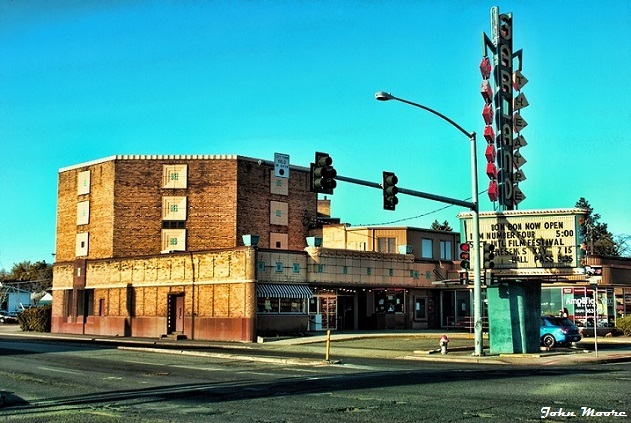
PhotoTitle: The Garland Theater
PhotoAttribution: Spokane City/County Historic Preservation Office
Listing Status: Spokane Register, National Register
URL: http://properties.historicspokane.org/property/?PropertyID=2074
Display Marker: large_yellow
Title: Garland Theater
Description: Date Built: 1945
Architect: Funk, Molander & Johnson/ Roy Blair
Common Name: The Garland
Built in 1945, the single-screen, Streamline Moderne style Garland Theater is representative of the entertainment and recreational needs of post-WWII Spokane. The brick facade, punctuated with decorative turquoise terra cotta tiles representing flowers, and an eye-catching forty-eight foot tower marquee makes the Garland one of the most recognizable landmarks of the Garland Business District. The interior, while having been renovated more than the exterior, still retains a majority of historical decorative elements. Today, the Garland Theater has stood the test of time and shows the mastery of several designs motifs by the noted architectural firm of Funk, Molander & Johnson.
Location: 47.69401, -117.4255
Address: 924 West Garland Avenue, Spokane WA 99205
PhotoURL:

PhotoTitle: The Garland Theater
PhotoAttribution: Spokane City/County Historic Preservation Office
Listing Status: Spokane Register, National Register
URL: http://properties.historicspokane.org/property/?PropertyID=2074
Display Marker: large_yellow
ID: 118
Title: Germond Block
Description: Date Built: 1890
Architect: Reid Brothers of San Diego
Common Name: Travo Building, Michael Building
The Germond Building is significant as one of a few remaining buildings that rose from the ashes of Spokane's 1889 fire. The structure is one of ten extant buildings of the 150 built in the year following the 1889 fire that razed the downtown business district. The building also had the distinction of serving as Spokane's city hall for its first two years while the new city hall was under construction. The Germond Block also represents a distinctive work in the Romanesque Revival style by a prominent architectural firm, the Reid Brothers. Although the building's ground floor storefront facade has been altered, as have the upper story windows, the building remains a distinctive element of downtown Spokane's historic streetscape.
Location: 47.65741, -117.42467
Address: 830 West Sprague Avenue, Spokane WA 99201
PhotoURL: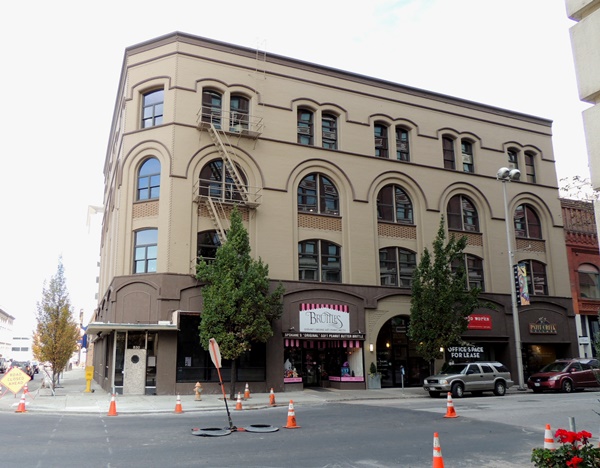
PhotoTitle: The Germond Block
PhotoAttribution: Spokane City/County Historic Preservation Office
Listing Status: Spokane Register, National Register
URL: http://properties.historicspokane.org/property/?PropertyID=1806
Display Marker: large_yellow
Title: Germond Block
Description: Date Built: 1890
Architect: Reid Brothers of San Diego
Common Name: Travo Building, Michael Building
The Germond Building is significant as one of a few remaining buildings that rose from the ashes of Spokane's 1889 fire. The structure is one of ten extant buildings of the 150 built in the year following the 1889 fire that razed the downtown business district. The building also had the distinction of serving as Spokane's city hall for its first two years while the new city hall was under construction. The Germond Block also represents a distinctive work in the Romanesque Revival style by a prominent architectural firm, the Reid Brothers. Although the building's ground floor storefront facade has been altered, as have the upper story windows, the building remains a distinctive element of downtown Spokane's historic streetscape.
Location: 47.65741, -117.42467
Address: 830 West Sprague Avenue, Spokane WA 99201
PhotoURL:

PhotoTitle: The Germond Block
PhotoAttribution: Spokane City/County Historic Preservation Office
Listing Status: Spokane Register, National Register
URL: http://properties.historicspokane.org/property/?PropertyID=1806
Display Marker: large_yellow
ID: 119
Title: Gibbs House
Description: Date Built: 1904
Architect: Unknown
Common Name: Chester Gibbs House Constructed in 1904. the Chester Gibbs House was built during the first phase of single-family construction along East Mission Avenue. Designed for Chester Gibbs, vice-president and manager of MacGillis and Gibbs Lumber Company, the home is an excellent example of the Free Classic Queen Anne style. The property achieved historic significance for its association with the architectural development and settlement of the Logan Neighborhood from 1904-1923, specifically along East Mission Avenue.
Location: 47.67138, -117.40577
Address: 308 East Mission Avenue, Spokane WA 99202
PhotoURL: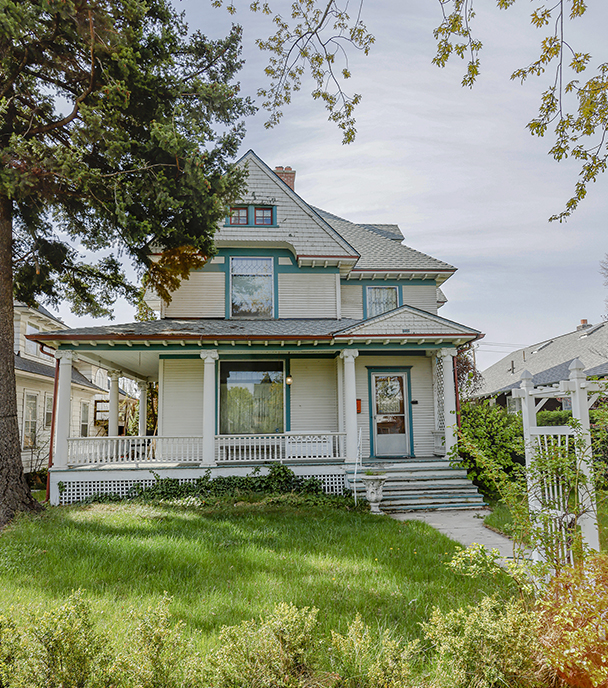
PhotoTitle: The Chester Gibbs House
PhotoAttribution: Spokane City/County Historic Preservation Office
Listing Status: Spokane Register, National Register
URL: http://properties.historicspokane.org/property/?PropertyID=1807
Display Marker: large_yellow
Title: Gibbs House
Description: Date Built: 1904
Architect: Unknown
Common Name: Chester Gibbs House Constructed in 1904. the Chester Gibbs House was built during the first phase of single-family construction along East Mission Avenue. Designed for Chester Gibbs, vice-president and manager of MacGillis and Gibbs Lumber Company, the home is an excellent example of the Free Classic Queen Anne style. The property achieved historic significance for its association with the architectural development and settlement of the Logan Neighborhood from 1904-1923, specifically along East Mission Avenue.
Location: 47.67138, -117.40577
Address: 308 East Mission Avenue, Spokane WA 99202
PhotoURL:

PhotoTitle: The Chester Gibbs House
PhotoAttribution: Spokane City/County Historic Preservation Office
Listing Status: Spokane Register, National Register
URL: http://properties.historicspokane.org/property/?PropertyID=1807
Display Marker: large_yellow
ID: 120
Title: Globe Hotel
Description: Date Built: 1908
Architect: Albert Held
Common Name: The Janet Block
Built in 1908 in response to a period of rapid growth in Spokane from 1900-1910, the Globe is significant as one of the few remaining downtown hotels representing this period of development. With its buff-colored, pressed-brick surface, the handsome three-story commercial style block offered private, furnished, ventilated rooms to the hundreds of itinerant working class men and women who helped shape Spokane. The hotel is also significant as a representative example of a Single Room Occupancy Hotel, a distinctive form of working class housing which was popular in the first decade of the twentieth century.
Location: 47.65934, -117.41074
Address: 204 North Division Street, Spokane WA 99202
PhotoURL:
PhotoTitle: The Globe Hotel
PhotoAttribution: Spokane City/County Historic Preservation Office
Listing Status: Spokane Register, National Register
URL: http://properties.historicspokane.org/property/?PropertyID=1808
Display Marker: large_yellow
Title: Globe Hotel
Description: Date Built: 1908
Architect: Albert Held
Common Name: The Janet Block
Built in 1908 in response to a period of rapid growth in Spokane from 1900-1910, the Globe is significant as one of the few remaining downtown hotels representing this period of development. With its buff-colored, pressed-brick surface, the handsome three-story commercial style block offered private, furnished, ventilated rooms to the hundreds of itinerant working class men and women who helped shape Spokane. The hotel is also significant as a representative example of a Single Room Occupancy Hotel, a distinctive form of working class housing which was popular in the first decade of the twentieth century.
Location: 47.65934, -117.41074
Address: 204 North Division Street, Spokane WA 99202
PhotoURL:

PhotoTitle: The Globe Hotel
PhotoAttribution: Spokane City/County Historic Preservation Office
Listing Status: Spokane Register, National Register
URL: http://properties.historicspokane.org/property/?PropertyID=1808
Display Marker: large_yellow
ID: 121
Title: Glover House
Description: Date Built: 1909
Architect: Kirtland Cutter and Karl Malmgren
Common Name: James Nettle Glover House, Brown House
This is James Glover's third house. Known as the "father" of Spokane, James Glover was the proprietor of the first General Store and founder of the First National Bank, among other endeavors. After the bank failed in 1893, Glover lost most of his fortune and was forced to sell his showpiece Kirtland Cutter-designed home on 8th Avenue. He relocated to this house in 1909, remaining until his death in 1921. Other owners include Frank Brown, proprietor of the Brown Printing Company.
Location: 47.67, -117.45651
Address: 1408 North Summit Boulevard, Spokane WA 99201
PhotoURL: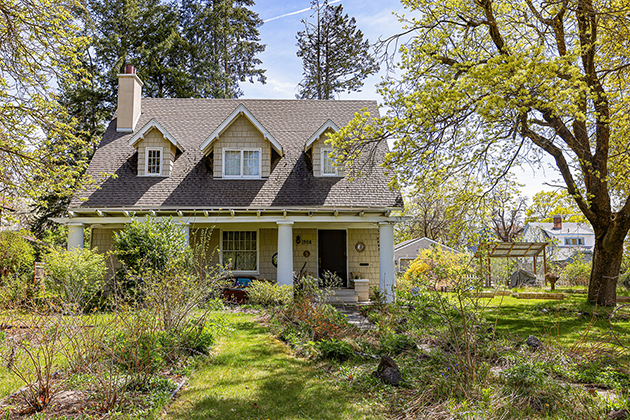
PhotoTitle: James Nettle Glover's third house
PhotoAttribution: Spokane City/County Historic Preservation Office
Listing Status: Spokane Register
URL: http://properties.historicspokane.org/property/?PropertyID=1810
Display Marker: large_yellow
Title: Glover House
Description: Date Built: 1909
Architect: Kirtland Cutter and Karl Malmgren
Common Name: James Nettle Glover House, Brown House
This is James Glover's third house. Known as the "father" of Spokane, James Glover was the proprietor of the first General Store and founder of the First National Bank, among other endeavors. After the bank failed in 1893, Glover lost most of his fortune and was forced to sell his showpiece Kirtland Cutter-designed home on 8th Avenue. He relocated to this house in 1909, remaining until his death in 1921. Other owners include Frank Brown, proprietor of the Brown Printing Company.
Location: 47.67, -117.45651
Address: 1408 North Summit Boulevard, Spokane WA 99201
PhotoURL:

PhotoTitle: James Nettle Glover's third house
PhotoAttribution: Spokane City/County Historic Preservation Office
Listing Status: Spokane Register
URL: http://properties.historicspokane.org/property/?PropertyID=1810
Display Marker: large_yellow
ID: 122
Title: Glover Mansion
Description: Date Built: 1888
Architect: Kirkland Cutter
Common Name: Spokane Unitarian Church
Built in 1888, the Glover Mansion is one of the first houses of importance in the area commonly known as the South Hill. The home is of English Tudor design with Shingle Style influence, a common characteristic of upper-class east coast homes of the time. Renowned Spokane architect Kirtland Cutter designed this majestic home for James Nettle Glover, celebrated as the "founding father" of Spokane, an entrepreneurial pioneer, visionary and leader of the early commercial and social development of Spokane. This home is architecturally significant for its association with Cutter, as it was most likely his first major architectural effort. After the construction of Glover's home, Cutter-designed mansions quickly became immensely popular among Spokane's well-to-do. In the 1940s the Glover Mansion became the home for the Unitarian Universalist Church of Spokane. The church remained in the home until the 1990s.
Location: 47.6479, -117.41722
Address: 321 West 8th Avenue, Spokane WA 99204
PhotoURL: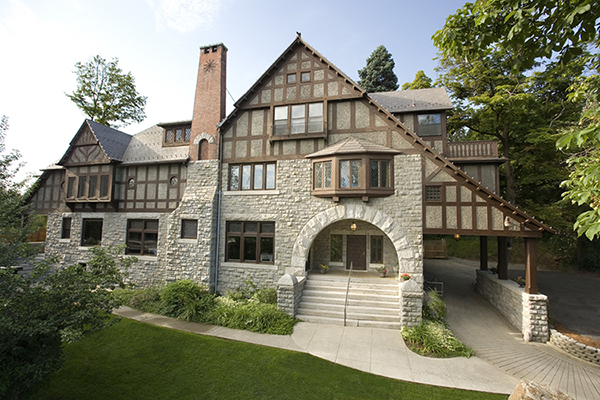
PhotoTitle: James Nettle Glover's mansion
PhotoAttribution: Spokane City/County Historic Preservation Office
Listing Status: Spokane Register, National Register
URL: http://properties.historicspokane.org/property/?PropertyID=1809
Display Marker: large_yellow
Title: Glover Mansion
Description: Date Built: 1888
Architect: Kirkland Cutter
Common Name: Spokane Unitarian Church
Built in 1888, the Glover Mansion is one of the first houses of importance in the area commonly known as the South Hill. The home is of English Tudor design with Shingle Style influence, a common characteristic of upper-class east coast homes of the time. Renowned Spokane architect Kirtland Cutter designed this majestic home for James Nettle Glover, celebrated as the "founding father" of Spokane, an entrepreneurial pioneer, visionary and leader of the early commercial and social development of Spokane. This home is architecturally significant for its association with Cutter, as it was most likely his first major architectural effort. After the construction of Glover's home, Cutter-designed mansions quickly became immensely popular among Spokane's well-to-do. In the 1940s the Glover Mansion became the home for the Unitarian Universalist Church of Spokane. The church remained in the home until the 1990s.
Location: 47.6479, -117.41722
Address: 321 West 8th Avenue, Spokane WA 99204
PhotoURL:

PhotoTitle: James Nettle Glover's mansion
PhotoAttribution: Spokane City/County Historic Preservation Office
Listing Status: Spokane Register, National Register
URL: http://properties.historicspokane.org/property/?PropertyID=1809
Display Marker: large_yellow
ID: 123
Title: Goodyear Tire and Rubber Store and Warehouse
Description: Date Built: 1925
Architect: Arthur W. Cowley
Common Name: The Bookstore
Built in 1925, Goodyear Tire and Rubber Warehouse is associated with the evolution of the automobile and automotive equipment sales and service business in Spokane. The 1920s was the first decade during which buildings were built downtown specifically to house automobile sales and accessories. The Goodyear building was the first building constructed in Spokane by a national tire company specifically as a tire warehouse with a sales office. Although it was not in the heart of Spokane's auto row, which was centered around1st Avenue, west of Monroe Street, it had an integral role in the growing automobile business as a distribution point for automobile tires.
Location: 47.6575, -117.40857
Address: 123 East Sprague Avenue, Spokane WA 99202
PhotoURL: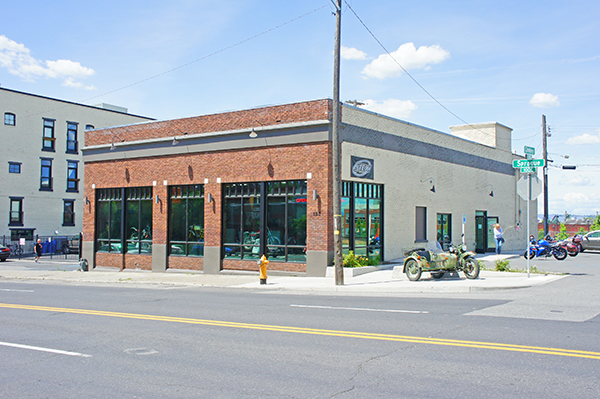
PhotoTitle: The Goodyear Tire and Rubber Store & Warehouse
PhotoAttribution: Spokane City/County Historic Preservation Office
Listing Status: Spokane Register
URL: http://properties.historicspokane.org/property/?PropertyID=2062
Display Marker: large_yellow
Title: Goodyear Tire and Rubber Store and Warehouse
Description: Date Built: 1925
Architect: Arthur W. Cowley
Common Name: The Bookstore
Built in 1925, Goodyear Tire and Rubber Warehouse is associated with the evolution of the automobile and automotive equipment sales and service business in Spokane. The 1920s was the first decade during which buildings were built downtown specifically to house automobile sales and accessories. The Goodyear building was the first building constructed in Spokane by a national tire company specifically as a tire warehouse with a sales office. Although it was not in the heart of Spokane's auto row, which was centered around1st Avenue, west of Monroe Street, it had an integral role in the growing automobile business as a distribution point for automobile tires.
Location: 47.6575, -117.40857
Address: 123 East Sprague Avenue, Spokane WA 99202
PhotoURL:

PhotoTitle: The Goodyear Tire and Rubber Store & Warehouse
PhotoAttribution: Spokane City/County Historic Preservation Office
Listing Status: Spokane Register
URL: http://properties.historicspokane.org/property/?PropertyID=2062
Display Marker: large_yellow
ID: 124
Title: Grace Baptist Church
Description: Date Built: 1907
Architect: John K. Dow
Common Name: Grace Baptist Church
Completed by 1908, Grace Baptist Church was one of the first churches built on the north side of the Spokane River. Designed by John K. Dow, a prominent architect who practiced in Spokane between 1884 and 1937, the building reflects a strong influence of the Gothic Revival Style. Although a number of other early twentieth century ecclesiastical buildings remain in the West Central neighborhood, Grace Baptist reflects a particularly high degree of its original architectural integrity. Later additions on the south end of the facility create only a slight distraction from this impressive local landmark.
Location: 47.66499, -117.43508
Address: 1523 West Mallon Avenue, Spokane WA 99201
PhotoURL: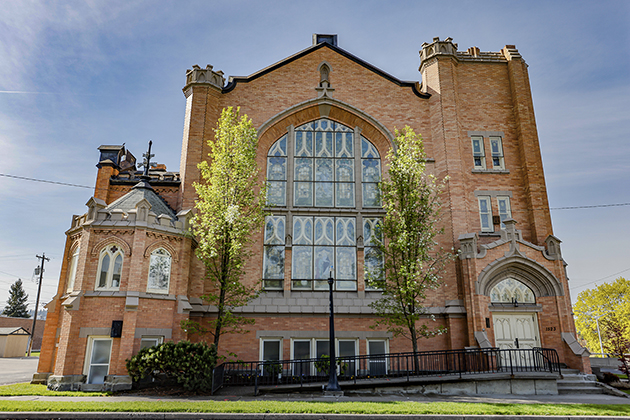
PhotoTitle: Grace Baptist Church
PhotoAttribution: Spokane City/County Historic Preservation Office
Listing Status: Spokane Register, National Register
URL: http://properties.historicspokane.org/property/?PropertyID=1811
Display Marker: large_yellow
Title: Grace Baptist Church
Description: Date Built: 1907
Architect: John K. Dow
Common Name: Grace Baptist Church
Completed by 1908, Grace Baptist Church was one of the first churches built on the north side of the Spokane River. Designed by John K. Dow, a prominent architect who practiced in Spokane between 1884 and 1937, the building reflects a strong influence of the Gothic Revival Style. Although a number of other early twentieth century ecclesiastical buildings remain in the West Central neighborhood, Grace Baptist reflects a particularly high degree of its original architectural integrity. Later additions on the south end of the facility create only a slight distraction from this impressive local landmark.
Location: 47.66499, -117.43508
Address: 1523 West Mallon Avenue, Spokane WA 99201
PhotoURL:

PhotoTitle: Grace Baptist Church
PhotoAttribution: Spokane City/County Historic Preservation Office
Listing Status: Spokane Register, National Register
URL: http://properties.historicspokane.org/property/?PropertyID=1811
Display Marker: large_yellow
ID: 125
Title: Charlotte Graham House
Description: Date Built: 1906
Architect: Unknown
Common Name: Charlotte Graham House
The history of the Charlotte Graham House, a great example of the American Four Square style, is closely intertwined with that of its neighbor to the north, the Thomas and Charlotte Graham House. That residence was built in 1896 for the Graham family who had recently arrived after building a considerable fortune through mining interests. Thomas Graham and his wife arrived in Spokane at an auspicious time. The city and the region were recovering from the financial crisis sometimes called the "Panic of 1893." The Charlotte Graham House as an excellent example of architecture during the period when newly-achieved affluence was transforming the formerly open land of the upper South Hill into a haven for Spokane's upper class citizens.
Location: 47.64413, -117.43135
Address: 1210 South Adams Street, Spokane WA 99204
PhotoURL: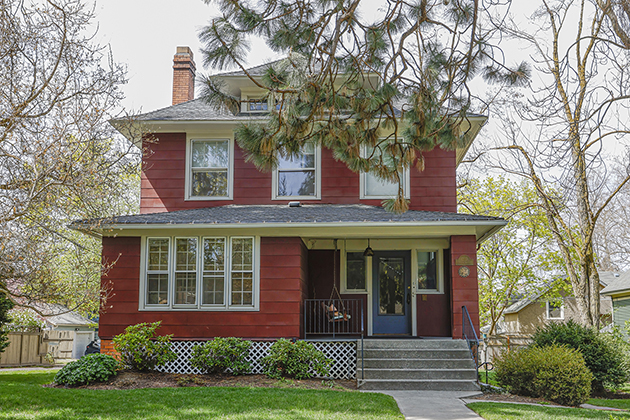
PhotoTitle: Charlotte Graham House
PhotoAttribution: Spokane City/County Historic Preservation Office
Listing Status: Spokane Register
URL: http://properties.historicspokane.org/property/?PropertyID=1812
Display Marker: large_yellow
Title: Charlotte Graham House
Description: Date Built: 1906
Architect: Unknown
Common Name: Charlotte Graham House
The history of the Charlotte Graham House, a great example of the American Four Square style, is closely intertwined with that of its neighbor to the north, the Thomas and Charlotte Graham House. That residence was built in 1896 for the Graham family who had recently arrived after building a considerable fortune through mining interests. Thomas Graham and his wife arrived in Spokane at an auspicious time. The city and the region were recovering from the financial crisis sometimes called the "Panic of 1893." The Charlotte Graham House as an excellent example of architecture during the period when newly-achieved affluence was transforming the formerly open land of the upper South Hill into a haven for Spokane's upper class citizens.
Location: 47.64413, -117.43135
Address: 1210 South Adams Street, Spokane WA 99204
PhotoURL:

PhotoTitle: Charlotte Graham House
PhotoAttribution: Spokane City/County Historic Preservation Office
Listing Status: Spokane Register
URL: http://properties.historicspokane.org/property/?PropertyID=1812
Display Marker: large_yellow
ID: 126
Title: John and Alta Graham House
Description: Date Built: 1908
Architect: W.W. Hyslop and Whitehouse & Price (wing addition)
Common Name: John and Alta Graham House
Historically significant for its association with John W. Graham and "The Hill" neighborhood, the Graham House and carriage house are typical examples of the development and subsequent settlement of the Hill, an area built as a residential neighborhood for some of Spokane's most prominent citizens. Built in 1908, the house was the home of John W. Graham and his wife, Alta Graham, for nearly five decades until John's death in 1941 and Alta's death in 1957. During this time, John Graham coined the slogan, "If It's Made of Paper, We Have It," while he owned, operated, and expanded the John W. Graham Company into one of the finest and largest stationery, book, and office supply stores in the western United States. Today, the home is an apartment building.
Location: 47.65006, -117.42611
Address: 607 South Monroe Street, Spokane WA 99204
PhotoURL: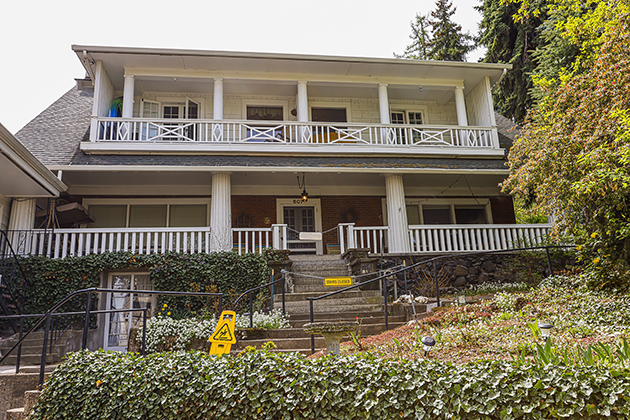
PhotoTitle: The John and Alta Graham House
PhotoAttribution: Spokane City/County Historic Preservation Office
Listing Status: Spokane Register
URL: http://properties.historicspokane.org/property/?PropertyID=1813
Display Marker: large_yellow
Title: John and Alta Graham House
Description: Date Built: 1908
Architect: W.W. Hyslop and Whitehouse & Price (wing addition)
Common Name: John and Alta Graham House
Historically significant for its association with John W. Graham and "The Hill" neighborhood, the Graham House and carriage house are typical examples of the development and subsequent settlement of the Hill, an area built as a residential neighborhood for some of Spokane's most prominent citizens. Built in 1908, the house was the home of John W. Graham and his wife, Alta Graham, for nearly five decades until John's death in 1941 and Alta's death in 1957. During this time, John Graham coined the slogan, "If It's Made of Paper, We Have It," while he owned, operated, and expanded the John W. Graham Company into one of the finest and largest stationery, book, and office supply stores in the western United States. Today, the home is an apartment building.
Location: 47.65006, -117.42611
Address: 607 South Monroe Street, Spokane WA 99204
PhotoURL:

PhotoTitle: The John and Alta Graham House
PhotoAttribution: Spokane City/County Historic Preservation Office
Listing Status: Spokane Register
URL: http://properties.historicspokane.org/property/?PropertyID=1813
Display Marker: large_yellow
ID: 127
Title: Thomas Graham House
Description: Date Built: 1896
Architect: Unknown
Common Name: Thomas J. Graham House
Large and complex with a porch wrapped around three sides, the Graham House possesses strong Victorian influences in its construction. The home was among the first houses to be built high on the South Hill as exclusive residential development had begun along the lower reaches of the Hill and only gradually crept to the heights above. The house was constructed for the family of Thomas J. Graham in 1896. Curiously, little is known about Thomas and his wife, Charlotte. Although the family was quite well off and had some connection to the mining industry, it is apparent that he was not one of the town's more visible people and instead chose a life of anonymity.
Location: 47.6443, -117.43135
Address: 1204 South Adams Street, Spokane WA 99204
PhotoURL: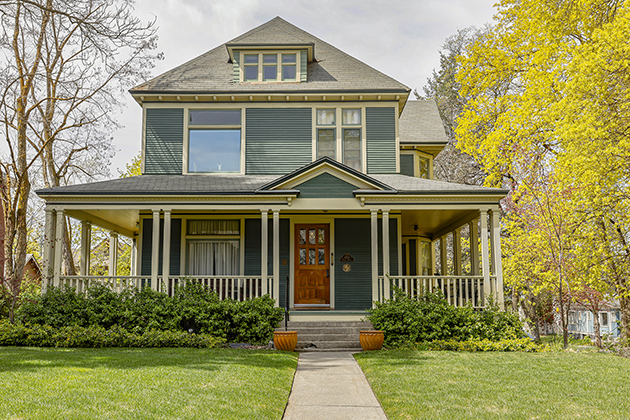
PhotoTitle: The Thomas Graham House
PhotoAttribution: Spokane City/County Historic Preservation Office
Listing Status: Spokane Register
URL: http://properties.historicspokane.org/property/?PropertyID=1814
Display Marker: large_yellow
Title: Thomas Graham House
Description: Date Built: 1896
Architect: Unknown
Common Name: Thomas J. Graham House
Large and complex with a porch wrapped around three sides, the Graham House possesses strong Victorian influences in its construction. The home was among the first houses to be built high on the South Hill as exclusive residential development had begun along the lower reaches of the Hill and only gradually crept to the heights above. The house was constructed for the family of Thomas J. Graham in 1896. Curiously, little is known about Thomas and his wife, Charlotte. Although the family was quite well off and had some connection to the mining industry, it is apparent that he was not one of the town's more visible people and instead chose a life of anonymity.
Location: 47.6443, -117.43135
Address: 1204 South Adams Street, Spokane WA 99204
PhotoURL:

PhotoTitle: The Thomas Graham House
PhotoAttribution: Spokane City/County Historic Preservation Office
Listing Status: Spokane Register
URL: http://properties.historicspokane.org/property/?PropertyID=1814
Display Marker: large_yellow
ID: 128
Title: Great Northern Depot Tower
Description: Date Built: 1902
Architect: Charles Frost and Alfred Granger
Common Name: The Clock Tower
The Great Northern Railway Depot Tower stands as a physical reminder of the centrality of railroads in the emergence of Spokane as a regional distribution hub during the late nineteenth and early twentieth centuries. Construction of the depot commenced in 1901. When it was completed in 1902 it was considered the finest depot west of Chicago. Countless passengers embarked and disembarked at the depot, which served famous passenger trains like the "Empire Builder." When the station was demolished in the early 1970s in preparation for Expo '74, planners retained the clock tower. It is now a conspicuous landmark in the heart of Riverfront Park, the centerpiece of the city.
Location: 47.661506, -117.419019
Address: 500 North Stevens Street, Havermale Island, Spokane WA 99201
PhotoURL:
PhotoTitle: The Great Northern Depot Tower
PhotoAttribution: Spokane City/County Historic Preservation Office
Listing Status: N/A
URL: http://properties.historicspokane.org/property/?PropertyID=1999
Display Marker: large_yellow
Title: Great Northern Depot Tower
Description: Date Built: 1902
Architect: Charles Frost and Alfred Granger
Common Name: The Clock Tower
The Great Northern Railway Depot Tower stands as a physical reminder of the centrality of railroads in the emergence of Spokane as a regional distribution hub during the late nineteenth and early twentieth centuries. Construction of the depot commenced in 1901. When it was completed in 1902 it was considered the finest depot west of Chicago. Countless passengers embarked and disembarked at the depot, which served famous passenger trains like the "Empire Builder." When the station was demolished in the early 1970s in preparation for Expo '74, planners retained the clock tower. It is now a conspicuous landmark in the heart of Riverfront Park, the centerpiece of the city.
Location: 47.661506, -117.419019
Address: 500 North Stevens Street, Havermale Island, Spokane WA 99201
PhotoURL:

PhotoTitle: The Great Northern Depot Tower
PhotoAttribution: Spokane City/County Historic Preservation Office
Listing Status: N/A
URL: http://properties.historicspokane.org/property/?PropertyID=1999
Display Marker: large_yellow
ID: 129
Title: Green-Hughes Printing Company Building
Description: Date Built: 1911
Architect: Unknown
Common Name: Green-Hughes Printing Co. Building
The Green-Hughes Printing Company Building was built in 1911 and named for the most significant owners of the building, Robert Green and Harley Hughes, who together owned and operated the Green-Hughes Printing Company from 1936 to 1951. From their printing presses on the building's first floor, Green and Hughes produced thousands of issues of Labor World, the most widely-read weekly newspaper reporting business at that time for organized labor unions operating in Eastern Washington, Northern Idaho and Western Montana. Hughes and his publication were the forerunners to the development of the Spokane Labor Council, the current body overseeing affiliated labor unions in Spokane County and part of Eastern Washington. The Green-Hughes Printing Company Building is historically significant for its association with Harley Hughes, Labor World and the development of one of East Central Spokane's warehouse and industrial districts.
Location: 47.655415, -117.412272
Address: 19 West Pacific Avenue, Spokane WA 99201
PhotoURL:
PhotoTitle: The Green-Hughes Printing Company Building
PhotoAttribution: Spokane City/County Historic Preservation Office
Listing Status: Spokane Register, National Register
URL: http://properties.historicspokane.org/property/?PropertyID=1815
Display Marker: large_yellow
Title: Green-Hughes Printing Company Building
Description: Date Built: 1911
Architect: Unknown
Common Name: Green-Hughes Printing Co. Building
The Green-Hughes Printing Company Building was built in 1911 and named for the most significant owners of the building, Robert Green and Harley Hughes, who together owned and operated the Green-Hughes Printing Company from 1936 to 1951. From their printing presses on the building's first floor, Green and Hughes produced thousands of issues of Labor World, the most widely-read weekly newspaper reporting business at that time for organized labor unions operating in Eastern Washington, Northern Idaho and Western Montana. Hughes and his publication were the forerunners to the development of the Spokane Labor Council, the current body overseeing affiliated labor unions in Spokane County and part of Eastern Washington. The Green-Hughes Printing Company Building is historically significant for its association with Harley Hughes, Labor World and the development of one of East Central Spokane's warehouse and industrial districts.
Location: 47.655415, -117.412272
Address: 19 West Pacific Avenue, Spokane WA 99201
PhotoURL:

PhotoTitle: The Green-Hughes Printing Company Building
PhotoAttribution: Spokane City/County Historic Preservation Office
Listing Status: Spokane Register, National Register
URL: http://properties.historicspokane.org/property/?PropertyID=1815
Display Marker: large_yellow
ID: 130
Title: Groshoff Apartments
Description: Date Built: 1909
Architect: George Groshoff
Common Name: Woodcutter's Hall
Pioneer contractor and master brick mason, George Groshoff, designed and built the Groshoff apartment building in a working class neighborhood that grew in response to the demand for the skills of immigrants during a period of rapid growth of Spokane. The building is also historically significant in its own right as the only remaining building of several large structures built in the valley to house the influx of single men who came to work in the mines, lumber camps, railroad yards and construction trades during 1900-1910, the period of explosive growth that followed the disastrous 1889 fire.
Location: 47.659160, -117.435641
Address: 1608 West Main Avenue, Spokane WA 99201
PhotoURL: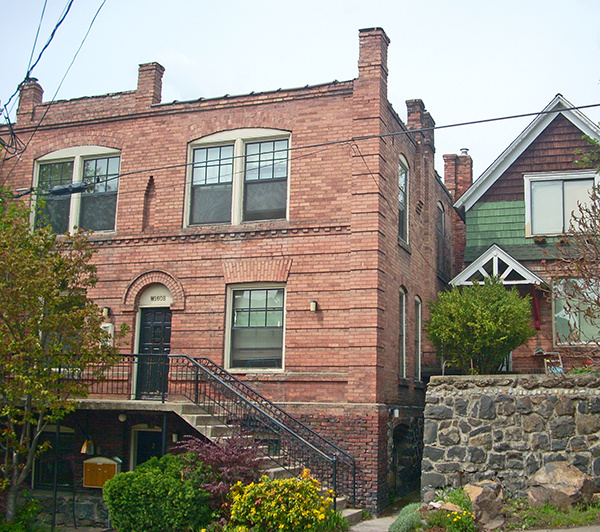
PhotoTitle: The Groshoff Apartments
PhotoAttribution: Spokane City/County Historic Preservation Office
Listing Status: Spokane Register, National Register
URL: http://properties.historicspokane.org/property/?PropertyID=1816
Display Marker: large_yellow
Title: Groshoff Apartments
Description: Date Built: 1909
Architect: George Groshoff
Common Name: Woodcutter's Hall
Pioneer contractor and master brick mason, George Groshoff, designed and built the Groshoff apartment building in a working class neighborhood that grew in response to the demand for the skills of immigrants during a period of rapid growth of Spokane. The building is also historically significant in its own right as the only remaining building of several large structures built in the valley to house the influx of single men who came to work in the mines, lumber camps, railroad yards and construction trades during 1900-1910, the period of explosive growth that followed the disastrous 1889 fire.
Location: 47.659160, -117.435641
Address: 1608 West Main Avenue, Spokane WA 99201
PhotoURL:

PhotoTitle: The Groshoff Apartments
PhotoAttribution: Spokane City/County Historic Preservation Office
Listing Status: Spokane Register, National Register
URL: http://properties.historicspokane.org/property/?PropertyID=1816
Display Marker: large_yellow
ID: 131
Title: Guse House
Description: Date Built: 1901
Architect: Loren L. Rand
Common Name: Fred and Mary Guse House
Built in 1901, the Fred and Mary Guse House is a fine example of the Free Classic Queen Anne style and is a product of noted Spokane architect, Loren L. Rand, a skilled exponent of the architectural profession who was ranked among the foremost in the northwest. The property is further significant for its association with the design, development, and subsequent settlement of Browne's Addition, one of Spokane's first socially and architecturally prominent residential neighborhoods. The property was built for Mary and Fred Guse, a pioneer Spokane grocer, and was home to the Guse family for 58 years. Although the interior of the house was modified in 1959 to accommodate three apartments, the exterior of the Guse House remains intact and nearly exactly depicts designs rendered in circa 1901 blueprints of the property. Remarkably well-preserved after a century of use, the exterior of the Guse House clearly conveys its original design, materials, and workmanship as a single-family residence.
Location: 47.655785, -117.441397
Address: 1928 West Pacific Avenue, Spokane WA 99201
PhotoURL: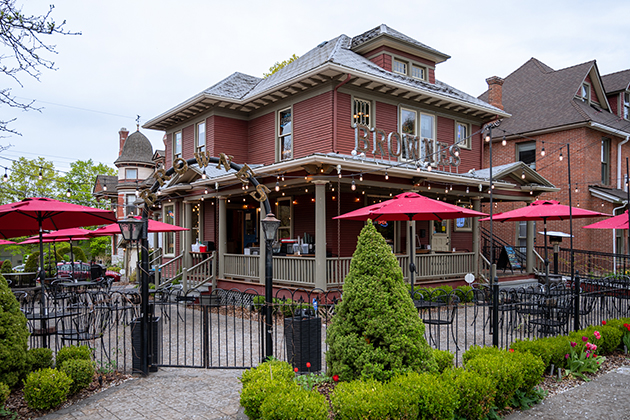
PhotoTitle: The Fred and Mary Guse House
PhotoAttribution: Spokane City/County Historic Preservation Office
Listing Status: Spokane Register, National Register
URL: http://properties.historicspokane.org/property/?PropertyID=1817
Display Marker: large_yellow
Title: Guse House
Description: Date Built: 1901
Architect: Loren L. Rand
Common Name: Fred and Mary Guse House
Built in 1901, the Fred and Mary Guse House is a fine example of the Free Classic Queen Anne style and is a product of noted Spokane architect, Loren L. Rand, a skilled exponent of the architectural profession who was ranked among the foremost in the northwest. The property is further significant for its association with the design, development, and subsequent settlement of Browne's Addition, one of Spokane's first socially and architecturally prominent residential neighborhoods. The property was built for Mary and Fred Guse, a pioneer Spokane grocer, and was home to the Guse family for 58 years. Although the interior of the house was modified in 1959 to accommodate three apartments, the exterior of the Guse House remains intact and nearly exactly depicts designs rendered in circa 1901 blueprints of the property. Remarkably well-preserved after a century of use, the exterior of the Guse House clearly conveys its original design, materials, and workmanship as a single-family residence.
Location: 47.655785, -117.441397
Address: 1928 West Pacific Avenue, Spokane WA 99201
PhotoURL:

PhotoTitle: The Fred and Mary Guse House
PhotoAttribution: Spokane City/County Historic Preservation Office
Listing Status: Spokane Register, National Register
URL: http://properties.historicspokane.org/property/?PropertyID=1817
Display Marker: large_yellow
ID: 132
Title: Hale Block
Description: Date Built: 1905
Architect: Unknown
Common Name: Hale Block
Built in 1905, the Hale Block is a three-story brick building constructed of eighteen-inch thick unreinforced masonry walls. At various times, it was home to the Hale, the Del Monte, the Lang, the Sonte and the Kincaid Hotels. These hotels provided housing needs for hundreds of working class citizens for 60 years. The Hale Block is one of only a few remaining SROs (Single Residency Occupany Hotels) that were originally erected in Spokane's East Downtown neighborhood, which once held over 100 such hotels.
Location: 47.657761, -117.414839
Address: 231 West Riverside Avenue, Spokane WA 99201
PhotoURL: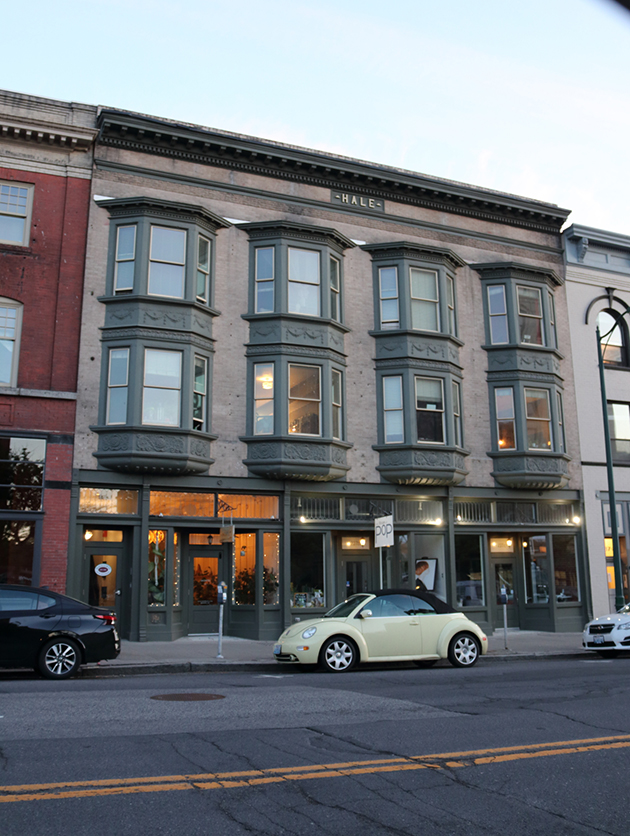
PhotoTitle: The Hale Block
PhotoAttribution: Spokane City/County Historic Preservation Office
Listing Status: Spokane Register, National Register
URL: http://properties.historicspokane.org/property/?PropertyID=1818
Display Marker: large_yellow
Title: Hale Block
Description: Date Built: 1905
Architect: Unknown
Common Name: Hale Block
Built in 1905, the Hale Block is a three-story brick building constructed of eighteen-inch thick unreinforced masonry walls. At various times, it was home to the Hale, the Del Monte, the Lang, the Sonte and the Kincaid Hotels. These hotels provided housing needs for hundreds of working class citizens for 60 years. The Hale Block is one of only a few remaining SROs (Single Residency Occupany Hotels) that were originally erected in Spokane's East Downtown neighborhood, which once held over 100 such hotels.
Location: 47.657761, -117.414839
Address: 231 West Riverside Avenue, Spokane WA 99201
PhotoURL:

PhotoTitle: The Hale Block
PhotoAttribution: Spokane City/County Historic Preservation Office
Listing Status: Spokane Register, National Register
URL: http://properties.historicspokane.org/property/?PropertyID=1818
Display Marker: large_yellow
ID: 133
Title: Ham-McEachern House
Description: Date Built: 1886
Architect: Unknown
Common Name: Oatman Residence
While there are older homes within the city limits of the small rural community of Latah, none can compare with the architectural skill and excellent condition of the Ham-McEachern House. The house exhibits the charm of Queen Anne styling popular in Eastern Washington prior to 1890, combined with the placidity of small town landscaping. The home was built in 1886 by D. T. Ham, co-founder of Latah's first store, who became one of the most influential political and business leaders in Washington just after the turn of the century. The next major owner of the property was William McEachern, Latah's first banker. The home has been closely related to Latah's and Spokane County's commercial and political history.
Location: 47.282018, -117.157509
Address: 329 North Pine Street, Latah WA 99018
PhotoURL: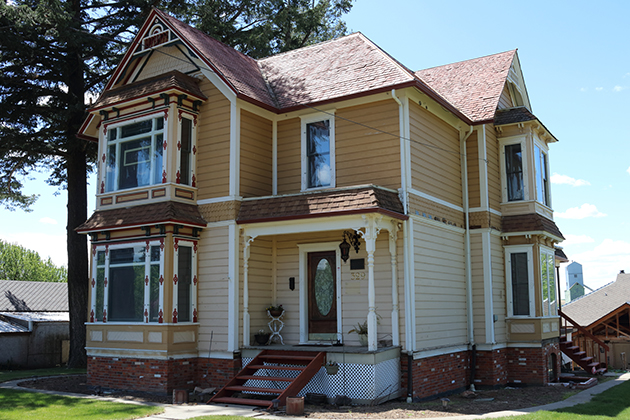
PhotoTitle: The Ham-McEachern House
PhotoAttribution: Lynne Foresman
Listing Status: Spokane Register, National Register
URL: http://properties.historicspokane.org/property/?PropertyID=2077
Display Marker: large_yellow
Title: Ham-McEachern House
Description: Date Built: 1886
Architect: Unknown
Common Name: Oatman Residence
While there are older homes within the city limits of the small rural community of Latah, none can compare with the architectural skill and excellent condition of the Ham-McEachern House. The house exhibits the charm of Queen Anne styling popular in Eastern Washington prior to 1890, combined with the placidity of small town landscaping. The home was built in 1886 by D. T. Ham, co-founder of Latah's first store, who became one of the most influential political and business leaders in Washington just after the turn of the century. The next major owner of the property was William McEachern, Latah's first banker. The home has been closely related to Latah's and Spokane County's commercial and political history.
Location: 47.282018, -117.157509
Address: 329 North Pine Street, Latah WA 99018
PhotoURL:

PhotoTitle: The Ham-McEachern House
PhotoAttribution: Lynne Foresman
Listing Status: Spokane Register, National Register
URL: http://properties.historicspokane.org/property/?PropertyID=2077
Display Marker: large_yellow
ID: 134
Title: Hamer Block
Description: Date Built: 1901
Architect: Unknown
Common Name: Leslie Apartments
The two-story red brick masonry Hamer Block-Leslie Apartments has a plain parapet and a corbelled brick cornice. From 1901 to 1950, various tenants occupied the building, including a clothing store, meat market, hardware shop, plumbing and heating store, saddlery business, Grossman Brothers Furniture, Brown Shoes & Repair, the Lighthouse Cafe, and Westminster Bakery. Upstairs, the Leslie Apartments were rented as single-occupancy rooms.
Location: 47.70315, -117.36457
Address: 4920 North Market Street, Spokane WA 99217
PhotoURL: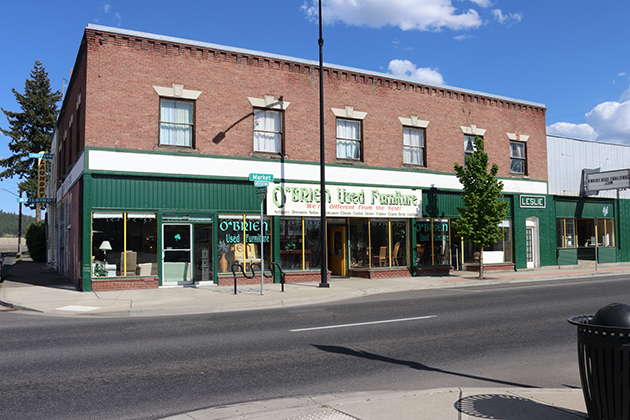
PhotoTitle: The Hamer Block
PhotoAttribution: Spokane City/County Historic Preservation Office
Listing Status: Spokane Register, National Register
URL: http://properties.historicspokane.org/property/?PropertyID=1819
Display Marker: large_yellow
Title: Hamer Block
Description: Date Built: 1901
Architect: Unknown
Common Name: Leslie Apartments
The two-story red brick masonry Hamer Block-Leslie Apartments has a plain parapet and a corbelled brick cornice. From 1901 to 1950, various tenants occupied the building, including a clothing store, meat market, hardware shop, plumbing and heating store, saddlery business, Grossman Brothers Furniture, Brown Shoes & Repair, the Lighthouse Cafe, and Westminster Bakery. Upstairs, the Leslie Apartments were rented as single-occupancy rooms.
Location: 47.70315, -117.36457
Address: 4920 North Market Street, Spokane WA 99217
PhotoURL:

PhotoTitle: The Hamer Block
PhotoAttribution: Spokane City/County Historic Preservation Office
Listing Status: Spokane Register, National Register
URL: http://properties.historicspokane.org/property/?PropertyID=1819
Display Marker: large_yellow
ID: 135
Title: Hanauer-Cook House
Description: Date Built: 1890
Architect: Unknown
Common Name: Hanauer-Cook House
The Hanauer-Cook House is an eclectic interpretation of the Queen Anne tradition with Free Classic Queen Anne style and Tudor Revival influence. The property covers three lots and commands a panoramic view of downtown from a prominent position atop a steep hillside site at the southeast corner of West Sixth Avenue and South Jefferson Street on Spokane's lower South Hill. The large two-story house is a manifestation of typical Queen Anne style features which include an irregular hip roof with lower cross gables, an irregular footprint with both bowed and box bays, a brick and basalt rock foundation, a full-width covered front porch with a wrap-around corner porch, diamond-paned leaded-glass windows, tall 1/1 double-hung wood-sash windows, and a round turret at the second floor. The home is in excellent condition and retains high exterior architectural integrity in original location, design, materials, workmanship, and association as a single-family residence built in the late 1800s in Spokane.
Location: 47.65005, -117.42905
Address: 1121 West 6th Avenue, Spokane WA 99204
PhotoURL: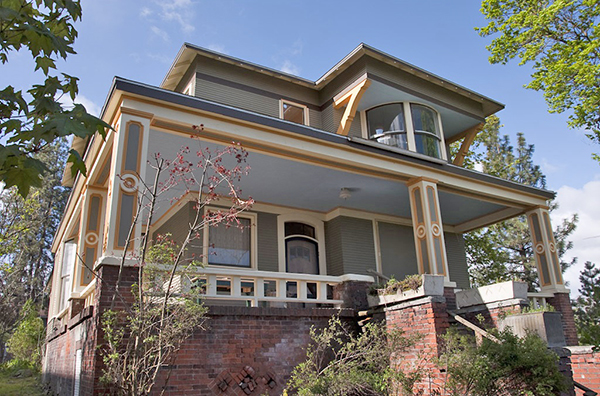
PhotoTitle: Hanauer-Cook House
PhotoAttribution: Spokane City/County Historic Preservation Office
Listing Status: Spokane Register
URL: http://properties.historicspokane.org/property/?PropertyID=1820
Display Marker: large_yellow
Title: Hanauer-Cook House
Description: Date Built: 1890
Architect: Unknown
Common Name: Hanauer-Cook House
The Hanauer-Cook House is an eclectic interpretation of the Queen Anne tradition with Free Classic Queen Anne style and Tudor Revival influence. The property covers three lots and commands a panoramic view of downtown from a prominent position atop a steep hillside site at the southeast corner of West Sixth Avenue and South Jefferson Street on Spokane's lower South Hill. The large two-story house is a manifestation of typical Queen Anne style features which include an irregular hip roof with lower cross gables, an irregular footprint with both bowed and box bays, a brick and basalt rock foundation, a full-width covered front porch with a wrap-around corner porch, diamond-paned leaded-glass windows, tall 1/1 double-hung wood-sash windows, and a round turret at the second floor. The home is in excellent condition and retains high exterior architectural integrity in original location, design, materials, workmanship, and association as a single-family residence built in the late 1800s in Spokane.
Location: 47.65005, -117.42905
Address: 1121 West 6th Avenue, Spokane WA 99204
PhotoURL:

PhotoTitle: Hanauer-Cook House
PhotoAttribution: Spokane City/County Historic Preservation Office
Listing Status: Spokane Register
URL: http://properties.historicspokane.org/property/?PropertyID=1820
Display Marker: large_yellow
ID: 136
Title: Hart-Collins House
Description: Date Built: 1907
Architect: Unknown
Common Name: Hart-Collins House
The house belonged to Henry M. Hart, a Cornell graduate who came to Spokane to be principal of South Central High School (now known as Lewis & Clark), the first high school in Spokane. During Hart's tenure, from 1907 to 1936, the school became known as one of the finest in the West and Hart became known as a leader in educational and cultural affairs of the city.
Location: 47.65131, -117.39066
Address: 1314 East 5th Avenue, Spokane WA 99202
PhotoURL:
PhotoTitle: Hart-Collins House
PhotoAttribution: Spokane City/County Historic Preservation Office
Listing Status: Spokane Register
URL: http://properties.historicspokane.org/property/?PropertyID=1821
Display Marker: large_yellow
Title: Hart-Collins House
Description: Date Built: 1907
Architect: Unknown
Common Name: Hart-Collins House
The house belonged to Henry M. Hart, a Cornell graduate who came to Spokane to be principal of South Central High School (now known as Lewis & Clark), the first high school in Spokane. During Hart's tenure, from 1907 to 1936, the school became known as one of the finest in the West and Hart became known as a leader in educational and cultural affairs of the city.
Location: 47.65131, -117.39066
Address: 1314 East 5th Avenue, Spokane WA 99202
PhotoURL:

PhotoTitle: Hart-Collins House
PhotoAttribution: Spokane City/County Historic Preservation Office
Listing Status: Spokane Register
URL: http://properties.historicspokane.org/property/?PropertyID=1821
Display Marker: large_yellow
ID: 137
Title: Hathaway-Suksdorf House
Description: Date Built: 1940
Architect: Hyrtice C. Marsh
Common Name: Hathaway-Suksdorf House
Designed for Dr. Joseph Hathaway, the Hathaway-Suksdorf House is a distinguished French Eclectic house. Architecturally significant, the Hathaway-Suksdorf House is one of few representative examples in Spokane, a style that was popular throughout America during this time. The house is one of the best remaining examples of the work of Hyrtice Marsh, the architect best known for the French Eclectic architectural style in Spokane. Easily recognized for its distinctive style, the home exhibits all the textbook character-defining French Eclectic features: the massive, steeply pitched, hipped pavilion roof, the flared eaves, the symmetrical brick veneer facade with its centrally placed door, the decorative quoins, the arched roof dormers and the tall chimney.
Location: 47.63242, -117.39987
Address: 720 East 24th Avenue, Spokane WA 99203
PhotoURL: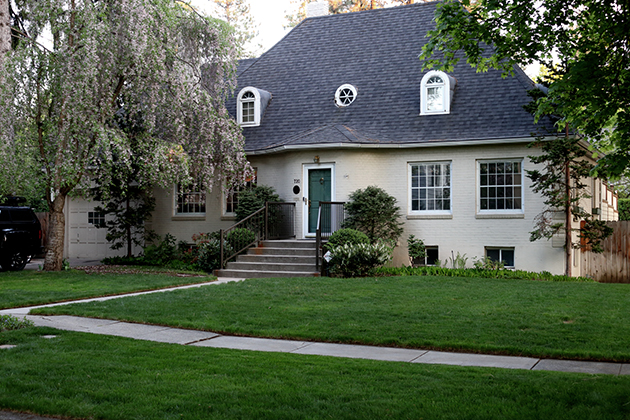
PhotoTitle: Hathaway-Suksdorf House
PhotoAttribution: Spokane City/County Historic Preservation Office
Listing Status: Spokane Register, National Register
URL: http://properties.historicspokane.org/property/?PropertyID=1822
Display Marker: large_yellow
Title: Hathaway-Suksdorf House
Description: Date Built: 1940
Architect: Hyrtice C. Marsh
Common Name: Hathaway-Suksdorf House
Designed for Dr. Joseph Hathaway, the Hathaway-Suksdorf House is a distinguished French Eclectic house. Architecturally significant, the Hathaway-Suksdorf House is one of few representative examples in Spokane, a style that was popular throughout America during this time. The house is one of the best remaining examples of the work of Hyrtice Marsh, the architect best known for the French Eclectic architectural style in Spokane. Easily recognized for its distinctive style, the home exhibits all the textbook character-defining French Eclectic features: the massive, steeply pitched, hipped pavilion roof, the flared eaves, the symmetrical brick veneer facade with its centrally placed door, the decorative quoins, the arched roof dormers and the tall chimney.
Location: 47.63242, -117.39987
Address: 720 East 24th Avenue, Spokane WA 99203
PhotoURL:

PhotoTitle: Hathaway-Suksdorf House
PhotoAttribution: Spokane City/County Historic Preservation Office
Listing Status: Spokane Register, National Register
URL: http://properties.historicspokane.org/property/?PropertyID=1822
Display Marker: large_yellow
ID: 138
Title: Hazel-Merton Block (demolished)
Description: Date Built: 1890
Architect: Herman Preusse
Common Name: Hazel-Merton Block
The historic Hazel-Merton Block was demolished in 2004. No structure has been rebuilt on the site. Designed by Herman Preusse in the wake of the Great Fire of 1889, the Hazel-Merton Block was a four-story brick commercial building with rough-faced stone detailing, a flat roof and a stone foundation. It was typical of designs that Preusse rendered for buildings between 1890 and 1893, the busiest years of his career. It was built for Charles W. Carson, a Spokane restaurateur and early occupants of the building included Edison Electric Illumination Co., the Washington Water Power Co. and William H. Cowles' Spokane Spokesman, which would eventually become the Spokesman-Review. During Spokane's decade of phenomenal growth and corresponding building boom at the beginning of the twentieth century, the upper floors of the Hazel-Merton Block were also converted from office space into a Single Room Occupancy Hotel.
Location: 47.65739, -117.42074
Address: 2 North Howard Street, Spokane WA 99201
PhotoURL: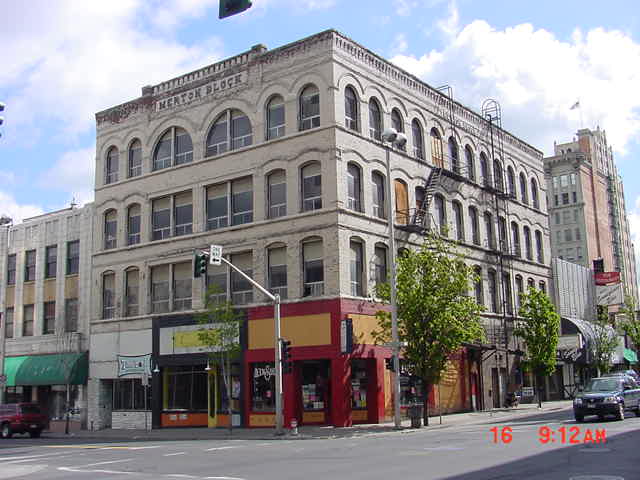
PhotoTitle: Hazel-Merton Block
PhotoAttribution: Spokane City/County Historic Preservation Office
Listing Status: N/A
URL: http://properties.historicspokane.org/property/?PropertyID=2076
Display Marker: large_yellow
Title: Hazel-Merton Block (demolished)
Description: Date Built: 1890
Architect: Herman Preusse
Common Name: Hazel-Merton Block
The historic Hazel-Merton Block was demolished in 2004. No structure has been rebuilt on the site. Designed by Herman Preusse in the wake of the Great Fire of 1889, the Hazel-Merton Block was a four-story brick commercial building with rough-faced stone detailing, a flat roof and a stone foundation. It was typical of designs that Preusse rendered for buildings between 1890 and 1893, the busiest years of his career. It was built for Charles W. Carson, a Spokane restaurateur and early occupants of the building included Edison Electric Illumination Co., the Washington Water Power Co. and William H. Cowles' Spokane Spokesman, which would eventually become the Spokesman-Review. During Spokane's decade of phenomenal growth and corresponding building boom at the beginning of the twentieth century, the upper floors of the Hazel-Merton Block were also converted from office space into a Single Room Occupancy Hotel.
Location: 47.65739, -117.42074
Address: 2 North Howard Street, Spokane WA 99201
PhotoURL:

PhotoTitle: Hazel-Merton Block
PhotoAttribution: Spokane City/County Historic Preservation Office
Listing Status: N/A
URL: http://properties.historicspokane.org/property/?PropertyID=2076
Display Marker: large_yellow
ID: 139
Title: Heath House
Description: Date Built: 1889
Architect: Unknown
Common Name: Heath Mission Avenue House
The Heath House is one of the earliest residential sections to be platted and developed north of the Spokane River. Situated on the north side of the graceful tree-lined Mission Avenue, the home is a simplified square, two-story, wood-frame Queen Anne with a one-and-a-half story back extension. The home was constructed for Sylvester Heath, a man who made significant contributions to early Spokane. Heath is credited for building the Heath Block in 1890 which served as a major contribution to downtown building following the fire of 1889. The Heath Library was also donated to the City of Spokane and represents one of several benevolent efforts.
Location: 47.67206, -117.39331
Address: 1017 East Mission Avenue, Spokane WA 99202
PhotoURL: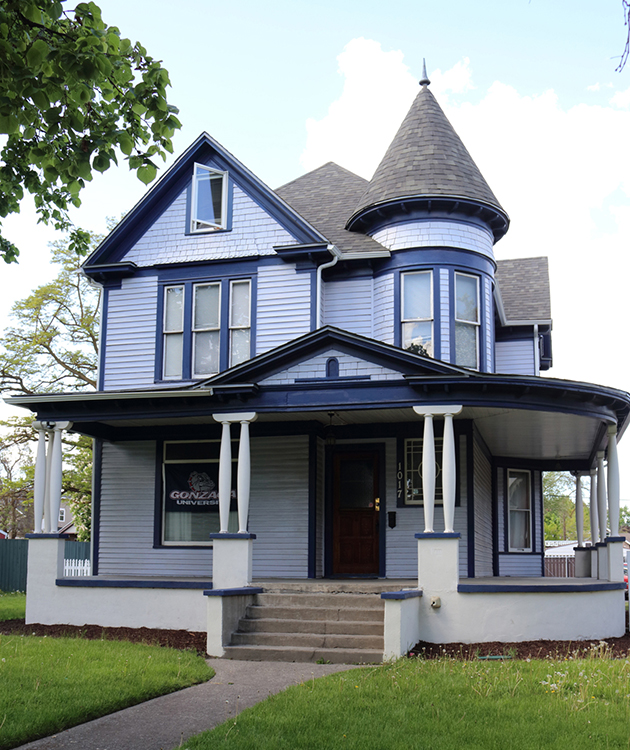
PhotoTitle: The Heath House
PhotoAttribution: Spokane City/County Historic Preservation Office
Listing Status: Spokane Register
URL: http://properties.historicspokane.org/property/?PropertyID=1823
Display Marker: large_yellow
Title: Heath House
Description: Date Built: 1889
Architect: Unknown
Common Name: Heath Mission Avenue House
The Heath House is one of the earliest residential sections to be platted and developed north of the Spokane River. Situated on the north side of the graceful tree-lined Mission Avenue, the home is a simplified square, two-story, wood-frame Queen Anne with a one-and-a-half story back extension. The home was constructed for Sylvester Heath, a man who made significant contributions to early Spokane. Heath is credited for building the Heath Block in 1890 which served as a major contribution to downtown building following the fire of 1889. The Heath Library was also donated to the City of Spokane and represents one of several benevolent efforts.
Location: 47.67206, -117.39331
Address: 1017 East Mission Avenue, Spokane WA 99202
PhotoURL:

PhotoTitle: The Heath House
PhotoAttribution: Spokane City/County Historic Preservation Office
Listing Status: Spokane Register
URL: http://properties.historicspokane.org/property/?PropertyID=1823
Display Marker: large_yellow
ID: 140
Title: Hendrickson Flats (demolished)
Description: Date Built: 1905
Architect: Unknown
Common Name: The Poplars
Hendrickson Flats was constructed in 1905 for widow Ola Hendrickson during a period in Spokane when brick apartment buildings first began to appear. Upscale versions of the boarding house concept were already prevalent in Spokane and multi-unit brick apartment dwellings were considered a satisfactory alternative to a house, requiring less of an investment. Constructed of buff-colored brick, the apartment building was probably constructed of brick from the Washington Brick and Lime Company in Clayton, Washington, the same material utilized to construct the Spokane County Courthouse. Hendrickson Flats was demolished in 1998.
Location: 47.651600, -117.418205
Address: 414 West 5th Avenue, Spokane WA 99204
PhotoURL: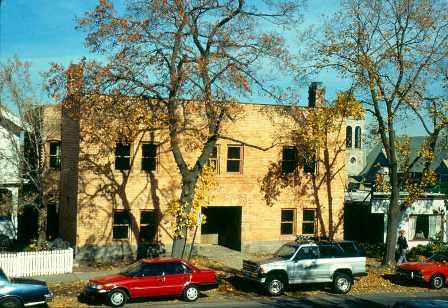
PhotoTitle: The once-standing Hendrickson Flats
PhotoAttribution: Spokane City/County Historic Preservation Office
Listing Status: Spokane Register
URL: http://properties.historicspokane.org/property/?PropertyID=1824
Display Marker: large_yellow
Title: Hendrickson Flats (demolished)
Description: Date Built: 1905
Architect: Unknown
Common Name: The Poplars
Hendrickson Flats was constructed in 1905 for widow Ola Hendrickson during a period in Spokane when brick apartment buildings first began to appear. Upscale versions of the boarding house concept were already prevalent in Spokane and multi-unit brick apartment dwellings were considered a satisfactory alternative to a house, requiring less of an investment. Constructed of buff-colored brick, the apartment building was probably constructed of brick from the Washington Brick and Lime Company in Clayton, Washington, the same material utilized to construct the Spokane County Courthouse. Hendrickson Flats was demolished in 1998.
Location: 47.651600, -117.418205
Address: 414 West 5th Avenue, Spokane WA 99204
PhotoURL:

PhotoTitle: The once-standing Hendrickson Flats
PhotoAttribution: Spokane City/County Historic Preservation Office
Listing Status: Spokane Register
URL: http://properties.historicspokane.org/property/?PropertyID=1824
Display Marker: large_yellow
ID: 141
Title: Hieber House
Description: Date Built: 1889
Architect:David B. Fotheringham Common Name: Henley-Hieber House, John & Louisa Hieber House
The Hieber House and carriage house, built in 1889, reflect an eclectic mix of influences from the Queen Anne, Swiss Chalet and Shingle architectural styles. The property was originally constructed for flagman and city stableman, John W. Glover, and his wife Maggie. In 1895 the house was sold to Emily and Daniel Henley, a prominent Spokane attorney. The home later gained significance through its long-standing association with noted Spokane brewmaster John G. F. Hieber. Founder of the Union Brewery & Malting Company, the Hieber Brewing & Malting Company and owner of numerous real estate holdings in Spokane, Hieber was praised for his excellent business capacity and enjoyed the good will and esteem of the entire community.
Location: 47.656176, -117.442171
Address: 2011 West 1st Avenue, Spokane WA 99201
PhotoURL: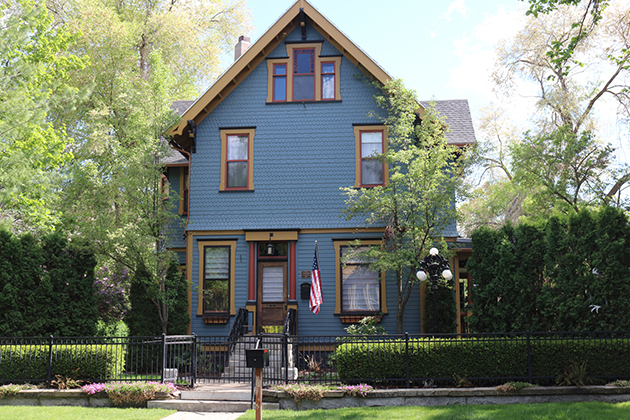
PhotoTitle: The John and Louisa Hieber House
PhotoAttribution: Spokane City/County Historic Preservation Office
Listing Status: Spokane Register, National Register
URL: http://properties.historicspokane.org/property/?PropertyID=1825
Display Marker: large_yellow
Title: Hieber House
Description: Date Built: 1889
Architect:David B. Fotheringham Common Name: Henley-Hieber House, John & Louisa Hieber House
The Hieber House and carriage house, built in 1889, reflect an eclectic mix of influences from the Queen Anne, Swiss Chalet and Shingle architectural styles. The property was originally constructed for flagman and city stableman, John W. Glover, and his wife Maggie. In 1895 the house was sold to Emily and Daniel Henley, a prominent Spokane attorney. The home later gained significance through its long-standing association with noted Spokane brewmaster John G. F. Hieber. Founder of the Union Brewery & Malting Company, the Hieber Brewing & Malting Company and owner of numerous real estate holdings in Spokane, Hieber was praised for his excellent business capacity and enjoyed the good will and esteem of the entire community.
Location: 47.656176, -117.442171
Address: 2011 West 1st Avenue, Spokane WA 99201
PhotoURL:

PhotoTitle: The John and Louisa Hieber House
PhotoAttribution: Spokane City/County Historic Preservation Office
Listing Status: Spokane Register, National Register
URL: http://properties.historicspokane.org/property/?PropertyID=1825
Display Marker: large_yellow
ID: 142
Title: Hill Brothers Building
Description: Date Built: 1890
Architect: Unknown
Common Name: Hill Brothers Building
The Hill Brothers Building is one of the oldest brick commercial buildings in downtown Spokane, one of the first buildings to be built after the Great Fire of 1889. Located in the heart of the city's downtown business district, the Hill Brothers Building represents the transition from the rough-and-tumble early days of downtown Spokane to the city's more mature, more refined, post-fire downtown retail core. Formerly a frame building that housed a saloon and gaming hall, the Hill Brothers Building was rebuilt as a substantial brick structure and served as a retail establishment for over 100 years.
Location: 47.65829, -117.4205
Address: 518 West Riverside Avenue, Spokane WA 99201
PhotoURL: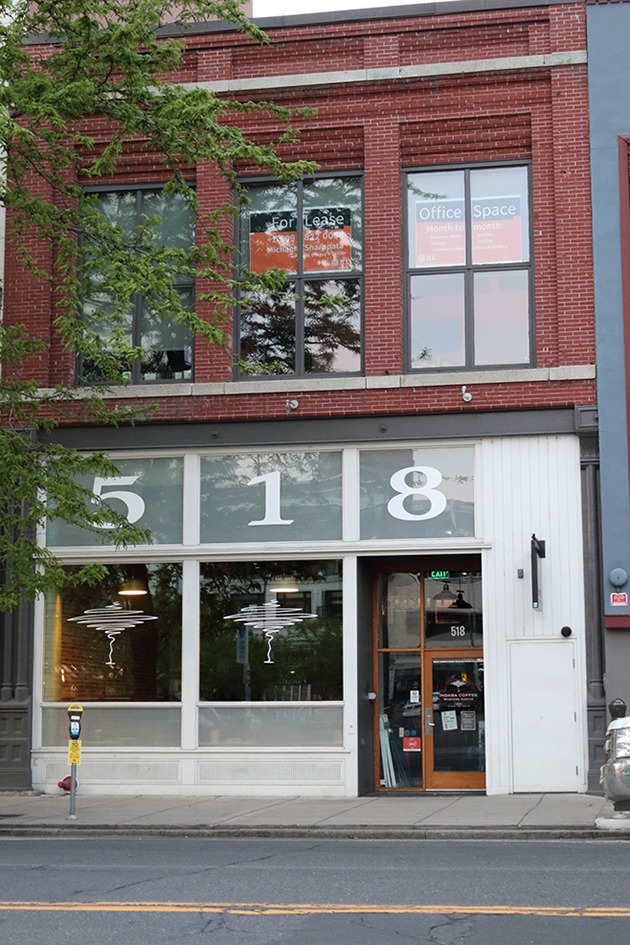
PhotoTitle: The Hill Brothers Building
PhotoAttribution: Spokane City/County Historic Preservation Office
Listing Status: Spokane Register
URL: http://properties.historicspokane.org/property/?PropertyID=1826
Display Marker: large_yellow
Title: Hill Brothers Building
Description: Date Built: 1890
Architect: Unknown
Common Name: Hill Brothers Building
The Hill Brothers Building is one of the oldest brick commercial buildings in downtown Spokane, one of the first buildings to be built after the Great Fire of 1889. Located in the heart of the city's downtown business district, the Hill Brothers Building represents the transition from the rough-and-tumble early days of downtown Spokane to the city's more mature, more refined, post-fire downtown retail core. Formerly a frame building that housed a saloon and gaming hall, the Hill Brothers Building was rebuilt as a substantial brick structure and served as a retail establishment for over 100 years.
Location: 47.65829, -117.4205
Address: 518 West Riverside Avenue, Spokane WA 99201
PhotoURL:

PhotoTitle: The Hill Brothers Building
PhotoAttribution: Spokane City/County Historic Preservation Office
Listing Status: Spokane Register
URL: http://properties.historicspokane.org/property/?PropertyID=1826
Display Marker: large_yellow
ID: 143
Title: Hill-Hilscher House
Description: Date Built: 1909
Architect: Unknown
Common Name: Hill-Hilscher House
The Hill-Hilscher House is an excellent rendition of the American Foursquare, single-family house type embellished in the Colonial Revival style, and was one of the first and finest homes built in the Cannon Hill Addition. The property was built for socially prominent Spokane residents, Lulu Cornelia and Charles W. Hill, pioneer, printer and president of C.W. Hill Printing Company. Charles and Lulu Hill later shared the property with their daughter and son-in-law who were residents of the house from 1920-1948.
Location: 47.63958, -117.43281
Address: 1636 South Cedar Street, Spokane WA 99203
PhotoURL: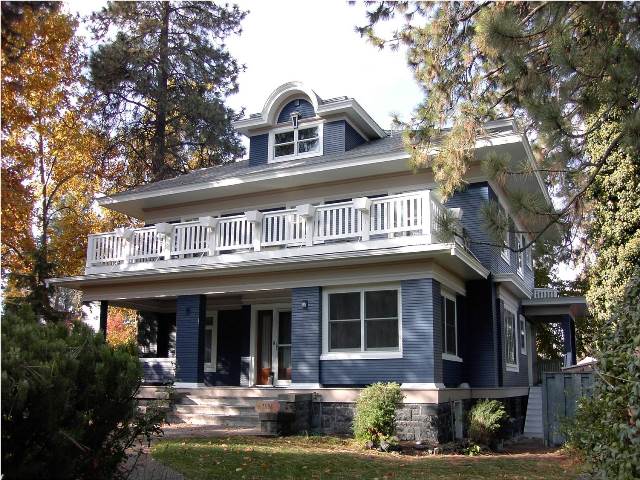
PhotoTitle: The Hill-Hilscher House
PhotoAttribution: Spokane City/County Historic Preservation Office
Listing Status: Spokane Register, National Register
URL: http://properties.historicspokane.org/property/?PropertyID=1827
Display Marker: large_yellow
Title: Hill-Hilscher House
Description: Date Built: 1909
Architect: Unknown
Common Name: Hill-Hilscher House
The Hill-Hilscher House is an excellent rendition of the American Foursquare, single-family house type embellished in the Colonial Revival style, and was one of the first and finest homes built in the Cannon Hill Addition. The property was built for socially prominent Spokane residents, Lulu Cornelia and Charles W. Hill, pioneer, printer and president of C.W. Hill Printing Company. Charles and Lulu Hill later shared the property with their daughter and son-in-law who were residents of the house from 1920-1948.
Location: 47.63958, -117.43281
Address: 1636 South Cedar Street, Spokane WA 99203
PhotoURL:

PhotoTitle: The Hill-Hilscher House
PhotoAttribution: Spokane City/County Historic Preservation Office
Listing Status: Spokane Register, National Register
URL: http://properties.historicspokane.org/property/?PropertyID=1827
Display Marker: large_yellow
ID: 144
Title: Hillyard High School
Description: Date Built: 1912
Architect: Westcott & Gifford
Common Name: Hillyard High School
The Hillyard High School property is the last surviving structure associated with Hillyard School District No. 122, which operated from 1907 until 1924. With the passing of other civic structures, this buidling is one of the last connections to the days when Hillyard governed its own affairs and funded its own undertakings. Aside from the Hillyard associations, the high school is strongly connected to the progress of high school education in the Spokane area in general and was the precursor of the current John R. Rogers High School. Following its deactivation, the property served as an apartment dwelling housing low income families, many of whom were returning to blue collar jobs after WWII.
Location: 47.70638, -117.36846
Address: 5313 North Regal Street, Spokane WA 99217
PhotoURL: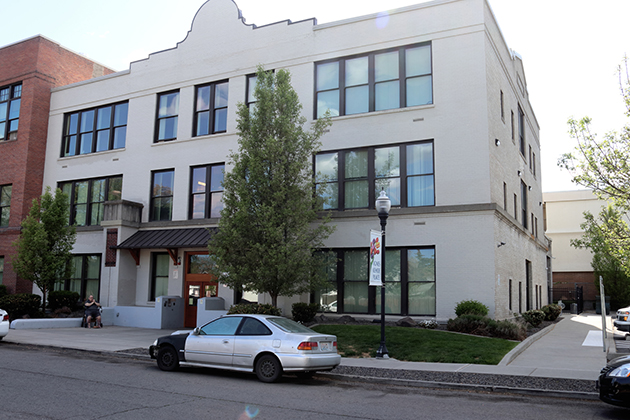
PhotoTitle: Hillyard High School
PhotoAttribution: Spokane City/County Historic Preservation Office
Listing Status: Spokane Register, National Register
URL: http://properties.historicspokane.org/property/?PropertyID=1828
Display Marker: large_yellow
Title: Hillyard High School
Description: Date Built: 1912
Architect: Westcott & Gifford
Common Name: Hillyard High School
The Hillyard High School property is the last surviving structure associated with Hillyard School District No. 122, which operated from 1907 until 1924. With the passing of other civic structures, this buidling is one of the last connections to the days when Hillyard governed its own affairs and funded its own undertakings. Aside from the Hillyard associations, the high school is strongly connected to the progress of high school education in the Spokane area in general and was the precursor of the current John R. Rogers High School. Following its deactivation, the property served as an apartment dwelling housing low income families, many of whom were returning to blue collar jobs after WWII.
Location: 47.70638, -117.36846
Address: 5313 North Regal Street, Spokane WA 99217
PhotoURL:

PhotoTitle: Hillyard High School
PhotoAttribution: Spokane City/County Historic Preservation Office
Listing Status: Spokane Register, National Register
URL: http://properties.historicspokane.org/property/?PropertyID=1828
Display Marker: large_yellow
ID: 145
Title: Hillyard Laundry Building
Description: Date Built: 1906
Architect: Charles Carr
Common Name: Hillyard Laundry Building
The Hillyard Laundry Building is a two-story formed concrete block structure with a plain parapet. A 1950 sign proclaiming "HILLYARD LAUNDRY & DRY CLEANING" is attached to the north facade above the front entrance. The building was originally owned and built in 1906 by Charles Carr, a blacksmith, who also built and owned the next building east, a blacksmith shop. The Hillyard Hand Laundry, owned and managed by Japanese immigrants Y. Tanaka, R. Nakashim, and H. Sato, operated in the building from 1906 to 1950. After 1950, the name of the business changed to Hillyard Laundry and Dry Cleaning.
Location: 47.70307, -117.36441
Address: 3108 East Olympic Avenue, Spokane WA 99217
PhotoURL:
PhotoTitle: Hillyard Laundry Building
PhotoAttribution: Spokane City/County Historic Preservation Office
Listing Status: Spokane Register, National Register
URL: http://properties.historicspokane.org/property/?PropertyID=1829
Display Marker: large_yellow
Title: Hillyard Laundry Building
Description: Date Built: 1906
Architect: Charles Carr
Common Name: Hillyard Laundry Building
The Hillyard Laundry Building is a two-story formed concrete block structure with a plain parapet. A 1950 sign proclaiming "HILLYARD LAUNDRY & DRY CLEANING" is attached to the north facade above the front entrance. The building was originally owned and built in 1906 by Charles Carr, a blacksmith, who also built and owned the next building east, a blacksmith shop. The Hillyard Hand Laundry, owned and managed by Japanese immigrants Y. Tanaka, R. Nakashim, and H. Sato, operated in the building from 1906 to 1950. After 1950, the name of the business changed to Hillyard Laundry and Dry Cleaning.
Location: 47.70307, -117.36441
Address: 3108 East Olympic Avenue, Spokane WA 99217
PhotoURL:

PhotoTitle: Hillyard Laundry Building
PhotoAttribution: Spokane City/County Historic Preservation Office
Listing Status: Spokane Register, National Register
URL: http://properties.historicspokane.org/property/?PropertyID=1829
Display Marker: large_yellow
ID: 146
Title: Hillyard Post Office
Description: Date Built: 1946
Architect: Unknown
Common Name: Hillyard Post Office
The Hillyard Post Office block is a modest, one-story structure clad in buff-colored brick veneer with a three-bay storefront, large windows and transoms, and an entrance at the westernmost end of the south facade. The Hillyard Post Office is one of the latest structures constructed in Hillyard during the District's period of significance from 1892-1946. Hillyard, which developed as a "railroad town," annexed to Spokane in 1924. Interestingly, letters postmarked as late as the 1980s continued to arrive at the post office with the town written as "Hillyard." The building served as a post office from 1946 through part of 2001.
Location: 47.70359, -117.36396
Address: 3117 East Olympic Avenue, Spokane WA 99217
PhotoURL: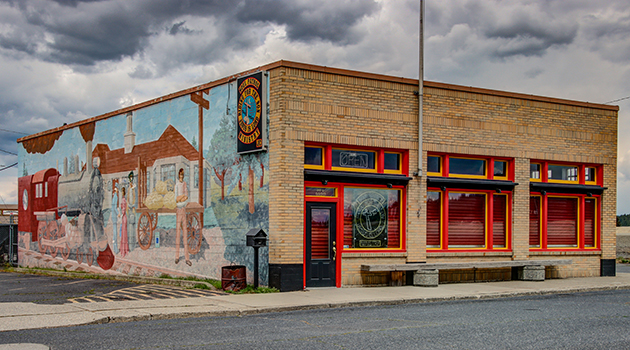
PhotoTitle: The Hillyard Post Office
PhotoAttribution: Spokane City/County Historic Preservation Office
Listing Status: Spokane Register, National Register
URL: http://properties.historicspokane.org/property/?PropertyID=1830
Display Marker: large_yellow
Title: Hillyard Post Office
Description: Date Built: 1946
Architect: Unknown
Common Name: Hillyard Post Office
The Hillyard Post Office block is a modest, one-story structure clad in buff-colored brick veneer with a three-bay storefront, large windows and transoms, and an entrance at the westernmost end of the south facade. The Hillyard Post Office is one of the latest structures constructed in Hillyard during the District's period of significance from 1892-1946. Hillyard, which developed as a "railroad town," annexed to Spokane in 1924. Interestingly, letters postmarked as late as the 1980s continued to arrive at the post office with the town written as "Hillyard." The building served as a post office from 1946 through part of 2001.
Location: 47.70359, -117.36396
Address: 3117 East Olympic Avenue, Spokane WA 99217
PhotoURL:

PhotoTitle: The Hillyard Post Office
PhotoAttribution: Spokane City/County Historic Preservation Office
Listing Status: Spokane Register, National Register
URL: http://properties.historicspokane.org/property/?PropertyID=1830
Display Marker: large_yellow
ID: 147
Title: Hillyard Water Company Building (demolished)
Description: Date Built: 1907
Architect: Hillyard Townsite Company
Common Name: Morgan Building
The small, one-story Hillyard Water Company Building (also called the Morgan Building until 1929) was made of formed concrete blocks and had a cast concrete cornice, smooth concrete quoins and an intact storefront configuration with a recessed entrance and original wood transoms. The building was constructed by the Hillyard Townsite Company for use as an office for the Hillyard Water Company. After 1930, the building housed Cambern Brothers Bakery, the Neighborhood Baker, and the Hillyard Dutch Shops, Bakers & Delicatessen. Cora Squibb's Black 7 Gold Dress Shop occupied the storefront from 1945 to 1965.
Location: 47.70456, -117.36448
Address: 5112 North Market Street, Spokane WA 99217
PhotoURL: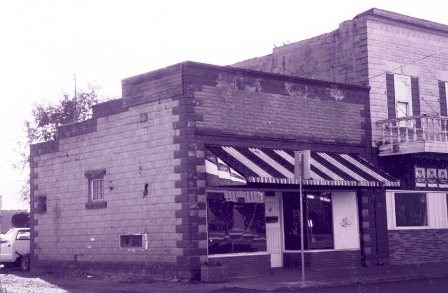
PhotoTitle: The once-standing Hillyard Water Company Building
PhotoAttribution: Spokane City/County Historic Preservation Office
Listing Status: Spokane Register, National Register
URL: http://properties.historicspokane.org/property/?PropertyID=1831
Display Marker: large_yellow
Title: Hillyard Water Company Building (demolished)
Description: Date Built: 1907
Architect: Hillyard Townsite Company
Common Name: Morgan Building
The small, one-story Hillyard Water Company Building (also called the Morgan Building until 1929) was made of formed concrete blocks and had a cast concrete cornice, smooth concrete quoins and an intact storefront configuration with a recessed entrance and original wood transoms. The building was constructed by the Hillyard Townsite Company for use as an office for the Hillyard Water Company. After 1930, the building housed Cambern Brothers Bakery, the Neighborhood Baker, and the Hillyard Dutch Shops, Bakers & Delicatessen. Cora Squibb's Black 7 Gold Dress Shop occupied the storefront from 1945 to 1965.
Location: 47.70456, -117.36448
Address: 5112 North Market Street, Spokane WA 99217
PhotoURL:

PhotoTitle: The once-standing Hillyard Water Company Building
PhotoAttribution: Spokane City/County Historic Preservation Office
Listing Status: Spokane Register, National Register
URL: http://properties.historicspokane.org/property/?PropertyID=1831
Display Marker: large_yellow
ID: 148
Title: Holley-Mason Building
Description: Date Built: 1905
Architect: Albert Held
Common Name: Holley-Mason Hardware Building
The Holley-Mason Building is a large, six-story commercial structure located in downtown Spokane. The building's internal structure is of reinforced concrete but the facades are finished with non-load bearing brick walls. The Howard Avenue elevation is beautifully executed with Renaissance-inspired brick and terra cotta details. The Holley-Mason Building is an important Spokane landmark significant for its architectural design and early use of reinforced concrete.
Location: 47.65525, -117.42059
Address: 157 South Howard Street, Spokane WA 99201
PhotoURL: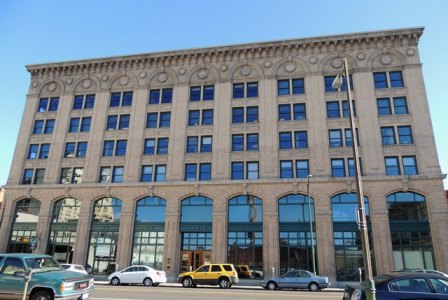
PhotoTitle: The Holley-Mason Building
PhotoAttribution: Spokane City/County Historic Preservation Office
Listing Status: Spokane Register, National Register
URL: http://properties.historicspokane.org/property/?PropertyID=1832
Display Marker: large_yellow
Title: Holley-Mason Building
Description: Date Built: 1905
Architect: Albert Held
Common Name: Holley-Mason Hardware Building
The Holley-Mason Building is a large, six-story commercial structure located in downtown Spokane. The building's internal structure is of reinforced concrete but the facades are finished with non-load bearing brick walls. The Howard Avenue elevation is beautifully executed with Renaissance-inspired brick and terra cotta details. The Holley-Mason Building is an important Spokane landmark significant for its architectural design and early use of reinforced concrete.
Location: 47.65525, -117.42059
Address: 157 South Howard Street, Spokane WA 99201
PhotoURL:

PhotoTitle: The Holley-Mason Building
PhotoAttribution: Spokane City/County Historic Preservation Office
Listing Status: Spokane Register, National Register
URL: http://properties.historicspokane.org/property/?PropertyID=1832
Display Marker: large_yellow
ID: 149
Title: Holmes Block
Description: Date Built: 1904
Architect: Isaac J. Galbraith
Common Name: Old Hill Apartments
The Holmes Block, Second Empire in character, is a distinctive landmark among the early commercial buildings still standing in this area off Monroe Street. Architecturally striking, the Holmes Block's facade features unique "porthole" windows and gargoyle waterspouts. Architect Isaac J. Galbraith designed this building for saloon keeper James C. Holmes, who used the main floor as a store until 1907, when he converted it to a saloon. It continued to serve in this capacity until Washington State passed a prohibition law in 1916. After that, the second and third stories were used as apartments.
Location: 47.66362, -117.42609
Address: 628 North Monroe Street, Spokane WA 99201
PhotoURL: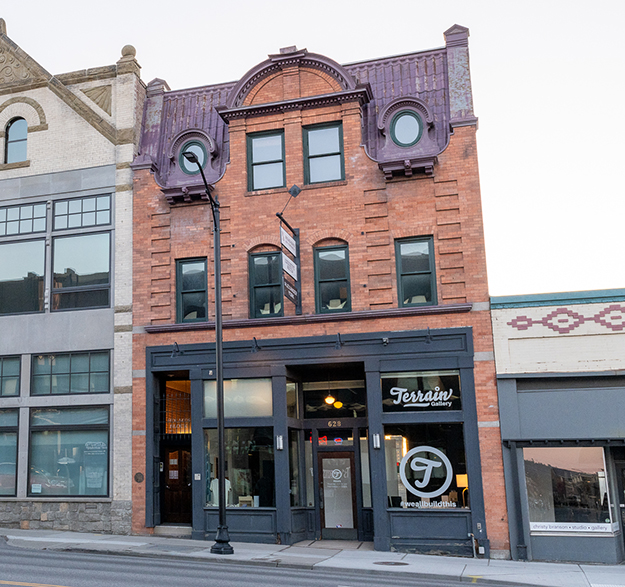
PhotoTitle: The Holmes Block
PhotoAttribution: Spokane City/County Historic Preservation Office
Listing Status: Spokane Register
URL: http://properties.historicspokane.org/property/?PropertyID=1833
Display Marker: large_yellow
Title: Holmes Block
Description: Date Built: 1904
Architect: Isaac J. Galbraith
Common Name: Old Hill Apartments
The Holmes Block, Second Empire in character, is a distinctive landmark among the early commercial buildings still standing in this area off Monroe Street. Architecturally striking, the Holmes Block's facade features unique "porthole" windows and gargoyle waterspouts. Architect Isaac J. Galbraith designed this building for saloon keeper James C. Holmes, who used the main floor as a store until 1907, when he converted it to a saloon. It continued to serve in this capacity until Washington State passed a prohibition law in 1916. After that, the second and third stories were used as apartments.
Location: 47.66362, -117.42609
Address: 628 North Monroe Street, Spokane WA 99201
PhotoURL:

PhotoTitle: The Holmes Block
PhotoAttribution: Spokane City/County Historic Preservation Office
Listing Status: Spokane Register
URL: http://properties.historicspokane.org/property/?PropertyID=1833
Display Marker: large_yellow
ID: 150
Title: Holy Names Academy
Description: Date Built: 1891
Architect: Patrick Donohoe (1891), Preusse & Zittel (1903)
Common Name: Academy Apartments
The Holy Names Academy Building is significant in the educational history of Spokane and the Inland Northwest. Chartered in 1891 as a private secondary academy and expanded in 1907, the Academy became one of the state's first private normal schools. The school offered both a high school curriculum and a teacher training course for young women from throughout the Inland Northwest for many decades. The building, an eclectic collection of nineteenth-century revivalistic architectural styles, is an important example of Victorian institutional architecture and reflects the designs of Spokane architects Patrick Donohoe and the well-known firm of Preusse and Zittel.The Holy Names Academy Building is significant in the educational history of Spokane and the Inland Northwest. Chartered in 1891 as a private secondary academy and expanded in 1907, the Academy became one of the state's first private normal schools. The school offered both a high school curriculum and a teacher training course for young women from throughout the Inland Northwest for many decades. The building, an eclectic collection of nineteenth-century revivalistic architectural styles, is an important example of Victorian institutional architecture and reflects the designs of Spokane architects Patrick Donohoe and the well-known firm of Preusse and Zittel.
Location: 47.66893, -117.39253
Address: 1216 North Superior Street, Spokane WA 99202
PhotoURL: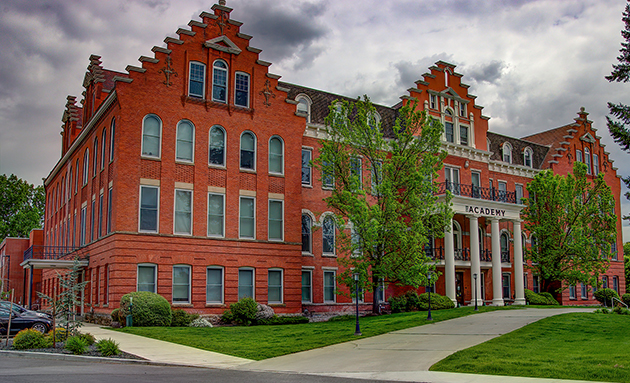
PhotoTitle: Holy Names Academy
PhotoAttribution: Spokane City/County Historic Preservation Office
Listing Status: Spokane Register, National Register
URL: http://properties.historicspokane.org/property/?PropertyID=1834
Display Marker: large_yellow
Title: Holy Names Academy
Description: Date Built: 1891
Architect: Patrick Donohoe (1891), Preusse & Zittel (1903)
Common Name: Academy Apartments
The Holy Names Academy Building is significant in the educational history of Spokane and the Inland Northwest. Chartered in 1891 as a private secondary academy and expanded in 1907, the Academy became one of the state's first private normal schools. The school offered both a high school curriculum and a teacher training course for young women from throughout the Inland Northwest for many decades. The building, an eclectic collection of nineteenth-century revivalistic architectural styles, is an important example of Victorian institutional architecture and reflects the designs of Spokane architects Patrick Donohoe and the well-known firm of Preusse and Zittel.The Holy Names Academy Building is significant in the educational history of Spokane and the Inland Northwest. Chartered in 1891 as a private secondary academy and expanded in 1907, the Academy became one of the state's first private normal schools. The school offered both a high school curriculum and a teacher training course for young women from throughout the Inland Northwest for many decades. The building, an eclectic collection of nineteenth-century revivalistic architectural styles, is an important example of Victorian institutional architecture and reflects the designs of Spokane architects Patrick Donohoe and the well-known firm of Preusse and Zittel.
Location: 47.66893, -117.39253
Address: 1216 North Superior Street, Spokane WA 99202
PhotoURL:

PhotoTitle: Holy Names Academy
PhotoAttribution: Spokane City/County Historic Preservation Office
Listing Status: Spokane Register, National Register
URL: http://properties.historicspokane.org/property/?PropertyID=1834
Display Marker: large_yellow
ID: 151
Title: Home Telephone & Telegraph Company Building
Description: Date Built: 1907
Architect:Albert Held/John Huetter Common Name: Home Telephone & Telegraph Company Building
The Home Telephone & Telegraph Company Building was built in 1907 as one the city's first telephone communication centers. During its period of significance from 1907 to 1955, the property achieved historic significance for its contribution to Spokane as one of the city's finest historic commercial/industrial buildings and as a leader in the development of the community's telephone communication industry. The property housed central operations for the Home Telephone & Telegraph Company, which implemented the first automatic dial telephone system in Spokane, the forerunner to contemporary rotary dial telephones. The company installed some of the first independent interstate long-distance service lines to regional customers in Washington, Idaho, Oregon, and Montana, and also developed a phone system that did not solely rely on batteries in personal hand-held telephones. The Home Telephone & Telegraph Company Building was designed by Albert Held, and built by John Huetter, early Spokane pioneers who are regarded as two of the region's most prominent master craftsmen.
Location: 47.6549, -117.42069
Address: 165 South Howard Street, Spokane WA 99201
PhotoURL: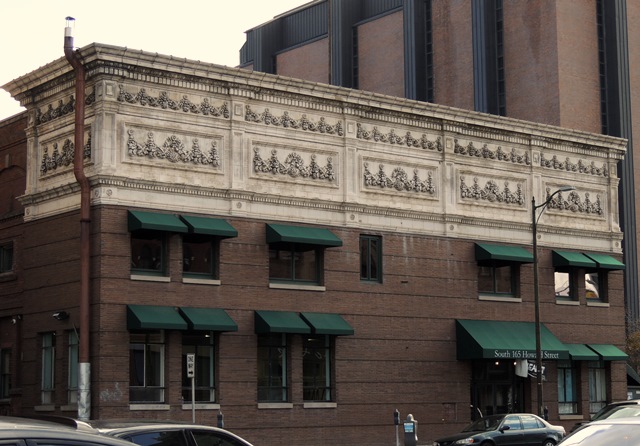
PhotoTitle: The altered west faŤade of the old Home Telephone & Telegraph Company Building
PhotoAttribution: Spokane City/County Historic Preservation Office
Listing Status: Spokane Register, National Register
URL: http://properties.historicspokane.org/property/?PropertyID=1835
Display Marker: large_yellow
Title: Home Telephone & Telegraph Company Building
Description: Date Built: 1907
Architect:Albert Held/John Huetter Common Name: Home Telephone & Telegraph Company Building
The Home Telephone & Telegraph Company Building was built in 1907 as one the city's first telephone communication centers. During its period of significance from 1907 to 1955, the property achieved historic significance for its contribution to Spokane as one of the city's finest historic commercial/industrial buildings and as a leader in the development of the community's telephone communication industry. The property housed central operations for the Home Telephone & Telegraph Company, which implemented the first automatic dial telephone system in Spokane, the forerunner to contemporary rotary dial telephones. The company installed some of the first independent interstate long-distance service lines to regional customers in Washington, Idaho, Oregon, and Montana, and also developed a phone system that did not solely rely on batteries in personal hand-held telephones. The Home Telephone & Telegraph Company Building was designed by Albert Held, and built by John Huetter, early Spokane pioneers who are regarded as two of the region's most prominent master craftsmen.
Location: 47.6549, -117.42069
Address: 165 South Howard Street, Spokane WA 99201
PhotoURL:

PhotoTitle: The altered west faŤade of the old Home Telephone & Telegraph Company Building
PhotoAttribution: Spokane City/County Historic Preservation Office
Listing Status: Spokane Register, National Register
URL: http://properties.historicspokane.org/property/?PropertyID=1835
Display Marker: large_yellow
ID: 152
Title: Hotel Upton
Description: Date Built: 1910
Architect: Loren L. Rand
Common Name: Hotel Grand Coulee, Grand Coulee Apartments
The Hotel Upton is historically significant as a Single Room Occupancy hotel (SRO) in Spokane's central business district. It was built in response to an unprecedented period of growth in Spokane's history between 1900 and 1910, when the city became the regional distribution hub of the Inland Empire. Like other SROs, which appeared on nearly every block of the central business district during the period, the Hotel Upton was built to accommodate the many itinerant laborers that flocked to Spokane to benefit from the expanding industries such as mining, agriculture, lumber and railroads. The Imperial Investment Co., headed by principle owner, manager, and secretary Andrew Laidlaw, a mining and real estate investor, contracted prominent Spokane architect Loren L. Rand to design the building. Some of Rand's other notable local works include the First Presbyterian Church, the Marble Bank (now demolished), numerous schools including Lewis and Clark High School, and the Riverside and Main additions to the Crescent Building. The Grand Coulee, as the building is now known, retains the functional integrity of a typical SRO, with the ground floor given over to commercial space and housing on the upper floors. It is the western terminus of the West Downtown Spokane Historic Transportation Corridor, a National Register Historic District.
Location: 47.65626, -117.43285
Address: 106 South Cedar Street, Spokane WA 99201
PhotoURL: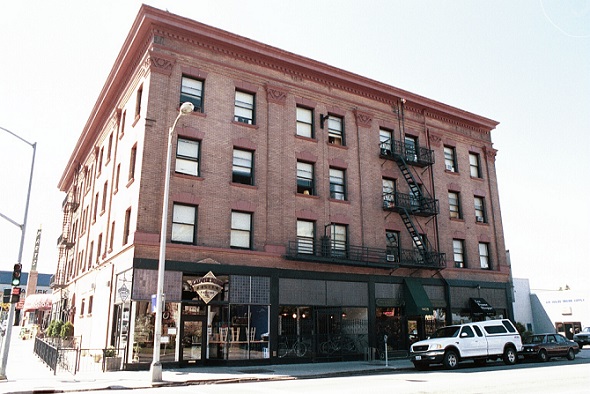
PhotoTitle: Hotel Upton
PhotoAttribution: Spokane City/County Historic Preservation Office
Listing Status: Spokane Register, National Register
URL: http://properties.historicspokane.org/property/?PropertyID=1836
Display Marker: large_yellow
Title: Hotel Upton
Description: Date Built: 1910
Architect: Loren L. Rand
Common Name: Hotel Grand Coulee, Grand Coulee Apartments
The Hotel Upton is historically significant as a Single Room Occupancy hotel (SRO) in Spokane's central business district. It was built in response to an unprecedented period of growth in Spokane's history between 1900 and 1910, when the city became the regional distribution hub of the Inland Empire. Like other SROs, which appeared on nearly every block of the central business district during the period, the Hotel Upton was built to accommodate the many itinerant laborers that flocked to Spokane to benefit from the expanding industries such as mining, agriculture, lumber and railroads. The Imperial Investment Co., headed by principle owner, manager, and secretary Andrew Laidlaw, a mining and real estate investor, contracted prominent Spokane architect Loren L. Rand to design the building. Some of Rand's other notable local works include the First Presbyterian Church, the Marble Bank (now demolished), numerous schools including Lewis and Clark High School, and the Riverside and Main additions to the Crescent Building. The Grand Coulee, as the building is now known, retains the functional integrity of a typical SRO, with the ground floor given over to commercial space and housing on the upper floors. It is the western terminus of the West Downtown Spokane Historic Transportation Corridor, a National Register Historic District.
Location: 47.65626, -117.43285
Address: 106 South Cedar Street, Spokane WA 99201
PhotoURL:

PhotoTitle: Hotel Upton
PhotoAttribution: Spokane City/County Historic Preservation Office
Listing Status: Spokane Register, National Register
URL: http://properties.historicspokane.org/property/?PropertyID=1836
Display Marker: large_yellow
ID: 153
Title: Hoxsey Block
Description: Date Built: 1910
Architect: Art Bengel (1939)
Common Name: Hoxsey Block
Built in 1910 for Spokane physician, Thomas Hoxsey, and his wife, Leita Hoxsey, who owned the property for more than 54 years, the structure was originally two adjoining single-story brick masonry commercial buildings. During its period of significance, the Hoxsey Block contributed to the health, welfare, and social needs of the South Perry Street/Grant Park community as an important commercial hub, central gathering place, and neighborhood retail and educational anchor. The south bay of the 1910 building, and later the south bay of the adjoining 1939 building, served as the neighborhood's first and only community-based public branch library for a 65 years. The north bay of the 1910 building was the site of the Altamont Pharmacy, the neighborhood's first and only pharmacy; and the center bay was home to a kaleidoscope of grocery & meat markets, variety stores, and retail shops. The 1939 building, which is nearly identical in design to the 1910 building, was occupied by Pat Noel's multiple grocery businesses and Howard Aust's market meats for 21 consecutive years, and later by shops and stores.
Location: 47.64619, -117.39014
Address: 1002 South Perry Street, Spokane WA 99202
PhotoURL: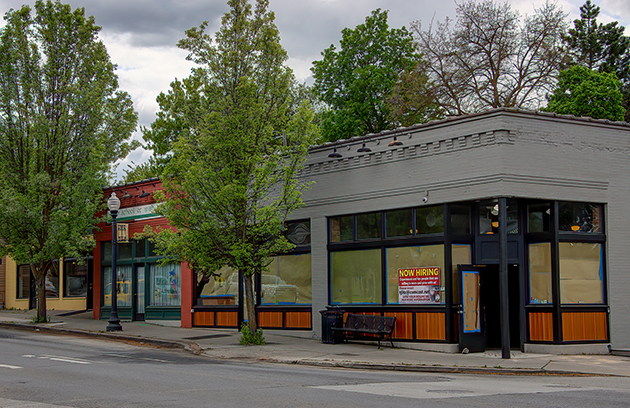
PhotoTitle: Hoxsey Block
PhotoAttribution: Spokane City/County Historic Preservation Office
Listing Status: Spokane Register
URL: http://properties.historicspokane.org/property/?PropertyID=1837
Display Marker: large_yellow
Title: Hoxsey Block
Description: Date Built: 1910
Architect: Art Bengel (1939)
Common Name: Hoxsey Block
Built in 1910 for Spokane physician, Thomas Hoxsey, and his wife, Leita Hoxsey, who owned the property for more than 54 years, the structure was originally two adjoining single-story brick masonry commercial buildings. During its period of significance, the Hoxsey Block contributed to the health, welfare, and social needs of the South Perry Street/Grant Park community as an important commercial hub, central gathering place, and neighborhood retail and educational anchor. The south bay of the 1910 building, and later the south bay of the adjoining 1939 building, served as the neighborhood's first and only community-based public branch library for a 65 years. The north bay of the 1910 building was the site of the Altamont Pharmacy, the neighborhood's first and only pharmacy; and the center bay was home to a kaleidoscope of grocery & meat markets, variety stores, and retail shops. The 1939 building, which is nearly identical in design to the 1910 building, was occupied by Pat Noel's multiple grocery businesses and Howard Aust's market meats for 21 consecutive years, and later by shops and stores.
Location: 47.64619, -117.39014
Address: 1002 South Perry Street, Spokane WA 99202
PhotoURL:

PhotoTitle: Hoxsey Block
PhotoAttribution: Spokane City/County Historic Preservation Office
Listing Status: Spokane Register
URL: http://properties.historicspokane.org/property/?PropertyID=1837
Display Marker: large_yellow
ID: 154
Title: Hussey House
Description: Date Built: 1905
Architect:John A. Creutzer Common Name: Charles and Susan Hussey House
Built in 1905 and 1917 respectively, the house and carriage house are excellent examples of the Arts & Crafts tradition expressed in the Craftsman style. The property's original design and architectural elements reflect a strong horizontal emphasis which is a prominent component of the Craftsman-style. Horizontal feathers of the property include jerkinhead gables, widely overhanging eaves, exposed rafter tails, wide bargeboards with pointed cutout tails, decorative brackets, battered double coursed shingles in combination with narrow-width clapboard siding, a covered front porch, and wide horizontal bands that separate the spaces between the basement, first floor, second floor, and gable peaks.
Location: 47.64473, -117.4307
Address: 1125 South Adams Street, Spokane WA 99204
PhotoURL: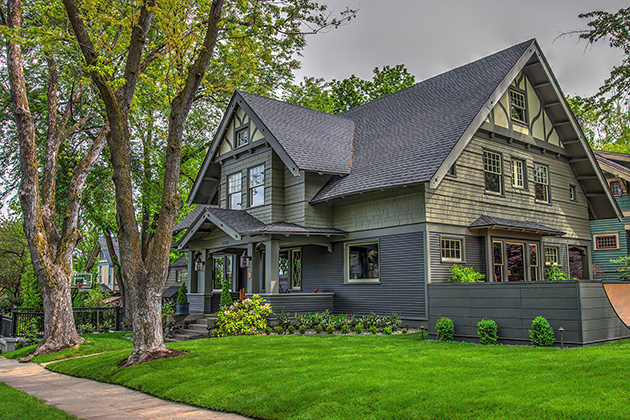
PhotoTitle: The Charles and Susan Hussey House
PhotoAttribution: Spokane City/County Historic Preservation Office
Listing Status: Spokane Register
URL: http://properties.historicspokane.org/property/?PropertyID=1838
Display Marker: large_yellow
Title: Hussey House
Description: Date Built: 1905
Architect:John A. Creutzer Common Name: Charles and Susan Hussey House
Built in 1905 and 1917 respectively, the house and carriage house are excellent examples of the Arts & Crafts tradition expressed in the Craftsman style. The property's original design and architectural elements reflect a strong horizontal emphasis which is a prominent component of the Craftsman-style. Horizontal feathers of the property include jerkinhead gables, widely overhanging eaves, exposed rafter tails, wide bargeboards with pointed cutout tails, decorative brackets, battered double coursed shingles in combination with narrow-width clapboard siding, a covered front porch, and wide horizontal bands that separate the spaces between the basement, first floor, second floor, and gable peaks.
Location: 47.64473, -117.4307
Address: 1125 South Adams Street, Spokane WA 99204
PhotoURL:

PhotoTitle: The Charles and Susan Hussey House
PhotoAttribution: Spokane City/County Historic Preservation Office
Listing Status: Spokane Register
URL: http://properties.historicspokane.org/property/?PropertyID=1838
Display Marker: large_yellow
ID: 155
Title: Hussey-Borgeson House
Description: Date Built: 1887
Architect: Loren L. Rand (carriage house)
Common Name: Hussey-Borgeson House
Built in 1887 and 1889, the Hussey-Borgeson House and its barn/stable/carriage house are two of the oldest and most intact domestic buildings in Spokane and are excellent examples of the Queen Anne Style. The carriage house and 1889 additions were designed by prominent Spokane architect Loren L. Rand; the architect of the original house is unknown. The house was built for mining and banking entrepreneur Warren Hussey and his wife Libby Shaw Hussey. It was later home to the Claus Borgeson family for over 80 years. The house is a contributing property in the Browne's Addition National Historic District but is historically and architecturally significant in its own right for its association with the early settlement and development of Spokane and as a superior example of the Queen Anne style of architecture.
Location: 47.65694, -117.44204
Address: 2003 West Riverside Avenue, Spokane WA 99201
PhotoURL: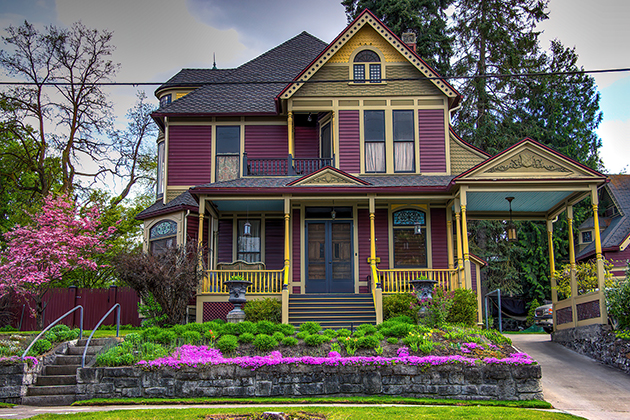
PhotoTitle: The Hussey-Borgeson House
PhotoAttribution: Spokane City/County Historic Preservation Office
Listing Status: Spokane Register, National Register
URL: http://properties.historicspokane.org/property/?PropertyID=1839
Display Marker: large_yellow
Title: Hussey-Borgeson House
Description: Date Built: 1887
Architect: Loren L. Rand (carriage house)
Common Name: Hussey-Borgeson House
Built in 1887 and 1889, the Hussey-Borgeson House and its barn/stable/carriage house are two of the oldest and most intact domestic buildings in Spokane and are excellent examples of the Queen Anne Style. The carriage house and 1889 additions were designed by prominent Spokane architect Loren L. Rand; the architect of the original house is unknown. The house was built for mining and banking entrepreneur Warren Hussey and his wife Libby Shaw Hussey. It was later home to the Claus Borgeson family for over 80 years. The house is a contributing property in the Browne's Addition National Historic District but is historically and architecturally significant in its own right for its association with the early settlement and development of Spokane and as a superior example of the Queen Anne style of architecture.
Location: 47.65694, -117.44204
Address: 2003 West Riverside Avenue, Spokane WA 99201
PhotoURL:

PhotoTitle: The Hussey-Borgeson House
PhotoAttribution: Spokane City/County Historic Preservation Office
Listing Status: Spokane Register, National Register
URL: http://properties.historicspokane.org/property/?PropertyID=1839
Display Marker: large_yellow
ID: 156
Title: Hutton Building
Description: Date Built: 1907
Architect: John K. Dow and Clarence Hubbell
Common Name: Hutton Building
Levi and May Arkwright Hutton built this building from wealth made in the Coeur d'Alene mining district. May Arkwright came to the Coeur d'Alene district in 1883 and opened a boarding house where she met her future husband, Levi Hutton, a railroad engineer. The Huttons were married in 1887 and continued to live and work in the mining area, where they became involved in the labor struggles. They invested in the Hercules Mine in 1887 and in 1901 the mine struck ore, making the Huttons one of the wealthiest families in the Inland Empire. In 1907 they built the Hutton Building and upon its completion, moved into its penthouse where they spent some of their most active years. The Huttons became the leading figures in the movement for political and labor reform.
Location: 47.6569, -117.41771
Address: 9 South Washington Street, Spokane WA 99201
PhotoURL: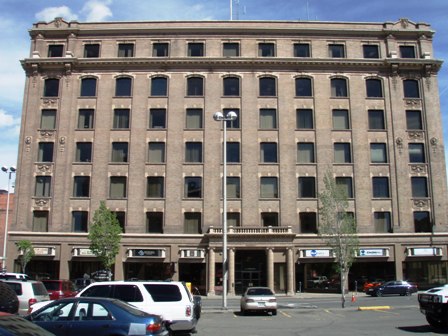
PhotoTitle: The Hutton Building
PhotoAttribution: Spokane City/County Historic Preservation Office
Listing Status: Spokane Register, National Register
URL: http://properties.historicspokane.org/property/?PropertyID=1840
Display Marker: large_yellow
Title: Hutton Building
Description: Date Built: 1907
Architect: John K. Dow and Clarence Hubbell
Common Name: Hutton Building
Levi and May Arkwright Hutton built this building from wealth made in the Coeur d'Alene mining district. May Arkwright came to the Coeur d'Alene district in 1883 and opened a boarding house where she met her future husband, Levi Hutton, a railroad engineer. The Huttons were married in 1887 and continued to live and work in the mining area, where they became involved in the labor struggles. They invested in the Hercules Mine in 1887 and in 1901 the mine struck ore, making the Huttons one of the wealthiest families in the Inland Empire. In 1907 they built the Hutton Building and upon its completion, moved into its penthouse where they spent some of their most active years. The Huttons became the leading figures in the movement for political and labor reform.
Location: 47.6569, -117.41771
Address: 9 South Washington Street, Spokane WA 99201
PhotoURL:

PhotoTitle: The Hutton Building
PhotoAttribution: Spokane City/County Historic Preservation Office
Listing Status: Spokane Register, National Register
URL: http://properties.historicspokane.org/property/?PropertyID=1840
Display Marker: large_yellow
ID: 157
Title: Hutton House
Description: Date Built: 1914
Architect: George H. Keith
Common Name: Hutton House
Built in 1914, the Hutton House is one of Spokane's finest examples of the Neoclassical architectural style. Designed by noted Spokane architect George W. Keith, the house was built for Levi and May Arkwright Hutton--two of Spokane's most significant humanitarians and civic benefactors. Their huge financial success from the Hercules Mine and committed passion to social reform had a significant impact on Spokane and the surrounding area. An ardent supporter of the women's suffrage movement, May Arkwright Hutton's strong words and hard work led to the right of all women to vote in Washington State. Levi Hutton fulfilled his life-long dream by building the Hutton Settlement, one of the country's best-designed and longest-running orphanages. It remains in operation today.
Location: 47.63943, -117.37885
Address: 2206 East 17th Avenue, Spokane WA 99203
PhotoURL: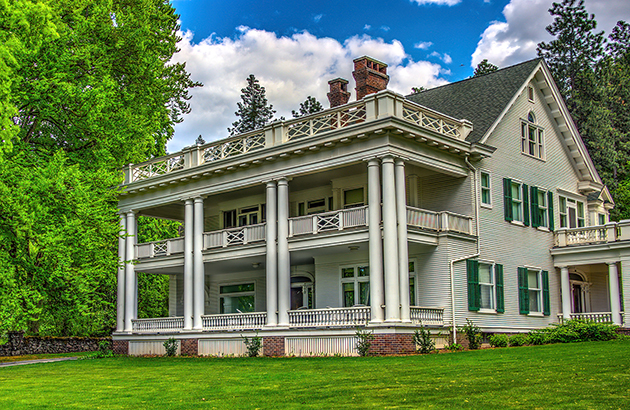
PhotoTitle: The Hutton House
PhotoAttribution: Spokane City/County Historic Preservation Office
Listing Status: Spokane Register, National Register
URL: http://properties.historicspokane.org/property/?PropertyID=1841
Display Marker: large_yellow
Title: Hutton House
Description: Date Built: 1914
Architect: George H. Keith
Common Name: Hutton House
Built in 1914, the Hutton House is one of Spokane's finest examples of the Neoclassical architectural style. Designed by noted Spokane architect George W. Keith, the house was built for Levi and May Arkwright Hutton--two of Spokane's most significant humanitarians and civic benefactors. Their huge financial success from the Hercules Mine and committed passion to social reform had a significant impact on Spokane and the surrounding area. An ardent supporter of the women's suffrage movement, May Arkwright Hutton's strong words and hard work led to the right of all women to vote in Washington State. Levi Hutton fulfilled his life-long dream by building the Hutton Settlement, one of the country's best-designed and longest-running orphanages. It remains in operation today.
Location: 47.63943, -117.37885
Address: 2206 East 17th Avenue, Spokane WA 99203
PhotoURL:

PhotoTitle: The Hutton House
PhotoAttribution: Spokane City/County Historic Preservation Office
Listing Status: Spokane Register, National Register
URL: http://properties.historicspokane.org/property/?PropertyID=1841
Display Marker: large_yellow
ID: 158
Title: Hyde Building and Annex (demolished)
Description: Date Built: 1890
Architect:William J. Carpenter & Albert Held Common Name: Hyde Building and Annex
The historic Hyde Building was demolished and removed from the National Register. The Hyde Building replaced an earlier three-story structure of the same name on this site, which was built for owner Eugene B. Hyde and consumed in the fire of 1889. Hyde, the city's first Marshall, Chief of Police and Chief of the Volunteer Fire Department, rebuilt his building in a more elaborate fashion using imported brick from St. Louis and brick from his own brick yard in Hangman Valley. Designed by Londoner William J. Carpenter, who also designed the Miller Building, Loewenberg House, and Couer d'Alene Hotel, the structure served as U.S. Court during the 1890s and featured two of Spokane's most popular bars at the time: the 'Court Saloon' and 'Court Annex'. In 1908 after much litigation, "Little Denver," the most expensive property per square foot, was purchased to the rear of the site so lavatories could be added at all levels. Architect Albert Held designed the addition which simply became known as the Annex. The Hyde was a seven story red brick structure with granite, sandstone and terra cotta detail. Sandstone spandrels with acanthus scroll design and a sixth floor arcade were arresting details. The roof line was dominated by a steeply pitched gable parapet. Rustication of brickwork was evident on the second floor and the name was inscribed in the gable parapet.
Location: 47.657851, -117.421805
Address: 611 West Riverside Avenue, Spokane WA 99201
PhotoURL: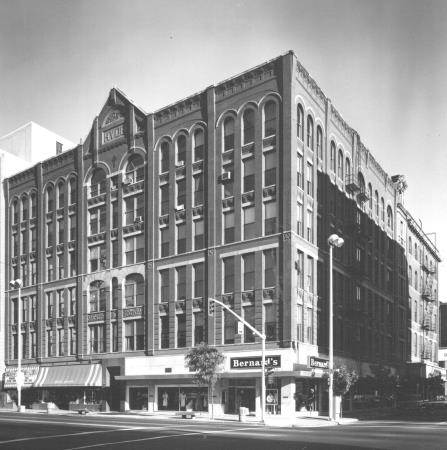
PhotoTitle: The once-standing Hyde Building and Annex at the intersection of Riverside and Wall
PhotoAttribution: Spokane City/County Historic Preservation Office
Listing Status: N/A
URL: http://properties.historicspokane.org/property/?PropertyID=2003
Display Marker: large_yellow
Title: Hyde Building and Annex (demolished)
Description: Date Built: 1890
Architect:William J. Carpenter & Albert Held Common Name: Hyde Building and Annex
The historic Hyde Building was demolished and removed from the National Register. The Hyde Building replaced an earlier three-story structure of the same name on this site, which was built for owner Eugene B. Hyde and consumed in the fire of 1889. Hyde, the city's first Marshall, Chief of Police and Chief of the Volunteer Fire Department, rebuilt his building in a more elaborate fashion using imported brick from St. Louis and brick from his own brick yard in Hangman Valley. Designed by Londoner William J. Carpenter, who also designed the Miller Building, Loewenberg House, and Couer d'Alene Hotel, the structure served as U.S. Court during the 1890s and featured two of Spokane's most popular bars at the time: the 'Court Saloon' and 'Court Annex'. In 1908 after much litigation, "Little Denver," the most expensive property per square foot, was purchased to the rear of the site so lavatories could be added at all levels. Architect Albert Held designed the addition which simply became known as the Annex. The Hyde was a seven story red brick structure with granite, sandstone and terra cotta detail. Sandstone spandrels with acanthus scroll design and a sixth floor arcade were arresting details. The roof line was dominated by a steeply pitched gable parapet. Rustication of brickwork was evident on the second floor and the name was inscribed in the gable parapet.
Location: 47.657851, -117.421805
Address: 611 West Riverside Avenue, Spokane WA 99201
PhotoURL:

PhotoTitle: The once-standing Hyde Building and Annex at the intersection of Riverside and Wall
PhotoAttribution: Spokane City/County Historic Preservation Office
Listing Status: N/A
URL: http://properties.historicspokane.org/property/?PropertyID=2003
Display Marker: large_yellow
ID: 159
Title: Indian Painted Rocks
Description: Date Built: 1750
Architect: Unknown
Common Name: Rock Paintings
Thought to be around 250 years old, the Indian Painted Rocks are incredibly well preserved pictographs. The paintings are made of pulverized red rock that was mixed with fish or animal oil. While the meaning of the Rock Paintings remains unclear, they are a physical reminder of the Spokane people's occupancy and use of the Inland Northwest long before the arrival of non-indigenous people to the area. The pictographs are located near the banks of the Little Spokane River in the Little Spokane River Natural Area, in close proximity to a large village site near the Little Spokane's confluence with the Spokane River.
Location: 47.782854, -117.496895
Address: 5694 West Rutter Parkway, Spokane WA 99208
PhotoURL:
PhotoTitle: Indian Painted Rocks
PhotoAttribution: Mike Prager of the Spokesman-Review
Listing Status: N/A
URL: http://properties.historicspokane.org/property/?PropertyID=2004
Display Marker: large_yellow
Title: Indian Painted Rocks
Description: Date Built: 1750
Architect: Unknown
Common Name: Rock Paintings
Thought to be around 250 years old, the Indian Painted Rocks are incredibly well preserved pictographs. The paintings are made of pulverized red rock that was mixed with fish or animal oil. While the meaning of the Rock Paintings remains unclear, they are a physical reminder of the Spokane people's occupancy and use of the Inland Northwest long before the arrival of non-indigenous people to the area. The pictographs are located near the banks of the Little Spokane River in the Little Spokane River Natural Area, in close proximity to a large village site near the Little Spokane's confluence with the Spokane River.
Location: 47.782854, -117.496895
Address: 5694 West Rutter Parkway, Spokane WA 99208
PhotoURL:

PhotoTitle: Indian Painted Rocks
PhotoAttribution: Mike Prager of the Spokesman-Review
Listing Status: N/A
URL: http://properties.historicspokane.org/property/?PropertyID=2004
Display Marker: large_yellow
ID: 160
Title: Inland Casket Company Factory
Description: Date Built: 1913
Architect: Ballard Plannery (1913) and G.A. Pehrson (1927)
Common Name: Inland Casket Company Factory
Built in two parts in 1913 and 1927, the Inland Casket Company Factory Building is historically significant as one of the longest-operating and the only surviving casket factory building in Spokane. Designed as a three-story brick masonry industrial block with symmetrical fenestration patters, the factory is a good example of vernacular commercial architecture. The Inland Casket Company was founded by Emil A. Skone and his two business partners, John Powers and Peter Sether, and manufactured hundreds of thousands of caskets for 65 years from 1913 to 1978 in Spokane. The company designed, built and finished ready-made and custom-designed caskets for funeral homes and cemeteries in Washington, Oregon, Idaho and Montana.
Location: 47.67892, -117.41228
Address: 2320 North Atlantic Street, Spokane WA 99205
PhotoURL: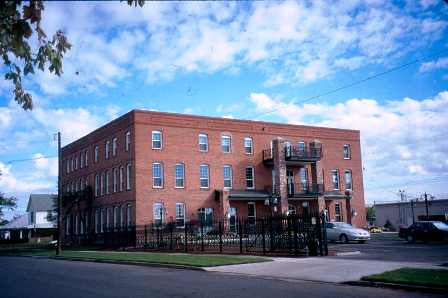
PhotoTitle: The Inland Casket Company Factory
PhotoAttribution: Spokane City/County Historic Preservation Office
Listing Status: Spokane Register
URL: http://properties.historicspokane.org/property/?PropertyID=1842
Display Marker: large_yellow
Title: Inland Casket Company Factory
Description: Date Built: 1913
Architect: Ballard Plannery (1913) and G.A. Pehrson (1927)
Common Name: Inland Casket Company Factory
Built in two parts in 1913 and 1927, the Inland Casket Company Factory Building is historically significant as one of the longest-operating and the only surviving casket factory building in Spokane. Designed as a three-story brick masonry industrial block with symmetrical fenestration patters, the factory is a good example of vernacular commercial architecture. The Inland Casket Company was founded by Emil A. Skone and his two business partners, John Powers and Peter Sether, and manufactured hundreds of thousands of caskets for 65 years from 1913 to 1978 in Spokane. The company designed, built and finished ready-made and custom-designed caskets for funeral homes and cemeteries in Washington, Oregon, Idaho and Montana.
Location: 47.67892, -117.41228
Address: 2320 North Atlantic Street, Spokane WA 99205
PhotoURL:

PhotoTitle: The Inland Casket Company Factory
PhotoAttribution: Spokane City/County Historic Preservation Office
Listing Status: Spokane Register
URL: http://properties.historicspokane.org/property/?PropertyID=1842
Display Marker: large_yellow
ID: 161
Title: Inland Empire News Building
Description: Date Built: 1903
Architect: Unknown
Common Name: Market Street Antiques
The Inland-Empire New Building is a two-story brick masonry building featuring a corbelled cornice and buff-colored brick facade veneer. It was built for furniture merchant John Stough whose business was active from 1903 until 1914. The building was occupied from 1914 to 1919 by furniture merchant Frank Murray. In 1919 the Inland Empire News, a local Hillyard newspaper, and later, the Northside Post, maintained a printing business in the building that ran through the 1950s.
Location: 47.70282, -117.36436
Address: 4912 North Market Street, Spokane WA 99217
PhotoURL: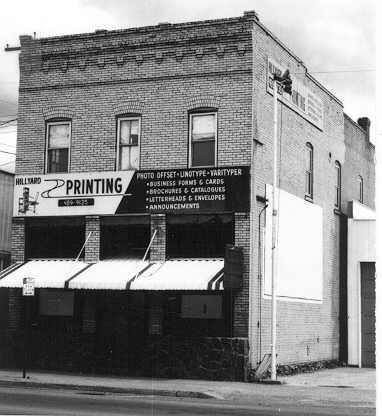
PhotoTitle: The Inland Empire News Building
PhotoAttribution: Spokane City/County Historic Preservation Office
Listing Status: Spokane Register, National Register
URL: http://properties.historicspokane.org/property/?PropertyID=1843
Display Marker: large_yellow
Title: Inland Empire News Building
Description: Date Built: 1903
Architect: Unknown
Common Name: Market Street Antiques
The Inland-Empire New Building is a two-story brick masonry building featuring a corbelled cornice and buff-colored brick facade veneer. It was built for furniture merchant John Stough whose business was active from 1903 until 1914. The building was occupied from 1914 to 1919 by furniture merchant Frank Murray. In 1919 the Inland Empire News, a local Hillyard newspaper, and later, the Northside Post, maintained a printing business in the building that ran through the 1950s.
Location: 47.70282, -117.36436
Address: 4912 North Market Street, Spokane WA 99217
PhotoURL:

PhotoTitle: The Inland Empire News Building
PhotoAttribution: Spokane City/County Historic Preservation Office
Listing Status: Spokane Register, National Register
URL: http://properties.historicspokane.org/property/?PropertyID=1843
Display Marker: large_yellow
ID: 162
Title: James and Elizabeth Comstock House
Description: Date Built: 1905
Architect:Loren L. Rand Common Name: James and Elizabeth Comstock House
The Comstock House is an excellent example of the Tudor Revival style, demonstrating defining features including a steeply pitched roof, three front-facing gables, tall narrow windows, and false half-timbering with stucco infill. Wide bridgeboards and decorative brackets articulate the eaves. A single-story porch projects from the center front of the house and features an open-gabled portico supported by paired square porch pillars anchored to black basalt porch piers. The portico's open gable is embellished with open truss work. Prominent Spokane Architect Loren Rand designed the home for James and Elizabeth Comstock, civic benefactors, pioneer merchants, and founders of the Crescent Department Store, the Spokane Dry Goods Company, and the Spokane Realty Company.
Location: 47.64756, -117.42914
Address: 1128 West 9th Avenue, Spokane WA 99204
PhotoURL: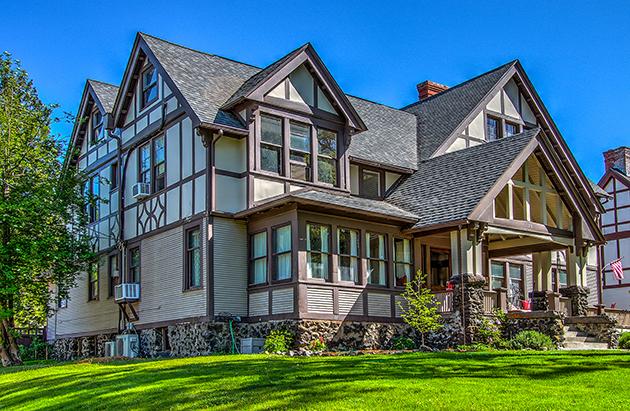
PhotoTitle: The James and Elizabeth Comstock House
PhotoAttribution: Spokane City/County Historic Preservation Office
Listing Status: Spokane Register, National Register
URL: http://properties.historicspokane.org/property/?PropertyID=1762
Display Marker: large_yellow
Title: James and Elizabeth Comstock House
Description: Date Built: 1905
Architect:Loren L. Rand Common Name: James and Elizabeth Comstock House
The Comstock House is an excellent example of the Tudor Revival style, demonstrating defining features including a steeply pitched roof, three front-facing gables, tall narrow windows, and false half-timbering with stucco infill. Wide bridgeboards and decorative brackets articulate the eaves. A single-story porch projects from the center front of the house and features an open-gabled portico supported by paired square porch pillars anchored to black basalt porch piers. The portico's open gable is embellished with open truss work. Prominent Spokane Architect Loren Rand designed the home for James and Elizabeth Comstock, civic benefactors, pioneer merchants, and founders of the Crescent Department Store, the Spokane Dry Goods Company, and the Spokane Realty Company.
Location: 47.64756, -117.42914
Address: 1128 West 9th Avenue, Spokane WA 99204
PhotoURL:

PhotoTitle: The James and Elizabeth Comstock House
PhotoAttribution: Spokane City/County Historic Preservation Office
Listing Status: Spokane Register, National Register
URL: http://properties.historicspokane.org/property/?PropertyID=1762
Display Marker: large_yellow
ID: 163
Title: James-Ammann House
Description: Date Built: 1906
Architect: Alfred Jones
Common Name: James-Ammann House
Constructed in 1906, the James-Ammann House was built for Thomas Francis James. At that time, James was a mining engineer for the Coeur d'Alene Mines and his life reflected the itinerant lifestyle of that profession. Born in 1859 in East Norwegian Township, Schuylkill County, Pennsylvania, James was the son of Welsh immigrants who were drawn to the anthracite coalfields opening in eastern Pennsylvania during the 1850s. In 1909, the house was purchased by Henry A. Ammann. The Ammanns were a pioneer family who arrived in Spokane in 1887. The James-Ammann house, being a contributing property in the Nettleton's Addition Historic District streetcar suburb from Spokane's most prolific period of growth and the remaining documented example of Alfred Jones Colonial Revival style, today proves itself to be a well-preserved example of both an overall pattern and a singular expression of that pattern.
Location: 47.66915, -117.45352
Address: 2828 West Sharp Avenue, Spokane WA 99201
PhotoURL: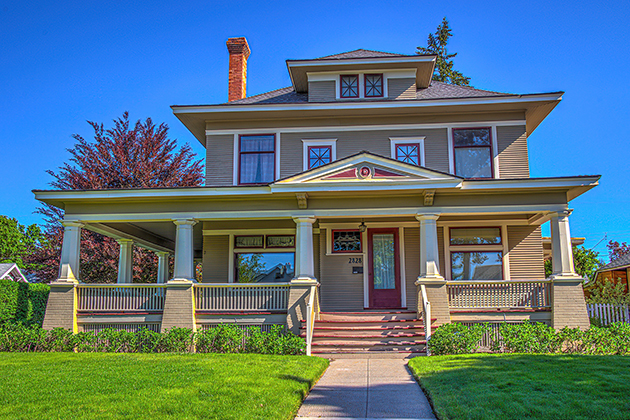
PhotoTitle: The James-Ammann House
PhotoAttribution: Spokane City/County Historic Preservation Office
Listing Status: Spokane Register, National Register
URL: http://properties.historicspokane.org/property/?PropertyID=1844
Display Marker: large_yellow
Title: James-Ammann House
Description: Date Built: 1906
Architect: Alfred Jones
Common Name: James-Ammann House
Constructed in 1906, the James-Ammann House was built for Thomas Francis James. At that time, James was a mining engineer for the Coeur d'Alene Mines and his life reflected the itinerant lifestyle of that profession. Born in 1859 in East Norwegian Township, Schuylkill County, Pennsylvania, James was the son of Welsh immigrants who were drawn to the anthracite coalfields opening in eastern Pennsylvania during the 1850s. In 1909, the house was purchased by Henry A. Ammann. The Ammanns were a pioneer family who arrived in Spokane in 1887. The James-Ammann house, being a contributing property in the Nettleton's Addition Historic District streetcar suburb from Spokane's most prolific period of growth and the remaining documented example of Alfred Jones Colonial Revival style, today proves itself to be a well-preserved example of both an overall pattern and a singular expression of that pattern.
Location: 47.66915, -117.45352
Address: 2828 West Sharp Avenue, Spokane WA 99201
PhotoURL:

PhotoTitle: The James-Ammann House
PhotoAttribution: Spokane City/County Historic Preservation Office
Listing Status: Spokane Register, National Register
URL: http://properties.historicspokane.org/property/?PropertyID=1844
Display Marker: large_yellow
ID: 165
Title: Jensen House
Description: Date Built: 1941
Architect: Whitehouse & Price
Common Name: Alvin and Mildred Jensen House
The Alvin Jensen House is significant for its association with Alvin Jensen, owner and operator of the Jensen-Byrd Company for over 70 years. The Jensen-Byrd Company is the longest operating wholesale hardware business in the Spokane region and it is the Pacific Northwest's largest hardware distributor. The house is also significant as the work of master architects, Harold Whitehouse and Ernest Price, who designed many of the region's best known structures including the Cathedral of St. John the Evangelist in Spokane. The Jensen House, built in 1941, is also a fine example of the Colonial Revival style of architecture.
Location: 47.64029, -117.39742
Address: 1609 South Crest Road, Spokane WA 99203
PhotoURL: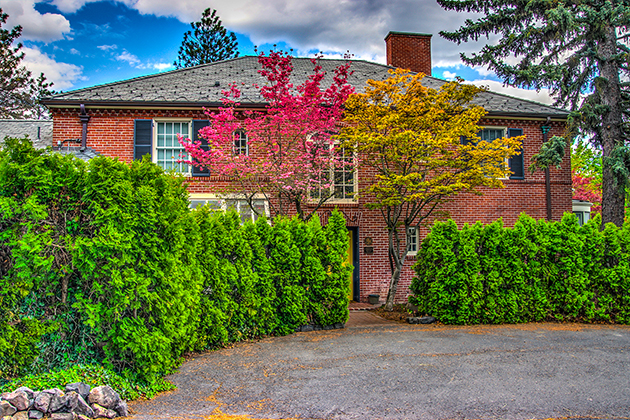
PhotoTitle: The Alvin and Mildred Jensen House
PhotoAttribution: Spokane City/County Historic Preservation Office
Listing Status: Spokane Register, National Register
URL: http://properties.historicspokane.org/property/?PropertyID=1846
Display Marker: large_yellow
Title: Jensen House
Description: Date Built: 1941
Architect: Whitehouse & Price
Common Name: Alvin and Mildred Jensen House
The Alvin Jensen House is significant for its association with Alvin Jensen, owner and operator of the Jensen-Byrd Company for over 70 years. The Jensen-Byrd Company is the longest operating wholesale hardware business in the Spokane region and it is the Pacific Northwest's largest hardware distributor. The house is also significant as the work of master architects, Harold Whitehouse and Ernest Price, who designed many of the region's best known structures including the Cathedral of St. John the Evangelist in Spokane. The Jensen House, built in 1941, is also a fine example of the Colonial Revival style of architecture.
Location: 47.64029, -117.39742
Address: 1609 South Crest Road, Spokane WA 99203
PhotoURL:

PhotoTitle: The Alvin and Mildred Jensen House
PhotoAttribution: Spokane City/County Historic Preservation Office
Listing Status: Spokane Register, National Register
URL: http://properties.historicspokane.org/property/?PropertyID=1846
Display Marker: large_yellow
ID: 166
Title: Joel E. Ferris, II House
Description: Date Built: 1955
Architect: Bruce Walker
Common Name: Ferris House
Designed in 1954 and completed in 1955, the Joel E. Ferris, ll House is an excellent example of mid-century modern and is the finest example of residential architecture by Bruce Walker. Its post and beam aesthetic reflects not only the Harvard Graduate School of Design (and one of its notable professors Marcel Breuer) where Walker was educated but the influence of Southern California architects as well. The landscape is the work of Lawrence Halprin, America's most significant landscape architect of the modern era. Among other prominent features by Halprin is the rock garden between the carport and house. The residence and grounds were built for Mary Jean and Joel Ferris, important fixtures in Spokane's local modern design movement. They increased awareness and appreciation for modern design in Spokane through the furniture and gift store, Joel, Inc., which they opened in 1950 in the Boothe-McClintock Building.
Location: 47.6417, -117.40351
Address: 431 East 16th Avenue, Spokane WA 99203
PhotoURL: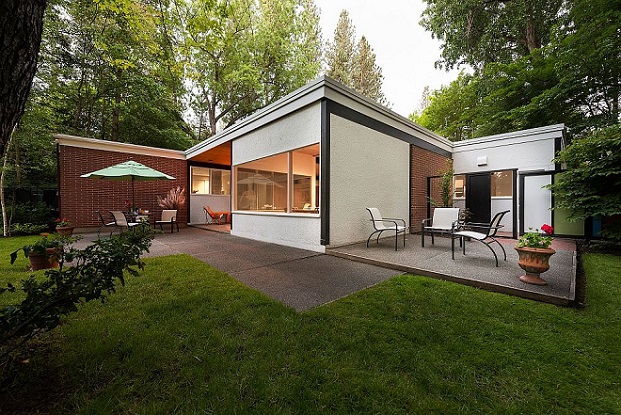
PhotoTitle: The Joel E. Ferris, II House
PhotoAttribution: Spokane City/County Historic Preservation Office
Listing Status: Spokane Register
URL: http://properties.historicspokane.org/property/?PropertyID=2052
Display Marker: large_yellow
Title: Joel E. Ferris, II House
Description: Date Built: 1955
Architect: Bruce Walker
Common Name: Ferris House
Designed in 1954 and completed in 1955, the Joel E. Ferris, ll House is an excellent example of mid-century modern and is the finest example of residential architecture by Bruce Walker. Its post and beam aesthetic reflects not only the Harvard Graduate School of Design (and one of its notable professors Marcel Breuer) where Walker was educated but the influence of Southern California architects as well. The landscape is the work of Lawrence Halprin, America's most significant landscape architect of the modern era. Among other prominent features by Halprin is the rock garden between the carport and house. The residence and grounds were built for Mary Jean and Joel Ferris, important fixtures in Spokane's local modern design movement. They increased awareness and appreciation for modern design in Spokane through the furniture and gift store, Joel, Inc., which they opened in 1950 in the Boothe-McClintock Building.
Location: 47.6417, -117.40351
Address: 431 East 16th Avenue, Spokane WA 99203
PhotoURL:

PhotoTitle: The Joel E. Ferris, II House
PhotoAttribution: Spokane City/County Historic Preservation Office
Listing Status: Spokane Register
URL: http://properties.historicspokane.org/property/?PropertyID=2052
Display Marker: large_yellow
ID: 167
Title: John A. Finch School
Description: Date Built: 1924
Architect: Julius Zittel, George Rasque/ F. E. Martin
Common Name: Finch Elementary School
The elegant John A. Finch School was designed by two of Spokane's most influential and prolific architects, Julius Zittel and George Rasque, both of whom achieved praise and admiration for their devotion to the design of educational institutions. Zittel's Neo-classical influence is seen in the elaborate central entry. Lovely cream-colored terra cotta scroll-work and columns frame the entrance; the words "Education is the Apprenticeship of Life" emblazoned above. The entrance is truly striking and the lavish use of expensive terra cotta construction materials is an indication of the School District's desire to create a lasting and monumental structure dedicated to the education of the City's northwest neighborhoods, comparable to those of the more pretentious south side. Although the final original structure was not fully completed until over twenty years after it was envisioned, the result is an outstanding example of early 20th century institutional architecture created by two of the area's most talented architects. Originally possessing a U-shaped plan, the school has since undergone intensive restoration and has expanded into an O-shaped plan while still maintaining the integrity and feeling of the original school building.
Location: 47.69183, -117.45309
Address: 3717 North Milton Street, Spokane WA 99205
PhotoURL: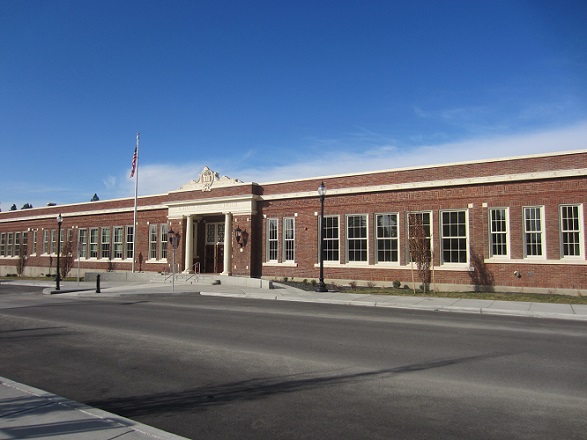
PhotoTitle: The John A. Finch School
PhotoAttribution: Spokane City/County Historic Preservation Office
Listing Status: National Register
URL: http://properties.historicspokane.org/property/?PropertyID=2082
Display Marker: large_yellow
Title: John A. Finch School
Description: Date Built: 1924
Architect: Julius Zittel, George Rasque/ F. E. Martin
Common Name: Finch Elementary School
The elegant John A. Finch School was designed by two of Spokane's most influential and prolific architects, Julius Zittel and George Rasque, both of whom achieved praise and admiration for their devotion to the design of educational institutions. Zittel's Neo-classical influence is seen in the elaborate central entry. Lovely cream-colored terra cotta scroll-work and columns frame the entrance; the words "Education is the Apprenticeship of Life" emblazoned above. The entrance is truly striking and the lavish use of expensive terra cotta construction materials is an indication of the School District's desire to create a lasting and monumental structure dedicated to the education of the City's northwest neighborhoods, comparable to those of the more pretentious south side. Although the final original structure was not fully completed until over twenty years after it was envisioned, the result is an outstanding example of early 20th century institutional architecture created by two of the area's most talented architects. Originally possessing a U-shaped plan, the school has since undergone intensive restoration and has expanded into an O-shaped plan while still maintaining the integrity and feeling of the original school building.
Location: 47.69183, -117.45309
Address: 3717 North Milton Street, Spokane WA 99205
PhotoURL:

PhotoTitle: The John A. Finch School
PhotoAttribution: Spokane City/County Historic Preservation Office
Listing Status: National Register
URL: http://properties.historicspokane.org/property/?PropertyID=2082
Display Marker: large_yellow
ID: 168
Title: Jones House
Description: Date Built: 1909
Architect: Alfred Jones (architect and builder)
Common Name: Alfred Jones House
Prominent Spokane architect, builder and entrepreneur, Alfred Jones, designed and built this eclectic home in 1909. A Spokesman-Review article deemed it "English" in style, but it exhibits elements of Craftsman and Victorian Stick styles as well. In addition to its architectural significance, the home is also historically significant for its association with Jones and its later association with Augustin Francis Schinner, the first Catholic Bishop of Spokane. Jones designed a number of prominent buildings in Spokane, sometimes in partnership with other prominent architects like Permain, Galbraith and Levesque. He was also an investor in several theaters in town, including the Scenic (later Scenic Vodvil), Washington (later Empress), and The Arcade. Jones scarcely had the chance to enjoy the home he designed; he relocated to Arizona due to ill health in 1911. In 1919 the Roman Catholic Church purchased the home for Schinner. The property continued to serve the church until 1968, providing a residence for three bishops. Consequently, it became a religious center for Spokane's rapidly increasing Catholic population.
Location: 47.64351, -117.4069
Address: 238 East 13th Avenue, Spokane WA 99202
PhotoURL: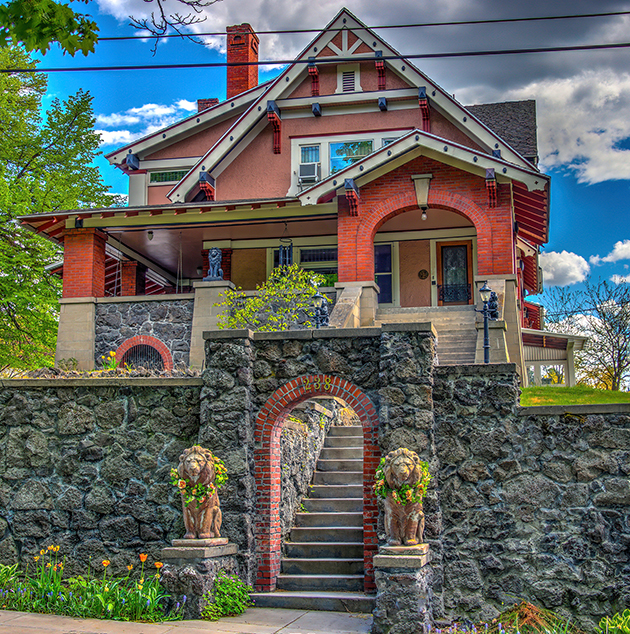
PhotoTitle: The Alfred Jones House
PhotoAttribution: Spokane City/County Historic Preservation Office
Listing Status: Spokane Register
URL: http://properties.historicspokane.org/property/?PropertyID=1847
Display Marker: large_yellow
Title: Jones House
Description: Date Built: 1909
Architect: Alfred Jones (architect and builder)
Common Name: Alfred Jones House
Prominent Spokane architect, builder and entrepreneur, Alfred Jones, designed and built this eclectic home in 1909. A Spokesman-Review article deemed it "English" in style, but it exhibits elements of Craftsman and Victorian Stick styles as well. In addition to its architectural significance, the home is also historically significant for its association with Jones and its later association with Augustin Francis Schinner, the first Catholic Bishop of Spokane. Jones designed a number of prominent buildings in Spokane, sometimes in partnership with other prominent architects like Permain, Galbraith and Levesque. He was also an investor in several theaters in town, including the Scenic (later Scenic Vodvil), Washington (later Empress), and The Arcade. Jones scarcely had the chance to enjoy the home he designed; he relocated to Arizona due to ill health in 1911. In 1919 the Roman Catholic Church purchased the home for Schinner. The property continued to serve the church until 1968, providing a residence for three bishops. Consequently, it became a religious center for Spokane's rapidly increasing Catholic population.
Location: 47.64351, -117.4069
Address: 238 East 13th Avenue, Spokane WA 99202
PhotoURL:

PhotoTitle: The Alfred Jones House
PhotoAttribution: Spokane City/County Historic Preservation Office
Listing Status: Spokane Register
URL: http://properties.historicspokane.org/property/?PropertyID=1847
Display Marker: large_yellow
ID: 169
Title: Kehoe Block
Description: Date Built: 1907
Architect: Hillyard Townsite Company
Common Name: Kehoe Block
The Kehoe Block is a two-story brick masonry building that features a cast concrete with an egg-and-dart and antler motif and a center diamond-shaped parapet with the word "KEHOE" in relief. Built for Thomas Kehoe, the building was originally constructed as the Kehoe Hotel, a singe-room occupancy hotel with 18 rooms on the second story. The first floor was occupied by a variety of businesses from 1907 to 1952, including the Kehoe Saloon, LeRoi Grocery, Buckley Hardware and Kehoe Hardware.
Location: 47.70348, -117.36448
Address: 5002 North Market Street, Spokane WA 99217
PhotoURL: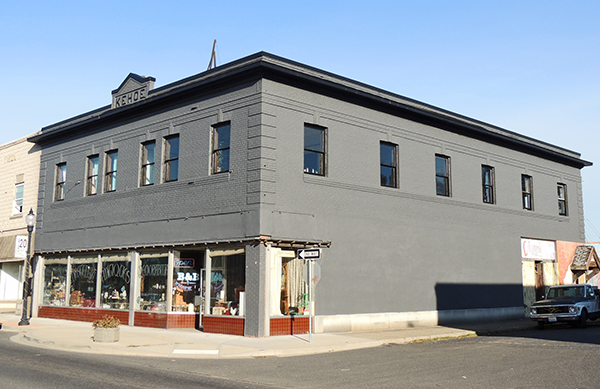
PhotoTitle: The Kehoe Block
PhotoAttribution: Spokane City/County Historic Preservation Office
Listing Status: Spokane Register, National Register
URL: http://properties.historicspokane.org/property/?PropertyID=1848
Display Marker: large_yellow
Title: Kehoe Block
Description: Date Built: 1907
Architect: Hillyard Townsite Company
Common Name: Kehoe Block
The Kehoe Block is a two-story brick masonry building that features a cast concrete with an egg-and-dart and antler motif and a center diamond-shaped parapet with the word "KEHOE" in relief. Built for Thomas Kehoe, the building was originally constructed as the Kehoe Hotel, a singe-room occupancy hotel with 18 rooms on the second story. The first floor was occupied by a variety of businesses from 1907 to 1952, including the Kehoe Saloon, LeRoi Grocery, Buckley Hardware and Kehoe Hardware.
Location: 47.70348, -117.36448
Address: 5002 North Market Street, Spokane WA 99217
PhotoURL:

PhotoTitle: The Kehoe Block
PhotoAttribution: Spokane City/County Historic Preservation Office
Listing Status: Spokane Register, National Register
URL: http://properties.historicspokane.org/property/?PropertyID=1848
Display Marker: large_yellow
ID: 170
Title: Kellners' Flats
Description: Date Built: 1903
Architect: Unknown
Common Name: Joseph and Bertha Kellner House
This apartment building was built in 1903 as a four-plex for Joseph and Bertha Kellner and their son Sidney, a salesman for M. Seller and Company (importers of wholesale and retail crockery, glassware, cutlery, willowware, stoves, and ranges). Joseph Kellner was a pioneer businessman and merchant who arrived in Spokane before the Great Fire of 1889. He operated a dry goods store downtown, developed real estate interests in Browne's Addition, and was involved in the establishment of Spokane's first Jewish temple. Other prominent Spokane figures, E. L. Richey, and later, William M. Day, were successive owners of the building. Kellner lived in the building for only two years before returning to his earlier home down the street. He later built and lived in the Marlboro Apartments. In 1943, the Kellner House was altered to accommodate apartments. A $13,600 war time housing lease was awarded by the United States Federal Government for the construction work, which was completed by Central Construction Company of Spokane. The building continues to serve as an apartment building today. In addition to its association with Kellner and other prominent figures from the city's early history, it is also architecturally significant as an example of the Colonial Revival style, and historically significant as an early indicator of the trend toward multiple family living units that characterized the development of Browne's Addition after 1905.
Location: 47.65514, -117.43638
Address: 1617 West Pacific Avenue, Spokane WA 99201
PhotoURL: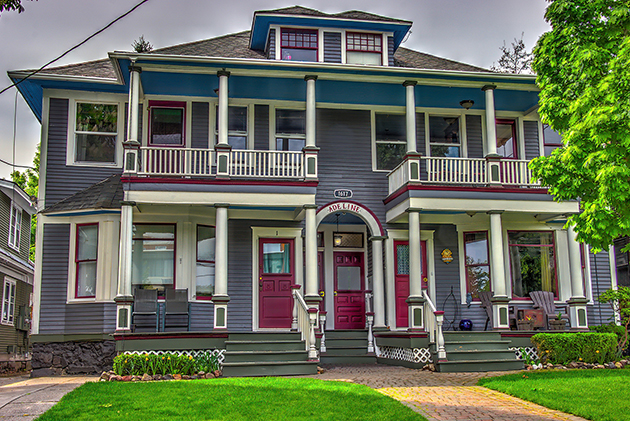
PhotoTitle: Kellner's Flats
PhotoAttribution: Spokane City/County Historic Preservation Office
Listing Status: Spokane Register, National Register
URL: http://properties.historicspokane.org/property/?PropertyID=1849
Display Marker: large_yellow
Title: Kellners' Flats
Description: Date Built: 1903
Architect: Unknown
Common Name: Joseph and Bertha Kellner House
This apartment building was built in 1903 as a four-plex for Joseph and Bertha Kellner and their son Sidney, a salesman for M. Seller and Company (importers of wholesale and retail crockery, glassware, cutlery, willowware, stoves, and ranges). Joseph Kellner was a pioneer businessman and merchant who arrived in Spokane before the Great Fire of 1889. He operated a dry goods store downtown, developed real estate interests in Browne's Addition, and was involved in the establishment of Spokane's first Jewish temple. Other prominent Spokane figures, E. L. Richey, and later, William M. Day, were successive owners of the building. Kellner lived in the building for only two years before returning to his earlier home down the street. He later built and lived in the Marlboro Apartments. In 1943, the Kellner House was altered to accommodate apartments. A $13,600 war time housing lease was awarded by the United States Federal Government for the construction work, which was completed by Central Construction Company of Spokane. The building continues to serve as an apartment building today. In addition to its association with Kellner and other prominent figures from the city's early history, it is also architecturally significant as an example of the Colonial Revival style, and historically significant as an early indicator of the trend toward multiple family living units that characterized the development of Browne's Addition after 1905.
Location: 47.65514, -117.43638
Address: 1617 West Pacific Avenue, Spokane WA 99201
PhotoURL:

PhotoTitle: Kellner's Flats
PhotoAttribution: Spokane City/County Historic Preservation Office
Listing Status: Spokane Register, National Register
URL: http://properties.historicspokane.org/property/?PropertyID=1849
Display Marker: large_yellow
ID: 171
Title: Kemp & Herbert Building
Description: Date Built: 1908
Architect: Alfred Jones
Common Name: Auntie's Bookstore, The Liberty Building
Significant architecturally as a fine example of commercial architecture in the Chicago School style, the Kemp and Hebert Building is also historically significant for its association with Charles Kemp, Henry Hebert and architect Alfred Jones. Kemp and Hebert established the Wholesale Dry Goods Company in 1892 and formed the Kemp-Hebert Corp. in 1908 in conjunction with the opening of their new four-story building at Main and Washington. The company continued to grow and expand through the 1920s. The building stood vacant in the early 1940s after the death of surviving partner Kemp in 1940. Liberty Furniture moved in during 1944, remaining until 1987. After another period of vacancy the building was renovated by Auntie's Bookstore, the current occupant.
Location: 47.6594, -117.41842
Address: 404 West Main Avenue, Spokane WA 99201
PhotoURL: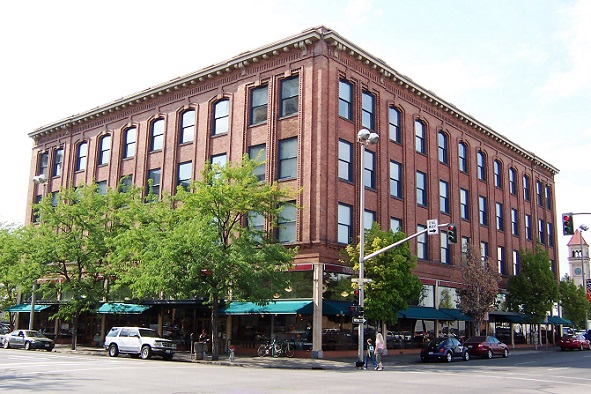
PhotoTitle: The Kemp & Herbert Building
PhotoAttribution: Spokane City/County Historic Preservation Office
Listing Status: Spokane Register, National Register
URL: http://properties.historicspokane.org/property/?PropertyID=2005
Display Marker: large_yellow
Title: Kemp & Herbert Building
Description: Date Built: 1908
Architect: Alfred Jones
Common Name: Auntie's Bookstore, The Liberty Building
Significant architecturally as a fine example of commercial architecture in the Chicago School style, the Kemp and Hebert Building is also historically significant for its association with Charles Kemp, Henry Hebert and architect Alfred Jones. Kemp and Hebert established the Wholesale Dry Goods Company in 1892 and formed the Kemp-Hebert Corp. in 1908 in conjunction with the opening of their new four-story building at Main and Washington. The company continued to grow and expand through the 1920s. The building stood vacant in the early 1940s after the death of surviving partner Kemp in 1940. Liberty Furniture moved in during 1944, remaining until 1987. After another period of vacancy the building was renovated by Auntie's Bookstore, the current occupant.
Location: 47.6594, -117.41842
Address: 404 West Main Avenue, Spokane WA 99201
PhotoURL:

PhotoTitle: The Kemp & Herbert Building
PhotoAttribution: Spokane City/County Historic Preservation Office
Listing Status: Spokane Register, National Register
URL: http://properties.historicspokane.org/property/?PropertyID=2005
Display Marker: large_yellow
ID: 172
Title: Kempis Apartments
Description: Date Built: 1906
Architect:Alfred Jones (architect) and Christ Anderson (builder) Common Name: Kempis Apartments
The Kempis Apartments, one of the first luxury apartments erected in Spokane, was built in 1906 and has been continuously occupied for over 95 years. The Kempis was built to accommodate residents of more affluent means who sought permanent housing located away from the hustle and bustle of the city's center. The property was designed by Alfed Jones and built by contractor Chris Anderson for Maud L. Kemp, wife of Charles John Kemp, part owner of the Kemp & Hebert Department Store. The apartment's garage and auto court were designed in 1920 by G.A. Pehrson. In 1995, Michael and Sarah Michalko purchased the property and remodeled the building, garage and auto court for use as luxury apartments that were rented on a daily, weekly and monthly basis. An upscale eatery was also added. Today, the Kempis is reverted back to luxury apartments and is being operated under Kempis LLC.
Location: 47.65065, -117.41748
Address: 523 South Washington Street, Spokane WA 99204
PhotoURL: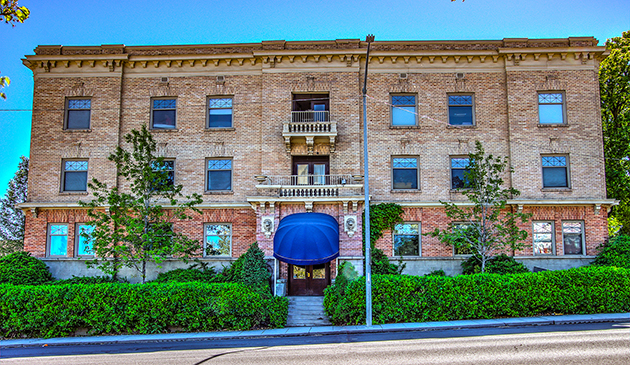
PhotoTitle: The Kempis Apartments
PhotoAttribution: Spokane City/County Historic Preservation Office
Listing Status: Spokane Register
URL: http://properties.historicspokane.org/property/?PropertyID=1850
Display Marker: large_yellow
Title: Kempis Apartments
Description: Date Built: 1906
Architect:Alfred Jones (architect) and Christ Anderson (builder) Common Name: Kempis Apartments
The Kempis Apartments, one of the first luxury apartments erected in Spokane, was built in 1906 and has been continuously occupied for over 95 years. The Kempis was built to accommodate residents of more affluent means who sought permanent housing located away from the hustle and bustle of the city's center. The property was designed by Alfed Jones and built by contractor Chris Anderson for Maud L. Kemp, wife of Charles John Kemp, part owner of the Kemp & Hebert Department Store. The apartment's garage and auto court were designed in 1920 by G.A. Pehrson. In 1995, Michael and Sarah Michalko purchased the property and remodeled the building, garage and auto court for use as luxury apartments that were rented on a daily, weekly and monthly basis. An upscale eatery was also added. Today, the Kempis is reverted back to luxury apartments and is being operated under Kempis LLC.
Location: 47.65065, -117.41748
Address: 523 South Washington Street, Spokane WA 99204
PhotoURL:

PhotoTitle: The Kempis Apartments
PhotoAttribution: Spokane City/County Historic Preservation Office
Listing Status: Spokane Register
URL: http://properties.historicspokane.org/property/?PropertyID=1850
Display Marker: large_yellow
ID: 173
Title: Kiesow-Gentsch House
Description: Date Built: 1912
Architect: Joseph T. Levesque/ W. B. Larimore
Common Name: Kiesow-Gentsch House
Built in 1912 in Spokane, Washington, the Kiesow-Gentsch House is architecturally significant as a quintessential example of the Craftsman style. The home depicts trademark features of the Craftsman aesthetic, including an accentuated horizontal emphasis, exposed structural members, and the use of organically integrated building materials. This is evident in a massive side-gable wood-shingle roof with exposed rafter tails and widely overhanging eaves; a spacious recessed front porch; a combination of irregular basalt, wood shingle, and vertical board-and-batten cladding; horizontal bands (string courses) that separate exterior cladding materials; mortise-and-tenon joinery; and original multi-paned casement windows. The home's interior is particularly significant for its open floor plan and exceptional square-cut woodwork/built-ins finished in the finest quality quarter-sawn oak with a rich, burnished patina. The Kiesow-Gentsch House was one of the first homes erected in the Cannon Hill Park neighborhood and was constructed for Experience & Frank D. Kiesow, the secretary/manager of loans/mortgages for the Jones Real Estate & Development CompanyŃthe company that developed the Cannon Hill Park Addition. The property was later owned by the Frederick & Augusta Gentsch family from 1914 to 1928, owners/proprietors of a real estate/insurance/mortgage/loan business in Spokane.
Location: 47.63388, -117.42161
Address: 618 West 23rd Avenue, Spokane WA 99203
PhotoURL: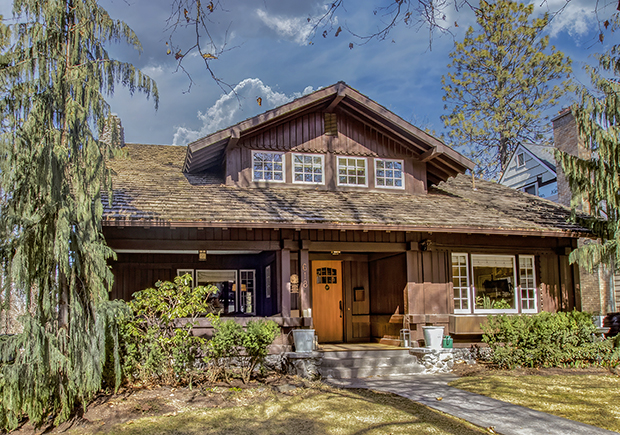
PhotoTitle: The Kiesow-Gentsch House
PhotoAttribution: Spokane City/County Historic Preservation Office
Listing Status: Spokane Register, National Register
URL: http://properties.historicspokane.org/property/?PropertyID=2057
Display Marker: large_yellow
Title: Kiesow-Gentsch House
Description: Date Built: 1912
Architect: Joseph T. Levesque/ W. B. Larimore
Common Name: Kiesow-Gentsch House
Built in 1912 in Spokane, Washington, the Kiesow-Gentsch House is architecturally significant as a quintessential example of the Craftsman style. The home depicts trademark features of the Craftsman aesthetic, including an accentuated horizontal emphasis, exposed structural members, and the use of organically integrated building materials. This is evident in a massive side-gable wood-shingle roof with exposed rafter tails and widely overhanging eaves; a spacious recessed front porch; a combination of irregular basalt, wood shingle, and vertical board-and-batten cladding; horizontal bands (string courses) that separate exterior cladding materials; mortise-and-tenon joinery; and original multi-paned casement windows. The home's interior is particularly significant for its open floor plan and exceptional square-cut woodwork/built-ins finished in the finest quality quarter-sawn oak with a rich, burnished patina. The Kiesow-Gentsch House was one of the first homes erected in the Cannon Hill Park neighborhood and was constructed for Experience & Frank D. Kiesow, the secretary/manager of loans/mortgages for the Jones Real Estate & Development CompanyŃthe company that developed the Cannon Hill Park Addition. The property was later owned by the Frederick & Augusta Gentsch family from 1914 to 1928, owners/proprietors of a real estate/insurance/mortgage/loan business in Spokane.
Location: 47.63388, -117.42161
Address: 618 West 23rd Avenue, Spokane WA 99203
PhotoURL:

PhotoTitle: The Kiesow-Gentsch House
PhotoAttribution: Spokane City/County Historic Preservation Office
Listing Status: Spokane Register, National Register
URL: http://properties.historicspokane.org/property/?PropertyID=2057
Display Marker: large_yellow
ID: 174
Title: Klein House
Description: Date Built: 1902
Architect: Unknown
Henry Klein, founder of Spokane Foundry Works in 1899, commissioned the 2 1/2 story home in 1902. The home is a relatively rare example of a brick Queen Anne style house and boasts hand-painted ceiling and wall murals featuring whimsical Art Nouveau-inspired vines, flowers and cupids. Interestingly, the foundry is noted for manufacturing manhole covers that still cover some Spokane streets and the Klein House today maintains a preserved, decorative furnace cover made by the foundry.
Location: 47.65492, -117.38604
Address: 1626 East Pacific Avenue, Spokane WA 99202
PhotoURL: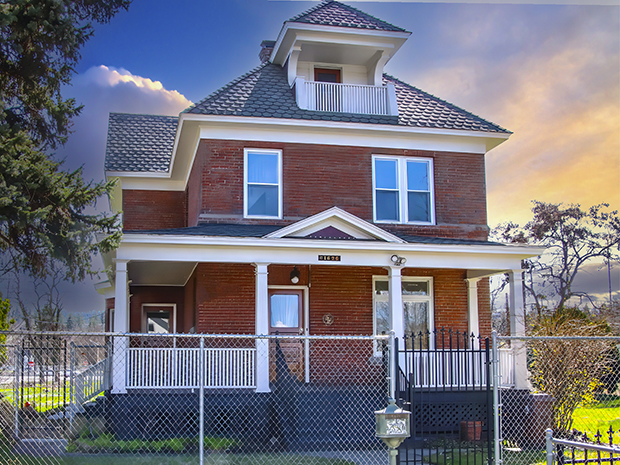
PhotoTitle: The Henry and Ida Klein House
PhotoAttribution: Spokane City/County Historic Preservation Office
Listing Status: Spokane Register
URL: http://properties.historicspokane.org/property/?PropertyID=1851
Display Marker: large_yellow
Title: Klein House
Description: Date Built: 1902
Architect: Unknown
Henry Klein, founder of Spokane Foundry Works in 1899, commissioned the 2 1/2 story home in 1902. The home is a relatively rare example of a brick Queen Anne style house and boasts hand-painted ceiling and wall murals featuring whimsical Art Nouveau-inspired vines, flowers and cupids. Interestingly, the foundry is noted for manufacturing manhole covers that still cover some Spokane streets and the Klein House today maintains a preserved, decorative furnace cover made by the foundry.
Location: 47.65492, -117.38604
Address: 1626 East Pacific Avenue, Spokane WA 99202
PhotoURL:

PhotoTitle: The Henry and Ida Klein House
PhotoAttribution: Spokane City/County Historic Preservation Office
Listing Status: Spokane Register
URL: http://properties.historicspokane.org/property/?PropertyID=1851
Display Marker: large_yellow
ID: 175
Title: Knickerbocker Apartments
Description: Date Built: 1912
Architect: Albert Held
Common Name: Knickerbocker Apartments
The Knickerbocker Apartments was added with three other apartment buildings (Amman, Breslin & San Marco) to the National Register of Historic Places under a thematic nomination for apartment buildings designed by Albert Held, a well-known architect who designed many of Spokane's best-known structures. Located in close proximity to downtown, Held's apartment buildings were among the first structures in Spokane designed and built exclusively as apartments. They were elegantly designed with wealthy tenants in mind; mining magnate and civic leader Graham B. Dennis, the owner of the Knickerbocker, spent $200,000 on the building, which he lived in, and expected from Held the "finest apartment house west of New York."
Location: 47.65112, -117.42064
Address: 507 South Howard Street, Spokane WA 99204
PhotoURL: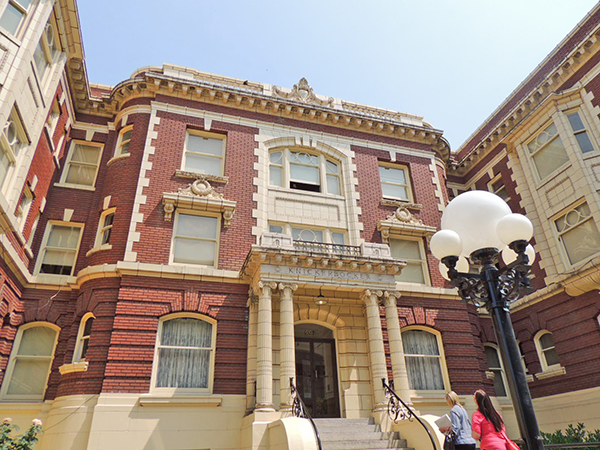
PhotoTitle: The Knickerbocker Apartments
PhotoAttribution: Spokane City/County Historic Preservation Office
Listing Status: Spokane Register, National Register
URL: http://properties.historicspokane.org/property/?PropertyID=2006
Display Marker: large_yellow
Title: Knickerbocker Apartments
Description: Date Built: 1912
Architect: Albert Held
Common Name: Knickerbocker Apartments
The Knickerbocker Apartments was added with three other apartment buildings (Amman, Breslin & San Marco) to the National Register of Historic Places under a thematic nomination for apartment buildings designed by Albert Held, a well-known architect who designed many of Spokane's best-known structures. Located in close proximity to downtown, Held's apartment buildings were among the first structures in Spokane designed and built exclusively as apartments. They were elegantly designed with wealthy tenants in mind; mining magnate and civic leader Graham B. Dennis, the owner of the Knickerbocker, spent $200,000 on the building, which he lived in, and expected from Held the "finest apartment house west of New York."
Location: 47.65112, -117.42064
Address: 507 South Howard Street, Spokane WA 99204
PhotoURL:

PhotoTitle: The Knickerbocker Apartments
PhotoAttribution: Spokane City/County Historic Preservation Office
Listing Status: Spokane Register, National Register
URL: http://properties.historicspokane.org/property/?PropertyID=2006
Display Marker: large_yellow
ID: 176
Title: Knight House
Description: Date Built: 1910
Architect: Cutter & Malmgren
Common Name: The Knight House
Built in 1910, the well-preserved Edwin Knight House is Northwest Spokane's most unique American Foursquare Style home. The house was designed by one of Washington State's most prolific and prominent architectural teams of the early twentieth century: Kirtland Kelsey Cutter and Karl Gunnar Malmgren. It was built for Edwin Herbert Knight, a turn of the century Spokane entrepreneur and businessman who owned and operated the Diamond Drill Contracting Company, one of the first companies in town to manufacture mining machinery. The house is historically significant for its association with the early development of Spokane's northwest corridor along the bluff overlooking the Spokane River, and for its association with Knight. It is also architecturally significant for its unique American Four Square Style adaptation and artistic elements designed by a master architect.
Location: 47.67322, -117.44605
Address: 1715 North West Point Road, Spokane WA 99201
PhotoURL: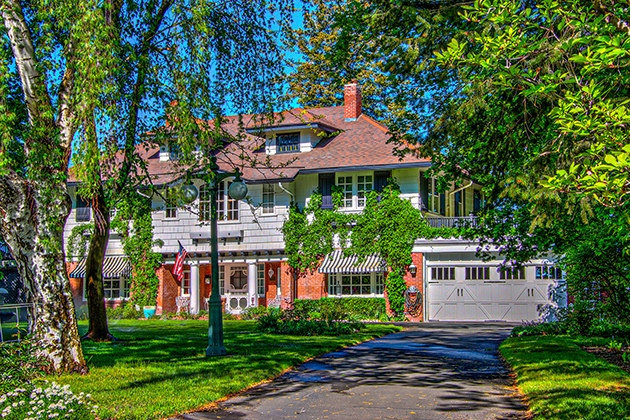
PhotoTitle: The Knight House
PhotoAttribution: Spokane City/County Historic Preservation Office
Listing Status: Spokane Register, National Register
URL: http://properties.historicspokane.org/property/?PropertyID=1852
Display Marker: large_yellow
Title: Knight House
Description: Date Built: 1910
Architect: Cutter & Malmgren
Common Name: The Knight House
Built in 1910, the well-preserved Edwin Knight House is Northwest Spokane's most unique American Foursquare Style home. The house was designed by one of Washington State's most prolific and prominent architectural teams of the early twentieth century: Kirtland Kelsey Cutter and Karl Gunnar Malmgren. It was built for Edwin Herbert Knight, a turn of the century Spokane entrepreneur and businessman who owned and operated the Diamond Drill Contracting Company, one of the first companies in town to manufacture mining machinery. The house is historically significant for its association with the early development of Spokane's northwest corridor along the bluff overlooking the Spokane River, and for its association with Knight. It is also architecturally significant for its unique American Four Square Style adaptation and artistic elements designed by a master architect.
Location: 47.67322, -117.44605
Address: 1715 North West Point Road, Spokane WA 99201
PhotoURL:

PhotoTitle: The Knight House
PhotoAttribution: Spokane City/County Historic Preservation Office
Listing Status: Spokane Register, National Register
URL: http://properties.historicspokane.org/property/?PropertyID=1852
Display Marker: large_yellow
ID: 177
Title: Knight's Diner
Description: Date Built: 1906
Architect: Pullman Car Company
Common Name: Knight's Diner
The railcar that houses Knight's Diner was built by the Pullman Car Company of Pittsburgh, Pennsylvania in 1906 and served the Northern Pacific Railroad as car number 988. During World War II the car, which had been retired to the Northern Pacific Yards in the Spokane Valley, was pressed into service as an indoctrination classroom for the war effort. President Franklin Delano Roosevelt subsequently offered the car as a gift to a Spokane resident in appreciation of his years of voluntary service traveling the country as "Uncle Sam" in support of the war effort. John (Jack) Knight, formerly the headwaiter at the Davenport Hotel, renovated the car for use as a diner in 1949. Knight's Diner has retained a high degree of integrity since construction in 1906, even during its later reuse as a diner. It is significant as both a well-preserved turn of the twentieth century all-wood Pullman car and as an outstanding example of an American roadside diner.
Location: 47.68444, -117.36562
Address: 2909 North Market Street, Spokane WA 99207
PhotoURL: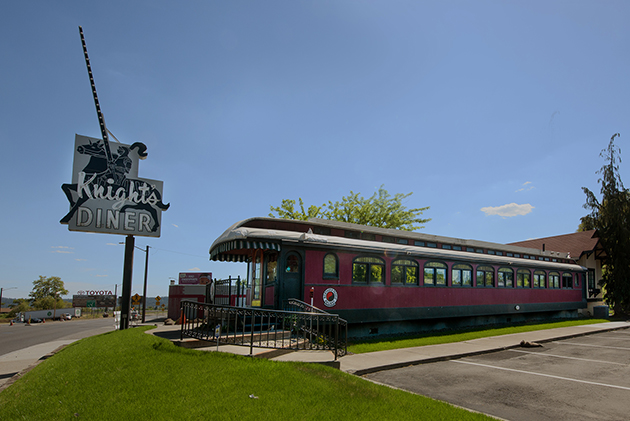
PhotoTitle: Knight's Diner
PhotoAttribution: Spokane City/County Historic Preservation Office
Listing Status: Spokane Register
URL: http://properties.historicspokane.org/property/?PropertyID=1853
Display Marker: large_yellow
Title: Knight's Diner
Description: Date Built: 1906
Architect: Pullman Car Company
Common Name: Knight's Diner
The railcar that houses Knight's Diner was built by the Pullman Car Company of Pittsburgh, Pennsylvania in 1906 and served the Northern Pacific Railroad as car number 988. During World War II the car, which had been retired to the Northern Pacific Yards in the Spokane Valley, was pressed into service as an indoctrination classroom for the war effort. President Franklin Delano Roosevelt subsequently offered the car as a gift to a Spokane resident in appreciation of his years of voluntary service traveling the country as "Uncle Sam" in support of the war effort. John (Jack) Knight, formerly the headwaiter at the Davenport Hotel, renovated the car for use as a diner in 1949. Knight's Diner has retained a high degree of integrity since construction in 1906, even during its later reuse as a diner. It is significant as both a well-preserved turn of the twentieth century all-wood Pullman car and as an outstanding example of an American roadside diner.
Location: 47.68444, -117.36562
Address: 2909 North Market Street, Spokane WA 99207
PhotoURL:

PhotoTitle: Knight's Diner
PhotoAttribution: Spokane City/County Historic Preservation Office
Listing Status: Spokane Register
URL: http://properties.historicspokane.org/property/?PropertyID=1853
Display Marker: large_yellow
ID: 178
Title: Koerner House
Description: Date Built: 1912
Architect: Carl Koerner, Peter Moe, and Carl Jabelonsky
Common Name: Carl and Mathilda Koerner House
With its low-pitched front-gabled roof with widely overhanging eaves, scalloped verge board, massive decorative brackets, rough-cut wood siding and second floor balconies and gallery porches, the Koerner House is an excellent example of the American Swiss Chalet Style. One of very few houses in this style in Spokane, the Koerner House possesses a high degree of craftsmanship. The home was built in 1912 for Carl Koerner, a successful Spokane accountant, and his wife Mathilda. Koerner worked on the plans himself, probably with the aid of Peter Moe, a draftsman for prominent Spokane architect Carl Jabelonsky, who may also have contributed to the design.
Location: 47.63871, -117.37106
Address: 1824 South Mount Vernon Street, Spokane WA 99223
PhotoURL: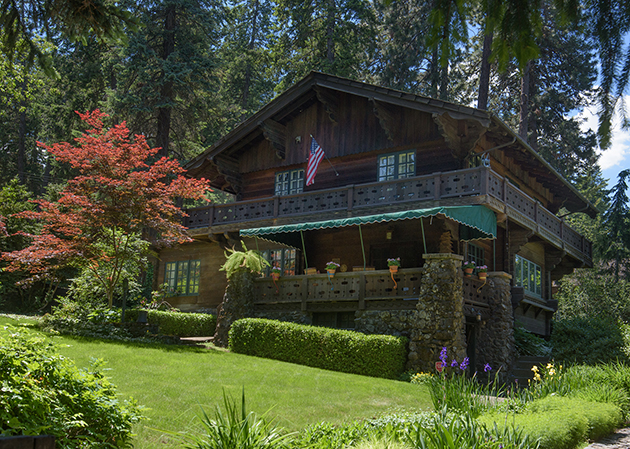
PhotoTitle: The Carl and Mathilda Koerner House
PhotoAttribution: Spokane City/County Historic Preservation Office
Listing Status: Spokane Register, National Register
URL: http://properties.historicspokane.org/property/?PropertyID=1854
Display Marker: large_yellow
Title: Koerner House
Description: Date Built: 1912
Architect: Carl Koerner, Peter Moe, and Carl Jabelonsky
Common Name: Carl and Mathilda Koerner House
With its low-pitched front-gabled roof with widely overhanging eaves, scalloped verge board, massive decorative brackets, rough-cut wood siding and second floor balconies and gallery porches, the Koerner House is an excellent example of the American Swiss Chalet Style. One of very few houses in this style in Spokane, the Koerner House possesses a high degree of craftsmanship. The home was built in 1912 for Carl Koerner, a successful Spokane accountant, and his wife Mathilda. Koerner worked on the plans himself, probably with the aid of Peter Moe, a draftsman for prominent Spokane architect Carl Jabelonsky, who may also have contributed to the design.
Location: 47.63871, -117.37106
Address: 1824 South Mount Vernon Street, Spokane WA 99223
PhotoURL:

PhotoTitle: The Carl and Mathilda Koerner House
PhotoAttribution: Spokane City/County Historic Preservation Office
Listing Status: Spokane Register, National Register
URL: http://properties.historicspokane.org/property/?PropertyID=1854
Display Marker: large_yellow
ID: 179
Title: Kroll House
Description: Date Built: 1910
Architect: Ballard Plannery
Common Name: William & Anna Kroll House
The property is an example of the American Arts & Crafts period with an eclectic mixture of influences from Craftsman and Tudor Revival styles. Prominent architectural features include the home's 2.5 stories, widely overhanging eaves, deep bargeboards with pointed ends, gable peak pendant drops, exposed rafter ends, scroll-sawn brackets, horizontal clapboard siding, basalt rock foundation, multi-windows with small divided lights in the upper sash, and a partial-width front porch and balcony supported by massive exposed beams/joists, and tapered porch posts.
Location: 47.64361, -117.42133
Address: 1249 South Wall Street, Spokane WA 99204
PhotoURL:
PhotoTitle: The William and Anna Kroll House
PhotoAttribution: Spokane City/County Historic Preservation Office
Listing Status: Spokane Register, National Register
URL: http://properties.historicspokane.org/property/?PropertyID=2039
Display Marker: large_yellow
Title: Kroll House
Description: Date Built: 1910
Architect: Ballard Plannery
Common Name: William & Anna Kroll House
The property is an example of the American Arts & Crafts period with an eclectic mixture of influences from Craftsman and Tudor Revival styles. Prominent architectural features include the home's 2.5 stories, widely overhanging eaves, deep bargeboards with pointed ends, gable peak pendant drops, exposed rafter ends, scroll-sawn brackets, horizontal clapboard siding, basalt rock foundation, multi-windows with small divided lights in the upper sash, and a partial-width front porch and balcony supported by massive exposed beams/joists, and tapered porch posts.
Location: 47.64361, -117.42133
Address: 1249 South Wall Street, Spokane WA 99204
PhotoURL:

PhotoTitle: The William and Anna Kroll House
PhotoAttribution: Spokane City/County Historic Preservation Office
Listing Status: Spokane Register, National Register
URL: http://properties.historicspokane.org/property/?PropertyID=2039
Display Marker: large_yellow
ID: 180
Title: Lane House
Description: Date Built: 1904
Architect: Unknown
Common Name: Zeph Lane House
Constructed in 1904, the Zeph Lane House was built during the first phase of single-family construction along East Mission Avenue, between the 200 and 800 block, what is today identified as the Mission Avenue National Historic District. The Lane House is an excellent example of the Free Classic Queen Anne style with Dutch Colonial influences. The Lane House was constructed for Zeph Lane, of Burke and Lane, a Spokane lumber manufacturer and dealer on West Broadway Avenue. The home sold to railroad contractor George Chew in 1909. Chew also had his own firm, Washtok and Chew, in the Mohawk Building downtown. During the property's period of significance from 1904 to 1917, the Lane House achieved historic significance for its association with the architectural development and settlement of the Logan Neighborhood, specifically along East Mission Avenue.
Location: 47.67139, -117.40009
Address: 630 East Mission Avenue, Spokane WA 99202
PhotoURL: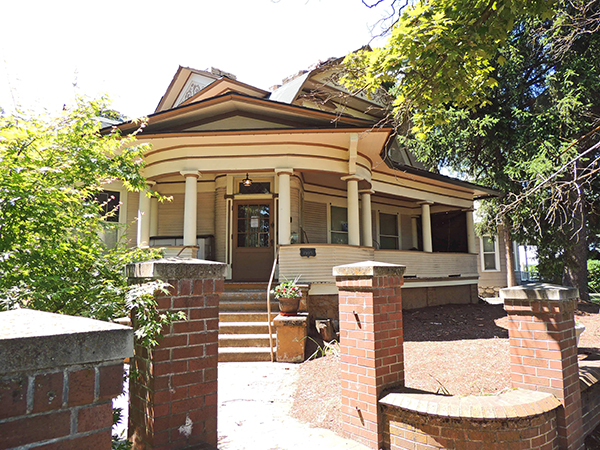
PhotoTitle: The Zeph Lane House
PhotoAttribution: Spokane City/County Historic Preservation Office
Listing Status: Spokane Register, National Register
URL: http://properties.historicspokane.org/property/?PropertyID=1980
Display Marker: large_yellow
Title: Lane House
Description: Date Built: 1904
Architect: Unknown
Common Name: Zeph Lane House
Constructed in 1904, the Zeph Lane House was built during the first phase of single-family construction along East Mission Avenue, between the 200 and 800 block, what is today identified as the Mission Avenue National Historic District. The Lane House is an excellent example of the Free Classic Queen Anne style with Dutch Colonial influences. The Lane House was constructed for Zeph Lane, of Burke and Lane, a Spokane lumber manufacturer and dealer on West Broadway Avenue. The home sold to railroad contractor George Chew in 1909. Chew also had his own firm, Washtok and Chew, in the Mohawk Building downtown. During the property's period of significance from 1904 to 1917, the Lane House achieved historic significance for its association with the architectural development and settlement of the Logan Neighborhood, specifically along East Mission Avenue.
Location: 47.67139, -117.40009
Address: 630 East Mission Avenue, Spokane WA 99202
PhotoURL:

PhotoTitle: The Zeph Lane House
PhotoAttribution: Spokane City/County Historic Preservation Office
Listing Status: Spokane Register, National Register
URL: http://properties.historicspokane.org/property/?PropertyID=1980
Display Marker: large_yellow
ID: 181
Title: Lang Building
Description: Date Built: 1890
Architect: Worthy Niver
Common Name: Jockey Club, Grand Army Hall
Built by M. Lang & Co. in 1890 as a hall and office space for the Grand Army of the Republic, the Lang Building, also known historically as the Grand Army Hall, is historically significant as one of the few remaining buildings from the rebuilding boom that followed the Great Spokane Fire of 1889. This building and the First Congregational Church (listed on the National Register of Historic Places) are the only two known surviving buildings designed by architect Worthy Niver, who practiced in Spokane from 1890 to 1892.
Location: 47.6586, -117.4183
Address: 115 North Washington Street, Spokane WA 99201
PhotoURL: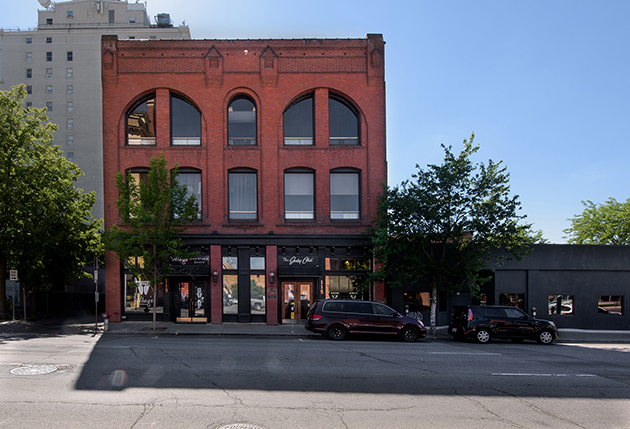
PhotoTitle: The Lang Building
PhotoAttribution: Spokane City/County Historic Preservation Office
Listing Status: Spokane Register
URL: http://properties.historicspokane.org/property/?PropertyID=1855
Display Marker: large_yellow
Title: Lang Building
Description: Date Built: 1890
Architect: Worthy Niver
Common Name: Jockey Club, Grand Army Hall
Built by M. Lang & Co. in 1890 as a hall and office space for the Grand Army of the Republic, the Lang Building, also known historically as the Grand Army Hall, is historically significant as one of the few remaining buildings from the rebuilding boom that followed the Great Spokane Fire of 1889. This building and the First Congregational Church (listed on the National Register of Historic Places) are the only two known surviving buildings designed by architect Worthy Niver, who practiced in Spokane from 1890 to 1892.
Location: 47.6586, -117.4183
Address: 115 North Washington Street, Spokane WA 99201
PhotoURL:

PhotoTitle: The Lang Building
PhotoAttribution: Spokane City/County Historic Preservation Office
Listing Status: Spokane Register
URL: http://properties.historicspokane.org/property/?PropertyID=1855
Display Marker: large_yellow
ID: 182
Title: Larsen-Lindholm House
Description: Date Built: 1909
Architect: Unknown
Common Name: Larsen-Lindholm House
Built in 1909, the Larsen-Lindholm House is a landmark example of architectural design and elements popularized during the late nineteenth and early twentieth-century American Arts & Crafts movement. The house was built in the Cliff Park neighborhood on Spokane's South Hill on speculation by Spokane jewelry store owner and real estate developer Mark L. Pershall for $8,000, a sum that more than tripled the $2,500 minimum construction cost mandated in neighborhood deed restrictions. One year after it was built, Bertha & Lewis P. Larsen, a brilliant mining engineer and founder of the town of Metaline Falls, purchased the property for $10,500. Immediately overcome by burgeoning business interests and mining obligations in Metaline Falls, the Larsens sold the home to Maurice & Bertha Lindholm in 1911. Maurice Lindholm was a successful investment securities broker and commercial photographer and owned the property for more than 35 years.
Location: 47.6439, -117.42131
Address: 1243 South Wall Street, Spokane WA 99204
PhotoURL: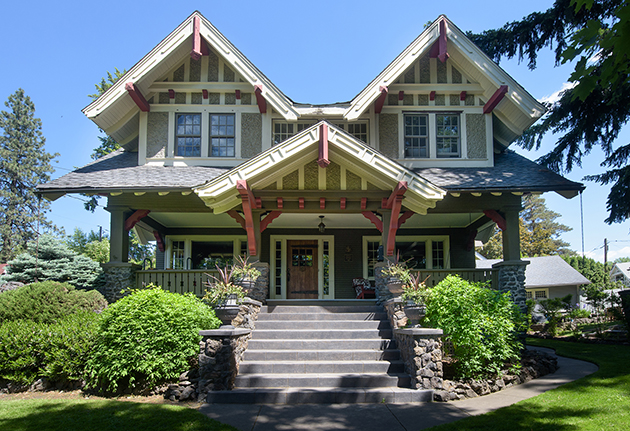
PhotoTitle: The Larsen-Lindholm House
PhotoAttribution: Spokane City/County Historic Preservation Office
Listing Status: Spokane Register
URL: http://properties.historicspokane.org/property/?PropertyID=1856
Display Marker: large_yellow
Title: Larsen-Lindholm House
Description: Date Built: 1909
Architect: Unknown
Common Name: Larsen-Lindholm House
Built in 1909, the Larsen-Lindholm House is a landmark example of architectural design and elements popularized during the late nineteenth and early twentieth-century American Arts & Crafts movement. The house was built in the Cliff Park neighborhood on Spokane's South Hill on speculation by Spokane jewelry store owner and real estate developer Mark L. Pershall for $8,000, a sum that more than tripled the $2,500 minimum construction cost mandated in neighborhood deed restrictions. One year after it was built, Bertha & Lewis P. Larsen, a brilliant mining engineer and founder of the town of Metaline Falls, purchased the property for $10,500. Immediately overcome by burgeoning business interests and mining obligations in Metaline Falls, the Larsens sold the home to Maurice & Bertha Lindholm in 1911. Maurice Lindholm was a successful investment securities broker and commercial photographer and owned the property for more than 35 years.
Location: 47.6439, -117.42131
Address: 1243 South Wall Street, Spokane WA 99204
PhotoURL:

PhotoTitle: The Larsen-Lindholm House
PhotoAttribution: Spokane City/County Historic Preservation Office
Listing Status: Spokane Register
URL: http://properties.historicspokane.org/property/?PropertyID=1856
Display Marker: large_yellow
ID: 183
Title: Levesque-Majer House
Description: Date Built: 1912
Architect: Joseph T. Levesque
Common Name: Levesque-Majer House
Architect Joseph T. Levesque designed this Craftsman style bungalow for himself in 1912. He described it as a "unique residence fashioned after the Japanese style." The Japanese influence certainly sets the home apart from other Craftsman style bungalows in Spokane. Paul Duchscherer, in The Bungalow: America's Arts and Crafts Home, characterized the Levesque-Majer House as "a splendid architectural anomaly in a city with a significant architectural range" and a "textbook example of Craftsman-style homes inspired by Gustav Stickley and the Greene Brothers" of Pasadena, California.
Location: 47.63869, -117.43454
Address: 1708 South Maple Boulevard, Spokane WA 99203
PhotoURL: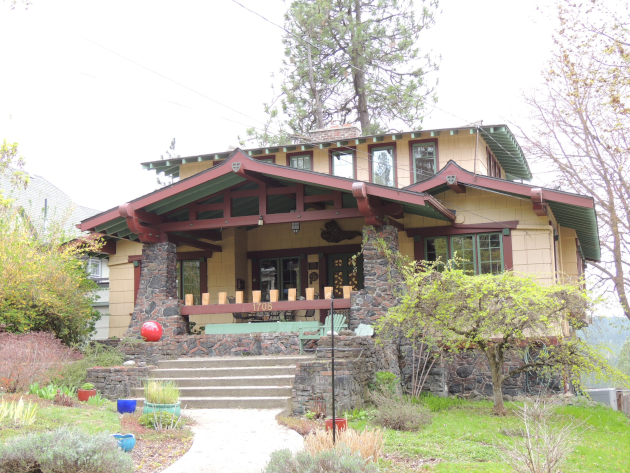
PhotoTitle: The Levesque-Majer House
PhotoAttribution: Spokane City/County Historic Preservation Office
Listing Status: Spokane Register, National Register
URL: http://properties.historicspokane.org/property/?PropertyID=1857
Display Marker: large_yellow
Title: Levesque-Majer House
Description: Date Built: 1912
Architect: Joseph T. Levesque
Common Name: Levesque-Majer House
Architect Joseph T. Levesque designed this Craftsman style bungalow for himself in 1912. He described it as a "unique residence fashioned after the Japanese style." The Japanese influence certainly sets the home apart from other Craftsman style bungalows in Spokane. Paul Duchscherer, in The Bungalow: America's Arts and Crafts Home, characterized the Levesque-Majer House as "a splendid architectural anomaly in a city with a significant architectural range" and a "textbook example of Craftsman-style homes inspired by Gustav Stickley and the Greene Brothers" of Pasadena, California.
Location: 47.63869, -117.43454
Address: 1708 South Maple Boulevard, Spokane WA 99203
PhotoURL:

PhotoTitle: The Levesque-Majer House
PhotoAttribution: Spokane City/County Historic Preservation Office
Listing Status: Spokane Register, National Register
URL: http://properties.historicspokane.org/property/?PropertyID=1857
Display Marker: large_yellow
ID: 184
Title: Levy Block
Description: Date Built: 1892
Architect: Unknown
Common Name: Levy Block
The Levy block, built in 1892 for Samuel Levy, is historically significant for its association with the rebuilding effort that occurred in Spokane in the wake of the Great Fire of 1889. It is also an early representative example of a Single Room Occupancy Hotel, or SRO, a distinctive type of working class housing built in response to the construction and population booms that occurred in Spokane between 1890 and 1910.
Location: 47.65858, -117.41928
Address: 118 North Stevens Street, Spokane WA 99201
PhotoURL: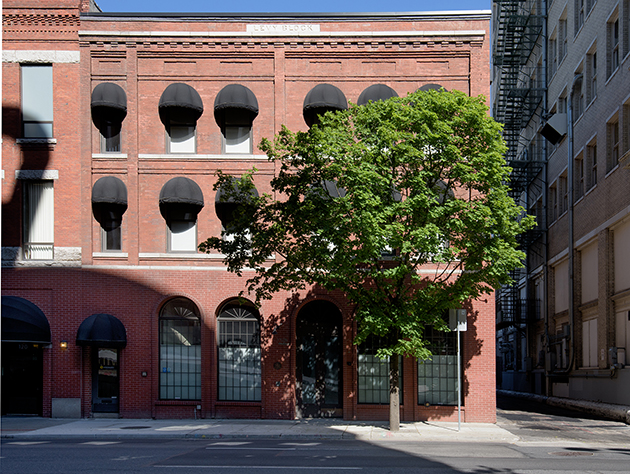
PhotoTitle: The Levy Block
PhotoAttribution: Spokane City/County Historic Preservation Office
Listing Status: Spokane Register
URL: http://properties.historicspokane.org/property/?PropertyID=1858
Display Marker: large_yellow
Title: Levy Block
Description: Date Built: 1892
Architect: Unknown
Common Name: Levy Block
The Levy block, built in 1892 for Samuel Levy, is historically significant for its association with the rebuilding effort that occurred in Spokane in the wake of the Great Fire of 1889. It is also an early representative example of a Single Room Occupancy Hotel, or SRO, a distinctive type of working class housing built in response to the construction and population booms that occurred in Spokane between 1890 and 1910.
Location: 47.65858, -117.41928
Address: 118 North Stevens Street, Spokane WA 99201
PhotoURL:

PhotoTitle: The Levy Block
PhotoAttribution: Spokane City/County Historic Preservation Office
Listing Status: Spokane Register
URL: http://properties.historicspokane.org/property/?PropertyID=1858
Display Marker: large_yellow
ID: 185
Title: Lewis & Clark High School
Description: Date Built: 1911
Architect:Loren L. Rand (1911-12) and Steve McNutt (2001 renovation and additions) Common Name: LC
Architecturally impressive, Lewis & Clark High School is also significant for its long association with educational efforts in Spokane. Built between1911 and 1912, Lewis & Clark is the oldest high school building in the city and is situated on property that has a long history with the Spokane educational system. Despite alterations to the original building after an addition in 2001, the school retains its historic integrity. What remains of the building's exterior continues to be one of the finest examples of the Collegiate Gothic Style in Spokane and is an outstanding example of the work of prominent Spokane architect Loren L. Rand.
Location: 47.65193, -117.42075
Address: 521 West 4th Avenue, Spokane WA 99204
PhotoURL: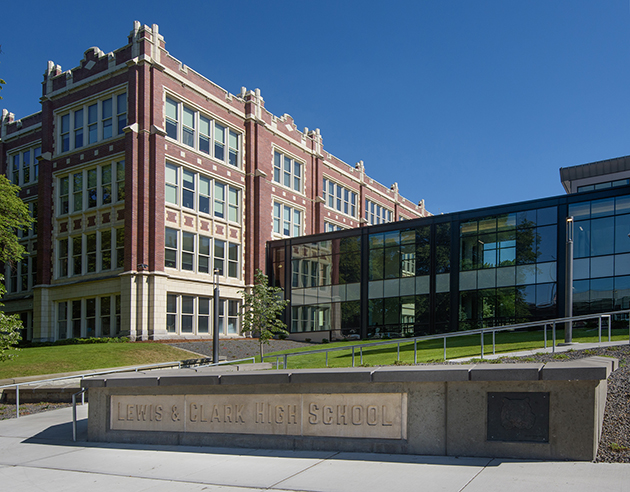
PhotoTitle: Lewis & Clark High School
PhotoAttribution: Spokane City/County Historic Preservation Office
Listing Status: National Register
URL: http://properties.historicspokane.org/property/?PropertyID=2007
Display Marker: large_yellow
Title: Lewis & Clark High School
Description: Date Built: 1911
Architect:Loren L. Rand (1911-12) and Steve McNutt (2001 renovation and additions) Common Name: LC
Architecturally impressive, Lewis & Clark High School is also significant for its long association with educational efforts in Spokane. Built between1911 and 1912, Lewis & Clark is the oldest high school building in the city and is situated on property that has a long history with the Spokane educational system. Despite alterations to the original building after an addition in 2001, the school retains its historic integrity. What remains of the building's exterior continues to be one of the finest examples of the Collegiate Gothic Style in Spokane and is an outstanding example of the work of prominent Spokane architect Loren L. Rand.
Location: 47.65193, -117.42075
Address: 521 West 4th Avenue, Spokane WA 99204
PhotoURL:

PhotoTitle: Lewis & Clark High School
PhotoAttribution: Spokane City/County Historic Preservation Office
Listing Status: National Register
URL: http://properties.historicspokane.org/property/?PropertyID=2007
Display Marker: large_yellow
ID: 186
Title: Liberty Park Methodist Episcopal Church
Description: Date Built: 1911
Architect: Unknown (possibly Leonard Starr)
Common Name: Library Park United Methodist Church
Liberty Park Methodist Episcopal Church is architecturally significant in its clear illustration of early twentieth-century Gothic Revival architecture and as a rare local example of the Akron Plan, a style of interior layout that became the standard for Methodist and other Christian denominations by the 1890s. The Akron Plan is so named because the Akron, Ohio, architect, George W. Kramer, and a Methodist minister, Lewis Miller, popularized it. Distinctive components of the plan include a corner pulpit platform and radial orientation of pews. The architect of the church has not been documented, though family tradition holds that Leonard Starr, an architect and a member of the Liberty Park Church, designed it. Starr worked as a draftsman for notable Spokane architect Albert Held in 1909 and 1910 and also did occasional work for Cutter and Malmgren, Spokane's most celebrated architectural firm.
Location: 47.64518, -117.3875
Address: 1526 East 11th Avenue, Spokane WA 99202
PhotoURL: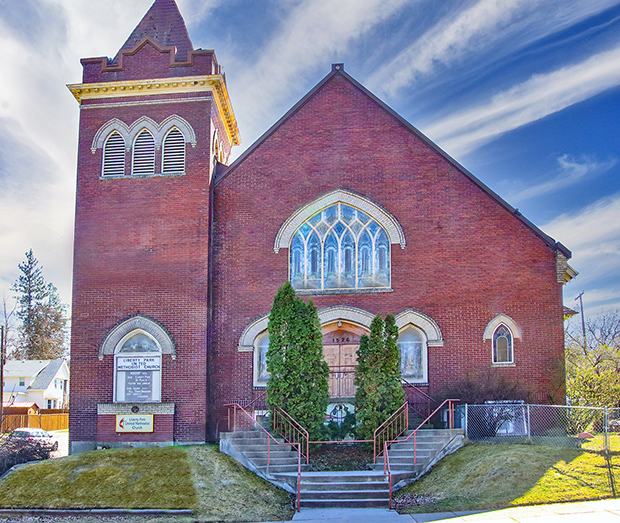
PhotoTitle: The Liberty Park Methodist Episcopal Church
PhotoAttribution: Spokane City/County Historic Preservation Office
Listing Status: Spokane Register
URL: http://properties.historicspokane.org/property/?PropertyID=1859
Display Marker: large_yellow
Title: Liberty Park Methodist Episcopal Church
Description: Date Built: 1911
Architect: Unknown (possibly Leonard Starr)
Common Name: Library Park United Methodist Church
Liberty Park Methodist Episcopal Church is architecturally significant in its clear illustration of early twentieth-century Gothic Revival architecture and as a rare local example of the Akron Plan, a style of interior layout that became the standard for Methodist and other Christian denominations by the 1890s. The Akron Plan is so named because the Akron, Ohio, architect, George W. Kramer, and a Methodist minister, Lewis Miller, popularized it. Distinctive components of the plan include a corner pulpit platform and radial orientation of pews. The architect of the church has not been documented, though family tradition holds that Leonard Starr, an architect and a member of the Liberty Park Church, designed it. Starr worked as a draftsman for notable Spokane architect Albert Held in 1909 and 1910 and also did occasional work for Cutter and Malmgren, Spokane's most celebrated architectural firm.
Location: 47.64518, -117.3875
Address: 1526 East 11th Avenue, Spokane WA 99202
PhotoURL:

PhotoTitle: The Liberty Park Methodist Episcopal Church
PhotoAttribution: Spokane City/County Historic Preservation Office
Listing Status: Spokane Register
URL: http://properties.historicspokane.org/property/?PropertyID=1859
Display Marker: large_yellow
ID: 187
Title: Lindsley-Larsen Estate
Description: Date Built: 1914
Architect: C. Harvey Smith
Common Name: Lindsley-Larsen Estate
The Lindsley-Larsen Estate is one of the few remaining undivided, multi-acre residential estates built in Spokane during the late nineteenth and early twentieth centuries. Built in 1914 for Maude and Edward Lindsley, owner of Lindsley Brothers Cedar Products, and was later home to Lewis P. Larsen, one of Spokane's most brilliant mining engineers, and his wife, Bertha, for more than 27 years. The property includes the main house, a carriage house/garage, a chauffeur's cottage and garage addition, and landscaped grounds and garden features. The grounds are particularly striking and included Rhododendron flower beds, a garden allee with a fountain, a reflecting pool, grassed game court, rock wall and other hardscape features. Designed by Spokane architect C. Harvey Smith and built in 1914, the Lindsley-Larsen Estate is an excellent example of the Colonial Revival style. The home won a city-wide contest held in 1921 and was honored as a "Notable Example of Architecture in Spokane" as reported in The Architect and Engineer.
Location: 47.64343, -117.37586
Address: 2314 East South Altamon Boulevard, Spokane WA 99202
PhotoURL: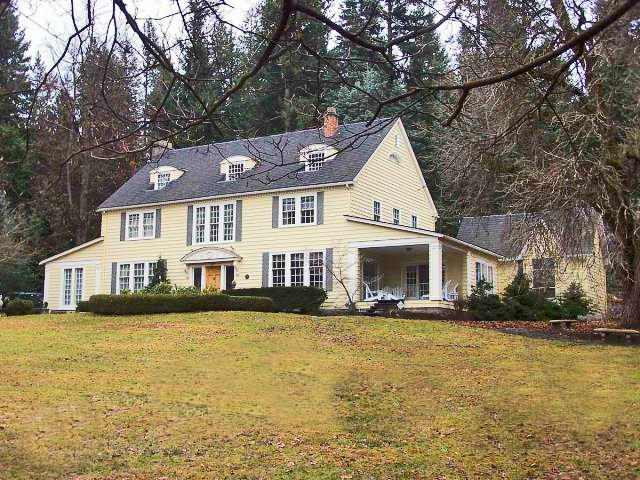
PhotoTitle: The Lindsley-Larsen Estate
PhotoAttribution: Spokane City/County Historic Preservation Office
Listing Status: Spokane Register
URL: http://properties.historicspokane.org/property/?PropertyID=1860
Display Marker: large_yellow
Title: Lindsley-Larsen Estate
Description: Date Built: 1914
Architect: C. Harvey Smith
Common Name: Lindsley-Larsen Estate
The Lindsley-Larsen Estate is one of the few remaining undivided, multi-acre residential estates built in Spokane during the late nineteenth and early twentieth centuries. Built in 1914 for Maude and Edward Lindsley, owner of Lindsley Brothers Cedar Products, and was later home to Lewis P. Larsen, one of Spokane's most brilliant mining engineers, and his wife, Bertha, for more than 27 years. The property includes the main house, a carriage house/garage, a chauffeur's cottage and garage addition, and landscaped grounds and garden features. The grounds are particularly striking and included Rhododendron flower beds, a garden allee with a fountain, a reflecting pool, grassed game court, rock wall and other hardscape features. Designed by Spokane architect C. Harvey Smith and built in 1914, the Lindsley-Larsen Estate is an excellent example of the Colonial Revival style. The home won a city-wide contest held in 1921 and was honored as a "Notable Example of Architecture in Spokane" as reported in The Architect and Engineer.
Location: 47.64343, -117.37586
Address: 2314 East South Altamon Boulevard, Spokane WA 99202
PhotoURL:

PhotoTitle: The Lindsley-Larsen Estate
PhotoAttribution: Spokane City/County Historic Preservation Office
Listing Status: Spokane Register
URL: http://properties.historicspokane.org/property/?PropertyID=1860
Display Marker: large_yellow
ID: 188
Title: Littlebrook Farm
Description: Date Built: 1944
Architect: Oliver LaJoie
Common Name: Littlebrook Farm
Littlebrook is an incredibly well-preserved example of horizontal whole log construction which is unique to the Spokane County area. Built between 1935 and 1944 by Oliver LaJoie, a local handyman who was hired from the unemployement office, the home was patterned after a drawing of the Red River Ranger Station in Elk City, Washington. All of the cedar logs used in building the home were hand cut, peeled and notched; no nails or pegs were used as whole logs were coped and placed horizontally one on top of the other. The two-story, hand hewn log home was built for John T. Little, a local businessman and County Commissioner, and his wife. John Little played an intergral part in the business and civic development of Spokane from 1909 until his death in 1980.
Location: 47.809149, -117.409008
Address: 16704 North Dartford Drive, Spokane County, Spokane WA 99208
PhotoURL: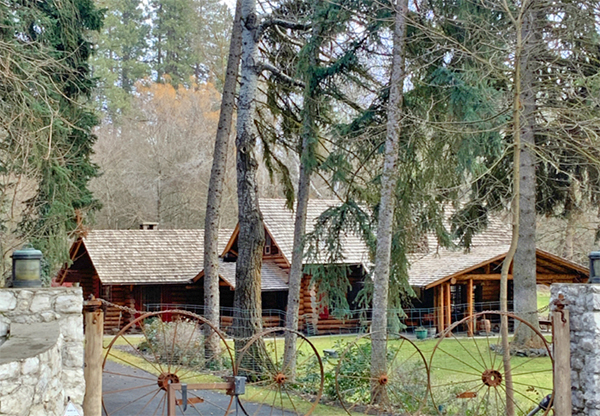
PhotoTitle: Littlebrook Farm
PhotoAttribution: Spokane City/County Historic Preservation Office
Listing Status: Spokane Register, National Register
URL: http://properties.historicspokane.org/property/?PropertyID=1861
Display Marker: large_yellow
Title: Littlebrook Farm
Description: Date Built: 1944
Architect: Oliver LaJoie
Common Name: Littlebrook Farm
Littlebrook is an incredibly well-preserved example of horizontal whole log construction which is unique to the Spokane County area. Built between 1935 and 1944 by Oliver LaJoie, a local handyman who was hired from the unemployement office, the home was patterned after a drawing of the Red River Ranger Station in Elk City, Washington. All of the cedar logs used in building the home were hand cut, peeled and notched; no nails or pegs were used as whole logs were coped and placed horizontally one on top of the other. The two-story, hand hewn log home was built for John T. Little, a local businessman and County Commissioner, and his wife. John Little played an intergral part in the business and civic development of Spokane from 1909 until his death in 1980.
Location: 47.809149, -117.409008
Address: 16704 North Dartford Drive, Spokane County, Spokane WA 99208
PhotoURL:

PhotoTitle: Littlebrook Farm
PhotoAttribution: Spokane City/County Historic Preservation Office
Listing Status: Spokane Register, National Register
URL: http://properties.historicspokane.org/property/?PropertyID=1861
Display Marker: large_yellow
ID: 189
Title: Lloyd-Bertles House and Garden
Description: Date Built: 1919
Architect: Unknown/Henry Lydell (builder)
Common Name: Lloyd-Bertles House and Garden
The Lloyd-Bertles House is architecturally significant as an example of a Tudor Revival style home with Craftsman influences. It was built by contractor Henry Lydell in 1919 for Spokane businessman and oil investor, Walden D. Lloyd, and his wife, Hattie. The sunken gardens and basalt landscaping features were most fully developed by John and Henrita Bertles, the owners of Bertles & Bertles Wholesale Lumber Company and 20-year residents of the home.
Location: 47.6354, -117.39745
Address: 2115 South Rockwood Boulevard, Spokane WA 99203
PhotoURL: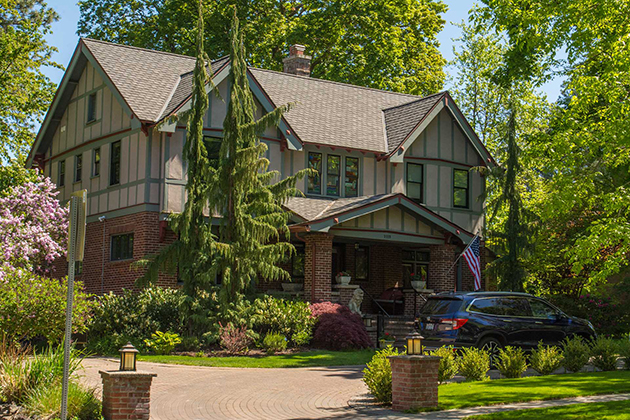
PhotoTitle: Lloyd-Bertles House and Garden
PhotoAttribution: Spokane City/County Historic Preservation Office
Listing Status: Spokane Register, National Register
URL: http://properties.historicspokane.org/property/?PropertyID=1862
Display Marker: large_yellow
Title: Lloyd-Bertles House and Garden
Description: Date Built: 1919
Architect: Unknown/Henry Lydell (builder)
Common Name: Lloyd-Bertles House and Garden
The Lloyd-Bertles House is architecturally significant as an example of a Tudor Revival style home with Craftsman influences. It was built by contractor Henry Lydell in 1919 for Spokane businessman and oil investor, Walden D. Lloyd, and his wife, Hattie. The sunken gardens and basalt landscaping features were most fully developed by John and Henrita Bertles, the owners of Bertles & Bertles Wholesale Lumber Company and 20-year residents of the home.
Location: 47.6354, -117.39745
Address: 2115 South Rockwood Boulevard, Spokane WA 99203
PhotoURL:

PhotoTitle: Lloyd-Bertles House and Garden
PhotoAttribution: Spokane City/County Historic Preservation Office
Listing Status: Spokane Register, National Register
URL: http://properties.historicspokane.org/property/?PropertyID=1862
Display Marker: large_yellow
ID: 190
Title: Loewenberg-Roberts House
Description: Date Built: 1889
Architect:William J. Carpenter Common Name: Loewenberg-Roberts House
The Loewenberg-Roberts house is one of Spokane's premiere examples of Queen Anne architecture and features granite window trim, decorative spindle work in the gables and a prominent turret. The 24-room mansion was designed in 1889 for pioneer businessman, Bernard Loewenberg, a Prussian immigrant and owner of the Loewenberg Mercantile, the building later to be known as the Coeur d'Alene Hotel. Following the stock market crash of 1893, Loewenberg went bankrupt and was forced to trade houses with E.J. Roberts in 1898. Edward Roberts was the chief engineer of the D.C. Corbin Railway Systems and founder of the Union Iron Works along with D.C. Corbin. The house remained in the Roberts family until 1959.
Location: 47.656, -117.44125
Address: 1923 West 1st Avenue, Spokane WA 99201
PhotoURL: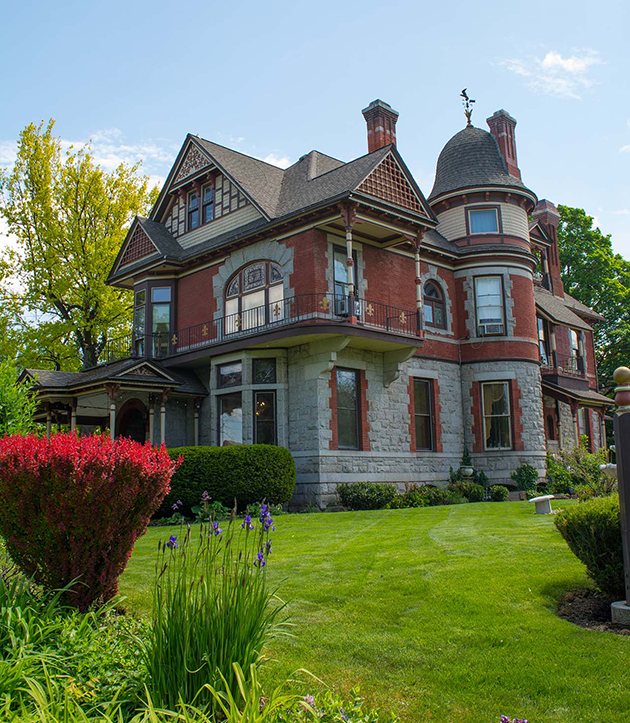
PhotoTitle: The Loewenberg-Roberts House
PhotoAttribution: Spokane City/County Historic Preservation Office
Listing Status: Spokane Register, National Register
URL: http://properties.historicspokane.org/property/?PropertyID=1863
Display Marker: large_yellow
Title: Loewenberg-Roberts House
Description: Date Built: 1889
Architect:William J. Carpenter Common Name: Loewenberg-Roberts House
The Loewenberg-Roberts house is one of Spokane's premiere examples of Queen Anne architecture and features granite window trim, decorative spindle work in the gables and a prominent turret. The 24-room mansion was designed in 1889 for pioneer businessman, Bernard Loewenberg, a Prussian immigrant and owner of the Loewenberg Mercantile, the building later to be known as the Coeur d'Alene Hotel. Following the stock market crash of 1893, Loewenberg went bankrupt and was forced to trade houses with E.J. Roberts in 1898. Edward Roberts was the chief engineer of the D.C. Corbin Railway Systems and founder of the Union Iron Works along with D.C. Corbin. The house remained in the Roberts family until 1959.
Location: 47.656, -117.44125
Address: 1923 West 1st Avenue, Spokane WA 99201
PhotoURL:

PhotoTitle: The Loewenberg-Roberts House
PhotoAttribution: Spokane City/County Historic Preservation Office
Listing Status: Spokane Register, National Register
URL: http://properties.historicspokane.org/property/?PropertyID=1863
Display Marker: large_yellow
ID: 191
Title: Long House
Description: Date Built: 1899
Architect: Albert Held
Common Name: Leo and Katie Long House
As one of the largest historic landmark residences in Spokane, the brick-and-stucco Leo and Katie Long House is a high-style example of the Queen Anne tradition with French Eclectic and Tudor Revival-style influence. The two-and-one-half-story home commands a panoramic view of north Spokane from a steep hillside site in the Second Railroad Addition on the South Hill. The home is characterized by typical Queen Anne-style features including an irregular footprint, an irregular steeply pitched hip roof, multiple dormers and bays, and two full-height towers.
Location: 47.65107, -117.4315
Address: 1305 West 5th Avenue, Spokane WA 99204
PhotoURL: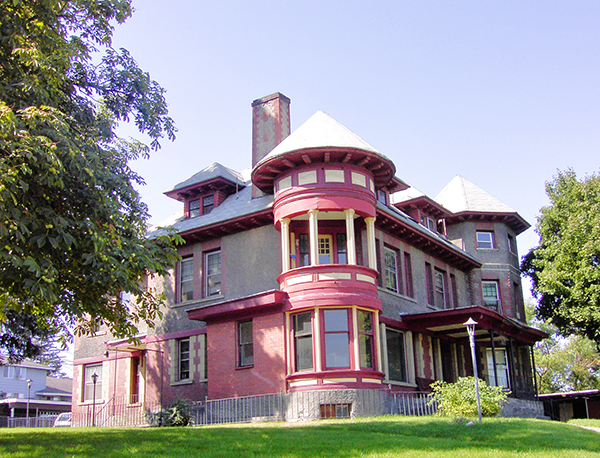
PhotoTitle: Leo and Katie Long House
PhotoAttribution: Spokane City/County Historic Preservation Office
Listing Status: Spokane Register
URL: http://properties.historicspokane.org/property/?PropertyID=1864
Display Marker: large_yellow
Title: Long House
Description: Date Built: 1899
Architect: Albert Held
Common Name: Leo and Katie Long House
As one of the largest historic landmark residences in Spokane, the brick-and-stucco Leo and Katie Long House is a high-style example of the Queen Anne tradition with French Eclectic and Tudor Revival-style influence. The two-and-one-half-story home commands a panoramic view of north Spokane from a steep hillside site in the Second Railroad Addition on the South Hill. The home is characterized by typical Queen Anne-style features including an irregular footprint, an irregular steeply pitched hip roof, multiple dormers and bays, and two full-height towers.
Location: 47.65107, -117.4315
Address: 1305 West 5th Avenue, Spokane WA 99204
PhotoURL:

PhotoTitle: Leo and Katie Long House
PhotoAttribution: Spokane City/County Historic Preservation Office
Listing Status: Spokane Register
URL: http://properties.historicspokane.org/property/?PropertyID=1864
Display Marker: large_yellow
ID: 192
Title: Lorraine Hotel
Description: Date Built: 1909
Architect: Loren L. Rand
Common Name: Denver Apartments
The Lorraine Hotel, a single room occupancy hotel (SRO), was constructed during the city's most significant period of growth. As the nearest SRO hotel to the Northern Pacific Passenger Depot, the Lorraine provided lodging for working class clientele, perhaps new residents to Spokane, many of whom stepped off the train at that very depot. The Lorraine, known as the Denver Apartments after 1943, operated continuously as a modest SRO until 1971 when the upper floors were vacated. The building was designed by Loren L. Rand, a prominent architect in the early decades of the twentieth century. Composed of brick terra cotta and molded sheet metal, the building is distinctively detailed and a good example of a well-designed small commercial building.
Location: 47.6568, -117.41655
Address: 308 West 1st Avenue, Spokane WA 99201
PhotoURL: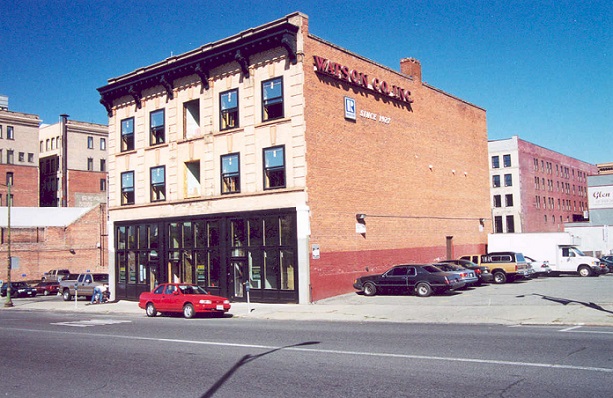
PhotoTitle: The Lorraine Hotel
PhotoAttribution: Spokane City/County Historic Preservation Office
Listing Status: Spokane Register, National Register
URL: http://properties.historicspokane.org/property/?PropertyID=1865
Display Marker: large_yellow
Title: Lorraine Hotel
Description: Date Built: 1909
Architect: Loren L. Rand
Common Name: Denver Apartments
The Lorraine Hotel, a single room occupancy hotel (SRO), was constructed during the city's most significant period of growth. As the nearest SRO hotel to the Northern Pacific Passenger Depot, the Lorraine provided lodging for working class clientele, perhaps new residents to Spokane, many of whom stepped off the train at that very depot. The Lorraine, known as the Denver Apartments after 1943, operated continuously as a modest SRO until 1971 when the upper floors were vacated. The building was designed by Loren L. Rand, a prominent architect in the early decades of the twentieth century. Composed of brick terra cotta and molded sheet metal, the building is distinctively detailed and a good example of a well-designed small commercial building.
Location: 47.6568, -117.41655
Address: 308 West 1st Avenue, Spokane WA 99201
PhotoURL:

PhotoTitle: The Lorraine Hotel
PhotoAttribution: Spokane City/County Historic Preservation Office
Listing Status: Spokane Register, National Register
URL: http://properties.historicspokane.org/property/?PropertyID=1865
Display Marker: large_yellow
ID: 193
Title: Lyons House
Description: Date Built: 1910
Architect: Ballard Plannery/ Wade H. Corbett
Common Name: Lyons/Norman House
The Lyons house is a significant example of the American Four Square form executed with Classical design elements. The house possesses a hipped, pyramidal roof in the Four Square tradition, wide eaves, and well-crafted details like the fish scale patterning on the dormers. Designed by the architecture firm, Ballard Plannery, the Lyons house plan was one of several that a customer could select or combine in order to construct their "dream home." Arthur G. Lyons, an employment agent, had the home built by local contractor Wade H. Corbett in 1910 but by 1921 the house was occupied by restauranteur, John W. Walsh, and his wife, Helen.
Location: 47.66772, -117.45536
Address: 2935 West Boone Avenue, Spokane WA 99201
PhotoURL: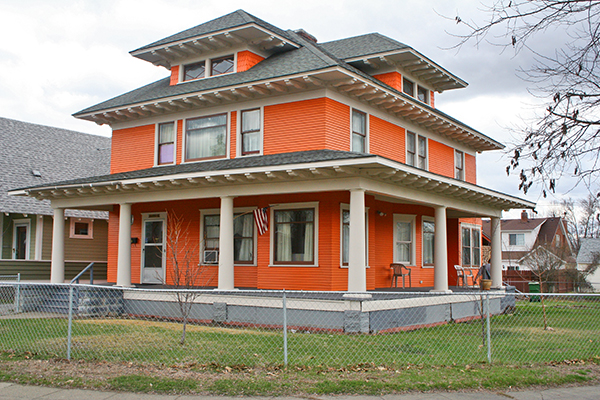
PhotoTitle: Lyons House
PhotoAttribution: Spokane City/County Historic Preservation Office
Listing Status: Spokane Register
URL: http://properties.historicspokane.org/property/?PropertyID=1866
Display Marker: large_yellow
Title: Lyons House
Description: Date Built: 1910
Architect: Ballard Plannery/ Wade H. Corbett
Common Name: Lyons/Norman House
The Lyons house is a significant example of the American Four Square form executed with Classical design elements. The house possesses a hipped, pyramidal roof in the Four Square tradition, wide eaves, and well-crafted details like the fish scale patterning on the dormers. Designed by the architecture firm, Ballard Plannery, the Lyons house plan was one of several that a customer could select or combine in order to construct their "dream home." Arthur G. Lyons, an employment agent, had the home built by local contractor Wade H. Corbett in 1910 but by 1921 the house was occupied by restauranteur, John W. Walsh, and his wife, Helen.
Location: 47.66772, -117.45536
Address: 2935 West Boone Avenue, Spokane WA 99201
PhotoURL:

PhotoTitle: Lyons House
PhotoAttribution: Spokane City/County Historic Preservation Office
Listing Status: Spokane Register
URL: http://properties.historicspokane.org/property/?PropertyID=1866
Display Marker: large_yellow
ID: 194
Title: Mack-Kane House
Description: Date Built: 1912
Architect: Ivan H. Abraham (builder)
Common Name: Mack-Kane House
Built in 1912, the Mack-Kane House is an excellent example of a Craftsman Style bungalow. The house is distinguished by a unique design, an original garage that echoes the quality, materials, and architectural elements of the house and by grounds and a basalt rock wall remnants that accentuate the property. The home was built for Spokane attorney, Mansfield Mack, and erected by Ivan Abraham, an accomplished Spokane builder who constructed several other homes in the Rockwood District. The house was later home for nearly 60 years to Spokane furniture maker Owen Kane and his daughter Katherine. Unusual for its four front-facing gables and facade design and for its "artistic" interpretation of the identifying features of the Craftsman Style, the home retains excellent integrity in all respects.
Location: 47.6334, -117.39933
Address: 734 East 23rd Avenue, Spokane WA 99203
PhotoURL: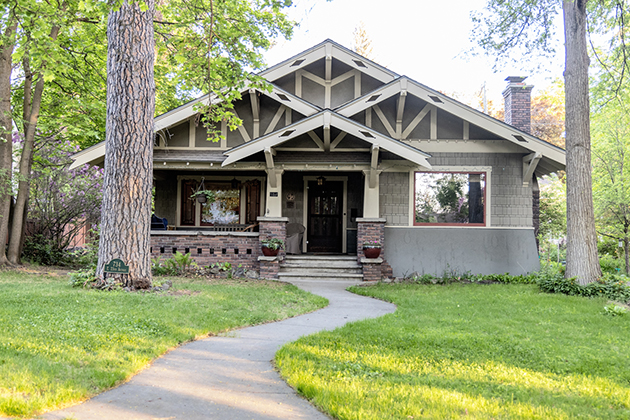
PhotoTitle: The Mack-Kane House
PhotoAttribution: Spokane City/County Historic Preservation Office
Listing Status: Spokane Register, National Register
URL: http://properties.historicspokane.org/property/?PropertyID=1868
Display Marker: large_yellow
Title: Mack-Kane House
Description: Date Built: 1912
Architect: Ivan H. Abraham (builder)
Common Name: Mack-Kane House
Built in 1912, the Mack-Kane House is an excellent example of a Craftsman Style bungalow. The house is distinguished by a unique design, an original garage that echoes the quality, materials, and architectural elements of the house and by grounds and a basalt rock wall remnants that accentuate the property. The home was built for Spokane attorney, Mansfield Mack, and erected by Ivan Abraham, an accomplished Spokane builder who constructed several other homes in the Rockwood District. The house was later home for nearly 60 years to Spokane furniture maker Owen Kane and his daughter Katherine. Unusual for its four front-facing gables and facade design and for its "artistic" interpretation of the identifying features of the Craftsman Style, the home retains excellent integrity in all respects.
Location: 47.6334, -117.39933
Address: 734 East 23rd Avenue, Spokane WA 99203
PhotoURL:

PhotoTitle: The Mack-Kane House
PhotoAttribution: Spokane City/County Historic Preservation Office
Listing Status: Spokane Register, National Register
URL: http://properties.historicspokane.org/property/?PropertyID=1868
Display Marker: large_yellow
ID: 195
Title: MacLeod House
Description: Date Built: 1902
Architect: Unknown
Common Name: Lillian Conn Antiques
Built in 1902, the Alex and Addie MacLeod House is an excellent example of the Free Classic subtype of the Queen Anne style. Located north of downtown Spokane in the Mountain View Addition of the city's West Central neighborhood, the house is one of few homes in the area featuring brick masonry construction and a full-width front porch with a hexagonal porch turret. The MacLeod House is well-preserved and conveys building techniques, materials, workmanship, and designs popularized by the Queen Anne style in Spokane during the late 1890s and early 1900s.
Location: 47.67285, -117.42695
Address: 1001 West Augusta Avenue, Spokane WA 99205
PhotoURL: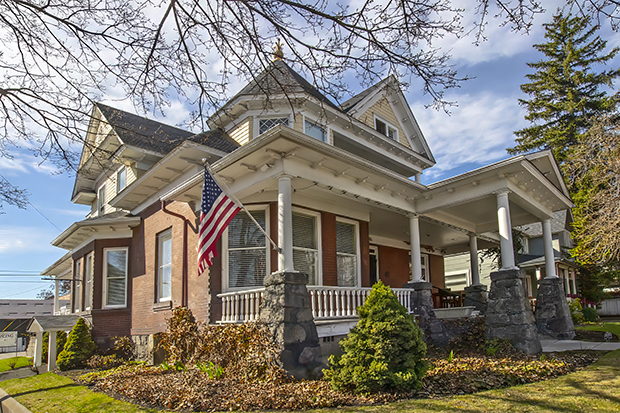
PhotoTitle: The MacLeod House
PhotoAttribution: Spokane City/County Historic Preservation Office
Listing Status: Spokane Register
URL: http://properties.historicspokane.org/property/?PropertyID=1867
Display Marker: large_yellow
Title: MacLeod House
Description: Date Built: 1902
Architect: Unknown
Common Name: Lillian Conn Antiques
Built in 1902, the Alex and Addie MacLeod House is an excellent example of the Free Classic subtype of the Queen Anne style. Located north of downtown Spokane in the Mountain View Addition of the city's West Central neighborhood, the house is one of few homes in the area featuring brick masonry construction and a full-width front porch with a hexagonal porch turret. The MacLeod House is well-preserved and conveys building techniques, materials, workmanship, and designs popularized by the Queen Anne style in Spokane during the late 1890s and early 1900s.
Location: 47.67285, -117.42695
Address: 1001 West Augusta Avenue, Spokane WA 99205
PhotoURL:

PhotoTitle: The MacLeod House
PhotoAttribution: Spokane City/County Historic Preservation Office
Listing Status: Spokane Register
URL: http://properties.historicspokane.org/property/?PropertyID=1867
Display Marker: large_yellow
ID: 196
Title: Malmgren House
Description: Date Built: 1910
Architect: Kirtland K. Cutter & Karl Malmgren
Common Name: Karl Malmgren House
Karl Malmgren, the architect and original owner of the house, was a partner in the noted firm of Cutter and Malmgren between 1894 and 1917. Cutter and Malmgren was one of the most prolific and prestigious partnerships in the Northwest and their designs remain well respected. Their many commissions included the Amasa Campbell House, the Patrick (Patsy) Clark Mansion, the Davenport Hotel and numerous other prominent residences and structures in the Spokane area and elsewhere. As the architect's private residence, the Malmgren House provides a particularly unique reflection of this firm's architectural abilities and interests. Completed in 1910, the house was executed on a grand scale and reflects Malmgren's own adaptation of Craftsman Style principles. The liberal use of wood, basalt rock, tile, chimneypieces, window seats and built-in furnishings was intended to make each room seem complete before any furniture was added. The home retains excellent integrity and is significant both in its association with Cutter and Malmgren and as an interesting example of the Craftsman Style of architecture.
Location: 47.64646, -117.42148
Address: 709 West Sumner Avenue, Spokane WA 99204
PhotoURL: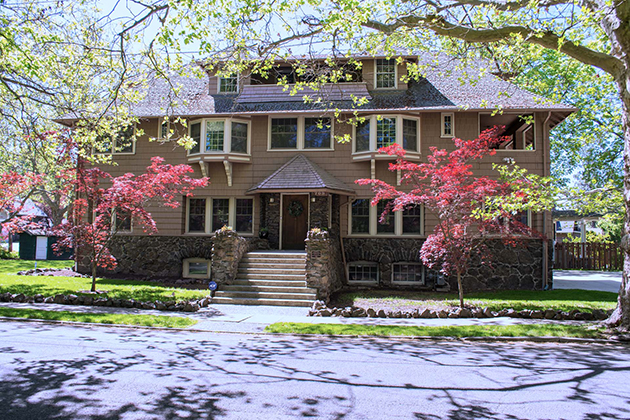
PhotoTitle: The Karl Malmgren House
PhotoAttribution: Spokane City/County Historic Preservation Office
Listing Status: Spokane Register, National Register
URL: http://properties.historicspokane.org/property/?PropertyID=1869
Display Marker: large_yellow
Title: Malmgren House
Description: Date Built: 1910
Architect: Kirtland K. Cutter & Karl Malmgren
Common Name: Karl Malmgren House
Karl Malmgren, the architect and original owner of the house, was a partner in the noted firm of Cutter and Malmgren between 1894 and 1917. Cutter and Malmgren was one of the most prolific and prestigious partnerships in the Northwest and their designs remain well respected. Their many commissions included the Amasa Campbell House, the Patrick (Patsy) Clark Mansion, the Davenport Hotel and numerous other prominent residences and structures in the Spokane area and elsewhere. As the architect's private residence, the Malmgren House provides a particularly unique reflection of this firm's architectural abilities and interests. Completed in 1910, the house was executed on a grand scale and reflects Malmgren's own adaptation of Craftsman Style principles. The liberal use of wood, basalt rock, tile, chimneypieces, window seats and built-in furnishings was intended to make each room seem complete before any furniture was added. The home retains excellent integrity and is significant both in its association with Cutter and Malmgren and as an interesting example of the Craftsman Style of architecture.
Location: 47.64646, -117.42148
Address: 709 West Sumner Avenue, Spokane WA 99204
PhotoURL:

PhotoTitle: The Karl Malmgren House
PhotoAttribution: Spokane City/County Historic Preservation Office
Listing Status: Spokane Register, National Register
URL: http://properties.historicspokane.org/property/?PropertyID=1869
Display Marker: large_yellow
ID: 197
Title: Marlboro Apartments
Description: Date Built: 1908
Architect: W.W. Hyslop
Common Name: Marlboro Apartments
Noted Spokane architect, W. W. Hyslop, designed the Marlboro Apartments in 1908 for Joseph Kellner and his wife Bertha and it remains one of the best preserved apartment buildings in Browne's Addition. The Marlboro Apartments was built as a luxury apartment building along with similar multi-family apartments in Browne's Addition including the Avenida Apartments, Westminster Apartments and the Elm Apartments, also designed by W. W. Hyslop.
Location: 47.65482, -117.44185
Address: 180 South Cannon Street, Spokane WA 99201
PhotoURL: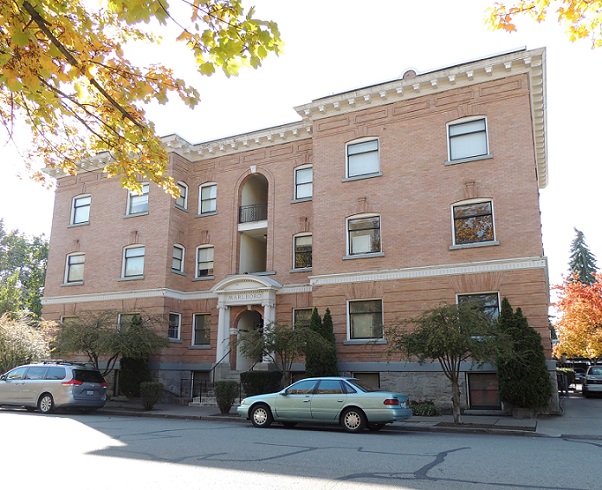
PhotoTitle: The Marlboro Apartments
PhotoAttribution: Spokane City/County Historic Preservation Office
Listing Status: Spokane Register
URL: http://properties.historicspokane.org/property/?PropertyID=1870
Display Marker: large_yellow
Title: Marlboro Apartments
Description: Date Built: 1908
Architect: W.W. Hyslop
Common Name: Marlboro Apartments
Noted Spokane architect, W. W. Hyslop, designed the Marlboro Apartments in 1908 for Joseph Kellner and his wife Bertha and it remains one of the best preserved apartment buildings in Browne's Addition. The Marlboro Apartments was built as a luxury apartment building along with similar multi-family apartments in Browne's Addition including the Avenida Apartments, Westminster Apartments and the Elm Apartments, also designed by W. W. Hyslop.
Location: 47.65482, -117.44185
Address: 180 South Cannon Street, Spokane WA 99201
PhotoURL:

PhotoTitle: The Marlboro Apartments
PhotoAttribution: Spokane City/County Historic Preservation Office
Listing Status: Spokane Register
URL: http://properties.historicspokane.org/property/?PropertyID=1870
Display Marker: large_yellow
ID: 198
Title: Marr House
Description: Date Built: 1913
Architect: Frank G. Hutchinson/ George and William Sillman
Common Name: Charles E. Marr House
The Charles Edward Marr House is an excellent and well-preserved example of a Craftsman-style bungalow. The house features full-width front porch, decorative brackets, elaborate exposed rafter tails and twin gabled dormers clad with Tudoresque false half-timbering. Frank G. Hutchinson, an accomplished architect and delineator employed by prominent Spokane firms including Albert Held, Cutter and Malmgren, Hyslop and Westcott, and Jacques and Rantoul, designed the home. Spokane building contractors George and William Sillman built it during 1912 and 1913. They sold the home to Charles Marr in 1914. Marr, a keen businessman, became Spokane's first grocery store magnate and helped establish the first "self-service" Piggly Wiggly Stores and, later, the first Safeway supermarkets in the Spokane area. Beginning in 1909 with one market, Marr's burgeoning grocery empire grew to include 575 stores in four major cities and two states by 1929.
Location: 47.64114, -117.4146
Address: 204 West 16th Avenue, Spokane WA 99203
PhotoURL:
PhotoTitle: The Charles E. Marr House
PhotoAttribution: Spokane City/County Historic Preservation Office
Listing Status: Spokane Register
URL: http://properties.historicspokane.org/property/?PropertyID=1871
Display Marker: large_yellow
Title: Marr House
Description: Date Built: 1913
Architect: Frank G. Hutchinson/ George and William Sillman
Common Name: Charles E. Marr House
The Charles Edward Marr House is an excellent and well-preserved example of a Craftsman-style bungalow. The house features full-width front porch, decorative brackets, elaborate exposed rafter tails and twin gabled dormers clad with Tudoresque false half-timbering. Frank G. Hutchinson, an accomplished architect and delineator employed by prominent Spokane firms including Albert Held, Cutter and Malmgren, Hyslop and Westcott, and Jacques and Rantoul, designed the home. Spokane building contractors George and William Sillman built it during 1912 and 1913. They sold the home to Charles Marr in 1914. Marr, a keen businessman, became Spokane's first grocery store magnate and helped establish the first "self-service" Piggly Wiggly Stores and, later, the first Safeway supermarkets in the Spokane area. Beginning in 1909 with one market, Marr's burgeoning grocery empire grew to include 575 stores in four major cities and two states by 1929.
Location: 47.64114, -117.4146
Address: 204 West 16th Avenue, Spokane WA 99203
PhotoURL:

PhotoTitle: The Charles E. Marr House
PhotoAttribution: Spokane City/County Historic Preservation Office
Listing Status: Spokane Register
URL: http://properties.historicspokane.org/property/?PropertyID=1871
Display Marker: large_yellow
ID: 199
Title: Masonic Temple
Description: Date Built: 1905
Architect: Rand & Dow, Rigg & Van Tyne
Common Name: Masonic Center
The Masonic Temple is a significant example of Neo-Classical Revival architecture in Spokane. Considered one of the grandest fraternal lodges in the west, it exemplifies the disciplined classicism that evolved from the Beaux-Arts movement and the influence of the Columbian Exposition of 1893. A principal structure in the Riverside Avenue National Historic District, the Masonic Temple is representative of the City Beautiful movement as it was expressed in Spokane. Historically and architecturally significant, the building drew on the talents of many of Spokane's most influential and prominent citizens during its construction and development. It is a reflection of the importance of the fraternal and social organizations to the fabric of the community during its growing years. Originally completed in 1905, the Temple was the collaborative effort of two prominent Spokane architects, John K. Dow and Loren L. Rand.
Location: 47.65879, -117.42821
Address: 1108 West Riverside Avenue, Spokane WA 99201
PhotoURL: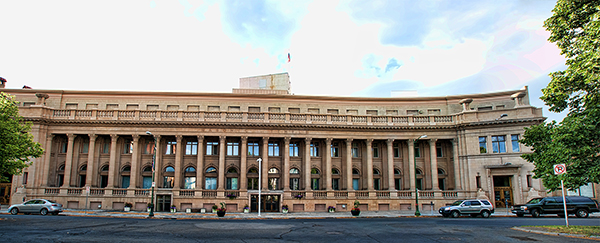
PhotoTitle: The Masonic Temple
PhotoAttribution: Spokane City/County Historic Preservation Office
Listing Status: Spokane Register
URL: http://properties.historicspokane.org/property/?PropertyID=1872
Display Marker: large_yellow
Title: Masonic Temple
Description: Date Built: 1905
Architect: Rand & Dow, Rigg & Van Tyne
Common Name: Masonic Center
The Masonic Temple is a significant example of Neo-Classical Revival architecture in Spokane. Considered one of the grandest fraternal lodges in the west, it exemplifies the disciplined classicism that evolved from the Beaux-Arts movement and the influence of the Columbian Exposition of 1893. A principal structure in the Riverside Avenue National Historic District, the Masonic Temple is representative of the City Beautiful movement as it was expressed in Spokane. Historically and architecturally significant, the building drew on the talents of many of Spokane's most influential and prominent citizens during its construction and development. It is a reflection of the importance of the fraternal and social organizations to the fabric of the community during its growing years. Originally completed in 1905, the Temple was the collaborative effort of two prominent Spokane architects, John K. Dow and Loren L. Rand.
Location: 47.65879, -117.42821
Address: 1108 West Riverside Avenue, Spokane WA 99201
PhotoURL:

PhotoTitle: The Masonic Temple
PhotoAttribution: Spokane City/County Historic Preservation Office
Listing Status: Spokane Register
URL: http://properties.historicspokane.org/property/?PropertyID=1872
Display Marker: large_yellow
ID: 200
Title: McCornack House
Description: Date Built: 1905
Architect: Unknown
Common Name: Dr. Peter McCornack House
Built in 1905, the McCornack House is one of Spokane's best examples of simple Colonial Revival style architecture and features a saltbox roof rarely seen in Spokane. The house was built for prominent Spokane pediatrician and Spokane County Medical Society president, Dr. Peter McCornack, and his wife, Jesse, who owned it for 30 years. The McCornack House retains excellent integrity and reveals early twentieth-century craftsmanship. It is historically significant for its association with the development of Spokane and the lower South Hill community surrounding Sacred Heart Medical Center.
Location: 47.6476, -117.40718
Address: 219 East 9th Avenue, Spokane WA 99202
PhotoURL: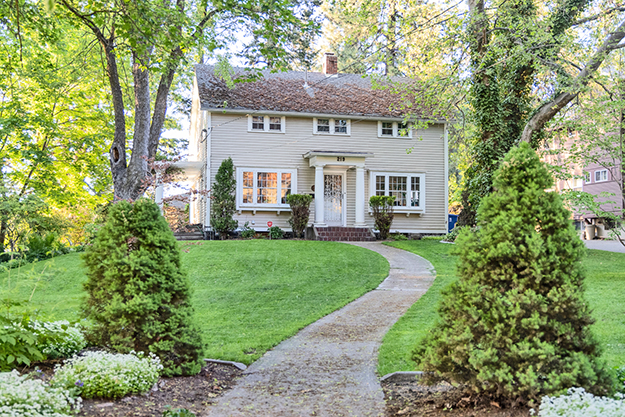
PhotoTitle: The Dr. Peter McCornack House
PhotoAttribution: Spokane City/County Historic Preservation Office
Listing Status: Spokane Register
URL: http://properties.historicspokane.org/property/?PropertyID=1873
Display Marker: large_yellow
Title: McCornack House
Description: Date Built: 1905
Architect: Unknown
Common Name: Dr. Peter McCornack House
Built in 1905, the McCornack House is one of Spokane's best examples of simple Colonial Revival style architecture and features a saltbox roof rarely seen in Spokane. The house was built for prominent Spokane pediatrician and Spokane County Medical Society president, Dr. Peter McCornack, and his wife, Jesse, who owned it for 30 years. The McCornack House retains excellent integrity and reveals early twentieth-century craftsmanship. It is historically significant for its association with the development of Spokane and the lower South Hill community surrounding Sacred Heart Medical Center.
Location: 47.6476, -117.40718
Address: 219 East 9th Avenue, Spokane WA 99202
PhotoURL:

PhotoTitle: The Dr. Peter McCornack House
PhotoAttribution: Spokane City/County Historic Preservation Office
Listing Status: Spokane Register
URL: http://properties.historicspokane.org/property/?PropertyID=1873
Display Marker: large_yellow
ID: 201
Title: McCroskey House
Description: Date Built: 1923
Architect: Kirtland K. Cutter
Common Name: Floyd McCroskey House
The McCrosky House is presumed to be the last residence in Spokane designed by the city's most renowned architect, Kirtland Kelsey Cutter. It was built in 1923 for Floyd McCroskey, a prominent Spokane life insurance underwriter. The land was a wedding gift to McCroskey and his wife from her parents, the Kemps, owners of the Kemp & Hebert Department Store. Located in the Marycliff-Cliff Park Historic District, the home was designed in the Spanish Colonial Revival style and represents an important transition in the development of Cutter's works, reflecting the influence of his increasing connections to Southern California and the architectural styles prevalent there. Cutter moved to California in 1923.
Location: 47.64601, -117.41775
Address: 414 West Sumner Avenue, Spokane WA 99204
PhotoURL: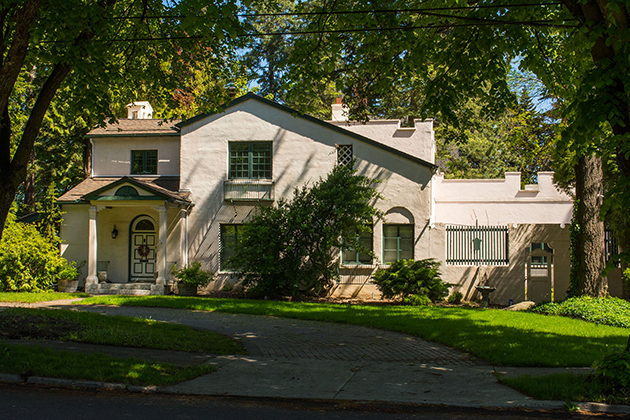
PhotoTitle: The Floyd McCroskey House
PhotoAttribution: Spokane City/County Historic Preservation Office
Listing Status: Spokane Register, National Register
URL: http://properties.historicspokane.org/property/?PropertyID=1874
Display Marker: large_yellow
Title: McCroskey House
Description: Date Built: 1923
Architect: Kirtland K. Cutter
Common Name: Floyd McCroskey House
The McCrosky House is presumed to be the last residence in Spokane designed by the city's most renowned architect, Kirtland Kelsey Cutter. It was built in 1923 for Floyd McCroskey, a prominent Spokane life insurance underwriter. The land was a wedding gift to McCroskey and his wife from her parents, the Kemps, owners of the Kemp & Hebert Department Store. Located in the Marycliff-Cliff Park Historic District, the home was designed in the Spanish Colonial Revival style and represents an important transition in the development of Cutter's works, reflecting the influence of his increasing connections to Southern California and the architectural styles prevalent there. Cutter moved to California in 1923.
Location: 47.64601, -117.41775
Address: 414 West Sumner Avenue, Spokane WA 99204
PhotoURL:

PhotoTitle: The Floyd McCroskey House
PhotoAttribution: Spokane City/County Historic Preservation Office
Listing Status: Spokane Register, National Register
URL: http://properties.historicspokane.org/property/?PropertyID=1874
Display Marker: large_yellow
ID: 203
Title: Mele House
Description: Date Built: 1923
Architect: Unknown
Common Name: Mele House
Constructed in 1923, the Mele House was built during the second phase of single-family construction along East Mission Avenue, between the 200 and 800 block, in what is today identified as the Mission Historic District. The house is an excellent example of the Craftsman style and was constructed for Pasquale (Peter) and Rosina (Rose) Mele, although it was occupied by numerous family members through the years. Peter sold produce as part of the Mele and Son fruit and produce company located in the old Washington Market and later the Central Market, originally located on Main Street. The home remained in the Mele family until 1990. During the property's period of significance from 1923 to 1990, the Mele House achieved historic significance for its association with the architectural development and settlement of the Logan Neighborhood, specifically along East Mission Avenue, and is additionally architecturally significant as an example of the Craftsman style.
Location: 47.67138, -117.40598
Address: 302 East Mission Avenue, Spokane WA 99202
PhotoURL: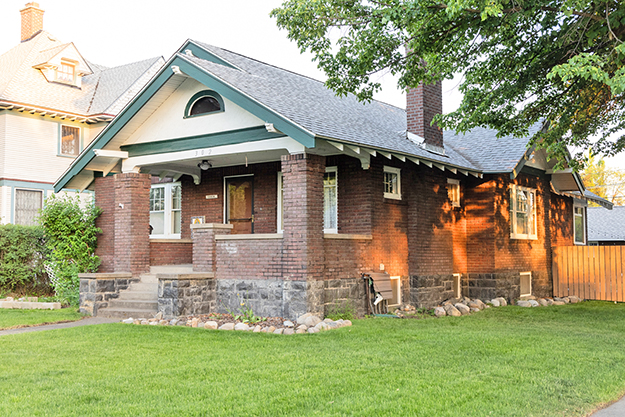
PhotoTitle: The Mele Hosue
PhotoAttribution: Spokane City/County Historic Preservation Office
Listing Status: Spokane Register
URL: http://properties.historicspokane.org/property/?PropertyID=1876
Display Marker: large_yellow
Title: Mele House
Description: Date Built: 1923
Architect: Unknown
Common Name: Mele House
Constructed in 1923, the Mele House was built during the second phase of single-family construction along East Mission Avenue, between the 200 and 800 block, in what is today identified as the Mission Historic District. The house is an excellent example of the Craftsman style and was constructed for Pasquale (Peter) and Rosina (Rose) Mele, although it was occupied by numerous family members through the years. Peter sold produce as part of the Mele and Son fruit and produce company located in the old Washington Market and later the Central Market, originally located on Main Street. The home remained in the Mele family until 1990. During the property's period of significance from 1923 to 1990, the Mele House achieved historic significance for its association with the architectural development and settlement of the Logan Neighborhood, specifically along East Mission Avenue, and is additionally architecturally significant as an example of the Craftsman style.
Location: 47.67138, -117.40598
Address: 302 East Mission Avenue, Spokane WA 99202
PhotoURL:

PhotoTitle: The Mele Hosue
PhotoAttribution: Spokane City/County Historic Preservation Office
Listing Status: Spokane Register
URL: http://properties.historicspokane.org/property/?PropertyID=1876
Display Marker: large_yellow
ID: 204
Title: Merrill-Edmunds House (demolished)
Description: Date Built: 1904
Architect: W.W. Hyslop
Common Name: Merill-Edmunds House
The historic Merrill-Edmunds House was demolished in September, 2007. The existing structure at this address is not listed on a historic register. The Merrill-Edmunds House is a fine example of a Craftsman-style bungalow and is one of few early twentieth-century homes in town located along the Spokane River. Built in 1904, the house was designed by prominent Spokane architect W. W. Hyslop for Fred S. Merrill and his wife, Annie, owners of the Merrill Typewriter Supply and Repair Company. The house was later the home of Washington Water Power inspector, Francis Edmunds, and his family for more than 50 years. It was architecturally significant as a good representation of the Craftsman style and for its association with master craftsman W. W. Hyslop.
Location: 47.66736, -117.46156
Address: 1105 North Evergreen Street, Spokane WA 99201
PhotoURL:
PhotoTitle: The once-standing Merrill-Edmunds House
PhotoAttribution: Spokane City/County Historic Preservation Office
Listing Status: N/A
URL: http://properties.historicspokane.org/property/?PropertyID=1877
Display Marker: large_yellow
Title: Merrill-Edmunds House (demolished)
Description: Date Built: 1904
Architect: W.W. Hyslop
Common Name: Merill-Edmunds House
The historic Merrill-Edmunds House was demolished in September, 2007. The existing structure at this address is not listed on a historic register. The Merrill-Edmunds House is a fine example of a Craftsman-style bungalow and is one of few early twentieth-century homes in town located along the Spokane River. Built in 1904, the house was designed by prominent Spokane architect W. W. Hyslop for Fred S. Merrill and his wife, Annie, owners of the Merrill Typewriter Supply and Repair Company. The house was later the home of Washington Water Power inspector, Francis Edmunds, and his family for more than 50 years. It was architecturally significant as a good representation of the Craftsman style and for its association with master craftsman W. W. Hyslop.
Location: 47.66736, -117.46156
Address: 1105 North Evergreen Street, Spokane WA 99201
PhotoURL:

PhotoTitle: The once-standing Merrill-Edmunds House
PhotoAttribution: Spokane City/County Historic Preservation Office
Listing Status: N/A
URL: http://properties.historicspokane.org/property/?PropertyID=1877
Display Marker: large_yellow
ID: 205
Title: Metropole Apartments
Description: Date Built: 1901
Architect: Charles F. White
Common Name: Metropole Apartments
The Metropole Apartment Building was constructed during the city's most significant period of growth, 1900 to 1910. With commercial uses on the ground floor and apartments on the upper floors, the Metropole provided lodging for working class clientele in the growing downtown and it has operated continuously as an apartment building from its construction in 1901 to present day. Charles F. White designed the vernacular brick building which retains its original architectural character as well as the characteristics features of a downtown commercial apartment building. The Metropole maintains exterior integrity in its nicely detailed and well preserved facade. In its role as a Single Room Occupant (SRO) hotel during this era, the Metropole was more elaborate in that each unit had a kitchen and a bathroom. The units were intended for more permanent clientele as well as families.
Location: 47.6547, -117.42134
Address: 178 1/2 South Howard Street, Spokane WA 99201
PhotoURL: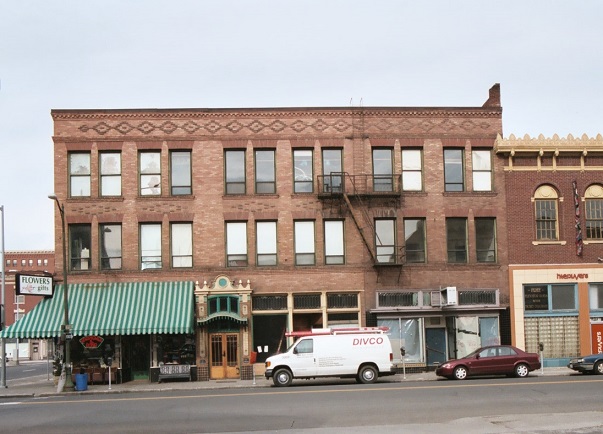
PhotoTitle: 2006 view of the fabulous Metropole Apartments
PhotoAttribution: Spokane City/County Historic Preservation Office
Listing Status: Spokane Register, National Register
URL: http://properties.historicspokane.org/property/?PropertyID=1878
Display Marker: large_yellow
Title: Metropole Apartments
Description: Date Built: 1901
Architect: Charles F. White
Common Name: Metropole Apartments
The Metropole Apartment Building was constructed during the city's most significant period of growth, 1900 to 1910. With commercial uses on the ground floor and apartments on the upper floors, the Metropole provided lodging for working class clientele in the growing downtown and it has operated continuously as an apartment building from its construction in 1901 to present day. Charles F. White designed the vernacular brick building which retains its original architectural character as well as the characteristics features of a downtown commercial apartment building. The Metropole maintains exterior integrity in its nicely detailed and well preserved facade. In its role as a Single Room Occupant (SRO) hotel during this era, the Metropole was more elaborate in that each unit had a kitchen and a bathroom. The units were intended for more permanent clientele as well as families.
Location: 47.6547, -117.42134
Address: 178 1/2 South Howard Street, Spokane WA 99201
PhotoURL:

PhotoTitle: 2006 view of the fabulous Metropole Apartments
PhotoAttribution: Spokane City/County Historic Preservation Office
Listing Status: Spokane Register, National Register
URL: http://properties.historicspokane.org/property/?PropertyID=1878
Display Marker: large_yellow
ID: 206
Title: Miley House
Description: Date Built: 1901
Architect: Unknown
Common Name: Lucius and Anna Miley House
The Miley house is a significant example of a Queen Anne eclectic dwelling in Spokane. Constructed during a period of tremendous change and rapid growth in Spokane, this dwelling combines several distinctive styles to create a unique expression of architectural eclecticism and the changing stylistic expressions of the day. Despite falling into disrepair and undergoing a number of renovations and restorations, the house remains in character and appearance, by all accounts, nearly the same as it was originally designed.
Location: 47.68004, -117.3841
Address: 1713 East Illinois Avenue, Spokane WA 99207
PhotoURL: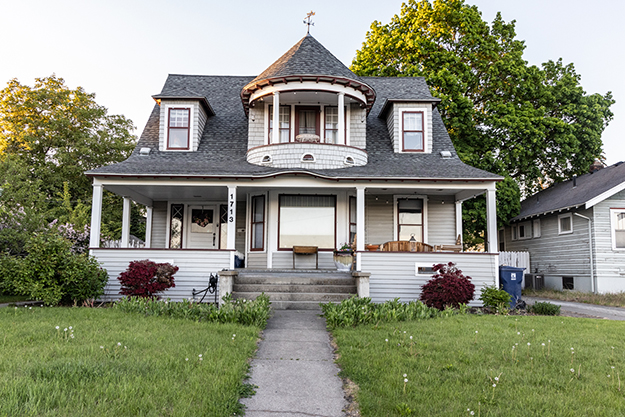
PhotoTitle: Just being Miley House
PhotoAttribution: Spokane City/County Historic Preservation Office
Listing Status: Spokane Register
URL: http://properties.historicspokane.org/property/?PropertyID=2053
Display Marker: large_yellow
Title: Miley House
Description: Date Built: 1901
Architect: Unknown
Common Name: Lucius and Anna Miley House
The Miley house is a significant example of a Queen Anne eclectic dwelling in Spokane. Constructed during a period of tremendous change and rapid growth in Spokane, this dwelling combines several distinctive styles to create a unique expression of architectural eclecticism and the changing stylistic expressions of the day. Despite falling into disrepair and undergoing a number of renovations and restorations, the house remains in character and appearance, by all accounts, nearly the same as it was originally designed.
Location: 47.68004, -117.3841
Address: 1713 East Illinois Avenue, Spokane WA 99207
PhotoURL:

PhotoTitle: Just being Miley House
PhotoAttribution: Spokane City/County Historic Preservation Office
Listing Status: Spokane Register
URL: http://properties.historicspokane.org/property/?PropertyID=2053
Display Marker: large_yellow
ID: 207
Title: Miller Building
Description: Date Built: 1890
Architect: William J. Carpenter
Common Name: Hotel Lusso
The Miller Building is significant for both its architecture and its role in Spokane's emergence as the urban center of the Inland Empire. Designed by architect William Carpenter, it was built shortly after the Great Fire of 1889 and is one of the last remaining examples of his important contribution to Spokane's Age of Elegance. The Miller Building's graceful brickwork and rich surface detail introduced to Spokane a form of Richardsonian Romanesque architecture that bore the imprint of the emerging Chicago School and Louis Sullivan. Occupying a particularly desirable location, the Miller Block also played a role in Spokane's economic successes in the decades of unparalleled growth that followed the fire. More recently, the building has been renovated and, together with the Whitten Block, next east, houses a luxury hotel, the Lusso.
Location: 47.657355, -117.423948
Address: 808 West Sprague Avenue, Spokane WA 99201
PhotoURL:
PhotoTitle: The Miller Building
PhotoAttribution: Spokane City/County Historic Preservation Office
Listing Status: Spokane Register, National Register
URL: http://properties.historicspokane.org/property/?PropertyID=1879
Display Marker: large_yellow
Title: Miller Building
Description: Date Built: 1890
Architect: William J. Carpenter
Common Name: Hotel Lusso
The Miller Building is significant for both its architecture and its role in Spokane's emergence as the urban center of the Inland Empire. Designed by architect William Carpenter, it was built shortly after the Great Fire of 1889 and is one of the last remaining examples of his important contribution to Spokane's Age of Elegance. The Miller Building's graceful brickwork and rich surface detail introduced to Spokane a form of Richardsonian Romanesque architecture that bore the imprint of the emerging Chicago School and Louis Sullivan. Occupying a particularly desirable location, the Miller Block also played a role in Spokane's economic successes in the decades of unparalleled growth that followed the fire. More recently, the building has been renovated and, together with the Whitten Block, next east, houses a luxury hotel, the Lusso.
Location: 47.657355, -117.423948
Address: 808 West Sprague Avenue, Spokane WA 99201
PhotoURL:

PhotoTitle: The Miller Building
PhotoAttribution: Spokane City/County Historic Preservation Office
Listing Status: Spokane Register, National Register
URL: http://properties.historicspokane.org/property/?PropertyID=1879
Display Marker: large_yellow
ID: 208
Title: Minthorn-Russel Block
Description: Date Built: 1903
Architect: Hillyard Townsite Company
Common Name: Minthorn-Russel Block
The two-story Minthorn-Russel Block has an arcaded corbel cornice and is divided into two bays by brick pilasters at the corners. The original storefront configuration is intact with two recessed entrances. A faded advertisement painted in 1903 is located on the north elevation of the building and reads, "Drugs, Russel Hotel, Rooms for Rent." The building was built for druggist Sherman Minthorn and for merchant Robert Russel with eight single-occupancy hotel rooms on the second floor known as the Russel Hotel. The Hillyard City Drug occupied the north storefront from 1903 to 1985 and the south storefront was occupied by the Buckley Clothes Shop. Beginning in 1935, the Capitol Bar occupied the south storefront.
Location: 47.70388, -117.36509
Address: 5015 North Market Street, Spokane WA 99217
PhotoURL: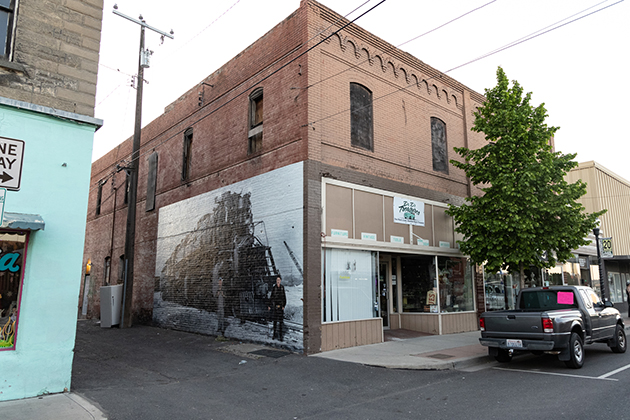
PhotoTitle: The Minthorn-Russel Block
PhotoAttribution: Spokane City/County Historic Preservation Office
Listing Status: Spokane Register, National Register
URL: http://properties.historicspokane.org/property/?PropertyID=1880
Display Marker: large_yellow
Title: Minthorn-Russel Block
Description: Date Built: 1903
Architect: Hillyard Townsite Company
Common Name: Minthorn-Russel Block
The two-story Minthorn-Russel Block has an arcaded corbel cornice and is divided into two bays by brick pilasters at the corners. The original storefront configuration is intact with two recessed entrances. A faded advertisement painted in 1903 is located on the north elevation of the building and reads, "Drugs, Russel Hotel, Rooms for Rent." The building was built for druggist Sherman Minthorn and for merchant Robert Russel with eight single-occupancy hotel rooms on the second floor known as the Russel Hotel. The Hillyard City Drug occupied the north storefront from 1903 to 1985 and the south storefront was occupied by the Buckley Clothes Shop. Beginning in 1935, the Capitol Bar occupied the south storefront.
Location: 47.70388, -117.36509
Address: 5015 North Market Street, Spokane WA 99217
PhotoURL:

PhotoTitle: The Minthorn-Russel Block
PhotoAttribution: Spokane City/County Historic Preservation Office
Listing Status: Spokane Register, National Register
URL: http://properties.historicspokane.org/property/?PropertyID=1880
Display Marker: large_yellow
ID: 209
Title: Moen House
Description: Date Built: 1938
Architect: Albert H. Funk
Common Name: Moen House
Designed by Albert H. Funk, the Moen House was built in 1938 as a single-family residence for Edward W. Moen, president of Moen-Leick Industries. The house illustrates the defining characteristics of the Art Moderne style: a molded concrete composition of stacked angular boxes with cut out corners, contrasted by streamlined rounded walls with wrapped steel sash in horizontal arrangement. Smooth white concrete walls in a single story step back asymmetrically in crisp rectangular blocks and streamlined curves segment the horizontal massing of the first floor. The Moen House is an imposing, stylish and rare contribution to the Rockwood neighborhood and, indeed, Spokane itself.
Location: 47.62929, -117.39879
Address: 810 East 28th Avenue, Spokane WA 99203
PhotoURL: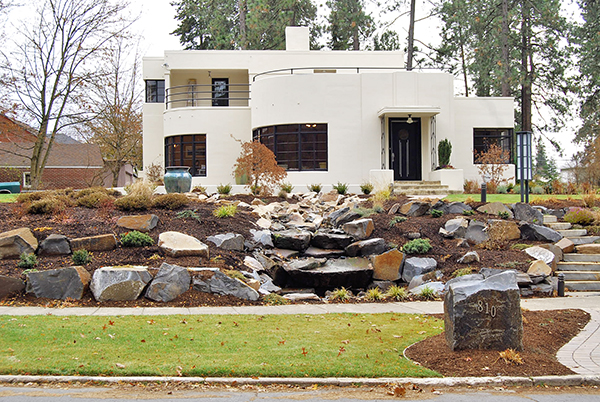
PhotoTitle: The Moen House
PhotoAttribution: Spokane City/County Historic Preservation Office
Listing Status: Spokane Register, National Register
URL: http://properties.historicspokane.org/property/?PropertyID=1881
Display Marker: large_yellow
Title: Moen House
Description: Date Built: 1938
Architect: Albert H. Funk
Common Name: Moen House
Designed by Albert H. Funk, the Moen House was built in 1938 as a single-family residence for Edward W. Moen, president of Moen-Leick Industries. The house illustrates the defining characteristics of the Art Moderne style: a molded concrete composition of stacked angular boxes with cut out corners, contrasted by streamlined rounded walls with wrapped steel sash in horizontal arrangement. Smooth white concrete walls in a single story step back asymmetrically in crisp rectangular blocks and streamlined curves segment the horizontal massing of the first floor. The Moen House is an imposing, stylish and rare contribution to the Rockwood neighborhood and, indeed, Spokane itself.
Location: 47.62929, -117.39879
Address: 810 East 28th Avenue, Spokane WA 99203
PhotoURL:

PhotoTitle: The Moen House
PhotoAttribution: Spokane City/County Historic Preservation Office
Listing Status: Spokane Register, National Register
URL: http://properties.historicspokane.org/property/?PropertyID=1881
Display Marker: large_yellow
ID: 210
Title: Mohawk Building (demolished)
Description: Date Built: 1915
Architect: John K. Dow
Common Name: Mohawk Building
The historic Mohawk Building was demolished in the spring of 2007. No structure has been rebuilt on the site. Located in the heart of the central business district in downtown Spokane, the Mohawk Building was a seven-story steel frame structure with a flat roof and poured concrete foundation and was a good example of the Chicago School style. It was designed and built in 1915 to replace an earlier structure, of the same name, which was destroyed by a fire. The Dodson family, part owners and occupants of the original Mohawk Building, led the rebuilding efforts. It was architecturally significant as the work of master architect John K. Dow and for the high artistic values that his work conveys, especially in its terra cotta detailing, produced by the Washington Brick, Lime & Mfg. Co. It was also significant for its long association with the business community and its importance in Spokane's emergence as a regional distribution hub.
Location: 47.65767, -117.42019
Address: 509 West Riverside Avenue, Spokane WA 99201
PhotoURL: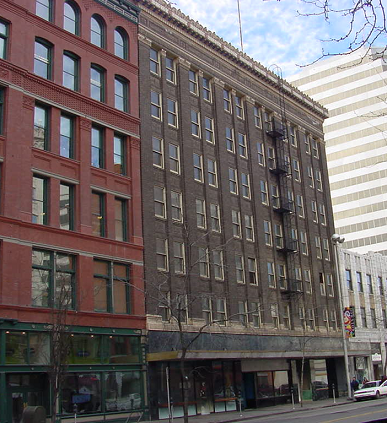
PhotoTitle: The once-standing Mohawk Building
PhotoAttribution: Spokane City/County Historic Preservation Office
Listing Status: N/A
URL: http://properties.historicspokane.org/property/?PropertyID=2064
Display Marker: large_yellow
Title: Mohawk Building (demolished)
Description: Date Built: 1915
Architect: John K. Dow
Common Name: Mohawk Building
The historic Mohawk Building was demolished in the spring of 2007. No structure has been rebuilt on the site. Located in the heart of the central business district in downtown Spokane, the Mohawk Building was a seven-story steel frame structure with a flat roof and poured concrete foundation and was a good example of the Chicago School style. It was designed and built in 1915 to replace an earlier structure, of the same name, which was destroyed by a fire. The Dodson family, part owners and occupants of the original Mohawk Building, led the rebuilding efforts. It was architecturally significant as the work of master architect John K. Dow and for the high artistic values that his work conveys, especially in its terra cotta detailing, produced by the Washington Brick, Lime & Mfg. Co. It was also significant for its long association with the business community and its importance in Spokane's emergence as a regional distribution hub.
Location: 47.65767, -117.42019
Address: 509 West Riverside Avenue, Spokane WA 99201
PhotoURL:

PhotoTitle: The once-standing Mohawk Building
PhotoAttribution: Spokane City/County Historic Preservation Office
Listing Status: N/A
URL: http://properties.historicspokane.org/property/?PropertyID=2064
Display Marker: large_yellow
ID: 211
Title: Moldenhauer House
Description: Date Built: 1918
Architect: Unknown/ George Baker (builder)
Common Name: Hans Moldenhauer House
Built by George Baker for Francis J. Engel in 1918, the Moldenhauer House is architecturally significant as a fine example of an Arts and Crafts style bungalow. The home is especially significant, however, for its association with musicologist, Hans Moldenhauer. Moldenhauer fled Nazi Germany for New York with his Jewish wife Margot Kuhn. He moved to Spokane after a visit in 1939 and, after serving as a ski troop instructor at Camp Hale in Colorado, became the first student to attend Whitworth College under the GI Bill. Having divorced, he married Rosaleen Jackman, a former student and Red Cross nurse at Camp Hale. Together they founded the Spokane Conservatory of Music in their home at 808 S. Lincoln, where they amassed a world-renowned collection of musical documents.
Location: 47.64816, -117.42487
Address: 808 South Lincoln Street, Spokane WA 99204
PhotoURL: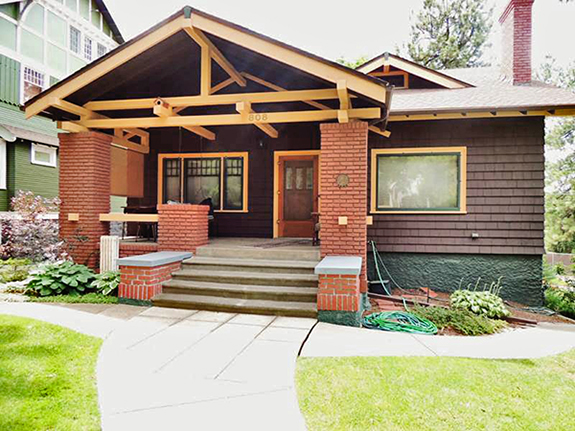
PhotoTitle: The Hans Moldenhauer House
PhotoAttribution: Spokane City/County Historic Preservation Office
Listing Status: Spokane Register
URL: http://properties.historicspokane.org/property/?PropertyID=1882
Display Marker: large_yellow
Title: Moldenhauer House
Description: Date Built: 1918
Architect: Unknown/ George Baker (builder)
Common Name: Hans Moldenhauer House
Built by George Baker for Francis J. Engel in 1918, the Moldenhauer House is architecturally significant as a fine example of an Arts and Crafts style bungalow. The home is especially significant, however, for its association with musicologist, Hans Moldenhauer. Moldenhauer fled Nazi Germany for New York with his Jewish wife Margot Kuhn. He moved to Spokane after a visit in 1939 and, after serving as a ski troop instructor at Camp Hale in Colorado, became the first student to attend Whitworth College under the GI Bill. Having divorced, he married Rosaleen Jackman, a former student and Red Cross nurse at Camp Hale. Together they founded the Spokane Conservatory of Music in their home at 808 S. Lincoln, where they amassed a world-renowned collection of musical documents.
Location: 47.64816, -117.42487
Address: 808 South Lincoln Street, Spokane WA 99204
PhotoURL:

PhotoTitle: The Hans Moldenhauer House
PhotoAttribution: Spokane City/County Historic Preservation Office
Listing Status: Spokane Register
URL: http://properties.historicspokane.org/property/?PropertyID=1882
Display Marker: large_yellow
ID: 212
Title: Monroe House
Description: Date Built: 1903
Architect: Unknown
Common Name: Levi Monroe House
Built in 1903 for Levi and Sara Monroe, the Monroe House is architecturally significant as an intact example of the Queen Anne style. The smaller house, now a duplex, was constructed in 1902 and served as home to the Monroes until the main house was completed; it then served as servants quarters. From 1902 to 1906, Monroe was the Livestock Editor of the Spokane Daily Chronicle and served as the Secretary of the Spokane Chamber of Commerce from 1906 to 1920. As a long-term officer there, he contributed to the planning and formation of early Spokane's business community. During the Depression, Monroe was the assistant to James O'Sullivan, Secretary of the Columbia Basin Commission. In this capacity, he worked with federal, state and local government officials in the planning of the Grand Coulee Dam.
Location: 47.65023, -117.43376
Address: 1427 West 6th Avenue, Spokane WA 99204
PhotoURL: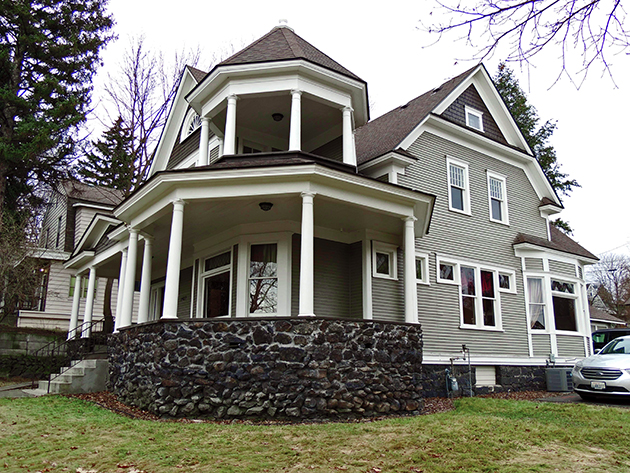
PhotoTitle: The Levi Monroe House
PhotoAttribution: Spokane City/County Historic Preservation Office
Listing Status: Spokane Register
URL: http://properties.historicspokane.org/property/?PropertyID=1884
Display Marker: large_yellow
Title: Monroe House
Description: Date Built: 1903
Architect: Unknown
Common Name: Levi Monroe House
Built in 1903 for Levi and Sara Monroe, the Monroe House is architecturally significant as an intact example of the Queen Anne style. The smaller house, now a duplex, was constructed in 1902 and served as home to the Monroes until the main house was completed; it then served as servants quarters. From 1902 to 1906, Monroe was the Livestock Editor of the Spokane Daily Chronicle and served as the Secretary of the Spokane Chamber of Commerce from 1906 to 1920. As a long-term officer there, he contributed to the planning and formation of early Spokane's business community. During the Depression, Monroe was the assistant to James O'Sullivan, Secretary of the Columbia Basin Commission. In this capacity, he worked with federal, state and local government officials in the planning of the Grand Coulee Dam.
Location: 47.65023, -117.43376
Address: 1427 West 6th Avenue, Spokane WA 99204
PhotoURL:

PhotoTitle: The Levi Monroe House
PhotoAttribution: Spokane City/County Historic Preservation Office
Listing Status: Spokane Register
URL: http://properties.historicspokane.org/property/?PropertyID=1884
Display Marker: large_yellow
ID: 213
Title: Monroe Street Bridge
Description: Date Built: 1910
Architect: Kirtland Cutter & Karl Malmgren (architects) and Ralston/McCarthy/Kennedy/Grieve/Cutter (engineers)
Common Name: Monroe Street Bridge
Spanning the Spokane River Gorge just below Spokane Falls, the Monroe Street Bridge is a city landmark. When the structure was completed in 1911, the 281-foot concrete central span was the largest in the United States, edging out Cleveland's Rocky River Bridge by a foot, and the third longest in the world. The design process for the bridge began in 1909 and building the grand triple-arched bridge was an arduous task. Laborers hired by the city (fully half the eventual cost of $535,000 went to wages) dangled above the rapids below on towers and cables, working to demolish the old steel bridge, constructed in 1891, and build cribbing for the new one. Shortly after demolition began, fill on the south bank collapsed, leading to the collapse of the old bridge. As the new bridge was being constructed, a violent windstorm destroyed weeks' worth of labor on the central arch. City engineer J. C. Ralston, with assistance from Morton McCarthy, J. F. Greene, and P. F. Kennedy, designed the structure. The design for the superstructure was prepared by Spokane's most celebrated firm of architects, Cutter and Malmgren. It reflects the city's pride in its pioneer heritage, with its western decorative motifs, including chain-shaped concrete ornamentation on the railings and four "covered wagon"-shaped pavilions adorned with cast-concrete bison skulls. Residents of Spokane, proud as they were of the grand new bridge, had to wait nearly 60 years to see it unobstructed. In 1914, just three years after it was built, the Union Pacific Railway built a trestle across and above it. The trestle was removed in 1973, in conjunction with preparations for the 1974 World's Fair held in Spokane. Listed on the National Register of Historic Places in 1975, all but the central span of the bridge was demolished and completely reconstructed starting in 2003. The bridge reopened in September 2005.
Location: 47.660747, -117.426703
Address: 218 North Monroe Street, Spokane WA 99201
PhotoURL: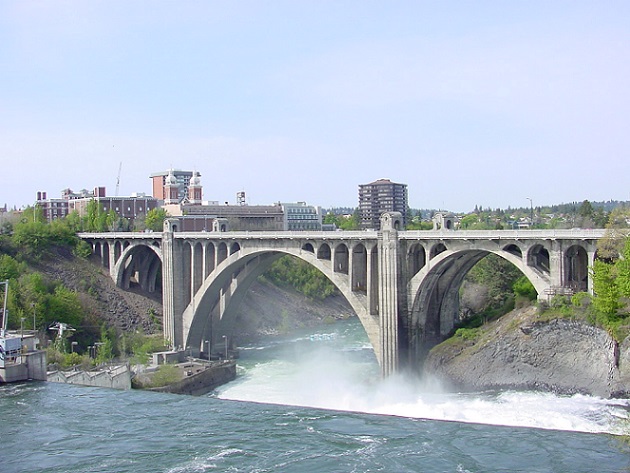
PhotoTitle: The Monroe Street Bridge
PhotoAttribution: Spokane City/County Historic Preservation Office
Listing Status: Spokane Register, National Register
URL: http://properties.historicspokane.org/property/?PropertyID=1883
Display Marker: large_yellow
Title: Monroe Street Bridge
Description: Date Built: 1910
Architect: Kirtland Cutter & Karl Malmgren (architects) and Ralston/McCarthy/Kennedy/Grieve/Cutter (engineers)
Common Name: Monroe Street Bridge
Spanning the Spokane River Gorge just below Spokane Falls, the Monroe Street Bridge is a city landmark. When the structure was completed in 1911, the 281-foot concrete central span was the largest in the United States, edging out Cleveland's Rocky River Bridge by a foot, and the third longest in the world. The design process for the bridge began in 1909 and building the grand triple-arched bridge was an arduous task. Laborers hired by the city (fully half the eventual cost of $535,000 went to wages) dangled above the rapids below on towers and cables, working to demolish the old steel bridge, constructed in 1891, and build cribbing for the new one. Shortly after demolition began, fill on the south bank collapsed, leading to the collapse of the old bridge. As the new bridge was being constructed, a violent windstorm destroyed weeks' worth of labor on the central arch. City engineer J. C. Ralston, with assistance from Morton McCarthy, J. F. Greene, and P. F. Kennedy, designed the structure. The design for the superstructure was prepared by Spokane's most celebrated firm of architects, Cutter and Malmgren. It reflects the city's pride in its pioneer heritage, with its western decorative motifs, including chain-shaped concrete ornamentation on the railings and four "covered wagon"-shaped pavilions adorned with cast-concrete bison skulls. Residents of Spokane, proud as they were of the grand new bridge, had to wait nearly 60 years to see it unobstructed. In 1914, just three years after it was built, the Union Pacific Railway built a trestle across and above it. The trestle was removed in 1973, in conjunction with preparations for the 1974 World's Fair held in Spokane. Listed on the National Register of Historic Places in 1975, all but the central span of the bridge was demolished and completely reconstructed starting in 2003. The bridge reopened in September 2005.
Location: 47.660747, -117.426703
Address: 218 North Monroe Street, Spokane WA 99201
PhotoURL:

PhotoTitle: The Monroe Street Bridge
PhotoAttribution: Spokane City/County Historic Preservation Office
Listing Status: Spokane Register, National Register
URL: http://properties.historicspokane.org/property/?PropertyID=1883
Display Marker: large_yellow
ID: 214
Title: Montgomery Ward Building
Description: Date Built: 1929
Architect: Montgomery Ward/ Wells Brothers
Common Name: Spokane City Hall
Designed by the Montgomery Ward Engineering Department and built by Wells Brothers of Chicago, the Montgomery Ward Building is historically as well as architecturally significant to the history of Spokane. The building occupies a spectacular site in the Central Business District overlooking the Lower Spokane Falls and River. The building represents an important chapter in the history of American commerce and stands as one of the first local examples of the Art Deco style that was popular, albeit briefly, across the nation at the time. The playfulness of the Art Deco style is lavishly employed in decorative floral panels and the color variation across the facade which was achieve with rose, ochre and green aggregate in the concrete mix. Montgomery Ward remained in the building until it moved to a new store on Division in 1978. The following year the City of Spokane purchased the building and converted it into the City Hall. Today, the third floor is home to the Historic Preservation Department!
Location: 47.660421, -117.424072
Address: 808 West Spokane Falls Boulevard, Spokane WA 99201
PhotoURL: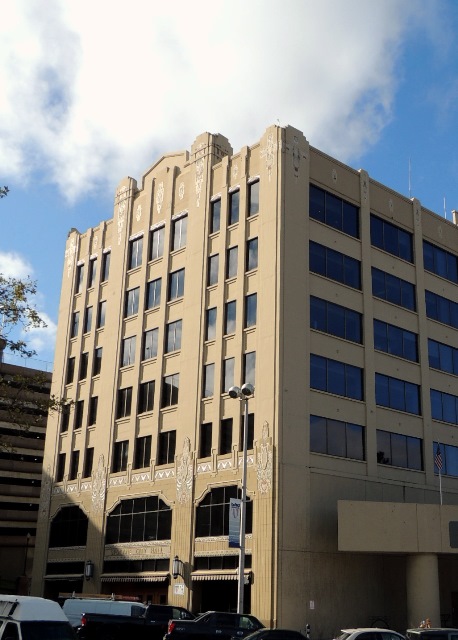
PhotoTitle: The Montgomery Ward Building
PhotoAttribution: Spokane City/County Historic Preservation Office
Listing Status: Spokane Register
URL: http://properties.historicspokane.org/property/?PropertyID=1885
Display Marker: large_yellow
Title: Montgomery Ward Building
Description: Date Built: 1929
Architect: Montgomery Ward/ Wells Brothers
Common Name: Spokane City Hall
Designed by the Montgomery Ward Engineering Department and built by Wells Brothers of Chicago, the Montgomery Ward Building is historically as well as architecturally significant to the history of Spokane. The building occupies a spectacular site in the Central Business District overlooking the Lower Spokane Falls and River. The building represents an important chapter in the history of American commerce and stands as one of the first local examples of the Art Deco style that was popular, albeit briefly, across the nation at the time. The playfulness of the Art Deco style is lavishly employed in decorative floral panels and the color variation across the facade which was achieve with rose, ochre and green aggregate in the concrete mix. Montgomery Ward remained in the building until it moved to a new store on Division in 1978. The following year the City of Spokane purchased the building and converted it into the City Hall. Today, the third floor is home to the Historic Preservation Department!
Location: 47.660421, -117.424072
Address: 808 West Spokane Falls Boulevard, Spokane WA 99201
PhotoURL:

PhotoTitle: The Montgomery Ward Building
PhotoAttribution: Spokane City/County Historic Preservation Office
Listing Status: Spokane Register
URL: http://properties.historicspokane.org/property/?PropertyID=1885
Display Marker: large_yellow
ID: 215
Title: Montvale Block
Description: Date Built: 1899
Architect: Unknown
Common Name: Montvale Hotel
Built in 1899 for business and civic leader, John W. Binkley, the Montvale Block is historically and architecturally significant as one of the oldest and best-preserved examples of a Single Room Occupancy Hotel. SROs were a type of working class housing popular in the decades around the turn of the twentieth century when Spokane experienced a tremendous building and population boom. Located on the southwest corner of First Avenue and South Monroe, the three-story Montvale Block is the cornerstone of a row of SRO hotels that line First Avenue for two blocks.
Location: 47.65623, -117.42689
Address: 1001 West 1st Avenue, Spokane WA 99201
PhotoURL: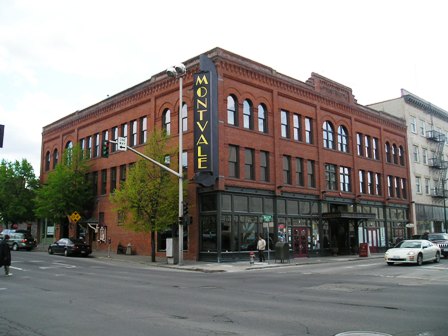
PhotoTitle: The Montvale Block
PhotoAttribution: Spokane City/County Historic Preservation Office
Listing Status: Spokane Register, National Register
URL: http://properties.historicspokane.org/property/?PropertyID=1886
Display Marker: large_yellow
Title: Montvale Block
Description: Date Built: 1899
Architect: Unknown
Common Name: Montvale Hotel
Built in 1899 for business and civic leader, John W. Binkley, the Montvale Block is historically and architecturally significant as one of the oldest and best-preserved examples of a Single Room Occupancy Hotel. SROs were a type of working class housing popular in the decades around the turn of the twentieth century when Spokane experienced a tremendous building and population boom. Located on the southwest corner of First Avenue and South Monroe, the three-story Montvale Block is the cornerstone of a row of SRO hotels that line First Avenue for two blocks.
Location: 47.65623, -117.42689
Address: 1001 West 1st Avenue, Spokane WA 99201
PhotoURL:

PhotoTitle: The Montvale Block
PhotoAttribution: Spokane City/County Historic Preservation Office
Listing Status: Spokane Register, National Register
URL: http://properties.historicspokane.org/property/?PropertyID=1886
Display Marker: large_yellow
ID: 216
Title: Montvale Farm
Description: Date Built: 1897
Architect: Unknown (possibly Clarence Smith)
Common Name: Montvale Farm
Established between 1897 and 1898, Montvale Farm is significant for its association with two of Spokane's most prominent and influential business and civic leaders: Judge John W. Binkley and Aubrey Lee White. Judge Binkley was a Ňcity pioneerÓ and founder of the prominent Spokane law firm, Binkley & Taylor. Elected on the Democratic ticket, Binkley served as probate judge for Spokane County in 1885 and 1886 and was instrumental in the development and successful growth of the Dutch-owned Northwestern & Pacific Mortgage Company, the Northwestern Hypotheekbank. He was also involved with the North Pacific Loan & Trust Company's banks that loaned more than $1 million dollars for the rebuilding of the city after the 1889 fire. Around 1898, Binkley, an avid outdoorsman, purchased more than 300 acres in the vicinity along Rutter Parkway and the Little Spokane River, a natural wetland river valley located nine miles northwest of Spokane. He built a four-room cabin along the north shore of the river, lavishly entertained his friends and such Spokane luminaries as Louis Davenport, John Finch, and Royal Riblet with hunting and fishing expeditions and summer barbeques, affectionately calling his gentlemen's mountain valley get-away "Montvale Farm." Aubrey Lee White, who married Binkley's daughter, Ethelyn, owned the property beginning in 1928. White, who was nicknamed the "Father of Spokane Parks," was president of Spokane's first park board.
Location: 47.782186, -117.493853
Address: 5821 West Rutter Parkway, Spokane WA 99208
PhotoURL: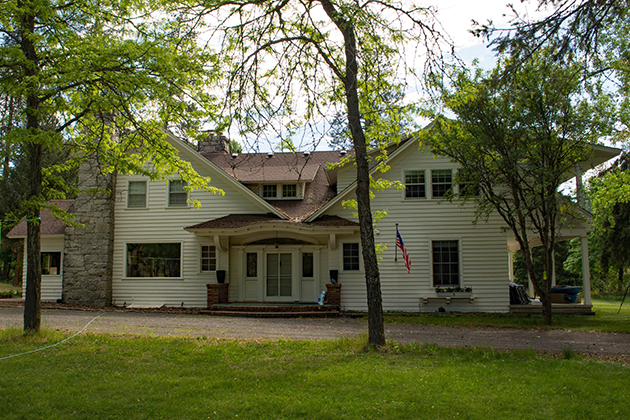
PhotoTitle: The Montvale Farm
PhotoAttribution: Spokane City/County Historic Preservation Office
Listing Status: Spokane Register
URL: http://properties.historicspokane.org/property/?PropertyID=1887
Display Marker: large_yellow
Title: Montvale Farm
Description: Date Built: 1897
Architect: Unknown (possibly Clarence Smith)
Common Name: Montvale Farm
Established between 1897 and 1898, Montvale Farm is significant for its association with two of Spokane's most prominent and influential business and civic leaders: Judge John W. Binkley and Aubrey Lee White. Judge Binkley was a Ňcity pioneerÓ and founder of the prominent Spokane law firm, Binkley & Taylor. Elected on the Democratic ticket, Binkley served as probate judge for Spokane County in 1885 and 1886 and was instrumental in the development and successful growth of the Dutch-owned Northwestern & Pacific Mortgage Company, the Northwestern Hypotheekbank. He was also involved with the North Pacific Loan & Trust Company's banks that loaned more than $1 million dollars for the rebuilding of the city after the 1889 fire. Around 1898, Binkley, an avid outdoorsman, purchased more than 300 acres in the vicinity along Rutter Parkway and the Little Spokane River, a natural wetland river valley located nine miles northwest of Spokane. He built a four-room cabin along the north shore of the river, lavishly entertained his friends and such Spokane luminaries as Louis Davenport, John Finch, and Royal Riblet with hunting and fishing expeditions and summer barbeques, affectionately calling his gentlemen's mountain valley get-away "Montvale Farm." Aubrey Lee White, who married Binkley's daughter, Ethelyn, owned the property beginning in 1928. White, who was nicknamed the "Father of Spokane Parks," was president of Spokane's first park board.
Location: 47.782186, -117.493853
Address: 5821 West Rutter Parkway, Spokane WA 99208
PhotoURL:

PhotoTitle: The Montvale Farm
PhotoAttribution: Spokane City/County Historic Preservation Office
Listing Status: Spokane Register
URL: http://properties.historicspokane.org/property/?PropertyID=1887
Display Marker: large_yellow
ID: 217
Title: Moore-Turner Garden
Description: Date Built: 1888
Architect: Hugh Bryan (landscape architect 1888-1891, post-1896 additions)
Common Name: Moore-Turner Garden
Developed in two main stages, the first from 1888 to 1891 and the second from 1911 to 1913, the Moore-Turner Garden is a local example of the landscape style that accompanied the Arts and Crafts Movement in America. George Turner and his wife Bertha purchased this residential garden, first laid out by F. Rockwood Moore, in 1896. During their ownership, the Moore-Turner Garden achieved its fullest development when the Turners commissioned Portland, Oregon landscape architect, Hugh Bryan, to supervise extensive additions. Incorporated into the South Hill's unique geology, the property covers over five acres and offers some of the finest views of the city and was the site of the city's early mansions. No other hillside landscape in Spokane retains the traces of its past to the same extent. While the South Hill's other hillside gardens have been compromised or have disappeared altogether, the remnants of the Moore-Turner Garden are identifiable. Currently owned by the Spokane Parks Department, the improvements to the infrastructure of the garden were completed in 2006 and included removing brush and debris, stabilizing the basalt walls, staircases and foundations, recovering the carriage road and installing the perimeter wrought iron fence with basalt columns.
Location: 47.64834, -117.42045
Address: 525 West 7th Avenue, Spokane WA 99204
PhotoURL: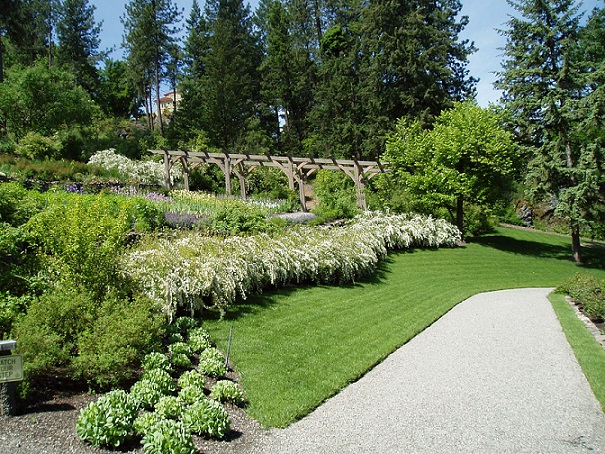
PhotoTitle: The Moore-Turner Garden
PhotoAttribution: Spokane City/County Historic Preservation Office
Listing Status: Spokane Register, National Register
URL: http://properties.historicspokane.org/property/?PropertyID=1888
Display Marker: large_yellow
Title: Moore-Turner Garden
Description: Date Built: 1888
Architect: Hugh Bryan (landscape architect 1888-1891, post-1896 additions)
Common Name: Moore-Turner Garden
Developed in two main stages, the first from 1888 to 1891 and the second from 1911 to 1913, the Moore-Turner Garden is a local example of the landscape style that accompanied the Arts and Crafts Movement in America. George Turner and his wife Bertha purchased this residential garden, first laid out by F. Rockwood Moore, in 1896. During their ownership, the Moore-Turner Garden achieved its fullest development when the Turners commissioned Portland, Oregon landscape architect, Hugh Bryan, to supervise extensive additions. Incorporated into the South Hill's unique geology, the property covers over five acres and offers some of the finest views of the city and was the site of the city's early mansions. No other hillside landscape in Spokane retains the traces of its past to the same extent. While the South Hill's other hillside gardens have been compromised or have disappeared altogether, the remnants of the Moore-Turner Garden are identifiable. Currently owned by the Spokane Parks Department, the improvements to the infrastructure of the garden were completed in 2006 and included removing brush and debris, stabilizing the basalt walls, staircases and foundations, recovering the carriage road and installing the perimeter wrought iron fence with basalt columns.
Location: 47.64834, -117.42045
Address: 525 West 7th Avenue, Spokane WA 99204
PhotoURL:

PhotoTitle: The Moore-Turner Garden
PhotoAttribution: Spokane City/County Historic Preservation Office
Listing Status: Spokane Register, National Register
URL: http://properties.historicspokane.org/property/?PropertyID=1888
Display Marker: large_yellow
ID: 218
Title: Morehouse-Williams House
Description: Date Built: 1912
Architect: Frank G. Hutchinson
Common Name: Morehouse-Williams House
Built in 1912, the Morehouse-Williams House is regarded as an excellent example of the Tudor Revival tradition with strong Craftsman-style influence as seen in the two steeply pitched prominent facade cross gables and decorative brackets. Built in the Rockwood Neighborhood, the property embodies the style, quality, cost and size of homes that were originally intended and planned for the area. The house was designed by Frank G. Hutchinson for Dr. Harry Lyman Morehouse, one of Spokane's early orthodontists, and his wife, Emily Blancette Morehouse. In 1914 the property was sold to Frank and Besse Williams who lived in it for 40 years.
Location: 47.64285, -117.40506
Address: 407 East 14th Avenue, Spokane WA 99202
PhotoURL: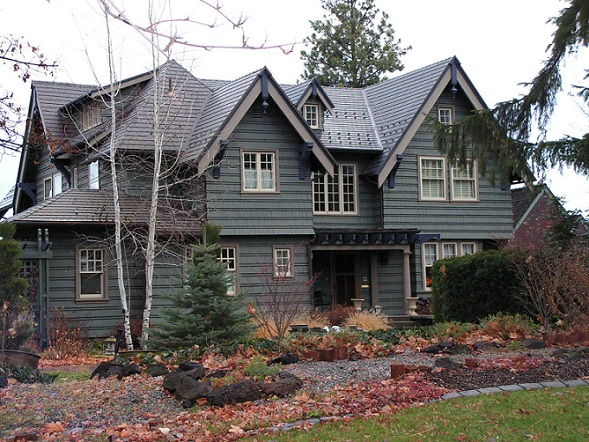
PhotoTitle: The Morehouse-Williams House
PhotoAttribution: Spokane City/County Historic Preservation Office
Listing Status: Spokane Register, National Register
URL: http://properties.historicspokane.org/property/?PropertyID=1889
Display Marker: large_yellow
Title: Morehouse-Williams House
Description: Date Built: 1912
Architect: Frank G. Hutchinson
Common Name: Morehouse-Williams House
Built in 1912, the Morehouse-Williams House is regarded as an excellent example of the Tudor Revival tradition with strong Craftsman-style influence as seen in the two steeply pitched prominent facade cross gables and decorative brackets. Built in the Rockwood Neighborhood, the property embodies the style, quality, cost and size of homes that were originally intended and planned for the area. The house was designed by Frank G. Hutchinson for Dr. Harry Lyman Morehouse, one of Spokane's early orthodontists, and his wife, Emily Blancette Morehouse. In 1914 the property was sold to Frank and Besse Williams who lived in it for 40 years.
Location: 47.64285, -117.40506
Address: 407 East 14th Avenue, Spokane WA 99202
PhotoURL:

PhotoTitle: The Morehouse-Williams House
PhotoAttribution: Spokane City/County Historic Preservation Office
Listing Status: Spokane Register, National Register
URL: http://properties.historicspokane.org/property/?PropertyID=1889
Display Marker: large_yellow
ID: 219
Title: Morgan Block
Description: Date Built: 1909
Architect: Alfred Jones
Common Name: Fairmont Hotel, Standard Building
The Morgan Block is historically significant as a representative example of a Single Room Occupancy Hotel (SRO), a unique style of working class housing popular in Spokane during a period of unprecedented growth around the turn of the twentieth century. Built to accommodate the influx of itinerant laborers who flocked to Spokane to fill jobs in the area's mining, agricultural, lumber and railroad industries, SROs once stood on nearly every block in the central business district. The Morgan Block was designed by prominent Spokane architect Alfred Jones and was built in 1909 for Daniel Morgan, a former Washington State senator and Spokane property developer. The building was damaged by a fire in the 1990s but has recently been rehabilitated.
Location: 47.65758, -117.41676
Address: 315 West Riverside Avenue, Spokane WA 99201
PhotoURL: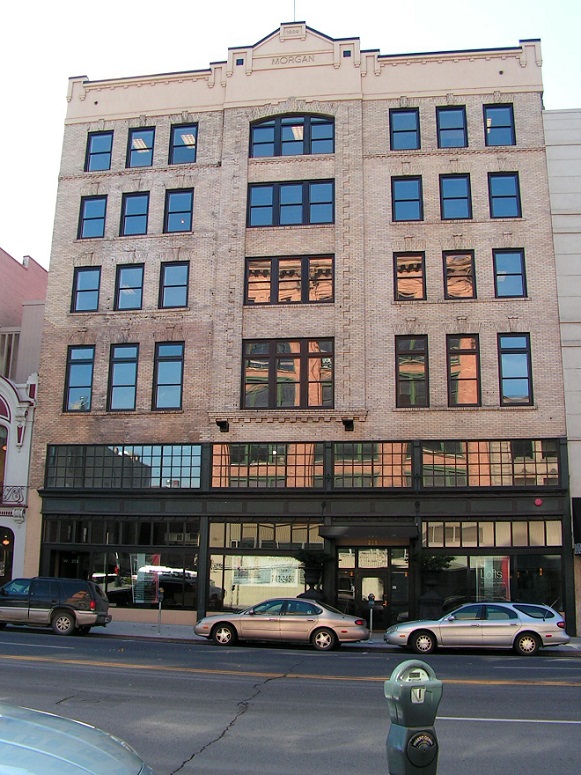
PhotoTitle: The Morgan Block
PhotoAttribution: Spokane City/County Historic Preservation Office
Listing Status: Spokane Register
URL: http://properties.historicspokane.org/property/?PropertyID=1890
Display Marker: large_yellow
Title: Morgan Block
Description: Date Built: 1909
Architect: Alfred Jones
Common Name: Fairmont Hotel, Standard Building
The Morgan Block is historically significant as a representative example of a Single Room Occupancy Hotel (SRO), a unique style of working class housing popular in Spokane during a period of unprecedented growth around the turn of the twentieth century. Built to accommodate the influx of itinerant laborers who flocked to Spokane to fill jobs in the area's mining, agricultural, lumber and railroad industries, SROs once stood on nearly every block in the central business district. The Morgan Block was designed by prominent Spokane architect Alfred Jones and was built in 1909 for Daniel Morgan, a former Washington State senator and Spokane property developer. The building was damaged by a fire in the 1990s but has recently been rehabilitated.
Location: 47.65758, -117.41676
Address: 315 West Riverside Avenue, Spokane WA 99201
PhotoURL:

PhotoTitle: The Morgan Block
PhotoAttribution: Spokane City/County Historic Preservation Office
Listing Status: Spokane Register
URL: http://properties.historicspokane.org/property/?PropertyID=1890
Display Marker: large_yellow
ID: 220
Title: Morgan House
Description: Date Built: 1909
Architect: George Keith and Harold Whitehouse
Common Name: Manito White House
The Daniel Morgan House is an excellent example of a Neoclassical dwelling Spokane and possesses striking features attributed to the style such as the prominent full-width and height entry porch and the four large Tuscan columns that support a gabled pediment. The home remains an important example of the residential work of local renowned architects, Harold C. Whitehouse and George H. Keith, and stands in one of Spokane's finest early neighborhoods, Manito Park Addition. The dwelling was constructed in 1909 for Daniel Morgan, an early Spokane entrepreneur, developer, and, later, a Washington state senator.
Location: 47.63562, -117.40647
Address: 242 East Manito Place, Spokane WA 99203
PhotoURL: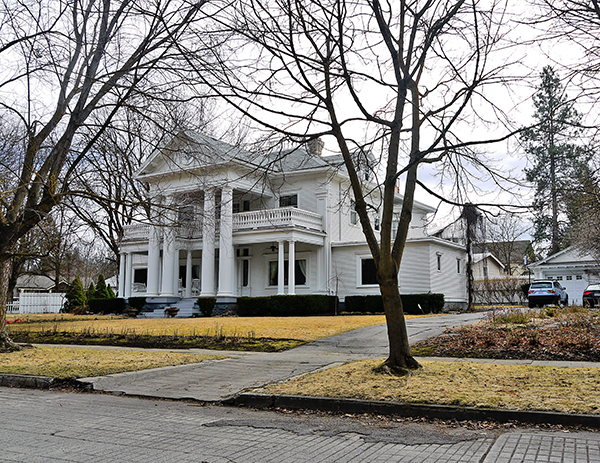
PhotoTitle: The Morgan House
PhotoAttribution: Spokane City/County Historic Preservation Office
Listing Status: Spokane Register
URL: http://properties.historicspokane.org/property/?PropertyID=2050
Display Marker: large_yellow
Title: Morgan House
Description: Date Built: 1909
Architect: George Keith and Harold Whitehouse
Common Name: Manito White House
The Daniel Morgan House is an excellent example of a Neoclassical dwelling Spokane and possesses striking features attributed to the style such as the prominent full-width and height entry porch and the four large Tuscan columns that support a gabled pediment. The home remains an important example of the residential work of local renowned architects, Harold C. Whitehouse and George H. Keith, and stands in one of Spokane's finest early neighborhoods, Manito Park Addition. The dwelling was constructed in 1909 for Daniel Morgan, an early Spokane entrepreneur, developer, and, later, a Washington state senator.
Location: 47.63562, -117.40647
Address: 242 East Manito Place, Spokane WA 99203
PhotoURL:

PhotoTitle: The Morgan House
PhotoAttribution: Spokane City/County Historic Preservation Office
Listing Status: Spokane Register
URL: http://properties.historicspokane.org/property/?PropertyID=2050
Display Marker: large_yellow
ID: 221
Title: Motie House
Description: Date Built: 1910
Architect: William J. Ballard, Ballard Plannery
Common Name: Marguerite Motie House
Built in 1910, the Marguerite Motie (pronounced mo'chee) House, garage and chicken house are fine examples of the Craftsman style. Facing south along West 13th Avenue, the house reveals typical Craftsman-style details with 1.5 stories, a side gable roof with widely overhanging eaves and a full-width front porch. Wide bargeboards with keyhole cutouts in the tails, battered porch pillars and hand-polished natural fir interior woodwork further illustrate the Craftsman-style aesthetic. The property is also significant for its association with Marguerite Motie, the first and longest-reigning "Miss Spokane," an advertising symbol used in the promotion of Spokane and the Inland Northwest in the early 20th century. Motie was selected from 138 candidates to act as an ambassador and official city hostess for the city and, as a civic figurehead, she contributed much to Spokane and the surrounding region.
Location: 47.64385, -117.42095
Address: 614 West 13th Avenue, Spokane WA 99204
PhotoURL: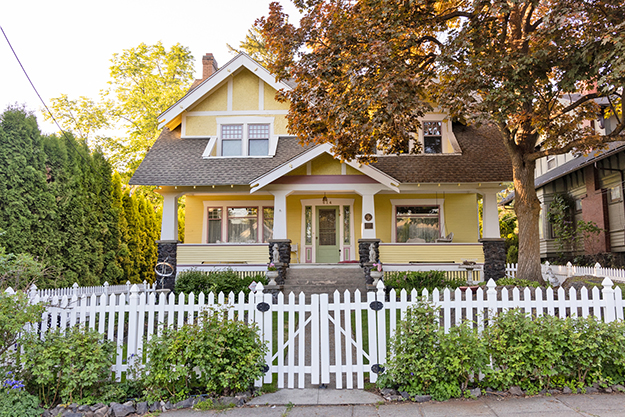
PhotoTitle: The Marguerite Motie House
PhotoAttribution: Spokane City/County Historic Preservation Office
Listing Status: Spokane Register, National Register
URL: http://properties.historicspokane.org/property/?PropertyID=1891
Display Marker: large_yellow
Title: Motie House
Description: Date Built: 1910
Architect: William J. Ballard, Ballard Plannery
Common Name: Marguerite Motie House
Built in 1910, the Marguerite Motie (pronounced mo'chee) House, garage and chicken house are fine examples of the Craftsman style. Facing south along West 13th Avenue, the house reveals typical Craftsman-style details with 1.5 stories, a side gable roof with widely overhanging eaves and a full-width front porch. Wide bargeboards with keyhole cutouts in the tails, battered porch pillars and hand-polished natural fir interior woodwork further illustrate the Craftsman-style aesthetic. The property is also significant for its association with Marguerite Motie, the first and longest-reigning "Miss Spokane," an advertising symbol used in the promotion of Spokane and the Inland Northwest in the early 20th century. Motie was selected from 138 candidates to act as an ambassador and official city hostess for the city and, as a civic figurehead, she contributed much to Spokane and the surrounding region.
Location: 47.64385, -117.42095
Address: 614 West 13th Avenue, Spokane WA 99204
PhotoURL:

PhotoTitle: The Marguerite Motie House
PhotoAttribution: Spokane City/County Historic Preservation Office
Listing Status: Spokane Register, National Register
URL: http://properties.historicspokane.org/property/?PropertyID=1891
Display Marker: large_yellow
ID: 222
Title: Mount Saint Michael
Description: Date Built: 1915
Architect: Julius Zittel
Common Name: Mount St. Michael Mission
Located near Hillyard and Mead six miles north of Spokane, the Mount Saint Michael Seminary was built in the vicinity of the first Catholic mission serving the area. Located high on a bluff some 500 feet above the valley floor, the building has an imposing architectural presence. Designed by noted Spokane architect, Julius Zittel, and built in 1915, Mount Saint Michael is an excellent example of the Tudor-Gothic and Collegiate Gothic Revival styles and possesses pointed gothic arches, large window areas and vertical elements which add visual height to the structure. Mount St. Michael is an outgrowth of the first Jesuit seminary to be established west of the Mississippi River and, since it has been in continuous use as a religious educational facility, remains a symbol of the development of Catholicism in the Pacific Northwest.
Location: 47.731464, -117.341270
Address: 8500 North St. Michaels Road, Spokane WA 99217
PhotoURL:
PhotoTitle: Mount St. Michael
PhotoAttribution: Spokane City/County Historic Preservation Office
Listing Status: Spokane Register, National Register
URL: http://properties.historicspokane.org/property/?PropertyID=1892
Display Marker: large_yellow
Title: Mount Saint Michael
Description: Date Built: 1915
Architect: Julius Zittel
Common Name: Mount St. Michael Mission
Located near Hillyard and Mead six miles north of Spokane, the Mount Saint Michael Seminary was built in the vicinity of the first Catholic mission serving the area. Located high on a bluff some 500 feet above the valley floor, the building has an imposing architectural presence. Designed by noted Spokane architect, Julius Zittel, and built in 1915, Mount Saint Michael is an excellent example of the Tudor-Gothic and Collegiate Gothic Revival styles and possesses pointed gothic arches, large window areas and vertical elements which add visual height to the structure. Mount St. Michael is an outgrowth of the first Jesuit seminary to be established west of the Mississippi River and, since it has been in continuous use as a religious educational facility, remains a symbol of the development of Catholicism in the Pacific Northwest.
Location: 47.731464, -117.341270
Address: 8500 North St. Michaels Road, Spokane WA 99217
PhotoURL:

PhotoTitle: Mount St. Michael
PhotoAttribution: Spokane City/County Historic Preservation Office
Listing Status: Spokane Register, National Register
URL: http://properties.historicspokane.org/property/?PropertyID=1892
Display Marker: large_yellow
ID: 223
Title: Mueller House
Description: Date Built: 1910
Architect: Alfred Jones
Common Name: Franz and Emma Mueller House
The Mueller House was built for Professor Franz Mueller and his wife, Emma. Franz Mueller came to Spokane in 1889 to direct the Musical Department at Jenkins University. Mueller was educated at the New England Conservatory of Music and, from 1891 to 1892, he headed the Musical Department at Gonzaga College and later founded the Spokane Conservatory of Music. He was well known as a composer; his best known work was the "White Fawn" which was presented in Spokane in 1895. He also composed light operas and was the organist at the First Methodist Church for most of his residency in Spokane.
Location: 47.64413, -117.42001
Address: 1206 South Stevens Street, Spokane WA 99204
PhotoURL: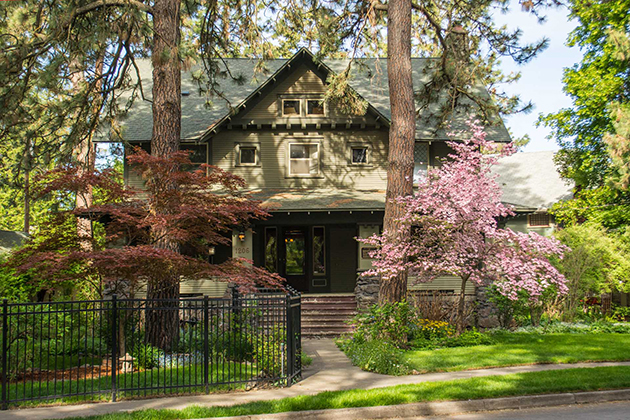
PhotoTitle: The Franz and Emma Mueller House
PhotoAttribution: Spokane City/County Historic Preservation Office
Listing Status: Spokane Register, National Register
URL: http://properties.historicspokane.org/property/?PropertyID=1893
Display Marker: large_yellow
Title: Mueller House
Description: Date Built: 1910
Architect: Alfred Jones
Common Name: Franz and Emma Mueller House
The Mueller House was built for Professor Franz Mueller and his wife, Emma. Franz Mueller came to Spokane in 1889 to direct the Musical Department at Jenkins University. Mueller was educated at the New England Conservatory of Music and, from 1891 to 1892, he headed the Musical Department at Gonzaga College and later founded the Spokane Conservatory of Music. He was well known as a composer; his best known work was the "White Fawn" which was presented in Spokane in 1895. He also composed light operas and was the organist at the First Methodist Church for most of his residency in Spokane.
Location: 47.64413, -117.42001
Address: 1206 South Stevens Street, Spokane WA 99204
PhotoURL:

PhotoTitle: The Franz and Emma Mueller House
PhotoAttribution: Spokane City/County Historic Preservation Office
Listing Status: Spokane Register, National Register
URL: http://properties.historicspokane.org/property/?PropertyID=1893
Display Marker: large_yellow
ID: 224
Title: Muzzy-Shine House
Description: Date Built: 1889
Architect: Unknown
Common Name: Muzzy-Shine House
Built in 1889 and named after its two most significant resident owners, Hiram Newton Muzzy and Patrick C. Shine, the Muzzy-Shine House is a high-style, landmark example of the Queen Anne tradition. The 2.5 story house is dominated by a steeply pitched roof and is an imposing edifice of red brick and sparkly silver-colored granite. The home was erected for Muzzy, a pioneer farmer and orchardist who came to Spokane in 1880, homesteaded 160 acres north of the Spokane County Courthouse and, upon receiving his patent, platted and sold more than 500 lots on his land, which he called Muzzy's Addition. The second owners of the property were Shine and his wife, Mary Gomm. Shine was a prominent Spokane attorney and politician who held various offices and government positions, served as consulate commissioner to British Columbia, Alberta and Saskatchewan, Canada, and provided legal counsel to railroad companies and real estate enterprises in Oregon and Spokane.
Location: 47.67193, -117.43442
Address: 1506 West Mission Avenue, Spokane WA 99201
PhotoURL: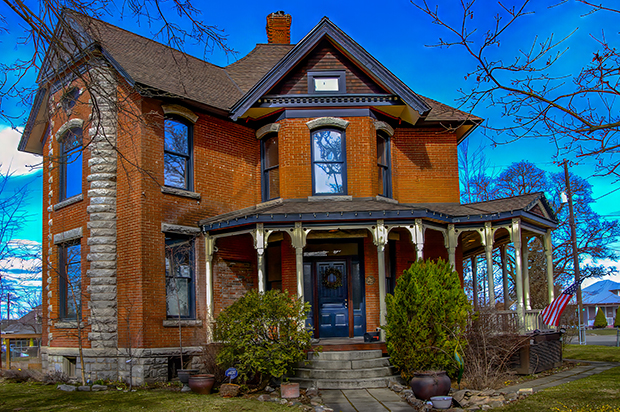
PhotoTitle: The Muzzy-Shine House
PhotoAttribution: Spokane City/County Historic Preservation Office
Listing Status: Spokane Register, National Register
URL: http://properties.historicspokane.org/property/?PropertyID=1894
Display Marker: large_yellow
Title: Muzzy-Shine House
Description: Date Built: 1889
Architect: Unknown
Common Name: Muzzy-Shine House
Built in 1889 and named after its two most significant resident owners, Hiram Newton Muzzy and Patrick C. Shine, the Muzzy-Shine House is a high-style, landmark example of the Queen Anne tradition. The 2.5 story house is dominated by a steeply pitched roof and is an imposing edifice of red brick and sparkly silver-colored granite. The home was erected for Muzzy, a pioneer farmer and orchardist who came to Spokane in 1880, homesteaded 160 acres north of the Spokane County Courthouse and, upon receiving his patent, platted and sold more than 500 lots on his land, which he called Muzzy's Addition. The second owners of the property were Shine and his wife, Mary Gomm. Shine was a prominent Spokane attorney and politician who held various offices and government positions, served as consulate commissioner to British Columbia, Alberta and Saskatchewan, Canada, and provided legal counsel to railroad companies and real estate enterprises in Oregon and Spokane.
Location: 47.67193, -117.43442
Address: 1506 West Mission Avenue, Spokane WA 99201
PhotoURL:

PhotoTitle: The Muzzy-Shine House
PhotoAttribution: Spokane City/County Historic Preservation Office
Listing Status: Spokane Register, National Register
URL: http://properties.historicspokane.org/property/?PropertyID=1894
Display Marker: large_yellow
ID: 225
Title: Natatorium Carousel
Description: Date Built: 1909
Architect: Charles Looff
Common Name: Looff Carousel
The Natatorium Carousel is a product of a lost craft and is representative of one of the few arts intended solely to amuse. Charles I. D. Looff, a renowned carousel artist, designed the "merry-go-round" in 1909 and it has been operating in Spokane ever since. The gilded and elaborately carved carousel, adorned with leaping horses and jungle animals, is said to be the last operating carousel designed by Looff. While most of Looff's horses were gentle, jolly creatures, those of the Spokane carousel are dashing fiery steeds that appear to race around the room. Each animal has details that proclaim its individuality and they are decorated with brightly colored flowers, parrots, cupids, gamebirds, bedrolls and clusters of fruit. The carousel was first located at at the famed Natatorium Park, an amusement park on the Spokane River developed by Washington Water Power in 1893 and since converted to a trailer park. In 1975 it moved to Riverfront Park which was created in conjunction with Expo '74, the World's Fair hosted by Spokane in 1974. The carousel was a wedding gift to Looff's daughter, Emma Vogel, and her husband, Louis Vogel, a Spokane banker and longtime owner of Natatorium Park. The carousel is the last remnant of the popular park and a fixture at the present park downtown.
Location: 47.660662, -117.420313
Address: 530 West Spokane Falls Boulevard, Spokane WA 99201
PhotoURL:
PhotoTitle: The fabulous Looff Carousel
PhotoAttribution: Spokane City/County Historic Preservation Office
Listing Status: National Register
URL: http://properties.historicspokane.org/property/?PropertyID=2008
Display Marker: large_yellow
Title: Natatorium Carousel
Description: Date Built: 1909
Architect: Charles Looff
Common Name: Looff Carousel
The Natatorium Carousel is a product of a lost craft and is representative of one of the few arts intended solely to amuse. Charles I. D. Looff, a renowned carousel artist, designed the "merry-go-round" in 1909 and it has been operating in Spokane ever since. The gilded and elaborately carved carousel, adorned with leaping horses and jungle animals, is said to be the last operating carousel designed by Looff. While most of Looff's horses were gentle, jolly creatures, those of the Spokane carousel are dashing fiery steeds that appear to race around the room. Each animal has details that proclaim its individuality and they are decorated with brightly colored flowers, parrots, cupids, gamebirds, bedrolls and clusters of fruit. The carousel was first located at at the famed Natatorium Park, an amusement park on the Spokane River developed by Washington Water Power in 1893 and since converted to a trailer park. In 1975 it moved to Riverfront Park which was created in conjunction with Expo '74, the World's Fair hosted by Spokane in 1974. The carousel was a wedding gift to Looff's daughter, Emma Vogel, and her husband, Louis Vogel, a Spokane banker and longtime owner of Natatorium Park. The carousel is the last remnant of the popular park and a fixture at the present park downtown.
Location: 47.660662, -117.420313
Address: 530 West Spokane Falls Boulevard, Spokane WA 99201
PhotoURL:

PhotoTitle: The fabulous Looff Carousel
PhotoAttribution: Spokane City/County Historic Preservation Office
Listing Status: National Register
URL: http://properties.historicspokane.org/property/?PropertyID=2008
Display Marker: large_yellow
ID: 226
Title: National Hotel
Description: Date Built: 1905
Architect: Unknown
Common Name: National Hotel
Built in 1905, the design for the National Hotel evokes the building's use as an SRO (Single Room Occupancy Hotel). The evocative features include symmetrically balanced exterior fenestration patterns, central skylights, commercial bays on the first floor and a separate door that opens to upper-story hotel rooms from the street. Providing housing needs for hundreds of working class citizens for more than sixty years, the National Hotel is one of only a few remaining SROs throughout the Spokane region. The building was jointly owned by Huber and Margaret Rasher, E. Postel and M. Oppenheimer. The western half of the building was demolished in 1967 and replaced with a parking lot.
Location: 47.65772, -117.41356
Address: 201 West Riverside Avenue, Spokane WA 99201
PhotoURL: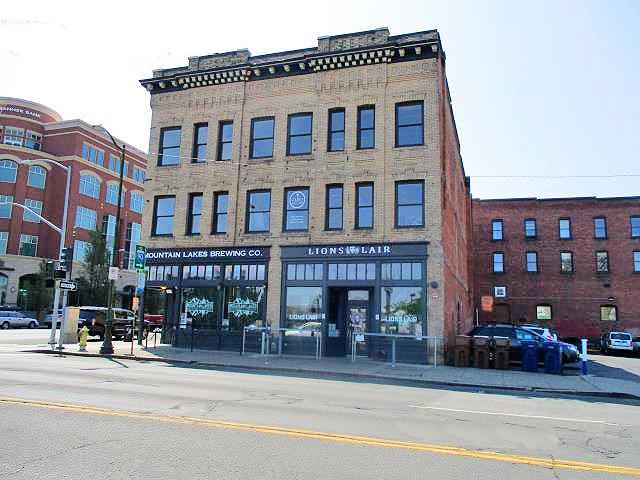
PhotoTitle: The National Hotel
PhotoAttribution: Spokane City/County Historic Preservation Office
Listing Status: Spokane Register, National Register
URL: http://properties.historicspokane.org/property/?PropertyID=1895
Display Marker: large_yellow
Title: National Hotel
Description: Date Built: 1905
Architect: Unknown
Common Name: National Hotel
Built in 1905, the design for the National Hotel evokes the building's use as an SRO (Single Room Occupancy Hotel). The evocative features include symmetrically balanced exterior fenestration patterns, central skylights, commercial bays on the first floor and a separate door that opens to upper-story hotel rooms from the street. Providing housing needs for hundreds of working class citizens for more than sixty years, the National Hotel is one of only a few remaining SROs throughout the Spokane region. The building was jointly owned by Huber and Margaret Rasher, E. Postel and M. Oppenheimer. The western half of the building was demolished in 1967 and replaced with a parking lot.
Location: 47.65772, -117.41356
Address: 201 West Riverside Avenue, Spokane WA 99201
PhotoURL:

PhotoTitle: The National Hotel
PhotoAttribution: Spokane City/County Historic Preservation Office
Listing Status: Spokane Register, National Register
URL: http://properties.historicspokane.org/property/?PropertyID=1895
Display Marker: large_yellow
ID: 227
Title: Nebraska Block
Description: Date Built: 1907
Architect: Hillyard Townsite Company
Common Name: Nebraska Hotel
The Nebraska Block was constructed of formed concrete blocks and is distinguished by quoins at the second-floor windows. Built as an early single-room occupancy hotel, the building was referred to as the Nebraska House and the Nebraska Hotel. According to local legend, part of the building was operated as a brothel with reports that "ladies of the evening" were engaged in business transactions on the second floor. From 1907 to 1952, first-floor space was occupied by a variety of tenants including dentist W.G. Beaumont, the law firm of Brown & Upton, Gibson Billiards, Walker Grocery Store, Imperial Pool & Beer Parlor, Louis Via Grocery Store and various cafes and restaurants.
Location: 47.70369, -117.36448
Address: 5008 North Market Street, Spokane WA 99217
PhotoURL: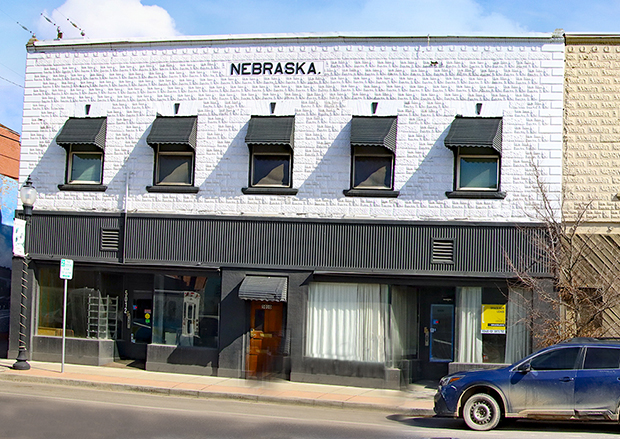
PhotoTitle: The Nebraska Block
PhotoAttribution: Google Street View
Listing Status: Spokane Register, National Register
URL: http://properties.historicspokane.org/property/?PropertyID=1896
Display Marker: large_yellow
Title: Nebraska Block
Description: Date Built: 1907
Architect: Hillyard Townsite Company
Common Name: Nebraska Hotel
The Nebraska Block was constructed of formed concrete blocks and is distinguished by quoins at the second-floor windows. Built as an early single-room occupancy hotel, the building was referred to as the Nebraska House and the Nebraska Hotel. According to local legend, part of the building was operated as a brothel with reports that "ladies of the evening" were engaged in business transactions on the second floor. From 1907 to 1952, first-floor space was occupied by a variety of tenants including dentist W.G. Beaumont, the law firm of Brown & Upton, Gibson Billiards, Walker Grocery Store, Imperial Pool & Beer Parlor, Louis Via Grocery Store and various cafes and restaurants.
Location: 47.70369, -117.36448
Address: 5008 North Market Street, Spokane WA 99217
PhotoURL:

PhotoTitle: The Nebraska Block
PhotoAttribution: Google Street View
Listing Status: Spokane Register, National Register
URL: http://properties.historicspokane.org/property/?PropertyID=1896
Display Marker: large_yellow
ID: 228
Title: New Madison Hotel
Description: Date Built: 1906
Architect: Unknown
Common Name: New Madison Hotel
The New Madison Hotel was constructed in 1906 during a period of intense growth for the city and its use as a Single Room Occupancy hotel contributed to the overall development of the transportation and commercial neighborhood. The New Madison housed transient workers and other travelers during the short-lived economic boom and population expansion. The five-story building was originally broken into commercial space on the ground floor, 159 rooms on the next three floors and the Blair Business College on the top floor. The buff-colored brick adds a lightness to the otherwise large mass of the building.
Location: 47.65622, -117.4277
Address: 1029 West 1st Avenue, Spokane WA 99201
PhotoURL: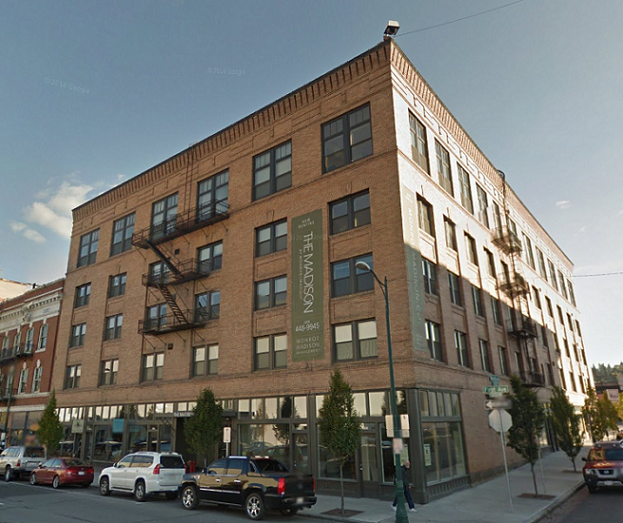
PhotoTitle: The New Madison Hotel
PhotoAttribution: Google Street View
Listing Status: Spokane Register, National Register
URL: http://properties.historicspokane.org/property/?PropertyID=1897
Display Marker: large_yellow
Title: New Madison Hotel
Description: Date Built: 1906
Architect: Unknown
Common Name: New Madison Hotel
The New Madison Hotel was constructed in 1906 during a period of intense growth for the city and its use as a Single Room Occupancy hotel contributed to the overall development of the transportation and commercial neighborhood. The New Madison housed transient workers and other travelers during the short-lived economic boom and population expansion. The five-story building was originally broken into commercial space on the ground floor, 159 rooms on the next three floors and the Blair Business College on the top floor. The buff-colored brick adds a lightness to the otherwise large mass of the building.
Location: 47.65622, -117.4277
Address: 1029 West 1st Avenue, Spokane WA 99201
PhotoURL:

PhotoTitle: The New Madison Hotel
PhotoAttribution: Google Street View
Listing Status: Spokane Register, National Register
URL: http://properties.historicspokane.org/property/?PropertyID=1897
Display Marker: large_yellow
ID: 229
Title: Nuzum House
Description: Date Built: 1912
Architect: Cutter & Malmgren
Common Name: Richard and Jessie Nuzum House
Constructed in 1912, the Nuzum house is reminiscent of seventeenth century "black and white" Tudor-style structures built in towns, hills and meadows throughout England. Celebrated Spokane architectural firm, Cutter and Malmgren, designed the home which was purchased in 1916 by Richard W. Nuzum, one of Spokane's most famous civil and criminal attorneys. Richard Nuzum and his wife, Jessie, were long-standing residents, living in the house for 30 years. The home is well-preserved with a high degree of architectural integrity and is a hallmark example of the American Tudor Revival style.
Location: 47.64558, -117.41873
Address: 503 West Sumner Avenue, Spokane WA 99204
PhotoURL: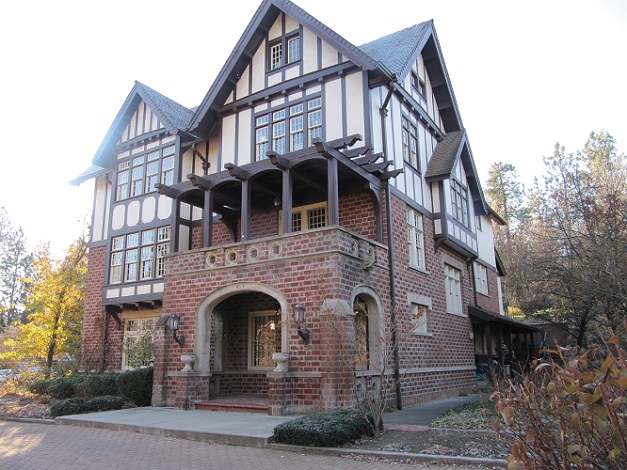
PhotoTitle: The Richard and Jessie Nuzum House
PhotoAttribution: Spokane City/County Historic Preservation Office
Listing Status: Spokane Register, National Register
URL: http://properties.historicspokane.org/property/?PropertyID=2047
Display Marker: large_yellow
Title: Nuzum House
Description: Date Built: 1912
Architect: Cutter & Malmgren
Common Name: Richard and Jessie Nuzum House
Constructed in 1912, the Nuzum house is reminiscent of seventeenth century "black and white" Tudor-style structures built in towns, hills and meadows throughout England. Celebrated Spokane architectural firm, Cutter and Malmgren, designed the home which was purchased in 1916 by Richard W. Nuzum, one of Spokane's most famous civil and criminal attorneys. Richard Nuzum and his wife, Jessie, were long-standing residents, living in the house for 30 years. The home is well-preserved with a high degree of architectural integrity and is a hallmark example of the American Tudor Revival style.
Location: 47.64558, -117.41873
Address: 503 West Sumner Avenue, Spokane WA 99204
PhotoURL:

PhotoTitle: The Richard and Jessie Nuzum House
PhotoAttribution: Spokane City/County Historic Preservation Office
Listing Status: Spokane Register, National Register
URL: http://properties.historicspokane.org/property/?PropertyID=2047
Display Marker: large_yellow
ID: 230
Title: Odd Fellows IOOF Lodge
Description: Date Built: 1909
Architect: Albert Held/ P.L. Peterson
Common Name: Odd Fellows Building, Odd Girls Building
The cornerstone of Odd Fellows IOOF Lodge was laid on January 1, 1909 and the $70,000 building was dedicated exactly ten months later. The Independent Order of Odd Fellows is a fraternal organization that saw a resurgence in popularity at the turn of the 20th century. The building itself was designed by noted Spokane architect, Albert Held, and the stately brick and terra cotta Odd Fellows Building has housed numerous businesses over the course of Spokane's history. The ground floor initially housed the Herring-Hall-Marvin Safe Company and the Turnbull undertaking rooms. The Riley Candy Company then occupied the space from 1917 to the mid-1940s. The Metronome Dance Hall was in the first floor from 1950 to 1953 until it became the Hi-Spot Dance Hall from 1954 to 1956. The Lodge Room, finished in mahogany and featuring stained glass windows and $3,000 carpet, was on the second floor. The third floor contained a banquet hall, parlor and kitchen.
Location: 47.65623, -117.4274
Address: 1017 West 1st Avenue, Spokane WA 99201
PhotoURL: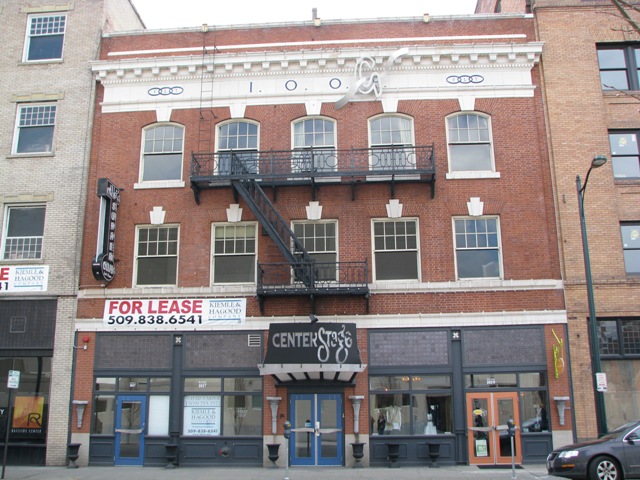
PhotoTitle: The Odd Fellows IOOF Lodge
PhotoAttribution: Spokane City/County Historic Preservation Office
Listing Status: Spokane Register, National Register
URL: http://properties.historicspokane.org/property/?PropertyID=1900
Display Marker: large_yellow
Title: Odd Fellows IOOF Lodge
Description: Date Built: 1909
Architect: Albert Held/ P.L. Peterson
Common Name: Odd Fellows Building, Odd Girls Building
The cornerstone of Odd Fellows IOOF Lodge was laid on January 1, 1909 and the $70,000 building was dedicated exactly ten months later. The Independent Order of Odd Fellows is a fraternal organization that saw a resurgence in popularity at the turn of the 20th century. The building itself was designed by noted Spokane architect, Albert Held, and the stately brick and terra cotta Odd Fellows Building has housed numerous businesses over the course of Spokane's history. The ground floor initially housed the Herring-Hall-Marvin Safe Company and the Turnbull undertaking rooms. The Riley Candy Company then occupied the space from 1917 to the mid-1940s. The Metronome Dance Hall was in the first floor from 1950 to 1953 until it became the Hi-Spot Dance Hall from 1954 to 1956. The Lodge Room, finished in mahogany and featuring stained glass windows and $3,000 carpet, was on the second floor. The third floor contained a banquet hall, parlor and kitchen.
Location: 47.65623, -117.4274
Address: 1017 West 1st Avenue, Spokane WA 99201
PhotoURL:

PhotoTitle: The Odd Fellows IOOF Lodge
PhotoAttribution: Spokane City/County Historic Preservation Office
Listing Status: Spokane Register, National Register
URL: http://properties.historicspokane.org/property/?PropertyID=1900
Display Marker: large_yellow
ID: 231
Title: Odell House
Description: Date Built: 1899
Architect: Loren L. Rand
Common Name: Odell House
Designed by prominent Spokane architect, Loren L. Rand, the Odell House is an excellent example of the Free Classic Queen Anne-style. At the time of its construction, the house's location was one of the most prestigious in the city. Other recently completed grand homes, including ones for mining magnates, Amasa Campbell and John Finch that were designed by Kirtland K. Cutter, share the bluff at the west end of First Avenue with the Odell House. An automobile garage designed by the Ballard Plannery was added in 1912. Like surrounding homes, the Odell House is also associated with prominent figures in Spokane history. The home was built for real estate entrepreneur and civic benefactor, George W. Odell, and his wife, Ada. It was later home to Denis and Margaret Clark. Clark was a wealthy miner and a brother to James and Patrick Clark, who built the nearby Patsy Clark Mansion. Sam Katzenstein, a salesman for Cohn Brother's Furniture, bought the house in 1922 and converted it to six apartments. It remains an apartment house today.
Location: 47.65617, -117.44732
Address: 2325 West 1st Avenue, Spokane WA 99201
PhotoURL: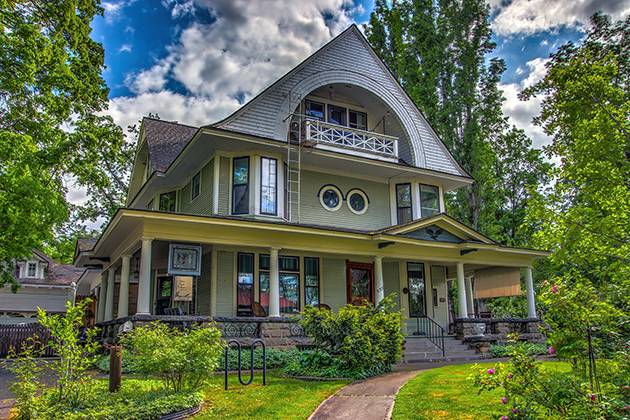
PhotoTitle: The George and Ada Odell House
PhotoAttribution: Spokane City/County Historic Preservation Office
Listing Status: Spokane Register, National Register
URL: http://properties.historicspokane.org/property/?PropertyID=1898
Display Marker: large_yellow
Title: Odell House
Description: Date Built: 1899
Architect: Loren L. Rand
Common Name: Odell House
Designed by prominent Spokane architect, Loren L. Rand, the Odell House is an excellent example of the Free Classic Queen Anne-style. At the time of its construction, the house's location was one of the most prestigious in the city. Other recently completed grand homes, including ones for mining magnates, Amasa Campbell and John Finch that were designed by Kirtland K. Cutter, share the bluff at the west end of First Avenue with the Odell House. An automobile garage designed by the Ballard Plannery was added in 1912. Like surrounding homes, the Odell House is also associated with prominent figures in Spokane history. The home was built for real estate entrepreneur and civic benefactor, George W. Odell, and his wife, Ada. It was later home to Denis and Margaret Clark. Clark was a wealthy miner and a brother to James and Patrick Clark, who built the nearby Patsy Clark Mansion. Sam Katzenstein, a salesman for Cohn Brother's Furniture, bought the house in 1922 and converted it to six apartments. It remains an apartment house today.
Location: 47.65617, -117.44732
Address: 2325 West 1st Avenue, Spokane WA 99201
PhotoURL:

PhotoTitle: The George and Ada Odell House
PhotoAttribution: Spokane City/County Historic Preservation Office
Listing Status: Spokane Register, National Register
URL: http://properties.historicspokane.org/property/?PropertyID=1898
Display Marker: large_yellow
ID: 232
Title: Opportunity Township Hall
Description: Date Built: 1912
Architect: C. Harvey Smith
Common Name: Opportunity Town Hall
The Opportunity Township Hall, erected in 1912, is a unique, one-and-one-half story, Spanish Colonial Revival style building with a gracefully shaped roof parapet. In 1905, D.K. McDonald, R. Hutchinson and A.C. Jamison founded the Modern Irrigation and Land Company and the farming community that formed around it would eventually become Opportunity. In 1908, Washington passed a law enabling unincorporated communities to form local units of government called townships. Now that Opportunity was officially recognized, the community needed a formal meeting place and four years later the township hall was erected. It has served the community as a meeting place, early library and place of worship. With "Opportunity Anno 1912" emblazoned at one point in terra cotta relief over the front entry, the Hall continues to represent the birth of a community over a century ago. The building is now home to the Spokane Valley Heritage Museum.
Location: 47.65676, -117.24194
Address: 12114 East Sprague Avenue, Spokane Valley WA 99206
PhotoURL: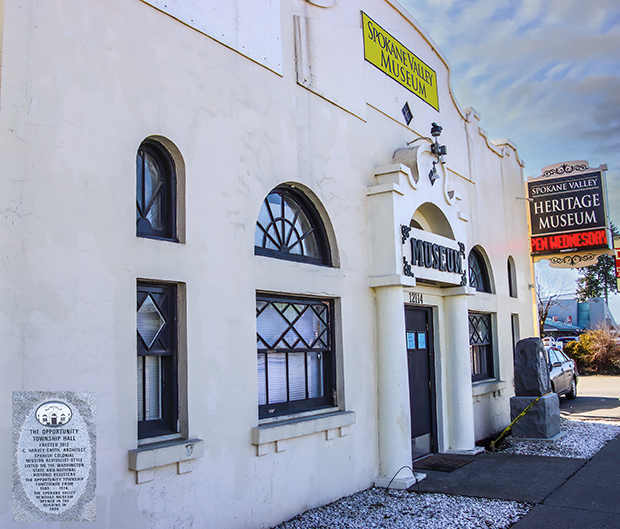
PhotoTitle: Opportunity Township Hall
PhotoAttribution: Spokane City/County Historic Preservation Office
Listing Status: Spokane Register, National Register
URL: http://properties.historicspokane.org/property/?PropertyID=2068
Display Marker: large_yellow
Title: Opportunity Township Hall
Description: Date Built: 1912
Architect: C. Harvey Smith
Common Name: Opportunity Town Hall
The Opportunity Township Hall, erected in 1912, is a unique, one-and-one-half story, Spanish Colonial Revival style building with a gracefully shaped roof parapet. In 1905, D.K. McDonald, R. Hutchinson and A.C. Jamison founded the Modern Irrigation and Land Company and the farming community that formed around it would eventually become Opportunity. In 1908, Washington passed a law enabling unincorporated communities to form local units of government called townships. Now that Opportunity was officially recognized, the community needed a formal meeting place and four years later the township hall was erected. It has served the community as a meeting place, early library and place of worship. With "Opportunity Anno 1912" emblazoned at one point in terra cotta relief over the front entry, the Hall continues to represent the birth of a community over a century ago. The building is now home to the Spokane Valley Heritage Museum.
Location: 47.65676, -117.24194
Address: 12114 East Sprague Avenue, Spokane Valley WA 99206
PhotoURL:

PhotoTitle: Opportunity Township Hall
PhotoAttribution: Spokane City/County Historic Preservation Office
Listing Status: Spokane Register, National Register
URL: http://properties.historicspokane.org/property/?PropertyID=2068
Display Marker: large_yellow
ID: 233
Title: Page-Ufford House
Description: Date Built: 1896
Architect: Unknown
Common Name: Page-Ufford House
The Page-Ufford House is an excellent example of the "Free Classic" Queen Anne style. The rear of the house commands a panoramic view of Latah Creek, Latah Valley and west Spokane. Possessing an irregular, steeply pitched hip roof, non-symmetrical facade, multiple exterior textures, a full-width wrap-around front porch and a prominent three-story circular tower, the house is certainly a high-style example of Queen Anne. The tower, which immediately draws the eyes of passersby, has its original curved windows and is topped with what is known as a witch's hat roof. A unique distinction of the property is the unusual variety of window designs: a keyhole window, an ocular window, an oval window, a diamond window, and a large arched Islamic-shaped window with multiple decorative leaded-glass lights. Originally built for Flora and Alba Page, a wealthy financier who owned the Page Land Company, the home was eventually purchased by Ethel and William Ufford, a well-known and successful lumberman.
Location: 47.65234, -117.44717
Address: 364 South Coeur d'Alene Street, Spokane WA 99201
PhotoURL: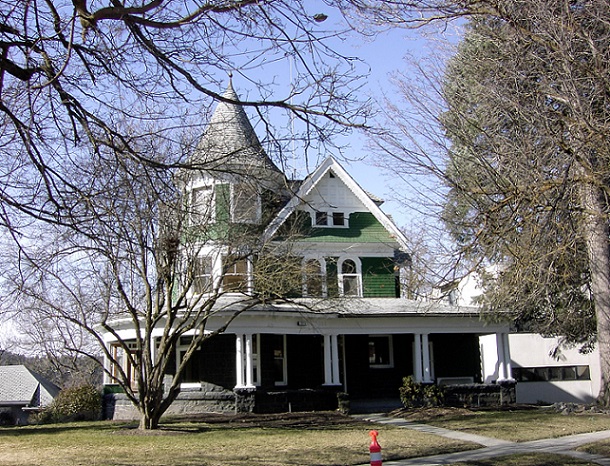
PhotoTitle: The Page-Ufford House
PhotoAttribution: Spokane City/County Historic Preservation Office
Listing Status: Spokane Register, National Register
URL: http://properties.historicspokane.org/property/?PropertyID=1901
Display Marker: large_yellow
Title: Page-Ufford House
Description: Date Built: 1896
Architect: Unknown
Common Name: Page-Ufford House
The Page-Ufford House is an excellent example of the "Free Classic" Queen Anne style. The rear of the house commands a panoramic view of Latah Creek, Latah Valley and west Spokane. Possessing an irregular, steeply pitched hip roof, non-symmetrical facade, multiple exterior textures, a full-width wrap-around front porch and a prominent three-story circular tower, the house is certainly a high-style example of Queen Anne. The tower, which immediately draws the eyes of passersby, has its original curved windows and is topped with what is known as a witch's hat roof. A unique distinction of the property is the unusual variety of window designs: a keyhole window, an ocular window, an oval window, a diamond window, and a large arched Islamic-shaped window with multiple decorative leaded-glass lights. Originally built for Flora and Alba Page, a wealthy financier who owned the Page Land Company, the home was eventually purchased by Ethel and William Ufford, a well-known and successful lumberman.
Location: 47.65234, -117.44717
Address: 364 South Coeur d'Alene Street, Spokane WA 99201
PhotoURL:

PhotoTitle: The Page-Ufford House
PhotoAttribution: Spokane City/County Historic Preservation Office
Listing Status: Spokane Register, National Register
URL: http://properties.historicspokane.org/property/?PropertyID=1901
Display Marker: large_yellow
ID: 234
Title: Palmer-Abbeal-Sprague Farmhouse and Barn
Description: Date Built: 1895
Architect: Eben Ephraim Palmer
Common Name: Sprague House and Barn
Completed in 1895, the Palmer-Abbeal-Sprague Farmhouse, a two-story dwelling built in a gable-front-and-wing plan, is a fine example of the Folk Victorian style and type. The farmhouse's exterior walls are clad with horizontal wood clapboard siding and original windows are tall wood-sash units. Embellished with cornice returns, inset wall dormers and corner boards, the Palmer farmhouse is as stately now as it was in the 1800s. The Palmer-Abbeal-Sprage Barn, which was built in 1905 as part of the farmstead, is located west of the farmhouse and was listed in 2012 on the Washington State Heritage Barn Register. A 1905 fieldstone foundation that once supported a cabbage shed is located on the property west of the farmhouse. Framed by a manicured lawn, wild grasses and a century-old fruit orchard, the farmhouse has undergone modifications since it was built over one-hundred years ago but still retains a great deal of original character. The property retains good integrity in original location, original design, original materials, original workmanship and original association. The house is in excellent condition as a turn-of-the-20th-century farmhouse and was rehabilitated in 2012 using guidelines from the Washington State Department of Archaeology & Historic Preservation.
Location: 47.738019, -117.315374
Address: 6616 East Orchard Road, Spokane WA 99217
PhotoURL: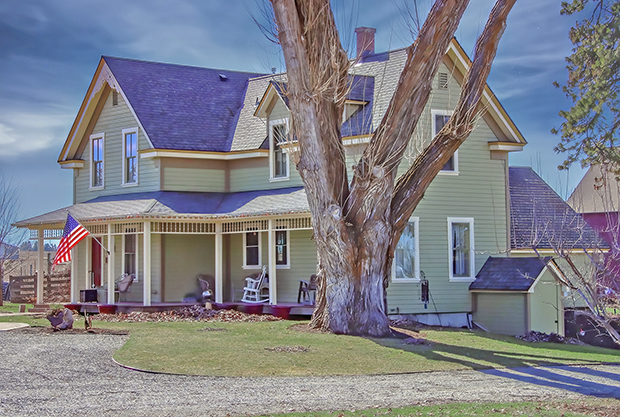
PhotoTitle: The Palmer-Abbeal-Sprague Farmhouse and Barn
PhotoAttribution: Spokane City/County Historic Preservation Office
Listing Status: Spokane Register, National Register
URL: http://properties.historicspokane.org/property/?PropertyID=2056
Display Marker: large_yellow
Title: Palmer-Abbeal-Sprague Farmhouse and Barn
Description: Date Built: 1895
Architect: Eben Ephraim Palmer
Common Name: Sprague House and Barn
Completed in 1895, the Palmer-Abbeal-Sprague Farmhouse, a two-story dwelling built in a gable-front-and-wing plan, is a fine example of the Folk Victorian style and type. The farmhouse's exterior walls are clad with horizontal wood clapboard siding and original windows are tall wood-sash units. Embellished with cornice returns, inset wall dormers and corner boards, the Palmer farmhouse is as stately now as it was in the 1800s. The Palmer-Abbeal-Sprage Barn, which was built in 1905 as part of the farmstead, is located west of the farmhouse and was listed in 2012 on the Washington State Heritage Barn Register. A 1905 fieldstone foundation that once supported a cabbage shed is located on the property west of the farmhouse. Framed by a manicured lawn, wild grasses and a century-old fruit orchard, the farmhouse has undergone modifications since it was built over one-hundred years ago but still retains a great deal of original character. The property retains good integrity in original location, original design, original materials, original workmanship and original association. The house is in excellent condition as a turn-of-the-20th-century farmhouse and was rehabilitated in 2012 using guidelines from the Washington State Department of Archaeology & Historic Preservation.
Location: 47.738019, -117.315374
Address: 6616 East Orchard Road, Spokane WA 99217
PhotoURL:

PhotoTitle: The Palmer-Abbeal-Sprague Farmhouse and Barn
PhotoAttribution: Spokane City/County Historic Preservation Office
Listing Status: Spokane Register, National Register
URL: http://properties.historicspokane.org/property/?PropertyID=2056
Display Marker: large_yellow
ID: 235
Title: Parent House
Description: Date Built: 1916
Architect: Unknown/George M. Baker (builder)
Common Name: Louis and Alma Parent House
Built in 1916, the Louis and Alma Parent House is a fine example of the Craftsman style bungalow. The home embodies typical Craftsman-style features, including an overall low-slung horizontal emphasis, low-pitched roof, widely overhanging eaves, wood shingle siding and wide bargeboards. The interior of the home displays Craftsman-style details such as an inglenook and fireplace with built-ins, mottled green glazed Grueby ceramic tile hearth and a built-in buffet/hutch. The Parent House retains a high degree of exterior and interior architectural integrity and is historically significant for its designation as a single-family residence built in the early 1900s in Spokane.
Location: 47.64149, -117.41745
Address: 411 West 15th Avenue, Spokane WA 99203
PhotoURL:
PhotoTitle: The Louis and Alma Parent House
PhotoAttribution: Spokane City/County Historic Preservation Office
Listing Status: Spokane Register
URL: http://properties.historicspokane.org/property/?PropertyID=2031
Display Marker: large_yellow
Title: Parent House
Description: Date Built: 1916
Architect: Unknown/George M. Baker (builder)
Common Name: Louis and Alma Parent House
Built in 1916, the Louis and Alma Parent House is a fine example of the Craftsman style bungalow. The home embodies typical Craftsman-style features, including an overall low-slung horizontal emphasis, low-pitched roof, widely overhanging eaves, wood shingle siding and wide bargeboards. The interior of the home displays Craftsman-style details such as an inglenook and fireplace with built-ins, mottled green glazed Grueby ceramic tile hearth and a built-in buffet/hutch. The Parent House retains a high degree of exterior and interior architectural integrity and is historically significant for its designation as a single-family residence built in the early 1900s in Spokane.
Location: 47.64149, -117.41745
Address: 411 West 15th Avenue, Spokane WA 99203
PhotoURL:

PhotoTitle: The Louis and Alma Parent House
PhotoAttribution: Spokane City/County Historic Preservation Office
Listing Status: Spokane Register
URL: http://properties.historicspokane.org/property/?PropertyID=2031
Display Marker: large_yellow
ID: 236
Title: Patsy Clark Mansion
Description: Date Built: 1897
Architect: Kirtland K. Cutter
Common Name: Patsy Clark Mansion
Possessing an eclectic mix of styles, this impressive home was built for Spokane mining millionaire, Patrick (Patsy) Clark, and his family. Kirtland K. Cutter, Spokane’s most prolific and celebrated architect, designed the residence to be the "most luxurious mansion ever" following a directive from the owner. Cutter traveled around the world, collecting materials and furnishings for the house - the exterior sepia sandstone is from Italy, the brick was made in St. Louis, Missouri and stained-glass windows were made by Louis Comfort Tiffany in New York City. Clark lived in the mansion until his death in 1915 and his wife, Mary, remained in the house until 1926. Eugene Enloe, an investor, purchased the house and sold it by 1950. The mansion served as the Francis Lester Inn, a restaurant and event house until 1982. It was then restored as Patsy Clark’s Restaurant. The Patsy Clark mansion went through several owners in the late 20th century. It is currently the home of the law firm, Eyman, Allison, Fennessy, Hunter and Jones.
Location: 47.65484, -117.4451
Address: 2208 West 2nd Avenue, Spokane WA 99201
PhotoURL: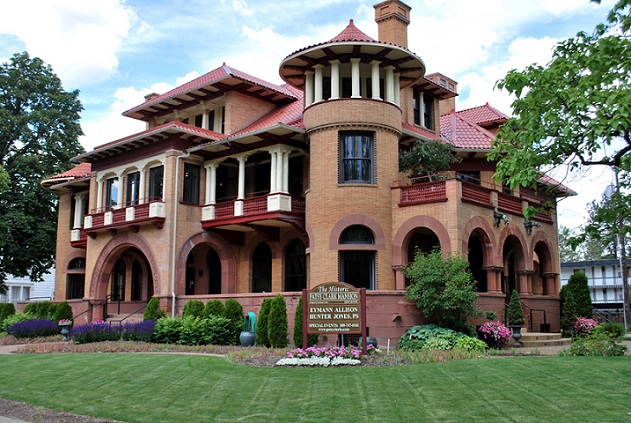
PhotoTitle: The Patsy Clark Mansion
PhotoAttribution: Spokane City/County Historic Preservation Office
Listing Status: Spokane Register, National Register
URL: http://properties.historicspokane.org/property/?PropertyID=1756
Display Marker: large_yellow
Title: Patsy Clark Mansion
Description: Date Built: 1897
Architect: Kirtland K. Cutter
Common Name: Patsy Clark Mansion
Possessing an eclectic mix of styles, this impressive home was built for Spokane mining millionaire, Patrick (Patsy) Clark, and his family. Kirtland K. Cutter, Spokane’s most prolific and celebrated architect, designed the residence to be the "most luxurious mansion ever" following a directive from the owner. Cutter traveled around the world, collecting materials and furnishings for the house - the exterior sepia sandstone is from Italy, the brick was made in St. Louis, Missouri and stained-glass windows were made by Louis Comfort Tiffany in New York City. Clark lived in the mansion until his death in 1915 and his wife, Mary, remained in the house until 1926. Eugene Enloe, an investor, purchased the house and sold it by 1950. The mansion served as the Francis Lester Inn, a restaurant and event house until 1982. It was then restored as Patsy Clark’s Restaurant. The Patsy Clark mansion went through several owners in the late 20th century. It is currently the home of the law firm, Eyman, Allison, Fennessy, Hunter and Jones.
Location: 47.65484, -117.4451
Address: 2208 West 2nd Avenue, Spokane WA 99201
PhotoURL:

PhotoTitle: The Patsy Clark Mansion
PhotoAttribution: Spokane City/County Historic Preservation Office
Listing Status: Spokane Register, National Register
URL: http://properties.historicspokane.org/property/?PropertyID=1756
Display Marker: large_yellow
ID: 237
Title: Pattullo House
Description: Date Built: 1907
Architect: William Ballard, Ballard Plannary Co.
Common Name: Charles and Estella Pattullo House
Built in 1906 and 1907, the Pattullo House is an excellent example of the Craftsman tradition. The home was designed by the Ballard Plannary Company, a noted early 20th-century Spokane architectural firm, and was constructed by the Chamberlin Real Estate & Improvement Company. The April 1907 cover of Chamberlin’s promotional publication, "Spokane’s Home Builders," featured an artist's rendering of the house. Pictured in the Ballard Plannary Company’s c. 1910-11 house plan book "The Modern Bungalow," a photograph of the house was underscored with a caption that described the home as “strictly California in design,” and professed the beautiful residence was admired by scores of people. The house was built for Estella Pattullo and her husband, Charles F. G. Pattullo, founder, president, and general manager of the Oregon Mortgage Company of Spokane for 43 years.
Location: 47.64423, -117.43066
Address: 1201 South Adams Street, Spokane WA 99204
PhotoURL: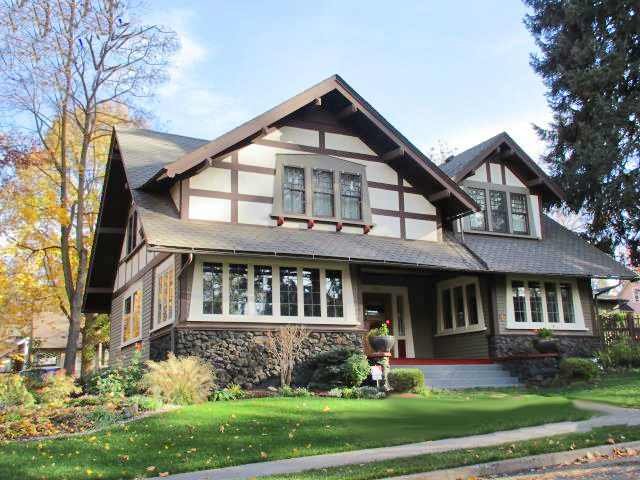
PhotoTitle: The Charles and Estella Pattullo House
PhotoAttribution: Spokane City/County Historic Preservation Office
Listing Status: Spokane Register
URL: http://properties.historicspokane.org/property/?PropertyID=1902
Display Marker: large_yellow
Title: Pattullo House
Description: Date Built: 1907
Architect: William Ballard, Ballard Plannary Co.
Common Name: Charles and Estella Pattullo House
Built in 1906 and 1907, the Pattullo House is an excellent example of the Craftsman tradition. The home was designed by the Ballard Plannary Company, a noted early 20th-century Spokane architectural firm, and was constructed by the Chamberlin Real Estate & Improvement Company. The April 1907 cover of Chamberlin’s promotional publication, "Spokane’s Home Builders," featured an artist's rendering of the house. Pictured in the Ballard Plannary Company’s c. 1910-11 house plan book "The Modern Bungalow," a photograph of the house was underscored with a caption that described the home as “strictly California in design,” and professed the beautiful residence was admired by scores of people. The house was built for Estella Pattullo and her husband, Charles F. G. Pattullo, founder, president, and general manager of the Oregon Mortgage Company of Spokane for 43 years.
Location: 47.64423, -117.43066
Address: 1201 South Adams Street, Spokane WA 99204
PhotoURL:

PhotoTitle: The Charles and Estella Pattullo House
PhotoAttribution: Spokane City/County Historic Preservation Office
Listing Status: Spokane Register
URL: http://properties.historicspokane.org/property/?PropertyID=1902
Display Marker: large_yellow
ID: 238
Title: Paulsen Building
Description: Date Built: 1908
Architect: Dow & Hubbell and Gustav A. Pehrson
Common Name: The Paulsen Center
The Paulsen Center is one of the most prominent features of the Spokane skyline. It consists of two buildings: the August Paulsen Building, designed by architects Dow and Hubbel and built in 1908-1911, and the Paulsen Medical and Dental Building, designed by architect Gustav A. Pehson and built in 1928-29 after Paulsen's death. It is architecturally significant because it used the newest form of all steel construction, which allowed it to be the tallest building in Spokane at that time. It illustrates the early formula for high-rise construction, which divided a building into three parts: a base, a shaft housing identical floors of offices, and an elaborate cornice crowning the composition. The style is generally associated with The Chicago School, referring to the skyscraper movement and the influence of Louis Sullivan. Pehrson designed the fifteen story Medical and Dental Building in the Art Deco style with Spanish and Moorish styled exterior and interior detailing. Its stepped crown rises to a set-back penthouse that members of the Paulsen family have occupied since the building was erected.
Location: 47.65768, -117.4188
Address: 421 West Riverside Avenue, Spokane WA 99201
PhotoURL: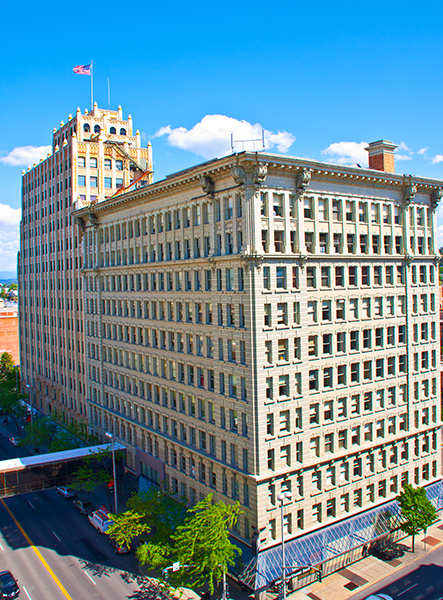
PhotoTitle: The Paulsen Building
PhotoAttribution: Spokane City/County Historic Preservation Office
Listing Status: Spokane Register
URL: http://properties.historicspokane.org/property/?PropertyID=1903
Display Marker: large_yellow
Title: Paulsen Building
Description: Date Built: 1908
Architect: Dow & Hubbell and Gustav A. Pehrson
Common Name: The Paulsen Center
The Paulsen Center is one of the most prominent features of the Spokane skyline. It consists of two buildings: the August Paulsen Building, designed by architects Dow and Hubbel and built in 1908-1911, and the Paulsen Medical and Dental Building, designed by architect Gustav A. Pehson and built in 1928-29 after Paulsen's death. It is architecturally significant because it used the newest form of all steel construction, which allowed it to be the tallest building in Spokane at that time. It illustrates the early formula for high-rise construction, which divided a building into three parts: a base, a shaft housing identical floors of offices, and an elaborate cornice crowning the composition. The style is generally associated with The Chicago School, referring to the skyscraper movement and the influence of Louis Sullivan. Pehrson designed the fifteen story Medical and Dental Building in the Art Deco style with Spanish and Moorish styled exterior and interior detailing. Its stepped crown rises to a set-back penthouse that members of the Paulsen family have occupied since the building was erected.
Location: 47.65768, -117.4188
Address: 421 West Riverside Avenue, Spokane WA 99201
PhotoURL:

PhotoTitle: The Paulsen Building
PhotoAttribution: Spokane City/County Historic Preservation Office
Listing Status: Spokane Register
URL: http://properties.historicspokane.org/property/?PropertyID=1903
Display Marker: large_yellow
ID: 239
Title: Pettet House
Description: Date Built: 1885
Architect: Unknown
Common Name: Glasgow Lodge
Built in 1885, the Pettet House-Glasgow Lodge is one of the oldest surviving single-family homes in Spokane. The house is an eclectic blend of Stick and Queen Anne architectural styles and features a center two-story gable-front with single-story wings attached to the east and west sides of the home. The house was built for Caroline and William Pettet, a Spokane pioneer, civic leader, real estate promoter, and a very prominent citizens of Spokane.
Location: 47.6738, -117.44622
Address: 1735 North West Point Road, Spokane WA 99201
PhotoURL: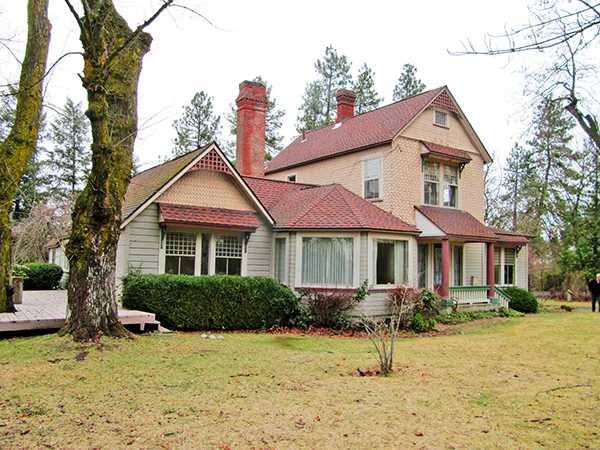
PhotoTitle: The Pettet House
PhotoAttribution: Spokane City/County Historic Preservation Office
Listing Status: Spokane Register
URL: http://properties.historicspokane.org/property/?PropertyID=2048
Display Marker: large_yellow
Title: Pettet House
Description: Date Built: 1885
Architect: Unknown
Common Name: Glasgow Lodge
Built in 1885, the Pettet House-Glasgow Lodge is one of the oldest surviving single-family homes in Spokane. The house is an eclectic blend of Stick and Queen Anne architectural styles and features a center two-story gable-front with single-story wings attached to the east and west sides of the home. The house was built for Caroline and William Pettet, a Spokane pioneer, civic leader, real estate promoter, and a very prominent citizens of Spokane.
Location: 47.6738, -117.44622
Address: 1735 North West Point Road, Spokane WA 99201
PhotoURL:

PhotoTitle: The Pettet House
PhotoAttribution: Spokane City/County Historic Preservation Office
Listing Status: Spokane Register
URL: http://properties.historicspokane.org/property/?PropertyID=2048
Display Marker: large_yellow
ID: 240
Title: Peyton Building and Annex
Description: Date Built: 1898
Architect: Herman Preusse, Kirtland K. Cutter & Karl Malmgren, and Robert Sweatt & Archibald Rigg
Common Name: Peyton Building and Annex
Built in 1898, the Peyton Building rose from the ashes of the Great Eastern Building (1890), which suffered a tragic fire that left only the exterior walls intact. Colonel Isaac N. Peyton purchased the property in 1898 and built the Peyton using the remaining walls of the Great Eastern. In 1908, the Peyton Annex at 10 N. Post Street was constructed adjacent (south) of the Peyton Building. At the time, the Annex was only the second reinforced concrete building in Spokane (the Holley-Mason Building was the first). Seven stories, the Annex is characterized by its three classical parts: base, shaft, and capital. Both the Peyton Building and Annex were known as first class commercial locations called the "million-dollar corner." The Peyton Building and Peyton Annex stand together as one of several remaining large commercial buildings in downtown Spokane designed in the Romanesque revival and Commercial styles.
Location: 47.65755, -117.42318
Address: 722 West Sprague Avenue, Spokane WA 99201
PhotoURL: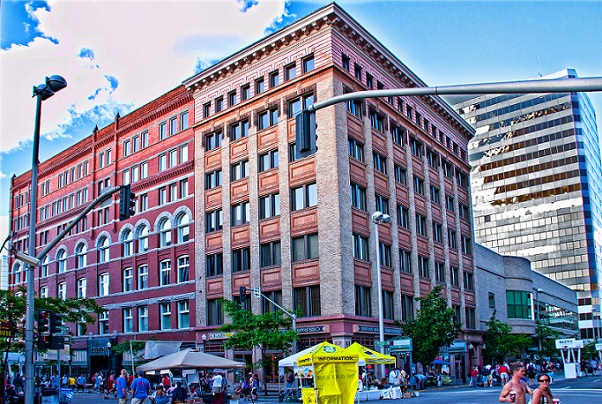
PhotoTitle: The Peyton Building and Annex
PhotoAttribution: Spokane City/County Historic Preservation Office
Listing Status: Spokane Register, National Register
URL: http://properties.historicspokane.org/property/?PropertyID=1904
Display Marker: large_yellow
Title: Peyton Building and Annex
Description: Date Built: 1898
Architect: Herman Preusse, Kirtland K. Cutter & Karl Malmgren, and Robert Sweatt & Archibald Rigg
Common Name: Peyton Building and Annex
Built in 1898, the Peyton Building rose from the ashes of the Great Eastern Building (1890), which suffered a tragic fire that left only the exterior walls intact. Colonel Isaac N. Peyton purchased the property in 1898 and built the Peyton using the remaining walls of the Great Eastern. In 1908, the Peyton Annex at 10 N. Post Street was constructed adjacent (south) of the Peyton Building. At the time, the Annex was only the second reinforced concrete building in Spokane (the Holley-Mason Building was the first). Seven stories, the Annex is characterized by its three classical parts: base, shaft, and capital. Both the Peyton Building and Annex were known as first class commercial locations called the "million-dollar corner." The Peyton Building and Peyton Annex stand together as one of several remaining large commercial buildings in downtown Spokane designed in the Romanesque revival and Commercial styles.
Location: 47.65755, -117.42318
Address: 722 West Sprague Avenue, Spokane WA 99201
PhotoURL:

PhotoTitle: The Peyton Building and Annex
PhotoAttribution: Spokane City/County Historic Preservation Office
Listing Status: Spokane Register, National Register
URL: http://properties.historicspokane.org/property/?PropertyID=1904
Display Marker: large_yellow
ID: 241
Title: Phelps House
Description: Date Built: 1901
Architect: Albert Held/David Fotheringham
Common Name: Moses and Netta Phelps House
Built in 1901, the Moses & Netta Phelps House is a fine example of the Free Classic Queen Anne style. The Phelps House was built by accomplished Spokane contractor David Fotheringham for Netta & Moses Augustus Phelps, a successful Spokane businessman, real estate investor, and "Spokane pioneer lumberman and banker" who helped form and manage the Wadsworth & Phelps Lumber Company, succeeded by the M. A. Phelps Lumber Company. Netta Wells Sheldon Phelps, wife to Moses Phelps and a well-known Spokane socialite and civic benefactress, was venerated for her work as a historical author, a Washington State Regent for the Daughters of the American Revolution, and as a philanthropist during her long and busy life spent in service to others.
Location: 47.65483, -117.44398
Address: 2118 West 2nd Avenue, Spokane WA 99201
PhotoURL: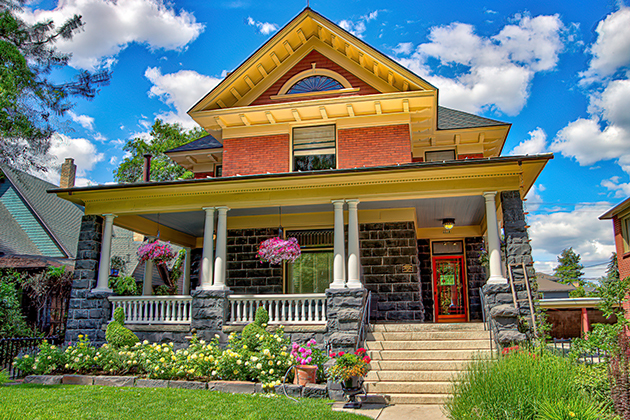
PhotoTitle: The Moses and Netta Phelps House
PhotoAttribution: Spokane City/County Historic Preservation Office
Listing Status: Spokane Register, National Register
URL: http://properties.historicspokane.org/property/?PropertyID=1905
Display Marker: large_yellow
Title: Phelps House
Description: Date Built: 1901
Architect: Albert Held/David Fotheringham
Common Name: Moses and Netta Phelps House
Built in 1901, the Moses & Netta Phelps House is a fine example of the Free Classic Queen Anne style. The Phelps House was built by accomplished Spokane contractor David Fotheringham for Netta & Moses Augustus Phelps, a successful Spokane businessman, real estate investor, and "Spokane pioneer lumberman and banker" who helped form and manage the Wadsworth & Phelps Lumber Company, succeeded by the M. A. Phelps Lumber Company. Netta Wells Sheldon Phelps, wife to Moses Phelps and a well-known Spokane socialite and civic benefactress, was venerated for her work as a historical author, a Washington State Regent for the Daughters of the American Revolution, and as a philanthropist during her long and busy life spent in service to others.
Location: 47.65483, -117.44398
Address: 2118 West 2nd Avenue, Spokane WA 99201
PhotoURL:

PhotoTitle: The Moses and Netta Phelps House
PhotoAttribution: Spokane City/County Historic Preservation Office
Listing Status: Spokane Register, National Register
URL: http://properties.historicspokane.org/property/?PropertyID=1905
Display Marker: large_yellow
ID: 242
Title: Phillips-Mitchem House
Description: Date Built: 1911
Architect: Earl Morrison/Amil T. Johnson
Common Name: Phillips-Mitchen House
The Phillips-Mitchem House was built in 1911 by the Kiernan Land Company and Maxwell Phillips, a real estate agent employed by the Western Trust & Investment Company. As the Kiernan Land Company developed the South Side Cable Addition on Spokane’s South Hill, Phillips invested in property in the Addition as an independent investor and real estate speculator. After construction of the Phillips-Mitchem House was complete, Maxwell Phillips and his wife, Ethel Phillips, lived at the residence for a few months then sold it for $12,000 to Henry and Clarissa Mitchem who arrived in Spokane in the early 1870s. The Phillips-Mitchem House is an outstanding example of eclectic Arts & Crafts-period styling with strong influence from the Tudor Revival and Craftsman traditions. The Phillips-Mitchem House is a tangible expression of the developer's intentions for the South Side Cable Addition of the trends, reflecting patterns that led to the adoption of subdivision regulations and covenants in Spokane residential neighborhoods.
Location: 47.64203, -117.41928
Address: 458 West 15th Avenue, Spokane WA 99203
PhotoURL: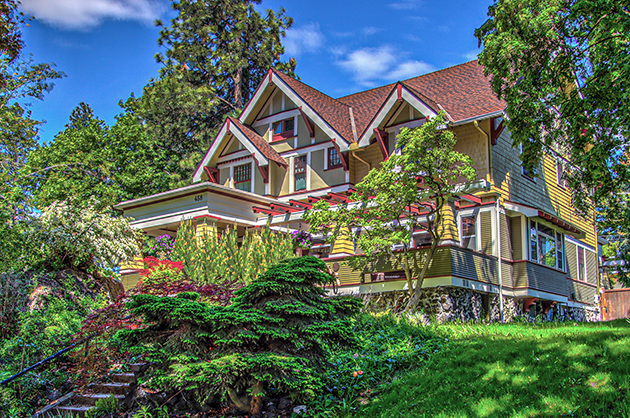
PhotoTitle: The Phillips-Mitchem House
PhotoAttribution: Spokane City/County Historic Preservation Office
Listing Status: Spokane Register
URL: http://properties.historicspokane.org/property/?PropertyID=1906
Display Marker: large_yellow
Title: Phillips-Mitchem House
Description: Date Built: 1911
Architect: Earl Morrison/Amil T. Johnson
Common Name: Phillips-Mitchen House
The Phillips-Mitchem House was built in 1911 by the Kiernan Land Company and Maxwell Phillips, a real estate agent employed by the Western Trust & Investment Company. As the Kiernan Land Company developed the South Side Cable Addition on Spokane’s South Hill, Phillips invested in property in the Addition as an independent investor and real estate speculator. After construction of the Phillips-Mitchem House was complete, Maxwell Phillips and his wife, Ethel Phillips, lived at the residence for a few months then sold it for $12,000 to Henry and Clarissa Mitchem who arrived in Spokane in the early 1870s. The Phillips-Mitchem House is an outstanding example of eclectic Arts & Crafts-period styling with strong influence from the Tudor Revival and Craftsman traditions. The Phillips-Mitchem House is a tangible expression of the developer's intentions for the South Side Cable Addition of the trends, reflecting patterns that led to the adoption of subdivision regulations and covenants in Spokane residential neighborhoods.
Location: 47.64203, -117.41928
Address: 458 West 15th Avenue, Spokane WA 99203
PhotoURL:

PhotoTitle: The Phillips-Mitchem House
PhotoAttribution: Spokane City/County Historic Preservation Office
Listing Status: Spokane Register
URL: http://properties.historicspokane.org/property/?PropertyID=1906
Display Marker: large_yellow
ID: 243
Title: Pietsch House
Description: Date Built: 1891
Architect: Franz Pietsch
Common Name: Franz Pietsch House
The oldest brick single family home in Peaceful Valley, the Pietsch House was built in 1891 by German immigrant, stonemason, and bricklayer Franz Pietsch and his sons Louis and Max. Together with his sons, Pietsch helped build the Great Northern Railroad clock tower, the Davenport Hotel, Medical Lake Hospital and many other downtown Spokane buildings. Displaying fine quality craftsmanship, the Pietsch House represents the development of Peaceful Valley and the ultimate building ideal of the skilled working class craftsmen who settled in the Valley and constructed their own homes.
Location: 47.65877, -117.437
Address: 1647 West Main Avenue, Spokane WA 99201
PhotoURL: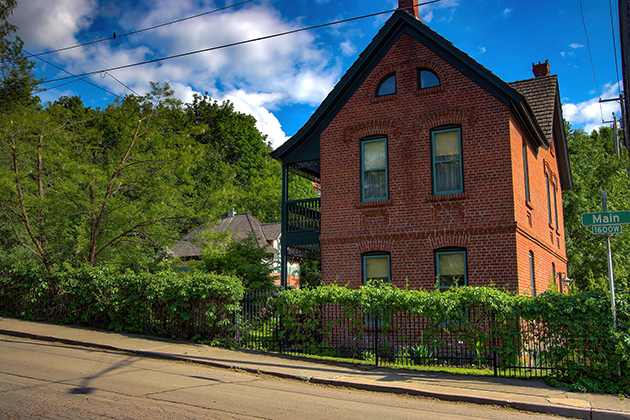
PhotoTitle: The Franz Pietsch House
PhotoAttribution: Spokane City/County Historic Preservation Office
Listing Status: Spokane Register, National Register
URL: http://properties.historicspokane.org/property/?PropertyID=1907
Display Marker: large_yellow
Title: Pietsch House
Description: Date Built: 1891
Architect: Franz Pietsch
Common Name: Franz Pietsch House
The oldest brick single family home in Peaceful Valley, the Pietsch House was built in 1891 by German immigrant, stonemason, and bricklayer Franz Pietsch and his sons Louis and Max. Together with his sons, Pietsch helped build the Great Northern Railroad clock tower, the Davenport Hotel, Medical Lake Hospital and many other downtown Spokane buildings. Displaying fine quality craftsmanship, the Pietsch House represents the development of Peaceful Valley and the ultimate building ideal of the skilled working class craftsmen who settled in the Valley and constructed their own homes.
Location: 47.65877, -117.437
Address: 1647 West Main Avenue, Spokane WA 99201
PhotoURL:

PhotoTitle: The Franz Pietsch House
PhotoAttribution: Spokane City/County Historic Preservation Office
Listing Status: Spokane Register, National Register
URL: http://properties.historicspokane.org/property/?PropertyID=1907
Display Marker: large_yellow
ID: 244
Title: Pine Creek Dairy Creamery
Description: Date Built: 1908
Architect: Unknown
Common Name: Pine Creek Dairy Creamery
Built in 1908, the Pine Creek Dairy Creamery building is a good example of early commercial/industrial brick masonry blocks that were built throughout east downtown Spokane during the early 1900s. A 1909 Spokesman-Review article described The Pine Creek Dairy as the Ňlargest producer of milk in the territory." The dairy included a rural farm with milking operations that supported 120 cows, and a creamery building at 168 S. Division Street. The creamery building housed the dairy's office, warehouse, distribution sales center, and processing plant, which manufactured cream, butter, and cheese. The dairy was owned and operated by William C. Sohns, who was regarded as one of Spokane's most trusted and influential dairymen.
Location: 47.655, -117.41165
Address: 168 South Division Street, Spokane WA 99202
PhotoURL:
PhotoTitle: The Pine Creek Dairy Creamery
PhotoAttribution: Spokane City/County Historic Preservation Office
Listing Status: Spokane Register, National Register
URL: http://properties.historicspokane.org/property/?PropertyID=1908
Display Marker: large_yellow
Title: Pine Creek Dairy Creamery
Description: Date Built: 1908
Architect: Unknown
Common Name: Pine Creek Dairy Creamery
Built in 1908, the Pine Creek Dairy Creamery building is a good example of early commercial/industrial brick masonry blocks that were built throughout east downtown Spokane during the early 1900s. A 1909 Spokesman-Review article described The Pine Creek Dairy as the Ňlargest producer of milk in the territory." The dairy included a rural farm with milking operations that supported 120 cows, and a creamery building at 168 S. Division Street. The creamery building housed the dairy's office, warehouse, distribution sales center, and processing plant, which manufactured cream, butter, and cheese. The dairy was owned and operated by William C. Sohns, who was regarded as one of Spokane's most trusted and influential dairymen.
Location: 47.655, -117.41165
Address: 168 South Division Street, Spokane WA 99202
PhotoURL:

PhotoTitle: The Pine Creek Dairy Creamery
PhotoAttribution: Spokane City/County Historic Preservation Office
Listing Status: Spokane Register, National Register
URL: http://properties.historicspokane.org/property/?PropertyID=1908
Display Marker: large_yellow
ID: 245
Title: Piollet House
Description: Date Built: 1923
Architect: Unknown/Artes J. Chitty
Common Name: Violet and Jean Poillet House
Constructed in 1923, the Victor & Jean Piollet House is a unique expression of the Colonial Revival style with influences from Craftsman, French Eclectic, and Italian Renaissance traditions. The most striking feature of the home is its exterior cladding, a decorative veneer of high-quality multi-colored glazed enamel-faced brick that completely covers the first and second floors of the two-story house. Similar in appearance to large glazed ceramic subway tiles, glazed enameled face bricks were sometimes used in Spokane as exterior veneer material on commercial buildings and only rarely on single-family homes, mostly as decorative embellishment at front entrances. The Piollet House may be the only home in Spokane which is entirely clad with decorative enameled face brick. The garage, built in 1928 behind the Piollet House, is made of hollow-core ceramic tile block construction and is covered with a glazed red tile roof. The garage's hollow-core ceramic tile blocks and glazed ceramic roof tiles, and the home's enameled face bricks were all made by the Washington Brick, Lime & Sewer Pipe Company which advanced a creative marketing approach in the 1920s when they showcased their products at the Piollet House and garage. A pioneer in the brick and tile business, the Washington Brick, Lime, & Sewer Pipe Company was, at the turn of the 20th-century, one of the first and largest brick manufacturing facilities in the state of Washington, and was in production in the Spokane area for more than 70 years. The company's marketing approach also included the property's first owners Jean & Victor Piollet, the sales manager and later, vice-president, of the Washington Brick, Lime & Sewer Pipe Company from 1912 through 1932.
Location: 47.64112, -117.4208
Address: 606 West 16th Avenue, Spokane WA 99203
PhotoURL: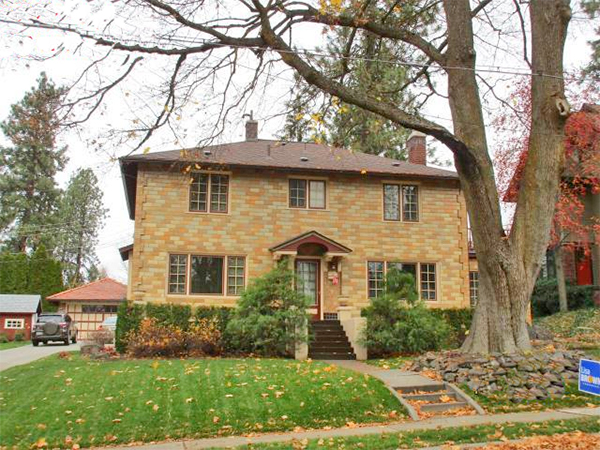
PhotoTitle: The Victor and Jean Piollet House
PhotoAttribution: Spokane City/County Historic Preservation Office
Listing Status: Spokane Register, National Register
URL: http://properties.historicspokane.org/property/?PropertyID=1909
Display Marker: large_yellow
Title: Piollet House
Description: Date Built: 1923
Architect: Unknown/Artes J. Chitty
Common Name: Violet and Jean Poillet House
Constructed in 1923, the Victor & Jean Piollet House is a unique expression of the Colonial Revival style with influences from Craftsman, French Eclectic, and Italian Renaissance traditions. The most striking feature of the home is its exterior cladding, a decorative veneer of high-quality multi-colored glazed enamel-faced brick that completely covers the first and second floors of the two-story house. Similar in appearance to large glazed ceramic subway tiles, glazed enameled face bricks were sometimes used in Spokane as exterior veneer material on commercial buildings and only rarely on single-family homes, mostly as decorative embellishment at front entrances. The Piollet House may be the only home in Spokane which is entirely clad with decorative enameled face brick. The garage, built in 1928 behind the Piollet House, is made of hollow-core ceramic tile block construction and is covered with a glazed red tile roof. The garage's hollow-core ceramic tile blocks and glazed ceramic roof tiles, and the home's enameled face bricks were all made by the Washington Brick, Lime & Sewer Pipe Company which advanced a creative marketing approach in the 1920s when they showcased their products at the Piollet House and garage. A pioneer in the brick and tile business, the Washington Brick, Lime, & Sewer Pipe Company was, at the turn of the 20th-century, one of the first and largest brick manufacturing facilities in the state of Washington, and was in production in the Spokane area for more than 70 years. The company's marketing approach also included the property's first owners Jean & Victor Piollet, the sales manager and later, vice-president, of the Washington Brick, Lime & Sewer Pipe Company from 1912 through 1932.
Location: 47.64112, -117.4208
Address: 606 West 16th Avenue, Spokane WA 99203
PhotoURL:

PhotoTitle: The Victor and Jean Piollet House
PhotoAttribution: Spokane City/County Historic Preservation Office
Listing Status: Spokane Register, National Register
URL: http://properties.historicspokane.org/property/?PropertyID=1909
Display Marker: large_yellow
ID: 246
Title: Plante's Ferry Park
Description: Date Built: Architect: Unknown
Common Name: Plante's Ferry Park
Plante's Ferry Park is significant for several reasons. From 1851 to 1876, the park was the site of the first authorized ferry across the Spokane River and was operated by Antoine Plante, a French Canadian voyageur who came overland with the Astor party, settled in Spokane Valley near what is now the town of Millwood in 1849. In 1861, an act was passed authorizing "Antoine Plante his heirs and assigns to establish and keep a ferry across the Spokane River at or near the point where the military road (Mullan Trail) from Fort Walla Walla to Fort Benton crosses said river." Plante's Ferry was also the site of Antoine's first residence in 1849. In 1865, Isaac Kellogg built a bridge here that connected both sides of the river.
Location: 47.699469, -117.240752
Address: 12308 East Upriver Drive, Spokane WA 99216
PhotoURL: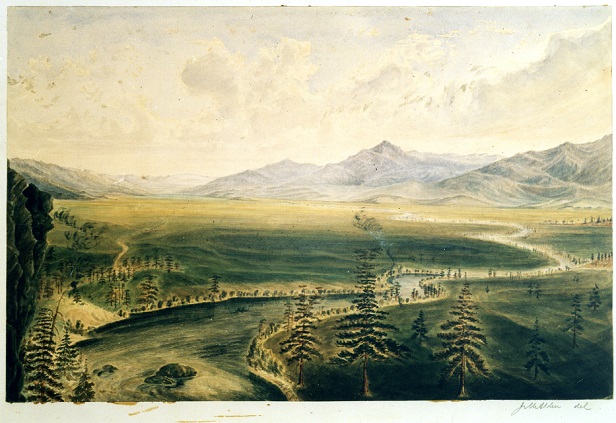
PhotoTitle: Plante's Ferry Park
PhotoAttribution: Spokane City/County Historic Preservation Office
Listing Status: N/A
URL: http://properties.historicspokane.org/property/?PropertyID=2010
Display Marker: large_yellow
Title: Plante's Ferry Park
Description: Date Built: Architect: Unknown
Common Name: Plante's Ferry Park
Plante's Ferry Park is significant for several reasons. From 1851 to 1876, the park was the site of the first authorized ferry across the Spokane River and was operated by Antoine Plante, a French Canadian voyageur who came overland with the Astor party, settled in Spokane Valley near what is now the town of Millwood in 1849. In 1861, an act was passed authorizing "Antoine Plante his heirs and assigns to establish and keep a ferry across the Spokane River at or near the point where the military road (Mullan Trail) from Fort Walla Walla to Fort Benton crosses said river." Plante's Ferry was also the site of Antoine's first residence in 1849. In 1865, Isaac Kellogg built a bridge here that connected both sides of the river.
Location: 47.699469, -117.240752
Address: 12308 East Upriver Drive, Spokane WA 99216
PhotoURL:

PhotoTitle: Plante's Ferry Park
PhotoAttribution: Spokane City/County Historic Preservation Office
Listing Status: N/A
URL: http://properties.historicspokane.org/property/?PropertyID=2010
Display Marker: large_yellow
ID: 247
Title: Porter House
Description: Date Built: 1913
Architect: Unknown/Gustav Bostrom (builder)
Common Name: A.L. Porter House
The well-preserved A.L. Porter House is an exceptional example of the Italian Renaissance architectural style based on sixteenth-century villas, rarely seen in Spokane. It was constructed in 1913 by building contractor and real estate developer Gus Bostrom, then purchased by Spokane lumber entrepreneur A.L. Porter.
Location: 47.63617, -117.42321
Address: 725 West 20th Avenue, Spokane WA 99203
PhotoURL: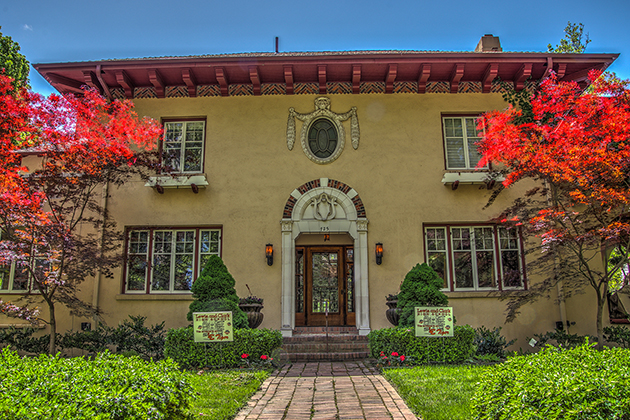
PhotoTitle: The A. L. Porter House
PhotoAttribution: Spokane City/County Historic Preservation Office
Listing Status: Spokane Register
URL: http://properties.historicspokane.org/property/?PropertyID=1910
Display Marker: large_yellow
Title: Porter House
Description: Date Built: 1913
Architect: Unknown/Gustav Bostrom (builder)
Common Name: A.L. Porter House
The well-preserved A.L. Porter House is an exceptional example of the Italian Renaissance architectural style based on sixteenth-century villas, rarely seen in Spokane. It was constructed in 1913 by building contractor and real estate developer Gus Bostrom, then purchased by Spokane lumber entrepreneur A.L. Porter.
Location: 47.63617, -117.42321
Address: 725 West 20th Avenue, Spokane WA 99203
PhotoURL:

PhotoTitle: The A. L. Porter House
PhotoAttribution: Spokane City/County Historic Preservation Office
Listing Status: Spokane Register
URL: http://properties.historicspokane.org/property/?PropertyID=1910
Display Marker: large_yellow
ID: 248
Title: Powell House
Description: Date Built: 1899
Architect: Loren L. Rand
Common Name: Edward and Dora Powell House
The E. L. Powell House was built in 1899 for Edward Louis Powell, Spokane's mayor from 1893-94, and his wife Dora. The Powell House remained in the family after E. L. Powell's death, when his daughter Gerta moved in to the home with her husband James Rigsby. Dora also remained in the house until her death in 1920. In 1954 the house was converted to apartments, but was later converted to a single-family residence. The home represents master architect Loren L. Rand's interpretation of the restrained Queen Anne style of architecture. For the Powells, Rand elaborated on a common Queen Anne form by mixing decorative elements from different subtypes in an elegantly subtle way.
Location: 47.6566, -117.43827
Address: 1728 West 1st Avenue, Spokane WA 99201
PhotoURL: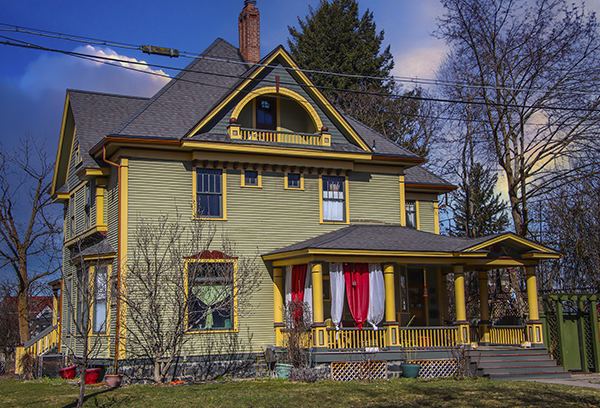
PhotoTitle: The Edward and Dora Powell House
PhotoAttribution: Spokane City/County Historic Preservation Office
Listing Status: Spokane Register, National Register
URL: http://properties.historicspokane.org/property/?PropertyID=1911
Display Marker: large_yellow
Title: Powell House
Description: Date Built: 1899
Architect: Loren L. Rand
Common Name: Edward and Dora Powell House
The E. L. Powell House was built in 1899 for Edward Louis Powell, Spokane's mayor from 1893-94, and his wife Dora. The Powell House remained in the family after E. L. Powell's death, when his daughter Gerta moved in to the home with her husband James Rigsby. Dora also remained in the house until her death in 1920. In 1954 the house was converted to apartments, but was later converted to a single-family residence. The home represents master architect Loren L. Rand's interpretation of the restrained Queen Anne style of architecture. For the Powells, Rand elaborated on a common Queen Anne form by mixing decorative elements from different subtypes in an elegantly subtle way.
Location: 47.6566, -117.43827
Address: 1728 West 1st Avenue, Spokane WA 99201
PhotoURL:

PhotoTitle: The Edward and Dora Powell House
PhotoAttribution: Spokane City/County Historic Preservation Office
Listing Status: Spokane Register, National Register
URL: http://properties.historicspokane.org/property/?PropertyID=1911
Display Marker: large_yellow
ID: 249
Title: Ralston House
Description: Date Built: 1900
Architect: J.C. Ralston (house), Kirtland Cutter (pavilions)
Common Name: J.C. Ralston House
The Ralston House is historically significant for its association with John C. Ralston, the Spokane civic engineer who designed and built it in 1900. The house reflects the influence of the Tudor Revival style, as interpreted by Ralston. Ralston was employed as the City of Spokane's chief engineer from 1907 to 1910 when he planned and designed more than $8 million worth of municipal improvements in the city, including many miles of pavement and six of the nine concrete arch bridges erected during Spokane's "Golden Age of Bridge Building." His most noteworthy contribution to Spokane is the Monroe Street Bridge, a city landmark completed in 1911 listed on the National Register of Historic Places in 1975. The home remained in the Ralston family for 90 years.
Location: 47.67142, -117.44808
Address: 2421 West Mission Avenue, Spokane WA 99201
PhotoURL: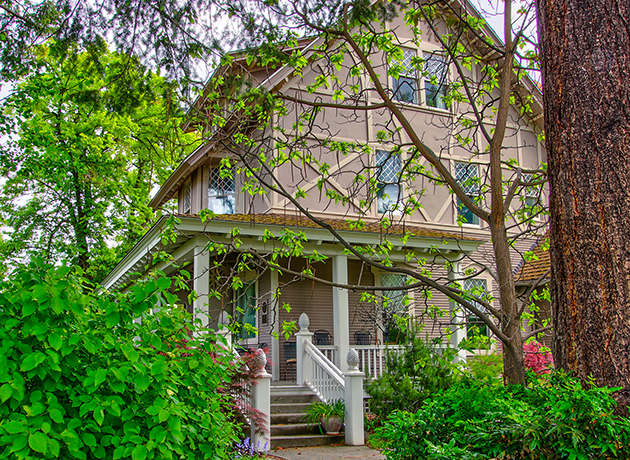
PhotoTitle: The John C. Ralston House
PhotoAttribution: Spokane City/County Historic Preservation Office
Listing Status: Spokane Register, National Register
URL: http://properties.historicspokane.org/property/?PropertyID=1912
Display Marker: large_yellow
Title: Ralston House
Description: Date Built: 1900
Architect: J.C. Ralston (house), Kirtland Cutter (pavilions)
Common Name: J.C. Ralston House
The Ralston House is historically significant for its association with John C. Ralston, the Spokane civic engineer who designed and built it in 1900. The house reflects the influence of the Tudor Revival style, as interpreted by Ralston. Ralston was employed as the City of Spokane's chief engineer from 1907 to 1910 when he planned and designed more than $8 million worth of municipal improvements in the city, including many miles of pavement and six of the nine concrete arch bridges erected during Spokane's "Golden Age of Bridge Building." His most noteworthy contribution to Spokane is the Monroe Street Bridge, a city landmark completed in 1911 listed on the National Register of Historic Places in 1975. The home remained in the Ralston family for 90 years.
Location: 47.67142, -117.44808
Address: 2421 West Mission Avenue, Spokane WA 99201
PhotoURL:

PhotoTitle: The John C. Ralston House
PhotoAttribution: Spokane City/County Historic Preservation Office
Listing Status: Spokane Register, National Register
URL: http://properties.historicspokane.org/property/?PropertyID=1912
Display Marker: large_yellow
ID: 250
Title: Realty Building
Description: Date Built: 1910
Architect: Albert Held
Common Name: The Delaney
The Realty Building, erected in 1910 and designed by master architect, Albert Held, was one of the first and tallest skyscrapers built in Spokane. Towering eight stories above Riverside Avenue, the building also possesses a delicate and decorative sculpted facade which is artfully rendered in smooth, reflective, cream-colored, glazed terra cotta. The building was originally constructed for the Spokane Realty Company, a group of businessmen and city boosters interested in positive planned growth for the region, and the architectural style and materials used reflects their "Pro-Spokane" vision. It was around this time that new, tall, elegant buildings with exquisite details began to replace the plain, no-frill brick masonry structures which were erected quickly after the Great Fire of 1889. The Realty Building, in fact, was also praised as being one of the leading fireproof structures in the city. The Realty Building was home to a variety of businesses and even served as the Spokane Police Department headquarters until eventually becoming the Delaney Apartments in 1971.
Location: 47.65831, -117.415
Address: 242 West Riverside Avenue, Spokane WA 99201
PhotoURL: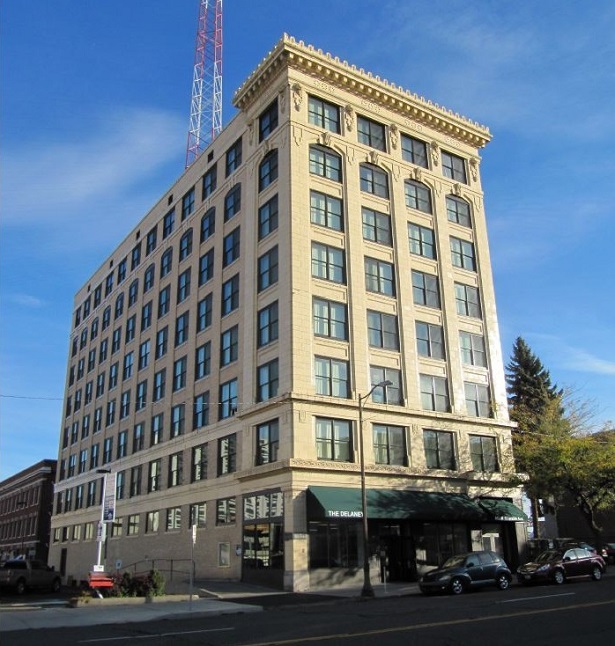
PhotoTitle: The Realty Building
PhotoAttribution: Spokane City/County Historic Preservation Office
Listing Status: Spokane Register, National Register
URL: http://properties.historicspokane.org/property/?PropertyID=2078
Display Marker: large_yellow
Title: Realty Building
Description: Date Built: 1910
Architect: Albert Held
Common Name: The Delaney
The Realty Building, erected in 1910 and designed by master architect, Albert Held, was one of the first and tallest skyscrapers built in Spokane. Towering eight stories above Riverside Avenue, the building also possesses a delicate and decorative sculpted facade which is artfully rendered in smooth, reflective, cream-colored, glazed terra cotta. The building was originally constructed for the Spokane Realty Company, a group of businessmen and city boosters interested in positive planned growth for the region, and the architectural style and materials used reflects their "Pro-Spokane" vision. It was around this time that new, tall, elegant buildings with exquisite details began to replace the plain, no-frill brick masonry structures which were erected quickly after the Great Fire of 1889. The Realty Building, in fact, was also praised as being one of the leading fireproof structures in the city. The Realty Building was home to a variety of businesses and even served as the Spokane Police Department headquarters until eventually becoming the Delaney Apartments in 1971.
Location: 47.65831, -117.415
Address: 242 West Riverside Avenue, Spokane WA 99201
PhotoURL:

PhotoTitle: The Realty Building
PhotoAttribution: Spokane City/County Historic Preservation Office
Listing Status: Spokane Register, National Register
URL: http://properties.historicspokane.org/property/?PropertyID=2078
Display Marker: large_yellow
ID: 251
Title: Reid House
Description: Date Built: 1900
Architect: Albert Held
Common Name: Dr. Peter & Jean Reid House
Built in 1900 and designed by prominent Spokane architect Albert Held, the Reid House is one of the finest examples of Craftsman Bungalow style architecture in Spokane. In continuous use as a single-family residence for over 100 years, the house has been home to four of Spokane's most prominent families: early pioneer banker Aaron Kuhn and his wife Leah; noted physician and surgeon Dr. Peter Reid and his wife Jean and their son, Dr. Robert Reid.
Location: 47.65619, -117.44686
Address: 2315 West 1st Avenue, Spokane WA 99201
PhotoURL: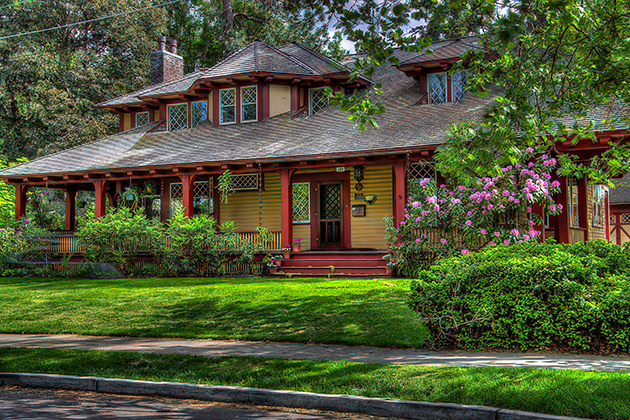
PhotoTitle: The Dr. Peter and Jean Reid House
PhotoAttribution: Spokane City/County Historic Preservation Office
Listing Status: Spokane Register, National Register
URL: http://properties.historicspokane.org/property/?PropertyID=1913
Display Marker: large_yellow
Title: Reid House
Description: Date Built: 1900
Architect: Albert Held
Common Name: Dr. Peter & Jean Reid House
Built in 1900 and designed by prominent Spokane architect Albert Held, the Reid House is one of the finest examples of Craftsman Bungalow style architecture in Spokane. In continuous use as a single-family residence for over 100 years, the house has been home to four of Spokane's most prominent families: early pioneer banker Aaron Kuhn and his wife Leah; noted physician and surgeon Dr. Peter Reid and his wife Jean and their son, Dr. Robert Reid.
Location: 47.65619, -117.44686
Address: 2315 West 1st Avenue, Spokane WA 99201
PhotoURL:

PhotoTitle: The Dr. Peter and Jean Reid House
PhotoAttribution: Spokane City/County Historic Preservation Office
Listing Status: Spokane Register, National Register
URL: http://properties.historicspokane.org/property/?PropertyID=1913
Display Marker: large_yellow
ID: 252
Title: Renstrom-Leigh House
Description: Date Built: 1895
Architect: Unknown
Common Name: Renstrom-Leigh House
The Renstrom-Leigh House is a fine example of the Queen Anne style with strong influence from two of the style's subtypes: Free Classic and Spindlework. Free Classic elements are expressed in the home's corbelled cornices and frieze bands while Spindlework elements are depicted as delicate embellishments found in turned posts and pendant drops. An unusual design feature unique to the Renstrom-Leigh House is a diagonal box bay located above the wrap-around porch. One of the first two homes erected in Booge's Addition, the house was built in 1895 for teamster and wholesale grocery porter, Gustaf A. Renstrom, and his wife, Anna. Four years later Walter E. and Anna King Leigh bought the property. Leigh, a prominent Spokane citizen and an accomplished attorney, helped start several Spokane law practices and invested in area mining properties. He was also the owner and president of the Great Northern Land Company. The Leighs lived in the house for 21 years, during which time they raised six children. Later owners have discovered cancelled checks, printed stationery, notes, children's books, magazines and a rare collection of love letters hidden under mounds of insulation and loose floorboards in the home's third-floor unfinished attic. The love letters were addressed to Miss Muriel Leigh, Walter and Anna Leigh's daughter, in 1916 while the family lived at the property.
Location: 47.64602, -117.42883
Address: 1115 West 10th Avenue, Spokane WA 99204
PhotoURL: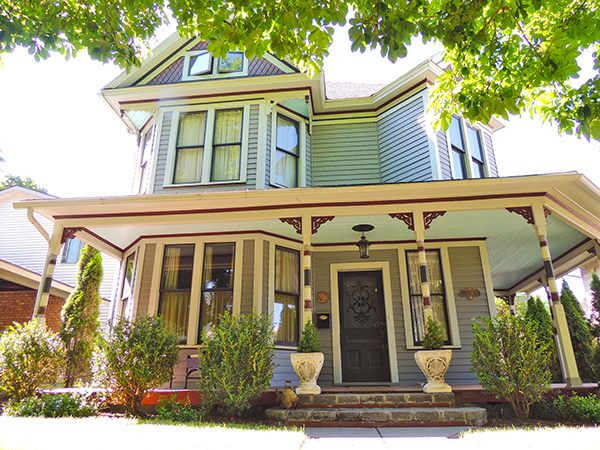
PhotoTitle: The Renstrom-Leigh House
PhotoAttribution: Spokane City/County Historic Preservation Office
Listing Status: Spokane Register
URL: http://properties.historicspokane.org/property/?PropertyID=1914
Display Marker: large_yellow
Title: Renstrom-Leigh House
Description: Date Built: 1895
Architect: Unknown
Common Name: Renstrom-Leigh House
The Renstrom-Leigh House is a fine example of the Queen Anne style with strong influence from two of the style's subtypes: Free Classic and Spindlework. Free Classic elements are expressed in the home's corbelled cornices and frieze bands while Spindlework elements are depicted as delicate embellishments found in turned posts and pendant drops. An unusual design feature unique to the Renstrom-Leigh House is a diagonal box bay located above the wrap-around porch. One of the first two homes erected in Booge's Addition, the house was built in 1895 for teamster and wholesale grocery porter, Gustaf A. Renstrom, and his wife, Anna. Four years later Walter E. and Anna King Leigh bought the property. Leigh, a prominent Spokane citizen and an accomplished attorney, helped start several Spokane law practices and invested in area mining properties. He was also the owner and president of the Great Northern Land Company. The Leighs lived in the house for 21 years, during which time they raised six children. Later owners have discovered cancelled checks, printed stationery, notes, children's books, magazines and a rare collection of love letters hidden under mounds of insulation and loose floorboards in the home's third-floor unfinished attic. The love letters were addressed to Miss Muriel Leigh, Walter and Anna Leigh's daughter, in 1916 while the family lived at the property.
Location: 47.64602, -117.42883
Address: 1115 West 10th Avenue, Spokane WA 99204
PhotoURL:

PhotoTitle: The Renstrom-Leigh House
PhotoAttribution: Spokane City/County Historic Preservation Office
Listing Status: Spokane Register
URL: http://properties.historicspokane.org/property/?PropertyID=1914
Display Marker: large_yellow
ID: 253
Title: Review Building
Description: Date Built: 1890
Architect: Chauncey B. Seaton
Common Name: Review Building
The Review Building houses the offices of the Spokesman-Review, Spokane's principal newspaper. One of the tallest buildings in Spokane, its tower is taller than the main roofs of the Paulsen Medical and Dental and Old National Bank buildings. Since its construction, it has been one of the most conspicuous buildings in town, as the architect, Chauncey B. Seaton, designed it to fit the irregular shape of the lot. Seaton came to Spokane in the aftermath of the Spokane Fire in 1889 to help rebuild the city. In 1890, he designed and supervised the construction of the Spokane Exposition Building. Although he designed the Review Building, he left before it was completed. In its early days, the building housed the Hotel Review in the upper floors. It also housed the Spokane Daily Chronicle until the building became too crowded, and the Chronicle moved into its own building in 1921. The Review Building was erected to house the Review, an evening daily paper, which was established by Frank Dallam as a weekly paper in 1883. Its closest competitor was the Spokesman, a democratic paper owned by a group of Spokane businessmen. In 1893, the competition between the two newspapers necessitated a merger if either was to survive. Out of this the Spokane Morning Review was born, under the management of Harvey Scott, H. L. Pittock, Anthony Cannon, and W. H. Cowles. The Panic of 1893 hurt the paper, and Cowles came to Spokane from Chicago to salvage it. He gained total control and created the Spokesman Review. W. H. Cowles was an important and influential businessman in Spokane. He was a founding member of the Spokane Chamber of Commerce, regional director of the Boy Scouts of America, and director for the Associated Press for thirty-three years. Theodore Roosevelt, Herbert Hoover, and William Howard Taft sought his advice. The family still owns and runs the paper and are generous civic benefactors in Spokane.
Location: 47.65771, -117.4263
Address: 999 West Riverside Avenue, Spokane WA 99201
PhotoURL: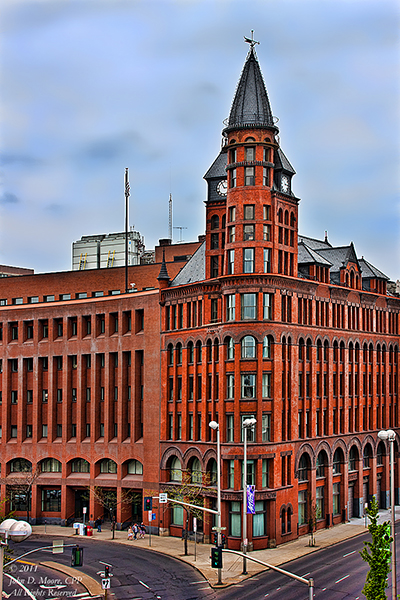
PhotoTitle: The Review Building
PhotoAttribution: Spokane City/County Historic Preservation Office
Listing Status: National Register
URL: http://properties.historicspokane.org/property/?PropertyID=2012
Display Marker: large_yellow
Title: Review Building
Description: Date Built: 1890
Architect: Chauncey B. Seaton
Common Name: Review Building
The Review Building houses the offices of the Spokesman-Review, Spokane's principal newspaper. One of the tallest buildings in Spokane, its tower is taller than the main roofs of the Paulsen Medical and Dental and Old National Bank buildings. Since its construction, it has been one of the most conspicuous buildings in town, as the architect, Chauncey B. Seaton, designed it to fit the irregular shape of the lot. Seaton came to Spokane in the aftermath of the Spokane Fire in 1889 to help rebuild the city. In 1890, he designed and supervised the construction of the Spokane Exposition Building. Although he designed the Review Building, he left before it was completed. In its early days, the building housed the Hotel Review in the upper floors. It also housed the Spokane Daily Chronicle until the building became too crowded, and the Chronicle moved into its own building in 1921. The Review Building was erected to house the Review, an evening daily paper, which was established by Frank Dallam as a weekly paper in 1883. Its closest competitor was the Spokesman, a democratic paper owned by a group of Spokane businessmen. In 1893, the competition between the two newspapers necessitated a merger if either was to survive. Out of this the Spokane Morning Review was born, under the management of Harvey Scott, H. L. Pittock, Anthony Cannon, and W. H. Cowles. The Panic of 1893 hurt the paper, and Cowles came to Spokane from Chicago to salvage it. He gained total control and created the Spokesman Review. W. H. Cowles was an important and influential businessman in Spokane. He was a founding member of the Spokane Chamber of Commerce, regional director of the Boy Scouts of America, and director for the Associated Press for thirty-three years. Theodore Roosevelt, Herbert Hoover, and William Howard Taft sought his advice. The family still owns and runs the paper and are generous civic benefactors in Spokane.
Location: 47.65771, -117.4263
Address: 999 West Riverside Avenue, Spokane WA 99201
PhotoURL:

PhotoTitle: The Review Building
PhotoAttribution: Spokane City/County Historic Preservation Office
Listing Status: National Register
URL: http://properties.historicspokane.org/property/?PropertyID=2012
Display Marker: large_yellow
ID: 254
Title: Richardson House
Description: Date Built: 1906
Architect: W.W. Hyslop
Common Name: Charles & Frances Richardson House
Built in 1906, the Charles & Frances Richardson House and Carriage House are a fine interpretation of the American Foursquare, a subtype of the Prairie School style. The home was designed by W. W. Hyslop, one of Spokane's most celebrated historic architects, and possesses high artistic values which are embodied in its design, materials, and construction. Just after it was built, the property was featured in the real estate section of the Spokesman-Review newspaper. Featuring a photograph of the house and copies of the architect's floor plans, the property was noted as a "convenient home" with "many striking ideas." The property was lauded for its Ňeffective useÓ of river rock which was used in the construction of the foundation and porch walls, and for its then-contemporary open-space interior floor plan specifically designed for comfort. The house was built for successful businessman and mining entrepreneur, Charles Prentice Richardson, a lawyer and real estate manager at Elmendorf & Elmendorf Real Estate Company, and his wife, Frances Greene Richardson.
Location: 47.66876, -117.45764
Address: 1226 North Summit Boulevard, Spokane WA 99201
PhotoURL: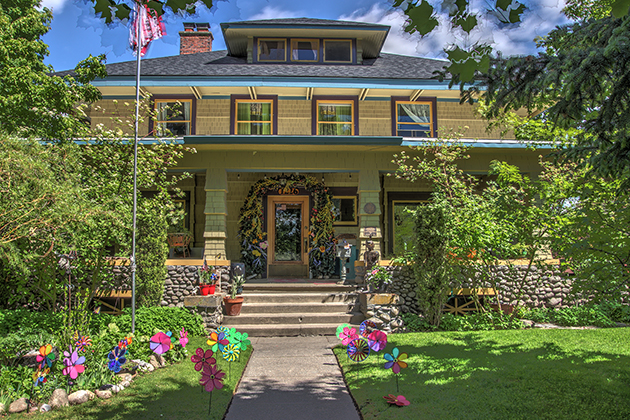
PhotoTitle: The Richardson-Jackson House
PhotoAttribution: Spokane City/County Historic Preservation Office
Listing Status: Spokane Register, National Register
URL: http://properties.historicspokane.org/property/?PropertyID=1916
Display Marker: large_yellow
Title: Richardson House
Description: Date Built: 1906
Architect: W.W. Hyslop
Common Name: Charles & Frances Richardson House
Built in 1906, the Charles & Frances Richardson House and Carriage House are a fine interpretation of the American Foursquare, a subtype of the Prairie School style. The home was designed by W. W. Hyslop, one of Spokane's most celebrated historic architects, and possesses high artistic values which are embodied in its design, materials, and construction. Just after it was built, the property was featured in the real estate section of the Spokesman-Review newspaper. Featuring a photograph of the house and copies of the architect's floor plans, the property was noted as a "convenient home" with "many striking ideas." The property was lauded for its Ňeffective useÓ of river rock which was used in the construction of the foundation and porch walls, and for its then-contemporary open-space interior floor plan specifically designed for comfort. The house was built for successful businessman and mining entrepreneur, Charles Prentice Richardson, a lawyer and real estate manager at Elmendorf & Elmendorf Real Estate Company, and his wife, Frances Greene Richardson.
Location: 47.66876, -117.45764
Address: 1226 North Summit Boulevard, Spokane WA 99201
PhotoURL:

PhotoTitle: The Richardson-Jackson House
PhotoAttribution: Spokane City/County Historic Preservation Office
Listing Status: Spokane Register, National Register
URL: http://properties.historicspokane.org/property/?PropertyID=1916
Display Marker: large_yellow
ID: 255
Title: Richardson-Seehorn House
Description: Date Built: 1910
Architect: Unknown/Arthur D. Jones (builder)
Common Name: Richardson-Seehorn House
Built in 1910 in Spokane's South Hill Addition, the Richardson-Seehorn House is a fine example of the American Foursquare style, an early subtype of the Prairie style. The house stands on one of the first lots purchased following the promotion of the addition by the Arthur D. Jones Company in 1906. In addition to its architectural significance, the house is also historically significant for its association with the development and subsequent settlement of Spokane's lower South Hill.
Location: 47.64842, -117.42424
Address: 731 South Lincoln Street, Spokane WA 99204
PhotoURL: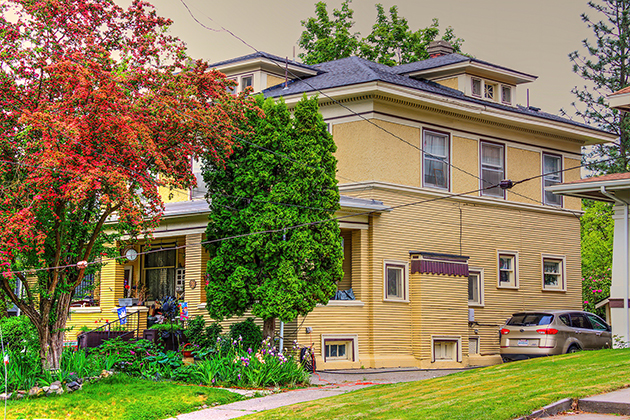
PhotoTitle: The Richardson-Seehorn House
PhotoAttribution: Spokane City/County Historic Preservation Office
Listing Status: Spokane Register
URL: http://properties.historicspokane.org/property/?PropertyID=1917
Display Marker: large_yellow
Title: Richardson-Seehorn House
Description: Date Built: 1910
Architect: Unknown/Arthur D. Jones (builder)
Common Name: Richardson-Seehorn House
Built in 1910 in Spokane's South Hill Addition, the Richardson-Seehorn House is a fine example of the American Foursquare style, an early subtype of the Prairie style. The house stands on one of the first lots purchased following the promotion of the addition by the Arthur D. Jones Company in 1906. In addition to its architectural significance, the house is also historically significant for its association with the development and subsequent settlement of Spokane's lower South Hill.
Location: 47.64842, -117.42424
Address: 731 South Lincoln Street, Spokane WA 99204
PhotoURL:

PhotoTitle: The Richardson-Seehorn House
PhotoAttribution: Spokane City/County Historic Preservation Office
Listing Status: Spokane Register
URL: http://properties.historicspokane.org/property/?PropertyID=1917
Display Marker: large_yellow
ID: 256
Title: Ridpath Hotel
Description: Date Built: 1952
Architect: Ned H. Abrams & Richard E Lytle/Utah Construction Company
Common Name: Ridpath Hotel
One of Spokane's most historically and architecturally significant hostelries, the Ridpath Hotel is located in the center of the city's arts and entertainment district in downtown Spokane. The hotel is comprised of two historic buildings: a tall multi- story, International-style, brick-veneered, steel-reinforced, high-rise tower completed in 1952, and an attached four-story brick masonry construction commercial building built in 1905. The 1952 building is commonly called the Ridpath Hotel "tower" while the attached 1905 building is called the "east wing." Together, the buildings offer more than 300 furnished hotel guest rooms, a lobby and lounge, cocktail and dining rooms, meeting/convention rooms, commercial shop/store space, a drive-in parking lobby, and a below-ground drive-in parking garage for 100 cars. With 13 floors, the Ridpath Hotel tower rises above surrounding commercial buildings and offers some of the finest and most spectacular panoramic views of Spokane and the surrounding landscape. Like so many historic commercial buildings across the country, the hotel's street-level storefront facades were modified in the 1970s-1980s with a compatible- contemporary design.
Location: 47.65689, -117.42031
Address: 515 West Sprague Avenue, Spokane WA 99201
PhotoURL:
PhotoTitle: The Ridpath Hotel
PhotoAttribution: Spokane City/County Historic Preservation Office
Listing Status: Spokane Register, National Register
URL: http://properties.historicspokane.org/property/?PropertyID=2055
Display Marker: large_yellow
Title: Ridpath Hotel
Description: Date Built: 1952
Architect: Ned H. Abrams & Richard E Lytle/Utah Construction Company
Common Name: Ridpath Hotel
One of Spokane's most historically and architecturally significant hostelries, the Ridpath Hotel is located in the center of the city's arts and entertainment district in downtown Spokane. The hotel is comprised of two historic buildings: a tall multi- story, International-style, brick-veneered, steel-reinforced, high-rise tower completed in 1952, and an attached four-story brick masonry construction commercial building built in 1905. The 1952 building is commonly called the Ridpath Hotel "tower" while the attached 1905 building is called the "east wing." Together, the buildings offer more than 300 furnished hotel guest rooms, a lobby and lounge, cocktail and dining rooms, meeting/convention rooms, commercial shop/store space, a drive-in parking lobby, and a below-ground drive-in parking garage for 100 cars. With 13 floors, the Ridpath Hotel tower rises above surrounding commercial buildings and offers some of the finest and most spectacular panoramic views of Spokane and the surrounding landscape. Like so many historic commercial buildings across the country, the hotel's street-level storefront facades were modified in the 1970s-1980s with a compatible- contemporary design.
Location: 47.65689, -117.42031
Address: 515 West Sprague Avenue, Spokane WA 99201
PhotoURL:

PhotoTitle: The Ridpath Hotel
PhotoAttribution: Spokane City/County Historic Preservation Office
Listing Status: Spokane Register, National Register
URL: http://properties.historicspokane.org/property/?PropertyID=2055
Display Marker: large_yellow
ID: 257
Title: Rigg House
Description: Date Built: 1914
Architect: Archibald G. Rigg
Common Name: Dr. Charles & Edith Rigg House
Built in 1914, the Dr. Charles & Edith Rigg House is a hallmark example of the Dutch Colonial Revival style and a product of master historic Spokane architect, Archibald G. Rigg, brother to Dr. Charles Rigg, for whom the home was designed. The house was custom-built for Dr. Charles F. Rigg and his wife, Edith Beck Rigg, and was owned by the Rigg family for 35 years from 1914 to 1949. According to his 1928 obituary in the Spokesman-Review newspaper, Dr. Rigg was beloved as "one of the most popular physicians in Spokane" and served an important position with the Spokane Police Department as the department's surgeon for 15 years until his death. Shortly after it was erected, a photograph of the Rigg House was featured in the October 4, 1914 edition of the Spokesman-Review, which described the home as a New England colonial type with artistic, novel and striking architectural features. The newspaper reported the property had an $8,500 construction cost and was built in the fashionable Rockwood residential district. In 1921, a professional architectural journal, The Architect and Engineer, featured the Rigg House as one of "The Five Most Notable Small Houses in Spokane."
Location: 47.63151, -117.39945
Address: 726 East 25th Avenue, Spokane WA 99203
PhotoURL: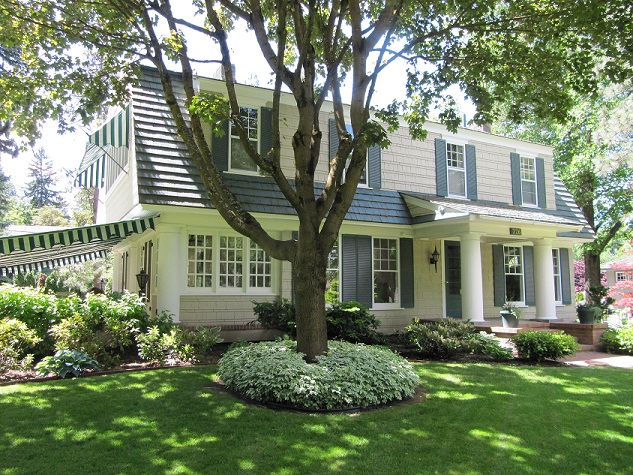
PhotoTitle: The Dr. Charles and Edith Rigg House
PhotoAttribution: Spokane City/County Historic Preservation Office
Listing Status: Spokane Register, National Register
URL: http://properties.historicspokane.org/property/?PropertyID=2058
Display Marker: large_yellow
Title: Rigg House
Description: Date Built: 1914
Architect: Archibald G. Rigg
Common Name: Dr. Charles & Edith Rigg House
Built in 1914, the Dr. Charles & Edith Rigg House is a hallmark example of the Dutch Colonial Revival style and a product of master historic Spokane architect, Archibald G. Rigg, brother to Dr. Charles Rigg, for whom the home was designed. The house was custom-built for Dr. Charles F. Rigg and his wife, Edith Beck Rigg, and was owned by the Rigg family for 35 years from 1914 to 1949. According to his 1928 obituary in the Spokesman-Review newspaper, Dr. Rigg was beloved as "one of the most popular physicians in Spokane" and served an important position with the Spokane Police Department as the department's surgeon for 15 years until his death. Shortly after it was erected, a photograph of the Rigg House was featured in the October 4, 1914 edition of the Spokesman-Review, which described the home as a New England colonial type with artistic, novel and striking architectural features. The newspaper reported the property had an $8,500 construction cost and was built in the fashionable Rockwood residential district. In 1921, a professional architectural journal, The Architect and Engineer, featured the Rigg House as one of "The Five Most Notable Small Houses in Spokane."
Location: 47.63151, -117.39945
Address: 726 East 25th Avenue, Spokane WA 99203
PhotoURL:

PhotoTitle: The Dr. Charles and Edith Rigg House
PhotoAttribution: Spokane City/County Historic Preservation Office
Listing Status: Spokane Register, National Register
URL: http://properties.historicspokane.org/property/?PropertyID=2058
Display Marker: large_yellow
ID: 258
Title: Robertson and Raznik Buildings
Description: Date Built: 1912-1913 (Robertson) and 1912 (Raznik)
Architect: Cutter & Malmgren (Robertson) and Joseph T. Levesque (Raznik)
Common Name: The Glen Dow Academy, Sons of Norway Building
The three-story Robertson building, designed by the influential architectural firm of Cutter and Malmgren, was financed by attorney Frederick C. Robertson, a man who has unfortunately been largely forgotten but played a major role in regional history. Between 1899 and 1902, Robertson defended striking union miners in the Coeur d’Alene district after martial law had been declared and hundreds of workers had been incarcerated. Robertson held that the martial law and confinements were unconstitutional; he prevailed and the martial law order was lifted and the miners released. He was also a prominent member of the Democratic Party and ran unsuccessfully for congress in 1908. The upper floors of the building were intended for use by the Odin Hall of Scandinavian Brotherhood, a fraternal lodge. The building’s upper floors continued to be used by fraternal groups becoming occupied by the Sons of Norway in 1942. That group restored the building directly to the west in 1965, for use as a new entrance. Known as the Raznik building, this two-story building possesses a striking facade due to its diminutive size and elegant composition. Designed by Joseph T. Levesque, the Raznik building was constructed for Max Raznik and originally housed Bob's Chili and a tavern. The Sons of Norway relocated in 1978 and subsequently, the F.C. Robertson Building was purchased by the Glen Dow Academy of Hair Design. The commercial storefront level of the building has seen a number of occupants, including a cigar store, taverns, cafes, and a State Liquor Store.
Location: 47.65769, -117.4165
Address: 309 West Riverside Avenue, Spokane WA 99201
PhotoURL: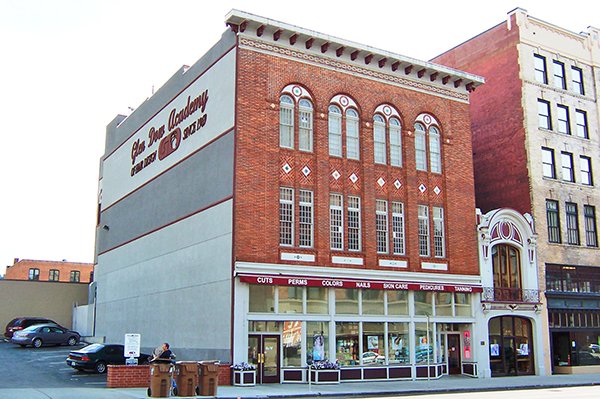
PhotoTitle: The Robertson/Raznik Building
PhotoAttribution: Spokane City/County Historic Preservation Office
Listing Status: Spokane Register, National Register
URL: http://properties.historicspokane.org/property/?PropertyID=1918
Display Marker: large_yellow
Title: Robertson and Raznik Buildings
Description: Date Built: 1912-1913 (Robertson) and 1912 (Raznik)
Architect: Cutter & Malmgren (Robertson) and Joseph T. Levesque (Raznik)
Common Name: The Glen Dow Academy, Sons of Norway Building
The three-story Robertson building, designed by the influential architectural firm of Cutter and Malmgren, was financed by attorney Frederick C. Robertson, a man who has unfortunately been largely forgotten but played a major role in regional history. Between 1899 and 1902, Robertson defended striking union miners in the Coeur d’Alene district after martial law had been declared and hundreds of workers had been incarcerated. Robertson held that the martial law and confinements were unconstitutional; he prevailed and the martial law order was lifted and the miners released. He was also a prominent member of the Democratic Party and ran unsuccessfully for congress in 1908. The upper floors of the building were intended for use by the Odin Hall of Scandinavian Brotherhood, a fraternal lodge. The building’s upper floors continued to be used by fraternal groups becoming occupied by the Sons of Norway in 1942. That group restored the building directly to the west in 1965, for use as a new entrance. Known as the Raznik building, this two-story building possesses a striking facade due to its diminutive size and elegant composition. Designed by Joseph T. Levesque, the Raznik building was constructed for Max Raznik and originally housed Bob's Chili and a tavern. The Sons of Norway relocated in 1978 and subsequently, the F.C. Robertson Building was purchased by the Glen Dow Academy of Hair Design. The commercial storefront level of the building has seen a number of occupants, including a cigar store, taverns, cafes, and a State Liquor Store.
Location: 47.65769, -117.4165
Address: 309 West Riverside Avenue, Spokane WA 99201
PhotoURL:

PhotoTitle: The Robertson/Raznik Building
PhotoAttribution: Spokane City/County Historic Preservation Office
Listing Status: Spokane Register, National Register
URL: http://properties.historicspokane.org/property/?PropertyID=1918
Display Marker: large_yellow
ID: 259
Title: Robinwood Apartments
Description: Date Built: 1939
Architect: Chester F. Rider
Common Name: Robinwood Apartments
Built in 1939, the Robinwood Apartments is significant as a fine example of the Tudor Revival style and one of the most remarkably intact apartment residences in Spokane, Washington. The multi-family complex was erected by Chester F. Rider, a noted Spokane builder and real estate developer who founded, owned, and managed the Rider Housing Corporation, and was responsible for the construction of at least six single-family homes and four multi-family apartment complexes on Spokane's South Hill. During its period of significance from 1939 to 1954, the Robinwood Apartments achieved importance in the area of community planning & development as one of four apartment complexes that was planned, developed, and built by Rider on the hillside area south of Ninth Avenue and along Grand Avenue on Spokane's South Hill. Associated with prevalent patterns of multi-family residential settlement in Spokane during the 1930s-1940s, the east and west buildings of the Robinwood Apartments, and its terraced inner courtyard design with original brick and basalt rock walls, is architecturally and historically significant.
Location: 47.64695, -117.41566
Address: 217 West 9th Avenue, Spokane WA 99204
PhotoURL: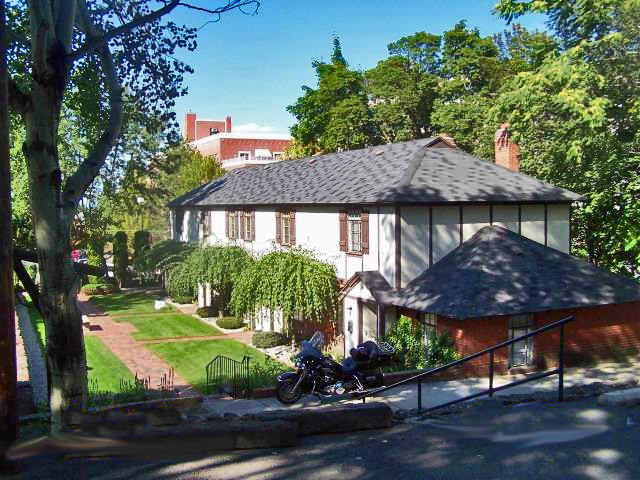
PhotoTitle: The Robinwood Apartments
PhotoAttribution: Spokane City/County Historic Preservation Office
Listing Status: Spokane Register, National Register
URL: http://properties.historicspokane.org/property/?PropertyID=1919
Display Marker: large_yellow
Title: Robinwood Apartments
Description: Date Built: 1939
Architect: Chester F. Rider
Common Name: Robinwood Apartments
Built in 1939, the Robinwood Apartments is significant as a fine example of the Tudor Revival style and one of the most remarkably intact apartment residences in Spokane, Washington. The multi-family complex was erected by Chester F. Rider, a noted Spokane builder and real estate developer who founded, owned, and managed the Rider Housing Corporation, and was responsible for the construction of at least six single-family homes and four multi-family apartment complexes on Spokane's South Hill. During its period of significance from 1939 to 1954, the Robinwood Apartments achieved importance in the area of community planning & development as one of four apartment complexes that was planned, developed, and built by Rider on the hillside area south of Ninth Avenue and along Grand Avenue on Spokane's South Hill. Associated with prevalent patterns of multi-family residential settlement in Spokane during the 1930s-1940s, the east and west buildings of the Robinwood Apartments, and its terraced inner courtyard design with original brick and basalt rock walls, is architecturally and historically significant.
Location: 47.64695, -117.41566
Address: 217 West 9th Avenue, Spokane WA 99204
PhotoURL:

PhotoTitle: The Robinwood Apartments
PhotoAttribution: Spokane City/County Historic Preservation Office
Listing Status: Spokane Register, National Register
URL: http://properties.historicspokane.org/property/?PropertyID=1919
Display Marker: large_yellow
ID: 260
Title: Rogers High School
Description: Date Built: 1932
Architect: Wells & Dow
Common Name: Rogers High School
John R. Rogers High School is an outstanding example of the Art Deco style as applied to public structures. Although the interior has been significantly renovated, the exterior of the original building retains largely the same appearance as when it was first constructed in 1932. All the projecting distractions of previous years have been removed, leaving behind the impressive edifice of the main building as it was originally designed.
Location: 47.69901, -117.38835
Address: 1622 East Wellesley Avenue, Spokane WA 99207
PhotoURL: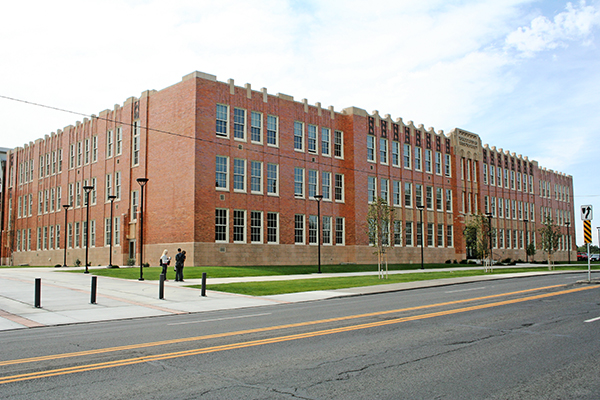
PhotoTitle: Rogers High School
PhotoAttribution: Spokane City/County Historic Preservation Office
Listing Status: National Register
URL: http://properties.historicspokane.org/property/?PropertyID=2030
Display Marker: large_yellow
Title: Rogers High School
Description: Date Built: 1932
Architect: Wells & Dow
Common Name: Rogers High School
John R. Rogers High School is an outstanding example of the Art Deco style as applied to public structures. Although the interior has been significantly renovated, the exterior of the original building retains largely the same appearance as when it was first constructed in 1932. All the projecting distractions of previous years have been removed, leaving behind the impressive edifice of the main building as it was originally designed.
Location: 47.69901, -117.38835
Address: 1622 East Wellesley Avenue, Spokane WA 99207
PhotoURL:

PhotoTitle: Rogers High School
PhotoAttribution: Spokane City/County Historic Preservation Office
Listing Status: National Register
URL: http://properties.historicspokane.org/property/?PropertyID=2030
Display Marker: large_yellow
ID: 261
Title: Rookery Building (demolished)
Description: Date Built: 1933
Architect: G. A. Pehrson
Common Name: The Rookery
The Rookery Building was demolished in 2006. No structure has been rebuilt on the site. Erected in 1933, the Rookery Building was the premier Spokane example of terra cotta artistry employing Art Deco design elements. Designed by Gustav Albin Pehrson, the Rookery was a three-story brick and steel frame structure with a concrete block foundation and flat roof. It was clad in terra cotta from the famed Washington Brick & Lime Co. of Clayton, Washington and its horizontal emphasis and stylistic design elements, including floral patterns, starbursts, chevrons and fans clearly established it as a high style Art Deco building. Located in the heart of the central business district of downtown Spokane, the Rookery was a strategic and viable commercial space for decades.
Location: 47.657575, -117.420971
Address: 14 North Howard Street, Spokane WA 99201
PhotoURL: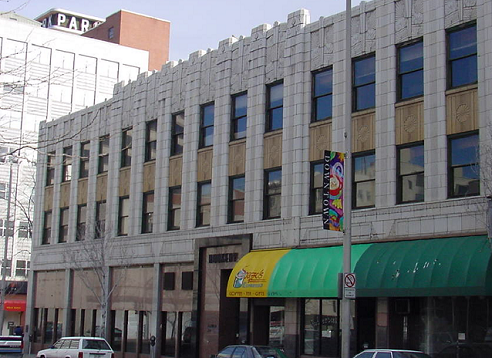
PhotoTitle: The once-standing Rookery Building
PhotoAttribution: Spokane City/County Historic Preservation Office
Listing Status: N/A
URL: http://properties.historicspokane.org/property/?PropertyID=2065
Display Marker: large_yellow
Title: Rookery Building (demolished)
Description: Date Built: 1933
Architect: G. A. Pehrson
Common Name: The Rookery
The Rookery Building was demolished in 2006. No structure has been rebuilt on the site. Erected in 1933, the Rookery Building was the premier Spokane example of terra cotta artistry employing Art Deco design elements. Designed by Gustav Albin Pehrson, the Rookery was a three-story brick and steel frame structure with a concrete block foundation and flat roof. It was clad in terra cotta from the famed Washington Brick & Lime Co. of Clayton, Washington and its horizontal emphasis and stylistic design elements, including floral patterns, starbursts, chevrons and fans clearly established it as a high style Art Deco building. Located in the heart of the central business district of downtown Spokane, the Rookery was a strategic and viable commercial space for decades.
Location: 47.657575, -117.420971
Address: 14 North Howard Street, Spokane WA 99201
PhotoURL:

PhotoTitle: The once-standing Rookery Building
PhotoAttribution: Spokane City/County Historic Preservation Office
Listing Status: N/A
URL: http://properties.historicspokane.org/property/?PropertyID=2065
Display Marker: large_yellow
ID: 262
Title: Roosevelt Apartments
Description: Date Built: 1929
Architect: Gustav Pehrson/Huetter Construction Company
Common Name: Roosevelt Apartments.
One of the city's finest apartment blocks, the Roosevelt Apartments were designed in 1929 by noted Spokane architect Gustav Albin Pehrson and built by the Huetter Construction Company. The apartment building was constructed for Ben Goldstein and Harry Lubin, two of Spokane's most influential civic, business, and Jewish community leaders.
Location: 47.64967, -117.42052
Address: 524 West 7th Avenue, Spokane WA 99204
PhotoURL: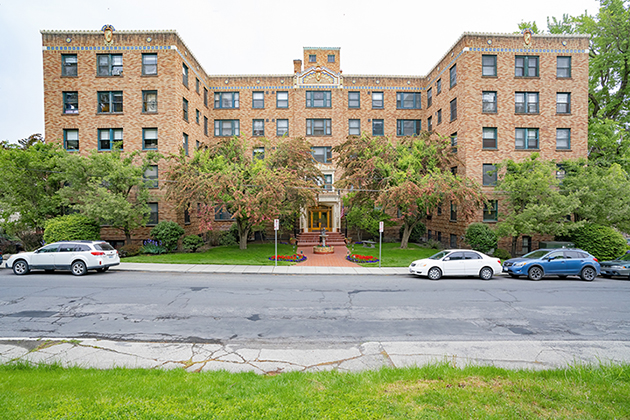
PhotoTitle: The Roosevelt Apartments
PhotoAttribution: Spokane City/County Historic Preservation Office
Listing Status: Spokane Register, National Register
URL: http://properties.historicspokane.org/property/?PropertyID=1920
Display Marker: large_yellow
Title: Roosevelt Apartments
Description: Date Built: 1929
Architect: Gustav Pehrson/Huetter Construction Company
Common Name: Roosevelt Apartments.
One of the city's finest apartment blocks, the Roosevelt Apartments were designed in 1929 by noted Spokane architect Gustav Albin Pehrson and built by the Huetter Construction Company. The apartment building was constructed for Ben Goldstein and Harry Lubin, two of Spokane's most influential civic, business, and Jewish community leaders.
Location: 47.64967, -117.42052
Address: 524 West 7th Avenue, Spokane WA 99204
PhotoURL:

PhotoTitle: The Roosevelt Apartments
PhotoAttribution: Spokane City/County Historic Preservation Office
Listing Status: Spokane Register, National Register
URL: http://properties.historicspokane.org/property/?PropertyID=1920
Display Marker: large_yellow
ID: 263
Title: Rose-Kly-Cecil Apartments
Description: Date Built: 1910
Architect: Unknown/Michael Hunz
Common Name: Rose-Kly-Cecil Apartments
Erected in 1910, the Rose-Kly-Cecil Apartments is a good example of the Colonial Revival style with Italianate influence. Located in the Union Park Addition in the East Central neighborhood of Spokane, WA, and surrounded by late nineteenth and early twentieth-century single-family homes, the Rose-Kly-Cecil Apartments is one of the community's only historic multi-family apartment buildings. The property faces north and is highly visible from its location just south of Interstate 90, which parallels Third Avenue in front of the property.
Location: 47.65336, -117.38461
Address: 1726 East 3rd Avenue, Spokane WA 99202
PhotoURL: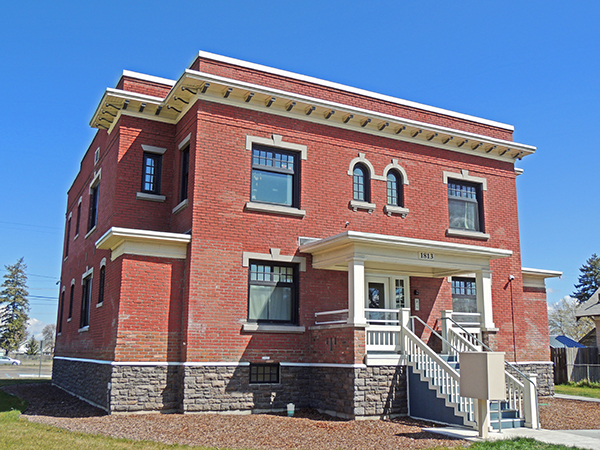
PhotoTitle: The Rose-Kly-Cecil Apartments
PhotoAttribution: Spokane City/County Historic Preservation Office
Listing Status: Spokane Register
URL: http://properties.historicspokane.org/property/?PropertyID=1921
Display Marker: large_yellow
Title: Rose-Kly-Cecil Apartments
Description: Date Built: 1910
Architect: Unknown/Michael Hunz
Common Name: Rose-Kly-Cecil Apartments
Erected in 1910, the Rose-Kly-Cecil Apartments is a good example of the Colonial Revival style with Italianate influence. Located in the Union Park Addition in the East Central neighborhood of Spokane, WA, and surrounded by late nineteenth and early twentieth-century single-family homes, the Rose-Kly-Cecil Apartments is one of the community's only historic multi-family apartment buildings. The property faces north and is highly visible from its location just south of Interstate 90, which parallels Third Avenue in front of the property.
Location: 47.65336, -117.38461
Address: 1726 East 3rd Avenue, Spokane WA 99202
PhotoURL:

PhotoTitle: The Rose-Kly-Cecil Apartments
PhotoAttribution: Spokane City/County Historic Preservation Office
Listing Status: Spokane Register
URL: http://properties.historicspokane.org/property/?PropertyID=1921
Display Marker: large_yellow
ID: 264
Title: Ross Place
Description: Date Built: 1910
Architect: Unknown
Common Name: Mary's Restaurant
The property is a significant remnant of Spokane's eastward development, and is associated with the lives of Oliver C. Ross, his brother Andrew Jackson Ross, and Oliver's son, Edward D. Ross, all of whom were instrumental in the commercial and agricultural development of the Spokane Valley and beyond. In 1929, Mary Palmerio converted the house into "Mary's Italian Restaurant," gaining a regional and national reputation that is remembered today. The Ross Place survives as the focal point and main residence of the Ross family. Although family members lived in other residences prior to the construction of the home in 1910, this property is the one most closely associated with them, and stands as a benchmark of the success and local prominence they achieved by the turn of the century.
Location: 47.65047, -117.34771
Address: 4235 East Hartson Avenue, Spokane WA 99202
PhotoURL: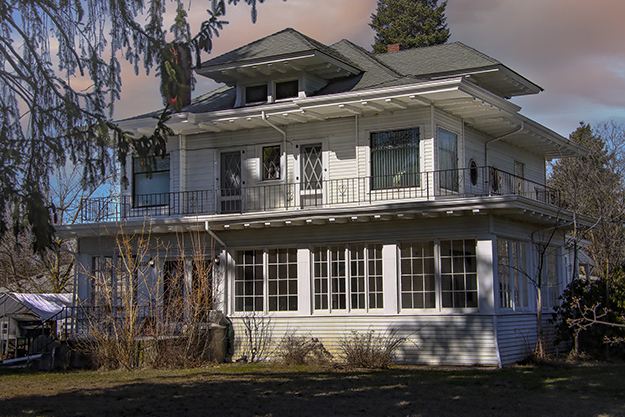
PhotoTitle: Ross Place
PhotoAttribution: Spokane City/County Historic Preservation Office
Listing Status: N/A
URL: http://properties.historicspokane.org/property/?PropertyID=2013
Display Marker: large_yellow
Title: Ross Place
Description: Date Built: 1910
Architect: Unknown
Common Name: Mary's Restaurant
The property is a significant remnant of Spokane's eastward development, and is associated with the lives of Oliver C. Ross, his brother Andrew Jackson Ross, and Oliver's son, Edward D. Ross, all of whom were instrumental in the commercial and agricultural development of the Spokane Valley and beyond. In 1929, Mary Palmerio converted the house into "Mary's Italian Restaurant," gaining a regional and national reputation that is remembered today. The Ross Place survives as the focal point and main residence of the Ross family. Although family members lived in other residences prior to the construction of the home in 1910, this property is the one most closely associated with them, and stands as a benchmark of the success and local prominence they achieved by the turn of the century.
Location: 47.65047, -117.34771
Address: 4235 East Hartson Avenue, Spokane WA 99202
PhotoURL:

PhotoTitle: Ross Place
PhotoAttribution: Spokane City/County Historic Preservation Office
Listing Status: N/A
URL: http://properties.historicspokane.org/property/?PropertyID=2013
Display Marker: large_yellow
ID: 265
Title: Roundup Grocery Warehouse
Description: Date Built: 1948
Architect: Unknown/Roy L. Blair (builder)
Common Name: Thomas Hammer Coffee
The Roundup Grocery/Thomas Hammer Building, a former rail corridor warehouse, is associated with Spokane's railroad corridor warehouse history. The warehouse building served as a transfer point for materials shipped into Spokane via the Northern Pacific Railroad to serve the market of Spokane and Inland Northwest. Most all of the warehouses in the Pacific Avenue produce district were built at or near the turn of the twentieth century, between 1892 and 1911. The buildings were predominately oriented toward the railroad, the major carrier of goods, with docks along the rail spurs. When these buildings were built they dealt with the massive load-carrying capacity of the rail car on one side and the relatively small capacity of wagons and trucks that were used to distribute the broken-down lots of goods that had been shipped in by rail on the other side.
Location: 47.6555, -117.41531
Address: 210 West Pacific Avenue, Spokane WA 99201
PhotoURL:
PhotoTitle: The Roundup Grocery Warehouse
PhotoAttribution: Spokane City/County Historic Preservation Office
Listing Status: Spokane Register, National Register
URL: http://properties.historicspokane.org/property/?PropertyID=1922
Display Marker: large_yellow
Title: Roundup Grocery Warehouse
Description: Date Built: 1948
Architect: Unknown/Roy L. Blair (builder)
Common Name: Thomas Hammer Coffee
The Roundup Grocery/Thomas Hammer Building, a former rail corridor warehouse, is associated with Spokane's railroad corridor warehouse history. The warehouse building served as a transfer point for materials shipped into Spokane via the Northern Pacific Railroad to serve the market of Spokane and Inland Northwest. Most all of the warehouses in the Pacific Avenue produce district were built at or near the turn of the twentieth century, between 1892 and 1911. The buildings were predominately oriented toward the railroad, the major carrier of goods, with docks along the rail spurs. When these buildings were built they dealt with the massive load-carrying capacity of the rail car on one side and the relatively small capacity of wagons and trucks that were used to distribute the broken-down lots of goods that had been shipped in by rail on the other side.
Location: 47.6555, -117.41531
Address: 210 West Pacific Avenue, Spokane WA 99201
PhotoURL:

PhotoTitle: The Roundup Grocery Warehouse
PhotoAttribution: Spokane City/County Historic Preservation Office
Listing Status: Spokane Register, National Register
URL: http://properties.historicspokane.org/property/?PropertyID=1922
Display Marker: large_yellow
ID: 266
Title: Royal Riblet Mansion
Description: Date Built: 1925
Architect: Royal Riblet and George Keith
Common Name: Arbor Crest Winery
Set over 400' up on a basalt outcropping above the Spokane River, the Italianate/Mission style Royal Riblet mansion is a Spokane Valley landmark. The house, state-of-the-arts for its time, was designed by prominent Spokane architect George Keith and built in 1925 for Royal N. Riblet, an inventor and entrepreneur who made a small fortune constructing tramways for booming mining companies in the Inland Northwest. The home was originally accessed via one of Riblet's trams, which ferried passengers to the home's cliff perch from the other side of the Spokane River. In the late 1980s brothers David and Harold Mielke restored the house for use as the headquarters of the Arbor Crest Winery.
Location: 47.69621, -117.250204
Address: 4702 North Fruit Hill Road, Spokane WA 99217
PhotoURL:
PhotoTitle: The Royal Riblet Mansion
PhotoAttribution: Spokane City/County Historic Preservation Office
Listing Status: Spokane Register, National Register
URL: http://properties.historicspokane.org/property/?PropertyID=1915
Display Marker: large_yellow
Title: Royal Riblet Mansion
Description: Date Built: 1925
Architect: Royal Riblet and George Keith
Common Name: Arbor Crest Winery
Set over 400' up on a basalt outcropping above the Spokane River, the Italianate/Mission style Royal Riblet mansion is a Spokane Valley landmark. The house, state-of-the-arts for its time, was designed by prominent Spokane architect George Keith and built in 1925 for Royal N. Riblet, an inventor and entrepreneur who made a small fortune constructing tramways for booming mining companies in the Inland Northwest. The home was originally accessed via one of Riblet's trams, which ferried passengers to the home's cliff perch from the other side of the Spokane River. In the late 1980s brothers David and Harold Mielke restored the house for use as the headquarters of the Arbor Crest Winery.
Location: 47.69621, -117.250204
Address: 4702 North Fruit Hill Road, Spokane WA 99217
PhotoURL:

PhotoTitle: The Royal Riblet Mansion
PhotoAttribution: Spokane City/County Historic Preservation Office
Listing Status: Spokane Register, National Register
URL: http://properties.historicspokane.org/property/?PropertyID=1915
Display Marker: large_yellow
ID: 267
Title: Rudberg House
Description: Date Built: 1911
Architect: Aaron Lundquist
Common Name: Rudberg House
Built in 1911, the Rudberg House was erected as a "spec home" by Aaron Lundquist, a prominent pioneer Spokane builder and home designer who traveled throughout the country studying architecture, and was admired for his construction of "many of the city's most beautiful homes." Built in 1911, the Rudberg House stands out as a very fine example of the Mission Revival style with its character defining shaped parapets and quatrefoil windows, covered front porch, massive square brick porch supports, and smooth stucco cladding.
Location: 47.64859, -117.42922
Address: 1128 West 8th Avenue, Spokane WA 99204
PhotoURL: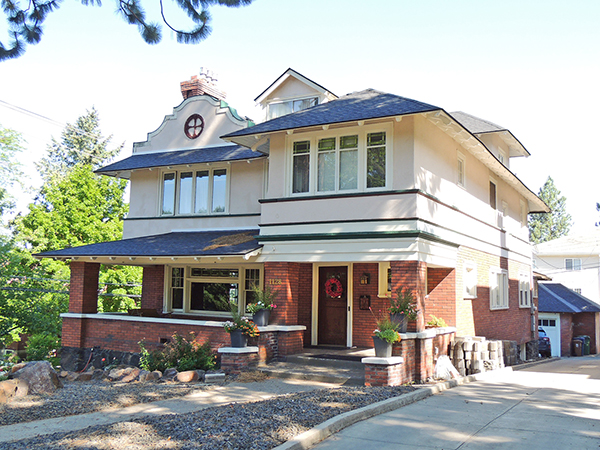
PhotoTitle: The Rudberg House
PhotoAttribution: Spokane City/County Historic Preservation Office
Listing Status: Spokane Register, National Register
URL: http://properties.historicspokane.org/property/?PropertyID=1923
Display Marker: large_yellow
Title: Rudberg House
Description: Date Built: 1911
Architect: Aaron Lundquist
Common Name: Rudberg House
Built in 1911, the Rudberg House was erected as a "spec home" by Aaron Lundquist, a prominent pioneer Spokane builder and home designer who traveled throughout the country studying architecture, and was admired for his construction of "many of the city's most beautiful homes." Built in 1911, the Rudberg House stands out as a very fine example of the Mission Revival style with its character defining shaped parapets and quatrefoil windows, covered front porch, massive square brick porch supports, and smooth stucco cladding.
Location: 47.64859, -117.42922
Address: 1128 West 8th Avenue, Spokane WA 99204
PhotoURL:

PhotoTitle: The Rudberg House
PhotoAttribution: Spokane City/County Historic Preservation Office
Listing Status: Spokane Register, National Register
URL: http://properties.historicspokane.org/property/?PropertyID=1923
Display Marker: large_yellow
ID: 268
Title: Russell House
Description: Date Built: 1900
Architect: Unknown
Common Name: Russell House
The Russell House is architecturally significant as a representative example of Tudor Revival style architecture and is historically significant for its association with Spokane banking, mining, and real estate entrepreneur Wakefield Perry Russell and his wife Lucy, for whom the home was built in 1900. The house served as the Russell family residence until Lucy's death in 1951. Although the home's architect remains unknown, Wakefield Russell's financial and social position likely allowed him to hire a professional architect to design it. The Russell House has remained a single-family residence from the time it was built, unlike many large homes in Browne's Addition.
Location: 47.65618, -117.44605
Address: 2231 West 1st Avenue, Spokane WA 99201
PhotoURL: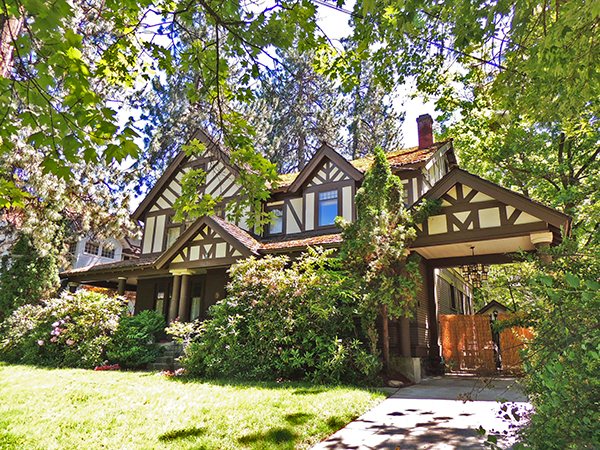
PhotoTitle: The Wakefield Perry and Lucy Russell House
PhotoAttribution: Spokane City/County Historic Preservation Office
Listing Status: Spokane Register, National Register
URL: http://properties.historicspokane.org/property/?PropertyID=1924
Display Marker: large_yellow
Title: Russell House
Description: Date Built: 1900
Architect: Unknown
Common Name: Russell House
The Russell House is architecturally significant as a representative example of Tudor Revival style architecture and is historically significant for its association with Spokane banking, mining, and real estate entrepreneur Wakefield Perry Russell and his wife Lucy, for whom the home was built in 1900. The house served as the Russell family residence until Lucy's death in 1951. Although the home's architect remains unknown, Wakefield Russell's financial and social position likely allowed him to hire a professional architect to design it. The Russell House has remained a single-family residence from the time it was built, unlike many large homes in Browne's Addition.
Location: 47.65618, -117.44605
Address: 2231 West 1st Avenue, Spokane WA 99201
PhotoURL:

PhotoTitle: The Wakefield Perry and Lucy Russell House
PhotoAttribution: Spokane City/County Historic Preservation Office
Listing Status: Spokane Register, National Register
URL: http://properties.historicspokane.org/property/?PropertyID=1924
Display Marker: large_yellow
ID: 269
Title: Salvation Army Building
Description: Date Built: 1921
Architect: Archibald C. Rigg/Frederick Phair
Common Name: Luigi's Italian Restaurant
Regarded as a social service work pioneer, the Salvation Army constructed its first permanent Spokane headquarters in a three-story red brick building built in 1921. The facility doubled as the Salvation Army's service center and as a single room occupancy hotel known as the Red Shield Hotel. It housed itinerant men and boys for nearly 60 years, and was the site for church services, boys clubs, free health and legal services, and war relief efforts. The Salvation Army building was one of Spokane's longest-running community aid facilities rendering practical help to those in need as advertised in their crusade for "soup, soap, and salvation." The building was designed and built by architect Archibald Rigg and built by general contractor Frederick Phair, two of Spokane's most accomplished building professionals.
Location: 47.65874, -117.41523
Address: 245 West Main Avenue, Spokane WA 99201
PhotoURL: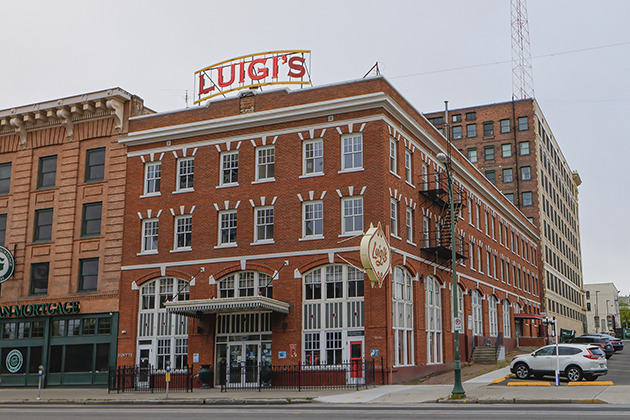
PhotoTitle: The Salvation Army Building
PhotoAttribution: Spokane City/County Historic Preservation Office
Listing Status: Spokane Register, National Register
URL: http://properties.historicspokane.org/property/?PropertyID=1926
Display Marker: large_yellow
Title: Salvation Army Building
Description: Date Built: 1921
Architect: Archibald C. Rigg/Frederick Phair
Common Name: Luigi's Italian Restaurant
Regarded as a social service work pioneer, the Salvation Army constructed its first permanent Spokane headquarters in a three-story red brick building built in 1921. The facility doubled as the Salvation Army's service center and as a single room occupancy hotel known as the Red Shield Hotel. It housed itinerant men and boys for nearly 60 years, and was the site for church services, boys clubs, free health and legal services, and war relief efforts. The Salvation Army building was one of Spokane's longest-running community aid facilities rendering practical help to those in need as advertised in their crusade for "soup, soap, and salvation." The building was designed and built by architect Archibald Rigg and built by general contractor Frederick Phair, two of Spokane's most accomplished building professionals.
Location: 47.65874, -117.41523
Address: 245 West Main Avenue, Spokane WA 99201
PhotoURL:

PhotoTitle: The Salvation Army Building
PhotoAttribution: Spokane City/County Historic Preservation Office
Listing Status: Spokane Register, National Register
URL: http://properties.historicspokane.org/property/?PropertyID=1926
Display Marker: large_yellow
ID: 270
Title: San Marco Apartments
Description: Date Built: 1904
Architect: Albert Held/Fred Phair
Common Name: San Marco Apartments
The San Marco's builder and owner George C. Beck intended it to be "one of the most elegant, expensive buildings" in Spokane, "with flats to lease to the upper crust." To that end he contracted Albert Held, one of Spokane's premier architects, to design the building, and hired Fred Phair, a leading local builder trained at the Cooper Institute in New York, to build it in 1904. The building is architecturally significant for its association with Held and as a superior example of his work.
Location: 47.65742, -117.43103
Address: 1229 West Riverside Avenue, Spokane WA 99201
PhotoURL: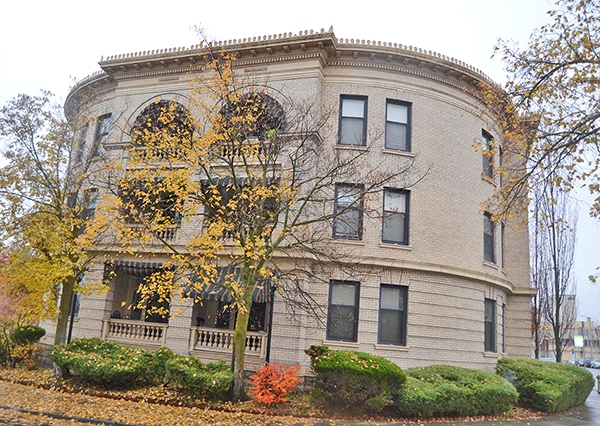
PhotoTitle: The San Marco Apartments
PhotoAttribution: Spokane City/County Historic Preservation Office
Listing Status: National Register
URL: http://properties.historicspokane.org/property/?PropertyID=2014
Display Marker: large_yellow
Title: San Marco Apartments
Description: Date Built: 1904
Architect: Albert Held/Fred Phair
Common Name: San Marco Apartments
The San Marco's builder and owner George C. Beck intended it to be "one of the most elegant, expensive buildings" in Spokane, "with flats to lease to the upper crust." To that end he contracted Albert Held, one of Spokane's premier architects, to design the building, and hired Fred Phair, a leading local builder trained at the Cooper Institute in New York, to build it in 1904. The building is architecturally significant for its association with Held and as a superior example of his work.
Location: 47.65742, -117.43103
Address: 1229 West Riverside Avenue, Spokane WA 99201
PhotoURL:

PhotoTitle: The San Marco Apartments
PhotoAttribution: Spokane City/County Historic Preservation Office
Listing Status: National Register
URL: http://properties.historicspokane.org/property/?PropertyID=2014
Display Marker: large_yellow
ID: 271
Title: Saranac Hotel
Description: Date Built: 1909
Architect: H.M. Keeny
Common Name: Saranac Hotel
Owner H. H. Hutton had this building built in 1909. A fine representative of Spokane's Single Room Occupancy Hotels in the Central Business District, the hotel housed on the upper floors has always been known as the Saranac, although it was also listed under furnished rooms as the Hotel Margurett in the 1910 directory. Early occupants of the commercial spaces included a second hand store in 1909 and Eli Woisnovich grocer in 1914. City Hand Laundry was a fixture in the building during the 1930s, 1940s, and 1950s. Other commercial tenants included B. C. Riblet Aerial Tramway during the 1930s, and Herman's Cabinet Shop and North Coast Supply Co. grocers during the 1940s and 1950s. This four-story red brick building has a buff brick facade with terra cotta trim. The upper floors have four window bays with bays of paired 1/1 wood sash windows flanking two bays of single 1/1 wood sash windows. A fire escape runs down the front of the westernmost of the central bays on the top two floors and extends to cover both single bays on the second floor. The ground floor is divided into three storefronts by cast iron piers, now painted green, which also frame the main hotel entrance offset east of center.
Location: 47.65875, -117.41229
Address: 25 West Main Avenue, Spokane WA 99201
PhotoURL: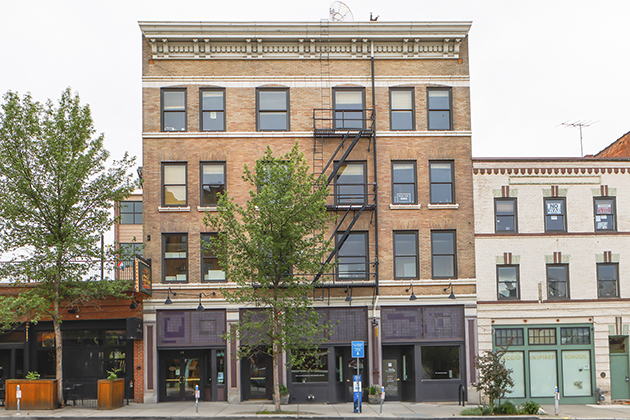
PhotoTitle: The Saranac Hotel
PhotoAttribution: Spokane City/County Historic Preservation Office
Listing Status: Spokane Register, National Register
URL: http://properties.historicspokane.org/property/?PropertyID=1927
Display Marker: large_yellow
Title: Saranac Hotel
Description: Date Built: 1909
Architect: H.M. Keeny
Common Name: Saranac Hotel
Owner H. H. Hutton had this building built in 1909. A fine representative of Spokane's Single Room Occupancy Hotels in the Central Business District, the hotel housed on the upper floors has always been known as the Saranac, although it was also listed under furnished rooms as the Hotel Margurett in the 1910 directory. Early occupants of the commercial spaces included a second hand store in 1909 and Eli Woisnovich grocer in 1914. City Hand Laundry was a fixture in the building during the 1930s, 1940s, and 1950s. Other commercial tenants included B. C. Riblet Aerial Tramway during the 1930s, and Herman's Cabinet Shop and North Coast Supply Co. grocers during the 1940s and 1950s. This four-story red brick building has a buff brick facade with terra cotta trim. The upper floors have four window bays with bays of paired 1/1 wood sash windows flanking two bays of single 1/1 wood sash windows. A fire escape runs down the front of the westernmost of the central bays on the top two floors and extends to cover both single bays on the second floor. The ground floor is divided into three storefronts by cast iron piers, now painted green, which also frame the main hotel entrance offset east of center.
Location: 47.65875, -117.41229
Address: 25 West Main Avenue, Spokane WA 99201
PhotoURL:

PhotoTitle: The Saranac Hotel
PhotoAttribution: Spokane City/County Historic Preservation Office
Listing Status: Spokane Register, National Register
URL: http://properties.historicspokane.org/property/?PropertyID=1927
Display Marker: large_yellow
ID: 272
Title: Sarsfield Farmhouse
Description: Date Built: 1905
Architect: Isaac Galbraith/ Peter Lefevre
Common Name: Sarsfield Farmhouse
The Sarsfield Farmhouse is a product of the American Arts and Crafts aesthetic and is an excellent example of the Craftsman style of architecture. The home was built for Patrick and Kate Sarsfield, Irish immigrants who established one of the area's first dairies on the acreage surrounding the house in White Bluff Prairie. Their business was incorporated as the Marigold Dairy but it was locally known as the Sarsfield Dairy. The house was designed by noted Spokane architect, Isaac J. Galbraith, and built in 1905 by Medical Lake pioneer and skilled stone mason Peter Lefevre. It is one of the oldest and best-preserved homes in unincorporated Spokane County and conveys early twentieth century building techniques evidenced in the use of basalt "liver rock" applied in the blind mortar method as a ten to twelve inch thick rock veneer.
Location: 47.6175, -117.49133
Address: 5520 West Thorpe Road, Spokane WA 99224
PhotoURL: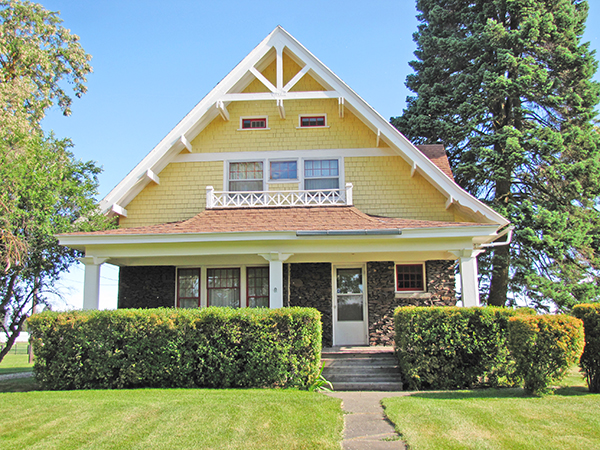
PhotoTitle: The Sarsfield Farmhouse
PhotoAttribution: Spokane City/County Historic Preservation Office
Listing Status: Spokane Register
URL: http://properties.historicspokane.org/property/?PropertyID=1928
Display Marker: large_yellow
Title: Sarsfield Farmhouse
Description: Date Built: 1905
Architect: Isaac Galbraith/ Peter Lefevre
Common Name: Sarsfield Farmhouse
The Sarsfield Farmhouse is a product of the American Arts and Crafts aesthetic and is an excellent example of the Craftsman style of architecture. The home was built for Patrick and Kate Sarsfield, Irish immigrants who established one of the area's first dairies on the acreage surrounding the house in White Bluff Prairie. Their business was incorporated as the Marigold Dairy but it was locally known as the Sarsfield Dairy. The house was designed by noted Spokane architect, Isaac J. Galbraith, and built in 1905 by Medical Lake pioneer and skilled stone mason Peter Lefevre. It is one of the oldest and best-preserved homes in unincorporated Spokane County and conveys early twentieth century building techniques evidenced in the use of basalt "liver rock" applied in the blind mortar method as a ten to twelve inch thick rock veneer.
Location: 47.6175, -117.49133
Address: 5520 West Thorpe Road, Spokane WA 99224
PhotoURL:

PhotoTitle: The Sarsfield Farmhouse
PhotoAttribution: Spokane City/County Historic Preservation Office
Listing Status: Spokane Register
URL: http://properties.historicspokane.org/property/?PropertyID=1928
Display Marker: large_yellow
ID: 273
Title: Schade Brewery
Description: Date Built: 1902
Architect: Lewis Stritesky and Gustav Pehrson
Common Name: Schade Tower
The Schade Brewery as it stands today was constructed in four phases: ca. 1902, 1903, 1907 and 1934-37. A striking landmark, and local manifestation of national trends, the old Schade Brewery provides a prominent physical reminder of past social, industrial, and architectural eras. The building takes its name from Bernhardt Schade, the brewmaster who had the building erected in 1903. Schade served as assistant brewmaster at another Spokane brewery, the New York Brewery, for a decade prior to establishing his own brewing operation. In 1903 he bought the entire oversized city block on East Trent from a Mr. Frost. Included in the purchase was a cold storage building Frost was constructing on the site. Schade hired the architect Lewis Stritesky, designer of the prominent Westminster Apartments at 2301 W. Pacific in Spokane, to design a facility based on drawings of a European brewery. Stritesky created a new western addition for the building begun by Frost. A bottling building and steam/pump house were also built on the property. Initial production was 35,000 to 40,000 barrels a year.
Location: 47.66071, -117.40218
Address: 528 East Spokane Falls Boulevard, Spokane WA 99202
PhotoURL: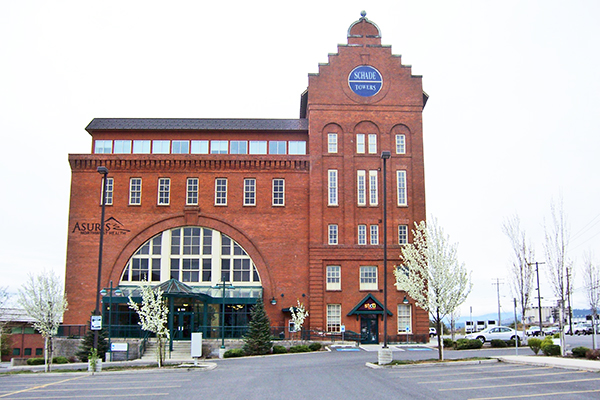
PhotoTitle: The Schade Brewery
PhotoAttribution: Spokane City/County Historic Preservation Office
Listing Status: Spokane Register, National Register
URL: http://properties.historicspokane.org/property/?PropertyID=1929
Display Marker: large_yellow
Title: Schade Brewery
Description: Date Built: 1902
Architect: Lewis Stritesky and Gustav Pehrson
Common Name: Schade Tower
The Schade Brewery as it stands today was constructed in four phases: ca. 1902, 1903, 1907 and 1934-37. A striking landmark, and local manifestation of national trends, the old Schade Brewery provides a prominent physical reminder of past social, industrial, and architectural eras. The building takes its name from Bernhardt Schade, the brewmaster who had the building erected in 1903. Schade served as assistant brewmaster at another Spokane brewery, the New York Brewery, for a decade prior to establishing his own brewing operation. In 1903 he bought the entire oversized city block on East Trent from a Mr. Frost. Included in the purchase was a cold storage building Frost was constructing on the site. Schade hired the architect Lewis Stritesky, designer of the prominent Westminster Apartments at 2301 W. Pacific in Spokane, to design a facility based on drawings of a European brewery. Stritesky created a new western addition for the building begun by Frost. A bottling building and steam/pump house were also built on the property. Initial production was 35,000 to 40,000 barrels a year.
Location: 47.66071, -117.40218
Address: 528 East Spokane Falls Boulevard, Spokane WA 99202
PhotoURL:

PhotoTitle: The Schade Brewery
PhotoAttribution: Spokane City/County Historic Preservation Office
Listing Status: Spokane Register, National Register
URL: http://properties.historicspokane.org/property/?PropertyID=1929
Display Marker: large_yellow
ID: 274
Title: Sears & Roebuck Building (demolished)
Description: Date Built: 1929
Architect: Sears and Roebuck Company (Class _A_ Store)/NImmons, Carr and Wright
Common Name: Spokane Public Library
Sears & Roebuck, one of the largest mail-order department stores in the United States, erected this Art-Deco building as the site of their Spokane store in 1929. Sears occupied the building until 1960, when it built a new store at the Northtown Mall. In 1961, the Comstock Foundation purchased the building for $350,000 and donated it to the City of Spokane for use as a new Public Library. A condition of the donation was that the Comstock name be retained. In 1962, the building was remodeled and opened as the Spokane Public Library. The building was razed in 1992 to make way for a new building to house the Spokane Public Library.
Location: 47.65954, -117.42555
Address: 906 West Main Avenue, Spokane WA 99201
PhotoURL: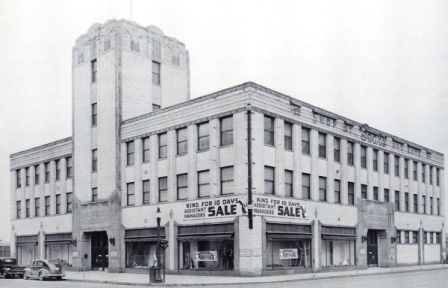
PhotoTitle: The once-standing Sears & Roebuck Building
PhotoAttribution: Spokane City/County Historic Preservation Office
Listing Status: N/A
URL: http://properties.historicspokane.org/property/?PropertyID=2015
Display Marker: large_yellow
Title: Sears & Roebuck Building (demolished)
Description: Date Built: 1929
Architect: Sears and Roebuck Company (Class _A_ Store)/NImmons, Carr and Wright
Common Name: Spokane Public Library
Sears & Roebuck, one of the largest mail-order department stores in the United States, erected this Art-Deco building as the site of their Spokane store in 1929. Sears occupied the building until 1960, when it built a new store at the Northtown Mall. In 1961, the Comstock Foundation purchased the building for $350,000 and donated it to the City of Spokane for use as a new Public Library. A condition of the donation was that the Comstock name be retained. In 1962, the building was remodeled and opened as the Spokane Public Library. The building was razed in 1992 to make way for a new building to house the Spokane Public Library.
Location: 47.65954, -117.42555
Address: 906 West Main Avenue, Spokane WA 99201
PhotoURL:

PhotoTitle: The once-standing Sears & Roebuck Building
PhotoAttribution: Spokane City/County Historic Preservation Office
Listing Status: N/A
URL: http://properties.historicspokane.org/property/?PropertyID=2015
Display Marker: large_yellow
ID: 275
Title: Seehorn-Lang Building
Description: Date Built: 1896
Architect: Unknown
Common Name: Seehorn Storage & Transfer Company
The Seehorn Storage & Transfer Co. Building is a contributing structure in the West Downtown Spokane Historic Transportation Corridor National Historic District. From 1898-1900 this building served as the warehouse for Swift & Co. meat packers. Prior to that, Spokane Storage Co. occupied the site. Seehorn Storage and Transfer moved into the building around 1910, and remained until about 1925, when the building was remodeled and street-level storefronts were added. Two longtime occupants of the new storefronts were the Holland Furnace Co., at 157-59, and Hoag (later Western) X-ray Co., at 155, both of which moved in during the late 1920s and remained into the 1960s. The building now connects with the old Central Steam Heat Plant, and is a part of Steam Plant Square, a renovated industrial complex housing office and commercial space in a unique setting.
Location: 47.65521, -117.42475
Address: 165 South Lincoln Street, Spokane WA 99201
PhotoURL: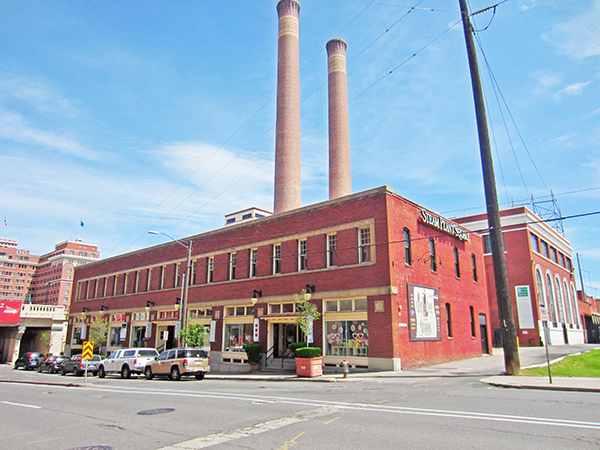
PhotoTitle: The Seehorn-Lang Building
PhotoAttribution: Spokane City/County Historic Preservation Office
Listing Status: Spokane Register, National Register
URL: http://properties.historicspokane.org/property/?PropertyID=1930
Display Marker: large_yellow
Title: Seehorn-Lang Building
Description: Date Built: 1896
Architect: Unknown
Common Name: Seehorn Storage & Transfer Company
The Seehorn Storage & Transfer Co. Building is a contributing structure in the West Downtown Spokane Historic Transportation Corridor National Historic District. From 1898-1900 this building served as the warehouse for Swift & Co. meat packers. Prior to that, Spokane Storage Co. occupied the site. Seehorn Storage and Transfer moved into the building around 1910, and remained until about 1925, when the building was remodeled and street-level storefronts were added. Two longtime occupants of the new storefronts were the Holland Furnace Co., at 157-59, and Hoag (later Western) X-ray Co., at 155, both of which moved in during the late 1920s and remained into the 1960s. The building now connects with the old Central Steam Heat Plant, and is a part of Steam Plant Square, a renovated industrial complex housing office and commercial space in a unique setting.
Location: 47.65521, -117.42475
Address: 165 South Lincoln Street, Spokane WA 99201
PhotoURL:

PhotoTitle: The Seehorn-Lang Building
PhotoAttribution: Spokane City/County Historic Preservation Office
Listing Status: Spokane Register, National Register
URL: http://properties.historicspokane.org/property/?PropertyID=1930
Display Marker: large_yellow
ID: 276
Title: Seligman House
Description: Date Built: 1907
Architect: Kirtland K. Cutter & Karl Malmgren
Common Name: William Otto & Stella Seligman House
Built in 1907, the Seligman House is a fine depiction of the Craftsman style. It was designed by Kirtland Kelsey Cutter, a principal architect with the architectural firm, Cutter & Malmgren. The front page of the Spokesman-Review newspaper printed a lengthy description of the Seligman House along with floor plans, a photograph of the exterior, and a photograph of the living room interior on August 25, 1907. Constructed at a reported cost of $7,000, the property was touted as an attractive home in Manito Park with many distinctive features, including exterior color harmony, large and well-arranged rooms, and ample grounds. The home was built for William Otto Seligman and his wife, Stella May Seligman. W. O. Seligman worked as part-owner/manager of Seligman Brothers Shoe Store in downtown Spokane, and as a salesman for D. Holzman & Company, wholesale liquor and cigars. The property achieved importance from 1906 to 1956 in the areas of significance, architecture and community planning & development, as a fine representation of the Craftsman style and a product of master architect, K. K. Cutter, and as an example of the type of residential home planned and prescribed by the developer of the neighborhood through restrictive covenants.
Location: 47.63434, -117.40727
Address: 2203 South Manito Boulevard, Spokane WA 99203
PhotoURL: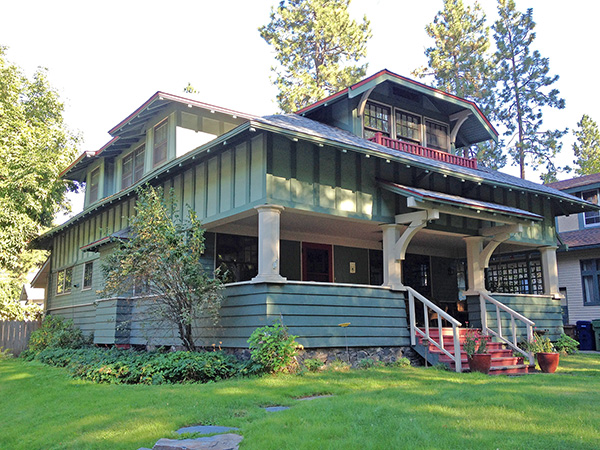
PhotoTitle: The William Otto and Stella Seligman House
PhotoAttribution: Spokane City/County Historic Preservation Office
Listing Status: Spokane Register, National Register
URL: http://properties.historicspokane.org/property/?PropertyID=1931
Display Marker: large_yellow
Title: Seligman House
Description: Date Built: 1907
Architect: Kirtland K. Cutter & Karl Malmgren
Common Name: William Otto & Stella Seligman House
Built in 1907, the Seligman House is a fine depiction of the Craftsman style. It was designed by Kirtland Kelsey Cutter, a principal architect with the architectural firm, Cutter & Malmgren. The front page of the Spokesman-Review newspaper printed a lengthy description of the Seligman House along with floor plans, a photograph of the exterior, and a photograph of the living room interior on August 25, 1907. Constructed at a reported cost of $7,000, the property was touted as an attractive home in Manito Park with many distinctive features, including exterior color harmony, large and well-arranged rooms, and ample grounds. The home was built for William Otto Seligman and his wife, Stella May Seligman. W. O. Seligman worked as part-owner/manager of Seligman Brothers Shoe Store in downtown Spokane, and as a salesman for D. Holzman & Company, wholesale liquor and cigars. The property achieved importance from 1906 to 1956 in the areas of significance, architecture and community planning & development, as a fine representation of the Craftsman style and a product of master architect, K. K. Cutter, and as an example of the type of residential home planned and prescribed by the developer of the neighborhood through restrictive covenants.
Location: 47.63434, -117.40727
Address: 2203 South Manito Boulevard, Spokane WA 99203
PhotoURL:

PhotoTitle: The William Otto and Stella Seligman House
PhotoAttribution: Spokane City/County Historic Preservation Office
Listing Status: Spokane Register, National Register
URL: http://properties.historicspokane.org/property/?PropertyID=1931
Display Marker: large_yellow
ID: 277
Title: Sengfelder-Bungay House
Description: Date Built: 1907
Architect: Kirtland Cutter & Karl Malmgren
Common Name: Angelica's Bed & Breakfast
Designed by the firm of Cutter and Malmgren in 1907 for John Sengfelder, this home is architecturally significant for its association with Spokane's renowned architect, Kirtland Kelsey Cutter. One of the earliest Spokane examples of a custom-designed house with strong Prairie Style elements, the Sengfelder-Bungay House affirms Cutter's design versatility and illustrates his use of stylistic trends. The house is also historically important for its connection with two socially prominent businessmen who were leaders in the commercial development of Spokane, John Sengfelder and Roy Bungay. John Sengfelder, born in Pennsylvania in 1859, migrated west at age 18. Once in Spokane, Sengfelder, practicing his trade as a baker and confectioner, opened the Sengfelder Bakery and Confectionery Company, the largest establishment of its kind in Spokane, which eventually employed over 20 people. His numerous other enterprises included real estate investments. In 1923 he and his wife, Elizabeth, moved to Los Angeles. Roy Bungay and his wife purchased the house in 1923 from the Sengfelders. Mr. Bungay helped develop the Spokane International Railway and in 1914, he established, in partnership with John Johnson, the Johnson-Bungay Fuel Company.
Location: 47.64697, -117.43193
Address: 1321 West 9th Avenue, Spokane WA 99204
PhotoURL: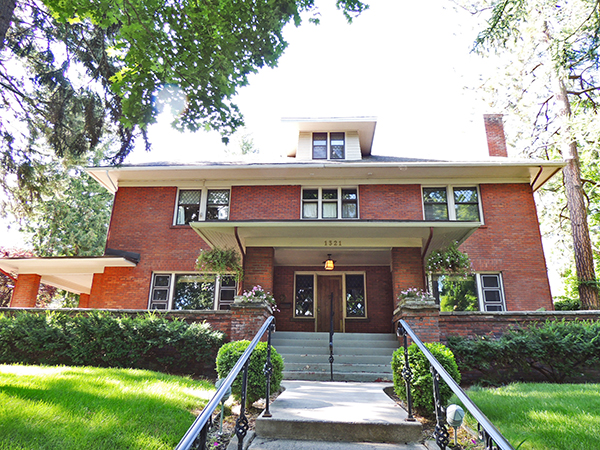
PhotoTitle: The Sengfelder-Bungay House
PhotoAttribution: Spokane City/County Historic Preservation Office
Listing Status: Spokane Register, National Register
URL: http://properties.historicspokane.org/property/?PropertyID=1932
Display Marker: large_yellow
Title: Sengfelder-Bungay House
Description: Date Built: 1907
Architect: Kirtland Cutter & Karl Malmgren
Common Name: Angelica's Bed & Breakfast
Designed by the firm of Cutter and Malmgren in 1907 for John Sengfelder, this home is architecturally significant for its association with Spokane's renowned architect, Kirtland Kelsey Cutter. One of the earliest Spokane examples of a custom-designed house with strong Prairie Style elements, the Sengfelder-Bungay House affirms Cutter's design versatility and illustrates his use of stylistic trends. The house is also historically important for its connection with two socially prominent businessmen who were leaders in the commercial development of Spokane, John Sengfelder and Roy Bungay. John Sengfelder, born in Pennsylvania in 1859, migrated west at age 18. Once in Spokane, Sengfelder, practicing his trade as a baker and confectioner, opened the Sengfelder Bakery and Confectionery Company, the largest establishment of its kind in Spokane, which eventually employed over 20 people. His numerous other enterprises included real estate investments. In 1923 he and his wife, Elizabeth, moved to Los Angeles. Roy Bungay and his wife purchased the house in 1923 from the Sengfelders. Mr. Bungay helped develop the Spokane International Railway and in 1914, he established, in partnership with John Johnson, the Johnson-Bungay Fuel Company.
Location: 47.64697, -117.43193
Address: 1321 West 9th Avenue, Spokane WA 99204
PhotoURL:

PhotoTitle: The Sengfelder-Bungay House
PhotoAttribution: Spokane City/County Historic Preservation Office
Listing Status: Spokane Register, National Register
URL: http://properties.historicspokane.org/property/?PropertyID=1932
Display Marker: large_yellow
ID: 278
Title: Shadle-Veasey House
Description: Date Built: 1906
Architect: Loren L. Rand
Common Name: Shadle-Veasey House
On January 23, 1905, James M. Comstock purchased Lots 10 and 11 on Block 69 in the Second Railroad Addition on West Ninth Avenue for $2,000. Founder of the Spokane Dry Goods Company, Spokane Dry Goods Realty Company, and the Crescent Department Store, Comstock was also father to Josie Comstock Shadle. Josie's husband, Eugene Shadle, was a business partner of Comstock's and was appointed president and general manager of the Crescent Department Store in Spokane, one of the most successful and longest-running department stores in Spokane history.
Location: 47.64756, -117.42883
Address: 1118 West 9th Avenue, Spokane WA 99204
PhotoURL: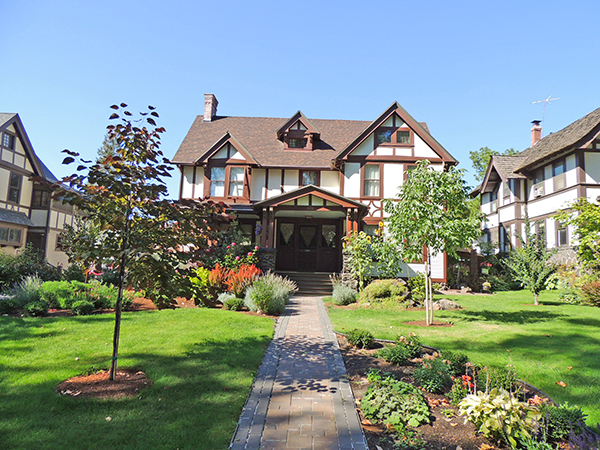
PhotoTitle: The Shadle-Veasey House
PhotoAttribution: Spokane City/County Historic Preservation Office
Listing Status: Spokane Register, National Register
URL: http://properties.historicspokane.org/property/?PropertyID=1934
Display Marker: large_yellow
Title: Shadle-Veasey House
Description: Date Built: 1906
Architect: Loren L. Rand
Common Name: Shadle-Veasey House
On January 23, 1905, James M. Comstock purchased Lots 10 and 11 on Block 69 in the Second Railroad Addition on West Ninth Avenue for $2,000. Founder of the Spokane Dry Goods Company, Spokane Dry Goods Realty Company, and the Crescent Department Store, Comstock was also father to Josie Comstock Shadle. Josie's husband, Eugene Shadle, was a business partner of Comstock's and was appointed president and general manager of the Crescent Department Store in Spokane, one of the most successful and longest-running department stores in Spokane history.
Location: 47.64756, -117.42883
Address: 1118 West 9th Avenue, Spokane WA 99204
PhotoURL:

PhotoTitle: The Shadle-Veasey House
PhotoAttribution: Spokane City/County Historic Preservation Office
Listing Status: Spokane Register, National Register
URL: http://properties.historicspokane.org/property/?PropertyID=1934
Display Marker: large_yellow
ID: 279
Title: Sheehy-Kelleher House
Description: Date Built: 1934
Architect: Unknown/Otto Bloomquist & Son, builder
Common Name: Sheehy-Kelleher House
Constructed in 1934, the Sheehy-Kelleher House was built between the 200 and 800 block during the last phase of single-family construction along East Mission Avenue, in what is today identified as the Mission Avenue National Historic District. An excellent example of the Tudor Revival style, the Sheehy-Kelleher House was constructed for John J. Sheehy, chief clerk with the Union Pacific Railway Company, and his wife Jane. Ray and Cathy Kelleher later acquired the property in 1967. During the property's period of significance from 1934 to 1967, the Sheehy-Kelleher House achieved historic significance for its association with the architectural development and settlement of the Logan Neighborhood, specifically along East Mission Avenue, and is additionally architecturally significant as an example of the Tudor Revival style.
Location: 47.67205, -117.40334
Address: 429 East Mission Avenue, Spokane WA 99202
PhotoURL: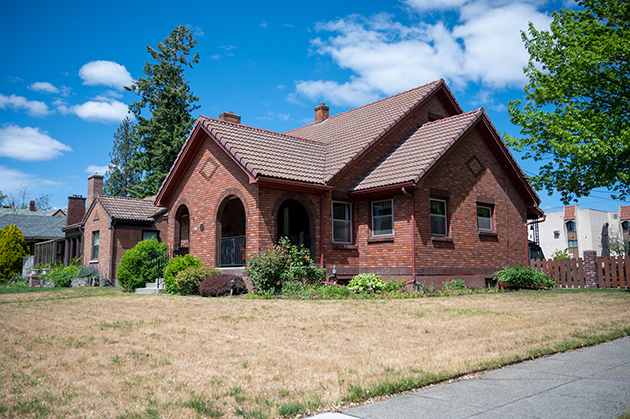
PhotoTitle: The Sheehy-Kelleher Hosue
PhotoAttribution: Spokane City/County Historic Preservation Office
Listing Status: Spokane Register, National Register
URL: http://properties.historicspokane.org/property/?PropertyID=1935
Display Marker: large_yellow
Title: Sheehy-Kelleher House
Description: Date Built: 1934
Architect: Unknown/Otto Bloomquist & Son, builder
Common Name: Sheehy-Kelleher House
Constructed in 1934, the Sheehy-Kelleher House was built between the 200 and 800 block during the last phase of single-family construction along East Mission Avenue, in what is today identified as the Mission Avenue National Historic District. An excellent example of the Tudor Revival style, the Sheehy-Kelleher House was constructed for John J. Sheehy, chief clerk with the Union Pacific Railway Company, and his wife Jane. Ray and Cathy Kelleher later acquired the property in 1967. During the property's period of significance from 1934 to 1967, the Sheehy-Kelleher House achieved historic significance for its association with the architectural development and settlement of the Logan Neighborhood, specifically along East Mission Avenue, and is additionally architecturally significant as an example of the Tudor Revival style.
Location: 47.67205, -117.40334
Address: 429 East Mission Avenue, Spokane WA 99202
PhotoURL:

PhotoTitle: The Sheehy-Kelleher Hosue
PhotoAttribution: Spokane City/County Historic Preservation Office
Listing Status: Spokane Register, National Register
URL: http://properties.historicspokane.org/property/?PropertyID=1935
Display Marker: large_yellow
ID: 280
Title: Shell Oil Building
Description: Date Built: 1915
Architect: Unknown
Common Name: Shell Oil Building
The Shell Oil Building is a small, one-story brick masonry building with a corbelled brick cornice and a two-bay instate storefront. The entrance, with original door and hardware, is located in the southern-most bay. Rosettes appear on a cast iron I-beam located above the storefront's transom windows. The Shell Oil Building was home to Ethan O. Palmer Auto Repair in the 1920s and 1930s and to S & E Plumbing and Heating Company from 1945 to the late 1980s.
Location: 47.70565, -117.3651
Address: 5215 North Market Street, Spokane WA 99217
PhotoURL: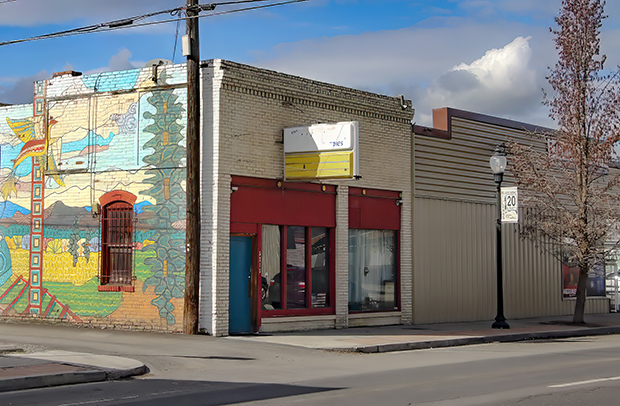
PhotoTitle: The Shell Oil Building
PhotoAttribution: Google Street View
Listing Status: Spokane Register, National Register
URL: http://properties.historicspokane.org/property/?PropertyID=1936
Display Marker: large_yellow
Title: Shell Oil Building
Description: Date Built: 1915
Architect: Unknown
Common Name: Shell Oil Building
The Shell Oil Building is a small, one-story brick masonry building with a corbelled brick cornice and a two-bay instate storefront. The entrance, with original door and hardware, is located in the southern-most bay. Rosettes appear on a cast iron I-beam located above the storefront's transom windows. The Shell Oil Building was home to Ethan O. Palmer Auto Repair in the 1920s and 1930s and to S & E Plumbing and Heating Company from 1945 to the late 1980s.
Location: 47.70565, -117.3651
Address: 5215 North Market Street, Spokane WA 99217
PhotoURL:

PhotoTitle: The Shell Oil Building
PhotoAttribution: Google Street View
Listing Status: Spokane Register, National Register
URL: http://properties.historicspokane.org/property/?PropertyID=1936
Display Marker: large_yellow
ID: 281
Title: Sherwood Building
Description: Date Built: 1916
Architect: Cutter & Malmgren/ Hurley-Mason
Common Name: Cutter Building
Rising eight stories above Riverside Avenue and exquisitely crafted in light gray terra cotta, the Sherwood Building is an eye-catching landmark in downtown Spokane. Constructed between 1916 and 1917, the building was originally developed by John D. Sherwood, a successful developer in Spokane's early history. Sherwood employed master architect Kirtland Cutter to design a building that would maximize the economics of the site in the core of a thriving commercial center. The Sherwood Building is one of only two Gothic Revival buildings in downtown; the other building being the Chronicle Building which was also designed by Cutter. Characteristic gothic detailing includes the many gargoyles and creatures which adorn the front of the building. The more interesting carvings included a hooded, bare-legged man who crouches above the main entry way, a lion that sits open-mouthed to his left and an eagle which stares intently from his right. The skillful use of gothic imagery, repetition and variation of forms and a careful balance of vertical and horizontal elements demonstrates the knowledge and finesse of an architect of the stature of Cutter.
Location: 47.65828, -117.42013
Address: 510 West Riverside Avenue, Spokane WA 99201
PhotoURL: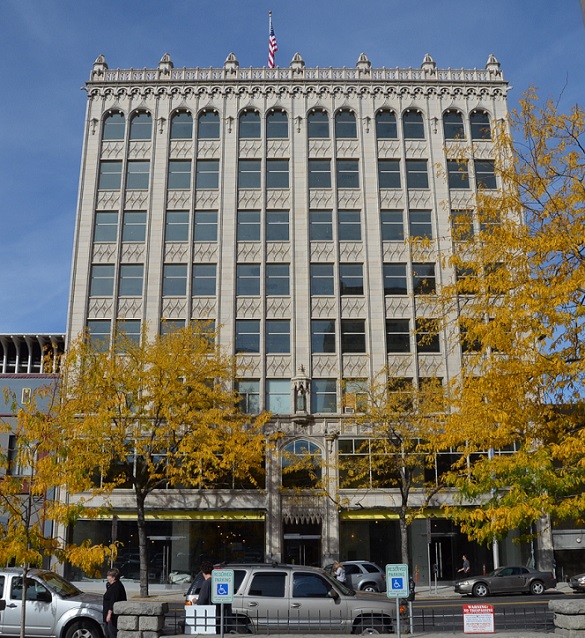
PhotoTitle: The Sherwood Building
PhotoAttribution: Spokane City/County Historic Preservation Office
Listing Status: Spokane Register
URL: http://properties.historicspokane.org/property/?PropertyID=2079
Display Marker: large_yellow
Title: Sherwood Building
Description: Date Built: 1916
Architect: Cutter & Malmgren/ Hurley-Mason
Common Name: Cutter Building
Rising eight stories above Riverside Avenue and exquisitely crafted in light gray terra cotta, the Sherwood Building is an eye-catching landmark in downtown Spokane. Constructed between 1916 and 1917, the building was originally developed by John D. Sherwood, a successful developer in Spokane's early history. Sherwood employed master architect Kirtland Cutter to design a building that would maximize the economics of the site in the core of a thriving commercial center. The Sherwood Building is one of only two Gothic Revival buildings in downtown; the other building being the Chronicle Building which was also designed by Cutter. Characteristic gothic detailing includes the many gargoyles and creatures which adorn the front of the building. The more interesting carvings included a hooded, bare-legged man who crouches above the main entry way, a lion that sits open-mouthed to his left and an eagle which stares intently from his right. The skillful use of gothic imagery, repetition and variation of forms and a careful balance of vertical and horizontal elements demonstrates the knowledge and finesse of an architect of the stature of Cutter.
Location: 47.65828, -117.42013
Address: 510 West Riverside Avenue, Spokane WA 99201
PhotoURL:

PhotoTitle: The Sherwood Building
PhotoAttribution: Spokane City/County Historic Preservation Office
Listing Status: Spokane Register
URL: http://properties.historicspokane.org/property/?PropertyID=2079
Display Marker: large_yellow
ID: 282
Title: Shoe Repair-Barber Shop Building
Description: Date Built: 1925
Architect: Unknown
Common Name: Shoe Repair-Barber Shop Building
The Shoe Repair-Barber Shop Building is a small, one-story hollow clay tile building with raked red brick veneer on the facade. This simple building is highlighted with a paneled frieze on the upper portion of the facade. The original storefront configuration is intact with original wood transoms, display windows, and recessed entrance. From 1925 to 1975, the building continuously housed a variety of shoe repair and barber shops.
Location: 47.70547, -117.36508
Address: 5209 North Market Street, Spokane WA 99217
PhotoURL: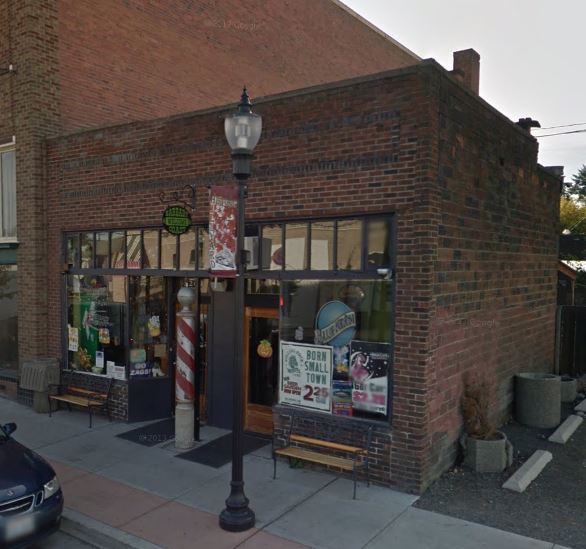
PhotoTitle: The Shoe Repair-Barber Shop Building
PhotoAttribution: Spokane City/County Historic Preservation Office
Listing Status: Spokane Register, National Register
URL: http://properties.historicspokane.org/property/?PropertyID=1937
Display Marker: large_yellow
Title: Shoe Repair-Barber Shop Building
Description: Date Built: 1925
Architect: Unknown
Common Name: Shoe Repair-Barber Shop Building
The Shoe Repair-Barber Shop Building is a small, one-story hollow clay tile building with raked red brick veneer on the facade. This simple building is highlighted with a paneled frieze on the upper portion of the facade. The original storefront configuration is intact with original wood transoms, display windows, and recessed entrance. From 1925 to 1975, the building continuously housed a variety of shoe repair and barber shops.
Location: 47.70547, -117.36508
Address: 5209 North Market Street, Spokane WA 99217
PhotoURL:

PhotoTitle: The Shoe Repair-Barber Shop Building
PhotoAttribution: Spokane City/County Historic Preservation Office
Listing Status: Spokane Register, National Register
URL: http://properties.historicspokane.org/property/?PropertyID=1937
Display Marker: large_yellow
ID: 283
Title: Smith Funeral
Description: Date Built: 1912
Architect: Jones & Levesque
Common Name: North Coast Life Insurance Company
The Smith Funeral Home Building is one of the focal point structures in the Riverside Avenue National Historic District, a serpentine avenue of stately buildings. The Baroque Revival building was completed in 1912 for Smith and Company, pioneer morticians. The building was constructured at the considerable cost of $130,000 from plans drawn by Alfred Jones and Joseph Levesque. The mansard roof, ornamental cartouche placed high on the facade and the original copper marquee gave the funeral home a sense of dignified refinement. In 1925, the company erected a steel-framed single-story garage entrance at the west of the building. The funeral home was the oldest continuously operating mortuary in the city prior to its closing in the late 1970s. It then sat vacant for nearly a decade and was very nearly demolished before the North Coast Life Insurance Co., located next east in the former Spokane Elks Lodge, rehabilitated it during the late 1980s.
Location: 47.65868, -117.42923
Address: 1124 West Riverside Avenue, Spokane WA 99201
PhotoURL: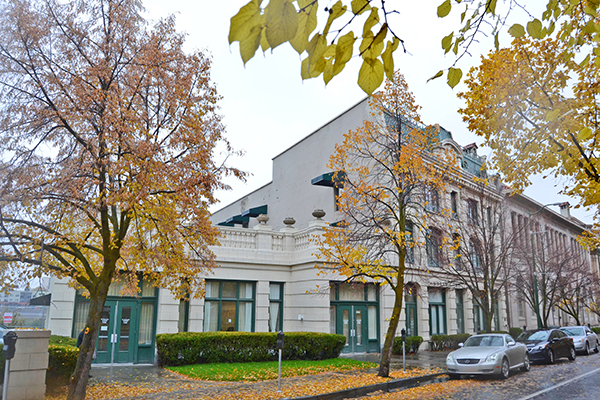
PhotoTitle: Smith Funeral
PhotoAttribution: Spokane City/County Historic Preservation Office
Listing Status: Spokane Register, National Register
URL: http://properties.historicspokane.org/property/?PropertyID=1938
Display Marker: large_yellow
Title: Smith Funeral
Description: Date Built: 1912
Architect: Jones & Levesque
Common Name: North Coast Life Insurance Company
The Smith Funeral Home Building is one of the focal point structures in the Riverside Avenue National Historic District, a serpentine avenue of stately buildings. The Baroque Revival building was completed in 1912 for Smith and Company, pioneer morticians. The building was constructured at the considerable cost of $130,000 from plans drawn by Alfred Jones and Joseph Levesque. The mansard roof, ornamental cartouche placed high on the facade and the original copper marquee gave the funeral home a sense of dignified refinement. In 1925, the company erected a steel-framed single-story garage entrance at the west of the building. The funeral home was the oldest continuously operating mortuary in the city prior to its closing in the late 1970s. It then sat vacant for nearly a decade and was very nearly demolished before the North Coast Life Insurance Co., located next east in the former Spokane Elks Lodge, rehabilitated it during the late 1980s.
Location: 47.65868, -117.42923
Address: 1124 West Riverside Avenue, Spokane WA 99201
PhotoURL:

PhotoTitle: Smith Funeral
PhotoAttribution: Spokane City/County Historic Preservation Office
Listing Status: Spokane Register, National Register
URL: http://properties.historicspokane.org/property/?PropertyID=1938
Display Marker: large_yellow
ID: 284
Title: Edwin Smith House
Description: Date Built: 1912
Architect: Charles R. Wood
Common Name: Edwin A. Smith House
This house, designed in the Tudor Revival style by architect Charles Wood, was constructed for noted Spokane resident Edwin A. Smith. Smith was an editor of the Cowles Publishing Company's farm journals for forty years. A vocal supporter of the American farmer, Smith was an avid crusader for improving farm life. Through his editorials and publications, he tried to alleviate the isolation of the western farm family.
Location: 47.67021, -117.45622
Address: 1414 North Summit Boulevard, Spokane WA 99201
PhotoURL: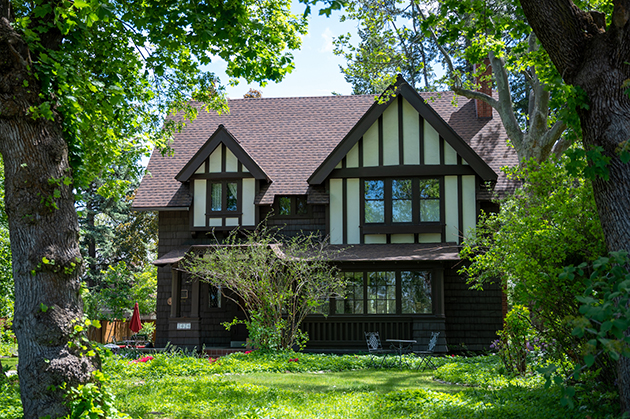
PhotoTitle: The Edwin A. Smith House
PhotoAttribution: Spokane City/County Historic Preservation Office
Listing Status: Spokane Register, National Register
URL: http://properties.historicspokane.org/property/?PropertyID=1940
Display Marker: large_yellow
Title: Edwin Smith House
Description: Date Built: 1912
Architect: Charles R. Wood
Common Name: Edwin A. Smith House
This house, designed in the Tudor Revival style by architect Charles Wood, was constructed for noted Spokane resident Edwin A. Smith. Smith was an editor of the Cowles Publishing Company's farm journals for forty years. A vocal supporter of the American farmer, Smith was an avid crusader for improving farm life. Through his editorials and publications, he tried to alleviate the isolation of the western farm family.
Location: 47.67021, -117.45622
Address: 1414 North Summit Boulevard, Spokane WA 99201
PhotoURL:

PhotoTitle: The Edwin A. Smith House
PhotoAttribution: Spokane City/County Historic Preservation Office
Listing Status: Spokane Register, National Register
URL: http://properties.historicspokane.org/property/?PropertyID=1940
Display Marker: large_yellow
ID: 285
Title: Snow-Stoltz House
Description: Date Built: 1908
Architect: Clapp & Clapp
Common Name: Snow-Stoltz House
Architects Frank and Lewis Clapp designed this American Foursquare style house for A. L. Snow, a railroad contractor with the firm of Watson & Snow, who built the house in 1908. Heath Addition, where Snow built the house, was one of the first areas developed on the north side of the river. Subsequent owners included James A. Anderson, president of the Spokane State Bank and owner of the Division Street and Manito Hardware companies, and R. H. Leyda, co-owner of Leyda & Barr Fuel Co. (later Ermina Fuel Co.). The Stoltz family purchased the house in 1961 and converted it into a bed and breakfast during the 1980s.
Location: 47.67535, -117.40343
Address: 427 East Indiana Avenue, Spokane WA 99207
PhotoURL: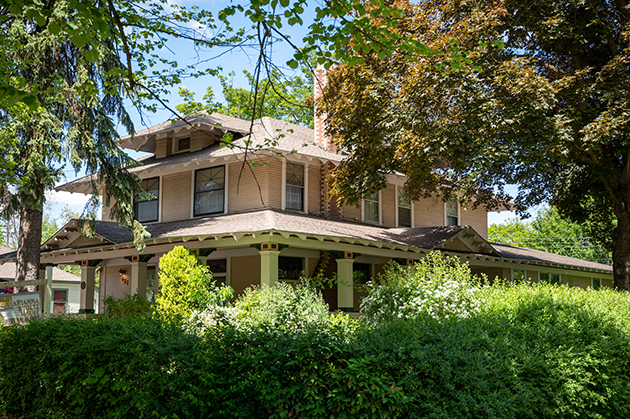
PhotoTitle: The Snow-Stoltz House
PhotoAttribution: Spokane City/County Historic Preservation Office
Listing Status: Spokane Register
URL: http://properties.historicspokane.org/property/?PropertyID=1941
Display Marker: large_yellow
Title: Snow-Stoltz House
Description: Date Built: 1908
Architect: Clapp & Clapp
Common Name: Snow-Stoltz House
Architects Frank and Lewis Clapp designed this American Foursquare style house for A. L. Snow, a railroad contractor with the firm of Watson & Snow, who built the house in 1908. Heath Addition, where Snow built the house, was one of the first areas developed on the north side of the river. Subsequent owners included James A. Anderson, president of the Spokane State Bank and owner of the Division Street and Manito Hardware companies, and R. H. Leyda, co-owner of Leyda & Barr Fuel Co. (later Ermina Fuel Co.). The Stoltz family purchased the house in 1961 and converted it into a bed and breakfast during the 1980s.
Location: 47.67535, -117.40343
Address: 427 East Indiana Avenue, Spokane WA 99207
PhotoURL:

PhotoTitle: The Snow-Stoltz House
PhotoAttribution: Spokane City/County Historic Preservation Office
Listing Status: Spokane Register
URL: http://properties.historicspokane.org/property/?PropertyID=1941
Display Marker: large_yellow
ID: 286
Title: Solby House
Description: Date Built: 1926
Architect: William Solby and Bertelsen & Wells
Common Name: William and Margaret Solby House
Built in 1926, the Solby House is a picturesque example of the Tudor Revival "Storybook" style. It was constructed for Margaret Solby and her husband, William Solby, a noted Spokane merchant, artist, inventor, decorator, and interior designer who erected the home to show how a model small house could be built. The home was custom-designed by Solby and Bertelsen & Wells, a prominent Spokane architectural firm, and was built to resemble the "old-fashioned North European type of farm house remembered by Mr. Solby" from his childhood in Copenhagen. With its unique golden-colored false-thatch, rolled-edge roof, hand-troweled soft pink stucco walls, and turquoise blue window shutters, the Solby House was an embodiment of the Storybook-style aesthetic and was described in 1926 as "not like a house in real life, but one of those enchanting hunting lodges in the wood, the cottage where Red Riding Hood went to see her grandmother." The house was featured with much aplomb on a three-page spread in the Spokesman-Review just after it was built in 1926. The newspaper venerated Solby as a recognized expert on decoration and touted the home's distinctive old English design with photographs, site plan, floor plan, and numerous articles that described the home's unique building site, exterior/interior design, architectural features, interior furnishings and fixtures, and its high-tech, thatch-like Zonolite roof. Called "Solby's Thatch," the roof was developed by William Solby to specifically resemble the look of thatched roofs constructed on cottages in England and northern Europe. The Solby House was additionally showcased in a May 1927 Good Housekeeping Magazine story with descriptive narrative and photographs of the exterior and interior.
Location: 47.63716, -117.39044
Address: 1325 East 20th Avenue, Spokane WA 99203
PhotoURL: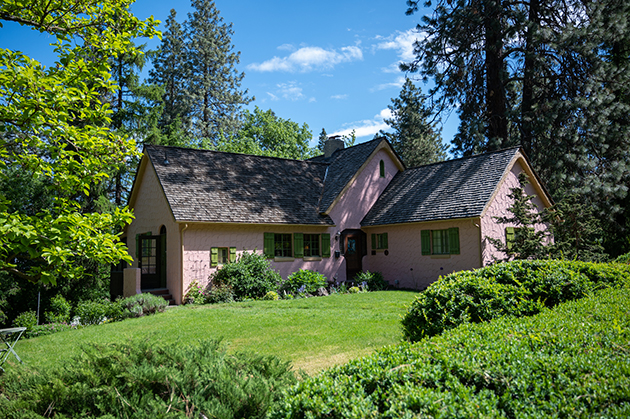
PhotoTitle: The William and Margaret Solby Hosue
PhotoAttribution: Spokane City/County Historic Preservation Office
Listing Status: Spokane Register, National Register
URL: http://properties.historicspokane.org/property/?PropertyID=1942
Display Marker: large_yellow
Title: Solby House
Description: Date Built: 1926
Architect: William Solby and Bertelsen & Wells
Common Name: William and Margaret Solby House
Built in 1926, the Solby House is a picturesque example of the Tudor Revival "Storybook" style. It was constructed for Margaret Solby and her husband, William Solby, a noted Spokane merchant, artist, inventor, decorator, and interior designer who erected the home to show how a model small house could be built. The home was custom-designed by Solby and Bertelsen & Wells, a prominent Spokane architectural firm, and was built to resemble the "old-fashioned North European type of farm house remembered by Mr. Solby" from his childhood in Copenhagen. With its unique golden-colored false-thatch, rolled-edge roof, hand-troweled soft pink stucco walls, and turquoise blue window shutters, the Solby House was an embodiment of the Storybook-style aesthetic and was described in 1926 as "not like a house in real life, but one of those enchanting hunting lodges in the wood, the cottage where Red Riding Hood went to see her grandmother." The house was featured with much aplomb on a three-page spread in the Spokesman-Review just after it was built in 1926. The newspaper venerated Solby as a recognized expert on decoration and touted the home's distinctive old English design with photographs, site plan, floor plan, and numerous articles that described the home's unique building site, exterior/interior design, architectural features, interior furnishings and fixtures, and its high-tech, thatch-like Zonolite roof. Called "Solby's Thatch," the roof was developed by William Solby to specifically resemble the look of thatched roofs constructed on cottages in England and northern Europe. The Solby House was additionally showcased in a May 1927 Good Housekeeping Magazine story with descriptive narrative and photographs of the exterior and interior.
Location: 47.63716, -117.39044
Address: 1325 East 20th Avenue, Spokane WA 99203
PhotoURL:

PhotoTitle: The William and Margaret Solby Hosue
PhotoAttribution: Spokane City/County Historic Preservation Office
Listing Status: Spokane Register, National Register
URL: http://properties.historicspokane.org/property/?PropertyID=1942
Display Marker: large_yellow
ID: 287
Title: Spokane & Inland Empire Railroad Car Facility
Description: Date Built: 1907
Architect: Albert Held/P.L. Petersen
Common Name: Spokane & Inland Empire Railroad Car Facility
The Spokane & Inland Empire Railroad (SIERR) Facilities and Car Barns constitute the largest and most intact building assemblage arising from the early twentieth century heyday of the electric railroad in the "Inland Empire" of Washington State. Given Spokane's national prominence in the early development of electric rail systems, these facilities provide a set of valuable resources connected with the transportation history of the United States. Built in a robust but austere variation of the industrial Romanesque Revival style, the SIERR buildings as a whole constitute a rare surviving example of a large scale electric railroad car complex from a century ago, a significant building type in both architectural and engineering terms. The brick and stone building complex features structural clarity and architectural expression in the straightforward materials, repetitive bays and scale of the various rail car barns. The SIERR building complex still stands as a rare surviving representative of an electric railroad car repair, storage, and fabrication facility despite minor alterations.
Location: 47.66017, -117.39713
Address: 850 East Spokane Falls Boulevard, Spokane WA 99202
PhotoURL: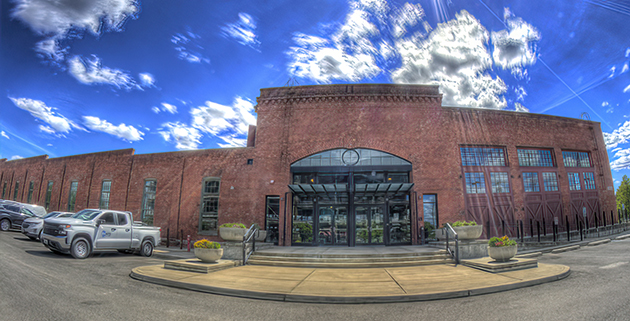
PhotoTitle: The Spokane & Inland Empire Railroad Car Facility
PhotoAttribution: Spokane City/County Historic Preservation Office
Listing Status: Spokane Register, National Register
URL: http://properties.historicspokane.org/property/?PropertyID=1945
Display Marker: large_yellow
Title: Spokane & Inland Empire Railroad Car Facility
Description: Date Built: 1907
Architect: Albert Held/P.L. Petersen
Common Name: Spokane & Inland Empire Railroad Car Facility
The Spokane & Inland Empire Railroad (SIERR) Facilities and Car Barns constitute the largest and most intact building assemblage arising from the early twentieth century heyday of the electric railroad in the "Inland Empire" of Washington State. Given Spokane's national prominence in the early development of electric rail systems, these facilities provide a set of valuable resources connected with the transportation history of the United States. Built in a robust but austere variation of the industrial Romanesque Revival style, the SIERR buildings as a whole constitute a rare surviving example of a large scale electric railroad car complex from a century ago, a significant building type in both architectural and engineering terms. The brick and stone building complex features structural clarity and architectural expression in the straightforward materials, repetitive bays and scale of the various rail car barns. The SIERR building complex still stands as a rare surviving representative of an electric railroad car repair, storage, and fabrication facility despite minor alterations.
Location: 47.66017, -117.39713
Address: 850 East Spokane Falls Boulevard, Spokane WA 99202
PhotoURL:

PhotoTitle: The Spokane & Inland Empire Railroad Car Facility
PhotoAttribution: Spokane City/County Historic Preservation Office
Listing Status: Spokane Register, National Register
URL: http://properties.historicspokane.org/property/?PropertyID=1945
Display Marker: large_yellow
ID: 288
Title: Spokane City Hall
Description: Date Built: 1912
Architect: Julius Zittel
Common Name: Old City Hall
This building was erected to serve as the temporary home of City Hall between 1912 and 1913, when railroad construction required demolition of the previous City Hall building. The City of Spokane expected to occupy this building for no more than five years, so no effort was made on ornamentation; its exterior was plain and its interior designed to be turned into a warehouse if expedient. Instead, it served as the seat of city government for more than seventy years, and as such was the site of many events that had an important impact on the historic and social fabric of the region. As a public building in everyday use, the Old City Hall was maintained in good operating condition and was never significantly altered. It remains much the same as built, a well-preserved legacy of the Commercial Style and Chicago School of architecture, as interpreted by noted local architect Julius Zittel. This building served as City Hall until 1982, when the city offices were moved into the Montgomery Ward Building at Post Street and Spokane Falls Boulevard. It has been renovated for office and commercial space.
Location: 47.6598, -117.42251
Address: 221 North Wall Street, Spokane WA 99201
PhotoURL: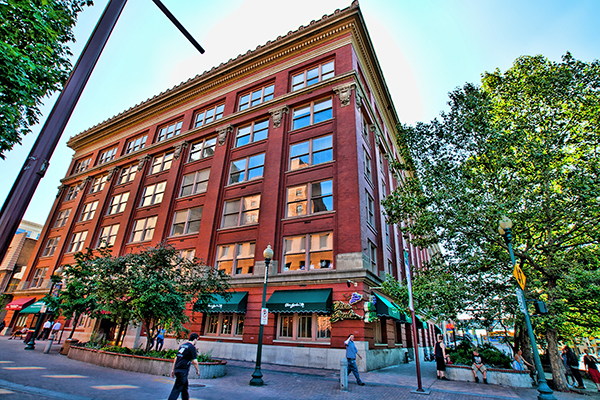
PhotoTitle: Old City Hall
PhotoAttribution: Spokane City/County Historic Preservation Office
Listing Status: Spokane Register, National Register
URL: http://properties.historicspokane.org/property/?PropertyID=1899
Display Marker: large_yellow
Title: Spokane City Hall
Description: Date Built: 1912
Architect: Julius Zittel
Common Name: Old City Hall
This building was erected to serve as the temporary home of City Hall between 1912 and 1913, when railroad construction required demolition of the previous City Hall building. The City of Spokane expected to occupy this building for no more than five years, so no effort was made on ornamentation; its exterior was plain and its interior designed to be turned into a warehouse if expedient. Instead, it served as the seat of city government for more than seventy years, and as such was the site of many events that had an important impact on the historic and social fabric of the region. As a public building in everyday use, the Old City Hall was maintained in good operating condition and was never significantly altered. It remains much the same as built, a well-preserved legacy of the Commercial Style and Chicago School of architecture, as interpreted by noted local architect Julius Zittel. This building served as City Hall until 1982, when the city offices were moved into the Montgomery Ward Building at Post Street and Spokane Falls Boulevard. It has been renovated for office and commercial space.
Location: 47.6598, -117.42251
Address: 221 North Wall Street, Spokane WA 99201
PhotoURL:

PhotoTitle: Old City Hall
PhotoAttribution: Spokane City/County Historic Preservation Office
Listing Status: Spokane Register, National Register
URL: http://properties.historicspokane.org/property/?PropertyID=1899
Display Marker: large_yellow
ID: 289
Title: Spokane Club
Description: Date Built: 1910
Architect: Kirtland K. Cutter
Common Name: Spokane Club
Designed by Cutter and Malmgren, Spokane's most celebrated firm of architects, the Georgian Revival style Spokane Club building serves as the eastern anchor of the Riverside Avenue National Historic District, which features a park-like setting planned by the nationally renowned Olmsted Brothers landscape architects of Brookline, Massachusetts. The Spokane Club, the first formal social organization in the city, relocated to this site in 1910 after a fire damaged the upper portion of its previous building, now known as the Chamber of Commerce/Metals/American Legion Building.
Location: 47.65882, -117.42706
Address: 1002 West Riverside Avenue, Spokane WA 99201
PhotoURL: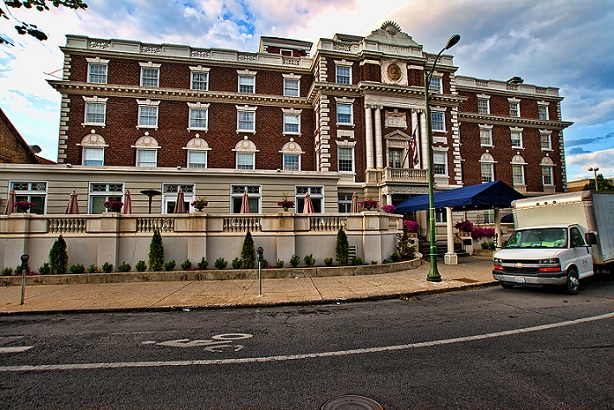
PhotoTitle: Spokane Club
PhotoAttribution: Spokane City/County Historic Preservation Office
Listing Status: Spokane Register, National Register
URL: http://properties.historicspokane.org/property/?PropertyID=1943
Display Marker: large_yellow
Title: Spokane Club
Description: Date Built: 1910
Architect: Kirtland K. Cutter
Common Name: Spokane Club
Designed by Cutter and Malmgren, Spokane's most celebrated firm of architects, the Georgian Revival style Spokane Club building serves as the eastern anchor of the Riverside Avenue National Historic District, which features a park-like setting planned by the nationally renowned Olmsted Brothers landscape architects of Brookline, Massachusetts. The Spokane Club, the first formal social organization in the city, relocated to this site in 1910 after a fire damaged the upper portion of its previous building, now known as the Chamber of Commerce/Metals/American Legion Building.
Location: 47.65882, -117.42706
Address: 1002 West Riverside Avenue, Spokane WA 99201
PhotoURL:

PhotoTitle: Spokane Club
PhotoAttribution: Spokane City/County Historic Preservation Office
Listing Status: Spokane Register, National Register
URL: http://properties.historicspokane.org/property/?PropertyID=1943
Display Marker: large_yellow
ID: 290
Title: Spokane County Courthouse
Description: Date Built: 1894
Architect: Willis A. Ritchie
Common Name: Spokane County Courthouse
The Spokane County Courthouse is one of the more prominent features in the Spokane skyline. It was built during 1894-1895 by David Fotheringham. Architect Willis Ritchie's award-winning design was chosen through a design competition in 1893. The dry pressed brick used for the building was the first to be produced in the area; previously such brick had to be shipped from the East Coast. The building has housed Spokane County government since 1895 and is one of the finest examples of French Renaissance architecture in the West.
Location: 47.664757, -117.428965
Address: 1116 West Broadway Avenue, Spokane WA 99260
PhotoURL: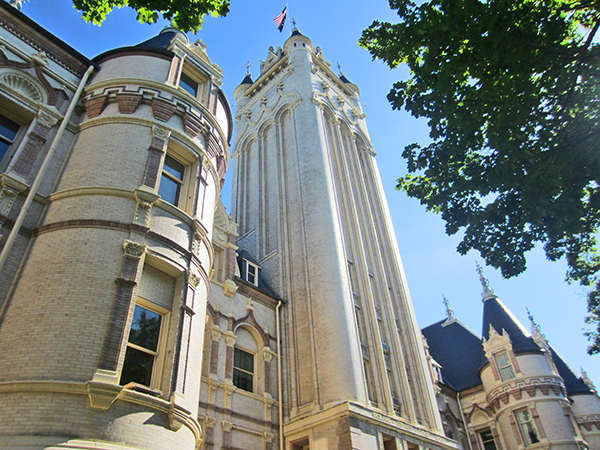
PhotoTitle: The Spokane County Courthouse
PhotoAttribution: Spokane City/County Historic Preservation Office
Listing Status: Spokane Register, National Register
URL: http://properties.historicspokane.org/property/?PropertyID=1944
Display Marker: large_yellow
Title: Spokane County Courthouse
Description: Date Built: 1894
Architect: Willis A. Ritchie
Common Name: Spokane County Courthouse
The Spokane County Courthouse is one of the more prominent features in the Spokane skyline. It was built during 1894-1895 by David Fotheringham. Architect Willis Ritchie's award-winning design was chosen through a design competition in 1893. The dry pressed brick used for the building was the first to be produced in the area; previously such brick had to be shipped from the East Coast. The building has housed Spokane County government since 1895 and is one of the finest examples of French Renaissance architecture in the West.
Location: 47.664757, -117.428965
Address: 1116 West Broadway Avenue, Spokane WA 99260
PhotoURL:

PhotoTitle: The Spokane County Courthouse
PhotoAttribution: Spokane City/County Historic Preservation Office
Listing Status: Spokane Register, National Register
URL: http://properties.historicspokane.org/property/?PropertyID=1944
Display Marker: large_yellow
ID: 291
Title: Spokane Fire Station No. 3
Description: Date Built: 1912
Architect: Unknown
Common Name: Spokane Public Radio
Spokane Fire Station No. 3, as it exists today, is actually two buildings, each built at a different time and later joined to form a single unit. The rear section, built in 1912, was originally intended to serve as a shop where vehicles and other fire fighting equipment could be built and repaired. At present, this building exhibits a red brick exterior and retains its historic two-story commercial style. The adjoining structure, built in 1917, also maintains a red brick exterior with a concrete foundation and a flat tar roof. The interior of the station, despite renovation to accommodate modern business activities, retains many features reminiscent of its original purpose, including the sliding pole!
Location: 47.66902, -117.42706
Address: 1229 North Monroe Street, Spokane WA 99201
PhotoURL: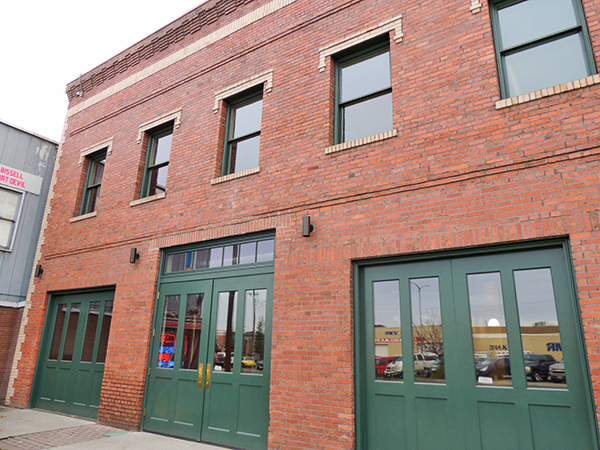
PhotoTitle: Spokane Fire Station No. 3
PhotoAttribution: Spokane City/County Historic Preservation Office
Listing Status: Spokane Register, National Register
URL: http://properties.historicspokane.org/property/?PropertyID=1995
Display Marker: large_yellow
Title: Spokane Fire Station No. 3
Description: Date Built: 1912
Architect: Unknown
Common Name: Spokane Public Radio
Spokane Fire Station No. 3, as it exists today, is actually two buildings, each built at a different time and later joined to form a single unit. The rear section, built in 1912, was originally intended to serve as a shop where vehicles and other fire fighting equipment could be built and repaired. At present, this building exhibits a red brick exterior and retains its historic two-story commercial style. The adjoining structure, built in 1917, also maintains a red brick exterior with a concrete foundation and a flat tar roof. The interior of the station, despite renovation to accommodate modern business activities, retains many features reminiscent of its original purpose, including the sliding pole!
Location: 47.66902, -117.42706
Address: 1229 North Monroe Street, Spokane WA 99201
PhotoURL:

PhotoTitle: Spokane Fire Station No. 3
PhotoAttribution: Spokane City/County Historic Preservation Office
Listing Status: Spokane Register, National Register
URL: http://properties.historicspokane.org/property/?PropertyID=1995
Display Marker: large_yellow
ID: 292
Title: Spokane Fire Station No. 9
Description: Date Built: 1930
Architect: Arthur Cowley
Common Name: Fire Station No. 9
Since 1930, Fire Station No. 9 not only provided fire protection for a large part of the city, but was an important factor in the neighborhood's social life as a center for local functions and various services as well. The station is also significant as an illustration of a transitional period in local firehouse design. Fire Station no. 9 was the last Spokane station to have been designed deliberately to complement the stylish appearance of neighboring residences.
Location: 47.64801, -117.4268
Address: 804 South Monroe Street, Spokane WA 99204
PhotoURL: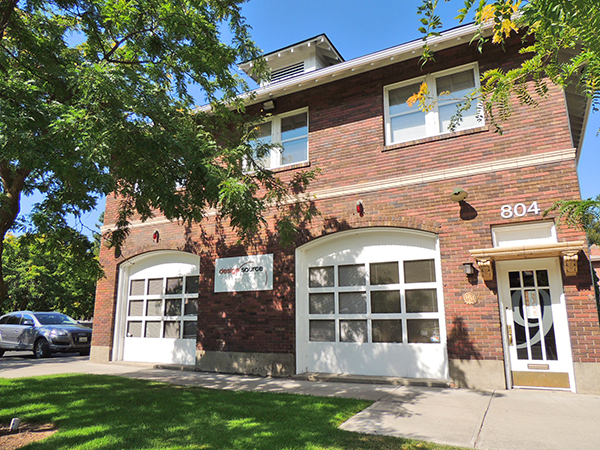
PhotoTitle: Spokane Fire Station No. 9
PhotoAttribution: Spokane City/County Historic Preservation Office
Listing Status: Spokane Register, National Register
URL: http://properties.historicspokane.org/property/?PropertyID=1996
Display Marker: large_yellow
Title: Spokane Fire Station No. 9
Description: Date Built: 1930
Architect: Arthur Cowley
Common Name: Fire Station No. 9
Since 1930, Fire Station No. 9 not only provided fire protection for a large part of the city, but was an important factor in the neighborhood's social life as a center for local functions and various services as well. The station is also significant as an illustration of a transitional period in local firehouse design. Fire Station no. 9 was the last Spokane station to have been designed deliberately to complement the stylish appearance of neighboring residences.
Location: 47.64801, -117.4268
Address: 804 South Monroe Street, Spokane WA 99204
PhotoURL:

PhotoTitle: Spokane Fire Station No. 9
PhotoAttribution: Spokane City/County Historic Preservation Office
Listing Status: Spokane Register, National Register
URL: http://properties.historicspokane.org/property/?PropertyID=1996
Display Marker: large_yellow
ID: 293
Title: Spokane Flour Mill
Description: Date Built: 1895
Architect: E.P. Allis
Common Name: The Old Flour Mill
The Flour Mill is a physical reminder of the centrality of water power in Spokane's history; nearly all of the early development of the city was directly related to the majestic falls of the Spokane River. The Spokane Flour Mill, built in 1895, was one in a series of mills built along the falls prior to 1900. It did not come into operation, however, until 1900 because the property became mired in a complex international lawsuit that was one of the most explosive and longest-fought battles in the city's legal history. The mill was adaptively renovated as a shopping center in conjunction with preparations for the World's Fair that Spokane hosted in 1974. Shoppers and diners at the Flour Mill now enjoy a view of Riverfront Park, the legacy of Expo '74 and the centerpiece of the city. The Flour Mill stands as a unique reminder that Spokane's history and wealth began in the power of the falls and endured through the bounty of the surrounding countryside.
Location: 47.664955, -117.421901
Address: 621 West Mallon Avenue, Spokane WA 99201
PhotoURL: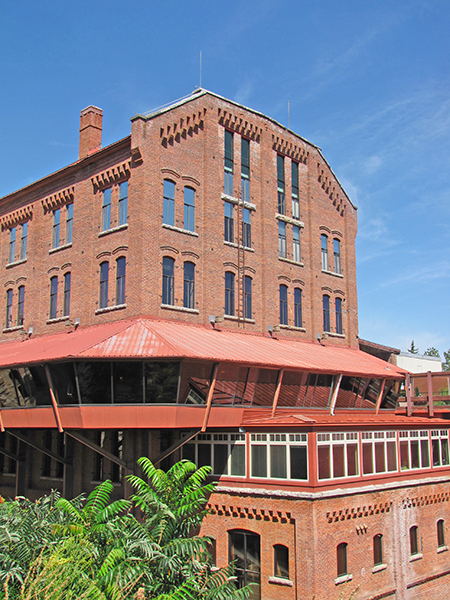
PhotoTitle: The Old Flour Mill
PhotoAttribution: Spokane City/County Historic Preservation Office
Listing Status: Spokane Register, National Register
URL: http://properties.historicspokane.org/property/?PropertyID=1946
Display Marker: large_yellow
Title: Spokane Flour Mill
Description: Date Built: 1895
Architect: E.P. Allis
Common Name: The Old Flour Mill
The Flour Mill is a physical reminder of the centrality of water power in Spokane's history; nearly all of the early development of the city was directly related to the majestic falls of the Spokane River. The Spokane Flour Mill, built in 1895, was one in a series of mills built along the falls prior to 1900. It did not come into operation, however, until 1900 because the property became mired in a complex international lawsuit that was one of the most explosive and longest-fought battles in the city's legal history. The mill was adaptively renovated as a shopping center in conjunction with preparations for the World's Fair that Spokane hosted in 1974. Shoppers and diners at the Flour Mill now enjoy a view of Riverfront Park, the legacy of Expo '74 and the centerpiece of the city. The Flour Mill stands as a unique reminder that Spokane's history and wealth began in the power of the falls and endured through the bounty of the surrounding countryside.
Location: 47.664955, -117.421901
Address: 621 West Mallon Avenue, Spokane WA 99201
PhotoURL:

PhotoTitle: The Old Flour Mill
PhotoAttribution: Spokane City/County Historic Preservation Office
Listing Status: Spokane Register, National Register
URL: http://properties.historicspokane.org/property/?PropertyID=1946
Display Marker: large_yellow
ID: 294
Title: Spokane House Site
Description: Date Built: NA
Architect: NA
Common Name: Fort Jacob/ Fort Spokane
The Spokane House Site is not currently listed on either the Spokane or the National Register of Historic Places, but is considered a historically and culturally significant archaeological site. At the turn of the century, the North West Company, a Canadian firm, started exploration of the fur resources of the inland northwest. David Thompson, explorer-geographer with the North West Company, made his way across the Rocky Mountains in 1807. As a result of these explorations, the trading posts of Kootenai House, Kullyspell House, and Saleesh House were established. In 1810, Thompson established a small post called Spokane House, built to meet his immediate needs, at the confluence of the Little Spokane and Spokane Rivers. It probably consisted of a store, warehouse, and quarters for the men. In 1811, John Jacob Astor of the American Pacific Fur Company established Fort Jacob near Spokane House. Fort Jacob was short-lived as news of the War of 1812 between the United States and Britain spread. By 1821, in an act of Parliament, the Canadian North West Company was absorbed by the British Hudson's Bay Company. In 1826, Spokane House was considered to be a less than ideal place for a trading post, and after 16 years of continuous occupation was abandoned for Fort Colville. Although archaeological studies have been made of this site, the precise location of Spokane House remains unknown. The Washington State Parks and Recreation Commission has developed a Spokane House site for the enjoyment and education of visitors.
Location: 47.784309, -117.536141
Address: 13501 North Nine Mile Road, Nine Mile Falls WA 99026
PhotoURL: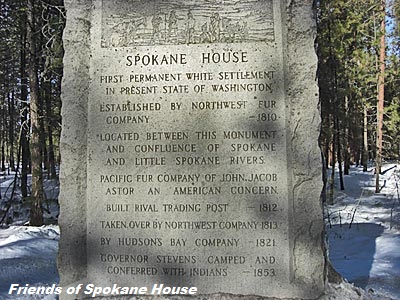
PhotoTitle: Historic marker at the Spokane House Site
PhotoAttribution: Friends of Spokane House
Listing Status: N/A
URL: http://properties.historicspokane.org/property/?PropertyID=2016
Display Marker: large_yellow
Title: Spokane House Site
Description: Date Built: NA
Architect: NA
Common Name: Fort Jacob/ Fort Spokane
The Spokane House Site is not currently listed on either the Spokane or the National Register of Historic Places, but is considered a historically and culturally significant archaeological site. At the turn of the century, the North West Company, a Canadian firm, started exploration of the fur resources of the inland northwest. David Thompson, explorer-geographer with the North West Company, made his way across the Rocky Mountains in 1807. As a result of these explorations, the trading posts of Kootenai House, Kullyspell House, and Saleesh House were established. In 1810, Thompson established a small post called Spokane House, built to meet his immediate needs, at the confluence of the Little Spokane and Spokane Rivers. It probably consisted of a store, warehouse, and quarters for the men. In 1811, John Jacob Astor of the American Pacific Fur Company established Fort Jacob near Spokane House. Fort Jacob was short-lived as news of the War of 1812 between the United States and Britain spread. By 1821, in an act of Parliament, the Canadian North West Company was absorbed by the British Hudson's Bay Company. In 1826, Spokane House was considered to be a less than ideal place for a trading post, and after 16 years of continuous occupation was abandoned for Fort Colville. Although archaeological studies have been made of this site, the precise location of Spokane House remains unknown. The Washington State Parks and Recreation Commission has developed a Spokane House site for the enjoyment and education of visitors.
Location: 47.784309, -117.536141
Address: 13501 North Nine Mile Road, Nine Mile Falls WA 99026
PhotoURL:

PhotoTitle: Historic marker at the Spokane House Site
PhotoAttribution: Friends of Spokane House
Listing Status: N/A
URL: http://properties.historicspokane.org/property/?PropertyID=2016
Display Marker: large_yellow
ID: 295
Title: Spokane Parental School
Description: Date Built: 1908
Architect: Albert Held
Common Name: Spokane Parental School
With the construction of Spokane Parental School, which housed, educated, disciplined, and mentored delinquent boys, in 1908, Spokane became one of only five cities in the United States, together with New York, Boston, Chicago, and Seattle, with educational correctional facilities of this sort. Renowned Spokane master architect Albert Held donated his services, drawing plans for the school and outbuildings in the Dutch Colonial Revival style.
Location: 47.601186, -117.407864
Address: 280 East Meadowlane Road, Spokane WA 99224
PhotoURL: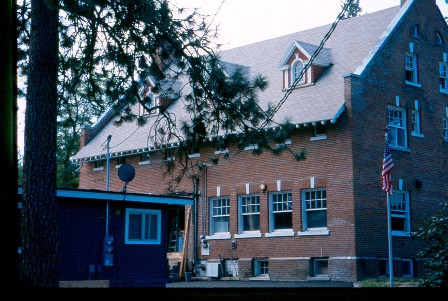
PhotoTitle: Spokane Parental School
PhotoAttribution: Spokane City/County Historic Preservation Office
Listing Status: Spokane Register
URL: http://properties.historicspokane.org/property/?PropertyID=1947
Display Marker: large_yellow
Title: Spokane Parental School
Description: Date Built: 1908
Architect: Albert Held
Common Name: Spokane Parental School
With the construction of Spokane Parental School, which housed, educated, disciplined, and mentored delinquent boys, in 1908, Spokane became one of only five cities in the United States, together with New York, Boston, Chicago, and Seattle, with educational correctional facilities of this sort. Renowned Spokane master architect Albert Held donated his services, drawing plans for the school and outbuildings in the Dutch Colonial Revival style.
Location: 47.601186, -117.407864
Address: 280 East Meadowlane Road, Spokane WA 99224
PhotoURL:

PhotoTitle: Spokane Parental School
PhotoAttribution: Spokane City/County Historic Preservation Office
Listing Status: Spokane Register
URL: http://properties.historicspokane.org/property/?PropertyID=1947
Display Marker: large_yellow
ID: 296
Title: Spokane Public Bath House
Description: Date Built: 1914
Architect: Harold C. Whitehouse
Common Name: Mission Park Public Bath House
Constructed in 1914, the Spokane Public Bath House is located in what was previously called the Sinto Triangle Park and was the first public bath house in Spokane. The Bath House, with its low-pitched roof, widely overhanging eaves and decorative eave brackets, is an excellent example of the Italian Renaissance style, a tradition infrequently seen in Spokane. After the success of the first bath house, outdoor public swimming pools, or plunges as they were called in 1914, were constructed across Spokane.
Location: 47.670267, -117.389378
Address: 1414 East Mission Avenue, Spokane WA 99202
PhotoURL: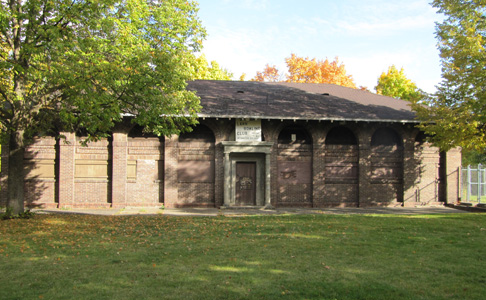
PhotoTitle: Spokane Public Bath House
PhotoAttribution: Spokane City/County Historic Preservation Office
Listing Status: Spokane Register
URL: http://properties.historicspokane.org/property/?PropertyID=2046
Display Marker: large_yellow
Title: Spokane Public Bath House
Description: Date Built: 1914
Architect: Harold C. Whitehouse
Common Name: Mission Park Public Bath House
Constructed in 1914, the Spokane Public Bath House is located in what was previously called the Sinto Triangle Park and was the first public bath house in Spokane. The Bath House, with its low-pitched roof, widely overhanging eaves and decorative eave brackets, is an excellent example of the Italian Renaissance style, a tradition infrequently seen in Spokane. After the success of the first bath house, outdoor public swimming pools, or plunges as they were called in 1914, were constructed across Spokane.
Location: 47.670267, -117.389378
Address: 1414 East Mission Avenue, Spokane WA 99202
PhotoURL:

PhotoTitle: Spokane Public Bath House
PhotoAttribution: Spokane City/County Historic Preservation Office
Listing Status: Spokane Register
URL: http://properties.historicspokane.org/property/?PropertyID=2046
Display Marker: large_yellow
ID: 297
Title: Spokane Sash & Door Company Flats
Description: Date Built: 1909
Architect: Kirtland K. Cutter
Common Name: Gardener & Engdahl Apartments/ The Gables
The Spokane Sash & Door Company Flats are historically significant for their association with Spokane's development and growth as a regional transportation hub, and architecturally significant as the work of the city's most celebrated architect, Kirtland K. Cutter. Built during a period when Spokane's population tripled from 36,000 in 1900 to 100,000 in 1910, this building is one of only a few of the twenty-two apartments built in Spokane by 1909 still standing today. The main building was commissioned in Tudor Revival style by the Spokane Sash and Door Company. This clinker brick building rightfully derives its current name, "The Gables," from the building's multi-gabled rooflines.
Location: 47.66464, -117.43157
Address: 1302 West Broadway Avenue, Spokane WA 99201
PhotoURL: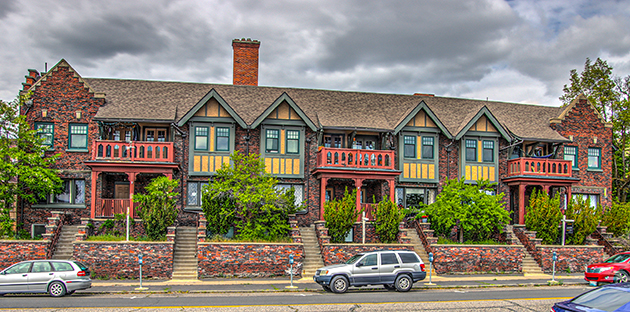
PhotoTitle: Spokane Sash & Door Company Flats
PhotoAttribution: Spokane City/County Historic Preservation Office
Listing Status: Spokane Register, National Register
URL: http://properties.historicspokane.org/property/?PropertyID=1948
Display Marker: large_yellow
Title: Spokane Sash & Door Company Flats
Description: Date Built: 1909
Architect: Kirtland K. Cutter
Common Name: Gardener & Engdahl Apartments/ The Gables
The Spokane Sash & Door Company Flats are historically significant for their association with Spokane's development and growth as a regional transportation hub, and architecturally significant as the work of the city's most celebrated architect, Kirtland K. Cutter. Built during a period when Spokane's population tripled from 36,000 in 1900 to 100,000 in 1910, this building is one of only a few of the twenty-two apartments built in Spokane by 1909 still standing today. The main building was commissioned in Tudor Revival style by the Spokane Sash and Door Company. This clinker brick building rightfully derives its current name, "The Gables," from the building's multi-gabled rooflines.
Location: 47.66464, -117.43157
Address: 1302 West Broadway Avenue, Spokane WA 99201
PhotoURL:

PhotoTitle: Spokane Sash & Door Company Flats
PhotoAttribution: Spokane City/County Historic Preservation Office
Listing Status: Spokane Register, National Register
URL: http://properties.historicspokane.org/property/?PropertyID=1948
Display Marker: large_yellow
ID: 298
Title: St. Joseph's Catholic Church and Convent
Description: Date Built: 1901
Architect: Julius A. Zittel
Common Name: St. Joesph Catholic Church Parish-Spokane
Built in 1901 and enlarged in 1909, St. Joseph's Catholic Church & Convent are located at the intersection of Dean Avenue and Walnut Street in the West Central neighborhood in northwest Spokane, Washington. The church is a fine example of ecclesiastical architecture designed in the Late Gothic Revival style and features a cruciform plan with a tall steeple, brick masonry construction, Gothic arches and label moldings, Gothic tracery and quatrefoils, stained-glass windows, a stepped buttresses, a domed apse, and a Gothic-arched pediment at the front entrance. The adjacent convent is a fine depiction of the Collegiate Gothic style. The buildings are well-preserved with few exterior alterations. Together, they retain excellent architectural integrity of location, design, materials, workmanship, and association as early 20th-century ecclesiastical and scholastic buildings erected in Spokane, Washington.
Location: 47.66597, -117.43449
Address: 1507 West Dean Avenue, Spokane WA 99201
PhotoURL:
PhotoTitle: St. Joseph's Catholic Church and Convent
PhotoAttribution: Spokane City/County Historic Preservation Office
Listing Status: Spokane Register
URL: http://properties.historicspokane.org/property/?PropertyID=2036
Display Marker: large_yellow
Title: St. Joseph's Catholic Church and Convent
Description: Date Built: 1901
Architect: Julius A. Zittel
Common Name: St. Joesph Catholic Church Parish-Spokane
Built in 1901 and enlarged in 1909, St. Joseph's Catholic Church & Convent are located at the intersection of Dean Avenue and Walnut Street in the West Central neighborhood in northwest Spokane, Washington. The church is a fine example of ecclesiastical architecture designed in the Late Gothic Revival style and features a cruciform plan with a tall steeple, brick masonry construction, Gothic arches and label moldings, Gothic tracery and quatrefoils, stained-glass windows, a stepped buttresses, a domed apse, and a Gothic-arched pediment at the front entrance. The adjacent convent is a fine depiction of the Collegiate Gothic style. The buildings are well-preserved with few exterior alterations. Together, they retain excellent architectural integrity of location, design, materials, workmanship, and association as early 20th-century ecclesiastical and scholastic buildings erected in Spokane, Washington.
Location: 47.66597, -117.43449
Address: 1507 West Dean Avenue, Spokane WA 99201
PhotoURL:

PhotoTitle: St. Joseph's Catholic Church and Convent
PhotoAttribution: Spokane City/County Historic Preservation Office
Listing Status: Spokane Register
URL: http://properties.historicspokane.org/property/?PropertyID=2036
Display Marker: large_yellow
ID: 299
Title: St. Joseph's Catholic School Gymnasium
Description: Date Built: 1928
Architect: Julius A. Zittel
Common Name: Hamilton Photography Studio
Built in 1928, St. Joseph's Catholic School Auditorium/Gymnasium is located at the intersection of Dean Avenue and Walnut Street in the West Central neighborhood of northwest Spokane, Washington. The auditorium/gym is an excellent interpretation of the Spanish Eclectic style applied to a building that was originally part of St. Joseph's Catholic Parish ecclesiastical and scholastic campus. The property has few exterior alterations and retains excellent architectural integrity of location, design, materials, workmanship, and association as early 20th-century building erected in Spokane, Washington.
Location: 47.66599, -117.43383
Address: 1427 West Dean Avenue, Spokane WA 99201
PhotoURL: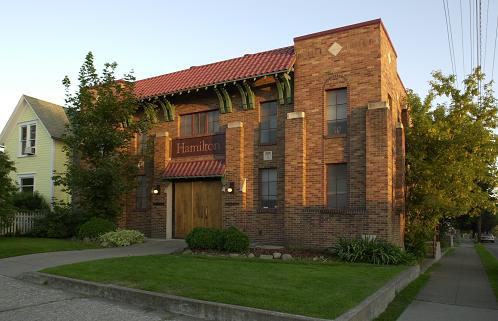
PhotoTitle: St. Joseph's Catholic School Auditorium/ sGymnasium
PhotoAttribution: Spokane City/County Historic Preservation Office
Listing Status: Spokane Register
URL: http://properties.historicspokane.org/property/?PropertyID=2035
Display Marker: large_yellow
Title: St. Joseph's Catholic School Gymnasium
Description: Date Built: 1928
Architect: Julius A. Zittel
Common Name: Hamilton Photography Studio
Built in 1928, St. Joseph's Catholic School Auditorium/Gymnasium is located at the intersection of Dean Avenue and Walnut Street in the West Central neighborhood of northwest Spokane, Washington. The auditorium/gym is an excellent interpretation of the Spanish Eclectic style applied to a building that was originally part of St. Joseph's Catholic Parish ecclesiastical and scholastic campus. The property has few exterior alterations and retains excellent architectural integrity of location, design, materials, workmanship, and association as early 20th-century building erected in Spokane, Washington.
Location: 47.66599, -117.43383
Address: 1427 West Dean Avenue, Spokane WA 99201
PhotoURL:

PhotoTitle: St. Joseph's Catholic School Auditorium/ sGymnasium
PhotoAttribution: Spokane City/County Historic Preservation Office
Listing Status: Spokane Register
URL: http://properties.historicspokane.org/property/?PropertyID=2035
Display Marker: large_yellow
ID: 300
Title: Stanek-Perrenoud House
Description: Date Built: 1938
Architect: Franklund W. Stanek Jr. (builder)
Common Name: Stanek-Perrenoud House
Reflecting an architectural style rarely seen in Spokane, the Stanek-Perrenoud House is an exceptional example of the Spanish Eclectic bungalow style popular in Florida and Southern California. The house was built in 1938 by owner Frank Stanek, Jr. as a show-home featuring products manufactured and produced by the Washington Brick, Lime and Sewer Pipe Company. In addition to his affiliation with the brickyard, Frank Stanek, Jr., together with his father and son, founded Stanek's Nurseries - Spokane's largest and most successful South Hill nursery. The Staneks also developed Lincoln Heights Shopping Center along East 29th Avenue in southern Spokane.
Location: 47.64104, -117.38665
Address: 1607 East 16th Avenue, Spokane WA 99203
PhotoURL: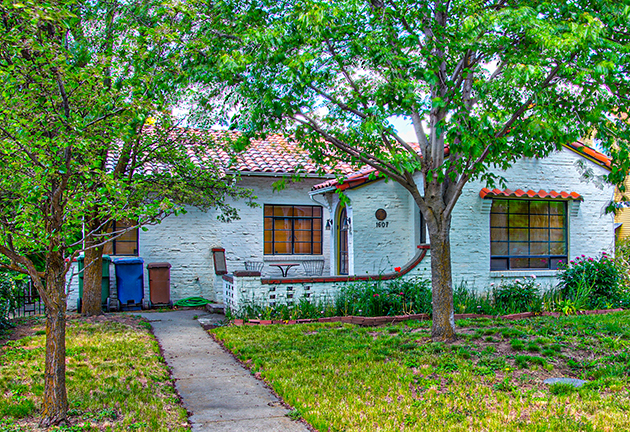
PhotoTitle: The Stanek-Perrenoud House
PhotoAttribution: Spokane City/County Historic Preservation Office
Listing Status: Spokane Register
URL: http://properties.historicspokane.org/property/?PropertyID=1949
Display Marker: large_yellow
Title: Stanek-Perrenoud House
Description: Date Built: 1938
Architect: Franklund W. Stanek Jr. (builder)
Common Name: Stanek-Perrenoud House
Reflecting an architectural style rarely seen in Spokane, the Stanek-Perrenoud House is an exceptional example of the Spanish Eclectic bungalow style popular in Florida and Southern California. The house was built in 1938 by owner Frank Stanek, Jr. as a show-home featuring products manufactured and produced by the Washington Brick, Lime and Sewer Pipe Company. In addition to his affiliation with the brickyard, Frank Stanek, Jr., together with his father and son, founded Stanek's Nurseries - Spokane's largest and most successful South Hill nursery. The Staneks also developed Lincoln Heights Shopping Center along East 29th Avenue in southern Spokane.
Location: 47.64104, -117.38665
Address: 1607 East 16th Avenue, Spokane WA 99203
PhotoURL:

PhotoTitle: The Stanek-Perrenoud House
PhotoAttribution: Spokane City/County Historic Preservation Office
Listing Status: Spokane Register
URL: http://properties.historicspokane.org/property/?PropertyID=1949
Display Marker: large_yellow
ID: 301
Title: Stimmel House
Description: Date Built: 1914
Architect: Clayton E. Feltis
Common Name: Harry & Evelyn Stimmel House
Built in 1914 during the height of the Arts & Crafts influence in America, the Harry & Evelyn Stimmel House is an excellent example of domestic bungalow architecture embellished in the Craftsman tradition. The Stimmel House was constructed by Spokane home designer/home builder, Clayon E. Feltis, who manifested his skills as an accomplished artisan through his personal artistic interpretation and purist approach to the Craftsman style. To date, a total of ten houses built in Spokane have been attributed to Feltis. In 1914, Harry A Stimmel and his wife, Evelyn, purchased the property. Stimmel, employed as a "toll engineer" at Pacific Telegraph & Telephone Company, owned the house until 1916.
Location: 47.63203, -117.42699
Address: 1009 West 24th Avenue, Spokane WA 99203
PhotoURL: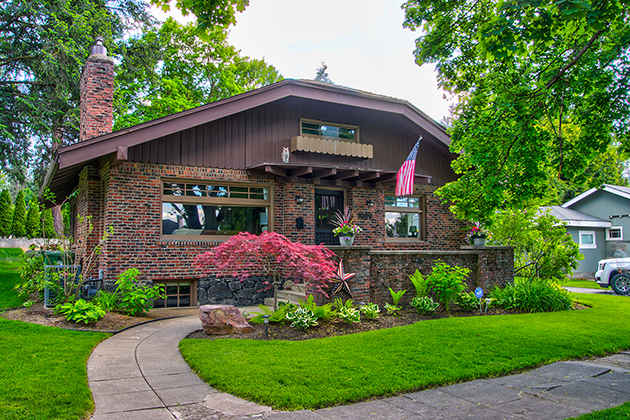
PhotoTitle: The Harry and Evelyn Stimmel House
PhotoAttribution: Spokane City/County Historic Preservation Office
Listing Status: Spokane Register
URL: http://properties.historicspokane.org/property/?PropertyID=1951
Display Marker: large_yellow
Title: Stimmel House
Description: Date Built: 1914
Architect: Clayton E. Feltis
Common Name: Harry & Evelyn Stimmel House
Built in 1914 during the height of the Arts & Crafts influence in America, the Harry & Evelyn Stimmel House is an excellent example of domestic bungalow architecture embellished in the Craftsman tradition. The Stimmel House was constructed by Spokane home designer/home builder, Clayon E. Feltis, who manifested his skills as an accomplished artisan through his personal artistic interpretation and purist approach to the Craftsman style. To date, a total of ten houses built in Spokane have been attributed to Feltis. In 1914, Harry A Stimmel and his wife, Evelyn, purchased the property. Stimmel, employed as a "toll engineer" at Pacific Telegraph & Telephone Company, owned the house until 1916.
Location: 47.63203, -117.42699
Address: 1009 West 24th Avenue, Spokane WA 99203
PhotoURL:

PhotoTitle: The Harry and Evelyn Stimmel House
PhotoAttribution: Spokane City/County Historic Preservation Office
Listing Status: Spokane Register
URL: http://properties.historicspokane.org/property/?PropertyID=1951
Display Marker: large_yellow
ID: 302
Title: Stone House
Description: Date Built: 1937
Architect: G. A. Pehrson
Common Name: Roy & Sylvia Stone House
The Roy & Sylvia Stone House is a fine example of the Regency Revival style. Well-preserved with few modifications, the Stone House is a two-story box with a hip roof and two attached lower wings, symmetrical fenestration patterns, and a prominent front entrance articulated with a paneled wood crown supported by square pilasters, a paneled wood front door, and leaded-glass transom and sidelights. The Stone House retains a high degree of exterior and architectural integrity in original location, design, materials, workmanship, and association as a single-family home built in the 1930s in Spokane.
Location: 47.63328, -117.39777
Address: 2325 South Garfield Road, Spokane WA 99203
PhotoURL: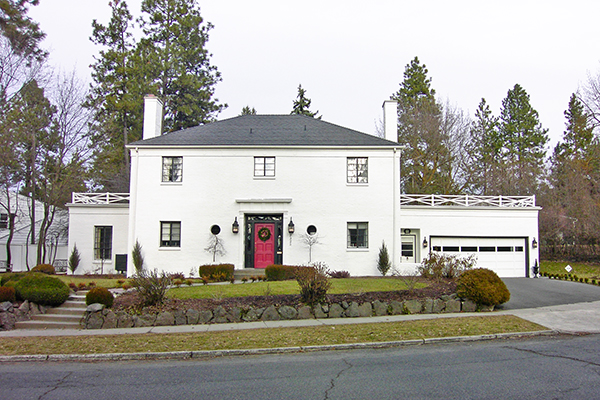
PhotoTitle: The Roy and Sylvia Stone House
PhotoAttribution: Spokane City/County Historic Preservation Office
Listing Status: Spokane Register, National Register
URL: http://properties.historicspokane.org/property/?PropertyID=2023
Display Marker: large_yellow
Title: Stone House
Description: Date Built: 1937
Architect: G. A. Pehrson
Common Name: Roy & Sylvia Stone House
The Roy & Sylvia Stone House is a fine example of the Regency Revival style. Well-preserved with few modifications, the Stone House is a two-story box with a hip roof and two attached lower wings, symmetrical fenestration patterns, and a prominent front entrance articulated with a paneled wood crown supported by square pilasters, a paneled wood front door, and leaded-glass transom and sidelights. The Stone House retains a high degree of exterior and architectural integrity in original location, design, materials, workmanship, and association as a single-family home built in the 1930s in Spokane.
Location: 47.63328, -117.39777
Address: 2325 South Garfield Road, Spokane WA 99203
PhotoURL:

PhotoTitle: The Roy and Sylvia Stone House
PhotoAttribution: Spokane City/County Historic Preservation Office
Listing Status: Spokane Register, National Register
URL: http://properties.historicspokane.org/property/?PropertyID=2023
Display Marker: large_yellow
ID: 303
Title: Strack House
Description: Date Built: 1907
Architect: John Strack
Common Name: John & Ida Strack House
Designed by John Strack in 1907, the home is an eclectic expression of the Colonial Revival style and is accentuated with architectural elements that reveal a mixture of influences from Queen Anne, Arts & Crafts, and Prairie traditions. John Strack was part owner of the Riblet & Strack Company. John, and his wife Ida, lived in the house until her death in 1911, after which John remarried Ella Williams and then divorced three years later. The house was then quit-claimed to Ella and subsequently sold in 1920. The Strack house is associated with the development of Liberty Park and the Liberty Place Addition and was one of the first homes built along East Fifth Avenue.
Location: 47.65138, -117.39228
Address: 1206 East 5th Avenue, Spokane WA 99202
PhotoURL: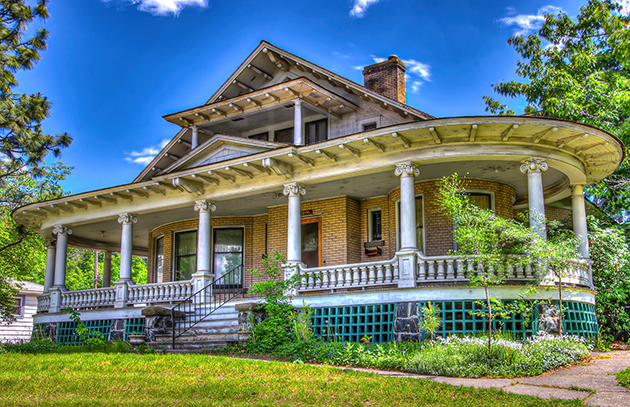
PhotoTitle: The John and Ida Strack House
PhotoAttribution: Spokane City/County Historic Preservation Office
Listing Status: Spokane Register
URL: http://properties.historicspokane.org/property/?PropertyID=1952
Display Marker: large_yellow
Title: Strack House
Description: Date Built: 1907
Architect: John Strack
Common Name: John & Ida Strack House
Designed by John Strack in 1907, the home is an eclectic expression of the Colonial Revival style and is accentuated with architectural elements that reveal a mixture of influences from Queen Anne, Arts & Crafts, and Prairie traditions. John Strack was part owner of the Riblet & Strack Company. John, and his wife Ida, lived in the house until her death in 1911, after which John remarried Ella Williams and then divorced three years later. The house was then quit-claimed to Ella and subsequently sold in 1920. The Strack house is associated with the development of Liberty Park and the Liberty Place Addition and was one of the first homes built along East Fifth Avenue.
Location: 47.65138, -117.39228
Address: 1206 East 5th Avenue, Spokane WA 99202
PhotoURL:

PhotoTitle: The John and Ida Strack House
PhotoAttribution: Spokane City/County Historic Preservation Office
Listing Status: Spokane Register
URL: http://properties.historicspokane.org/property/?PropertyID=1952
Display Marker: large_yellow
ID: 304
Title: Strahorn Pines (demolished)
Description: Date Built: 1887
Architect: J.J. Browne; Kirtland K. Cutter & Karl Malmgren (1900 remodel)
Common Name: Strahorn Pines (demolished)
The historic Strahorn Pines building was purchased by the Eastern Washington Historical Society in 1970, then demolished in 1974 to make way for expanded facilities and more parking. The existing structure at this address (the Museum of Arts and Culture Exhibition building) is not listed on a historic register. Constructed in 1887, this home was built and occupied by J.J. Browne and his family until 1900 when the house was purchased by Robert E. Strahorn and his wife Carrie Adell "Dell" Strahorn. The three-story building was then completely remodeled by architects K. Cutter and K. Malmgren into a twenty-room mansion with nine bathrooms and ten fireplaces. Said to be the first house in Spokane with steam heat, Strahorn Pines was said to also house a bowling lane. In 1929, the home and coach house were converted into eleven apartments, but a portion of the original decorations and furnishings were retained. First owned by J.J. Browne, Mr. and Mrs. Robert Strahorn purchased the home in 1900. Strahorn had been a writer covering the Sioux Wars in the Powder River Country. Eventually, Jay Gould hired Strahorn to publicize the benefits of the railroads and to promote westward expansion and settlement. Strahorn's booster job evolved into research into the placement of rail extensions. Strahorn was a key figure in the railroad development in Spokane and the Inland Empire. He single-handedly built the North Coast Railway, connecting Spokane with Portland and the coast. After a lifetime of fortunes won and lost, Robert Strahorn died in Spokane in 1944.
Location: 47.656955, -117.445510
Address: 2216 West 1st Avenue, Spokane WA 99201
PhotoURL:
PhotoTitle: The once-standing Strahorn Pines
PhotoAttribution: Spokane City/County Historic Preservation Office
Listing Status: N/A
URL: http://properties.historicspokane.org/property/?PropertyID=2017
Display Marker: large_yellow
Title: Strahorn Pines (demolished)
Description: Date Built: 1887
Architect: J.J. Browne; Kirtland K. Cutter & Karl Malmgren (1900 remodel)
Common Name: Strahorn Pines (demolished)
The historic Strahorn Pines building was purchased by the Eastern Washington Historical Society in 1970, then demolished in 1974 to make way for expanded facilities and more parking. The existing structure at this address (the Museum of Arts and Culture Exhibition building) is not listed on a historic register. Constructed in 1887, this home was built and occupied by J.J. Browne and his family until 1900 when the house was purchased by Robert E. Strahorn and his wife Carrie Adell "Dell" Strahorn. The three-story building was then completely remodeled by architects K. Cutter and K. Malmgren into a twenty-room mansion with nine bathrooms and ten fireplaces. Said to be the first house in Spokane with steam heat, Strahorn Pines was said to also house a bowling lane. In 1929, the home and coach house were converted into eleven apartments, but a portion of the original decorations and furnishings were retained. First owned by J.J. Browne, Mr. and Mrs. Robert Strahorn purchased the home in 1900. Strahorn had been a writer covering the Sioux Wars in the Powder River Country. Eventually, Jay Gould hired Strahorn to publicize the benefits of the railroads and to promote westward expansion and settlement. Strahorn's booster job evolved into research into the placement of rail extensions. Strahorn was a key figure in the railroad development in Spokane and the Inland Empire. He single-handedly built the North Coast Railway, connecting Spokane with Portland and the coast. After a lifetime of fortunes won and lost, Robert Strahorn died in Spokane in 1944.
Location: 47.656955, -117.445510
Address: 2216 West 1st Avenue, Spokane WA 99201
PhotoURL:

PhotoTitle: The once-standing Strahorn Pines
PhotoAttribution: Spokane City/County Historic Preservation Office
Listing Status: N/A
URL: http://properties.historicspokane.org/property/?PropertyID=2017
Display Marker: large_yellow
ID: 305
Title: Strong House
Description: Date Built: 1879
Architect: Unknown
Common Name: J.F. Strong House
Built in 1879 and expanded in 1900, the J. F. Strong House is one of the earliest and best preserved homes in North Spokane County. It is historically significant for its association with the first owner, J. F. Strong, the first successful settler in the Five Mile Prairie area. The Strong House was originally located on a 160 acre homestead, and is associated with the early settlement of Five Mile Prairie and the agricultural heritage of the area. It served as the Strong Family home for over thirty years. The Strong House retains a high degree of integrity and is one of the few houses on Five Mile Prairie built before the turn of the century.
Location: 47.736654, -117.440620
Address: 2015 West Strong Road, Spokane WA 99208
PhotoURL: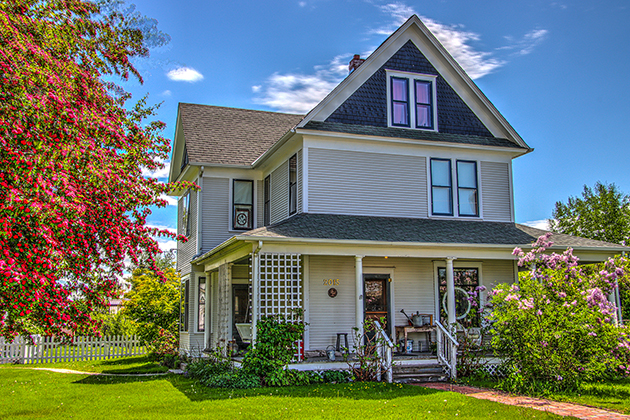
PhotoTitle: The J. F. Strong House
PhotoAttribution: Spokane City/County Historic Preservation Office
Listing Status: Spokane Register
URL: http://properties.historicspokane.org/property/?PropertyID=1953
Display Marker: large_yellow
Title: Strong House
Description: Date Built: 1879
Architect: Unknown
Common Name: J.F. Strong House
Built in 1879 and expanded in 1900, the J. F. Strong House is one of the earliest and best preserved homes in North Spokane County. It is historically significant for its association with the first owner, J. F. Strong, the first successful settler in the Five Mile Prairie area. The Strong House was originally located on a 160 acre homestead, and is associated with the early settlement of Five Mile Prairie and the agricultural heritage of the area. It served as the Strong Family home for over thirty years. The Strong House retains a high degree of integrity and is one of the few houses on Five Mile Prairie built before the turn of the century.
Location: 47.736654, -117.440620
Address: 2015 West Strong Road, Spokane WA 99208
PhotoURL:

PhotoTitle: The J. F. Strong House
PhotoAttribution: Spokane City/County Historic Preservation Office
Listing Status: Spokane Register
URL: http://properties.historicspokane.org/property/?PropertyID=1953
Display Marker: large_yellow
ID: 306
Title: Sunset Boulevard Bridge
Description: Date Built: 1911
Architect: Morton McCartney/ J.F. Cunningham (builder)
Common Name: Latah Creek Bridge
The Latah Creek Bridge, construction of which began in 1911, was Spokane's second monumental concrete arch bridge, spanning 1,070 feet with seven semi-circular arch spans 128 to 150 feet across. While the Monroe Street Bridge consists of a flattened central arch, the Latah Creek Bridge is composed of a series of Roman or semi-circular arches. As is evident in the many similarities between the two bridges, many of the people who were responsible for the design and construction of the Monroe Street Bridge were also responsible for the design and construction of the Latah Creek Bridge. Like the Monroe Street Bridge, the Latah Creek Bridge is an early example within the state of a long-span fixed-end arch. Although the semi-circular arches of the bridge were reminiscent of an earlier age of concrete and masonry arch construction, the steel reinforcement of the concrete structure pointed towards the future in concrete arch design.
Location: 47.649960, -117.447149
Address: 2300 West Sunset Boulevard, Spokane WA 99201
PhotoURL: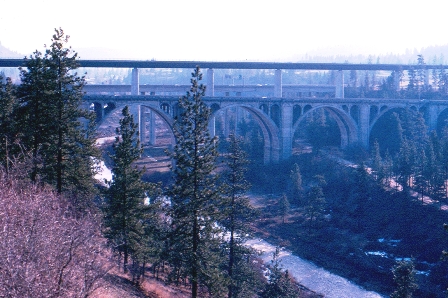
PhotoTitle: The Sunset Boulevard Bridge
PhotoAttribution: Spokane City/County Historic Preservation Office
Listing Status: National Register
URL: http://properties.historicspokane.org/property/?PropertyID=2018
Display Marker: large_yellow
Title: Sunset Boulevard Bridge
Description: Date Built: 1911
Architect: Morton McCartney/ J.F. Cunningham (builder)
Common Name: Latah Creek Bridge
The Latah Creek Bridge, construction of which began in 1911, was Spokane's second monumental concrete arch bridge, spanning 1,070 feet with seven semi-circular arch spans 128 to 150 feet across. While the Monroe Street Bridge consists of a flattened central arch, the Latah Creek Bridge is composed of a series of Roman or semi-circular arches. As is evident in the many similarities between the two bridges, many of the people who were responsible for the design and construction of the Monroe Street Bridge were also responsible for the design and construction of the Latah Creek Bridge. Like the Monroe Street Bridge, the Latah Creek Bridge is an early example within the state of a long-span fixed-end arch. Although the semi-circular arches of the bridge were reminiscent of an earlier age of concrete and masonry arch construction, the steel reinforcement of the concrete structure pointed towards the future in concrete arch design.
Location: 47.649960, -117.447149
Address: 2300 West Sunset Boulevard, Spokane WA 99201
PhotoURL:

PhotoTitle: The Sunset Boulevard Bridge
PhotoAttribution: Spokane City/County Historic Preservation Office
Listing Status: National Register
URL: http://properties.historicspokane.org/property/?PropertyID=2018
Display Marker: large_yellow
ID: 307
Title: Swanson House
Description: Date Built: 1922
Architect: Unknown
Common Name: Emil and Martha Swanson House
Originally located in the East Central neighborhood of Spokane, the Swanson House is an outstanding example of the high-style Craftsman bungalow. Classic Craftsman design can be seen in the eaves treatment, window composition, front porch and battered wood posts on massive brick piers. The house was constructed in 1922 for Emil D. Swanson, a superintendent for the White Pine and Sash Company, and his wife, Martha V. In 2006 the Swanson House was relocated from its original location at 3720 E Second Avenue in Spokane to its current location at 4912 E Ninth Avenue in Spokane Valley. Due to this loss of integrity of location, the house is not listed on the Spokane Register of Historic Places.
Location: 47.654512, -117.355363
Address: 3720 East 2nd Avenue, Spokane WA 99202
PhotoURL:
PhotoTitle: The Emil and Martha Swanson House
PhotoAttribution: Spokane City/County Historic Preservation Office
Listing Status: N/A
URL: http://properties.historicspokane.org/property/?PropertyID=2066
Display Marker: large_yellow
Title: Swanson House
Description: Date Built: 1922
Architect: Unknown
Common Name: Emil and Martha Swanson House
Originally located in the East Central neighborhood of Spokane, the Swanson House is an outstanding example of the high-style Craftsman bungalow. Classic Craftsman design can be seen in the eaves treatment, window composition, front porch and battered wood posts on massive brick piers. The house was constructed in 1922 for Emil D. Swanson, a superintendent for the White Pine and Sash Company, and his wife, Martha V. In 2006 the Swanson House was relocated from its original location at 3720 E Second Avenue in Spokane to its current location at 4912 E Ninth Avenue in Spokane Valley. Due to this loss of integrity of location, the house is not listed on the Spokane Register of Historic Places.
Location: 47.654512, -117.355363
Address: 3720 East 2nd Avenue, Spokane WA 99202
PhotoURL:

PhotoTitle: The Emil and Martha Swanson House
PhotoAttribution: Spokane City/County Historic Preservation Office
Listing Status: N/A
URL: http://properties.historicspokane.org/property/?PropertyID=2066
Display Marker: large_yellow
ID: 308
Title: Symons Block
Description: Date Built: 1917
Architect: Rigg & Van Tyne
Common Name: Symons Block
Built in 1917-1918, the Symons Block is architecturally important because it reflects the attention to style and investment in quality materials and construction that were still attributes of Spokane's commercial architecture following the city's greatest era of expansion and development. The highly-regarded architectural team of Archibald Rigg and Roland Van Tyne, known for several Spokane landmarks, designed it. It is also important for its association with pioneer Spokane business investor Colonel Thomas W. Symons and his son, who helped bring broadcast radio to the Northwest. For many years the home to Spokane's first radio station, the building is historically significant for its association with the development of the area's local and national broadcasting media. An integral part of Spokane's business community, the Symons Building also has street-level spaces that have housed some of Spokane's best-known businesses.
Location: 47.65689, -117.42071
Address: 525 West Sprague Avenue, Spokane WA 99201
PhotoURL: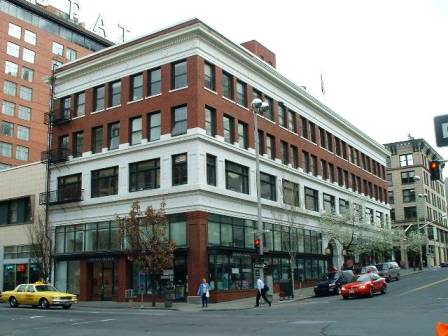
PhotoTitle: The Symons Block
PhotoAttribution: Spokane City/County Historic Preservation Office
Listing Status: Spokane Register
URL: http://properties.historicspokane.org/property/?PropertyID=1954
Display Marker: large_yellow
Title: Symons Block
Description: Date Built: 1917
Architect: Rigg & Van Tyne
Common Name: Symons Block
Built in 1917-1918, the Symons Block is architecturally important because it reflects the attention to style and investment in quality materials and construction that were still attributes of Spokane's commercial architecture following the city's greatest era of expansion and development. The highly-regarded architectural team of Archibald Rigg and Roland Van Tyne, known for several Spokane landmarks, designed it. It is also important for its association with pioneer Spokane business investor Colonel Thomas W. Symons and his son, who helped bring broadcast radio to the Northwest. For many years the home to Spokane's first radio station, the building is historically significant for its association with the development of the area's local and national broadcasting media. An integral part of Spokane's business community, the Symons Building also has street-level spaces that have housed some of Spokane's best-known businesses.
Location: 47.65689, -117.42071
Address: 525 West Sprague Avenue, Spokane WA 99201
PhotoURL:

PhotoTitle: The Symons Block
PhotoAttribution: Spokane City/County Historic Preservation Office
Listing Status: Spokane Register
URL: http://properties.historicspokane.org/property/?PropertyID=1954
Display Marker: large_yellow
ID: 309
Title: Taber-Ott House
Description: Date Built: 1910
Architect: W.W. Hyslop
Common Name: Tabor-Ott House
Reflecting the influence of the popular turn-of-the-century Craftsman style, the Taber-Ott residence is also significant for its historical associations with architect W. W. Hyslop, who practiced in Spokane between ca. 1900 and 1917. The house, completed in 1911, was designed for E. G. Taber, the chief engineer for the Spokane International Railway company from 1907 to 1940. In addition to its association with Taber's significant role in the development of the Inland Empire, the residence is also noted for its associations with Anna Stratton Browne, widow of Spokane founder J. J. Browne and Taber's second wife, and with Margie May Ott, renowned pianist and musical instructor. Franklin and Margie May Ott acquired the home a few years after E. G. Taber's death in 1946, and remained for nearly forty years.
Location: 47.6375, -117.39953
Address: 1910 South Upper Terrace Road, Spokane WA 99203
PhotoURL: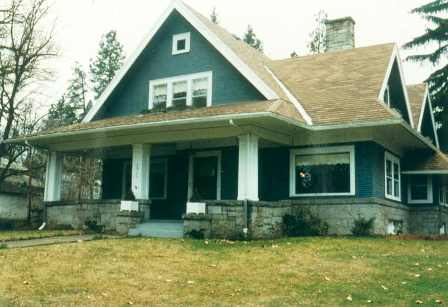
PhotoTitle: The Taber-Ott House
PhotoAttribution: Spokane City/County Historic Preservation Office
Listing Status: Spokane Register, National Register
URL: http://properties.historicspokane.org/property/?PropertyID=1955
Display Marker: large_yellow
Title: Taber-Ott House
Description: Date Built: 1910
Architect: W.W. Hyslop
Common Name: Tabor-Ott House
Reflecting the influence of the popular turn-of-the-century Craftsman style, the Taber-Ott residence is also significant for its historical associations with architect W. W. Hyslop, who practiced in Spokane between ca. 1900 and 1917. The house, completed in 1911, was designed for E. G. Taber, the chief engineer for the Spokane International Railway company from 1907 to 1940. In addition to its association with Taber's significant role in the development of the Inland Empire, the residence is also noted for its associations with Anna Stratton Browne, widow of Spokane founder J. J. Browne and Taber's second wife, and with Margie May Ott, renowned pianist and musical instructor. Franklin and Margie May Ott acquired the home a few years after E. G. Taber's death in 1946, and remained for nearly forty years.
Location: 47.6375, -117.39953
Address: 1910 South Upper Terrace Road, Spokane WA 99203
PhotoURL:

PhotoTitle: The Taber-Ott House
PhotoAttribution: Spokane City/County Historic Preservation Office
Listing Status: Spokane Register, National Register
URL: http://properties.historicspokane.org/property/?PropertyID=1955
Display Marker: large_yellow
ID: 310
Title: Taylor House
Description: Date Built: 1905
Architect: George W. Taylor
Common Name: George and Annie Taylor House
Spokane carpenter and building contractor George W. Taylor constructed the Taylor House in 1905 in the Emerson-Garfield neighborhood in Muzzy's Addition on real estate speculation. After a short two-year stay, George Taylor and his wife, Annie Taylor, sold the house for $1,400 and moved away from Spokane. The Taylor House was subseqnetly owned by a number of residents representing a variety of specialties, from telephone/telegraph operators, tailors, real estate & insurance agents, waitress and bartender, to clerks, businessmen, teacher/professor, and professional medical technicians. The Taylor House retains excellent architectural integrity in original location, design, materials, workmanship, and association as a Neoclassical-style single-family residence built in Spokane in 1905.
Location: 47.67555, -117.44265
Address: 2027 West Shannon Avenue, Spokane WA 99205
PhotoURL: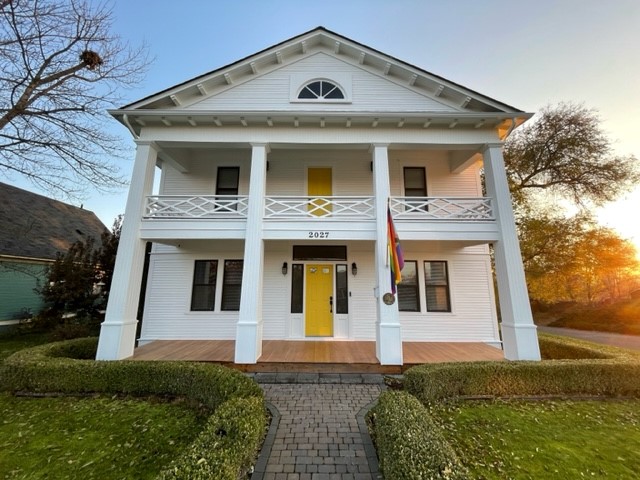
PhotoTitle: The George and Annie Taylor House
PhotoAttribution: Spokane City/County Historic Preservation Office
Listing Status: Spokane Register
URL: http://properties.historicspokane.org/property/?PropertyID=2043
Display Marker: large_yellow
Title: Taylor House
Description: Date Built: 1905
Architect: George W. Taylor
Common Name: George and Annie Taylor House
Spokane carpenter and building contractor George W. Taylor constructed the Taylor House in 1905 in the Emerson-Garfield neighborhood in Muzzy's Addition on real estate speculation. After a short two-year stay, George Taylor and his wife, Annie Taylor, sold the house for $1,400 and moved away from Spokane. The Taylor House was subseqnetly owned by a number of residents representing a variety of specialties, from telephone/telegraph operators, tailors, real estate & insurance agents, waitress and bartender, to clerks, businessmen, teacher/professor, and professional medical technicians. The Taylor House retains excellent architectural integrity in original location, design, materials, workmanship, and association as a Neoclassical-style single-family residence built in Spokane in 1905.
Location: 47.67555, -117.44265
Address: 2027 West Shannon Avenue, Spokane WA 99205
PhotoURL:

PhotoTitle: The George and Annie Taylor House
PhotoAttribution: Spokane City/County Historic Preservation Office
Listing Status: Spokane Register
URL: http://properties.historicspokane.org/property/?PropertyID=2043
Display Marker: large_yellow
ID: 311
Title: Tebben House
Description: Date Built: 1910
Architect: Unknown
Common Name: Frederick and Minnie Tebben House
Built in 1910 and 1916 respectively, the Frederick & Minnie Tebben House and garage are fine examples of the Arts & Crafts tradition and most particularly, the Craftsman style, revealing methods of early twentieth-century building practices and construction materials. The woodwork and many built-ins and made of the finest quality quarter-sawn oak which, over time, have burnished to a rich dark amber color. The house and garage are products of residential urban growth in Spokane during the early 1900s and of real estate developer Harl J. Cook's planned development in the Marycliff-Cliff Park District on Spokane's South Hill. The Tebben House and garage were built for Frederick & Minnie Tebben, owners and proprietors of the Tebben Lambdin Company and insurance agents for the Standard Fire Insurance Company in the Hyde Block in downtown Spokane.
Location: 47.64381, -117.42014
Address: 524 West 13th Avenue, Spokane WA 99204
PhotoURL:
PhotoTitle: The Frederick and Minnie Tebben House
PhotoAttribution: Spokane City/County Historic Preservation Office
Listing Status: Spokane Register
URL: http://properties.historicspokane.org/property/?PropertyID=1956
Display Marker: large_yellow
Title: Tebben House
Description: Date Built: 1910
Architect: Unknown
Common Name: Frederick and Minnie Tebben House
Built in 1910 and 1916 respectively, the Frederick & Minnie Tebben House and garage are fine examples of the Arts & Crafts tradition and most particularly, the Craftsman style, revealing methods of early twentieth-century building practices and construction materials. The woodwork and many built-ins and made of the finest quality quarter-sawn oak which, over time, have burnished to a rich dark amber color. The house and garage are products of residential urban growth in Spokane during the early 1900s and of real estate developer Harl J. Cook's planned development in the Marycliff-Cliff Park District on Spokane's South Hill. The Tebben House and garage were built for Frederick & Minnie Tebben, owners and proprietors of the Tebben Lambdin Company and insurance agents for the Standard Fire Insurance Company in the Hyde Block in downtown Spokane.
Location: 47.64381, -117.42014
Address: 524 West 13th Avenue, Spokane WA 99204
PhotoURL:

PhotoTitle: The Frederick and Minnie Tebben House
PhotoAttribution: Spokane City/County Historic Preservation Office
Listing Status: Spokane Register
URL: http://properties.historicspokane.org/property/?PropertyID=1956
Display Marker: large_yellow
ID: 312
Title: Thomas House on Nora
Description: Date Built: 1902
Architect: Unknown/John Hunz
Common Name: Dr. Charles and Elsie Thomas House
Dr. Charles & Elsie Thomas bought the house the year it was built in 1902. Dr. Thomas practiced medicine in Spokane with offices in the Fernwell Building in downtown Spokane and as a surgeon at St. Luke's Hospital (now Ogden Hall). The Thomas House is a fine example of the Free Classic Queen Anne style and retains a high degree of exterior integrity in original location, design, materials, workmanship, and association as a prominent single-family home built in 1902 in Spokane.
Location: 47.67424, -117.40172
Address: 527 East Nora Avenue, Spokane WA 99207
PhotoURL: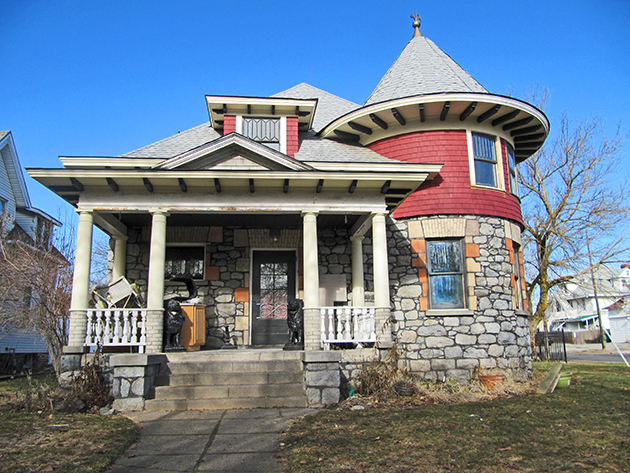
PhotoTitle: The Dr. Charles and Elsie Thomas House on Nora Avenue
PhotoAttribution: Spokane City/County Historic Preservation Office
Listing Status: Spokane Register
URL: http://properties.historicspokane.org/property/?PropertyID=2041
Display Marker: large_yellow
Title: Thomas House on Nora
Description: Date Built: 1902
Architect: Unknown/John Hunz
Common Name: Dr. Charles and Elsie Thomas House
Dr. Charles & Elsie Thomas bought the house the year it was built in 1902. Dr. Thomas practiced medicine in Spokane with offices in the Fernwell Building in downtown Spokane and as a surgeon at St. Luke's Hospital (now Ogden Hall). The Thomas House is a fine example of the Free Classic Queen Anne style and retains a high degree of exterior integrity in original location, design, materials, workmanship, and association as a prominent single-family home built in 1902 in Spokane.
Location: 47.67424, -117.40172
Address: 527 East Nora Avenue, Spokane WA 99207
PhotoURL:

PhotoTitle: The Dr. Charles and Elsie Thomas House on Nora Avenue
PhotoAttribution: Spokane City/County Historic Preservation Office
Listing Status: Spokane Register
URL: http://properties.historicspokane.org/property/?PropertyID=2041
Display Marker: large_yellow
ID: 313
Title: Thomas House on Summit
Description: Date Built: 1907
Architect:Cutter & Malmgren Common Name: Charles & Elsie Thomas House
The Thomas House and garage were built in 1907 in the Sherwood Addition neighborhood in northwest Spokane. They are excellent examples of the Mission Revival style and were erected for prominent Spokane physician and surgeon, Dr. Charles Thomas, and his wife, Elsie Thomas. Located on the bluff at Summit Boulevard with a breathtaking view of the meandering Spokane River and timbered hillsides along the river's west bank, the property was custom-designed by Cutter & Malmgren, one of Spokane's most celebrated architectural firms. Construction of the Thomas House was foretold in a February 6, 1905 feature in the Spokane-Review newspaper. The article reported that Dr. Thomas and his wife "will build a $30,000 residence of brick and stone, and there will be a large lodge for automobiles." The article further indicated that Dr. Thomas selected the site not only because of its delightful view, but because of its convenience to St. Luke's Hospital. Especially during its period of significance, 1907-1956, the Thomas House achieved historic significance in the context of community design & development as one of the largest homes built in the Sherwood Addition and as a tangible expression of the prominent urban development and settlement that occurred in the area, especially along the bluff's edge at Summit Boulevard.
Location: 47.66834, -117.45768
Address: 1212 North Summit Boulevard, Spokane WA 99201
PhotoURL: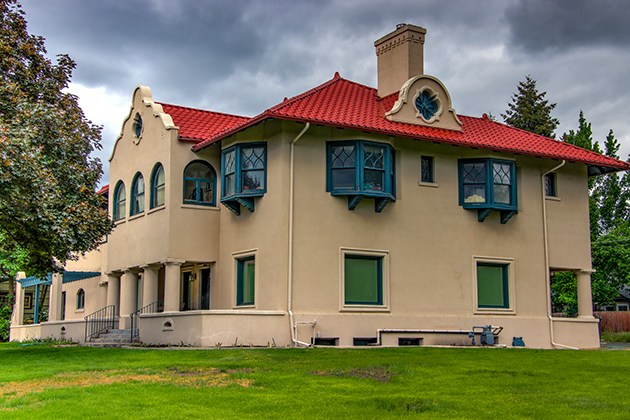
PhotoTitle: The Dr. Charles and Elsie Thomas House on Summit Boulevard
PhotoAttribution: Spokane City/County Historic Preservation Office
Listing Status: Spokane Register, National Register
URL: http://properties.historicspokane.org/property/?PropertyID=1957
Display Marker: large_yellow
Title: Thomas House on Summit
Description: Date Built: 1907
Architect:Cutter & Malmgren Common Name: Charles & Elsie Thomas House
The Thomas House and garage were built in 1907 in the Sherwood Addition neighborhood in northwest Spokane. They are excellent examples of the Mission Revival style and were erected for prominent Spokane physician and surgeon, Dr. Charles Thomas, and his wife, Elsie Thomas. Located on the bluff at Summit Boulevard with a breathtaking view of the meandering Spokane River and timbered hillsides along the river's west bank, the property was custom-designed by Cutter & Malmgren, one of Spokane's most celebrated architectural firms. Construction of the Thomas House was foretold in a February 6, 1905 feature in the Spokane-Review newspaper. The article reported that Dr. Thomas and his wife "will build a $30,000 residence of brick and stone, and there will be a large lodge for automobiles." The article further indicated that Dr. Thomas selected the site not only because of its delightful view, but because of its convenience to St. Luke's Hospital. Especially during its period of significance, 1907-1956, the Thomas House achieved historic significance in the context of community design & development as one of the largest homes built in the Sherwood Addition and as a tangible expression of the prominent urban development and settlement that occurred in the area, especially along the bluff's edge at Summit Boulevard.
Location: 47.66834, -117.45768
Address: 1212 North Summit Boulevard, Spokane WA 99201
PhotoURL:

PhotoTitle: The Dr. Charles and Elsie Thomas House on Summit Boulevard
PhotoAttribution: Spokane City/County Historic Preservation Office
Listing Status: Spokane Register, National Register
URL: http://properties.historicspokane.org/property/?PropertyID=1957
Display Marker: large_yellow
ID: 314
Title: Transient Hotel
Description: Date Built: 1904
Architect: C. Ferris White/McVay Builders
Common Name: Minnesota Building
The Transient Hotel is significant for its association with the unprecedented population and construction booms that occurred in Spokane in the first decade of the twentieth century. During that time investors erected Single Room Occupancy hotels (SRO) on nearly every block of the city's central business district to accommodate the waves of itinerant laborers who flocked to Spokane for jobs in the region's mining, lumber, agricultural, railroad, and other economic sectors. One such investor was William McVay, the contractor who erected the Transient in 1904. McVay worked from plans drawn by architect C. Ferris White. While the Transient reflects the typical SRO in its configuration, with commercial spaces on the ground floor and single room occupancy residential spaces above, it is atypical in its size--most SROs tended to be considerably larger, with three or four stories and a "U" or "W" shaped footprint, making maximum use of all available space.
Location: 47.65633, -117.41898
Address: 423 West 1st Avenue, Spokane WA 99201
PhotoURL: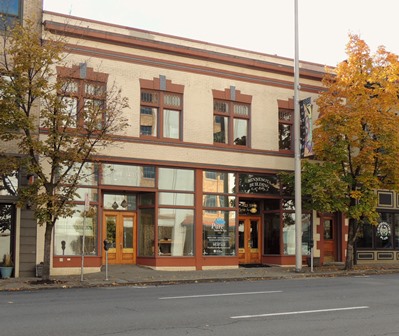
PhotoTitle: The Transient Hotel
PhotoAttribution: Spokane City/County Historic Preservation Office
Listing Status: Spokane Register
URL: http://properties.historicspokane.org/property/?PropertyID=1958
Display Marker: large_yellow
Title: Transient Hotel
Description: Date Built: 1904
Architect: C. Ferris White/McVay Builders
Common Name: Minnesota Building
The Transient Hotel is significant for its association with the unprecedented population and construction booms that occurred in Spokane in the first decade of the twentieth century. During that time investors erected Single Room Occupancy hotels (SRO) on nearly every block of the city's central business district to accommodate the waves of itinerant laborers who flocked to Spokane for jobs in the region's mining, lumber, agricultural, railroad, and other economic sectors. One such investor was William McVay, the contractor who erected the Transient in 1904. McVay worked from plans drawn by architect C. Ferris White. While the Transient reflects the typical SRO in its configuration, with commercial spaces on the ground floor and single room occupancy residential spaces above, it is atypical in its size--most SROs tended to be considerably larger, with three or four stories and a "U" or "W" shaped footprint, making maximum use of all available space.
Location: 47.65633, -117.41898
Address: 423 West 1st Avenue, Spokane WA 99201
PhotoURL:

PhotoTitle: The Transient Hotel
PhotoAttribution: Spokane City/County Historic Preservation Office
Listing Status: Spokane Register
URL: http://properties.historicspokane.org/property/?PropertyID=1958
Display Marker: large_yellow
ID: 315
Title: Trumbull-White House
Description: Date Built: 1924
Architect:Unknown/George Bottler Common Name: Trumbull-White House
The well-preserved Trumbull-White House was built in 1924 and is a quintessential expression of the Colonial Revival style dominant in American residential architecture from 1880 to 1955. The house was constructed by Spokane contractor George Bottler for Pearl and Willard Trumbull, one of the city's pioneer automobile dealers. Pearl Trumbull helped establish state and local garden societies and is credited with helping to create the Lilac Parade and naming Spokane the "Lilac City." The Trumbull-White House was also home to another significant Spokane woman, Dr. Elizabeth White - one of Spokane's first female physicians. Dr. White was the first female president of the Deaconess Hospital Medical Staff and one of six female doctors practicing in Spokane when she bought the house. A leader in medical and civic affairs, White was active in the Chamber of Commerce, the Social Hygiene Association, and the advisory council for the Spokane Chapter of the Girl Scouts of America.
Location: 47.64364, -117.40098
Address: 617 East 13th Avenue, Spokane WA 99202
PhotoURL:
PhotoTitle: The Trumbull-White House
PhotoAttribution: Spokane City/County Historic Preservation Office
Listing Status: Spokane Register
URL: http://properties.historicspokane.org/property/?PropertyID=1959
Display Marker: large_yellow
Title: Trumbull-White House
Description: Date Built: 1924
Architect:Unknown/George Bottler Common Name: Trumbull-White House
The well-preserved Trumbull-White House was built in 1924 and is a quintessential expression of the Colonial Revival style dominant in American residential architecture from 1880 to 1955. The house was constructed by Spokane contractor George Bottler for Pearl and Willard Trumbull, one of the city's pioneer automobile dealers. Pearl Trumbull helped establish state and local garden societies and is credited with helping to create the Lilac Parade and naming Spokane the "Lilac City." The Trumbull-White House was also home to another significant Spokane woman, Dr. Elizabeth White - one of Spokane's first female physicians. Dr. White was the first female president of the Deaconess Hospital Medical Staff and one of six female doctors practicing in Spokane when she bought the house. A leader in medical and civic affairs, White was active in the Chamber of Commerce, the Social Hygiene Association, and the advisory council for the Spokane Chapter of the Girl Scouts of America.
Location: 47.64364, -117.40098
Address: 617 East 13th Avenue, Spokane WA 99202
PhotoURL:

PhotoTitle: The Trumbull-White House
PhotoAttribution: Spokane City/County Historic Preservation Office
Listing Status: Spokane Register
URL: http://properties.historicspokane.org/property/?PropertyID=1959
Display Marker: large_yellow
ID: 316
Title: Tuell House
Description: Date Built: 1911
Architect: William J. Ballard, Ballard Plannery/Thomas & Jordan General Contractors
Common Name: Frank & Maude Tuell House
Built in 1912, the Tuell House is a hallmark example of the Craftsman style bungalow. It was designed by William J. Ballard, founder of the Ballard Plannary Company, a prominent Spokane architectural firm. Featured in several newspaper articles in 1912 and 1913, the house was described as "artistic and beautiful," built in the California design. Regarded as contemporary and modern for its time, the home was constructed as a "spec house" by Spokane carpenters and building contractors, Thomas & Jordan, and was reported to cost between $5,500 and $8,000. The property was purchased before it was completed by Spokane pharmacist, Frank Tuell and his wife, Maude Tuell, who made it their home for 17 years. During its period of significance from 1912 to 1929, the property achieved importance as a product of accomplished architect, William Ballard, and as an example of the type and quality of dwelling specifically planned and prescribed through neighborhood design covenants for the Cannon Hill Park Addition.
Location: 47.63474, -117.4174
Address: 416 West 22nd Avenue, Spokane WA 99203
PhotoURL: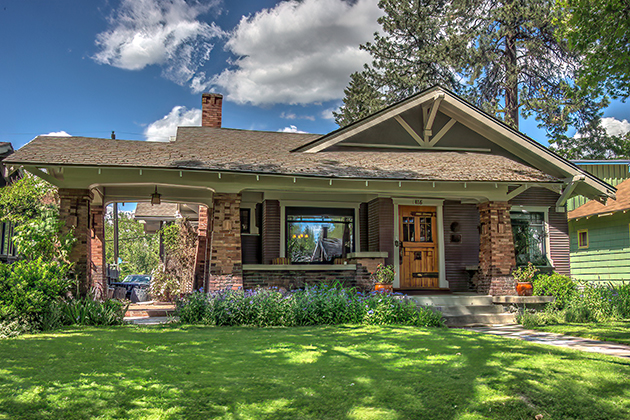
PhotoTitle: The Frank and Maude Tuell House
PhotoAttribution: Spokane City/County Historic Preservation Office
Listing Status: Spokane Register, National Register
URL: http://properties.historicspokane.org/property/?PropertyID=1960
Display Marker: large_yellow
Title: Tuell House
Description: Date Built: 1911
Architect: William J. Ballard, Ballard Plannery/Thomas & Jordan General Contractors
Common Name: Frank & Maude Tuell House
Built in 1912, the Tuell House is a hallmark example of the Craftsman style bungalow. It was designed by William J. Ballard, founder of the Ballard Plannary Company, a prominent Spokane architectural firm. Featured in several newspaper articles in 1912 and 1913, the house was described as "artistic and beautiful," built in the California design. Regarded as contemporary and modern for its time, the home was constructed as a "spec house" by Spokane carpenters and building contractors, Thomas & Jordan, and was reported to cost between $5,500 and $8,000. The property was purchased before it was completed by Spokane pharmacist, Frank Tuell and his wife, Maude Tuell, who made it their home for 17 years. During its period of significance from 1912 to 1929, the property achieved importance as a product of accomplished architect, William Ballard, and as an example of the type and quality of dwelling specifically planned and prescribed through neighborhood design covenants for the Cannon Hill Park Addition.
Location: 47.63474, -117.4174
Address: 416 West 22nd Avenue, Spokane WA 99203
PhotoURL:

PhotoTitle: The Frank and Maude Tuell House
PhotoAttribution: Spokane City/County Historic Preservation Office
Listing Status: Spokane Register, National Register
URL: http://properties.historicspokane.org/property/?PropertyID=1960
Display Marker: large_yellow
ID: 317
Title: J. W. Turner House
Description: Date Built: 1911
Architect: Carl Jabelonsky
Common Name: J.W. Turner House
The J. W. Turner House, located in the Rockwood Historic District, is an excellent example of a Tudor Revival Craftsman style home as seen if the half-timbering, basalt foundation and flared gables. John E. Anderson, who built many of the homes in the District, commissioned noted Spokane architect, Carl Jabelonsky, to design the house. The house is also significant for its association with several prominent Spokane businessmen. The first owner of the home, J. W. Turner, was an early Spokane refrigeration pioneer and merchant. Subsequent owners include Edgar Van Brundt, treasurer for the Washington Brick, Lime, and Sewer Pipe Company, and Peter Murphy who was prominent in the regional livestock industry.
Location: 47.6436, -117.40307
Address: 527 East Rockwood Boulevard, Spokane WA 99202
PhotoURL: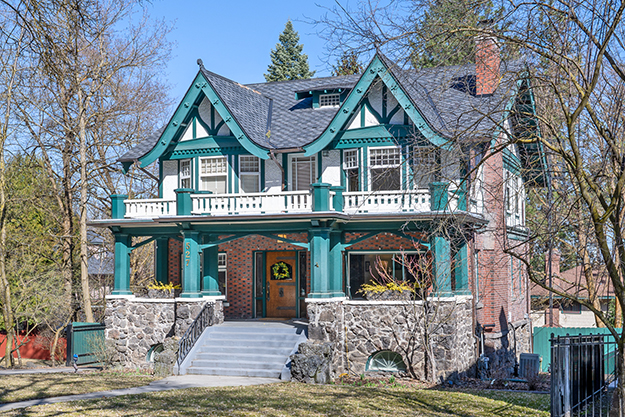
PhotoTitle: The J. W. Turner House
PhotoAttribution: Spokane City/County Historic Preservation Office
Listing Status: Spokane Register, National Register
URL: http://properties.historicspokane.org/property/?PropertyID=1961
Display Marker: large_yellow
Title: J. W. Turner House
Description: Date Built: 1911
Architect: Carl Jabelonsky
Common Name: J.W. Turner House
The J. W. Turner House, located in the Rockwood Historic District, is an excellent example of a Tudor Revival Craftsman style home as seen if the half-timbering, basalt foundation and flared gables. John E. Anderson, who built many of the homes in the District, commissioned noted Spokane architect, Carl Jabelonsky, to design the house. The house is also significant for its association with several prominent Spokane businessmen. The first owner of the home, J. W. Turner, was an early Spokane refrigeration pioneer and merchant. Subsequent owners include Edgar Van Brundt, treasurer for the Washington Brick, Lime, and Sewer Pipe Company, and Peter Murphy who was prominent in the regional livestock industry.
Location: 47.6436, -117.40307
Address: 527 East Rockwood Boulevard, Spokane WA 99202
PhotoURL:

PhotoTitle: The J. W. Turner House
PhotoAttribution: Spokane City/County Historic Preservation Office
Listing Status: Spokane Register, National Register
URL: http://properties.historicspokane.org/property/?PropertyID=1961
Display Marker: large_yellow
ID: 318
Title: Luther and Jane Turner House
Description: Date Built: 1916
Architect: John R. Burrill
Common Name: Luther and Jane Turner House
Built in 1916, the Turner House once occupied an entire city block, but now occupies about half of that space, sharing the block with the modern Loganhurst Care Center. The Luther P. Turner House is historically significant as an excellent, and largely intact, Spokane example of the Neoclassical architectural style, and for its association with the Luther P. Turner family, early settlers of the Inland Northwest who made their fortune growing wheat on the rolling Palouse hills west of Spokane. Luther and his wife later became prominent Spokane socialites. Following Mr. Turner's death, the building served as a nursing home for elderly residents until its recent closure.
Location: 47.67935, -117.38667
Address: 1521 East Illinois Avenue, Spokane WA 99207
PhotoURL: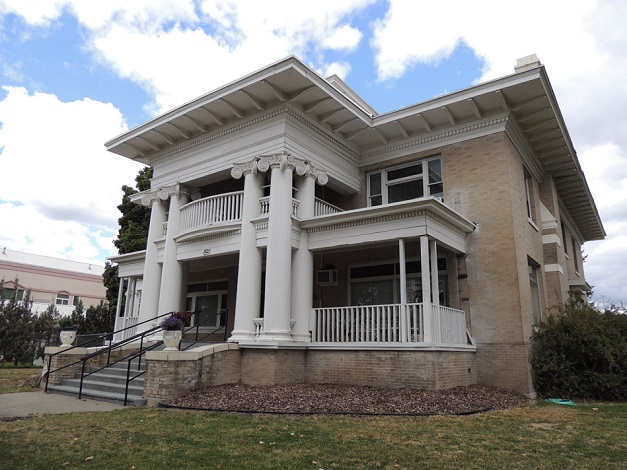
PhotoTitle: The Luther and Jane Turner House
PhotoAttribution: Spokane City/County Historic Preservation Office
Listing Status: Spokane Register, National Register
URL: http://properties.historicspokane.org/property/?PropertyID=1962
Display Marker: large_yellow
Title: Luther and Jane Turner House
Description: Date Built: 1916
Architect: John R. Burrill
Common Name: Luther and Jane Turner House
Built in 1916, the Turner House once occupied an entire city block, but now occupies about half of that space, sharing the block with the modern Loganhurst Care Center. The Luther P. Turner House is historically significant as an excellent, and largely intact, Spokane example of the Neoclassical architectural style, and for its association with the Luther P. Turner family, early settlers of the Inland Northwest who made their fortune growing wheat on the rolling Palouse hills west of Spokane. Luther and his wife later became prominent Spokane socialites. Following Mr. Turner's death, the building served as a nursing home for elderly residents until its recent closure.
Location: 47.67935, -117.38667
Address: 1521 East Illinois Avenue, Spokane WA 99207
PhotoURL:

PhotoTitle: The Luther and Jane Turner House
PhotoAttribution: Spokane City/County Historic Preservation Office
Listing Status: Spokane Register, National Register
URL: http://properties.historicspokane.org/property/?PropertyID=1962
Display Marker: large_yellow
ID: 319
Title: US Post Office
Description: Date Built: 1908
Architect: James Knox Taylor (1908), Louis A. Simon (1941 addition)
Common Name: U.S. Post Office
The U.S. Post Office was designed in the office of the Supervising Architect of the Treasury Department by James Knox Taylor in 1906-07, and reflects the prevailing design ideals of that era with its Beaux Arts Classicism and Second Renaissance Revival influences. An addition to the north end of the building, completed in 1941 by the James Leck Co. of Minneapolis, blends seamlessly with the original structure. Plans for the addition were drawn in the office of Louis A. Simon, Supervising Architect for the Federal Works Administration under the direction of W. G. Noll, Chief of Architecture. A two-year $7.7 million renovation of the building was completed in 1993.
Location: 47.65847, -117.4254
Address: 904 West Riverside Avenue, Spokane WA 99201
PhotoURL: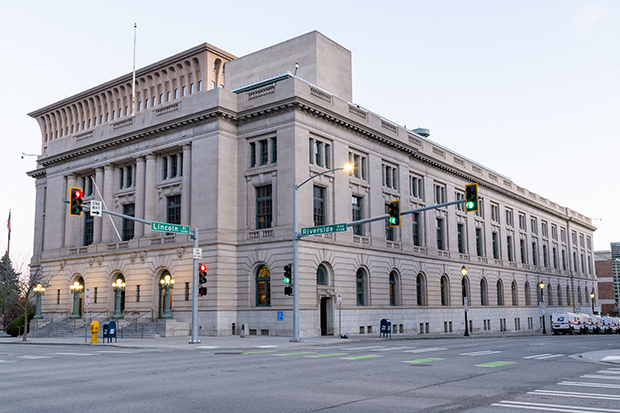
PhotoTitle: The U. S. Post Office
PhotoAttribution: Spokane City/County Historic Preservation Office
Listing Status: National Register
URL: http://properties.historicspokane.org/property/?PropertyID=2019
Display Marker: large_yellow
Title: US Post Office
Description: Date Built: 1908
Architect: James Knox Taylor (1908), Louis A. Simon (1941 addition)
Common Name: U.S. Post Office
The U.S. Post Office was designed in the office of the Supervising Architect of the Treasury Department by James Knox Taylor in 1906-07, and reflects the prevailing design ideals of that era with its Beaux Arts Classicism and Second Renaissance Revival influences. An addition to the north end of the building, completed in 1941 by the James Leck Co. of Minneapolis, blends seamlessly with the original structure. Plans for the addition were drawn in the office of Louis A. Simon, Supervising Architect for the Federal Works Administration under the direction of W. G. Noll, Chief of Architecture. A two-year $7.7 million renovation of the building was completed in 1993.
Location: 47.65847, -117.4254
Address: 904 West Riverside Avenue, Spokane WA 99201
PhotoURL:

PhotoTitle: The U. S. Post Office
PhotoAttribution: Spokane City/County Historic Preservation Office
Listing Status: National Register
URL: http://properties.historicspokane.org/property/?PropertyID=2019
Display Marker: large_yellow
ID: 320
Title: United Hillyard Bank Building
Description: Date Built: 1920
Architect: Henry Bertelsen
Common Name: United Hillyard Bank Building
This two-story brick Beaux-Arts building features buff-colored brick veneer and a decorative brick sawtooth and terra cotta cornice capped with the initials "UHB" (United Hillyard Bank). In 1908, the First National Bank built a tall, two-story building that served as one of the banks in Hillyard. That bank's reign was cut short when it and the State Bank of Hillyard next door were demolished and replaced in 1920 by the current Hillyard Bank Building. The UHB Building was designed by Spokane architect, Henry Bertelsen, and the original storefront is still largely intact.
Location: 47.70389, -117.36448
Address: 5016 North Market Street, Spokane WA 99217
PhotoURL:
PhotoTitle: The United Hillyard Bank Building
PhotoAttribution: Spokane City/County Historic Preservation Office
Listing Status: Spokane Register, National Register
URL: http://properties.historicspokane.org/property/?PropertyID=1963
Display Marker: large_yellow
Title: United Hillyard Bank Building
Description: Date Built: 1920
Architect: Henry Bertelsen
Common Name: United Hillyard Bank Building
This two-story brick Beaux-Arts building features buff-colored brick veneer and a decorative brick sawtooth and terra cotta cornice capped with the initials "UHB" (United Hillyard Bank). In 1908, the First National Bank built a tall, two-story building that served as one of the banks in Hillyard. That bank's reign was cut short when it and the State Bank of Hillyard next door were demolished and replaced in 1920 by the current Hillyard Bank Building. The UHB Building was designed by Spokane architect, Henry Bertelsen, and the original storefront is still largely intact.
Location: 47.70389, -117.36448
Address: 5016 North Market Street, Spokane WA 99217
PhotoURL:

PhotoTitle: The United Hillyard Bank Building
PhotoAttribution: Spokane City/County Historic Preservation Office
Listing Status: Spokane Register, National Register
URL: http://properties.historicspokane.org/property/?PropertyID=1963
Display Marker: large_yellow
ID: 321
Title: Snappy Beer Parlor
Description: Date Built: 1909
Architect: Preusse & Zittel (likely)
Common Name: Jack & Dan's
Jack & Dan's Tavern is one of only a handful of remaining beer parlors in Spokane that have operated continuously as parlors/taverns since the repeal of prohibition in Washington in 1933. Built in 1909, the two-story brick building housed a variety of businesses over the decades including pharmacies, taverns and meat markets. Between 1915 and 1933, the prohibition years, saloons changed to soft drink establishments and no longer could patrons rest their feet on the brass rail while enjoying a cold one. Snappy Beer Parlor, which occupied the commercial space in 1934, would become Joey's Tavern in the 1940s which would, in turn, become Jack & Dan's.
Location: 47.6692, -117.39625
Address: 1226 North Hamilton Street, Spokane WA 99202
PhotoURL: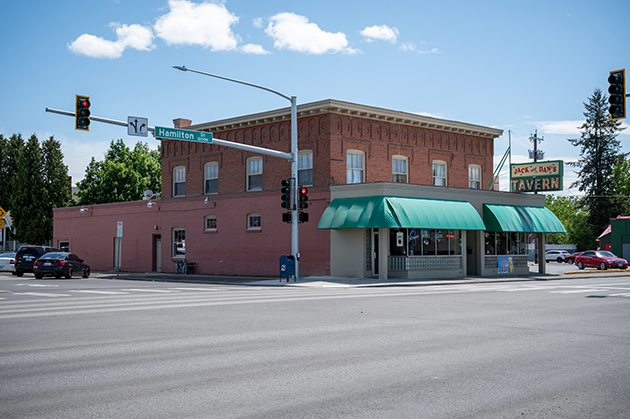
PhotoTitle: Snappy Beer Parlor!
PhotoAttribution: Spokane City/County Historic Preservation Office
Listing Status: Spokane Register
URL: http://properties.historicspokane.org/property/?PropertyID=1964
Display Marker: large_yellow
Title: Snappy Beer Parlor
Description: Date Built: 1909
Architect: Preusse & Zittel (likely)
Common Name: Jack & Dan's
Jack & Dan's Tavern is one of only a handful of remaining beer parlors in Spokane that have operated continuously as parlors/taverns since the repeal of prohibition in Washington in 1933. Built in 1909, the two-story brick building housed a variety of businesses over the decades including pharmacies, taverns and meat markets. Between 1915 and 1933, the prohibition years, saloons changed to soft drink establishments and no longer could patrons rest their feet on the brass rail while enjoying a cold one. Snappy Beer Parlor, which occupied the commercial space in 1934, would become Joey's Tavern in the 1940s which would, in turn, become Jack & Dan's.
Location: 47.6692, -117.39625
Address: 1226 North Hamilton Street, Spokane WA 99202
PhotoURL:

PhotoTitle: Snappy Beer Parlor!
PhotoAttribution: Spokane City/County Historic Preservation Office
Listing Status: Spokane Register
URL: http://properties.historicspokane.org/property/?PropertyID=1964
Display Marker: large_yellow
ID: 322
Title: Wallace-Lyberger Building (demolished)
Description: Date Built: 1905
Architect: David W. Wallace
Common Name: Bridgeport Grocery & Hardware
The Wallace-Lyberger Building was demolished in 2011. Built in 1905 by Spokane carpenter, David W. Wallace, the Wallace-Lyberger Building was a one-story vernacular commercial block constructed of un-reinforced brick masonry with a flat roof, plain parapet and corbelled brick cornice. The property was one of the first commercial buildings built in the Hays Park neighborhood along North Crestline Street and symbolizes the importance of the area's early 20th century development as a mixed-use residential and commercial neighborhood. The P. A. Lyberger family founded the Bridgeport Grocery & Hardware Store, a family-owned and operated grocery business that occupied the building for 34 years from 1912 to 1946.
Location: 47.688584, -117.378682
Address: 3402 North Crestline Street, Spokane WA 99207
PhotoURL: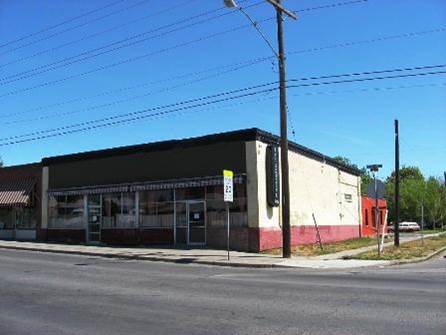
PhotoTitle: The once-standing Wallace-Lyberger Building
PhotoAttribution: Spokane City/County Historic Preservation Office
Listing Status: N/A
URL: http://properties.historicspokane.org/property/?PropertyID=2067
Display Marker: large_yellow
Title: Wallace-Lyberger Building (demolished)
Description: Date Built: 1905
Architect: David W. Wallace
Common Name: Bridgeport Grocery & Hardware
The Wallace-Lyberger Building was demolished in 2011. Built in 1905 by Spokane carpenter, David W. Wallace, the Wallace-Lyberger Building was a one-story vernacular commercial block constructed of un-reinforced brick masonry with a flat roof, plain parapet and corbelled brick cornice. The property was one of the first commercial buildings built in the Hays Park neighborhood along North Crestline Street and symbolizes the importance of the area's early 20th century development as a mixed-use residential and commercial neighborhood. The P. A. Lyberger family founded the Bridgeport Grocery & Hardware Store, a family-owned and operated grocery business that occupied the building for 34 years from 1912 to 1946.
Location: 47.688584, -117.378682
Address: 3402 North Crestline Street, Spokane WA 99207
PhotoURL:

PhotoTitle: The once-standing Wallace-Lyberger Building
PhotoAttribution: Spokane City/County Historic Preservation Office
Listing Status: N/A
URL: http://properties.historicspokane.org/property/?PropertyID=2067
Display Marker: large_yellow
ID: 323
Title: Washington Auto Carriage
Description: Date Built: 1917
Architect: Unknown/E. A. Buchanan
Common Name: Washington Auto Carriage
Built in 1917 as an expansion of an adjacent carriage and wagon and automobile body fabrication business, the building served as the headquarters for the Washington Auto Carriage Company until 1954 when the company moved to a new larger location in the Spokane Valley. Washington Auto Carriage, still operating in Spokane Valley, is one of the oldest businesses in Spokane. The building was instrumental in the transformation from blacksmiths shoeing horses and building and repairing carriages to modifying automobile and truck chassis and bodies for fire and sheriff's departments, mining companies, delivery companies, and schools among others.
Location: 47.65486, -117.41287
Address: 32 West 2nd Avenue, Spokane WA 99201
PhotoURL: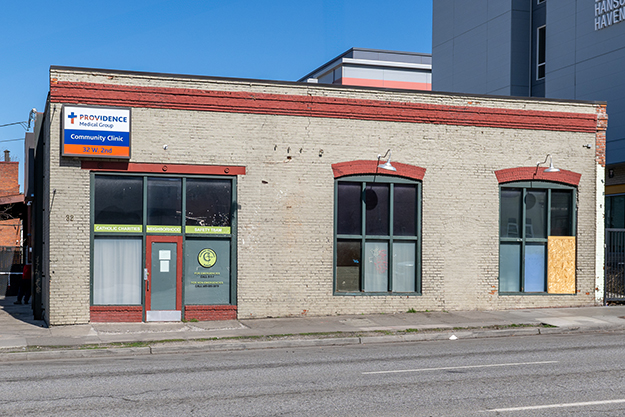
PhotoTitle: Washington Auto Carriage
PhotoAttribution: Spokane City/County Historic Preservation Office
Listing Status: Spokane Register
URL: http://properties.historicspokane.org/property/?PropertyID=2037
Display Marker: large_yellow
Title: Washington Auto Carriage
Description: Date Built: 1917
Architect: Unknown/E. A. Buchanan
Common Name: Washington Auto Carriage
Built in 1917 as an expansion of an adjacent carriage and wagon and automobile body fabrication business, the building served as the headquarters for the Washington Auto Carriage Company until 1954 when the company moved to a new larger location in the Spokane Valley. Washington Auto Carriage, still operating in Spokane Valley, is one of the oldest businesses in Spokane. The building was instrumental in the transformation from blacksmiths shoeing horses and building and repairing carriages to modifying automobile and truck chassis and bodies for fire and sheriff's departments, mining companies, delivery companies, and schools among others.
Location: 47.65486, -117.41287
Address: 32 West 2nd Avenue, Spokane WA 99201
PhotoURL:

PhotoTitle: Washington Auto Carriage
PhotoAttribution: Spokane City/County Historic Preservation Office
Listing Status: Spokane Register
URL: http://properties.historicspokane.org/property/?PropertyID=2037
Display Marker: large_yellow
ID: 324
Title: Washington Broom Factory (Gustav Meese Building)
Description: Date Built: 1905
Architect: Unknown
Common Name: Northwest Knitting Mills
Built in 1905 as a replacement to a building destroyed in a fire, this factory is one of the first industrial buildings constructed in the West Central neighborhood and has been in use since its construction. This three-story building and basement rises from a stone and mortar foundation to a flat roof. Walls consist of brick frame construction and brick cladding. The Washington State Broom Factory is significant due to its architectural stature as an industrial property type of good integrity representing the West Central neighborhood, its association with commercial development in the area, and its connection to persons important tot he commercial development of Spokane.
Location: 47.66965, -117.43802
Address: 1727 West Sinto Avenue, Spokane WA 99201
PhotoURL: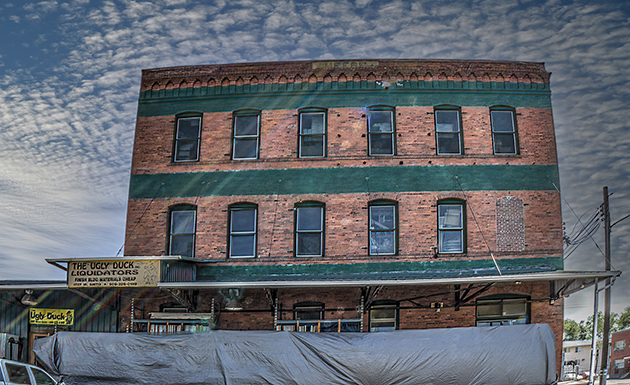
PhotoTitle: The Washington Broom Factory
PhotoAttribution: Spokane City/County Historic Preservation Office
Listing Status: National Register
URL: http://properties.historicspokane.org/property/?PropertyID=2020
Display Marker: large_yellow
Title: Washington Broom Factory (Gustav Meese Building)
Description: Date Built: 1905
Architect: Unknown
Common Name: Northwest Knitting Mills
Built in 1905 as a replacement to a building destroyed in a fire, this factory is one of the first industrial buildings constructed in the West Central neighborhood and has been in use since its construction. This three-story building and basement rises from a stone and mortar foundation to a flat roof. Walls consist of brick frame construction and brick cladding. The Washington State Broom Factory is significant due to its architectural stature as an industrial property type of good integrity representing the West Central neighborhood, its association with commercial development in the area, and its connection to persons important tot he commercial development of Spokane.
Location: 47.66965, -117.43802
Address: 1727 West Sinto Avenue, Spokane WA 99201
PhotoURL:

PhotoTitle: The Washington Broom Factory
PhotoAttribution: Spokane City/County Historic Preservation Office
Listing Status: National Register
URL: http://properties.historicspokane.org/property/?PropertyID=2020
Display Marker: large_yellow
ID: 325
Title: Washington Cracker Company
Description: Date Built: 1904
Architect: Unknown
Common Name: Washington Cracker Co.
The Washington Cracker Co. building was developed by Portland entrepreneur Herman Wittenberg for his rapidly expanding biscuit and candy-making business in 1891. The business left a legacy of buildings on the west coast, including two in Portland that are individually listed on the National Register of Historic Places. The building is significant for its place in the patterns of local history, and specifically for its association with historic events that had a significant effect on the city. The building is important for its association with the rapidly growing biscuit and candy industry of the late nineteenth century and as a good representation of a vernacular industrial warehouse that embodies the distinctive characteristics of a type that is particularly representative of the buildings for which this historic district is known.
Location: 47.65535, -117.41674
Address: 304 West Pacific Avenue, Spokane WA 99201
PhotoURL: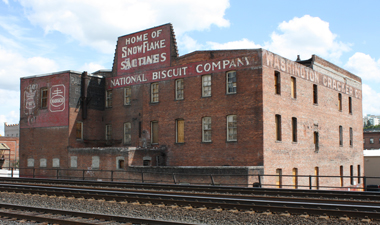
PhotoTitle: The Washington Cracker Co. building
PhotoAttribution: Spokane City/County Historic Preservation Office
Listing Status: Spokane Register, National Register
URL: http://properties.historicspokane.org/property/?PropertyID=1966
Display Marker: large_yellow
Title: Washington Cracker Company
Description: Date Built: 1904
Architect: Unknown
Common Name: Washington Cracker Co.
The Washington Cracker Co. building was developed by Portland entrepreneur Herman Wittenberg for his rapidly expanding biscuit and candy-making business in 1891. The business left a legacy of buildings on the west coast, including two in Portland that are individually listed on the National Register of Historic Places. The building is significant for its place in the patterns of local history, and specifically for its association with historic events that had a significant effect on the city. The building is important for its association with the rapidly growing biscuit and candy industry of the late nineteenth century and as a good representation of a vernacular industrial warehouse that embodies the distinctive characteristics of a type that is particularly representative of the buildings for which this historic district is known.
Location: 47.65535, -117.41674
Address: 304 West Pacific Avenue, Spokane WA 99201
PhotoURL:

PhotoTitle: The Washington Cracker Co. building
PhotoAttribution: Spokane City/County Historic Preservation Office
Listing Status: Spokane Register, National Register
URL: http://properties.historicspokane.org/property/?PropertyID=1966
Display Marker: large_yellow
ID: 326
Title: Washington Furniture Building
Description: Date Built: 1909
Architect: Unknown
Common Name: Community Building
The Washington Furniture Building is historically significant for its association with the commercial expansion of Spokane's central business district during the unparalleled period of growth in the first decade of the twentieth century. The building's construction in 1909 coincided with increased building activity that resulted in the emergence of the first block of West Main Avenue as a commercial area on the periphery of downtown that accommodated small business enterprises and residential spaces catering to the working class. This particular part of town became home to a community of immigrants from the Balkan countries. The Washington Furniture Company Building's brick facade still reflects its original use and character and contributes to the high degree of integrity that the block as a whole conveys; very few, if any blocks in east downtown Spokane retain such a high concentration of historic buildings.
Location: 47.65875, -117.4127
Address: 35 West Main Avenue, Spokane WA 99201
PhotoURL: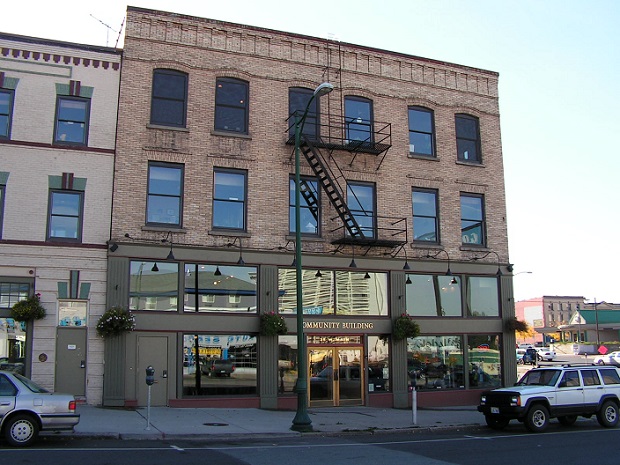
PhotoTitle: The Washington Furniture Building
PhotoAttribution: Spokane City/County Historic Preservation Office
Listing Status: Spokane Register, National Register
URL: http://properties.historicspokane.org/property/?PropertyID=1967
Display Marker: large_yellow
Title: Washington Furniture Building
Description: Date Built: 1909
Architect: Unknown
Common Name: Community Building
The Washington Furniture Building is historically significant for its association with the commercial expansion of Spokane's central business district during the unparalleled period of growth in the first decade of the twentieth century. The building's construction in 1909 coincided with increased building activity that resulted in the emergence of the first block of West Main Avenue as a commercial area on the periphery of downtown that accommodated small business enterprises and residential spaces catering to the working class. This particular part of town became home to a community of immigrants from the Balkan countries. The Washington Furniture Company Building's brick facade still reflects its original use and character and contributes to the high degree of integrity that the block as a whole conveys; very few, if any blocks in east downtown Spokane retain such a high concentration of historic buildings.
Location: 47.65875, -117.4127
Address: 35 West Main Avenue, Spokane WA 99201
PhotoURL:

PhotoTitle: The Washington Furniture Building
PhotoAttribution: Spokane City/County Historic Preservation Office
Listing Status: Spokane Register, National Register
URL: http://properties.historicspokane.org/property/?PropertyID=1967
Display Marker: large_yellow
ID: 327
Title: Washington Post Building
Description: Date Built: 1902
Architect: Unknown
Common Name: Washington Post Building
The Washington Post Building is historically significant for its association with Otto Jukeland, a pioneer leader of Spokane's German immigrant community and co-founder of The Washington Post, the largest Germanic Language newspaper in the Northwest. The building, completed on the eastern edge of Spokane's Central Business District in the summer of 1903, was the first permanent home of the newspaper. Jukeland arrived in Spokane from Leipzig, Germany in 1886. In February of 1889, he founded The Washington Post, together with fellow immigrant A. M. Armand. First published from Room 22 in the Eagle Block, the newspaper found an eager readership among the city's growing German community, and Jukeland bought out Armand in 1900. Subscription continued to grow so that by 1910 the newspaper had already outgrown the building, and the presses were moved to the newly completed Germania Building, a larger facility at the corner of Third and Browne designed for Jukeland by the noted architectural firm of Preusse & Zittel. Preusse and Zittel are also thought to have designed the Washington Post Building.
Location: 47.65424, -117.41601
Address: 223 West 2nd Avenue, Spokane WA 99201
PhotoURL: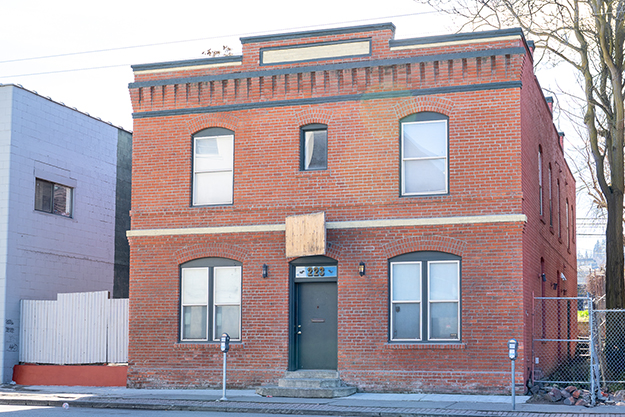
PhotoTitle: The Washington Post Building
PhotoAttribution: Spokane City/County Historic Preservation Office
Listing Status: Spokane Register
URL: http://properties.historicspokane.org/property/?PropertyID=1968
Display Marker: large_yellow
Title: Washington Post Building
Description: Date Built: 1902
Architect: Unknown
Common Name: Washington Post Building
The Washington Post Building is historically significant for its association with Otto Jukeland, a pioneer leader of Spokane's German immigrant community and co-founder of The Washington Post, the largest Germanic Language newspaper in the Northwest. The building, completed on the eastern edge of Spokane's Central Business District in the summer of 1903, was the first permanent home of the newspaper. Jukeland arrived in Spokane from Leipzig, Germany in 1886. In February of 1889, he founded The Washington Post, together with fellow immigrant A. M. Armand. First published from Room 22 in the Eagle Block, the newspaper found an eager readership among the city's growing German community, and Jukeland bought out Armand in 1900. Subscription continued to grow so that by 1910 the newspaper had already outgrown the building, and the presses were moved to the newly completed Germania Building, a larger facility at the corner of Third and Browne designed for Jukeland by the noted architectural firm of Preusse & Zittel. Preusse and Zittel are also thought to have designed the Washington Post Building.
Location: 47.65424, -117.41601
Address: 223 West 2nd Avenue, Spokane WA 99201
PhotoURL:

PhotoTitle: The Washington Post Building
PhotoAttribution: Spokane City/County Historic Preservation Office
Listing Status: Spokane Register
URL: http://properties.historicspokane.org/property/?PropertyID=1968
Display Marker: large_yellow
ID: 328
Title: Washington Street Bridge (demolished)
Description: Date Built: 1908
Architect: Charles McIntyre & Wallace-Coates Engineering Company
Common Name: Washington Street Bridge
The historic Washington Street Bridge was demolished. The existing structure at this address is not listed on a historic register. The Washington Street Bridge was a three spanned reinforced concrete arch constructed in 1908 over the Spokane River. Designed by City Engineer Charles McIntyre and constructed by Wallace-Coates Engineering Company, the bridge was 242 feet long and consisted of three 77 foot flattened ribbed arches. J.B. Strauss of the Strauss Bascule and Concrete Bridge Company of Chicago was the consulting engineer. The Washington Street Bridge was an early example of concrete construction in the state and, when it was listed on the National Register in 1982, was the oldest surviving concrete arch bridge in the state. By January 1983, the bridge was considered unsafe with numerous cracks in the arches and abutments and chipped supports that revealed exposed reinforced steel. The bridge was demolished and replaced in 1983 with the current bridge.
Location: 47.663384, -117.417942
Address: 2 North Washington Street, Spokane WA 99201
PhotoURL: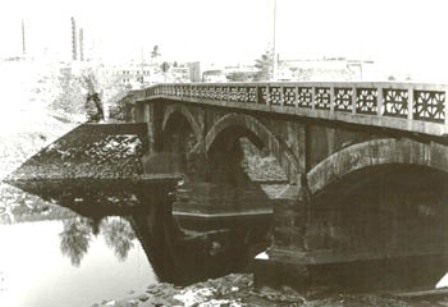
PhotoTitle: The once-standing Washington Street Bridge
PhotoAttribution: Spokane City/County Historic Preservation Office
Listing Status: N/A
URL: http://properties.historicspokane.org/property/?PropertyID=2021
Display Marker: large_yellow
Title: Washington Street Bridge (demolished)
Description: Date Built: 1908
Architect: Charles McIntyre & Wallace-Coates Engineering Company
Common Name: Washington Street Bridge
The historic Washington Street Bridge was demolished. The existing structure at this address is not listed on a historic register. The Washington Street Bridge was a three spanned reinforced concrete arch constructed in 1908 over the Spokane River. Designed by City Engineer Charles McIntyre and constructed by Wallace-Coates Engineering Company, the bridge was 242 feet long and consisted of three 77 foot flattened ribbed arches. J.B. Strauss of the Strauss Bascule and Concrete Bridge Company of Chicago was the consulting engineer. The Washington Street Bridge was an early example of concrete construction in the state and, when it was listed on the National Register in 1982, was the oldest surviving concrete arch bridge in the state. By January 1983, the bridge was considered unsafe with numerous cracks in the arches and abutments and chipped supports that revealed exposed reinforced steel. The bridge was demolished and replaced in 1983 with the current bridge.
Location: 47.663384, -117.417942
Address: 2 North Washington Street, Spokane WA 99201
PhotoURL:

PhotoTitle: The once-standing Washington Street Bridge
PhotoAttribution: Spokane City/County Historic Preservation Office
Listing Status: N/A
URL: http://properties.historicspokane.org/property/?PropertyID=2021
Display Marker: large_yellow
ID: 329
Title: Weaver House
Description: Date Built: 1910
Architect: Alfred Jones
Common Name: Weaver House
The Weaver House is architecturally significant as an excellent example of the Craftsman style of architecture and as the work of prominent Spokane architect Alfred Jones. The home was built in 1910 for Lawrence Weaver, a successful investor with ranching and fruit orchard interests in the Wenatchee Valley, and his wife Lydia. The couple remained in the home, where they raised a family of six, for over 60 years. It retains a high degree of its historic character and integrity.
Location: 47.64112, -117.42044
Address: 520 West 16th Avenue, Spokane WA 99203
PhotoURL: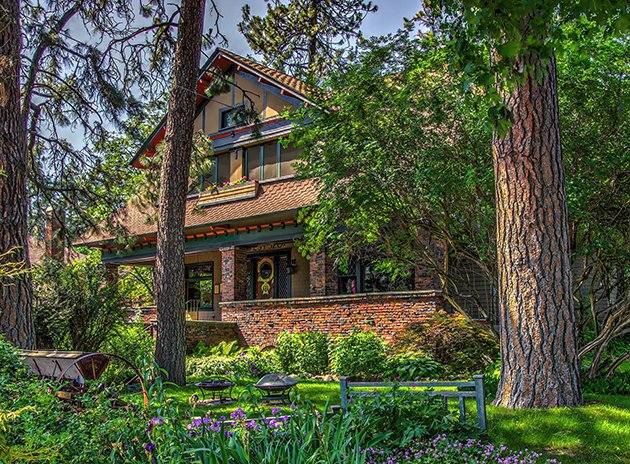
PhotoTitle: The Weaver House
PhotoAttribution: Spokane City/County Historic Preservation Office
Listing Status: Spokane Register, National Register
URL: http://properties.historicspokane.org/property/?PropertyID=1969
Display Marker: large_yellow
Title: Weaver House
Description: Date Built: 1910
Architect: Alfred Jones
Common Name: Weaver House
The Weaver House is architecturally significant as an excellent example of the Craftsman style of architecture and as the work of prominent Spokane architect Alfred Jones. The home was built in 1910 for Lawrence Weaver, a successful investor with ranching and fruit orchard interests in the Wenatchee Valley, and his wife Lydia. The couple remained in the home, where they raised a family of six, for over 60 years. It retains a high degree of its historic character and integrity.
Location: 47.64112, -117.42044
Address: 520 West 16th Avenue, Spokane WA 99203
PhotoURL:

PhotoTitle: The Weaver House
PhotoAttribution: Spokane City/County Historic Preservation Office
Listing Status: Spokane Register, National Register
URL: http://properties.historicspokane.org/property/?PropertyID=1969
Display Marker: large_yellow
ID: 331
Title: Wetzel Warehouse
Description: Date Built: 1906
Architect: Unknown
Common Name: Wetzel Warehouse
The Wetzel Warehouse was constructed in 1906 and exists as an excellent example of commercial vernacular industrial warehouse architecture built in Spokane during the early twentieth century. Designed as a functional industrial warehouse with little exterior embellishment, the Wetzel Warehouse is part of a unique contiguous facade of mostly two-story commercial vernacular industrial buildings that were built in the early 1900s. The warehouse buildings front West Pacific Avenue between McClellan and Browne Streets and demonstrate early building trends and patterns that led to the industrial development of east downtown Spokane and its importance as the town's storage and distribution center.
Location: 47.65585, -117.41412
Address: 114 West Pacific Avenue, Spokane WA 99201
PhotoURL: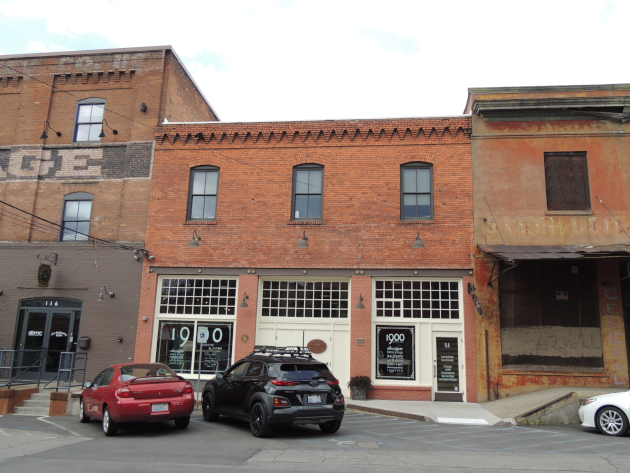
PhotoTitle: The Wetzel Warehouse
PhotoAttribution: Spokane City/County Historic Preservation Office
Listing Status: Spokane Register, National Register
URL: http://properties.historicspokane.org/property/?PropertyID=1971
Display Marker: large_yellow
Title: Wetzel Warehouse
Description: Date Built: 1906
Architect: Unknown
Common Name: Wetzel Warehouse
The Wetzel Warehouse was constructed in 1906 and exists as an excellent example of commercial vernacular industrial warehouse architecture built in Spokane during the early twentieth century. Designed as a functional industrial warehouse with little exterior embellishment, the Wetzel Warehouse is part of a unique contiguous facade of mostly two-story commercial vernacular industrial buildings that were built in the early 1900s. The warehouse buildings front West Pacific Avenue between McClellan and Browne Streets and demonstrate early building trends and patterns that led to the industrial development of east downtown Spokane and its importance as the town's storage and distribution center.
Location: 47.65585, -117.41412
Address: 114 West Pacific Avenue, Spokane WA 99201
PhotoURL:

PhotoTitle: The Wetzel Warehouse
PhotoAttribution: Spokane City/County Historic Preservation Office
Listing Status: Spokane Register, National Register
URL: http://properties.historicspokane.org/property/?PropertyID=1971
Display Marker: large_yellow
ID: 332
Title: Whitten Block
Description: Date Built: 1889
Architect: Lorenzo Boardman
Common Name: Fugazzi
Completed in 1890, the year after Spokane's Great Fire, the Whitten Block is historically significant for its association with Spokane's emergence as the commercial center and transportation hub of the Inland Northwest. The building is also architecturally significant as an one of a mere handful of buildings that have survived from the rebuilding effort that followed the fire. It is, moreover, the only remaining commercial structure in Spokane designed by architect Lorenzo Boardman. Finally, the building is significant for its association with Spokane pioneers Leyford B. Whitten and Georgia Ballou Whitten. L. B. Whitten came to Spokane as a carpenter, but soon established himself as a successful mining and real estate investor. In 1888 he married Georgia Ballou, one of Spokane's first female physicians. Some of Spokane's best-known businesses got their start in the Whitten Block. Louis Davenport lived in the building, where he had his restaurant before erecting his landmark Davenport Hotel and restaurant across the street, on the opposite corner of the intersection. Spokane's famous Crescent Department Store was another early occupant of the building. The building was recently renovated and, together with the Miller Block, adjacent next west, now houses a luxury hotel, the Lusso.
Location: 47.657384, -117.423759
Address: 1 North Post Street, Spokane WA 99201
PhotoURL: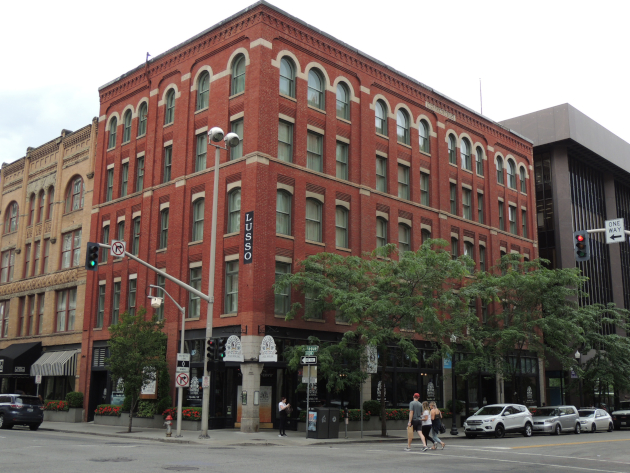
PhotoTitle: The Whitten Block
PhotoAttribution: Spokane City/County Historic Preservation Office
Listing Status: Spokane Register, National Register
URL: http://properties.historicspokane.org/property/?PropertyID=1972
Display Marker: large_yellow
Title: Whitten Block
Description: Date Built: 1889
Architect: Lorenzo Boardman
Common Name: Fugazzi
Completed in 1890, the year after Spokane's Great Fire, the Whitten Block is historically significant for its association with Spokane's emergence as the commercial center and transportation hub of the Inland Northwest. The building is also architecturally significant as an one of a mere handful of buildings that have survived from the rebuilding effort that followed the fire. It is, moreover, the only remaining commercial structure in Spokane designed by architect Lorenzo Boardman. Finally, the building is significant for its association with Spokane pioneers Leyford B. Whitten and Georgia Ballou Whitten. L. B. Whitten came to Spokane as a carpenter, but soon established himself as a successful mining and real estate investor. In 1888 he married Georgia Ballou, one of Spokane's first female physicians. Some of Spokane's best-known businesses got their start in the Whitten Block. Louis Davenport lived in the building, where he had his restaurant before erecting his landmark Davenport Hotel and restaurant across the street, on the opposite corner of the intersection. Spokane's famous Crescent Department Store was another early occupant of the building. The building was recently renovated and, together with the Miller Block, adjacent next west, now houses a luxury hotel, the Lusso.
Location: 47.657384, -117.423759
Address: 1 North Post Street, Spokane WA 99201
PhotoURL:

PhotoTitle: The Whitten Block
PhotoAttribution: Spokane City/County Historic Preservation Office
Listing Status: Spokane Register, National Register
URL: http://properties.historicspokane.org/property/?PropertyID=1972
Display Marker: large_yellow
ID: 333
Title: Wilbur-Hahn House
Description: Date Built: 1916
Architect: Gustav Pehrson and Kirtland K. Cutter
Common Name: Wilbur-Hahn House
The Wilbur-Hahn House is architecturally significant as an outstanding example of Craftsman style architecture. It was designed in 1916 for Ralston "Jack" Wilbur, a partner and salesman with Hallide Machinery Company, and his wife Sarah E. Smith, the controlling stockholder of the fabulously lucrative Hecla Mining Company. Wilbur commissioned prominent Spokane architect G. A. Pehrson, a personal friend, to design the home. The plans are reported to have been completed in partnership with K. K. Cutter, Spokane's most celebrated architect; Pehrson was employed in Cutter's firm at the time. In addition to its association with the Wilburs, the home is also historically significant as the long-time residence of Rudolph Hahn, a controversial figure in Spokane who lived in the home from 1924 to 1945. Hahn held lavish parties in the home, entertaining noteworthy figures like Lt. J. Doolittle, later leader of the famous Doolittle Raid during World War II. He moved out of the house a few years after his wife committed suicide in it, in the same year he was convicted for illegally performing abortions. He was found murdered in his apartment downtown in the New Madison Hotel the next year.
Location: 47.63855, -117.37262
Address: 2525 East 19th Avenue, Spokane WA 99223
PhotoURL: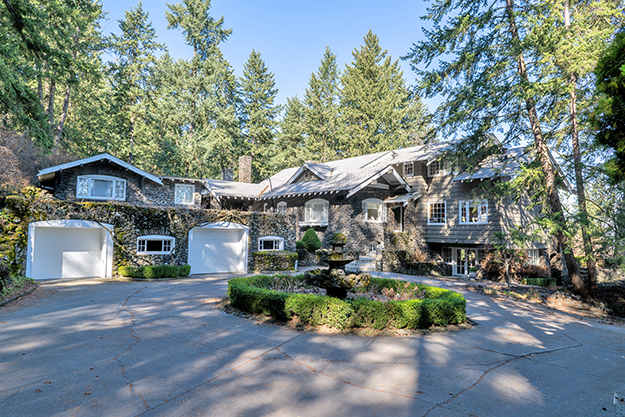
PhotoTitle: The Wilbur-Hahn House
PhotoAttribution: Spokane City/County Historic Preservation Office
Listing Status: Spokane Register, National Register
URL: http://properties.historicspokane.org/property/?PropertyID=1973
Display Marker: large_yellow
Title: Wilbur-Hahn House
Description: Date Built: 1916
Architect: Gustav Pehrson and Kirtland K. Cutter
Common Name: Wilbur-Hahn House
The Wilbur-Hahn House is architecturally significant as an outstanding example of Craftsman style architecture. It was designed in 1916 for Ralston "Jack" Wilbur, a partner and salesman with Hallide Machinery Company, and his wife Sarah E. Smith, the controlling stockholder of the fabulously lucrative Hecla Mining Company. Wilbur commissioned prominent Spokane architect G. A. Pehrson, a personal friend, to design the home. The plans are reported to have been completed in partnership with K. K. Cutter, Spokane's most celebrated architect; Pehrson was employed in Cutter's firm at the time. In addition to its association with the Wilburs, the home is also historically significant as the long-time residence of Rudolph Hahn, a controversial figure in Spokane who lived in the home from 1924 to 1945. Hahn held lavish parties in the home, entertaining noteworthy figures like Lt. J. Doolittle, later leader of the famous Doolittle Raid during World War II. He moved out of the house a few years after his wife committed suicide in it, in the same year he was convicted for illegally performing abortions. He was found murdered in his apartment downtown in the New Madison Hotel the next year.
Location: 47.63855, -117.37262
Address: 2525 East 19th Avenue, Spokane WA 99223
PhotoURL:

PhotoTitle: The Wilbur-Hahn House
PhotoAttribution: Spokane City/County Historic Preservation Office
Listing Status: Spokane Register, National Register
URL: http://properties.historicspokane.org/property/?PropertyID=1973
Display Marker: large_yellow
ID: 334
Title: Willard Hotel
Description: Date Built: 1911
Architect: Arthur Cowley and Archibald Rigg
Common Name: Otis Hotel
Dr. Joseph Gandy, one of the first residents of Spokane, had this building constructed in 1911. Originally named the Willard Hotel, it was a single-room-occupancy hotel designed to house the burgeoning working class population drawn to Spokane to fill jobs associated with the city's unparalleled decade of growth just after the turn of the twentieth century. SROs were once commonplace in Spokane, but relatively few representative examples remain. The row of SROs including the Willard, along west First Avenue in the heart of the West Downtown Historic Transportation Corridor, represents the best extant concentration of this property type in Spokane. In 1921, Spokane investor Victor Dessert bought the structure and changed its name to the Atlantic Hotel. By 1941, it was called the Milner Hotel, in 1948 it became the Earle Hotel, and in 1956, the Otis. The Otis Hotel still functions as a single-room-occupancy hotel with commercial space on the first floor.
Location: 47.65622, -117.42841
Address: 1101 West 1st Avenue, Spokane WA 99201
PhotoURL: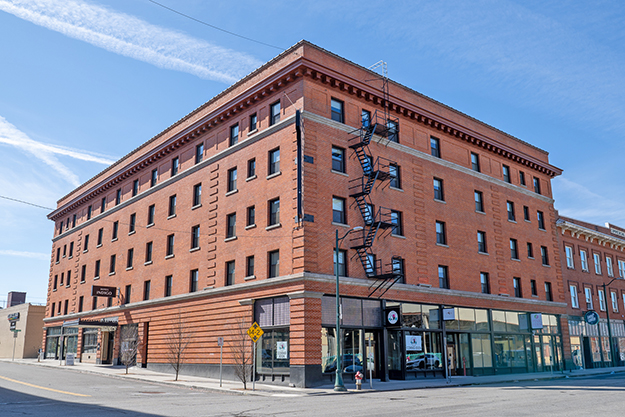
PhotoTitle: The Willard Hotel
PhotoAttribution: Spokane City/County Historic Preservation Office
Listing Status: National Register
URL: http://properties.historicspokane.org/property/?PropertyID=2051
Display Marker: large_yellow
Title: Willard Hotel
Description: Date Built: 1911
Architect: Arthur Cowley and Archibald Rigg
Common Name: Otis Hotel
Dr. Joseph Gandy, one of the first residents of Spokane, had this building constructed in 1911. Originally named the Willard Hotel, it was a single-room-occupancy hotel designed to house the burgeoning working class population drawn to Spokane to fill jobs associated with the city's unparalleled decade of growth just after the turn of the twentieth century. SROs were once commonplace in Spokane, but relatively few representative examples remain. The row of SROs including the Willard, along west First Avenue in the heart of the West Downtown Historic Transportation Corridor, represents the best extant concentration of this property type in Spokane. In 1921, Spokane investor Victor Dessert bought the structure and changed its name to the Atlantic Hotel. By 1941, it was called the Milner Hotel, in 1948 it became the Earle Hotel, and in 1956, the Otis. The Otis Hotel still functions as a single-room-occupancy hotel with commercial space on the first floor.
Location: 47.65622, -117.42841
Address: 1101 West 1st Avenue, Spokane WA 99201
PhotoURL:

PhotoTitle: The Willard Hotel
PhotoAttribution: Spokane City/County Historic Preservation Office
Listing Status: National Register
URL: http://properties.historicspokane.org/property/?PropertyID=2051
Display Marker: large_yellow
ID: 335
Title: Williams House
Description: Date Built: 1911
Architect: Albert Held/Cyrus A. Conant
Common Name: Williams House
Built in 1911 for Spokane attorney James A. Williams and his wife Corinne Conant Williams, the Williams House is an exceptional example of Prairie style architecture. The home was designed by noted Spokane architect Albert Held and built by Corinne Conant Williams' father Cyrus Augustus Conant, a general contractor who specialized in bridge building. The house is located near Cannon Hill Park, which was designed in accordance with the recommendations of the nationally renowned Olmsted Brothers landscape architects of Brookline, Massachusetts.
Location: 47.63724, -117.43061
Address: 1225 West 19th Avenue, Spokane WA 99203
PhotoURL: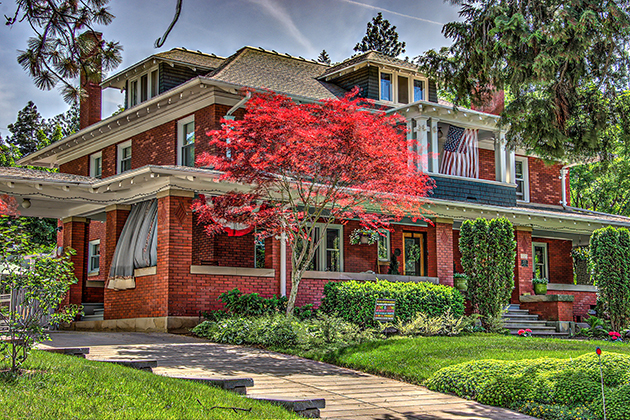
PhotoTitle: The James and Corinne Wiliams House
PhotoAttribution: Spokane City/County Historic Preservation Office
Listing Status: Spokane Register, National Register
URL: http://properties.historicspokane.org/property/?PropertyID=1974
Display Marker: large_yellow
Title: Williams House
Description: Date Built: 1911
Architect: Albert Held/Cyrus A. Conant
Common Name: Williams House
Built in 1911 for Spokane attorney James A. Williams and his wife Corinne Conant Williams, the Williams House is an exceptional example of Prairie style architecture. The home was designed by noted Spokane architect Albert Held and built by Corinne Conant Williams' father Cyrus Augustus Conant, a general contractor who specialized in bridge building. The house is located near Cannon Hill Park, which was designed in accordance with the recommendations of the nationally renowned Olmsted Brothers landscape architects of Brookline, Massachusetts.
Location: 47.63724, -117.43061
Address: 1225 West 19th Avenue, Spokane WA 99203
PhotoURL:

PhotoTitle: The James and Corinne Wiliams House
PhotoAttribution: Spokane City/County Historic Preservation Office
Listing Status: Spokane Register, National Register
URL: http://properties.historicspokane.org/property/?PropertyID=1974
Display Marker: large_yellow
ID: 336
Title: Winter House
Description: Date Built: 1910
Architect: E.W. Morrison/A.L. Lundquist
Common Name: Charles W. Winter House
Aaron L. Lundquist, a noted contractor who built several homes throughout Spokane, built the house for Charles Winter, vice president of Spokane and Eastern Trust Company. The architect was Earl Morrison, whose other work includes a home at 1628 W. 9th. Several owners occupied the house between 1924 and 1947. In 1947 William Bartlett, parts manager for Reo Manufacturing, bought the house, owning it until 1989. The current owners, Sam and Calla Rodell, purchased the property in 1991.
Location: 47.64383, -117.4326
Address: 1226 South Cedar Street, Spokane WA 99204
PhotoURL: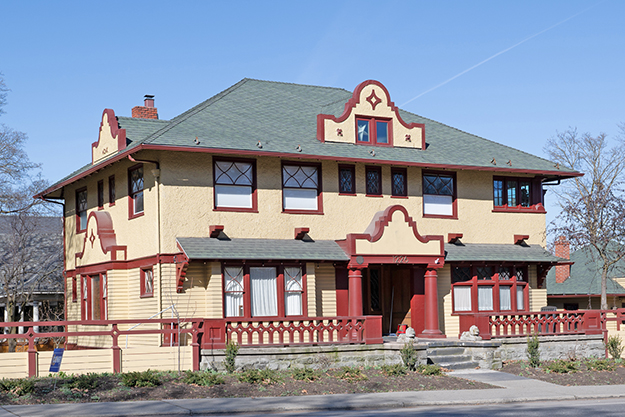
PhotoTitle: The Charles W. Winter House
PhotoAttribution: Spokane City/County Historic Preservation Office
Listing Status: Spokane Register
URL: http://properties.historicspokane.org/property/?PropertyID=1975
Display Marker: large_yellow
Title: Winter House
Description: Date Built: 1910
Architect: E.W. Morrison/A.L. Lundquist
Common Name: Charles W. Winter House
Aaron L. Lundquist, a noted contractor who built several homes throughout Spokane, built the house for Charles Winter, vice president of Spokane and Eastern Trust Company. The architect was Earl Morrison, whose other work includes a home at 1628 W. 9th. Several owners occupied the house between 1924 and 1947. In 1947 William Bartlett, parts manager for Reo Manufacturing, bought the house, owning it until 1989. The current owners, Sam and Calla Rodell, purchased the property in 1991.
Location: 47.64383, -117.4326
Address: 1226 South Cedar Street, Spokane WA 99204
PhotoURL:

PhotoTitle: The Charles W. Winter House
PhotoAttribution: Spokane City/County Historic Preservation Office
Listing Status: Spokane Register
URL: http://properties.historicspokane.org/property/?PropertyID=1975
Display Marker: large_yellow
ID: 337
Title: Witherspoon House
Description: Date Built: 1912
Architect: Charles R. Wood
Common Name: Archibald & Eda Witherspoon House
Perched on the top of a steep north-facing hillside, the Witherspoon House was built in 1912 as a large, imposing two-story home with creme-colored stucco cladding, arched windows, and a green Spanish tile roof. It is a fine example of the Italian Renaissance style. The home was custom-designed for dynamo Spokane business leader, banker, mining man, and attorney, Archibald W. Witherspoon, and his wife, Eda Mauseth Witherspoon, who lived with their three children at the property for 16 years during Witherspoon's most productive time of life. Prominently identified with the civic, business, and industrial life of Spokane, A. W. Witherspoon founded the law firm of Witherspoon, Witherspoon & Kelley (now Witherspoon, Kelley, Davenport & Toole), and was noted as one of the oldest members of the bar in Spokane during his career. Witherspoon had a great impact on Spokane business, achieving a reputation as an expert on corporate restructuring and reorganization, and was so well-respected by his peers and clients that he served on the boards of more than 75 corporations in the Inland Northwest.
Location: 47.6349, -117.39833
Address: 2124 South Rockwood Boulevard, Spokane WA 99203
PhotoURL: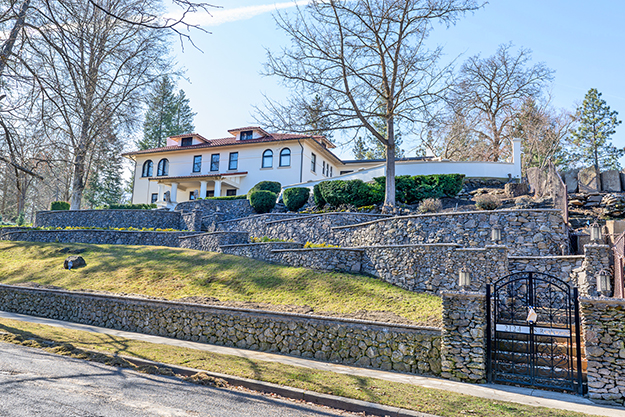
PhotoTitle: The Archibald and Eda Witherspoon House
PhotoAttribution: Spokane City/County Historic Preservation Office
Listing Status: Spokane Register, National Register
URL: http://properties.historicspokane.org/property/?PropertyID=1976
Display Marker: large_yellow
Title: Witherspoon House
Description: Date Built: 1912
Architect: Charles R. Wood
Common Name: Archibald & Eda Witherspoon House
Perched on the top of a steep north-facing hillside, the Witherspoon House was built in 1912 as a large, imposing two-story home with creme-colored stucco cladding, arched windows, and a green Spanish tile roof. It is a fine example of the Italian Renaissance style. The home was custom-designed for dynamo Spokane business leader, banker, mining man, and attorney, Archibald W. Witherspoon, and his wife, Eda Mauseth Witherspoon, who lived with their three children at the property for 16 years during Witherspoon's most productive time of life. Prominently identified with the civic, business, and industrial life of Spokane, A. W. Witherspoon founded the law firm of Witherspoon, Witherspoon & Kelley (now Witherspoon, Kelley, Davenport & Toole), and was noted as one of the oldest members of the bar in Spokane during his career. Witherspoon had a great impact on Spokane business, achieving a reputation as an expert on corporate restructuring and reorganization, and was so well-respected by his peers and clients that he served on the boards of more than 75 corporations in the Inland Northwest.
Location: 47.6349, -117.39833
Address: 2124 South Rockwood Boulevard, Spokane WA 99203
PhotoURL:

PhotoTitle: The Archibald and Eda Witherspoon House
PhotoAttribution: Spokane City/County Historic Preservation Office
Listing Status: Spokane Register, National Register
URL: http://properties.historicspokane.org/property/?PropertyID=1976
Display Marker: large_yellow
ID: 338
Title: Woman's Club of Spokane
Description: Date Built: 1911
Architect: Gustav Pehrson
Common Name: Woman's Club of Spokane
The Woman's Club of Spokane, located in the Ninth Avenue Historic District on Spokane lower South Hill, is architecturally significant as the work of master Spokane architect Gustav Albin Pehrson. Pehrson designed the building in 1928, incorporating the pre-existing Woman's Club, built in 1911, into the new building. The Woman's Club of Spokane, which still occupies the building, has been responding to the needs of women in the community since 1905, offering day care, education, and other services; the building is historically significant for its association with the organization.
Location: 47.64767, -117.43384
Address: 1428 West 9th Avenue, Spokane WA 99204
PhotoURL: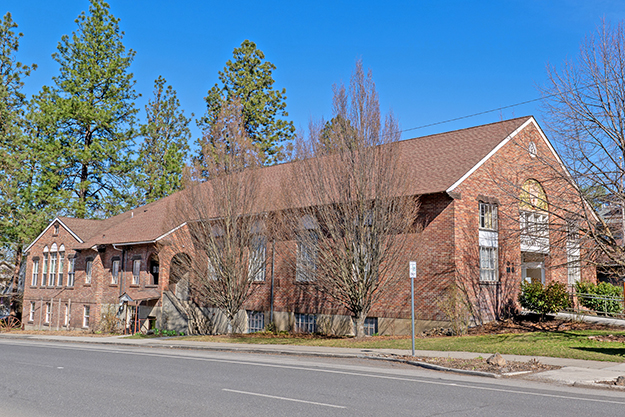
PhotoTitle: The Woman's Club of Spokane
PhotoAttribution: Spokane City/County Historic Preservation Office
Listing Status: Spokane Register, National Register
URL: http://properties.historicspokane.org/property/?PropertyID=1977
Display Marker: large_yellow
Title: Woman's Club of Spokane
Description: Date Built: 1911
Architect: Gustav Pehrson
Common Name: Woman's Club of Spokane
The Woman's Club of Spokane, located in the Ninth Avenue Historic District on Spokane lower South Hill, is architecturally significant as the work of master Spokane architect Gustav Albin Pehrson. Pehrson designed the building in 1928, incorporating the pre-existing Woman's Club, built in 1911, into the new building. The Woman's Club of Spokane, which still occupies the building, has been responding to the needs of women in the community since 1905, offering day care, education, and other services; the building is historically significant for its association with the organization.
Location: 47.64767, -117.43384
Address: 1428 West 9th Avenue, Spokane WA 99204
PhotoURL:

PhotoTitle: The Woman's Club of Spokane
PhotoAttribution: Spokane City/County Historic Preservation Office
Listing Status: Spokane Register, National Register
URL: http://properties.historicspokane.org/property/?PropertyID=1977
Display Marker: large_yellow
ID: 339
Title: Wood House
Description: Date Built: 1901
Architect: Unknown
Common Name: Lemuel & Cora Rose Wood House
Built in 1901 and 1922 respectively, the Lemuel & Cora Rose Wood House and garage are a textbook illustration of the Free Classic Queen Anne style, featuring such style elements as the home's irregular hip roof and two-story form, full-height curved wall tower and conical roof, and a covered wrap-around front porch. Colonial-influenced Free Classic details are apparent in the home's pedimented cross gables, modillioned boxed eaves, narrow-width horizontal wood clapboard siding, and round porch columns. Historically and architecturally significant, the well-preserved Wood House and garage have remained in use as a single-family residence for more than a century.
Location: 47.65528, -117.44855
Address: 2417 West Pacific Avenue, Spokane WA 99201
PhotoURL: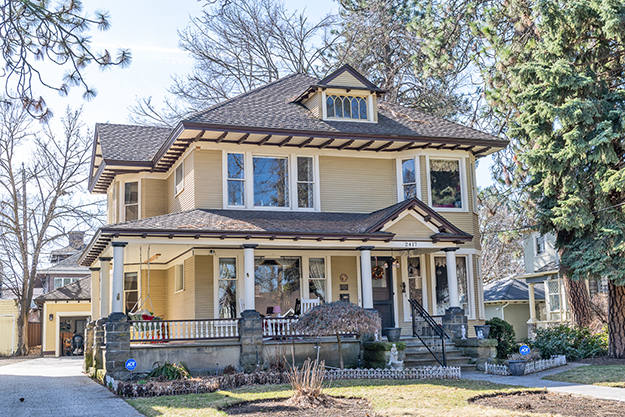
PhotoTitle: The Lemuel and Cora Rose Wood House
PhotoAttribution: Spokane City/County Historic Preservation Office
Listing Status: Spokane Register, National Register
URL: http://properties.historicspokane.org/property/?PropertyID=1978
Display Marker: large_yellow
Title: Wood House
Description: Date Built: 1901
Architect: Unknown
Common Name: Lemuel & Cora Rose Wood House
Built in 1901 and 1922 respectively, the Lemuel & Cora Rose Wood House and garage are a textbook illustration of the Free Classic Queen Anne style, featuring such style elements as the home's irregular hip roof and two-story form, full-height curved wall tower and conical roof, and a covered wrap-around front porch. Colonial-influenced Free Classic details are apparent in the home's pedimented cross gables, modillioned boxed eaves, narrow-width horizontal wood clapboard siding, and round porch columns. Historically and architecturally significant, the well-preserved Wood House and garage have remained in use as a single-family residence for more than a century.
Location: 47.65528, -117.44855
Address: 2417 West Pacific Avenue, Spokane WA 99201
PhotoURL:

PhotoTitle: The Lemuel and Cora Rose Wood House
PhotoAttribution: Spokane City/County Historic Preservation Office
Listing Status: Spokane Register, National Register
URL: http://properties.historicspokane.org/property/?PropertyID=1978
Display Marker: large_yellow
ID: 340
Title: Woodward Building
Description: Date Built: 1890
Architect: Herman Preusse
Common Name: Soulful Soups
The Woodward Building is one of the oldest commercial structures in downtown Spokane, dating to 1890, when the city was still rebuilding after the Great Fire of 1889. Herman Preusse, one of Spokane's earliest practicing and most prolific architects, designed the building for Minnesota real estate investor Lafayette Woodward. Preusse designed more buildings in the wake of the fire than any other architect, but relatively few of his downtown commercial buildings from this time period remain.
Location: 47.65855, -117.42135
Address: 117 North Howard Street, Spokane WA 99201
PhotoURL: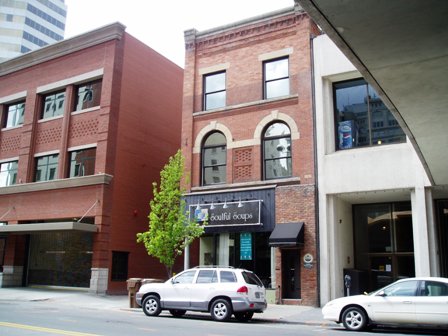
PhotoTitle: The Woodward Building
PhotoAttribution: Spokane City/County Historic Preservation Office
Listing Status: Spokane Register
URL: http://properties.historicspokane.org/property/?PropertyID=1979
Display Marker: large_yellow
Title: Woodward Building
Description: Date Built: 1890
Architect: Herman Preusse
Common Name: Soulful Soups
The Woodward Building is one of the oldest commercial structures in downtown Spokane, dating to 1890, when the city was still rebuilding after the Great Fire of 1889. Herman Preusse, one of Spokane's earliest practicing and most prolific architects, designed the building for Minnesota real estate investor Lafayette Woodward. Preusse designed more buildings in the wake of the fire than any other architect, but relatively few of his downtown commercial buildings from this time period remain.
Location: 47.65855, -117.42135
Address: 117 North Howard Street, Spokane WA 99201
PhotoURL:

PhotoTitle: The Woodward Building
PhotoAttribution: Spokane City/County Historic Preservation Office
Listing Status: Spokane Register
URL: http://properties.historicspokane.org/property/?PropertyID=1979
Display Marker: large_yellow
ID: 341
Title: Drumheller Springs
Description: Date Built: NA
Architect: Unknown
Common Name: Garry's Springs, Lone Pine, Spring Hill
Drumheller Springs was the site of both prehistoric and historic Indian encampments as well as a school established by Spokane Garry, a tribal leader who proved a skillful diplomat between the Spokane Indians and the early non-Indian settlers in the area. The springs were historically known as Garry's Springs and Lone Pine Springs; the current name derives from their association with Dan Drumheller, a pioneer stockman who established a slaughter house on the flat immediately below the spring in the late nineteenth century.
Location: 47.68707, -117.43964
Address: 1915 West Dalton Avenue, Spokane WA 99205
PhotoURL: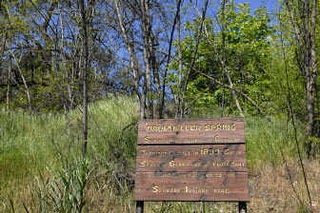
PhotoTitle: Drumheller Springs also known as Garry's Springs
PhotoAttribution: Spokane City/County Historic Preservation Office
Listing Status: N/A
URL: http://properties.historicspokane.org/property/?PropertyID=1782
Display Marker: large_yellow
Title: Drumheller Springs
Description: Date Built: NA
Architect: Unknown
Common Name: Garry's Springs, Lone Pine, Spring Hill
Drumheller Springs was the site of both prehistoric and historic Indian encampments as well as a school established by Spokane Garry, a tribal leader who proved a skillful diplomat between the Spokane Indians and the early non-Indian settlers in the area. The springs were historically known as Garry's Springs and Lone Pine Springs; the current name derives from their association with Dan Drumheller, a pioneer stockman who established a slaughter house on the flat immediately below the spring in the late nineteenth century.
Location: 47.68707, -117.43964
Address: 1915 West Dalton Avenue, Spokane WA 99205
PhotoURL:

PhotoTitle: Drumheller Springs also known as Garry's Springs
PhotoAttribution: Spokane City/County Historic Preservation Office
Listing Status: N/A
URL: http://properties.historicspokane.org/property/?PropertyID=1782
Display Marker: large_yellow
ID: 342
Title: Latah School
Description: Date Built: 1908
Architect: George Williams
Common Name: Union High School
Built in 1908 and 1920 respectively, the Latah School and its attached gymnasium is one of the oldest, largest and best preserved rural brick schoolhouses in the Palouse farming region in southeastern Spokane County. From 1908 to 1958, the schoolhouse symbolized Latah's commitment to education and community development, serving as the area's primary educational structure. Associated with the evolution of public education in Spokane County, the two-story, brick masonry Latah School reflects early 20th-century building practices advocated for schools, including fire-resistant building materials and a preferred schoolhouse design for graded classrooms. Besides providing a public education to children and students from Latah and surrounding communities, the Latah School served as a meeting place for political, religious, benevolent and other civic and social gatherings in the area.
Location: 47.283526, -117.156602
Address: 515 North Main Street, Latah WA 99018
PhotoURL: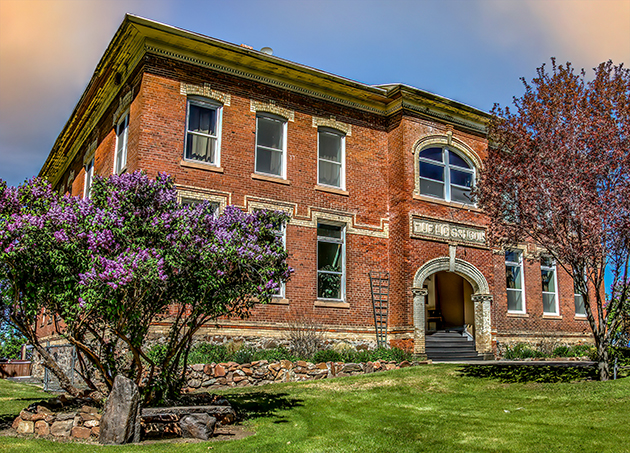
PhotoTitle: The Latah School
PhotoAttribution: Spokane City/County Historic Preservation Office
Listing Status: National Register
URL: http://properties.historicspokane.org/property/?PropertyID=2083
Display Marker: large_yellow
Title: Latah School
Description: Date Built: 1908
Architect: George Williams
Common Name: Union High School
Built in 1908 and 1920 respectively, the Latah School and its attached gymnasium is one of the oldest, largest and best preserved rural brick schoolhouses in the Palouse farming region in southeastern Spokane County. From 1908 to 1958, the schoolhouse symbolized Latah's commitment to education and community development, serving as the area's primary educational structure. Associated with the evolution of public education in Spokane County, the two-story, brick masonry Latah School reflects early 20th-century building practices advocated for schools, including fire-resistant building materials and a preferred schoolhouse design for graded classrooms. Besides providing a public education to children and students from Latah and surrounding communities, the Latah School served as a meeting place for political, religious, benevolent and other civic and social gatherings in the area.
Location: 47.283526, -117.156602
Address: 515 North Main Street, Latah WA 99018
PhotoURL:

PhotoTitle: The Latah School
PhotoAttribution: Spokane City/County Historic Preservation Office
Listing Status: National Register
URL: http://properties.historicspokane.org/property/?PropertyID=2083
Display Marker: large_yellow
ID: 343
Title: Marshall Bridge
Description: Date Built: 1949
Architect: W. L. Malony
Common Name: Bridge No. 2404
Completed in 1949, the Marshall Creek Bridge facilitated the crossing of the mainline rail yard and switching center of the Spokane, Portland and Seattle Railroad (SP&S), Union Pacific Railroad (UP), and Northern Pacific Railroad (NP) at the community of Marshall, Washington. The bridge spanned two tracks of the SP&S, two through tracks and two diverging tracks of the NP, space for two future through tracks, as well as provided a crossing of Marshall Creek. Before construction of the Marshall Creek Bridge, vehicular track crossing involved a circuitous route leading to an inadequate timber bridge over the creek. Although constructed on a Spokane County highway, the Marshall Creek Bridge was a Washington State Department of Highways Project.
Location: 47.566747, -117.493356
Address: 9613 Cheney-Spokane Road, Marshall WA 99224
PhotoURL: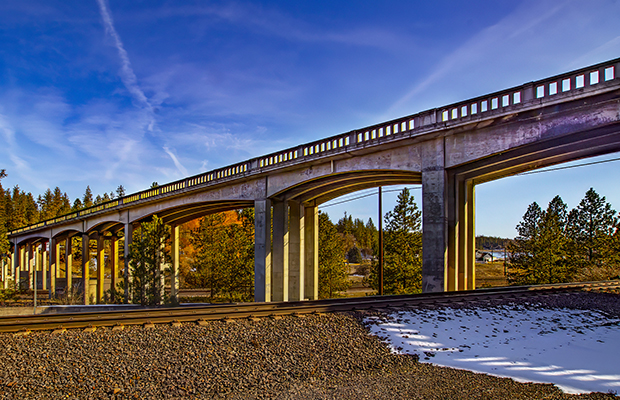
PhotoTitle: Marshall Bridge
PhotoAttribution: Spokane City/County Historic Preservation Office
Listing Status: National Register
URL: http://properties.historicspokane.org/property/?PropertyID=2084
Display Marker: large_yellow
Title: Marshall Bridge
Description: Date Built: 1949
Architect: W. L. Malony
Common Name: Bridge No. 2404
Completed in 1949, the Marshall Creek Bridge facilitated the crossing of the mainline rail yard and switching center of the Spokane, Portland and Seattle Railroad (SP&S), Union Pacific Railroad (UP), and Northern Pacific Railroad (NP) at the community of Marshall, Washington. The bridge spanned two tracks of the SP&S, two through tracks and two diverging tracks of the NP, space for two future through tracks, as well as provided a crossing of Marshall Creek. Before construction of the Marshall Creek Bridge, vehicular track crossing involved a circuitous route leading to an inadequate timber bridge over the creek. Although constructed on a Spokane County highway, the Marshall Creek Bridge was a Washington State Department of Highways Project.
Location: 47.566747, -117.493356
Address: 9613 Cheney-Spokane Road, Marshall WA 99224
PhotoURL:

PhotoTitle: Marshall Bridge
PhotoAttribution: Spokane City/County Historic Preservation Office
Listing Status: National Register
URL: http://properties.historicspokane.org/property/?PropertyID=2084
Display Marker: large_yellow
ID: 344
Title: Rosebush House
Description: Date Built: 1923-1928
Architect: Harold C. Whitehouse
Common Name: Walter Rosebush House
The Rosebush House is reminiscent of thatch-roofed cottages found in the countryside of Northern France and the home's unique garage resembles a Medieval-inspired carriage house. Built for Waldo Rosebush, general manager and treasurer of the Inland Empire Paper Company, the Rosebush House and garage were designed by Harold Whitehouse, one of Spokane's most accomplished architects. The English Cottage/Norman vernacular influence is typical of much of Whitehouse's work during the 1920s-1930s, but the design for the Rosebush property is singularly unusual and distinctive.
Location: 47.68748, -117.28504
Address: 3318 North Marguerite Road, Millwood WA 99212
PhotoURL: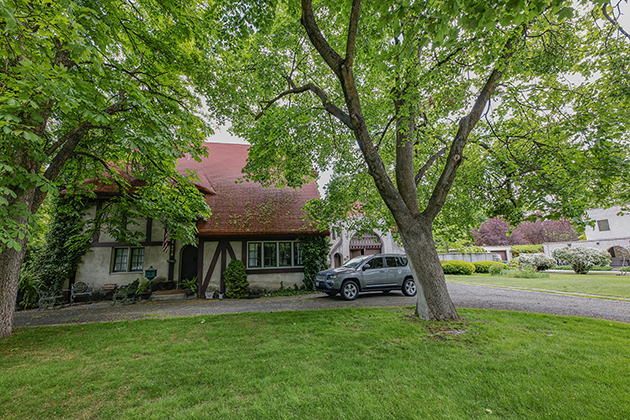
PhotoTitle: The Waldo Rosebush House and Garage
PhotoAttribution: Spokane City/County Historic Preservation Office
Listing Status: National Register
URL: http://properties.historicspokane.org/property/?PropertyID=2085
Display Marker: large_yellow
Title: Rosebush House
Description: Date Built: 1923-1928
Architect: Harold C. Whitehouse
Common Name: Walter Rosebush House
The Rosebush House is reminiscent of thatch-roofed cottages found in the countryside of Northern France and the home's unique garage resembles a Medieval-inspired carriage house. Built for Waldo Rosebush, general manager and treasurer of the Inland Empire Paper Company, the Rosebush House and garage were designed by Harold Whitehouse, one of Spokane's most accomplished architects. The English Cottage/Norman vernacular influence is typical of much of Whitehouse's work during the 1920s-1930s, but the design for the Rosebush property is singularly unusual and distinctive.
Location: 47.68748, -117.28504
Address: 3318 North Marguerite Road, Millwood WA 99212
PhotoURL:

PhotoTitle: The Waldo Rosebush House and Garage
PhotoAttribution: Spokane City/County Historic Preservation Office
Listing Status: National Register
URL: http://properties.historicspokane.org/property/?PropertyID=2085
Display Marker: large_yellow
ID: 345
Title: St. Paul Market
Description: Date Built: 1905
Architect: Julius J. Danielsen (builder)
Common Name: Batch Bakeshop
The St. Paul Market Building was built in 1905 at the corner of Dean Avenue and Chestnut Street and is one of the last of three commercial buildings built at this intersection in the West Central neighborhood. The property reflects the scale of the neighborhood's early 20th-century development as a commercial node within walking distance of many residential customers. Founded by Julius J. Danielsen, the St. Paul Market was a family-owned and operated butcher shop that occupied the building for roughly 31 years from 1905 to 1936. True to its form as a neighborhood business and gathering point, the Westminster Presbyterian Church was founded in the basement of the building in the spring of 1955. It was renamed to the Dean Avenue Market in the 1950s and remained a retail food business well into the 1960s.
Location: 47.66585, -117.44295
Address: 2023 Weast Dean Avenue, Spokane WA 99201
PhotoURL: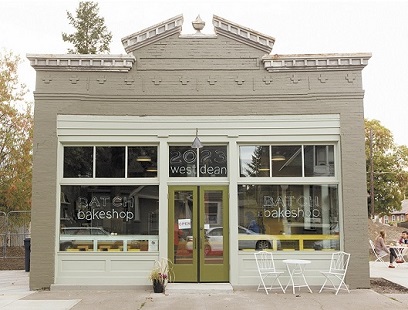
PhotoTitle: The St. Paul Market
PhotoAttribution: Young Kwak from the Pacific Northwest Inlander
Listing Status: Spokane Register
URL: http://properties.historicspokane.org/property/?PropertyID=1925
Display Marker: large_yellow
Title: St. Paul Market
Description: Date Built: 1905
Architect: Julius J. Danielsen (builder)
Common Name: Batch Bakeshop
The St. Paul Market Building was built in 1905 at the corner of Dean Avenue and Chestnut Street and is one of the last of three commercial buildings built at this intersection in the West Central neighborhood. The property reflects the scale of the neighborhood's early 20th-century development as a commercial node within walking distance of many residential customers. Founded by Julius J. Danielsen, the St. Paul Market was a family-owned and operated butcher shop that occupied the building for roughly 31 years from 1905 to 1936. True to its form as a neighborhood business and gathering point, the Westminster Presbyterian Church was founded in the basement of the building in the spring of 1955. It was renamed to the Dean Avenue Market in the 1950s and remained a retail food business well into the 1960s.
Location: 47.66585, -117.44295
Address: 2023 Weast Dean Avenue, Spokane WA 99201
PhotoURL:

PhotoTitle: The St. Paul Market
PhotoAttribution: Young Kwak from the Pacific Northwest Inlander
Listing Status: Spokane Register
URL: http://properties.historicspokane.org/property/?PropertyID=1925
Display Marker: large_yellow
ID: 346
Title: Alberthal Barn
Description: Date Built: ~1925
Style: Broken Gable
Believed to have been built by Siemus Riddle well before the 1950s, the Alberthal Barn was used in the 1960s by Jack Hopkins to store hay that was grown on the property. The pasture is used for grazing to this day. The barn has a broken gable roof shape, vertical siding and a hay hood.
Location: 47.941736, -117.504653
Address: 31411 North Monroe Road, Deer Park, WA 99006
PhotoURL: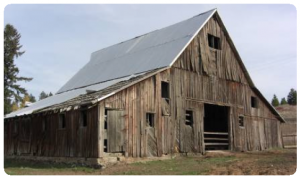
PhotoTitle: The Alberthal Barn
PhotoAttribution: Spokane City/County Historic Preservation Office
Listing Status: Heritage Barn Register
URL: http://www.historicspokane.org/spokane-county-heritage-barns
Display Marker: large_red
Title: Alberthal Barn
Description: Date Built: ~1925
Style: Broken Gable
Believed to have been built by Siemus Riddle well before the 1950s, the Alberthal Barn was used in the 1960s by Jack Hopkins to store hay that was grown on the property. The pasture is used for grazing to this day. The barn has a broken gable roof shape, vertical siding and a hay hood.
Location: 47.941736, -117.504653
Address: 31411 North Monroe Road, Deer Park, WA 99006
PhotoURL:

PhotoTitle: The Alberthal Barn
PhotoAttribution: Spokane City/County Historic Preservation Office
Listing Status: Heritage Barn Register
URL: http://www.historicspokane.org/spokane-county-heritage-barns
Display Marker: large_red
ID: 348
Title: Babb Farm
Description: Date Built: ~1900
Style: Dutch Barn
Common Name: A and B Farms
Albert Babb, one of the first settlers in the Rock Creek District, raised prize-winning Clydesdale draft horses on his homestead claim. In the spring, the Nez Perce often camped on the meadow near the Babb home on their way from Idaho to dig camas and other roots in Washington.
Location: 47.346076, -117.430960
Address: 1626 West Powers Road, Rosalia WA 99170
PhotoURL: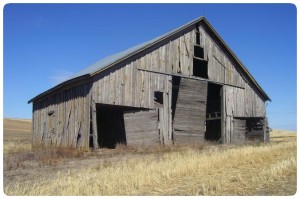
PhotoTitle: The Babb Farm
PhotoAttribution: Spokane City/County Historic Preservation Office
Listing Status: Heritage Barn Register
URL: http://www.historicspokane.org/spokane-county-heritage-barns
Display Marker: large_red
Title: Babb Farm
Description: Date Built: ~1900
Style: Dutch Barn
Common Name: A and B Farms
Albert Babb, one of the first settlers in the Rock Creek District, raised prize-winning Clydesdale draft horses on his homestead claim. In the spring, the Nez Perce often camped on the meadow near the Babb home on their way from Idaho to dig camas and other roots in Washington.
Location: 47.346076, -117.430960
Address: 1626 West Powers Road, Rosalia WA 99170
PhotoURL:

PhotoTitle: The Babb Farm
PhotoAttribution: Spokane City/County Historic Preservation Office
Listing Status: Heritage Barn Register
URL: http://www.historicspokane.org/spokane-county-heritage-barns
Display Marker: large_red
ID: 360
Title: Hildenbrandt Ranch
Description: Date Built: 1890
Style: Saltbox
Common Name: Tawasentha Ranch
While the original builder is unknown, Irvin L. Hildenbrandt purchased the farm in 1902 and raised dairy cows, eventually shifting to the raising and boarding of horses. Hildenbrandt named the barn “Tawasentha” after the poem “The Song of Hiawatha” by Henry Wadsorth Longfellow. In that poem he read: In the vale of Tawasentha, In the green and silent valley, By the pleasant water – coures, Dwelt the singer Nawadaha. Hildenbrandt found this a fitting homage.
Location: 47.826035, -117.374886
Address: 2429 East Colbert Road, Colbert WA 99005
PhotoURL: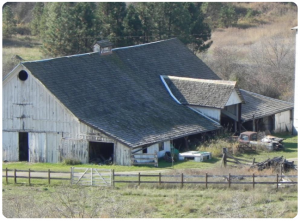
PhotoTitle: The Hildenbrandt Ranch
PhotoAttribution: Spokane City/County Historic Preservation Office
Listing Status: Heritage Barn Register
URL: http://www.historicspokane.org/spokane-county-heritage-barns
Display Marker: large_red
Title: Hildenbrandt Ranch
Description: Date Built: 1890
Style: Saltbox
Common Name: Tawasentha Ranch
While the original builder is unknown, Irvin L. Hildenbrandt purchased the farm in 1902 and raised dairy cows, eventually shifting to the raising and boarding of horses. Hildenbrandt named the barn “Tawasentha” after the poem “The Song of Hiawatha” by Henry Wadsorth Longfellow. In that poem he read: In the vale of Tawasentha, In the green and silent valley, By the pleasant water – coures, Dwelt the singer Nawadaha. Hildenbrandt found this a fitting homage.
Location: 47.826035, -117.374886
Address: 2429 East Colbert Road, Colbert WA 99005
PhotoURL:

PhotoTitle: The Hildenbrandt Ranch
PhotoAttribution: Spokane City/County Historic Preservation Office
Listing Status: Heritage Barn Register
URL: http://www.historicspokane.org/spokane-county-heritage-barns
Display Marker: large_red
ID: 347
Title: Henry Allice Farm
Description: Date Built: 1900
Style: Gable/ Gable-on-Hip
Common Name: Larry and Bonnie Busse Farm
Henry Allice homesteaded the property in the 1880s. He and his father cut the trees on site, aged them one year and then cut them into lumber. A barn raising crew framed the barn using notches and pegs. While building his home and logs were drying, Allice lived in the barn. The barn has a traditional gable roof, vertical siding, milking shed and silo.
Location: 47.741366, -117.584937
Address: 9003 North Garfield Road, Spokane, WA 99224
PhotoURL: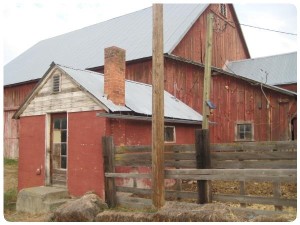
PhotoTitle: The Henry Allice Farm
PhotoAttribution: Spokane City/County Historic Preservation Office
Listing Status: Heritage Barn Register
URL: http://www.historicspokane.org/spokane-county-heritage-barns
Display Marker: large_red
Title: Henry Allice Farm
Description: Date Built: 1900
Style: Gable/ Gable-on-Hip
Common Name: Larry and Bonnie Busse Farm
Henry Allice homesteaded the property in the 1880s. He and his father cut the trees on site, aged them one year and then cut them into lumber. A barn raising crew framed the barn using notches and pegs. While building his home and logs were drying, Allice lived in the barn. The barn has a traditional gable roof, vertical siding, milking shed and silo.
Location: 47.741366, -117.584937
Address: 9003 North Garfield Road, Spokane, WA 99224
PhotoURL:

PhotoTitle: The Henry Allice Farm
PhotoAttribution: Spokane City/County Historic Preservation Office
Listing Status: Heritage Barn Register
URL: http://www.historicspokane.org/spokane-county-heritage-barns
Display Marker: large_red
ID: 350
Title: Carlstrom Barn
Description: Date Built: ~1910
Style: Saltbox
Believed to have been built by W. Black around 1910, the Carlstrom Barn has a saltbox style roof, board and batten siding and hay loft. Black sold the land to the Wilsons who signed the deed in 1933.
Location: 47.705375, -117.238627
Address: 12305 East Wellesley Avenue, Spokane WA 99216
PhotoURL: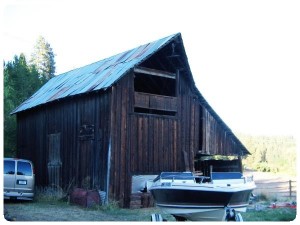
PhotoTitle: The Carlstrom Barn
PhotoAttribution: Spokane City/County Historic Preservation Office
Listing Status: Heritage Barn Register
URL: http://www.historicspokane.org/spokane-county-heritage-barns
Display Marker: large_red
Title: Carlstrom Barn
Description: Date Built: ~1910
Style: Saltbox
Believed to have been built by W. Black around 1910, the Carlstrom Barn has a saltbox style roof, board and batten siding and hay loft. Black sold the land to the Wilsons who signed the deed in 1933.
Location: 47.705375, -117.238627
Address: 12305 East Wellesley Avenue, Spokane WA 99216
PhotoURL:

PhotoTitle: The Carlstrom Barn
PhotoAttribution: Spokane City/County Historic Preservation Office
Listing Status: Heritage Barn Register
URL: http://www.historicspokane.org/spokane-county-heritage-barns
Display Marker: large_red
ID: 351
Title: Champion Barn
Description: Date Built: ~1903
Style: Gable
Common Name: Long Barn Farm
Built around 1903 along with a farmhouse, the Champion Barn operated as a dairy until the 1950s when it was converted into a chicken and egg farm. It was also the base of W. Salsbury’s geological survey business.
Location: 47.638071, -117.342355
Address: 1902 South Glenrose Road, Spokane WA 99223
PhotoURL: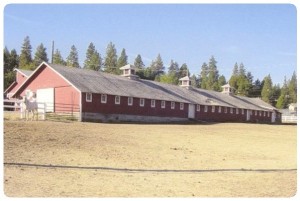
PhotoTitle: The Champion Barn
PhotoAttribution: Spokane City/County Historic Preservation Office
Listing Status: Heritage Barn Register
URL: http://www.historicspokane.org/spokane-county-heritage-barns
Display Marker: large_red
Title: Champion Barn
Description: Date Built: ~1903
Style: Gable
Common Name: Long Barn Farm
Built around 1903 along with a farmhouse, the Champion Barn operated as a dairy until the 1950s when it was converted into a chicken and egg farm. It was also the base of W. Salsbury’s geological survey business.
Location: 47.638071, -117.342355
Address: 1902 South Glenrose Road, Spokane WA 99223
PhotoURL:

PhotoTitle: The Champion Barn
PhotoAttribution: Spokane City/County Historic Preservation Office
Listing Status: Heritage Barn Register
URL: http://www.historicspokane.org/spokane-county-heritage-barns
Display Marker: large_red
ID: 353
Title: Copenhaver Barn
Description: Date Built: ~1955
Style: Western
Common Name: Phinney Farm
Believed to have been built by Deb Copenhaver in the 1950s, the barn is the last remaining “large” barn in the Liberty Lake area. Copenhaver was a national rodeo champion in the 1950s and raised cattle and horses on the farm. Besides acting as a ranch, the farm also had a racing track for quarter horses and a large arena for rodeo events and practice that was used by many cowboys in the area.
Location: 47.685457, -117.043447
Address: 3107 North Idaho Road, Liberty Lake WA 99019
PhotoURL: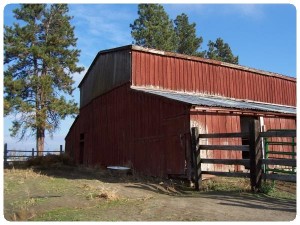
PhotoTitle: The Copenhaver Barn
PhotoAttribution: Spokane City/County Historic Preservation Office
Listing Status: Heritage Barn Register
URL: http://www.historicspokane.org/spokane-county-heritage-barns
Display Marker: large_red
Title: Copenhaver Barn
Description: Date Built: ~1955
Style: Western
Common Name: Phinney Farm
Believed to have been built by Deb Copenhaver in the 1950s, the barn is the last remaining “large” barn in the Liberty Lake area. Copenhaver was a national rodeo champion in the 1950s and raised cattle and horses on the farm. Besides acting as a ranch, the farm also had a racing track for quarter horses and a large arena for rodeo events and practice that was used by many cowboys in the area.
Location: 47.685457, -117.043447
Address: 3107 North Idaho Road, Liberty Lake WA 99019
PhotoURL:

PhotoTitle: The Copenhaver Barn
PhotoAttribution: Spokane City/County Historic Preservation Office
Listing Status: Heritage Barn Register
URL: http://www.historicspokane.org/spokane-county-heritage-barns
Display Marker: large_red
ID: 362
Title: Victor Hyslop Barn
Description: Date Built: 1926
Style: Gothic
Thomas Hyslop arrived in Spokane in 1879 and began farming the land in Reardan. His youngest son, Victor, took over the farming operations in 1912 and erected the rare, green-colored barn in July of 1926. At this time, the primary purpose of the large barn was for storage of loose hay and oats and feeding and harnessing horses. Ultimately, as farming practices changed, hay was no longer raised and the barn was modernized.
Location: 47.713762, -117.777161
Address: 6209 North Coulee Hite Road, Reardan WA 99029
PhotoURL: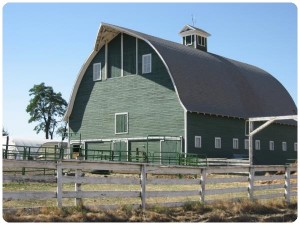
PhotoTitle: The Victor Hyslop Barn
PhotoAttribution: Spokane City/County Historic Preservation Office
Listing Status: Heritage Barn Register
URL: http://www.historicspokane.org/spokane-county-heritage-barns
Display Marker: large_red
Title: Victor Hyslop Barn
Description: Date Built: 1926
Style: Gothic
Thomas Hyslop arrived in Spokane in 1879 and began farming the land in Reardan. His youngest son, Victor, took over the farming operations in 1912 and erected the rare, green-colored barn in July of 1926. At this time, the primary purpose of the large barn was for storage of loose hay and oats and feeding and harnessing horses. Ultimately, as farming practices changed, hay was no longer raised and the barn was modernized.
Location: 47.713762, -117.777161
Address: 6209 North Coulee Hite Road, Reardan WA 99029
PhotoURL:

PhotoTitle: The Victor Hyslop Barn
PhotoAttribution: Spokane City/County Historic Preservation Office
Listing Status: Heritage Barn Register
URL: http://www.historicspokane.org/spokane-county-heritage-barns
Display Marker: large_red
ID: 363
Title: Johnson Homestead
Description: Date Built: ~1910
Style: English Gambrel
Historic Name: Christian Johnson Homestead
Christian Johnson was a Norwegian merchant marine who immigrated to the US and homesteaded 330 acres in the area. Of all the buildings he built on his farm, only the barn and a silo remain. The barn was used for a dairy production and cattle ranching.
Location: 47.985774, -117.308273
Address: 36119 North Milan Elk Road, Chattaroy WA 99003
PhotoURL: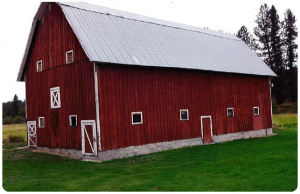
PhotoTitle: The Johnson Homestead Barn
PhotoAttribution: Spokane City/County Historic Preservation Office
Listing Status: Heritage Barn Register
URL: http://www.historicspokane.org/spokane-county-heritage-barns
Display Marker: large_red
Title: Johnson Homestead
Description: Date Built: ~1910
Style: English Gambrel
Historic Name: Christian Johnson Homestead
Christian Johnson was a Norwegian merchant marine who immigrated to the US and homesteaded 330 acres in the area. Of all the buildings he built on his farm, only the barn and a silo remain. The barn was used for a dairy production and cattle ranching.
Location: 47.985774, -117.308273
Address: 36119 North Milan Elk Road, Chattaroy WA 99003
PhotoURL:

PhotoTitle: The Johnson Homestead Barn
PhotoAttribution: Spokane City/County Historic Preservation Office
Listing Status: Heritage Barn Register
URL: http://www.historicspokane.org/spokane-county-heritage-barns
Display Marker: large_red
ID: 364
Title: Koch Farm
Description: Date Built: ~1910
Style: Gable
The barn originally held a variety of animals and crops including cattle, horses, chickens, pigs and hay. The Koch Farm also has a bunk house and brick shop on the property that are believed to have been built by the Civilian Conservation Corps.
Location: 47.720803, -117.236809
Address: 12426 East Bigelow Gulch Road, Spokane WA 99217
PhotoURL: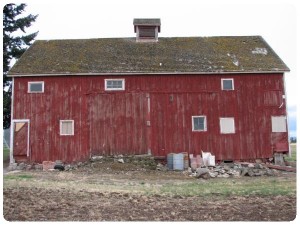
PhotoTitle: The Koch Farm
PhotoAttribution: Spokane City/County Historic Preservation Office
Listing Status: Heritage Barn Register
URL: http://www.historicspokane.org/spokane-county-heritage-barns
Display Marker: large_red
Title: Koch Farm
Description: Date Built: ~1910
Style: Gable
The barn originally held a variety of animals and crops including cattle, horses, chickens, pigs and hay. The Koch Farm also has a bunk house and brick shop on the property that are believed to have been built by the Civilian Conservation Corps.
Location: 47.720803, -117.236809
Address: 12426 East Bigelow Gulch Road, Spokane WA 99217
PhotoURL:

PhotoTitle: The Koch Farm
PhotoAttribution: Spokane City/County Historic Preservation Office
Listing Status: Heritage Barn Register
URL: http://www.historicspokane.org/spokane-county-heritage-barns
Display Marker: large_red
ID: 349
Title: A. L. Bradley Barn
Description: Date Built: 1904
Style: Dutch Gambrel
Common Name: Walking Circle L Ranch
The barn originally held 40 milk cows, named after ladies in the community, and had their names stenciled on the boards above each stanchion. The large hay loft with a high door and cable track was designed for loose hay that grew on the surrounding flats.
Location: 47.435092, -117.097909
Address: 23310 E Hoxie Road, Rockford WA 99030
PhotoURL: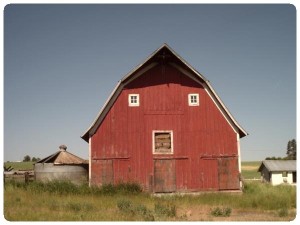
PhotoTitle: The A. L. Bradley Barn
PhotoAttribution: Spokane City/County Historic Preservation Office
Listing Status: Heritage Barn Register
URL: http://www.historicspokane.org/spokane-county-heritage-barns
Display Marker: large_red
Title: A. L. Bradley Barn
Description: Date Built: 1904
Style: Dutch Gambrel
Common Name: Walking Circle L Ranch
The barn originally held 40 milk cows, named after ladies in the community, and had their names stenciled on the boards above each stanchion. The large hay loft with a high door and cable track was designed for loose hay that grew on the surrounding flats.
Location: 47.435092, -117.097909
Address: 23310 E Hoxie Road, Rockford WA 99030
PhotoURL:

PhotoTitle: The A. L. Bradley Barn
PhotoAttribution: Spokane City/County Historic Preservation Office
Listing Status: Heritage Barn Register
URL: http://www.historicspokane.org/spokane-county-heritage-barns
Display Marker: large_red
ID: 354
Title: Louis Domrese Barn
Description: Date Built: 1948
Style: Saltbox
Common Name: Rocky Hill Farm
During the 1930s, the Rocky Hill property was owned by Anna P. James and in the early 1940s, it was purchased by Louis Domrese. He hired a carpenter to build a modest size barn to house milking cows and cattle. Domrese also stored oats, wheat and alfalfa in the barn before taking them to the mill. The barn has vertical wooden siding, which is used in a charming fishbone pattern on the doors.
Location: 47.672059, -117.068469
Address: 25000 East Mission Avenue, Liberty Lake WA 99019
PhotoURL: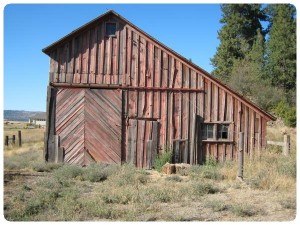
PhotoTitle: The Louis Domrese Barn
PhotoAttribution: Spokane City/County Historic Preservation Office
Listing Status: Heritage Barn Register
URL: http://www.historicspokane.org/spokane-county-heritage-barns
Display Marker: large_red
Title: Louis Domrese Barn
Description: Date Built: 1948
Style: Saltbox
Common Name: Rocky Hill Farm
During the 1930s, the Rocky Hill property was owned by Anna P. James and in the early 1940s, it was purchased by Louis Domrese. He hired a carpenter to build a modest size barn to house milking cows and cattle. Domrese also stored oats, wheat and alfalfa in the barn before taking them to the mill. The barn has vertical wooden siding, which is used in a charming fishbone pattern on the doors.
Location: 47.672059, -117.068469
Address: 25000 East Mission Avenue, Liberty Lake WA 99019
PhotoURL:

PhotoTitle: The Louis Domrese Barn
PhotoAttribution: Spokane City/County Historic Preservation Office
Listing Status: Heritage Barn Register
URL: http://www.historicspokane.org/spokane-county-heritage-barns
Display Marker: large_red
ID: 366
Title: Middleburg Barn
Description: Date Built: 1916
Style: Round
Common Name: Deep Creek Farm
Originally owned by Mr. Middleburg, the round barn at Deep Creek Farm was first used as a dairy barn. The cows stood in a circle around the center silo, which was a standard feature on farms beginning in the 1890s, and were milked with their feet resting on a cork floor. The Middleburg Barn is the only listed round barn in Spokane County.
Location: 47.666855, -117.693588
Address: 811 North Deep Creek Road, Medical Lake WA 99022
PhotoURL: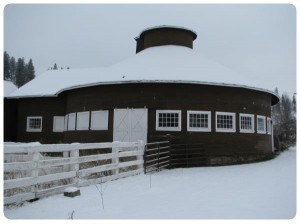
PhotoTitle: The Middleburg Barn
PhotoAttribution: Spokane City/County Historic Preservation Office
Listing Status: Heritage Barn Register
URL: http://www.historicspokane.org/spokane-county-heritage-barns
Display Marker: large_red
Title: Middleburg Barn
Description: Date Built: 1916
Style: Round
Common Name: Deep Creek Farm
Originally owned by Mr. Middleburg, the round barn at Deep Creek Farm was first used as a dairy barn. The cows stood in a circle around the center silo, which was a standard feature on farms beginning in the 1890s, and were milked with their feet resting on a cork floor. The Middleburg Barn is the only listed round barn in Spokane County.
Location: 47.666855, -117.693588
Address: 811 North Deep Creek Road, Medical Lake WA 99022
PhotoURL:

PhotoTitle: The Middleburg Barn
PhotoAttribution: Spokane City/County Historic Preservation Office
Listing Status: Heritage Barn Register
URL: http://www.historicspokane.org/spokane-county-heritage-barns
Display Marker: large_red
ID: 352
Title: George Clark Barn
Description: Date Built: 1900
Style: Gable
Common Name: Hengen Farms
George Clark, the original homesteader, built the barn after living 16 years on the property. The square barn then passed to the Imohoffs, the Cochran family and eventually the Knuths who bought the “Old Clark Place” in 1913. The barn has an unusual siding design in which the boards are painted red and the battens are painted white.
Location: 47.410093, -117.358193
Address: 3508 East Spangle Waverly Road, Spangle WA 99031
PhotoURL: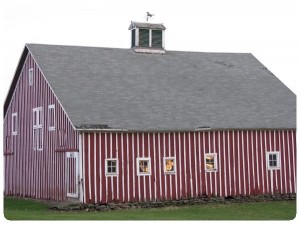
PhotoTitle: The George Clark Barn
PhotoAttribution: Spokane City/County Historic Preservation Office
Listing Status: Heritage Barn Register
URL: http://www.historicspokane.org/spokane-county-heritage-barns
Display Marker: large_red
Title: George Clark Barn
Description: Date Built: 1900
Style: Gable
Common Name: Hengen Farms
George Clark, the original homesteader, built the barn after living 16 years on the property. The square barn then passed to the Imohoffs, the Cochran family and eventually the Knuths who bought the “Old Clark Place” in 1913. The barn has an unusual siding design in which the boards are painted red and the battens are painted white.
Location: 47.410093, -117.358193
Address: 3508 East Spangle Waverly Road, Spangle WA 99031
PhotoURL:

PhotoTitle: The George Clark Barn
PhotoAttribution: Spokane City/County Historic Preservation Office
Listing Status: Heritage Barn Register
URL: http://www.historicspokane.org/spokane-county-heritage-barns
Display Marker: large_red
ID: 357
Title: Girvin Barn
Description: Date Built: 1904
Style: Saltbox
The square Girvin Barn, built in 1904 along with the house and machine shed, was mainly used to store hay. The lean-to acted as a milking station and there are both horse and cow stalls on the lower level of the barn.
Location: 47.589660, -117.318398
Address: 6323 East Jamieson Road, Spokane WA 99223
PhotoURL: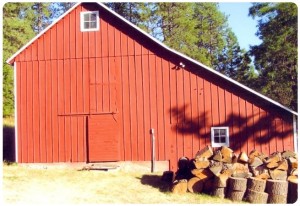
PhotoTitle: The Girvin Barn
PhotoAttribution: Spokane City/County Historic Preservation Office
Listing Status: Heritage Barn Register
URL: http://www.historicspokane.org/spokane-county-heritage-barns
Display Marker: large_red
Title: Girvin Barn
Description: Date Built: 1904
Style: Saltbox
The square Girvin Barn, built in 1904 along with the house and machine shed, was mainly used to store hay. The lean-to acted as a milking station and there are both horse and cow stalls on the lower level of the barn.
Location: 47.589660, -117.318398
Address: 6323 East Jamieson Road, Spokane WA 99223
PhotoURL:

PhotoTitle: The Girvin Barn
PhotoAttribution: Spokane City/County Historic Preservation Office
Listing Status: Heritage Barn Register
URL: http://www.historicspokane.org/spokane-county-heritage-barns
Display Marker: large_red
ID: 355
Title: Farr Barn
Description: Date Built: pre-1929
Style: Dutch Gambrel
Common Name: Pierce Barn
Believed to have been built by the Farr family at the turn of the century, the rectangular barn is very traditionally styled with red paint, white trim, Dutch gambrel roof and common gable-end window placed high on the facade. The Farr Barn remains in good condition.
Location: 47.660725, -117.273755
Address: 404 North Farr Road, Spokane Valley WA 99206
PhotoURL: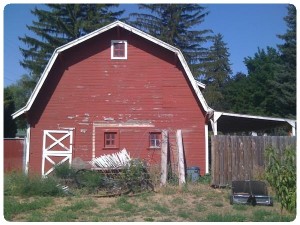
PhotoTitle: The Farr Barn
PhotoAttribution: Spokane City/County Historic Preservation Office
Listing Status: Heritage Barn Register
URL: http://www.historicspokane.org/spokane-county-heritage-barns
Display Marker: large_red
Title: Farr Barn
Description: Date Built: pre-1929
Style: Dutch Gambrel
Common Name: Pierce Barn
Believed to have been built by the Farr family at the turn of the century, the rectangular barn is very traditionally styled with red paint, white trim, Dutch gambrel roof and common gable-end window placed high on the facade. The Farr Barn remains in good condition.
Location: 47.660725, -117.273755
Address: 404 North Farr Road, Spokane Valley WA 99206
PhotoURL:

PhotoTitle: The Farr Barn
PhotoAttribution: Spokane City/County Historic Preservation Office
Listing Status: Heritage Barn Register
URL: http://www.historicspokane.org/spokane-county-heritage-barns
Display Marker: large_red
ID: 359
Title: Heathdale Ranch
Description: Date Built: 1908
Style: Dutch Gambrel
Common Name: Latta's-WS Ranch
The large, double-cupola barn was built by Sylvester Heath as part of his Morgan Horse Ranch. The property passed next to Phil Bloom and then the Sheard family. The Sheards raised wheat, oats, barley, peas and lentils. The barn was used to store hay for the herd of cattle they raised.
Location: 47.554899, -117.206205
Address: 14610 East Belmont Road, Mica WA 99023
PhotoURL: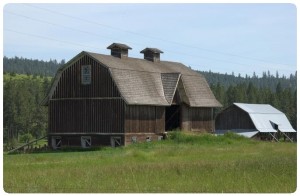
PhotoTitle: The Heathdale Ranch
PhotoAttribution: Spokane City/County Historic Preservation Office
Listing Status: Heritage Barn Register
URL: http://www.historicspokane.org/spokane-county-heritage-barns
Display Marker: large_red
Title: Heathdale Ranch
Description: Date Built: 1908
Style: Dutch Gambrel
Common Name: Latta's-WS Ranch
The large, double-cupola barn was built by Sylvester Heath as part of his Morgan Horse Ranch. The property passed next to Phil Bloom and then the Sheard family. The Sheards raised wheat, oats, barley, peas and lentils. The barn was used to store hay for the herd of cattle they raised.
Location: 47.554899, -117.206205
Address: 14610 East Belmont Road, Mica WA 99023
PhotoURL:

PhotoTitle: The Heathdale Ranch
PhotoAttribution: Spokane City/County Historic Preservation Office
Listing Status: Heritage Barn Register
URL: http://www.historicspokane.org/spokane-county-heritage-barns
Display Marker: large_red
ID: 356
Title: Finn-Beaven Barn
Description: Date Built: ~1930
Style: Gable
The small Finn-Beaven Barn, built with the material available on site, is made of hand-hewn timber supported by field stones. It sits on the edge of a small, seasonal creek that flows into Owen Lake. Once a dairy farm, there are remnants of stanchions used to hold cows during milking in the barn.
Location: 47.932245, -117.365684
Address: 30211 North Regal Road, Chattaroy WA 99003
PhotoURL: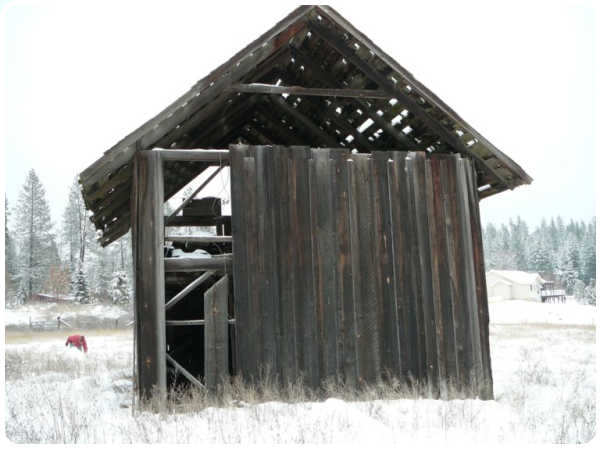
PhotoTitle: The Finn-Beaven Barn
PhotoAttribution: Spokane City/County Historic Preservation Office
Listing Status: Heritage Barn Register
URL: http://www.historicspokane.org/spokane-county-heritage-barns
Display Marker: large_red
Title: Finn-Beaven Barn
Description: Date Built: ~1930
Style: Gable
The small Finn-Beaven Barn, built with the material available on site, is made of hand-hewn timber supported by field stones. It sits on the edge of a small, seasonal creek that flows into Owen Lake. Once a dairy farm, there are remnants of stanchions used to hold cows during milking in the barn.
Location: 47.932245, -117.365684
Address: 30211 North Regal Road, Chattaroy WA 99003
PhotoURL:

PhotoTitle: The Finn-Beaven Barn
PhotoAttribution: Spokane City/County Historic Preservation Office
Listing Status: Heritage Barn Register
URL: http://www.historicspokane.org/spokane-county-heritage-barns
Display Marker: large_red
ID: 358
Title: James Hays Barn
Description: Date Built: 1902
Style: Dutch Gambrel
Common Name: Denny Land & Livestock
The impressive James Hays Barn has several interesting design elements. Hays built the barn over a waterway and with a bridge so that wagons could drive through the barn and unload hay without turning around. It is two stories and housed many teams of horses and possibly field hands that worked on the farm.
Location: 47.367678, -117.239113
Address: 12311 East Hays Road, Fairfield WA 99012
PhotoURL: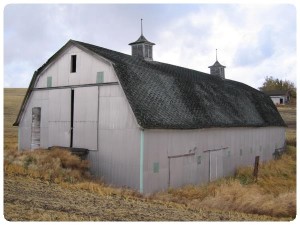
PhotoTitle: The James Hays Barn
PhotoAttribution: Spokane City/County Historic Preservation Office
Listing Status: Heritage Barn Register
URL: http://www.historicspokane.org/spokane-county-heritage-barns
Display Marker: large_red
Title: James Hays Barn
Description: Date Built: 1902
Style: Dutch Gambrel
Common Name: Denny Land & Livestock
The impressive James Hays Barn has several interesting design elements. Hays built the barn over a waterway and with a bridge so that wagons could drive through the barn and unload hay without turning around. It is two stories and housed many teams of horses and possibly field hands that worked on the farm.
Location: 47.367678, -117.239113
Address: 12311 East Hays Road, Fairfield WA 99012
PhotoURL:

PhotoTitle: The James Hays Barn
PhotoAttribution: Spokane City/County Historic Preservation Office
Listing Status: Heritage Barn Register
URL: http://www.historicspokane.org/spokane-county-heritage-barns
Display Marker: large_red
ID: 365
Title: Clyde Krick Farm
Description: Date Built: ~1937
Style: Broken Gable/ English Gambrel
Common Name: Quarter Circle 7 L Ranch
Clyde E. Krick, a dirt farmer who planted alfalfa and hay, built the large, western style barn in 1937. Krick and group of Mennonites that had a team of horses raised the roof. Krick was a co-founder of the Spokane County Search and Rescue and raised bloodhounds on the property. A faint X can still be seen on the side of the barn that signaled helicopters to land and pick up the hounds.
Location: 47.995471, -117.503279
Address: 37411 North Grove Road, Deer Park WA 99006
PhotoURL: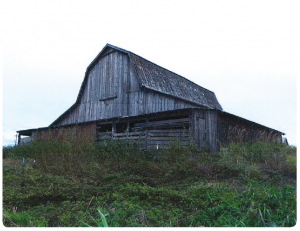
PhotoTitle: The Clyde Krick Farm
PhotoAttribution: Spokane City/County Historic Preservation Office
Listing Status: Heritage Barn Register
URL: http://www.historicspokane.org/spokane-county-heritage-barns
Display Marker: large_red
Title: Clyde Krick Farm
Description: Date Built: ~1937
Style: Broken Gable/ English Gambrel
Common Name: Quarter Circle 7 L Ranch
Clyde E. Krick, a dirt farmer who planted alfalfa and hay, built the large, western style barn in 1937. Krick and group of Mennonites that had a team of horses raised the roof. Krick was a co-founder of the Spokane County Search and Rescue and raised bloodhounds on the property. A faint X can still be seen on the side of the barn that signaled helicopters to land and pick up the hounds.
Location: 47.995471, -117.503279
Address: 37411 North Grove Road, Deer Park WA 99006
PhotoURL:

PhotoTitle: The Clyde Krick Farm
PhotoAttribution: Spokane City/County Historic Preservation Office
Listing Status: Heritage Barn Register
URL: http://www.historicspokane.org/spokane-county-heritage-barns
Display Marker: large_red
ID: 361
Title: Hutton Settlement
Description: Date Built: 1917-1920
Style: Dutch Gambrel
Historic Name: Hutton Settlement Children's Home Barn
The barn, along with the entire campus, was constructed by L. W. Hutton with Whitehouse-Price as the architect. The barn was built to house a dairy herd for the purpose of helping feed the nearly eighty children who lived at the Home.
Location: 47.702839, -117.265580
Address: 9907 East Wellesley Avenue, Spokane WA 99206
PhotoURL: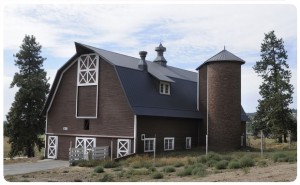
PhotoTitle: The Hutton Settlment Barn
PhotoAttribution: Spokane City/County Historic Preservation Office
Listing Status: Heritage Barn Register
URL: http://www.historicspokane.org/spokane-county-heritage-barns
Display Marker: large_red
Title: Hutton Settlement
Description: Date Built: 1917-1920
Style: Dutch Gambrel
Historic Name: Hutton Settlement Children's Home Barn
The barn, along with the entire campus, was constructed by L. W. Hutton with Whitehouse-Price as the architect. The barn was built to house a dairy herd for the purpose of helping feed the nearly eighty children who lived at the Home.
Location: 47.702839, -117.265580
Address: 9907 East Wellesley Avenue, Spokane WA 99206
PhotoURL:

PhotoTitle: The Hutton Settlment Barn
PhotoAttribution: Spokane City/County Historic Preservation Office
Listing Status: Heritage Barn Register
URL: http://www.historicspokane.org/spokane-county-heritage-barns
Display Marker: large_red
ID: 367
Title: Miller Farm
Description: Date Built: ~1911
Style: Gable
Historic Name: Hamilton and Mary Miller Farm
After arriving in the Rockford area in 1878, Hamilton and Mary Miller cleared and farmed the land and raised several children on their farm. One of their children, William, took over the property around 1911 and erected the Dutch-style barn. The faded-red barn now sits just off a busy highway, a far cry from its original setting.
Location: 47.438645, -117.087428
Address: 23510 East Hoxie Road, Rockford WA 99030
PhotoURL: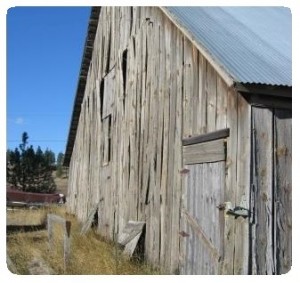
PhotoTitle: The Miller Farm
PhotoAttribution: Spokane City/County Historic Preservation Office
Listing Status: Heritage Barn Register
URL: http://www.historicspokane.org/spokane-county-heritage-barns
Display Marker: large_red
Title: Miller Farm
Description: Date Built: ~1911
Style: Gable
Historic Name: Hamilton and Mary Miller Farm
After arriving in the Rockford area in 1878, Hamilton and Mary Miller cleared and farmed the land and raised several children on their farm. One of their children, William, took over the property around 1911 and erected the Dutch-style barn. The faded-red barn now sits just off a busy highway, a far cry from its original setting.
Location: 47.438645, -117.087428
Address: 23510 East Hoxie Road, Rockford WA 99030
PhotoURL:

PhotoTitle: The Miller Farm
PhotoAttribution: Spokane City/County Historic Preservation Office
Listing Status: Heritage Barn Register
URL: http://www.historicspokane.org/spokane-county-heritage-barns
Display Marker: large_red
ID: 368
Title: Mittelstaedt Farm
Description: Date Built: 1905
Style: English Gambrel
While the original builder is not known, Eber Bly owned the farm until the 1940s when he sold it to the Weyen family. It was at this point that the metal roof was installed and the cupola removed. The Weyens sold the farm to the Mittelstaedt family who used the upper part of the barn for hay storage and lower part for sheep and hogs.
Location: 47.629785, -117.778004
Address: 2424 South Coulee Hite Road, Reardan WA 99029
PhotoURL: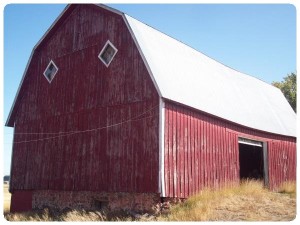
PhotoTitle: The Mittelstaedt Farm
PhotoAttribution: Spokane City/County Historic Preservation Office
Listing Status: Heritage Barn Register
URL: http://www.historicspokane.org/spokane-county-heritage-barns
Display Marker: large_red
Title: Mittelstaedt Farm
Description: Date Built: 1905
Style: English Gambrel
While the original builder is not known, Eber Bly owned the farm until the 1940s when he sold it to the Weyen family. It was at this point that the metal roof was installed and the cupola removed. The Weyens sold the farm to the Mittelstaedt family who used the upper part of the barn for hay storage and lower part for sheep and hogs.
Location: 47.629785, -117.778004
Address: 2424 South Coulee Hite Road, Reardan WA 99029
PhotoURL:

PhotoTitle: The Mittelstaedt Farm
PhotoAttribution: Spokane City/County Historic Preservation Office
Listing Status: Heritage Barn Register
URL: http://www.historicspokane.org/spokane-county-heritage-barns
Display Marker: large_red
ID: 370
Title: Nelson Barn
Description: Date Built: 1916
Style: Dutch Gambrel
Common Name: Reifenbergers Barn
Mr. and Mrs. Nelson lived on the property starting in 1917 until Mrs. Nelson sold the farm to Ralph and Gerry Reifenberger in 1958. The rectangular wooden barn has a gambrel roof, horizontal siding, hay hood and is adorned with a weather vane.
Location: 47.362804, -117.095962
Address: 22815 East Truax Road, Fairfield WA 99012
PhotoURL: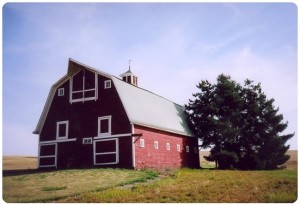
PhotoTitle: The Nelson Barn
PhotoAttribution: Spokane City/County Historic Preservation Office
Listing Status: Heritage Barn Register
URL: http://www.historicspokane.org/spokane-county-heritage-barns
Display Marker: large_red
Title: Nelson Barn
Description: Date Built: 1916
Style: Dutch Gambrel
Common Name: Reifenbergers Barn
Mr. and Mrs. Nelson lived on the property starting in 1917 until Mrs. Nelson sold the farm to Ralph and Gerry Reifenberger in 1958. The rectangular wooden barn has a gambrel roof, horizontal siding, hay hood and is adorned with a weather vane.
Location: 47.362804, -117.095962
Address: 22815 East Truax Road, Fairfield WA 99012
PhotoURL:

PhotoTitle: The Nelson Barn
PhotoAttribution: Spokane City/County Historic Preservation Office
Listing Status: Heritage Barn Register
URL: http://www.historicspokane.org/spokane-county-heritage-barns
Display Marker: large_red
ID: 371
Title: Painter Barn
Description: Date Built: 1916
Style: Dutch Gambrel
Historic Name: Parlan and Mary Painter Barn
Benjamin and Melvina Painter purchased the 160 acre homestead of David and Emma Bonney in 1882. Their son, Parland, and his wife, Mary, owned the farm from 1908 to 1930 built the barn in 1916. Windows were a luxury for the barn but Parlan wanted natural light into the barn and some of the original 1916 glass remains.
Location: 47.308858, -117.511513
Address: 6803 West Cheney Plaza Road, Cheney WA 99004
PhotoURL: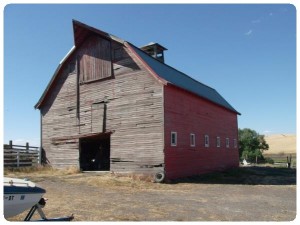
PhotoTitle: The Painter Barn
PhotoAttribution: Spokane City/County Historic Preservation Office
Listing Status: Heritage Barn Register
URL: http://www.historicspokane.org/spokane-county-heritage-barns
Display Marker: large_red
Title: Painter Barn
Description: Date Built: 1916
Style: Dutch Gambrel
Historic Name: Parlan and Mary Painter Barn
Benjamin and Melvina Painter purchased the 160 acre homestead of David and Emma Bonney in 1882. Their son, Parland, and his wife, Mary, owned the farm from 1908 to 1930 built the barn in 1916. Windows were a luxury for the barn but Parlan wanted natural light into the barn and some of the original 1916 glass remains.
Location: 47.308858, -117.511513
Address: 6803 West Cheney Plaza Road, Cheney WA 99004
PhotoURL:

PhotoTitle: The Painter Barn
PhotoAttribution: Spokane City/County Historic Preservation Office
Listing Status: Heritage Barn Register
URL: http://www.historicspokane.org/spokane-county-heritage-barns
Display Marker: large_red
ID: 369
Title: Tom Morrow Barn
Description: Date Built: 1900
Style: English Gambrel
Common Name: Hamilton Family Farm
Tom Morrow, who homesteaded the farm, built the barn and all of the other buildings on the property. Morrow lived on the farm until the late 1960s when he and his wife passed away. The farm was then given to the Catholic Church and later purchased by the Hamilton family.
Location: 47.748819, -117.454168
Address: 9923 North 5 Mile Road, Spokane WA 99208
PhotoURL: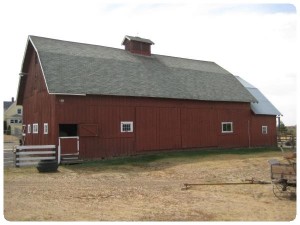
PhotoTitle: The Tom Morrow Barn
PhotoAttribution: Spokane City/County Historic Preservation Office
Listing Status: Heritage Barn Register
URL: http://www.historicspokane.org/spokane-county-heritage-barns
Display Marker: large_red
Title: Tom Morrow Barn
Description: Date Built: 1900
Style: English Gambrel
Common Name: Hamilton Family Farm
Tom Morrow, who homesteaded the farm, built the barn and all of the other buildings on the property. Morrow lived on the farm until the late 1960s when he and his wife passed away. The farm was then given to the Catholic Church and later purchased by the Hamilton family.
Location: 47.748819, -117.454168
Address: 9923 North 5 Mile Road, Spokane WA 99208
PhotoURL:

PhotoTitle: The Tom Morrow Barn
PhotoAttribution: Spokane City/County Historic Preservation Office
Listing Status: Heritage Barn Register
URL: http://www.historicspokane.org/spokane-county-heritage-barns
Display Marker: large_red
ID: 372
Title: Palmer Farm
Description: Date Built: ~1905
Style: Gable
Common Name: Palmer-Abbeal-Sprague Farmhouse
Originally developed by Eben Palmer in the 1890s, the farm eventually sold to John and Rebecca Abbeal around 1907. The Abbeals, in turn, sold it to their nephes, John and Vernon Sprague. During this time the barn was in constant use for cows and chickens.
Location: 47.738247, -117.315868
Address: 6616 East Orchard Road, Spokane WA 99217
PhotoURL: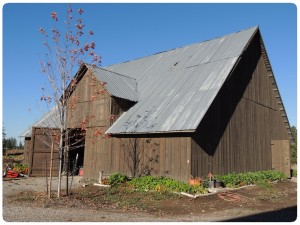
PhotoTitle: The Palmer-Abbeal-Sprague Farmhouse
PhotoAttribution: Spokane City/County Historic Preservation Office
Listing Status: Heritage Barn Register
URL: http://www.historicspokane.org/spokane-county-heritage-barns
Display Marker: large_red
Title: Palmer Farm
Description: Date Built: ~1905
Style: Gable
Common Name: Palmer-Abbeal-Sprague Farmhouse
Originally developed by Eben Palmer in the 1890s, the farm eventually sold to John and Rebecca Abbeal around 1907. The Abbeals, in turn, sold it to their nephes, John and Vernon Sprague. During this time the barn was in constant use for cows and chickens.
Location: 47.738247, -117.315868
Address: 6616 East Orchard Road, Spokane WA 99217
PhotoURL:

PhotoTitle: The Palmer-Abbeal-Sprague Farmhouse
PhotoAttribution: Spokane City/County Historic Preservation Office
Listing Status: Heritage Barn Register
URL: http://www.historicspokane.org/spokane-county-heritage-barns
Display Marker: large_red
ID: 373
Title: Philleo Barn
Description: Date Built: ~1920
Style: Dutch Gambrel
Common Name: McGourin Farms
The Philleo Barn located in the northern Palouse region has been in the McGourin family for five generations. Built as a replacement for an earlier structure that burned, the barn housed the teams of horses used to farm wheat.
Location: 47.398277, -117.465212
Address: 28101 South Philleo Lake Road, Spangle WA 99031
PhotoURL: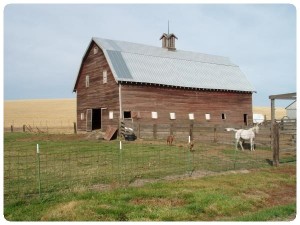
PhotoTitle: The Philleo Barn
PhotoAttribution: Spokane City/County Historic Preservation Office
Listing Status: Heritage Barn Register
URL: http://www.historicspokane.org/spokane-county-heritage-barns
Display Marker: large_red
Title: Philleo Barn
Description: Date Built: ~1920
Style: Dutch Gambrel
Common Name: McGourin Farms
The Philleo Barn located in the northern Palouse region has been in the McGourin family for five generations. Built as a replacement for an earlier structure that burned, the barn housed the teams of horses used to farm wheat.
Location: 47.398277, -117.465212
Address: 28101 South Philleo Lake Road, Spangle WA 99031
PhotoURL:

PhotoTitle: The Philleo Barn
PhotoAttribution: Spokane City/County Historic Preservation Office
Listing Status: Heritage Barn Register
URL: http://www.historicspokane.org/spokane-county-heritage-barns
Display Marker: large_red
ID: 374
Title: Red Barn Farm
Description: Date Built: ~1908
Style: Gable
Although little is known about its history, the aptly named Red Barn was built around 1908 and was used to store alfalfa, wheat and other crops grown on the farm. The rectangular barn has vertical wood siding, a wooden roof and a concrete and basalt foundation.
Location: 47.597024, -117.354536
Address: 6216 South Waneta Road, Spokane WA 99223
PhotoURL: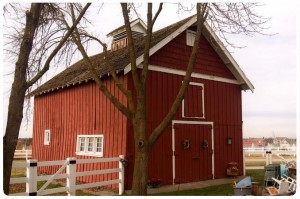
PhotoTitle: The Red Barn Farm
PhotoAttribution: Spokane City/County Historic Preservation Office
Listing Status: Heritage Barn Register
URL: http://www.historicspokane.org/spokane-county-heritage-barns
Display Marker: large_red
Title: Red Barn Farm
Description: Date Built: ~1908
Style: Gable
Although little is known about its history, the aptly named Red Barn was built around 1908 and was used to store alfalfa, wheat and other crops grown on the farm. The rectangular barn has vertical wood siding, a wooden roof and a concrete and basalt foundation.
Location: 47.597024, -117.354536
Address: 6216 South Waneta Road, Spokane WA 99223
PhotoURL:

PhotoTitle: The Red Barn Farm
PhotoAttribution: Spokane City/County Historic Preservation Office
Listing Status: Heritage Barn Register
URL: http://www.historicspokane.org/spokane-county-heritage-barns
Display Marker: large_red
ID: 375
Title: John Schneider Barn
Description: Built Date: 1922
Style: Crib/ Saltbox
Common Name: Jaclin Farms
Purchased by John B. and Clara Schneider in 1901, the farm is still owned by members of the Schneider family. The log crib barn was built by John M. and Olga Schneider in 1922 with the help of neighbors and friends.
Location: 47.904138, -117.274361
Address: 9715 East Tallman Road, Chattaroy WA 99003
PhotoURL: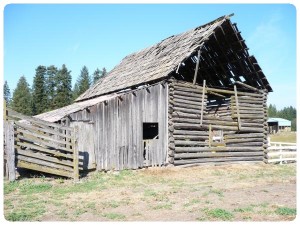
PhotoTitle: The John Schneider Barn
PhotoAttribution: Spokane City/County Historic Preservation Office
Listing Status: Heritage Barn Register
URL: http://www.historicspokane.org/spokane-county-heritage-barns
Display Marker: large_red
Title: John Schneider Barn
Description: Built Date: 1922
Style: Crib/ Saltbox
Common Name: Jaclin Farms
Purchased by John B. and Clara Schneider in 1901, the farm is still owned by members of the Schneider family. The log crib barn was built by John M. and Olga Schneider in 1922 with the help of neighbors and friends.
Location: 47.904138, -117.274361
Address: 9715 East Tallman Road, Chattaroy WA 99003
PhotoURL:

PhotoTitle: The John Schneider Barn
PhotoAttribution: Spokane City/County Historic Preservation Office
Listing Status: Heritage Barn Register
URL: http://www.historicspokane.org/spokane-county-heritage-barns
Display Marker: large_red
ID: 377
Title: Stuart Farm
Description: Date Built: 1916
Style: Gable-on-Hip/ Western
Originally the large barn on Stuart Farm housed horses on one side and had a milking area on the other. In 1955 an addition was added to the south side of the barn that housed eleven more stanchions for milking. When the farm was being maintained as a dairy farm, all of the cows had feminine, lady names befitting their personality or lineage.
Location: 48.035587, -117.276776
Address: 41908 North Dunn Road, Elk WA 99009
PhotoURL: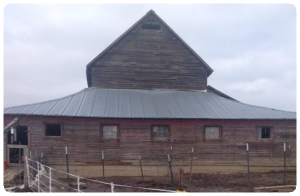
PhotoTitle: The Stuart Farm
PhotoAttribution: Spokane City/County Historic Preservation Office
Listing Status: Heritage Barn Register
URL: http://www.historicspokane.org/spokane-county-heritage-barns
Display Marker: large_red
Title: Stuart Farm
Description: Date Built: 1916
Style: Gable-on-Hip/ Western
Originally the large barn on Stuart Farm housed horses on one side and had a milking area on the other. In 1955 an addition was added to the south side of the barn that housed eleven more stanchions for milking. When the farm was being maintained as a dairy farm, all of the cows had feminine, lady names befitting their personality or lineage.
Location: 48.035587, -117.276776
Address: 41908 North Dunn Road, Elk WA 99009
PhotoURL:

PhotoTitle: The Stuart Farm
PhotoAttribution: Spokane City/County Historic Preservation Office
Listing Status: Heritage Barn Register
URL: http://www.historicspokane.org/spokane-county-heritage-barns
Display Marker: large_red
ID: 388
Title: Dwight's Linden
Description: Age: ~100
Height: 72 feet
Species: Hungarian Linden
A fragrant tree in bloom, the Hungarian linden is an exceptional specimen that can be found in the John A. Finch Arboretum. This historic tree is also documented to have been planted by Daniel H. Dwight, one of Spokane's important pioneers and developers. Dwight owned the land prior to the City's 1912 purchase and it was on Garden Springs Creek that he built his summer cottage, Brookside.
Location: 47.641216, -117.465453
Address: 3404 West Woodland Boulevard, Spokane WA 99224
PhotoURL: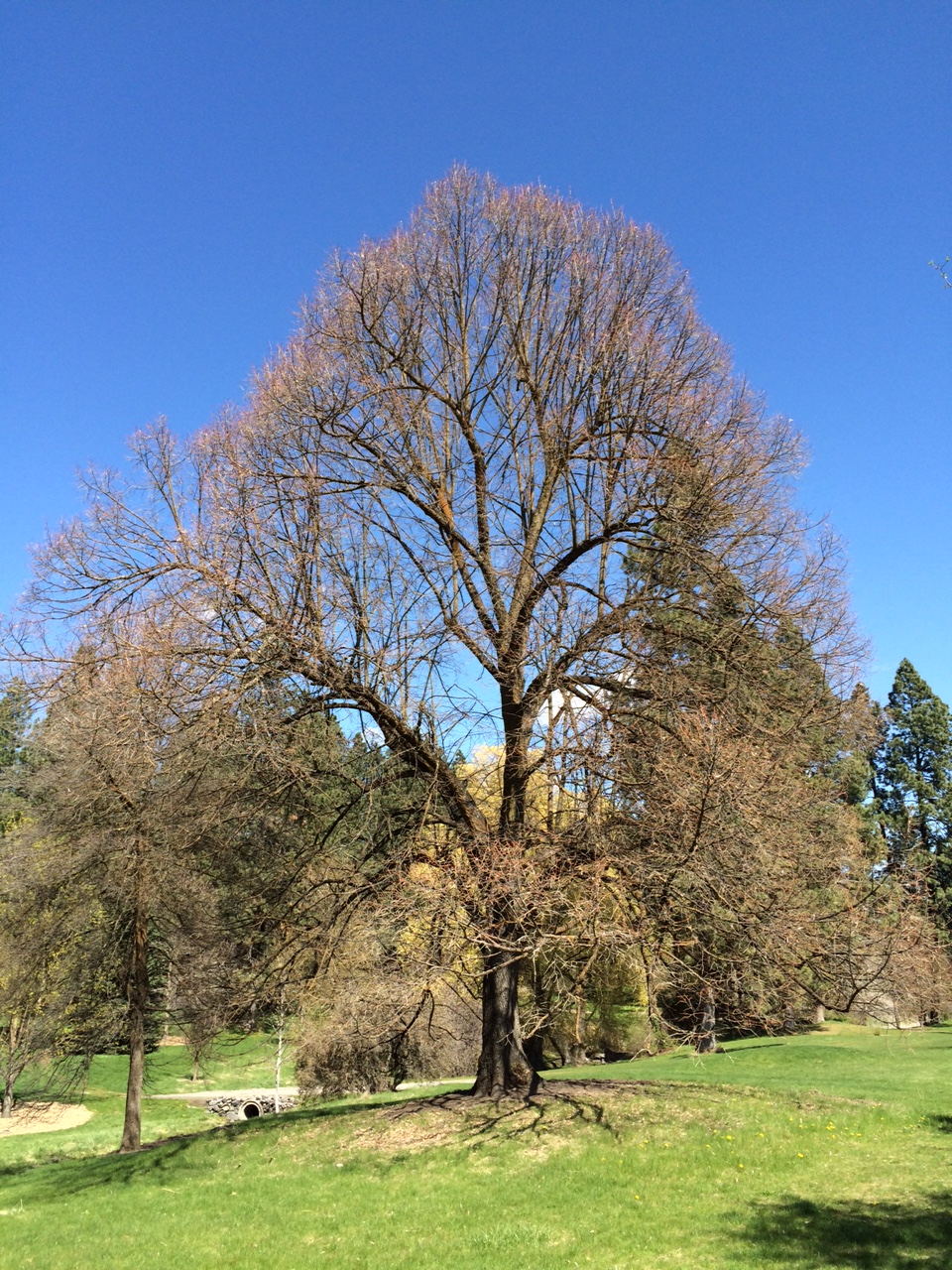
PhotoTitle: The Hungarian Linden
PhotoAttribution: City of Spokane Parks and Recreation
Listing Status: Spokane Heritage Tree Register
URL: https://my.spokanecity.org/urbanforestry/programs/heritage-tree/
Display Marker: large_green
Title: Dwight's Linden
Description: Age: ~100
Height: 72 feet
Species: Hungarian Linden
A fragrant tree in bloom, the Hungarian linden is an exceptional specimen that can be found in the John A. Finch Arboretum. This historic tree is also documented to have been planted by Daniel H. Dwight, one of Spokane's important pioneers and developers. Dwight owned the land prior to the City's 1912 purchase and it was on Garden Springs Creek that he built his summer cottage, Brookside.
Location: 47.641216, -117.465453
Address: 3404 West Woodland Boulevard, Spokane WA 99224
PhotoURL:

PhotoTitle: The Hungarian Linden
PhotoAttribution: City of Spokane Parks and Recreation
Listing Status: Spokane Heritage Tree Register
URL: https://my.spokanecity.org/urbanforestry/programs/heritage-tree/
Display Marker: large_green
ID: 393
Title: The Ancient Ones
Description: Age: 175+
Height: 110 feet
Species: Douglas Fir
This collection of three ancient Douglas firs were likely established prior to Spokane being settled. They are very near Chief Garry's last known camp site and would have been impressive trees even at that time.
Location: 47.653599, -117.478865
Address: Indian Canyon Park, South Indian Canyon Drive, Spokane WA 99224
PhotoURL: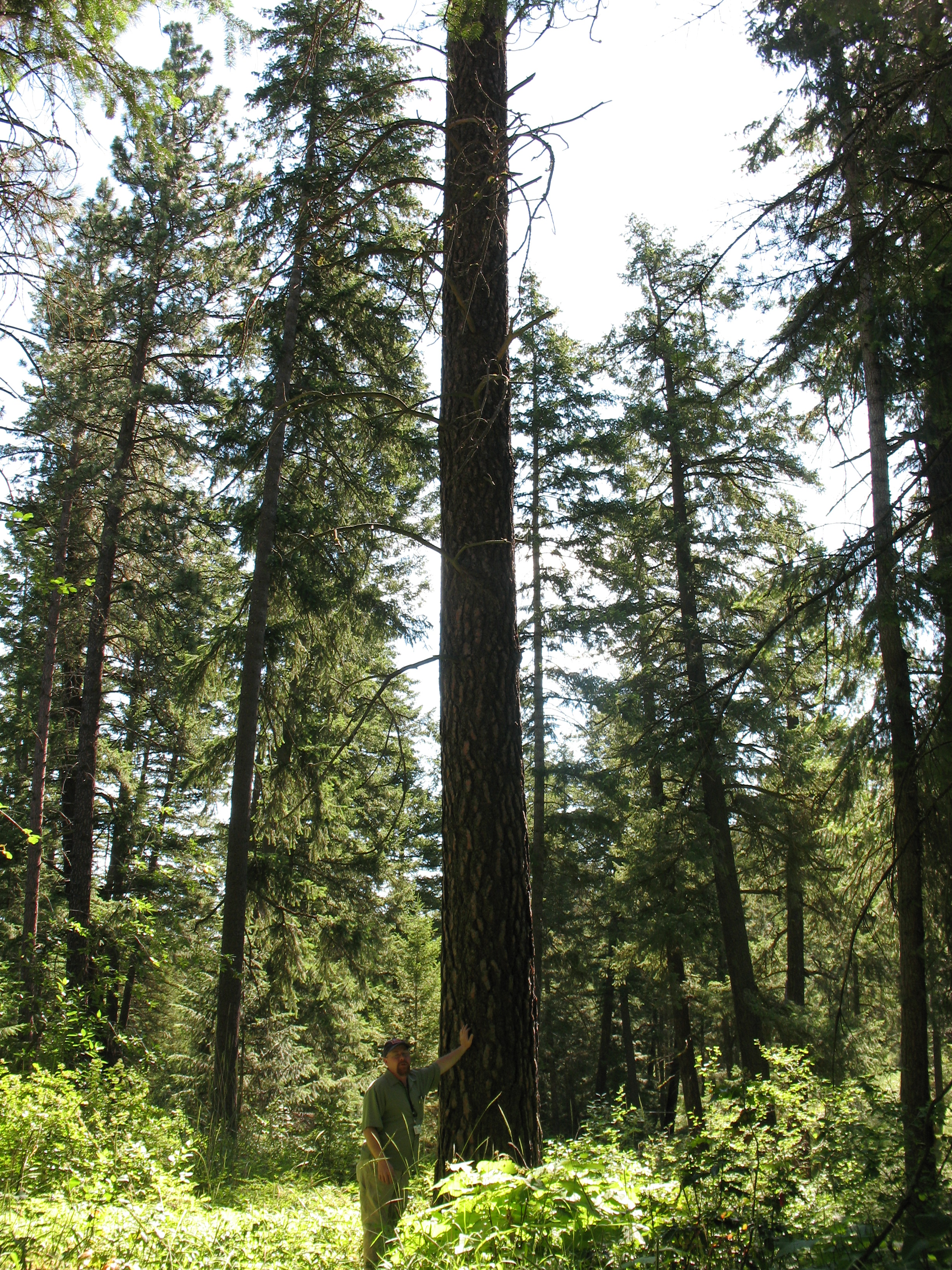
PhotoTitle: Douglas Fir in Indian Canyon Park
PhotoAttribution: City of Spokane Parks and Recreation
Listing Status: Spokane Heritage Tree Register
URL: https://my.spokanecity.org/urbanforestry/programs/heritage-tree/
Display Marker: large_green
Title: The Ancient Ones
Description: Age: 175+
Height: 110 feet
Species: Douglas Fir
This collection of three ancient Douglas firs were likely established prior to Spokane being settled. They are very near Chief Garry's last known camp site and would have been impressive trees even at that time.
Location: 47.653599, -117.478865
Address: Indian Canyon Park, South Indian Canyon Drive, Spokane WA 99224
PhotoURL:

PhotoTitle: Douglas Fir in Indian Canyon Park
PhotoAttribution: City of Spokane Parks and Recreation
Listing Status: Spokane Heritage Tree Register
URL: https://my.spokanecity.org/urbanforestry/programs/heritage-tree/
Display Marker: large_green
ID: 376
Title: Stoneman Farm
Description: Date Built: 1898
Style: Broken Gable
Common Name: R.E.W. Christensen Farms
The Stoneman Farm was first homesteaded in the late 1880s and most of the current structures on the farm including the large, red barn were built at that same time. The farm was used as a dairy farm by the original builders until 1953 when the Christensen family purchased it. It is now used to store dry hay and shelter horses, chickens and rabbits.
Location: 47.760861, -117.335430
Address: 11210 North Fairview Road, Mead WA 99021
PhotoURL: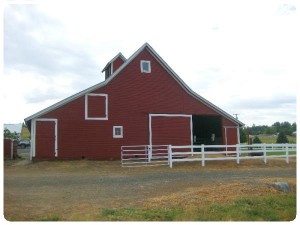
PhotoTitle: The Stoneman Farm
PhotoAttribution: Spokane City/County Historic Preservation Office
Listing Status: Heritage Barn Register
URL: http://www.historicspokane.org/spokane-county-heritage-barns
Display Marker: large_red
Title: Stoneman Farm
Description: Date Built: 1898
Style: Broken Gable
Common Name: R.E.W. Christensen Farms
The Stoneman Farm was first homesteaded in the late 1880s and most of the current structures on the farm including the large, red barn were built at that same time. The farm was used as a dairy farm by the original builders until 1953 when the Christensen family purchased it. It is now used to store dry hay and shelter horses, chickens and rabbits.
Location: 47.760861, -117.335430
Address: 11210 North Fairview Road, Mead WA 99021
PhotoURL:

PhotoTitle: The Stoneman Farm
PhotoAttribution: Spokane City/County Historic Preservation Office
Listing Status: Heritage Barn Register
URL: http://www.historicspokane.org/spokane-county-heritage-barns
Display Marker: large_red
ID: 378
Title: The Swallow's Nest
Description: Date Built: ~1930
Style: Dutch Gambrel/ Saltbox
Believed to have been built by Swedish craftsmen, the Swallow’s Nest was used as the main storage place for hay when the land was a large dairy farm. In the 1940s the barn passed to Ralph and Adelle Durheim who took great care of the property. The Swallow’s Nest, now owned by the Moore family, has an interesting combination of a Dutch gambrel roof and milking shed.
Location: 48.019265, -117.494411
Address: 5410 West Bridges Road, Deer Park WA 99006
PhotoURL: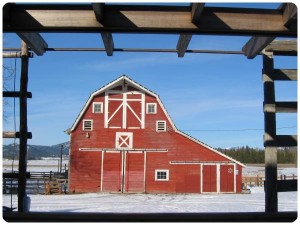
PhotoTitle: The Swallow's Nest
PhotoAttribution: Spokane City/County Historic Preservation Office
Listing Status: Heritage Barn Register
URL: http://www.historicspokane.org/spokane-county-heritage-barns
Display Marker: large_red
Title: The Swallow's Nest
Description: Date Built: ~1930
Style: Dutch Gambrel/ Saltbox
Believed to have been built by Swedish craftsmen, the Swallow’s Nest was used as the main storage place for hay when the land was a large dairy farm. In the 1940s the barn passed to Ralph and Adelle Durheim who took great care of the property. The Swallow’s Nest, now owned by the Moore family, has an interesting combination of a Dutch gambrel roof and milking shed.
Location: 48.019265, -117.494411
Address: 5410 West Bridges Road, Deer Park WA 99006
PhotoURL:

PhotoTitle: The Swallow's Nest
PhotoAttribution: Spokane City/County Historic Preservation Office
Listing Status: Heritage Barn Register
URL: http://www.historicspokane.org/spokane-county-heritage-barns
Display Marker: large_red
ID: 391
Title: Chief Garry Park Champion
Description: Height: 56 feet
Species: Sycamore Maple
Known for its colorful display in autumn, the Sycamore maple is a delightful specimen in Chief Garry Park. Rising 50 feet into the air and possessing a crown of 50 feet, this tree is certainly a state champion size candidate!
Location: 47.671259, -117.372378
Address: Chief Garry Park, Spokane WA 99202
PhotoURL: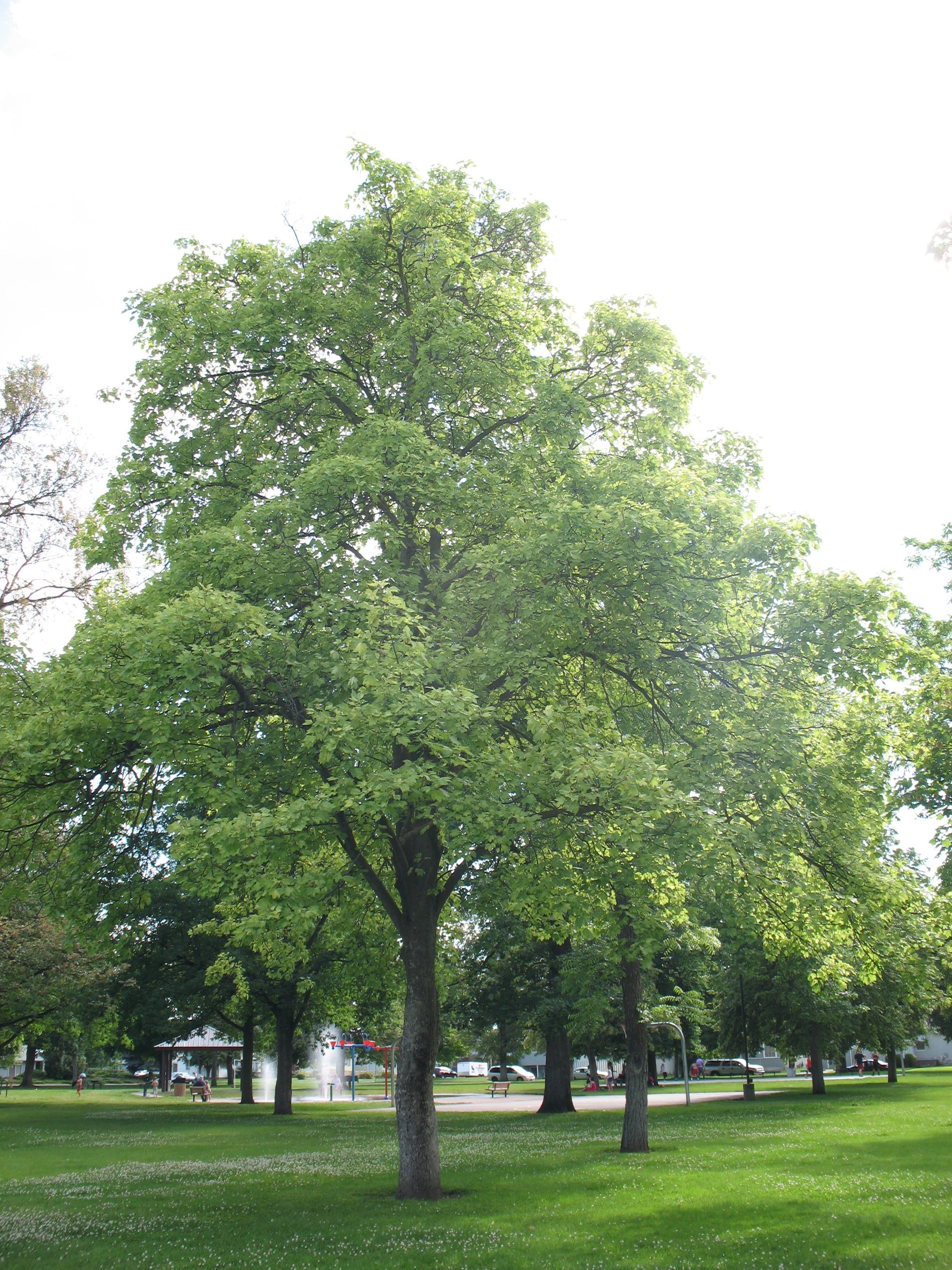
PhotoTitle: Sycamore Maple in Chief Garry Park
PhotoAttribution: City of Spokane Parks and Recreation
Listing Status: Spokane Heritage Tree Register
URL: https://my.spokanecity.org/urbanforestry/programs/heritage-tree/
Display Marker: large_green
Title: Chief Garry Park Champion
Description: Height: 56 feet
Species: Sycamore Maple
Known for its colorful display in autumn, the Sycamore maple is a delightful specimen in Chief Garry Park. Rising 50 feet into the air and possessing a crown of 50 feet, this tree is certainly a state champion size candidate!
Location: 47.671259, -117.372378
Address: Chief Garry Park, Spokane WA 99202
PhotoURL:

PhotoTitle: Sycamore Maple in Chief Garry Park
PhotoAttribution: City of Spokane Parks and Recreation
Listing Status: Spokane Heritage Tree Register
URL: https://my.spokanecity.org/urbanforestry/programs/heritage-tree/
Display Marker: large_green
ID: 379
Title: Tomlinson Barn
Description: Date Built: ~1927
Style: Gothic
Common Name: Norm Paulson Farm
Believed to have been originally owned by the Stevens family, the farm passed to the Tomlinsons, realtors by trade, who built the impressive, Gothic barn around 1927. The Tomlinson Barn was famous for the large, festive dances that were held there every Saturday night.
Location: 47.285274, -117.431319
Address: 1612 West Babb Road, Rosalia WA 99170
PhotoURL: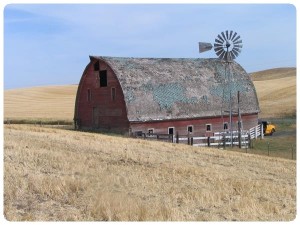
PhotoTitle: The Tomlinson Barn
PhotoAttribution: Spokane City/County Historic Preservation Office
Listing Status: Heritage Barn Register
URL: http://www.historicspokane.org/spokane-county-heritage-barns
Display Marker: large_red
Title: Tomlinson Barn
Description: Date Built: ~1927
Style: Gothic
Common Name: Norm Paulson Farm
Believed to have been originally owned by the Stevens family, the farm passed to the Tomlinsons, realtors by trade, who built the impressive, Gothic barn around 1927. The Tomlinson Barn was famous for the large, festive dances that were held there every Saturday night.
Location: 47.285274, -117.431319
Address: 1612 West Babb Road, Rosalia WA 99170
PhotoURL:

PhotoTitle: The Tomlinson Barn
PhotoAttribution: Spokane City/County Historic Preservation Office
Listing Status: Heritage Barn Register
URL: http://www.historicspokane.org/spokane-county-heritage-barns
Display Marker: large_red
ID: 380
Title: Weeks Barn
Description: Date Built: ~1900
Style: Gable
Common Name: Heinemann Farm
Charles M. Weeks received his homestead certificate for the farm in Indian Prairie in 1899. He built his barn around the turn of the century for his horses and a few cows. Hay was stored in the loft and then pushed off the sides into the mangers below.
Location: 47.716035, -117.635642
Address: 16110 West Jacobs Road, Spokane WA 99224
PhotoURL: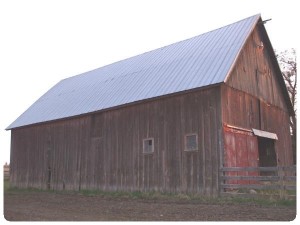
PhotoTitle: The Weeks Barn
PhotoAttribution: Spokane City/County Historic Preservation Office
Listing Status: Heritage Barn Register
URL: http://www.historicspokane.org/spokane-county-heritage-barns
Display Marker: large_red
Title: Weeks Barn
Description: Date Built: ~1900
Style: Gable
Common Name: Heinemann Farm
Charles M. Weeks received his homestead certificate for the farm in Indian Prairie in 1899. He built his barn around the turn of the century for his horses and a few cows. Hay was stored in the loft and then pushed off the sides into the mangers below.
Location: 47.716035, -117.635642
Address: 16110 West Jacobs Road, Spokane WA 99224
PhotoURL:

PhotoTitle: The Weeks Barn
PhotoAttribution: Spokane City/County Historic Preservation Office
Listing Status: Heritage Barn Register
URL: http://www.historicspokane.org/spokane-county-heritage-barns
Display Marker: large_red
ID: 382
Title: Reid Family Tree
Description: Age: 60+
Height: 65 feet
Species: Sugar Maple
The Reid Family Tree is believed to have been planted by Dr. Peter Reid, a noted Spokane physician and surgeon, and his family in the 1930s or 40s. The tree is situated on the west side of the Browne's Addition Historic District and has contributed to the verdant and vibrant feeling of the neighborhood. It is also claimed that Dr. Reid, when socializing with friends, would drink gin and tonics and always make one for the tree and pour it on its roots. The current owners have continued that tradition.
Location: 47.656202, -117.447099
Address: 2315 West 1st Avenue, Spokane WA 99201
PhotoURL: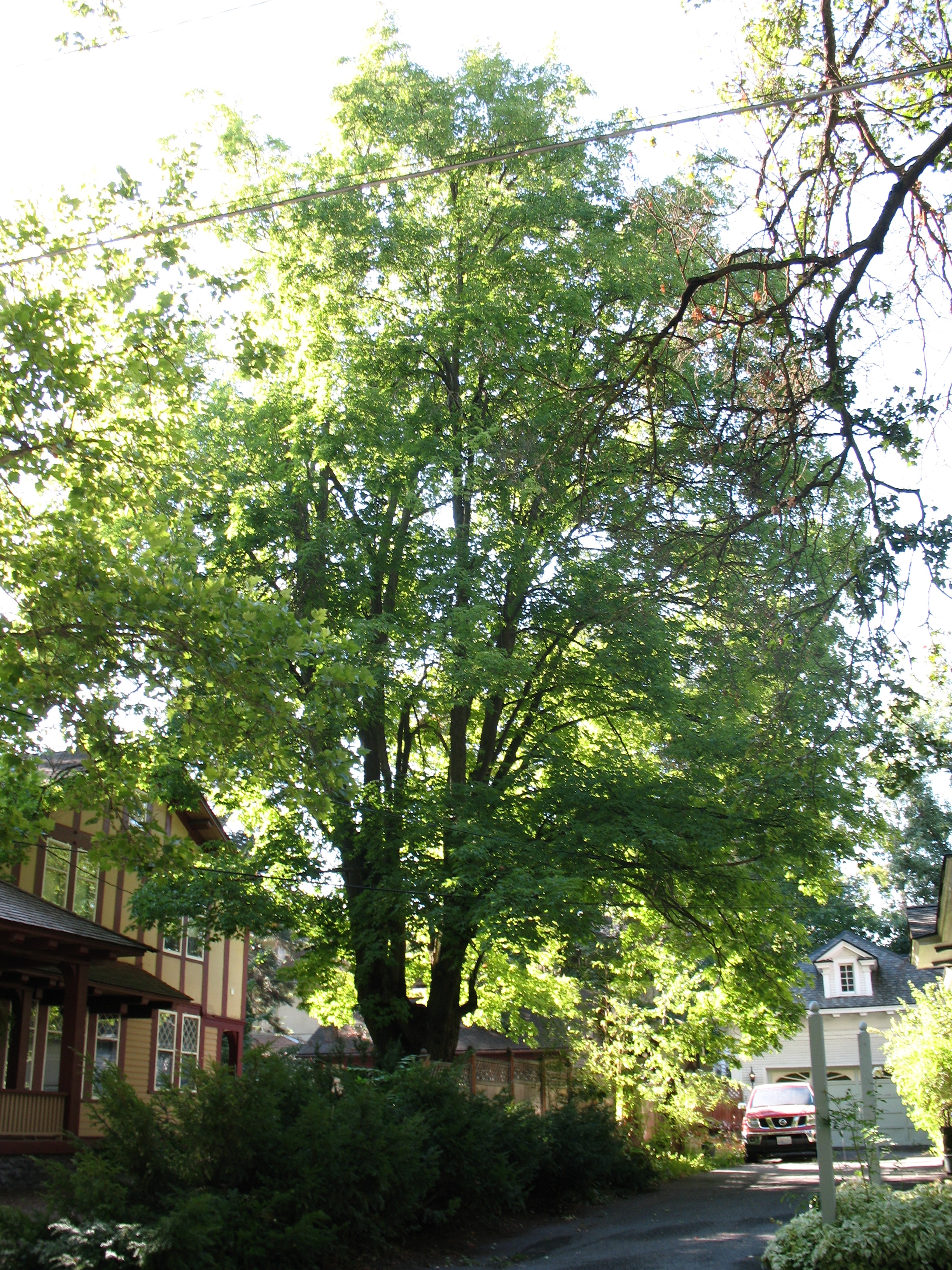
PhotoTitle: Sugar Maple at 2315 W 1st
PhotoAttribution: City of Spokane Parks and Recreation
Listing Status: Spokane Heritage Tree Register
URL: https://my.spokanecity.org/urbanforestry/programs/heritage-tree/
Display Marker: large_green
Title: Reid Family Tree
Description: Age: 60+
Height: 65 feet
Species: Sugar Maple
The Reid Family Tree is believed to have been planted by Dr. Peter Reid, a noted Spokane physician and surgeon, and his family in the 1930s or 40s. The tree is situated on the west side of the Browne's Addition Historic District and has contributed to the verdant and vibrant feeling of the neighborhood. It is also claimed that Dr. Reid, when socializing with friends, would drink gin and tonics and always make one for the tree and pour it on its roots. The current owners have continued that tradition.
Location: 47.656202, -117.447099
Address: 2315 West 1st Avenue, Spokane WA 99201
PhotoURL:

PhotoTitle: Sugar Maple at 2315 W 1st
PhotoAttribution: City of Spokane Parks and Recreation
Listing Status: Spokane Heritage Tree Register
URL: https://my.spokanecity.org/urbanforestry/programs/heritage-tree/
Display Marker: large_green
ID: 385
Title: The Zelkova Giant
Description: Height: 53 feet
Species: Japanese Zelkova
This impressive tree is one of seven that borders Webster Park on the west and southwest edges. Measuring 53 feet tall with a crown of 66 feet, this Japanese Zelkova is almost as big as the largest in the state!
Location: 47.694617, -117.466766
Address: 4001 North J Street, Spokane WA 99205
PhotoURL: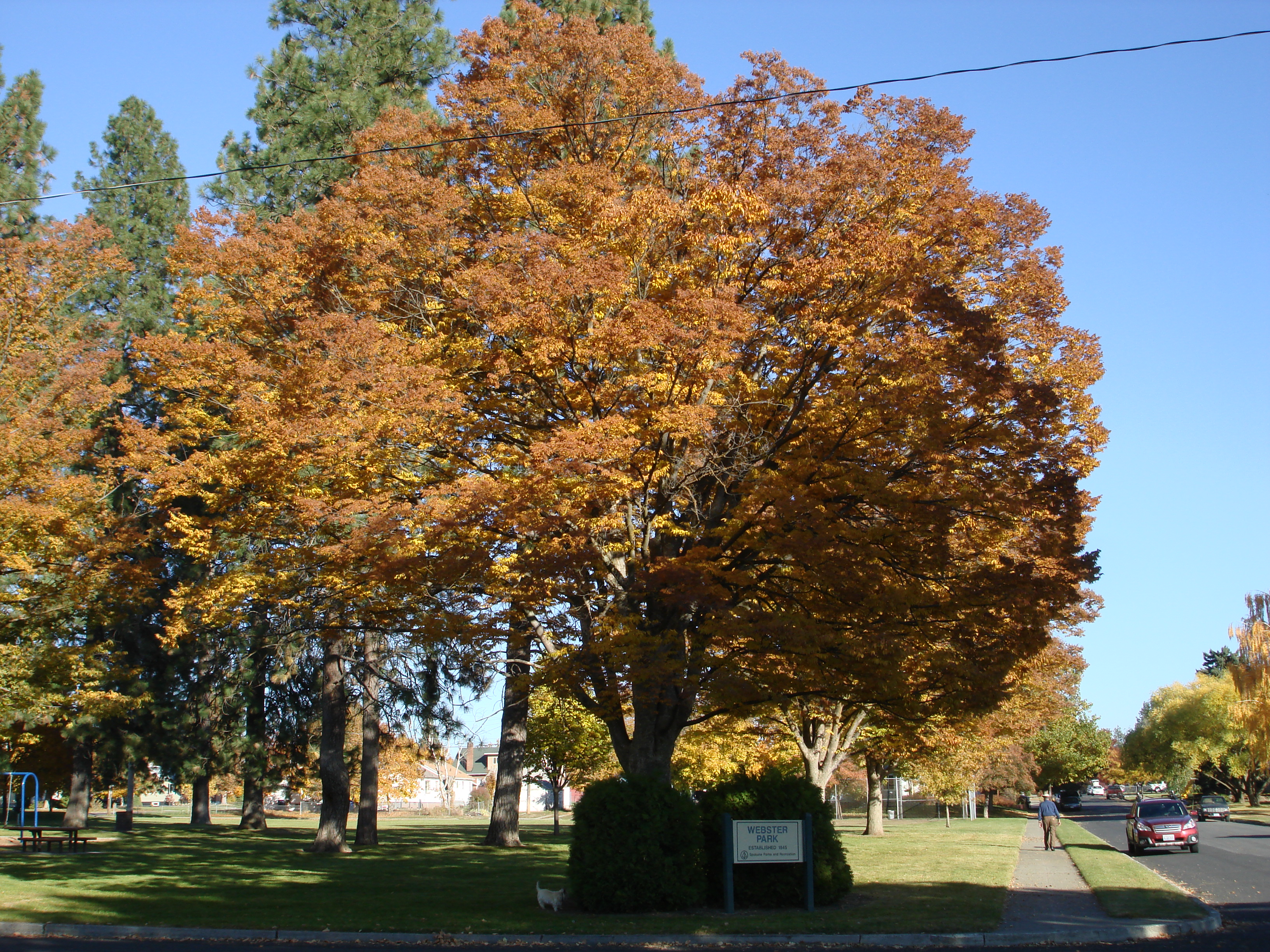
PhotoTitle: Japanese Zelkova in the Fall
PhotoAttribution: City of Spokane Parks and Recreation
Listing Status: Spokane Heritage Tree Register
URL: https://my.spokanecity.org/urbanforestry/programs/heritage-tree/
Display Marker: large_green
Title: The Zelkova Giant
Description: Height: 53 feet
Species: Japanese Zelkova
This impressive tree is one of seven that borders Webster Park on the west and southwest edges. Measuring 53 feet tall with a crown of 66 feet, this Japanese Zelkova is almost as big as the largest in the state!
Location: 47.694617, -117.466766
Address: 4001 North J Street, Spokane WA 99205
PhotoURL:

PhotoTitle: Japanese Zelkova in the Fall
PhotoAttribution: City of Spokane Parks and Recreation
Listing Status: Spokane Heritage Tree Register
URL: https://my.spokanecity.org/urbanforestry/programs/heritage-tree/
Display Marker: large_green
ID: 381
Title: Windsor Barn
Description: Date Built: ~1880
Style: Dutch Barn
Common Name: Windsor Castle
Built around 1880, the Windsor Barn is the original barn built for the Windsor family. Put together with wooden pegs, the barn remains in good condition. The only alteration is the addition on the side of the barn which was added in 1970.
Location: 47.615284, -117.486227
Address: 4311 South Abbott Road, Spokane WA 99224
PhotoURL: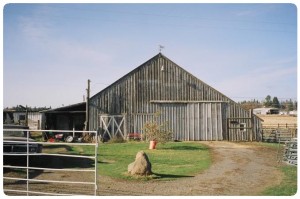
PhotoTitle: The Windsor Barn
PhotoAttribution: Spokane City/County Historic Preservation Office
Listing Status: Heritage Barn Register
URL: http://www.historicspokane.org/spokane-county-heritage-barns
Display Marker: large_red
Title: Windsor Barn
Description: Date Built: ~1880
Style: Dutch Barn
Common Name: Windsor Castle
Built around 1880, the Windsor Barn is the original barn built for the Windsor family. Put together with wooden pegs, the barn remains in good condition. The only alteration is the addition on the side of the barn which was added in 1970.
Location: 47.615284, -117.486227
Address: 4311 South Abbott Road, Spokane WA 99224
PhotoURL:

PhotoTitle: The Windsor Barn
PhotoAttribution: Spokane City/County Historic Preservation Office
Listing Status: Heritage Barn Register
URL: http://www.historicspokane.org/spokane-county-heritage-barns
Display Marker: large_red
ID: 390
Title: The Littleleaf Linden
Description: Age: ~110 years
Height: 29 feet
Species: American Linden
Located in the prominent Marycliff-Cliff Park Historic District, this American linden was planted in the Moore-Turner residential garden in the late 1890s and can be seen in several historic photographs of Mrs. Turner. The garden, which typifies a landscape style that accompanied the Arts and Crafts movement in America, was developed by pioneers, Frank Rockwood Moore and U.S. Senator George Turner.
Location: 47.648358, -117.421150
Address: Edwidge Woldson Park, Spokane WA 99204
PhotoURL: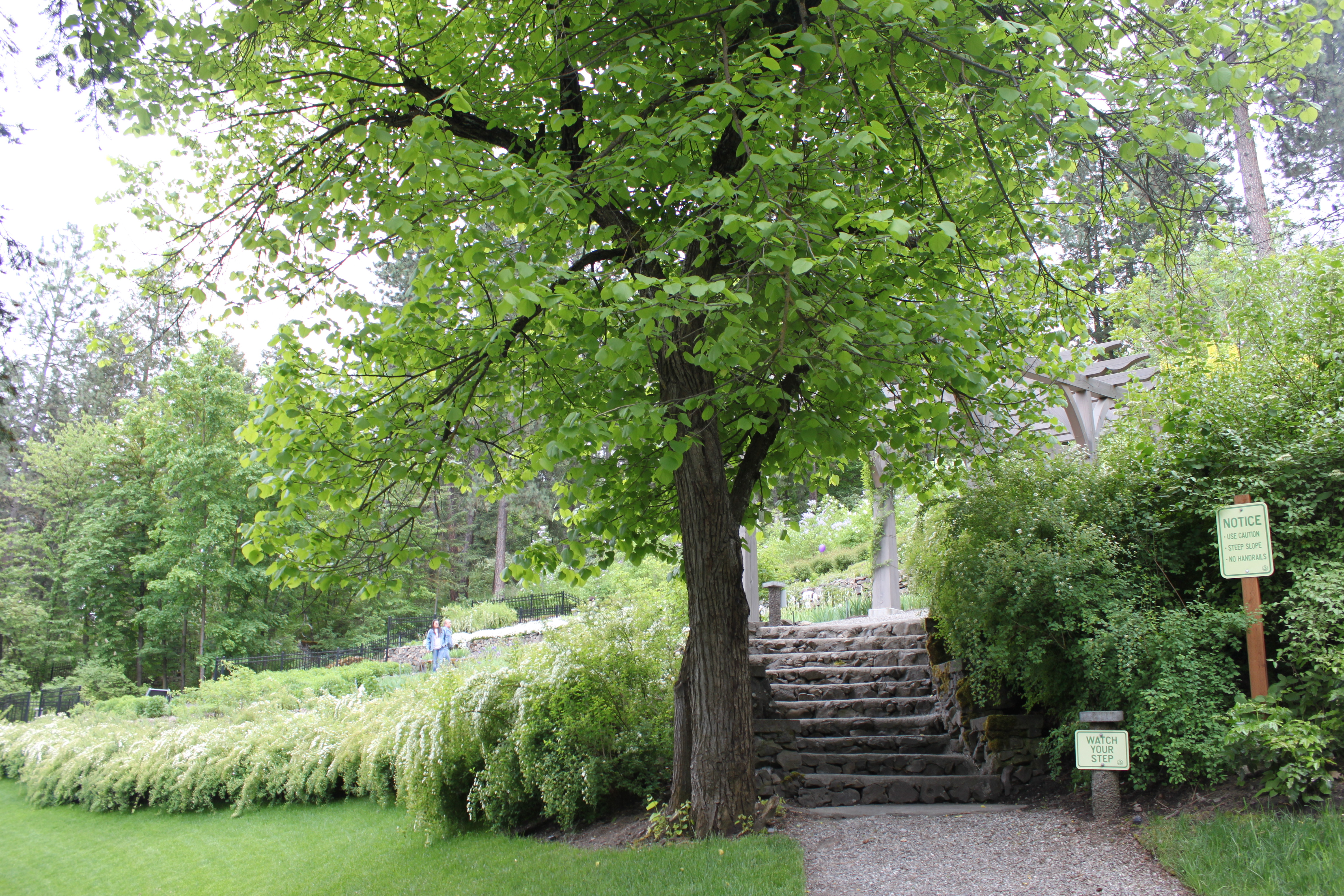
PhotoTitle: The American Linden tree
PhotoAttribution: City of Spokane Parks and Recreation
Listing Status: Spokane Heritage Tree Register
URL: https://my.spokanecity.org/urbanforestry/programs/heritage-tree/
Display Marker: large_green
Title: The Littleleaf Linden
Description: Age: ~110 years
Height: 29 feet
Species: American Linden
Located in the prominent Marycliff-Cliff Park Historic District, this American linden was planted in the Moore-Turner residential garden in the late 1890s and can be seen in several historic photographs of Mrs. Turner. The garden, which typifies a landscape style that accompanied the Arts and Crafts movement in America, was developed by pioneers, Frank Rockwood Moore and U.S. Senator George Turner.
Location: 47.648358, -117.421150
Address: Edwidge Woldson Park, Spokane WA 99204
PhotoURL:

PhotoTitle: The American Linden tree
PhotoAttribution: City of Spokane Parks and Recreation
Listing Status: Spokane Heritage Tree Register
URL: https://my.spokanecity.org/urbanforestry/programs/heritage-tree/
Display Marker: large_green
ID: 383
Title: Grant Park Guardian
Description: Age: ~90
Height: 75 feet
Species: Horse Chestnut
This mature tree acts as a guardian and greeter to the southeast entrance to Grant Park. This beautiful tree embraces and glorifies the four seasons throughout the year and is a superb example of a horse chestnut tree.
Location: 47.645543, -117.391226
Address: 1300 East 11th Avenue, Spokane WA 99202
PhotoURL:
PhotoTitle: The horse chestnut tree in Grant Park
PhotoAttribution: City of Spokane Parks and Recreation
Listing Status: Spokane Heritage Tree Register
URL: https://my.spokanecity.org/urbanforestry/programs/heritage-tree/
Display Marker: large_green
Title: Grant Park Guardian
Description: Age: ~90
Height: 75 feet
Species: Horse Chestnut
This mature tree acts as a guardian and greeter to the southeast entrance to Grant Park. This beautiful tree embraces and glorifies the four seasons throughout the year and is a superb example of a horse chestnut tree.
Location: 47.645543, -117.391226
Address: 1300 East 11th Avenue, Spokane WA 99202
PhotoURL:

PhotoTitle: The horse chestnut tree in Grant Park
PhotoAttribution: City of Spokane Parks and Recreation
Listing Status: Spokane Heritage Tree Register
URL: https://my.spokanecity.org/urbanforestry/programs/heritage-tree/
Display Marker: large_green
ID: 384
Title: The Rockwood Spruce
Description: Age: 90+
Height: 125+ feet
Species: Norway Spruce
Towering 125 feet above 26th Avenue, the large Norway Spruce has a commanding presence. The historic tree also appears on the original landscaping plans from 1926 and is located in the Rockwood Historic District which was designed by the nationally renowned Olmsted Brothers landscape architectural firm.
Location: 47.631003, -117.399734
Address: 725 E 26th Avenue, Spokane WA 99203
PhotoURL: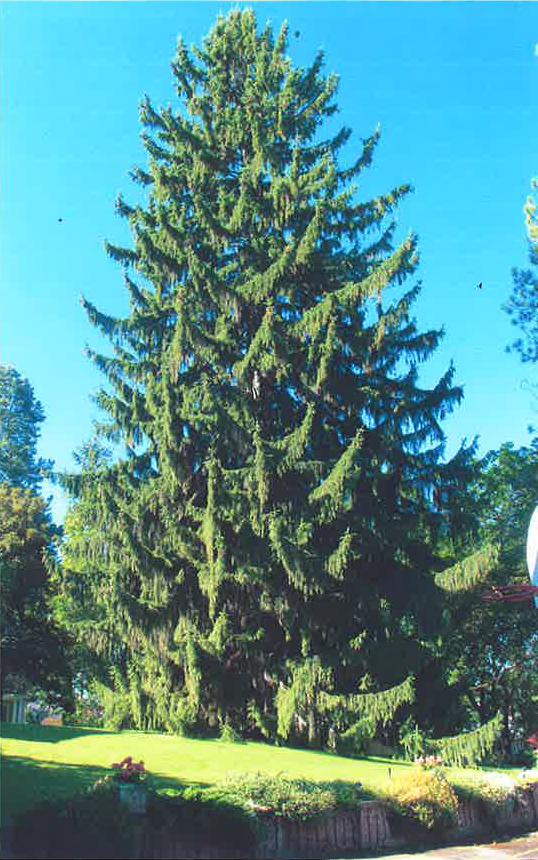
PhotoTitle: The Norway Spruce on 26th Avenue
PhotoAttribution: City of Spokane Parks and Recreation
Listing Status: Spokane Heritage Tree Register
URL: https://my.spokanecity.org/urbanforestry/programs/heritage-tree/
Display Marker: large_green
Title: The Rockwood Spruce
Description: Age: 90+
Height: 125+ feet
Species: Norway Spruce
Towering 125 feet above 26th Avenue, the large Norway Spruce has a commanding presence. The historic tree also appears on the original landscaping plans from 1926 and is located in the Rockwood Historic District which was designed by the nationally renowned Olmsted Brothers landscape architectural firm.
Location: 47.631003, -117.399734
Address: 725 E 26th Avenue, Spokane WA 99203
PhotoURL:

PhotoTitle: The Norway Spruce on 26th Avenue
PhotoAttribution: City of Spokane Parks and Recreation
Listing Status: Spokane Heritage Tree Register
URL: https://my.spokanecity.org/urbanforestry/programs/heritage-tree/
Display Marker: large_green
ID: 387
Title: The Massive Miyabe
Description: Age: 58 years
Height: 54 feet
Species: Miyabe Maple
With satiny leaves and low-sweeping branches, the rare Miyabe maple is a charming shade tree in the summer and an explosion of color in the fall. Rising 54 feet above Finch Arboretum and with a crown of 52 feet, this tree is a potential state champion.
Location: 47.641939, -117.466226
Address: 3404 West Woodland Boulevard, Spokane WA 99224
PhotoURL: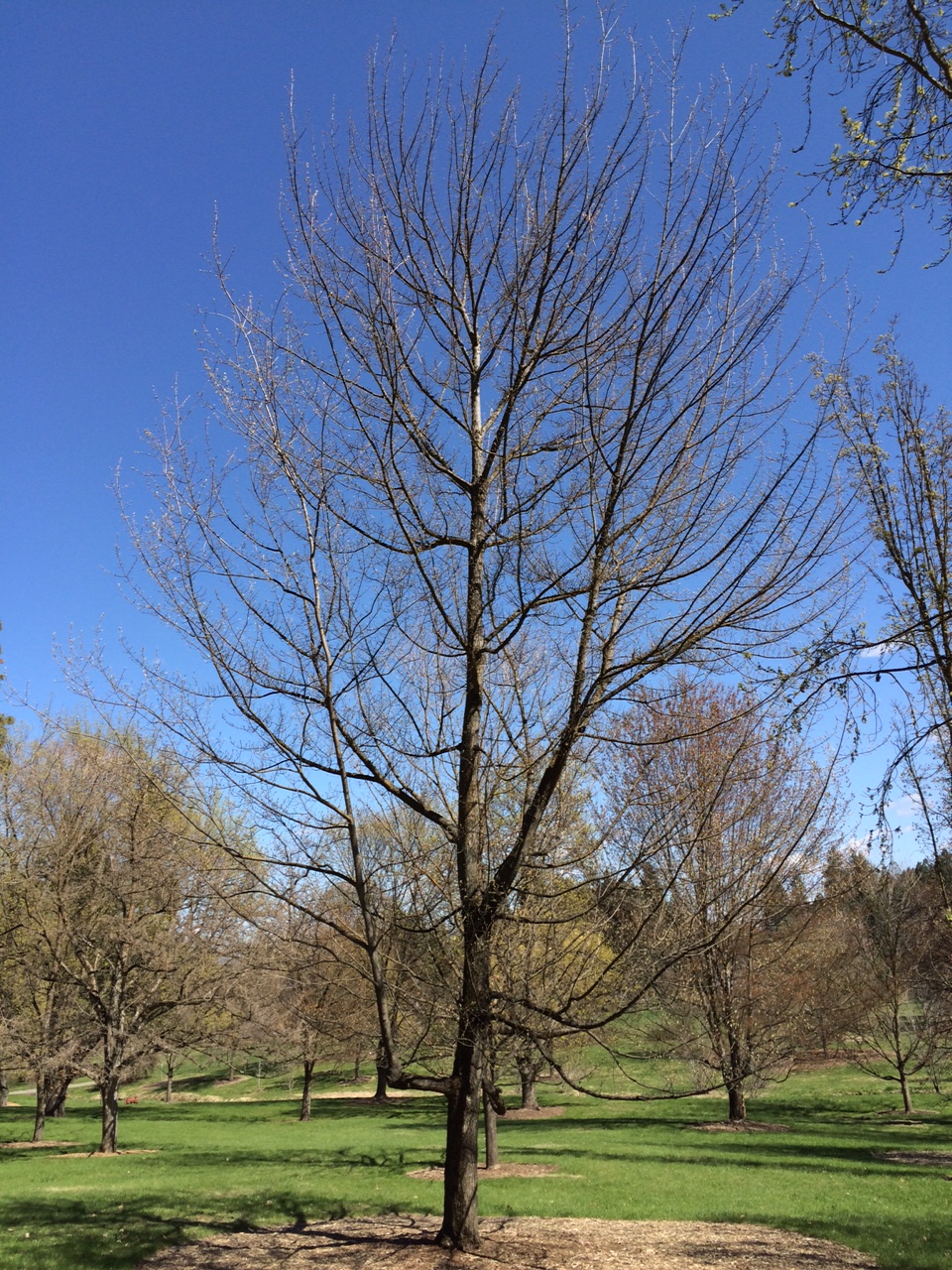
PhotoTitle: The Miyabe maple
PhotoAttribution: City of Spokane Parks and Recreation
Listing Status: Spokane Heritage Tree Register
URL: https://my.spokanecity.org/urbanforestry/programs/heritage-tree/
Display Marker: large_green
Title: The Massive Miyabe
Description: Age: 58 years
Height: 54 feet
Species: Miyabe Maple
With satiny leaves and low-sweeping branches, the rare Miyabe maple is a charming shade tree in the summer and an explosion of color in the fall. Rising 54 feet above Finch Arboretum and with a crown of 52 feet, this tree is a potential state champion.
Location: 47.641939, -117.466226
Address: 3404 West Woodland Boulevard, Spokane WA 99224
PhotoURL:

PhotoTitle: The Miyabe maple
PhotoAttribution: City of Spokane Parks and Recreation
Listing Status: Spokane Heritage Tree Register
URL: https://my.spokanecity.org/urbanforestry/programs/heritage-tree/
Display Marker: large_green
ID: 395
Title: The Moore-Turner Elm
Description: Height: 88 feet
Species: American Elm
An incredibly hardy and graceful tree, the American Elm was favored for plantings along streets and in parks. Located in the historic Moore-Turner Garden, which typifies a landscape style that accompanied the Arts and Crafts movement in America, this elm rises 88 feet into the air and stretches 44 feet across.
Location: 47.648539, -117.420409
Address: Pioneer Park, Spokane WA 99204
PhotoURL: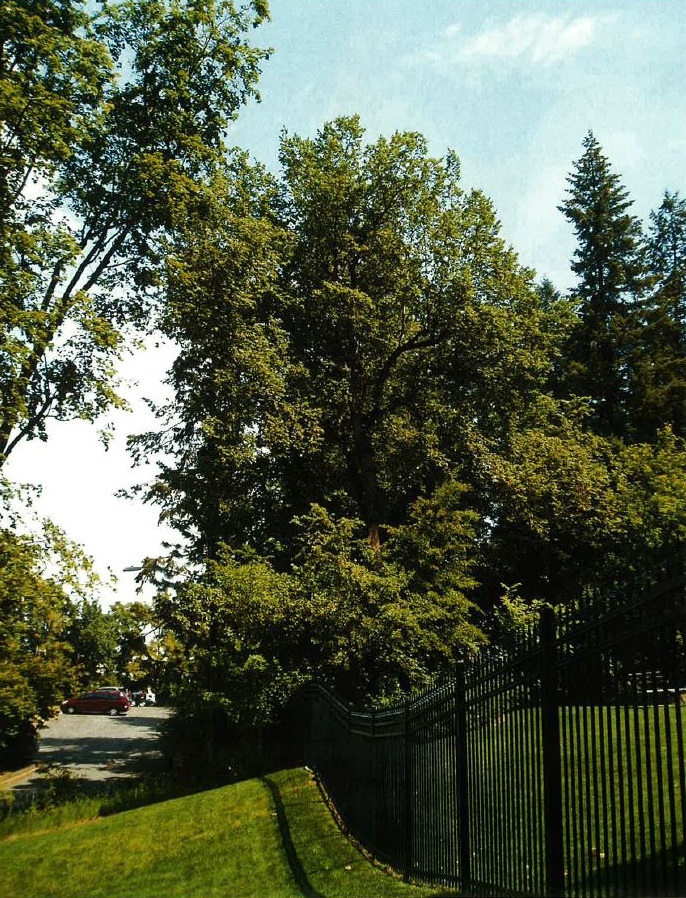
PhotoTitle: American Elm
PhotoAttribution: City of Spokane Parks and Recreation
Listing Status: Spokane Heritage Tree Register
URL: https://my.spokanecity.org/urbanforestry/programs/heritage-tree/
Display Marker: large_green
Title: The Moore-Turner Elm
Description: Height: 88 feet
Species: American Elm
An incredibly hardy and graceful tree, the American Elm was favored for plantings along streets and in parks. Located in the historic Moore-Turner Garden, which typifies a landscape style that accompanied the Arts and Crafts movement in America, this elm rises 88 feet into the air and stretches 44 feet across.
Location: 47.648539, -117.420409
Address: Pioneer Park, Spokane WA 99204
PhotoURL:

PhotoTitle: American Elm
PhotoAttribution: City of Spokane Parks and Recreation
Listing Status: Spokane Heritage Tree Register
URL: https://my.spokanecity.org/urbanforestry/programs/heritage-tree/
Display Marker: large_green
ID: 396
Title: Corbin's Apricot
Description: Species: Apricot
Also known as the Armenian plum, the apricot tree produces sweetly-tart fruit by the same name. According to accounts given by former residents of the D.C. Corbin House, a kitchen garden was located directly behind the house above the rock wall. Revealed in historic photographs, the apricot tree is a remnant of that original garden.
Location: 47.648505, -117.419832
Address: Pioneer Park, Spokane WA 99204
PhotoURL: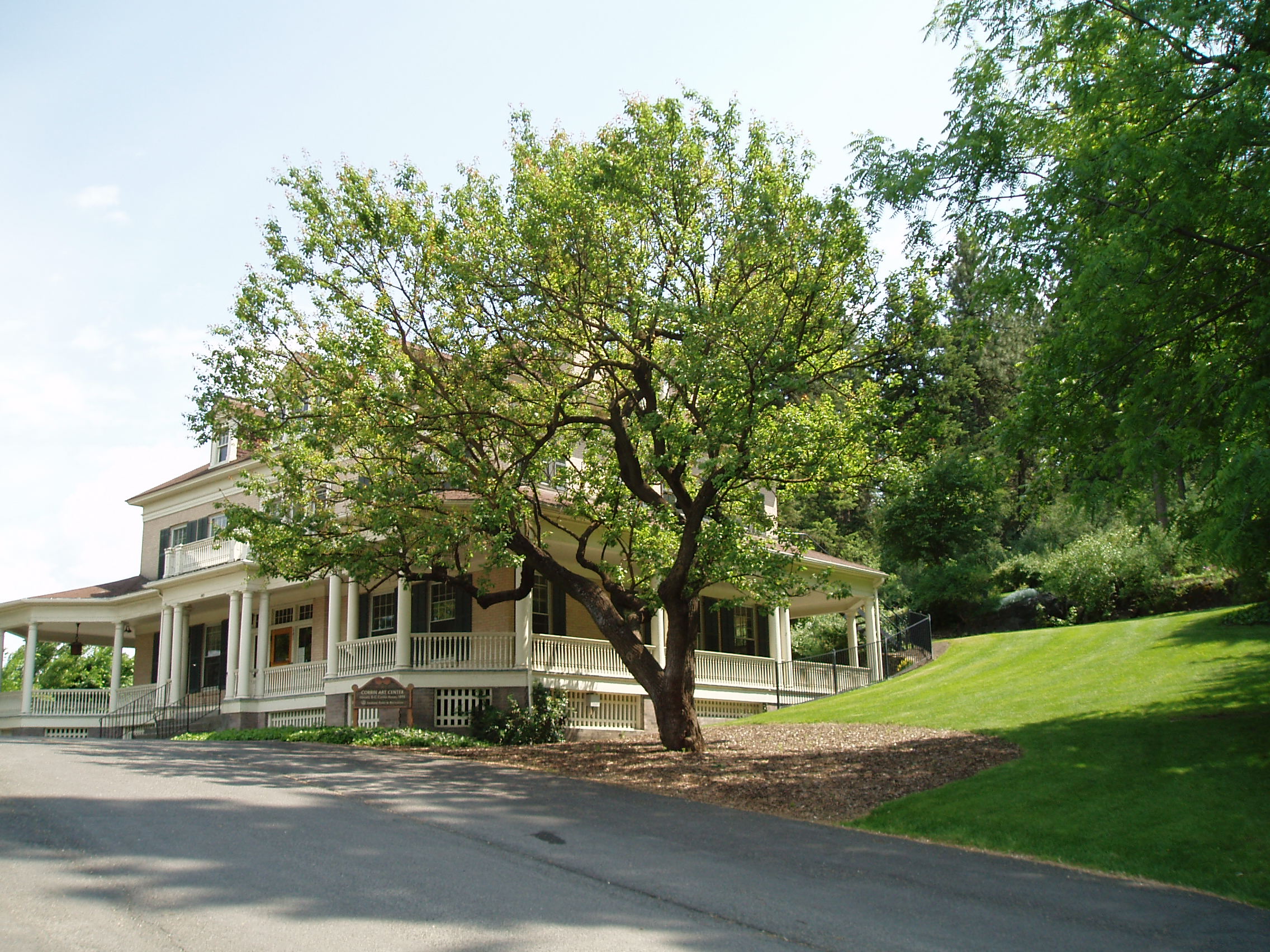
PhotoTitle: Apricot Treet
PhotoAttribution: City of Spokane Parks and Recreation
Listing Status: Spokane Heritage Tree Register
URL: https://my.spokanecity.org/urbanforestry/programs/heritage-tree/
Display Marker: large_green
Title: Corbin's Apricot
Description: Species: Apricot
Also known as the Armenian plum, the apricot tree produces sweetly-tart fruit by the same name. According to accounts given by former residents of the D.C. Corbin House, a kitchen garden was located directly behind the house above the rock wall. Revealed in historic photographs, the apricot tree is a remnant of that original garden.
Location: 47.648505, -117.419832
Address: Pioneer Park, Spokane WA 99204
PhotoURL:

PhotoTitle: Apricot Treet
PhotoAttribution: City of Spokane Parks and Recreation
Listing Status: Spokane Heritage Tree Register
URL: https://my.spokanecity.org/urbanforestry/programs/heritage-tree/
Display Marker: large_green
ID: 386
Title: Liberty Park Champion
Description: Height: 45 feet
Species: Corkscrew Willow
Named for its curling, twisting branches, this Corkscrew willow is found on the west side of Liberty Park. With a height of 45 feet, a diameter of 50 inches and a crown of 60 feet, this impressive tree is likely the largest or second largest in the state!
Location: 47.652584, -117.389177
Address: Liberty Park, Spokane WA 99202
PhotoURL: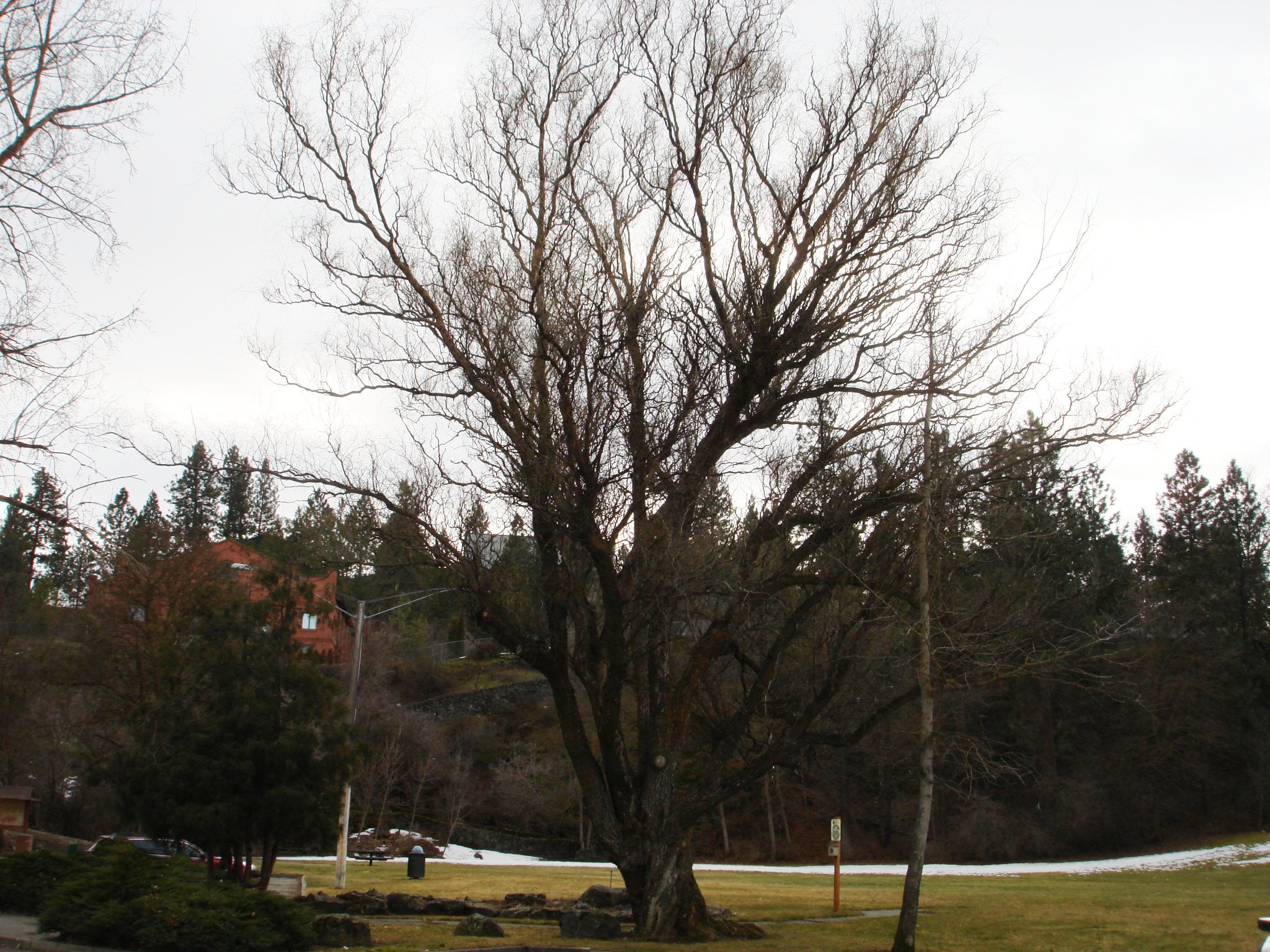
PhotoTitle: Corkscrew Willow in Liberty Park
PhotoAttribution: City of Spokane Parks and Recreation
Listing Status: Spokane Heritage Tree Register
URL: https://my.spokanecity.org/urbanforestry/programs/heritage-tree/
Display Marker: large_green
Title: Liberty Park Champion
Description: Height: 45 feet
Species: Corkscrew Willow
Named for its curling, twisting branches, this Corkscrew willow is found on the west side of Liberty Park. With a height of 45 feet, a diameter of 50 inches and a crown of 60 feet, this impressive tree is likely the largest or second largest in the state!
Location: 47.652584, -117.389177
Address: Liberty Park, Spokane WA 99202
PhotoURL:

PhotoTitle: Corkscrew Willow in Liberty Park
PhotoAttribution: City of Spokane Parks and Recreation
Listing Status: Spokane Heritage Tree Register
URL: https://my.spokanecity.org/urbanforestry/programs/heritage-tree/
Display Marker: large_green
ID: 392
Title: The Last Planes
Description: Age: 110+
Height: ~65 feet
Species: London Plane
This collection of three London planes can be seen providing significant tree canopy along First Avenue in the Browne's Addition Historic District. Planted around the turn of the century, these three remaining trees represent some of the original landscaping for this area of the neighborhood and, therefore, for the city.
Location: 47.656345, -117.446785
Address: 2315 West 1st Avenue, Spokane WA 99201
PhotoURL: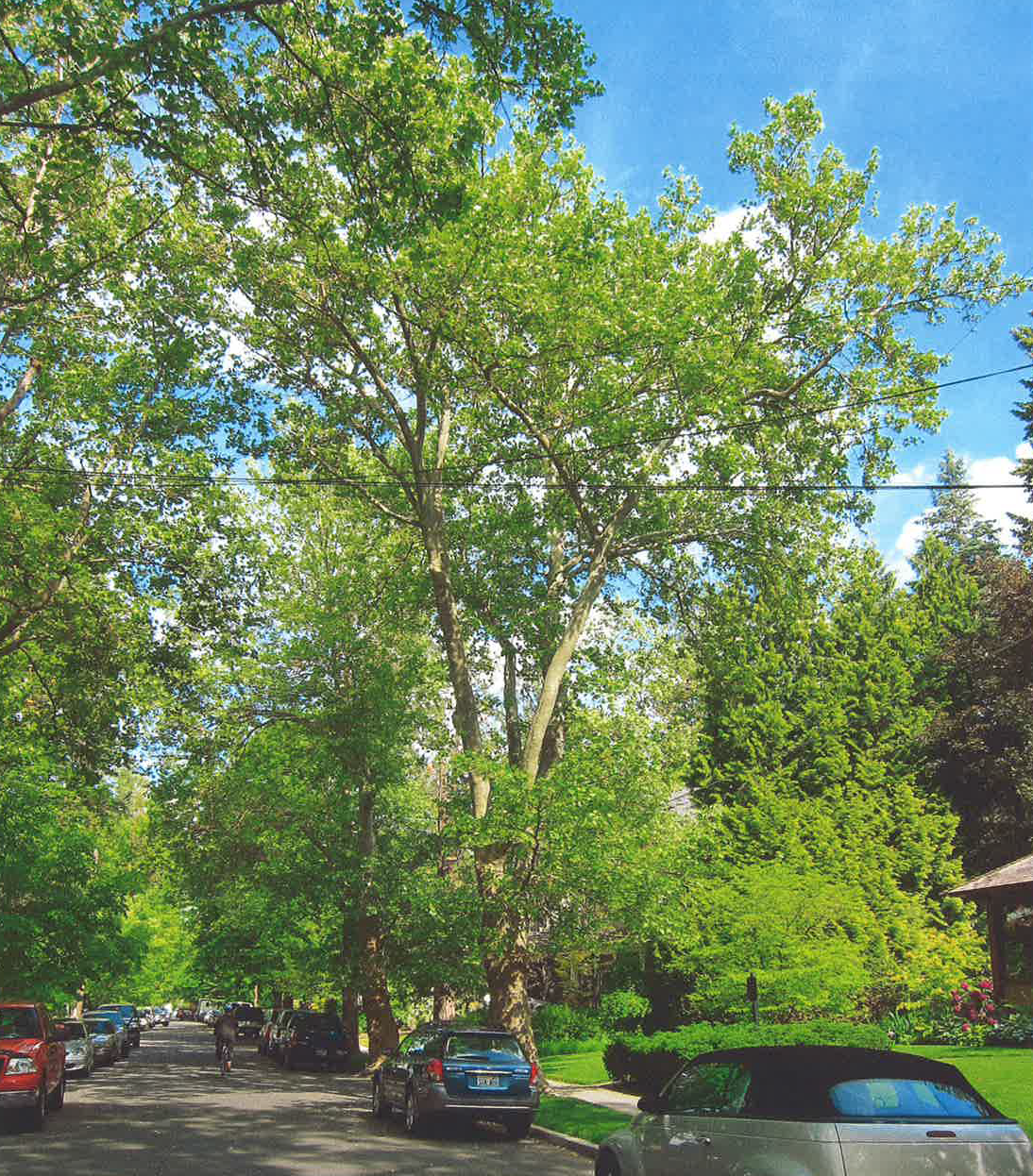
PhotoTitle: London Plane
PhotoAttribution: City of Spokane Parks and Recreation
Listing Status: Spokane Heritage Tree Register
URL: https://my.spokanecity.org/urbanforestry/programs/heritage-tree/
Display Marker: large_green
Title: The Last Planes
Description: Age: 110+
Height: ~65 feet
Species: London Plane
This collection of three London planes can be seen providing significant tree canopy along First Avenue in the Browne's Addition Historic District. Planted around the turn of the century, these three remaining trees represent some of the original landscaping for this area of the neighborhood and, therefore, for the city.
Location: 47.656345, -117.446785
Address: 2315 West 1st Avenue, Spokane WA 99201
PhotoURL:

PhotoTitle: London Plane
PhotoAttribution: City of Spokane Parks and Recreation
Listing Status: Spokane Heritage Tree Register
URL: https://my.spokanecity.org/urbanforestry/programs/heritage-tree/
Display Marker: large_green
ID: 394
Title: The Chestnut Champion
Description: Height: 102 feet
Species: Horse Chestnut
Sometimes known as the conker tree due to its large, glossy nut-like seeds, the horse chestnut is also known for its brilliant display of spring flowers. This chestnut tree in Edwidge Woldson Park is 102 feet tall and has a crown that measures 102 feet, making it a state champion size contender!
Location: 47.648926, -117.421108
Address: Edwidge Woldson Park, Spokane WA 99204
PhotoURL: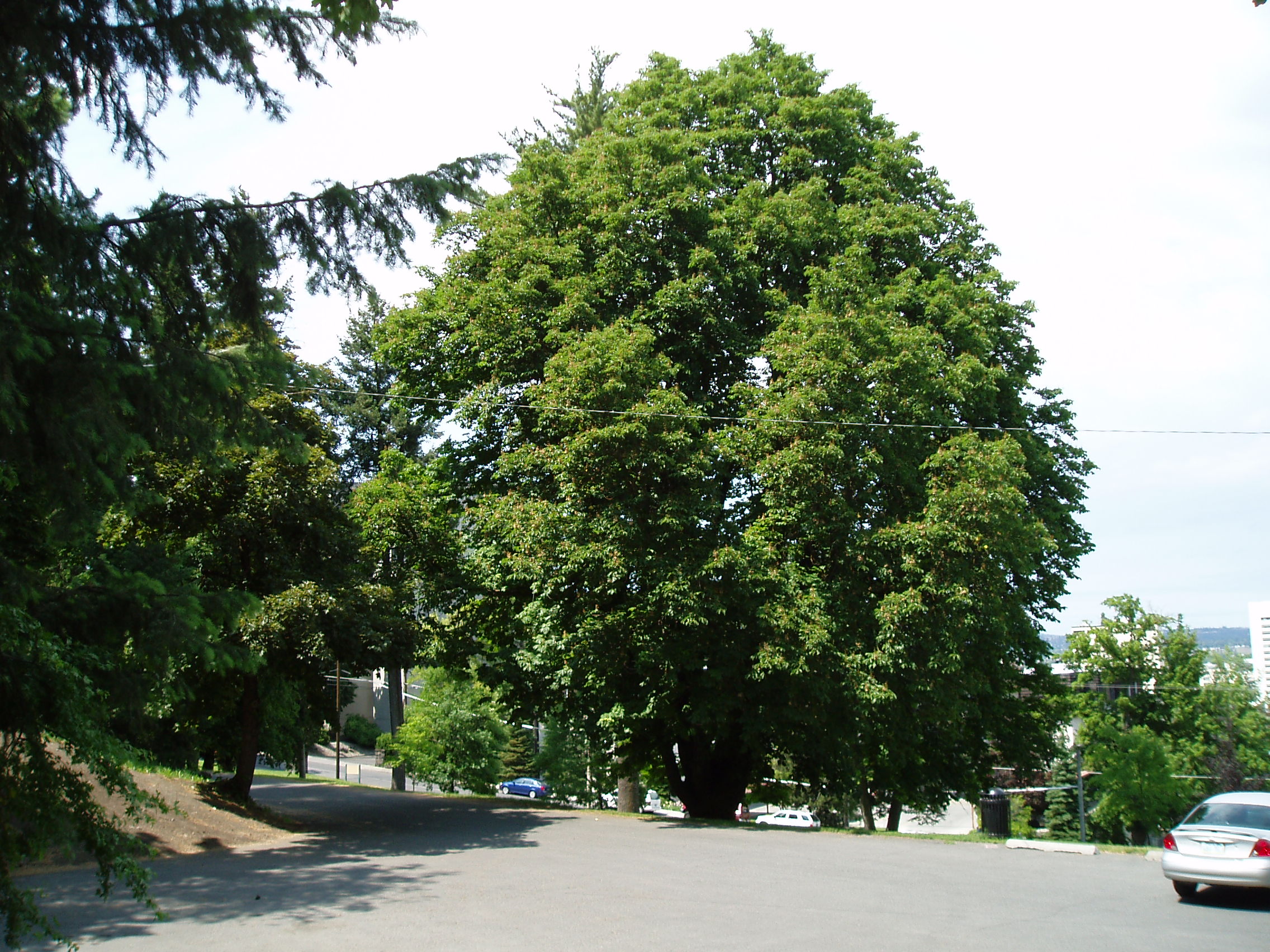
PhotoTitle: Horse Chestnut
PhotoAttribution: City of Spokane Parks and Recreation
Listing Status: Spokane Heritage Tree Register
URL: https://my.spokanecity.org/urbanforestry/programs/heritage-tree/
Display Marker: large_green
Title: The Chestnut Champion
Description: Height: 102 feet
Species: Horse Chestnut
Sometimes known as the conker tree due to its large, glossy nut-like seeds, the horse chestnut is also known for its brilliant display of spring flowers. This chestnut tree in Edwidge Woldson Park is 102 feet tall and has a crown that measures 102 feet, making it a state champion size contender!
Location: 47.648926, -117.421108
Address: Edwidge Woldson Park, Spokane WA 99204
PhotoURL:

PhotoTitle: Horse Chestnut
PhotoAttribution: City of Spokane Parks and Recreation
Listing Status: Spokane Heritage Tree Register
URL: https://my.spokanecity.org/urbanforestry/programs/heritage-tree/
Display Marker: large_green
ID: 397
Title: Horse Slaughter Camp
Description: The soberly named Horse Slaughter Camp is a large open space on the south side of the Spokane River near the Idaho border. During the collision between white settlers and native tribes, events occurred in which participants took the law into their own hands and meted out their own versions of justice. After the defeat of the Spokanes, Couer d’Alenes, Yakimas, Palouses and other tribes at the Battle of Four Lakes and the Battle of Spokane Plains, Wright continued to wreak havoc along the Spokane River in an effort to destroy the tribes’ war-making capability. It was here, in September of 1858, that Colonel George Wright killed over 800 horses belonging to a confederation of Plateau Indian tribes. Wright and his men would take two entire days to shoot the horses. Wright then ordered the burning of several storehouses of grain. This cruel act diminished the tribes’ wealth and mobility. Starvation then threatened the confederation that winter and greatly reduced their resistance. This final undertaking led to more whites settling in the territory.
Horse Slaughter Camp is located just west of the 2 mile marker on the Centennial Trail (47.689019, -117.072436). A stone marker, erected in 1946 by the Spokane County Pioneer Society, identifies the site. Although not listed on the National or Spokane Register, the site has been documented and inventoried.
Location: 47.689019, -117.072436
Address: Mile Marker 2, Centennial Trail
PhotoURL: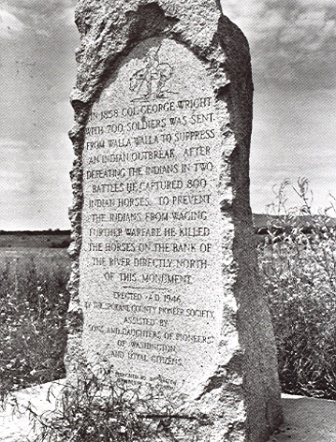
PhotoTitle: Camp Marker
PhotoAttribution: Spokane City/County Historic Preservation Office
Listing Status: N/A
URL: http://properties.historicspokane.org/property/?PropertyID=2086
Display Marker: large_yellow
Title: Horse Slaughter Camp
Description: The soberly named Horse Slaughter Camp is a large open space on the south side of the Spokane River near the Idaho border. During the collision between white settlers and native tribes, events occurred in which participants took the law into their own hands and meted out their own versions of justice. After the defeat of the Spokanes, Couer d’Alenes, Yakimas, Palouses and other tribes at the Battle of Four Lakes and the Battle of Spokane Plains, Wright continued to wreak havoc along the Spokane River in an effort to destroy the tribes’ war-making capability. It was here, in September of 1858, that Colonel George Wright killed over 800 horses belonging to a confederation of Plateau Indian tribes. Wright and his men would take two entire days to shoot the horses. Wright then ordered the burning of several storehouses of grain. This cruel act diminished the tribes’ wealth and mobility. Starvation then threatened the confederation that winter and greatly reduced their resistance. This final undertaking led to more whites settling in the territory.
Horse Slaughter Camp is located just west of the 2 mile marker on the Centennial Trail (47.689019, -117.072436). A stone marker, erected in 1946 by the Spokane County Pioneer Society, identifies the site. Although not listed on the National or Spokane Register, the site has been documented and inventoried.
Location: 47.689019, -117.072436
Address: Mile Marker 2, Centennial Trail
PhotoURL:

PhotoTitle: Camp Marker
PhotoAttribution: Spokane City/County Historic Preservation Office
Listing Status: N/A
URL: http://properties.historicspokane.org/property/?PropertyID=2086
Display Marker: large_yellow
ID: 398
Title: Bayley House
Description: Date Built: 1889
Architect: Loren L. Rand
Common Name: My Father's House
Built in 1889, the James and Sarah Bayley House is an almost textbook example of the Queen Anne style. Fish-scale shingling, decorative wood paterae, multiple bay windows and asymmetrical form all avoid a smooth-walled appearance, a notable feature of the Queen Anne style. Although originally built in the Ross Park Addition for James Luther Bayley, one of Spokane’s first pioneer bridge builders and civil contractors, and his wife, Sarah, the home has since been moved one mile east.
Location: 47.677798, -117.364335
Address: 3111 East Marshall Avenue, Spokane WA, 99207
PhotoURL: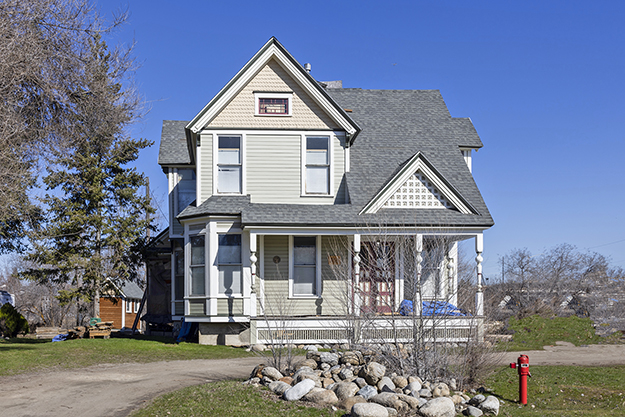
PhotoTitle: Bayley House
PhotoAttribution: Spokane City/County Historic Preservation Office
Listing Status: Spokane Register
URL: http://properties.historicspokane.org/property/?PropertyID=2088
Display Marker: large_yellow
Title: Bayley House
Description: Date Built: 1889
Architect: Loren L. Rand
Common Name: My Father's House
Built in 1889, the James and Sarah Bayley House is an almost textbook example of the Queen Anne style. Fish-scale shingling, decorative wood paterae, multiple bay windows and asymmetrical form all avoid a smooth-walled appearance, a notable feature of the Queen Anne style. Although originally built in the Ross Park Addition for James Luther Bayley, one of Spokane’s first pioneer bridge builders and civil contractors, and his wife, Sarah, the home has since been moved one mile east.
Location: 47.677798, -117.364335
Address: 3111 East Marshall Avenue, Spokane WA, 99207
PhotoURL:

PhotoTitle: Bayley House
PhotoAttribution: Spokane City/County Historic Preservation Office
Listing Status: Spokane Register
URL: http://properties.historicspokane.org/property/?PropertyID=2088
Display Marker: large_yellow
ID: 399
Title: Ernest and Anna Chamberlin House
Description: Date Built: 1906
Architect: W. J. Ballard
Possessing an almost “storybook” appearance, the Chamberlin House is an excellent example of the Craftsman style in Spokane. The home’s porch, complete with tapered pillars, are made of smooth, round cobblestone culled from the banks of the Spokane River. Wide bargeboards and interior woodwork alike are embellished with a whimsical design that depicts the silhouette of a seabird with a long, pointed beak. The house was designed by W. J. Ballard for Ernest Chamberlin. Chamberlin was co-founder of the Chamberlin Real Estate & Improvement Company which, during the early 1900s, built over 400 houses throughout the city and helped spur private home ownership in northwest Spokane.
Location: 47.668853, -117.456461
Address: 1228 North Sherwood Street, Spokane WA 99201
PhotoURL: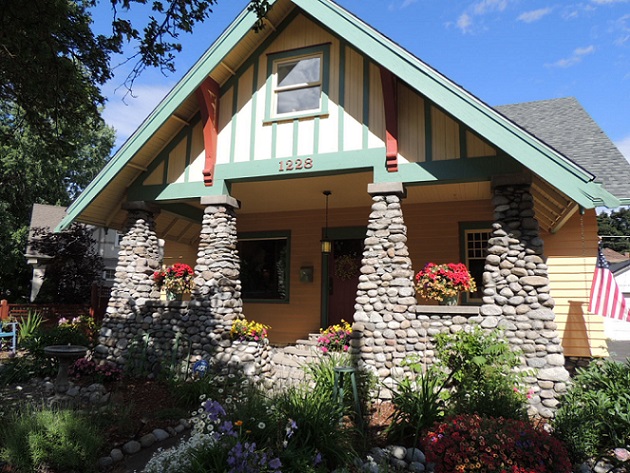
PhotoTitle: Chamberlin House
PhotoAttribution: Spokane City/County Historic Preservation Office
Listing Status: Spokane Register
URL: http://properties.historicspokane.org/property/?PropertyID=2087
Display Marker: large_yellow
Title: Ernest and Anna Chamberlin House
Description: Date Built: 1906
Architect: W. J. Ballard
Possessing an almost “storybook” appearance, the Chamberlin House is an excellent example of the Craftsman style in Spokane. The home’s porch, complete with tapered pillars, are made of smooth, round cobblestone culled from the banks of the Spokane River. Wide bargeboards and interior woodwork alike are embellished with a whimsical design that depicts the silhouette of a seabird with a long, pointed beak. The house was designed by W. J. Ballard for Ernest Chamberlin. Chamberlin was co-founder of the Chamberlin Real Estate & Improvement Company which, during the early 1900s, built over 400 houses throughout the city and helped spur private home ownership in northwest Spokane.
Location: 47.668853, -117.456461
Address: 1228 North Sherwood Street, Spokane WA 99201
PhotoURL:

PhotoTitle: Chamberlin House
PhotoAttribution: Spokane City/County Historic Preservation Office
Listing Status: Spokane Register
URL: http://properties.historicspokane.org/property/?PropertyID=2087
Display Marker: large_yellow
ID: 400
Title: Hillyard Branch Library
Description: Date Built: 1929
Architect: Whitehouse & Price
Common Name: Church of the Resurrection
Despite its modest stature, the Hillyard Branch Library possesses an enormous amount of integrity, character and history. Built in 1929 by noted local architectural firm, Whitehouse & Price, the library has Italian Renaissance elements and impressive detailing in both the interior and exterior. Intricately carved terra cotta tiles and a large cartouche embellish the entrance while vaulted ceilings and hand-carved, hand-painted exposed timber beams accentuate the interior space. The library, which was open for over fifty years, served the community of Hillyard after its annexation to Spokane in 1924.
Location: 47.703147, -117.366600
Address: 2936 East Olympic Avenue, Spokane, WA, 99207
PhotoURL:
PhotoTitle: Hillyard Library
PhotoAttribution: Spokane City/County Historic Preservation Office
Listing Status: Spokane Register
URL: http://properties.historicspokane.org/property/?PropertyID=2089
Display Marker: large_yellow
Title: Hillyard Branch Library
Description: Date Built: 1929
Architect: Whitehouse & Price
Common Name: Church of the Resurrection
Despite its modest stature, the Hillyard Branch Library possesses an enormous amount of integrity, character and history. Built in 1929 by noted local architectural firm, Whitehouse & Price, the library has Italian Renaissance elements and impressive detailing in both the interior and exterior. Intricately carved terra cotta tiles and a large cartouche embellish the entrance while vaulted ceilings and hand-carved, hand-painted exposed timber beams accentuate the interior space. The library, which was open for over fifty years, served the community of Hillyard after its annexation to Spokane in 1924.
Location: 47.703147, -117.366600
Address: 2936 East Olympic Avenue, Spokane, WA, 99207
PhotoURL:

PhotoTitle: Hillyard Library
PhotoAttribution: Spokane City/County Historic Preservation Office
Listing Status: Spokane Register
URL: http://properties.historicspokane.org/property/?PropertyID=2089
Display Marker: large_yellow
ID: 401
Title: Temple Emanu-El (demolished)
Description: Date Built: 1892
Architect: Herman Preusse
People of the Jewish faith have participated in the social, economic and political life of the Pacific Northwest from the earliest periods of exploration and settlement. Temple Emanu-El, erected at the corner of Third Avenue and Madison Street, was the first permanent Jewish house of worship in Washington State. The synagogue, designed by the noted Spokane architect Herman Preusse, was a beautiful wood building with decorative windows, entryways and embellished with a striking "onion dome" on top of its tower. The building cost about $3,500 to build and was used until a new temple was built at 8th Avenue and Walnut Street in the 1920s. The original temple remained until 1934.
A marker, erected by the Jewish American Society for Historic Preservation, now sits on the former site of the temple.
Location: 47.653258, -117.428278
Address: 1105 West 3rd Avenue, Spokane WA 99201
PhotoURL: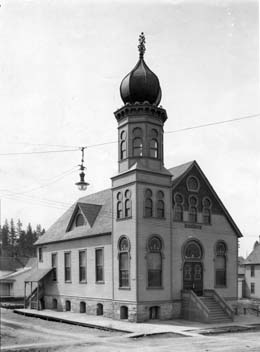
PhotoTitle: Temple
PhotoAttribution: Spokesman Review Archives
Listing Status: N/A
URL: http://properties.historicspokane.org/property/?PropertyID=2090
Display Marker: large_yellow
Title: Temple Emanu-El (demolished)
Description: Date Built: 1892
Architect: Herman Preusse
People of the Jewish faith have participated in the social, economic and political life of the Pacific Northwest from the earliest periods of exploration and settlement. Temple Emanu-El, erected at the corner of Third Avenue and Madison Street, was the first permanent Jewish house of worship in Washington State. The synagogue, designed by the noted Spokane architect Herman Preusse, was a beautiful wood building with decorative windows, entryways and embellished with a striking "onion dome" on top of its tower. The building cost about $3,500 to build and was used until a new temple was built at 8th Avenue and Walnut Street in the 1920s. The original temple remained until 1934.
A marker, erected by the Jewish American Society for Historic Preservation, now sits on the former site of the temple.
Location: 47.653258, -117.428278
Address: 1105 West 3rd Avenue, Spokane WA 99201
PhotoURL:

PhotoTitle: Temple
PhotoAttribution: Spokesman Review Archives
Listing Status: N/A
URL: http://properties.historicspokane.org/property/?PropertyID=2090
Display Marker: large_yellow
ID: 402
Title: North Western Cold Storage Warehouse
Description: Date Built: 1910
Architect: Keith & Whitehouse
Common Name: Cold Storage Warehouse
Built in 1910, the North Western Cold Storage Warehouse is located within a large concentration of commercial and industrial buildings, like bakeries, creameries and factories, that began developing in east downtown around the turn of the century. The warehouse is the largest cold storage, industrial building in Spokane's first refrigerated market district which is comprised of the NW Cold Storage building and the adjoining buildings. Together they supplied refrigeration storage for Spokane dairy, meats and produce in a time when most people relied on iceboxes to keep food cold. John H. McAllister, a contractor and investor, commissioned the noted Spokane architectural firm of Keith & Whitehouse to design the large three-story, brick warehouse. The large block letters painted on the outside of the building made it clear what the building's purpose was. Beginning in 1965 with the Sylvan Furniture Company, the warehouse was cleared of all refrigeration machinery and was never again used for refrigerating, freezing and storing food products.
Location: 47.655810, -117.414387
Address: 116 W Pacific Avenue, Spokane WA, 99201
PhotoURL: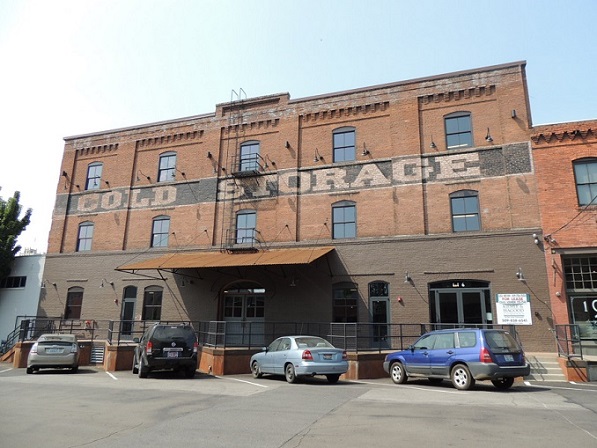
PhotoTitle: warehouse
PhotoAttribution: Spokane City/County Historic Preservation Office
Listing Status: Spokane Register, National Register
URL: http://properties.historicspokane.org/property/?PropertyID=2091
Display Marker: large_yellow
Title: North Western Cold Storage Warehouse
Description: Date Built: 1910
Architect: Keith & Whitehouse
Common Name: Cold Storage Warehouse
Built in 1910, the North Western Cold Storage Warehouse is located within a large concentration of commercial and industrial buildings, like bakeries, creameries and factories, that began developing in east downtown around the turn of the century. The warehouse is the largest cold storage, industrial building in Spokane's first refrigerated market district which is comprised of the NW Cold Storage building and the adjoining buildings. Together they supplied refrigeration storage for Spokane dairy, meats and produce in a time when most people relied on iceboxes to keep food cold. John H. McAllister, a contractor and investor, commissioned the noted Spokane architectural firm of Keith & Whitehouse to design the large three-story, brick warehouse. The large block letters painted on the outside of the building made it clear what the building's purpose was. Beginning in 1965 with the Sylvan Furniture Company, the warehouse was cleared of all refrigeration machinery and was never again used for refrigerating, freezing and storing food products.
Location: 47.655810, -117.414387
Address: 116 W Pacific Avenue, Spokane WA, 99201
PhotoURL:

PhotoTitle: warehouse
PhotoAttribution: Spokane City/County Historic Preservation Office
Listing Status: Spokane Register, National Register
URL: http://properties.historicspokane.org/property/?PropertyID=2091
Display Marker: large_yellow
ID: 403
Title: Bonsall-Taylor House
Description: Date Built: 1920
Built in 1920 on popular Manito Boulevard in the Manito Park subdivision, the Bonsall-Taylor House is a typical example of the bungalow house form embellished in the Craftsman style. The home has a strong, ground-hugging horizontal emphasis and possesses architecturally outstanding cedar shingle siding. The work of a master craftsman, the siding alternates between large and small shingles and encircles the entire house without any breaks. The house was originally home to Louis and Ella Bonsall, owners of Bonsall Clothing, until 1938 when it was sold to Ozro Clair Taylor, local pharmacist, and his wife, Ruth.
Location: 47.629125, -117.408074
Address: 2728 S Manito Blvd, Spokane WA 99203
PhotoURL: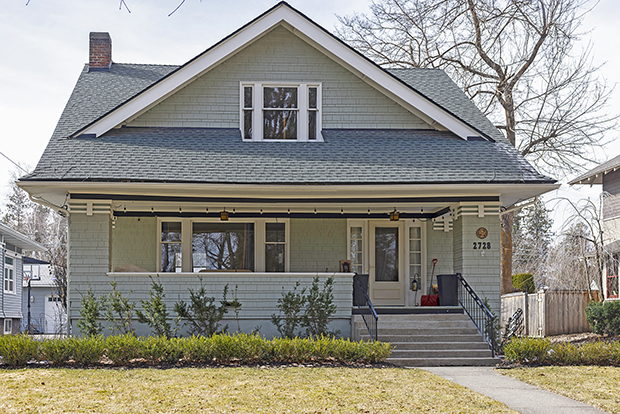
PhotoTitle: bt house
PhotoAttribution: Spokane City/County Historic Preservation Office
Listing Status: Spokane Register
URL: http://properties.historicspokane.org/property/?PropertyID=2092
Display Marker: large_yellow
Title: Bonsall-Taylor House
Description: Date Built: 1920
Built in 1920 on popular Manito Boulevard in the Manito Park subdivision, the Bonsall-Taylor House is a typical example of the bungalow house form embellished in the Craftsman style. The home has a strong, ground-hugging horizontal emphasis and possesses architecturally outstanding cedar shingle siding. The work of a master craftsman, the siding alternates between large and small shingles and encircles the entire house without any breaks. The house was originally home to Louis and Ella Bonsall, owners of Bonsall Clothing, until 1938 when it was sold to Ozro Clair Taylor, local pharmacist, and his wife, Ruth.
Location: 47.629125, -117.408074
Address: 2728 S Manito Blvd, Spokane WA 99203
PhotoURL:

PhotoTitle: bt house
PhotoAttribution: Spokane City/County Historic Preservation Office
Listing Status: Spokane Register
URL: http://properties.historicspokane.org/property/?PropertyID=2092
Display Marker: large_yellow
ID: 404
Title: Spokane Civic Building
Description: Date Built: 1931
Architect: Whitehouse & Price
Common Name: Chamber of Commerce Building
The Spokane Civic Building, built in 1931 by noted Spokane architectural firm, Whitehosue & Price, is an outstanding example of Italian Renaissance architecture and possesses beautiful architectural elements characteristic of the style including the distinctive red Spanish tile roof, symmetrical arrangement and elaborate front porch, also called a loggia, with its impressive arcade of round arches and Classical Order columns. These universal classical traits are combined with other ornamentation that give the building a distinctly Inland Empire feeling through the use of motifs based on local products and activities, such as the pine cone, apple and wheat sheaves designs and in the use of the war bonneted Indian heads. Originally home to the Spokane Chamber of Commerce, the building housed numerous organizations and civic groups throughout the years including the Spokane News Bureau, the U.S. Bureau of Reclamation Spokane office and the Spokane Agricultural Expo. The Spokane Area Chamber of Commerce moved to a larger building at 801 W. Riverside in 2003 and the building is now primarily occupied by the Empire Health Foundation.
Location: 47.658834, -117.427646
Address: 1020 W Riverside Avenue, Spokane WA 99201
PhotoURL: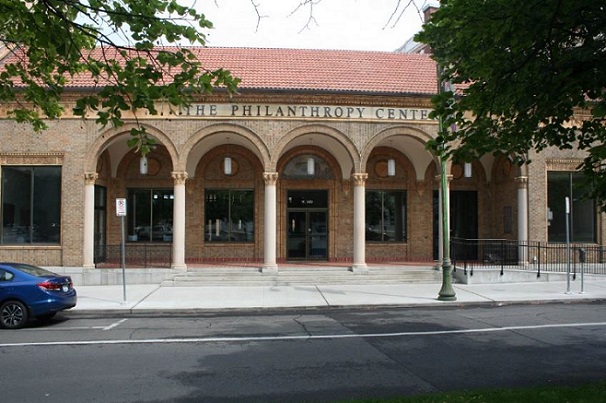
PhotoTitle: scc
PhotoAttribution: Spokane City/County Historic Preservation Office
Listing Status: Spokane Register, National Register
URL: http://properties.historicspokane.org/property/?PropertyID=2093
Display Marker: large_yellow
Title: Spokane Civic Building
Description: Date Built: 1931
Architect: Whitehouse & Price
Common Name: Chamber of Commerce Building
The Spokane Civic Building, built in 1931 by noted Spokane architectural firm, Whitehosue & Price, is an outstanding example of Italian Renaissance architecture and possesses beautiful architectural elements characteristic of the style including the distinctive red Spanish tile roof, symmetrical arrangement and elaborate front porch, also called a loggia, with its impressive arcade of round arches and Classical Order columns. These universal classical traits are combined with other ornamentation that give the building a distinctly Inland Empire feeling through the use of motifs based on local products and activities, such as the pine cone, apple and wheat sheaves designs and in the use of the war bonneted Indian heads. Originally home to the Spokane Chamber of Commerce, the building housed numerous organizations and civic groups throughout the years including the Spokane News Bureau, the U.S. Bureau of Reclamation Spokane office and the Spokane Agricultural Expo. The Spokane Area Chamber of Commerce moved to a larger building at 801 W. Riverside in 2003 and the building is now primarily occupied by the Empire Health Foundation.
Location: 47.658834, -117.427646
Address: 1020 W Riverside Avenue, Spokane WA 99201
PhotoURL:

PhotoTitle: scc
PhotoAttribution: Spokane City/County Historic Preservation Office
Listing Status: Spokane Register, National Register
URL: http://properties.historicspokane.org/property/?PropertyID=2093
Display Marker: large_yellow
ID: 405
Title: Genesee Block
Description: Date Built: 1892
Built in 1892, the Genesee Block, named for reasons unknown, is one of the earliest and last remaining commercial buildings from the 1890s in Spokane's downtown commercial core. A two story, commercial brick building, possessing some Romanesque Revival stylistic features, the Genesee Block has been in continuous operation for over 120 years. Currently vacant due to preservation and restoration efforts, the commercial structure has housed a variety of Spokane businesses over the years including, to name but a few, the Fred T. Merrill Cycle Company in 1895, Staples Candies in 1910, Barlett's Women's Clothing in 1915 and CE Carlson Company Furs by 1929. Interestingly, a cork-lined room used by Carlson for storing furs still exists in the basement.
Location: 47.657687, -117.424464
Address: 819-821 W Riverside Avenue, Spokane WA 99201
PhotoURL: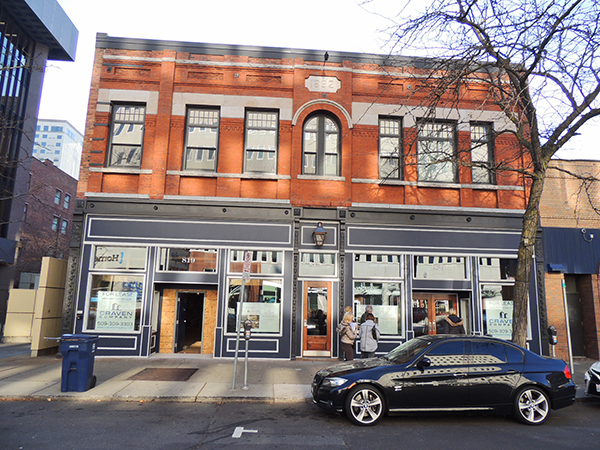
PhotoTitle: 819
PhotoAttribution: Spokane City/County Historic Preservation Office
Listing Status: Spokane Register
URL: http://properties.historicspokane.org/property/?PropertyID=2094
Display Marker: large_yellow
Title: Genesee Block
Description: Date Built: 1892
Built in 1892, the Genesee Block, named for reasons unknown, is one of the earliest and last remaining commercial buildings from the 1890s in Spokane's downtown commercial core. A two story, commercial brick building, possessing some Romanesque Revival stylistic features, the Genesee Block has been in continuous operation for over 120 years. Currently vacant due to preservation and restoration efforts, the commercial structure has housed a variety of Spokane businesses over the years including, to name but a few, the Fred T. Merrill Cycle Company in 1895, Staples Candies in 1910, Barlett's Women's Clothing in 1915 and CE Carlson Company Furs by 1929. Interestingly, a cork-lined room used by Carlson for storing furs still exists in the basement.
Location: 47.657687, -117.424464
Address: 819-821 W Riverside Avenue, Spokane WA 99201
PhotoURL:

PhotoTitle: 819
PhotoAttribution: Spokane City/County Historic Preservation Office
Listing Status: Spokane Register
URL: http://properties.historicspokane.org/property/?PropertyID=2094
Display Marker: large_yellow
ID: 406
Title: Hutton Elementary School
Description: Date Built: 1921
Architect: Rigg & Vantyne
Constructed in 1921 with additions in 1930-31, Hutton Elementary School is significant for its contribution to public education in Spokane and for its unique Spanish Eclectic design. Consisting of stucco walls, red tile roof and arcaded entry, Hutton is the only Spokane school that is built in this architectural style. Designed by master architect, Archibald G. Rigg, and his partner, Roland Van Tyne, the school building rises prominently on an elevated basalt and earthen platform, making it a South Hill Landmark. Named after mining millionaire and public benefactor, Levi H. Hutton, the school has been serving the children of Spokane for almost 100 years.
Location: 47.632643, -117.396469
Address: 908 E 24th Avenue, Spokane WA 99203
PhotoURL: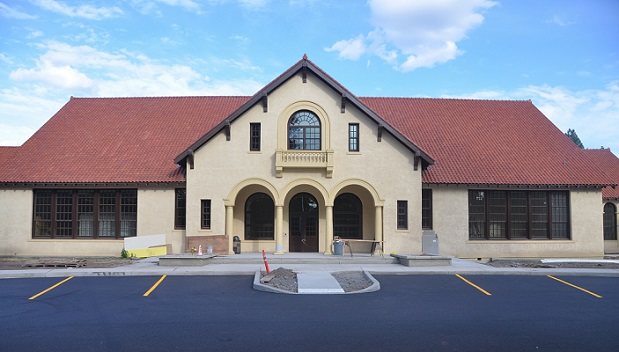
PhotoTitle: he
PhotoAttribution: Spokane City/County Historic Preservation Office
Listing Status: Spokane Register, National Register
URL: http://properties.historicspokane.org/property/?PropertyID=2095
Display Marker: large_yellow
Title: Hutton Elementary School
Description: Date Built: 1921
Architect: Rigg & Vantyne
Constructed in 1921 with additions in 1930-31, Hutton Elementary School is significant for its contribution to public education in Spokane and for its unique Spanish Eclectic design. Consisting of stucco walls, red tile roof and arcaded entry, Hutton is the only Spokane school that is built in this architectural style. Designed by master architect, Archibald G. Rigg, and his partner, Roland Van Tyne, the school building rises prominently on an elevated basalt and earthen platform, making it a South Hill Landmark. Named after mining millionaire and public benefactor, Levi H. Hutton, the school has been serving the children of Spokane for almost 100 years.
Location: 47.632643, -117.396469
Address: 908 E 24th Avenue, Spokane WA 99203
PhotoURL:

PhotoTitle: he
PhotoAttribution: Spokane City/County Historic Preservation Office
Listing Status: Spokane Register, National Register
URL: http://properties.historicspokane.org/property/?PropertyID=2095
Display Marker: large_yellow
ID: 408
Title: Lowell School
Description: Date Built: 1899, 1917
Architect: Albert Held, C. Harvey Smith
Located in the center of Latah Valley in southwest Spokane, the Lowell School was originally built in 1899 and enlarged/remodeled in 1917 to accommodate an increased student population growth. However, little remains of the 1899 structure except the basement and foundation. Designed by prominent Spokane architects, Albert Held (1899) and C. Harvey Smith (1917), the stucco-clad schoolhouse is a one story Mission Revival building with a low-pitched hip roof, wide overhanging eaves and arched windows. Named in honor of James Russell Lowell, a noted American educator, philosopher and poet, the building remained a public school until 1954 when it was converted to storage space and then a private residence. The building is currently undergoing restoration work to not only restore the architecture but to convert it to a restaurant.
Location: 47.634008, -117.440342
Address: 2225 S. Inland Empire Way, Spokane WA 99224
PhotoURL: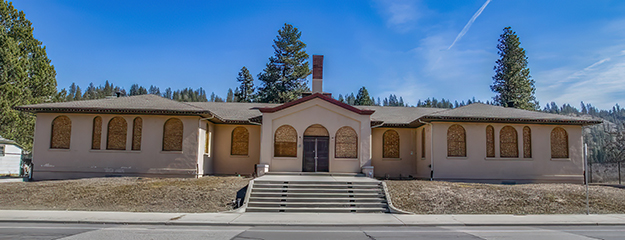
PhotoTitle: ls
PhotoAttribution: Spokane CC HPO
Listing Status: Spokane Register
URL: http://properties.historicspokane.org/property/?PropertyID=2097
Display Marker: large_yellow
Title: Lowell School
Description: Date Built: 1899, 1917
Architect: Albert Held, C. Harvey Smith
Located in the center of Latah Valley in southwest Spokane, the Lowell School was originally built in 1899 and enlarged/remodeled in 1917 to accommodate an increased student population growth. However, little remains of the 1899 structure except the basement and foundation. Designed by prominent Spokane architects, Albert Held (1899) and C. Harvey Smith (1917), the stucco-clad schoolhouse is a one story Mission Revival building with a low-pitched hip roof, wide overhanging eaves and arched windows. Named in honor of James Russell Lowell, a noted American educator, philosopher and poet, the building remained a public school until 1954 when it was converted to storage space and then a private residence. The building is currently undergoing restoration work to not only restore the architecture but to convert it to a restaurant.
Location: 47.634008, -117.440342
Address: 2225 S. Inland Empire Way, Spokane WA 99224
PhotoURL:

PhotoTitle: ls
PhotoAttribution: Spokane CC HPO
Listing Status: Spokane Register
URL: http://properties.historicspokane.org/property/?PropertyID=2097
Display Marker: large_yellow
ID: 409
Title: Manito Park
Description: Date Built: 1904
Landscape Architect: Olmsted Brothers, Harold T. Abbott, Nagado Sakuri
Architect: Chester A. Houghtaling
Used as a park as early as 1886, by 1891, when the City of Spokane began formally accepting donations of land for public parks, "Montrose Park," as it was originally called, was an established recreational area. Renamed "Manito" in 1903, the park was officially dedicated to the city in 1904 and became the public space cherished today. An evolving landscape, Manito Park has remained Spokane's primary community park since its inception and helps tell the story of recreation, culture, politics and landscape architecture in Spokane. This history is seen and experienced in the basalt-rubble structures, remnants of trolley lines, water features, exceptional flower gardens, such as the Formal Rose Garden and Duncan Gardens, and in the ever-serene Nishinomiya Tsutakawa Japanese Gardens. Truly a jewel of the city, Manito Park and Boulevard has provided recreational and cultural delight for over 100 years.
Manito Park and Boulevard's nomination to be placed on the National Register of Historic Places is currently pending.
Location: 47.636667, -117.410938
Address: 1702 S. Grand Blvd., Spokane WA 99203
PhotoURL: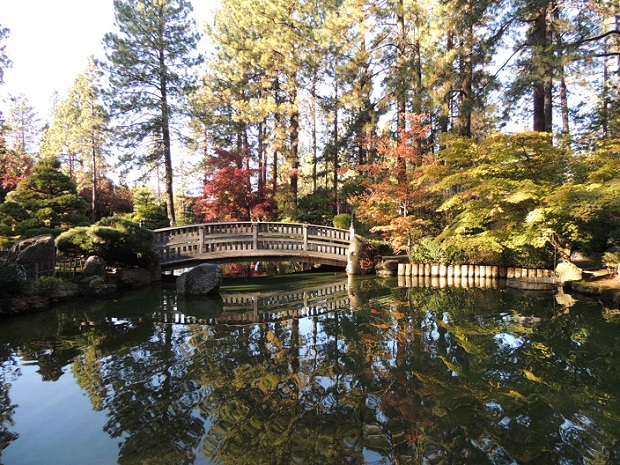
PhotoTitle: manito
PhotoAttribution: SCC HPO
Listing Status: Pending
URL: http://properties.historicspokane.org/property/?PropertyID=2098
Display Marker: large_yellow
Title: Manito Park
Description: Date Built: 1904
Landscape Architect: Olmsted Brothers, Harold T. Abbott, Nagado Sakuri
Architect: Chester A. Houghtaling
Used as a park as early as 1886, by 1891, when the City of Spokane began formally accepting donations of land for public parks, "Montrose Park," as it was originally called, was an established recreational area. Renamed "Manito" in 1903, the park was officially dedicated to the city in 1904 and became the public space cherished today. An evolving landscape, Manito Park has remained Spokane's primary community park since its inception and helps tell the story of recreation, culture, politics and landscape architecture in Spokane. This history is seen and experienced in the basalt-rubble structures, remnants of trolley lines, water features, exceptional flower gardens, such as the Formal Rose Garden and Duncan Gardens, and in the ever-serene Nishinomiya Tsutakawa Japanese Gardens. Truly a jewel of the city, Manito Park and Boulevard has provided recreational and cultural delight for over 100 years.
Manito Park and Boulevard's nomination to be placed on the National Register of Historic Places is currently pending.
Location: 47.636667, -117.410938
Address: 1702 S. Grand Blvd., Spokane WA 99203
PhotoURL:

PhotoTitle: manito
PhotoAttribution: SCC HPO
Listing Status: Pending
URL: http://properties.historicspokane.org/property/?PropertyID=2098
Display Marker: large_yellow
ID: 412
Title: Rombeck-Dutch's Loans Building
Description: Date Built: 1927, ~1903
Builder: F.E. Martin
Common Name: Huppin's Building
The Rombeck-Dutch's Loan Building consists of two adjacent buildings that were combined into one ownership in 1986: a two-story, brick vernacular commercial Single Room Occupancy Hotel, the Rombeck, which was built by Henry Rombeck in 1927, and the one-story, brick vernacular commercial building, which was built around 1903 and operated as Dutch's Loans, immediately to the east. The Rombeck, accentuated by Classical elemetns, appears to have been the last SRO constructed in downtown Spokane. Dutch's Loans was built by Ernest Azzi during Spokane's most significant period of growth, 1900-1910, and remains an integral element of a bock that contains three of the earliest of Spokane's post-fire buildings. The Rombeck-Dutch's Loans Building continued a legacy of pawn, jewelry, second hand and loan businesses on West Main, most owned and operated by Jewish businessmen who would become prominent families in Spokane's downtown core.
Location: 47.658822, -117.419030
Address: 421 W Main Avenue, Spokane WA 99201
PhotoURL: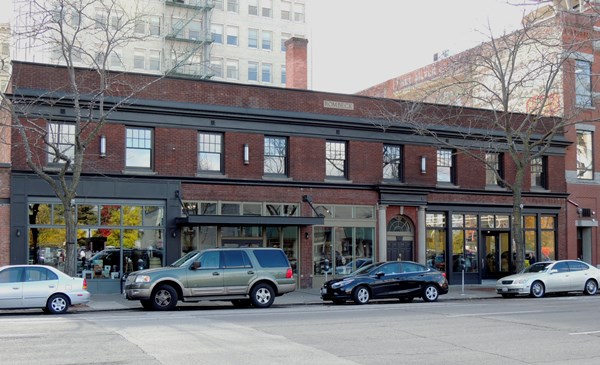
PhotoTitle: rdl
PhotoAttribution: scchpo
Listing Status: Spokane Register
URL: http://properties.historicspokane.org/property/?PropertyID=2101
Display Marker: large_yellow
Title: Rombeck-Dutch's Loans Building
Description: Date Built: 1927, ~1903
Builder: F.E. Martin
Common Name: Huppin's Building
The Rombeck-Dutch's Loan Building consists of two adjacent buildings that were combined into one ownership in 1986: a two-story, brick vernacular commercial Single Room Occupancy Hotel, the Rombeck, which was built by Henry Rombeck in 1927, and the one-story, brick vernacular commercial building, which was built around 1903 and operated as Dutch's Loans, immediately to the east. The Rombeck, accentuated by Classical elemetns, appears to have been the last SRO constructed in downtown Spokane. Dutch's Loans was built by Ernest Azzi during Spokane's most significant period of growth, 1900-1910, and remains an integral element of a bock that contains three of the earliest of Spokane's post-fire buildings. The Rombeck-Dutch's Loans Building continued a legacy of pawn, jewelry, second hand and loan businesses on West Main, most owned and operated by Jewish businessmen who would become prominent families in Spokane's downtown core.
Location: 47.658822, -117.419030
Address: 421 W Main Avenue, Spokane WA 99201
PhotoURL:

PhotoTitle: rdl
PhotoAttribution: scchpo
Listing Status: Spokane Register
URL: http://properties.historicspokane.org/property/?PropertyID=2101
Display Marker: large_yellow
ID: 410
Title: Hutsinpiller House
Description: Date Built: 1926
The Hutsinpiller House and Garage are significant for their fine, artistic representation of the Craftsman style and bungalow house form and are remarkably intact and meticulously preserved. With horizontal emphasis produced by a low-pitched roof, clipped jerkinhead gable peaks, widely overhanging eaves, tapered porch pillars, raked brick cladding with deeply incised shadowed grout lines, the property has a ground-hugging, low-slung form — all tenets of the Craftsman style and the bungalow house form. The home’s interior lends further architectural significance to the property with smooth, well-preserved, superior quality woodwork made of gumwood, a rare specialty hardwood. The home was custom-built for United States Railway Mail Service clerk, J. Elmer Hutsinpiller, and his wife, Hester M. Hutsinpiller. Three generations of the Hutsinpiller family owned the property for more than 70 consecutive years — a strong testament to the well-designed, well-built Hutsinpiller House and the longstanding popularity of the surrounding residential Cannon Hill-Manito Park neighborhood.
Location: 47.629766, -117.411663
Address: 3 W 27th Avenue, Spokane WA 99203
PhotoURL: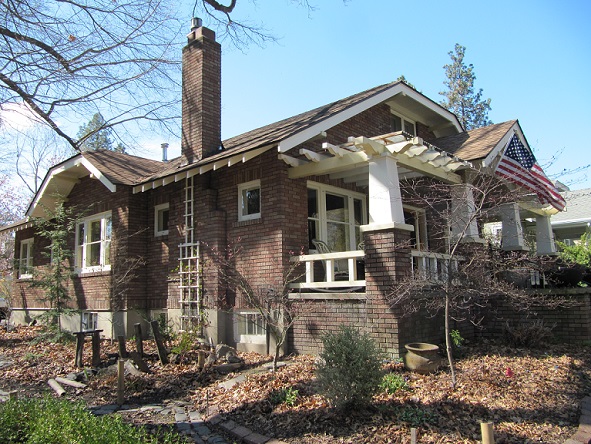
PhotoTitle: hh
PhotoAttribution: scchpo
Listing Status: Spokane Register
URL: http://properties.historicspokane.org/property/?PropertyID=2099
Display Marker: large_yellow
Title: Hutsinpiller House
Description: Date Built: 1926
The Hutsinpiller House and Garage are significant for their fine, artistic representation of the Craftsman style and bungalow house form and are remarkably intact and meticulously preserved. With horizontal emphasis produced by a low-pitched roof, clipped jerkinhead gable peaks, widely overhanging eaves, tapered porch pillars, raked brick cladding with deeply incised shadowed grout lines, the property has a ground-hugging, low-slung form — all tenets of the Craftsman style and the bungalow house form. The home’s interior lends further architectural significance to the property with smooth, well-preserved, superior quality woodwork made of gumwood, a rare specialty hardwood. The home was custom-built for United States Railway Mail Service clerk, J. Elmer Hutsinpiller, and his wife, Hester M. Hutsinpiller. Three generations of the Hutsinpiller family owned the property for more than 70 consecutive years — a strong testament to the well-designed, well-built Hutsinpiller House and the longstanding popularity of the surrounding residential Cannon Hill-Manito Park neighborhood.
Location: 47.629766, -117.411663
Address: 3 W 27th Avenue, Spokane WA 99203
PhotoURL:

PhotoTitle: hh
PhotoAttribution: scchpo
Listing Status: Spokane Register
URL: http://properties.historicspokane.org/property/?PropertyID=2099
Display Marker: large_yellow
ID: 411
Title: Jimmie Durkin Building
Description: Date Built: 1903, 1910
The Jimmie Durkin Building consists of two adjacent buildings that have been combined into one ownership sometime prior to 1948: a three story, brick vernacular commercial Single Room Occupancy hotel built in 1910 and the one story, stucco-clad vernacular commercial building, which was built in 1903, to the east. Both buildings were constructed during Spokane’s most significant period of growth, 1900 through 1910, and remain integral elements of a block that contains three of the earliest of Spokane’s post-fire buildings. The three story building housed the saloon of the Inland Empire’s leading liquor dealer and one of the most colorful characters in Spokane’s early history, Jimmie Durkin. Durkin’s saloon operated into the advent of Prohibition in Washington State, 1916, survived and plodded on after its repeal in 1933. Becoming Dutch’s Loans in the late 1990s, the buildings continued a legacy of pawn, jewelry, second hand and loan businesses on West Main, most owned and operated by Jewish businessmen who would become prominent families in Spokane’s downtown core.
Location: 47.658834, -117.418698
Address: 409 W Main Avenue, Spokane WA 99201
PhotoURL: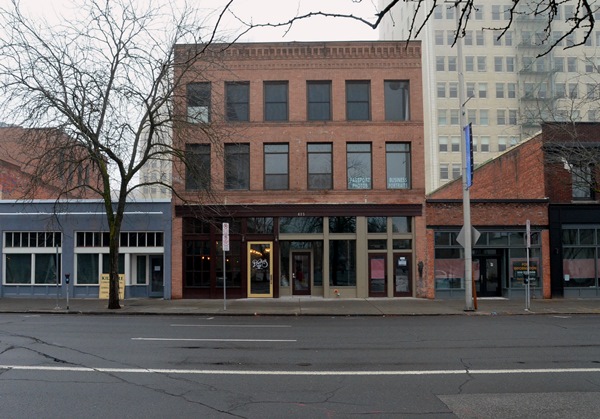
PhotoTitle: jdb
PhotoAttribution: scchpo
Listing Status: Spokane Register
URL: http://properties.historicspokane.org/property/?PropertyID=2100
Display Marker: large_yellow
Title: Jimmie Durkin Building
Description: Date Built: 1903, 1910
The Jimmie Durkin Building consists of two adjacent buildings that have been combined into one ownership sometime prior to 1948: a three story, brick vernacular commercial Single Room Occupancy hotel built in 1910 and the one story, stucco-clad vernacular commercial building, which was built in 1903, to the east. Both buildings were constructed during Spokane’s most significant period of growth, 1900 through 1910, and remain integral elements of a block that contains three of the earliest of Spokane’s post-fire buildings. The three story building housed the saloon of the Inland Empire’s leading liquor dealer and one of the most colorful characters in Spokane’s early history, Jimmie Durkin. Durkin’s saloon operated into the advent of Prohibition in Washington State, 1916, survived and plodded on after its repeal in 1933. Becoming Dutch’s Loans in the late 1990s, the buildings continued a legacy of pawn, jewelry, second hand and loan businesses on West Main, most owned and operated by Jewish businessmen who would become prominent families in Spokane’s downtown core.
Location: 47.658834, -117.418698
Address: 409 W Main Avenue, Spokane WA 99201
PhotoURL:

PhotoTitle: jdb
PhotoAttribution: scchpo
Listing Status: Spokane Register
URL: http://properties.historicspokane.org/property/?PropertyID=2100
Display Marker: large_yellow
ID: 413
Title: Eikenbary-Pierce House
Description: Date Built: 1910
Builder: Anton Isakson
The Eikenbary-Pierce House was built in 1910, a block east of Cliff Park in the architecturally prominent historic neighborhood on the South Hill. Arts & Crafts in style, the home possesses beautiful and stylistic Craftsman features such as the low-pitched roof, tapered porch pillars, overhanging eaves and incredible interior woodwork. Additionally, a very interesting piece of the history of this Arts and Crafts home is its connection to the founders of Shriner's Hospital. The building is significant for its association with Henry A. Pierce and Dr. Charles F. Eikenbary, two of Spokane’s most prominent civic benefactors and philanthropists, and the property’s most significant owners. Henry A. Pierce helped organize the Shriners Hospital for Crippled Children (as it was then called) in Spokane and served as Chairman of the Board of Governors for the hospital for 35 years from its inception in 1924 to his death in 1959. Pierce hired Dr. Charles Eikenbary as the first orthopedic surgeon and Medical Chief-of-Staff for the Shriners Hospital (1924-1926) and who lived in the house from 1913 to 1923.
Location: 47.643688, -117.415542
Address: 1303 S Bernard Street, Spokane WA 99204
PhotoURL: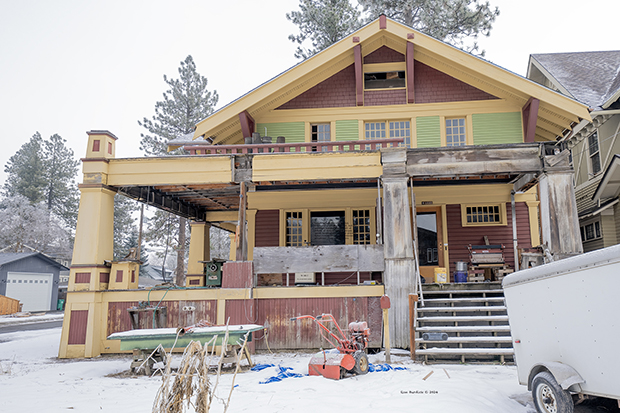
PhotoTitle: 1303
PhotoAttribution: scchpo
Listing Status: Spokane Register
URL: http://properties.historicspokane.org/property/?PropertyID=2103
Display Marker: large_yellow
Title: Eikenbary-Pierce House
Description: Date Built: 1910
Builder: Anton Isakson
The Eikenbary-Pierce House was built in 1910, a block east of Cliff Park in the architecturally prominent historic neighborhood on the South Hill. Arts & Crafts in style, the home possesses beautiful and stylistic Craftsman features such as the low-pitched roof, tapered porch pillars, overhanging eaves and incredible interior woodwork. Additionally, a very interesting piece of the history of this Arts and Crafts home is its connection to the founders of Shriner's Hospital. The building is significant for its association with Henry A. Pierce and Dr. Charles F. Eikenbary, two of Spokane’s most prominent civic benefactors and philanthropists, and the property’s most significant owners. Henry A. Pierce helped organize the Shriners Hospital for Crippled Children (as it was then called) in Spokane and served as Chairman of the Board of Governors for the hospital for 35 years from its inception in 1924 to his death in 1959. Pierce hired Dr. Charles Eikenbary as the first orthopedic surgeon and Medical Chief-of-Staff for the Shriners Hospital (1924-1926) and who lived in the house from 1913 to 1923.
Location: 47.643688, -117.415542
Address: 1303 S Bernard Street, Spokane WA 99204
PhotoURL:

PhotoTitle: 1303
PhotoAttribution: scchpo
Listing Status: Spokane Register
URL: http://properties.historicspokane.org/property/?PropertyID=2103
Display Marker: large_yellow
ID: 414
Title: Vinther and Nelson Hardware Building
Description: Date Built: 1905
Architect: Isaac Galbraith
Common Name: The Hub
Built in 1905, the Vinther and Nelson Hardware Building was designed by Isaac Galbraith, an architect who practiced in Spokane in the first decade of the 20th Century. It is a good, although deteriorated, example of the brick commercial style that became the dominant architectural idiom in early urban America, especially after fire had ravaged many wood frame structures. Although portions of the front facade of the building have been altered, distinctive historic features remain, such as the detailed bas relief ornamentation. The building was built by two enterprising cousins from Denmark, Samuel Vinther and Nels Nelson, who began their careers in the Pacific Northwest in 1982 as common laborers for the railroads. In little over a decade, they were able to create and maintain a successful hardware store which was managed by their sons until 1963. The Vinther and Nelson Hardware Building is significant for its architecture, its story and its contributions to the economy of Spokane especially as it developed on the north side of the Spokane River, made possible by new bridges and the new street railroad system. The story of two humble immigrants making a go at it, and finding financial success in an environment of bustling commercial activity, surviving even the major mid-century economic downturns, is riveting. The tale of Samuel Vinther and Nels Nelson is a leitmotif of the story of early Spokane.
Location: 47.663701, -117.426359
Address: 706 N Monroe Street, Spokane WA 99201
PhotoURL: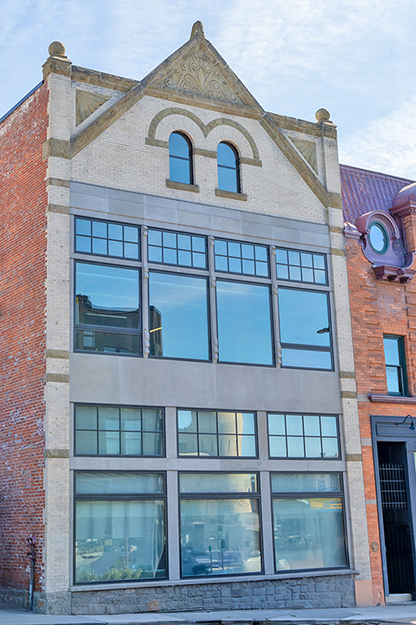
PhotoTitle: 706
PhotoAttribution: scchpo
Listing Status: Spokane Register
URL: http://properties.historicspokane.org/property/?PropertyID=2102
Display Marker: large_yellow
Title: Vinther and Nelson Hardware Building
Description: Date Built: 1905
Architect: Isaac Galbraith
Common Name: The Hub
Built in 1905, the Vinther and Nelson Hardware Building was designed by Isaac Galbraith, an architect who practiced in Spokane in the first decade of the 20th Century. It is a good, although deteriorated, example of the brick commercial style that became the dominant architectural idiom in early urban America, especially after fire had ravaged many wood frame structures. Although portions of the front facade of the building have been altered, distinctive historic features remain, such as the detailed bas relief ornamentation. The building was built by two enterprising cousins from Denmark, Samuel Vinther and Nels Nelson, who began their careers in the Pacific Northwest in 1982 as common laborers for the railroads. In little over a decade, they were able to create and maintain a successful hardware store which was managed by their sons until 1963. The Vinther and Nelson Hardware Building is significant for its architecture, its story and its contributions to the economy of Spokane especially as it developed on the north side of the Spokane River, made possible by new bridges and the new street railroad system. The story of two humble immigrants making a go at it, and finding financial success in an environment of bustling commercial activity, surviving even the major mid-century economic downturns, is riveting. The tale of Samuel Vinther and Nels Nelson is a leitmotif of the story of early Spokane.
Location: 47.663701, -117.426359
Address: 706 N Monroe Street, Spokane WA 99201
PhotoURL:

PhotoTitle: 706
PhotoAttribution: scchpo
Listing Status: Spokane Register
URL: http://properties.historicspokane.org/property/?PropertyID=2102
Display Marker: large_yellow
ID: 415
Title: Bradley House
Description: Date Built: 1909
Builder: Aaron L. Lundquist
The William O. Bradly House, located on a the lovely, tree-lined Ninth Avenue, is a fine representation of the Mission Revival style and is an exemplary product of master Spokane builder, Aaron L. Lundquist. Its high artistic values are expressed in multiple shaped parapets, characteristics of the Mission Revival style, and in interior woodwork crafted in curly fir and finished the deepest ebony hue. The house was named for Dr. Bradley, a dentist who practiced in Spokane for 58 years and was the property's first and most prominent owner. The home is a contributing resource in the Ninth Avenue National Register Historic District, which was listed in 1994, and retains a high degree of integrity.
Location: 47.647084, -117.437437
Address: 1703 W. Ninth Avenue
PhotoURL: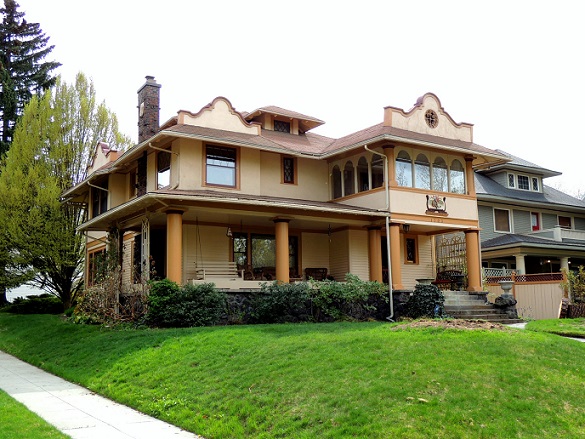
PhotoTitle: bradley
PhotoAttribution: shpo
Listing Status: Spokane Register, National Register
URL: http://properties.historicspokane.org/property/?PropertyID=2104
Display Marker: large_yellow
Title: Bradley House
Description: Date Built: 1909
Builder: Aaron L. Lundquist
The William O. Bradly House, located on a the lovely, tree-lined Ninth Avenue, is a fine representation of the Mission Revival style and is an exemplary product of master Spokane builder, Aaron L. Lundquist. Its high artistic values are expressed in multiple shaped parapets, characteristics of the Mission Revival style, and in interior woodwork crafted in curly fir and finished the deepest ebony hue. The house was named for Dr. Bradley, a dentist who practiced in Spokane for 58 years and was the property's first and most prominent owner. The home is a contributing resource in the Ninth Avenue National Register Historic District, which was listed in 1994, and retains a high degree of integrity.
Location: 47.647084, -117.437437
Address: 1703 W. Ninth Avenue
PhotoURL:

PhotoTitle: bradley
PhotoAttribution: shpo
Listing Status: Spokane Register, National Register
URL: http://properties.historicspokane.org/property/?PropertyID=2104
Display Marker: large_yellow
ID: 416
Title: Plummer-Wheeler House
Description: Date Built: 1912
Builder: Earl W. Morrison/ Amil T. Johnson
Construction of the Plummer-Wheeler House began in 1912 and was completed in 1913. The Plummer-Wheeler House is an excellent rendition of the American Foursquare house form. The home was built for $20,000 - eclipsing by nearly four times the minimum building cost required by neighborhood covenants. The Plummer-Wheeler House is a product of two of Spokane’s most prominent Spokane construction professionals, architect Earl W. Morrison and building contractor Amil T. Johnson. During its period of significance from 1912 to 1951, the Plummer-Wheeler House achieved historical significance for its associations with Spokane attorney William H. Plummer and Spokane surgeon Dr. Herbert E. Wheeler, the home’s two earliest and most significant residents.
Location: 47°38'10.9"N 117°23'53.9"W
Address: 2007 S. Rockwood Blvd
PhotoURL: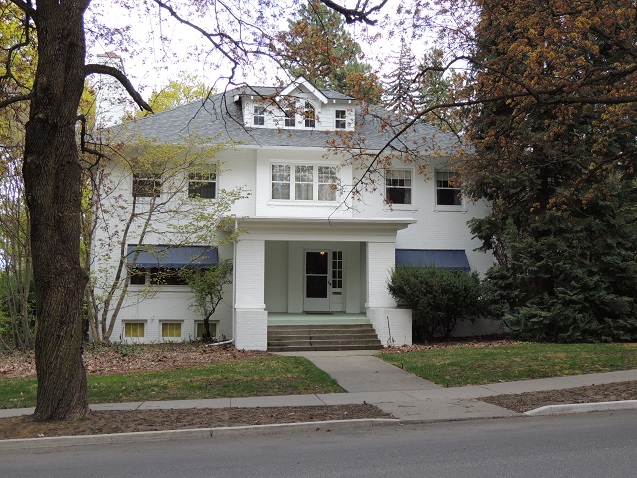
PhotoTitle: Plummer-Wheeler House
PhotoAttribution: SHPO
Listing Status: Spokane Register, National Register
URL: http://properties.historicspokane.org/property/?PropertyID=2105
Display Marker: large_yellow
Title: Plummer-Wheeler House
Description: Date Built: 1912
Builder: Earl W. Morrison/ Amil T. Johnson
Construction of the Plummer-Wheeler House began in 1912 and was completed in 1913. The Plummer-Wheeler House is an excellent rendition of the American Foursquare house form. The home was built for $20,000 - eclipsing by nearly four times the minimum building cost required by neighborhood covenants. The Plummer-Wheeler House is a product of two of Spokane’s most prominent Spokane construction professionals, architect Earl W. Morrison and building contractor Amil T. Johnson. During its period of significance from 1912 to 1951, the Plummer-Wheeler House achieved historical significance for its associations with Spokane attorney William H. Plummer and Spokane surgeon Dr. Herbert E. Wheeler, the home’s two earliest and most significant residents.
Location: 47°38'10.9"N 117°23'53.9"W
Address: 2007 S. Rockwood Blvd
PhotoURL:

PhotoTitle: Plummer-Wheeler House
PhotoAttribution: SHPO
Listing Status: Spokane Register, National Register
URL: http://properties.historicspokane.org/property/?PropertyID=2105
Display Marker: large_yellow
ID: 417
Title: Love House
Description: Date Built: 1912
Builder: Unknown/Harry E. Brokaw
Located in the Cannon Hill Park neighborhood, the Love House is a picture perfect example of Craftsman design. Built in 1912 as a part of a South Hill housing development, this home has experienced few changes over the decades. The Love House features a recognizable tapered chimney, spacious front porch, and rough textured brick and basalt rock on the exterior of the home as well as extensive interior oak wood work. Henry Love and his wife Frances were the first owners of the home. Henry was employed by a local loan company before starting and managing his own real estate business in Spokane. After the Loves sold the house in 1917, the property was home to many families with the current residents owning the home since 1994.
Location: 47°37'59.0"N 117°25'06.0"W
Address: 436 W. 24th Ave.
PhotoURL: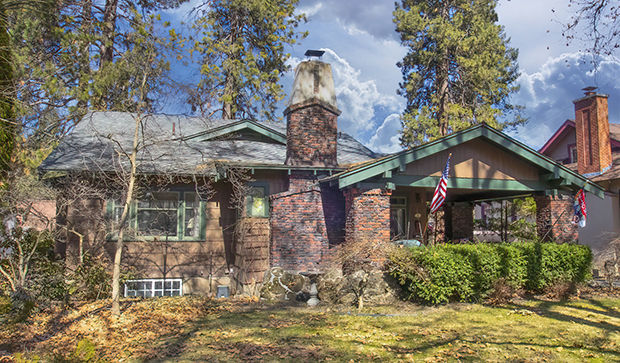
PhotoTitle: Love House
PhotoAttribution: SHPO
Listing Status: Spokane Register
URL: http://properties.historicspokane.org/property/?PropertyID=2106
Display Marker: large_yellow
Title: Love House
Description: Date Built: 1912
Builder: Unknown/Harry E. Brokaw
Located in the Cannon Hill Park neighborhood, the Love House is a picture perfect example of Craftsman design. Built in 1912 as a part of a South Hill housing development, this home has experienced few changes over the decades. The Love House features a recognizable tapered chimney, spacious front porch, and rough textured brick and basalt rock on the exterior of the home as well as extensive interior oak wood work. Henry Love and his wife Frances were the first owners of the home. Henry was employed by a local loan company before starting and managing his own real estate business in Spokane. After the Loves sold the house in 1917, the property was home to many families with the current residents owning the home since 1994.
Location: 47°37'59.0"N 117°25'06.0"W
Address: 436 W. 24th Ave.
PhotoURL:

PhotoTitle: Love House
PhotoAttribution: SHPO
Listing Status: Spokane Register
URL: http://properties.historicspokane.org/property/?PropertyID=2106
Display Marker: large_yellow
ID: 418
Title: Treaty Tree
Description: Located in an area traditionally utilized by the Upper Spokane Indians, the Treaty Tree acted as a meeting and gathering place for tribe members. This tall Ponderosa Pine is named for the discussion that is said to have taken place in the shade of its limbs about the demands for peace from Col. George Wright in 1858. The land on which the tree sits was later granted to Baptiste Peone under the Donation Land Act of 1850. Peone, half white and half Indian, was the only person in the county to receive land under this Act. The noble Treaty Tree stands alone on a low hill as the only evidence remaining of Peone's homestead and the original Saint Michael Mission, also located on this land. The Treaty Tree is not listed on the Spokane Heritage Tree Register but was included in the 1997 Historic Resources Inventory of Spokane County.
Location: 47.750673, -117.306525
Address: East Dorak Road
PhotoURL: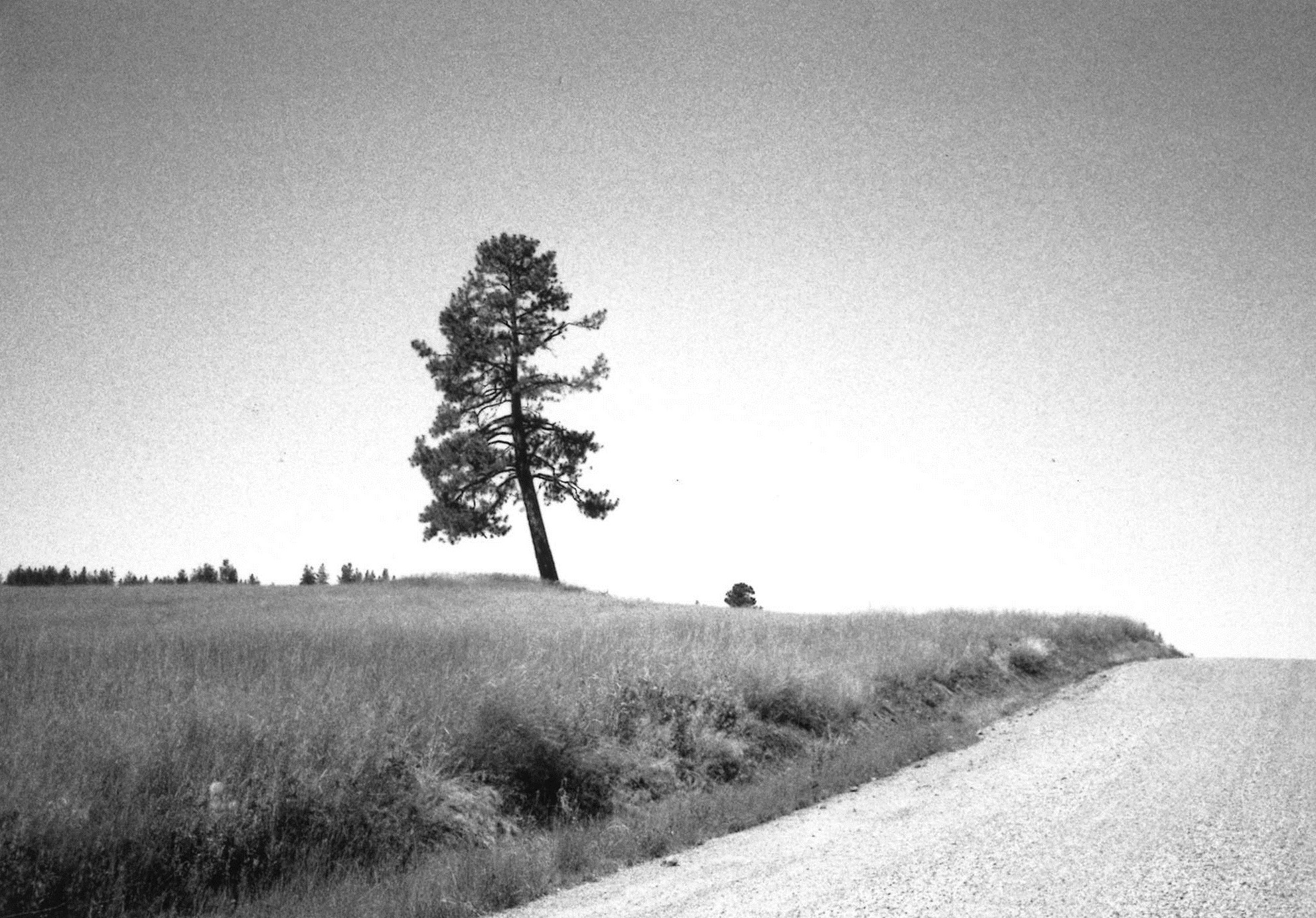
PhotoTitle: Treaty Tree
PhotoAttribution:
Listing Status: N/A
URL:
Display Marker: large_green
Title: Treaty Tree
Description: Located in an area traditionally utilized by the Upper Spokane Indians, the Treaty Tree acted as a meeting and gathering place for tribe members. This tall Ponderosa Pine is named for the discussion that is said to have taken place in the shade of its limbs about the demands for peace from Col. George Wright in 1858. The land on which the tree sits was later granted to Baptiste Peone under the Donation Land Act of 1850. Peone, half white and half Indian, was the only person in the county to receive land under this Act. The noble Treaty Tree stands alone on a low hill as the only evidence remaining of Peone's homestead and the original Saint Michael Mission, also located on this land. The Treaty Tree is not listed on the Spokane Heritage Tree Register but was included in the 1997 Historic Resources Inventory of Spokane County.
Location: 47.750673, -117.306525
Address: East Dorak Road
PhotoURL:

PhotoTitle: Treaty Tree
PhotoAttribution:
Listing Status: N/A
URL:
Display Marker: large_green
ID: 420
Title: The Towering Norwegian
Description: Height: ~123 feet
Species: Norway Spruce
This giant spruce is most likely the second tallest of its kind in the city, falling short of only the Brewton Spruce on 26th street. Standing over 120 feet tall and with a crown measuring nearly 50 feet, this tree is notable for its impressive size among the other giants located in the Finch Arboretum.
Location: 47.642152, -117.466827
Address: 3404 West Woodland Boulevard, Spokane WA 99224
PhotoURL: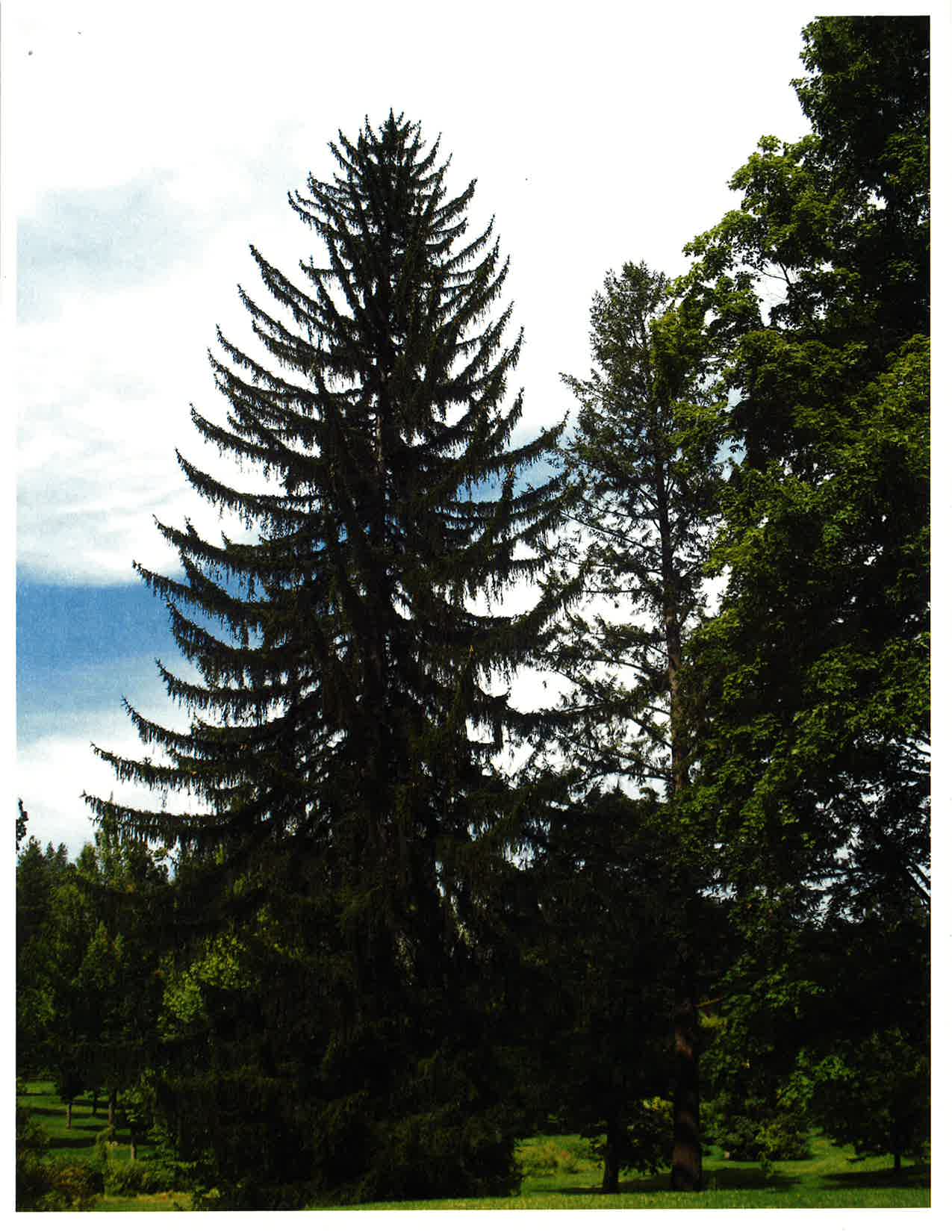
PhotoTitle: Norway Spruce
PhotoAttribution: City of Spokane Parks and Recreation
Listing Status: Spokane Heritage Tree Register
URL: https://my.spokanecity.org/urbanforestry/programs/heritage-tree/
Display Marker: large_green
Title: The Towering Norwegian
Description: Height: ~123 feet
Species: Norway Spruce
This giant spruce is most likely the second tallest of its kind in the city, falling short of only the Brewton Spruce on 26th street. Standing over 120 feet tall and with a crown measuring nearly 50 feet, this tree is notable for its impressive size among the other giants located in the Finch Arboretum.
Location: 47.642152, -117.466827
Address: 3404 West Woodland Boulevard, Spokane WA 99224
PhotoURL:

PhotoTitle: Norway Spruce
PhotoAttribution: City of Spokane Parks and Recreation
Listing Status: Spokane Heritage Tree Register
URL: https://my.spokanecity.org/urbanforestry/programs/heritage-tree/
Display Marker: large_green
ID: 419
Title: Munroe & Helen Burr House
Description: Date Built: 1912
Builder: Allister Mack Laing
The Munroe & Helen Burr House, constructed in 1912, is a textbook example of a Craftsman style home. Located in the Rockwood neighborhood on Spokane’s South Hill, the home was occupied by the Burrs until it was sold in 1916. Munroe Burr was a long time resident of Spokane and operated his own electric company for many years. The low roof line, noticeable “eyebrow” dormer and wide eaves combine to create an exaggerated horizontal appearance – a hallmark of the Craftsman style. Interior woodwork is prominently expressed in deep ebony-colored curly- and vertical-grain fir, hand-rubbed to a rich patina. The unique basalt rock retaining wall bordering the driveway on the west side of the house was built at the same time as the home making it an original feature of the property. Well-preserved, the Burr House retains a high degree of exterior and interior architectural integrity in original location, design, materials, craftsmanship, and association.
Location: 47.634411, -117.401329
Address: 628 East 22nd Avenue, Spokane, WA 99203
PhotoURL: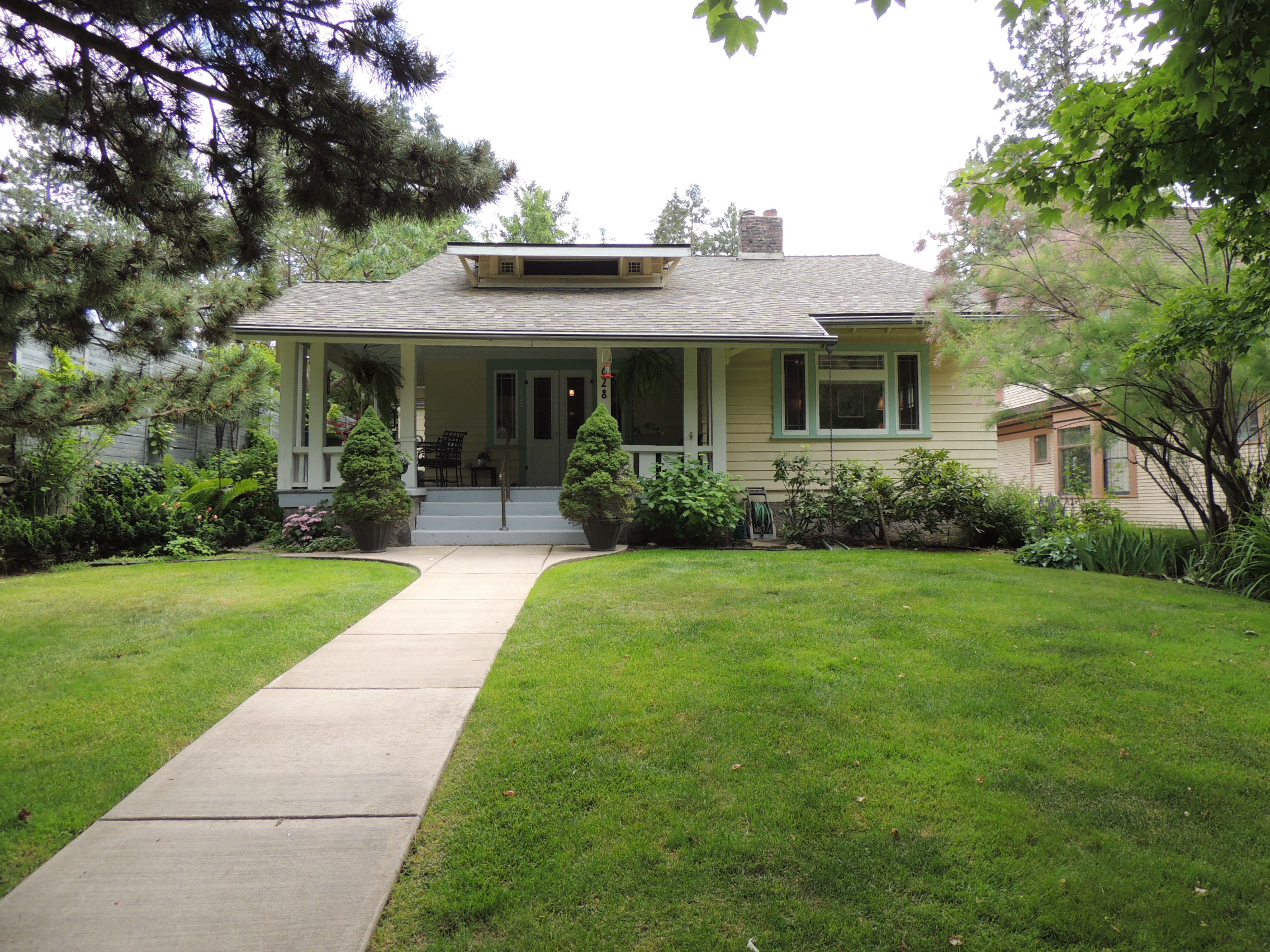
PhotoTitle: Burr House
PhotoAttribution: SHPO
Listing Status: Spokane Register
URL: http://properties.historicspokane.org/property/?PropertyID=2107
Display Marker: large_yellow
Title: Munroe & Helen Burr House
Description: Date Built: 1912
Builder: Allister Mack Laing
The Munroe & Helen Burr House, constructed in 1912, is a textbook example of a Craftsman style home. Located in the Rockwood neighborhood on Spokane’s South Hill, the home was occupied by the Burrs until it was sold in 1916. Munroe Burr was a long time resident of Spokane and operated his own electric company for many years. The low roof line, noticeable “eyebrow” dormer and wide eaves combine to create an exaggerated horizontal appearance – a hallmark of the Craftsman style. Interior woodwork is prominently expressed in deep ebony-colored curly- and vertical-grain fir, hand-rubbed to a rich patina. The unique basalt rock retaining wall bordering the driveway on the west side of the house was built at the same time as the home making it an original feature of the property. Well-preserved, the Burr House retains a high degree of exterior and interior architectural integrity in original location, design, materials, craftsmanship, and association.
Location: 47.634411, -117.401329
Address: 628 East 22nd Avenue, Spokane, WA 99203
PhotoURL:

PhotoTitle: Burr House
PhotoAttribution: SHPO
Listing Status: Spokane Register
URL: http://properties.historicspokane.org/property/?PropertyID=2107
Display Marker: large_yellow
ID: 421
Title: Powerful Pine
Description: Height: ~33 feet
Species: Mexican Pinyon Pine
One of the largest trees of its kind in the state, this Pinyon Pine boasts a crown reaching over 40 feet across. Though not as tall as the state champion, the reach of this pine's branches rivals many that tower high above it.
Location: 47.642564, -117.466409
Address: 3404 West Woodland Boulevard, Spokane WA 99224
PhotoURL: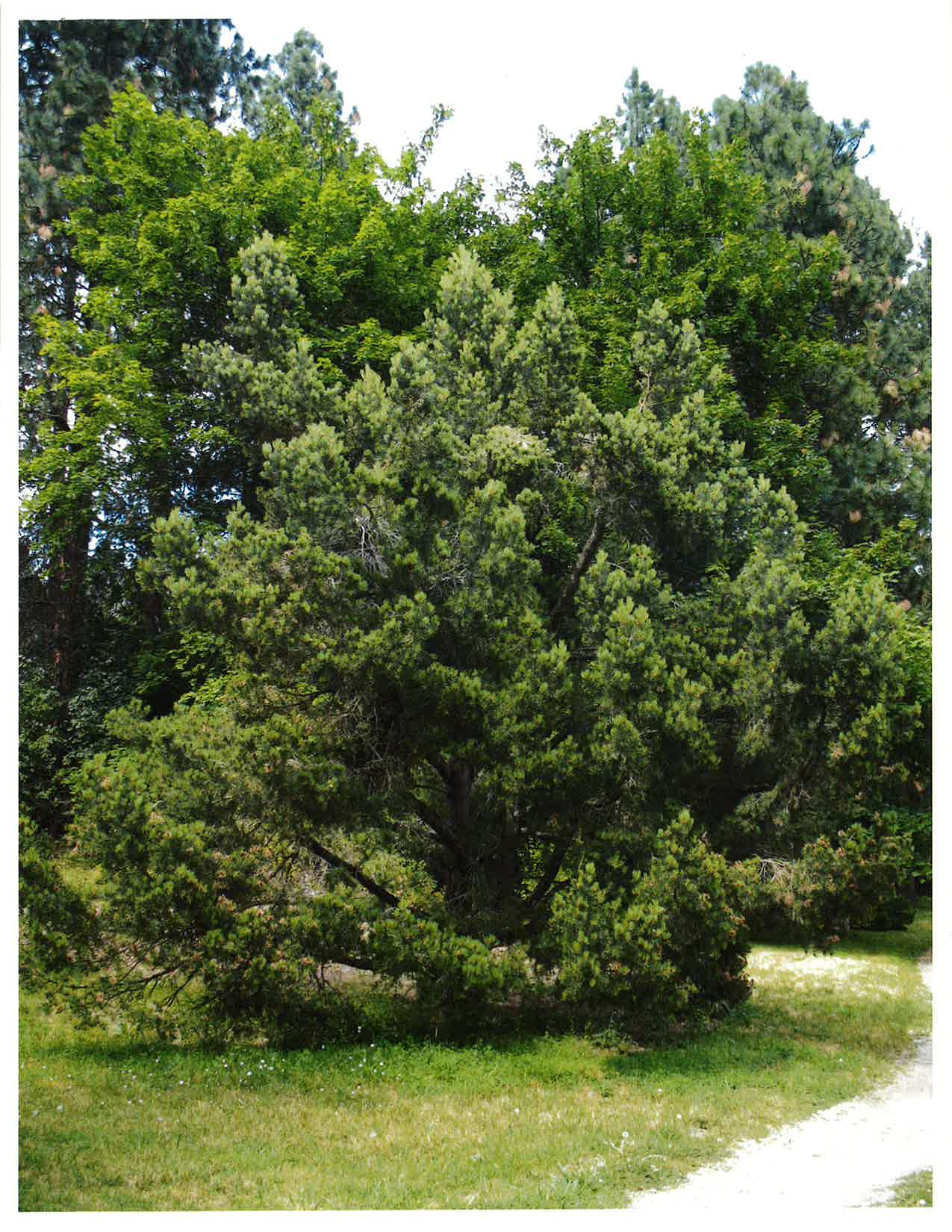
PhotoTitle: Mexican Pine
PhotoAttribution: City of Spokane Parks and Recreation
Listing Status: Spokane Heritage Tree Register
URL: https://my.spokanecity.org/urbanforestry/programs/heritage-tree/
Display Marker: large_green
Title: Powerful Pine
Description: Height: ~33 feet
Species: Mexican Pinyon Pine
One of the largest trees of its kind in the state, this Pinyon Pine boasts a crown reaching over 40 feet across. Though not as tall as the state champion, the reach of this pine's branches rivals many that tower high above it.
Location: 47.642564, -117.466409
Address: 3404 West Woodland Boulevard, Spokane WA 99224
PhotoURL:

PhotoTitle: Mexican Pine
PhotoAttribution: City of Spokane Parks and Recreation
Listing Status: Spokane Heritage Tree Register
URL: https://my.spokanecity.org/urbanforestry/programs/heritage-tree/
Display Marker: large_green
ID: 422
Title: The Majestic Twins
Description: Age: ~66 years
Height: ~55 feet
Species: Dawn Redwood
Planted in 1950, these two majestic trees are thought to be some of the oldest of their kind in the United States. Originating in China, these twins were most likely given to the Finch Arboretum by another arboretum in the middle of the 20th century.
Location: 47.641029, -117.465251
Address: 3404 W Woodland Blvd, Spokane, WA 99224
PhotoURL: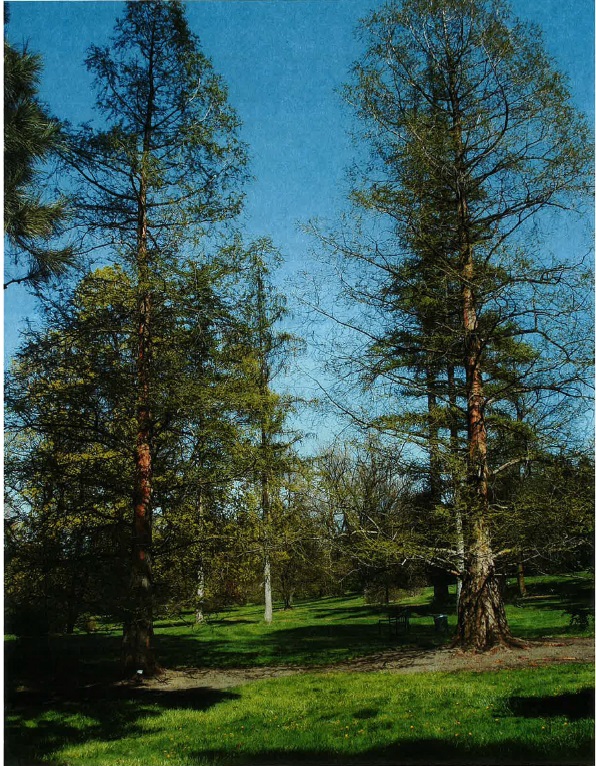
PhotoTitle: Dawn Redwoods
PhotoAttribution: City of Spokane Parks and Recreation
Listing Status: Spokane Heritage Tree Register
URL: https://my.spokanecity.org/urbanforestry/programs/heritage-tree/
Display Marker: large_green
Title: The Majestic Twins
Description: Age: ~66 years
Height: ~55 feet
Species: Dawn Redwood
Planted in 1950, these two majestic trees are thought to be some of the oldest of their kind in the United States. Originating in China, these twins were most likely given to the Finch Arboretum by another arboretum in the middle of the 20th century.
Location: 47.641029, -117.465251
Address: 3404 W Woodland Blvd, Spokane, WA 99224
PhotoURL:

PhotoTitle: Dawn Redwoods
PhotoAttribution: City of Spokane Parks and Recreation
Listing Status: Spokane Heritage Tree Register
URL: https://my.spokanecity.org/urbanforestry/programs/heritage-tree/
Display Marker: large_green
ID: 423
Title: Farline House
Description: Date Built: 1953
Architect: Frank Toribara
Common Name: Louis and Ruth Farline House
The Farline House, located just north of Lincoln Park, sits in a neighborhood of relatively modern homes just east of the edge of the older South Central neighborhood. The home is located on a corrner lot and sits canted, with the front elevation faces to the southwest. Designed by Frank Yoshio Toribara, a Seattle-educated architect who moved to Spokane in the 1950s, and built by the Vines Construction Company, this ranch style home contains many unique features and stands out in comparison to the surrounding homes. The eye catching roof line and prominent use of windows are easily seen from the exterior while the interior of the home holds many other distinguishing aspects. The home was occupied by Louis and Ruth Farline from shortly after the time of its construction until 2014, when the home was purchased by the current owners.
Location: 47.642051, -117.378782
Address: 2205 E. Girard Place, Spokane WA 99203
PhotoURL: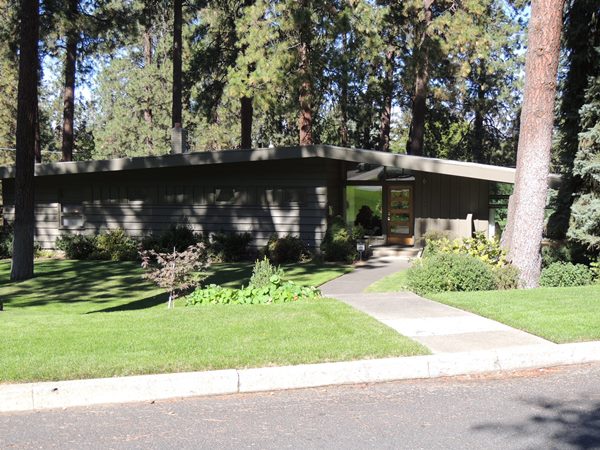
PhotoTitle: Farline House
PhotoAttribution: SHPO
Listing Status: Spokane Register
URL: http://properties.historicspokane.org/property/?PropertyID=2108
Display Marker: large_yellow
Title: Farline House
Description: Date Built: 1953
Architect: Frank Toribara
Common Name: Louis and Ruth Farline House
The Farline House, located just north of Lincoln Park, sits in a neighborhood of relatively modern homes just east of the edge of the older South Central neighborhood. The home is located on a corrner lot and sits canted, with the front elevation faces to the southwest. Designed by Frank Yoshio Toribara, a Seattle-educated architect who moved to Spokane in the 1950s, and built by the Vines Construction Company, this ranch style home contains many unique features and stands out in comparison to the surrounding homes. The eye catching roof line and prominent use of windows are easily seen from the exterior while the interior of the home holds many other distinguishing aspects. The home was occupied by Louis and Ruth Farline from shortly after the time of its construction until 2014, when the home was purchased by the current owners.
Location: 47.642051, -117.378782
Address: 2205 E. Girard Place, Spokane WA 99203
PhotoURL:

PhotoTitle: Farline House
PhotoAttribution: SHPO
Listing Status: Spokane Register
URL: http://properties.historicspokane.org/property/?PropertyID=2108
Display Marker: large_yellow
ID: 424
Title: Doran Building
Description: The Doran Building was constructed in 1920, when the age of the automobile was just dawning in earnest. It was designed by early Spokane architect Arthur Cowley and constructed by builder, Abe Houle. The building originally housed one of the earliest and most successful automobile dealerships in Spokane, owned by John Doran. After Doran's death, the building served as a car dealership for various businesses until the 1970's. The following decades saw the building occupied by auto repair shops until it was converted to the Evergreen Parking Garage in 2002. Although the building has experienced many modifications, the front facade maintains the original openings and much of the original appearance of the building. The Doran Building was listed on the Spokane Register of Historic Places on 11/07/2016 due to its contribution to local Spokane history.
Location: 47.654183, -117.422518
Address: 707 W. 2nd Avenue
PhotoURL: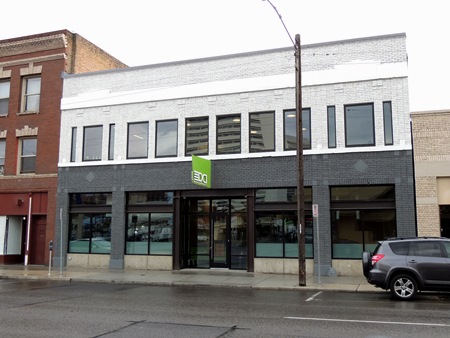
PhotoTitle: Doran Building
PhotoAttribution: SHPO
Listing Status: Spokane Register
URL: http://properties.historicspokane.org/property/?PropertyID=2109
Display Marker: large_yellow
Title: Doran Building
Description: The Doran Building was constructed in 1920, when the age of the automobile was just dawning in earnest. It was designed by early Spokane architect Arthur Cowley and constructed by builder, Abe Houle. The building originally housed one of the earliest and most successful automobile dealerships in Spokane, owned by John Doran. After Doran's death, the building served as a car dealership for various businesses until the 1970's. The following decades saw the building occupied by auto repair shops until it was converted to the Evergreen Parking Garage in 2002. Although the building has experienced many modifications, the front facade maintains the original openings and much of the original appearance of the building. The Doran Building was listed on the Spokane Register of Historic Places on 11/07/2016 due to its contribution to local Spokane history.
Location: 47.654183, -117.422518
Address: 707 W. 2nd Avenue
PhotoURL:

PhotoTitle: Doran Building
PhotoAttribution: SHPO
Listing Status: Spokane Register
URL: http://properties.historicspokane.org/property/?PropertyID=2109
Display Marker: large_yellow
ID: 330
Title: Wells Chevrolet Service Building
Description: Date Built: 1926
Architect: Unknown
Common Name: Lambert Candy Building
Historically significant for its association with Spokane's first "auto row," this building was constructed as the service department for Wells Chevrolet, located directly to the north. With the completion of this building in 1926, it became possible to unload automobiles at the railroad grade level and convey them directly to the showroom on First Avenue. After the demise of Wells Chevrolet during the Depression, the building continued to house auto-related businesses, including Better Chevrolet Service, Day-Majer Used Cars and Service, and Riegel Bros./Riegel-Becker Truck, Service, and Body/Paint Shop. By the mid-1960s however, auto row had moved south, and the building was occupied by a tobacco wholesaler and a candy wholesaler. The building stood vacant through the early 1990s. It was recently converted into condominiums.
Location: 47.6558, -117.4308
Address: 115 South Adams Street, Spokane WA 99201
PhotoURL: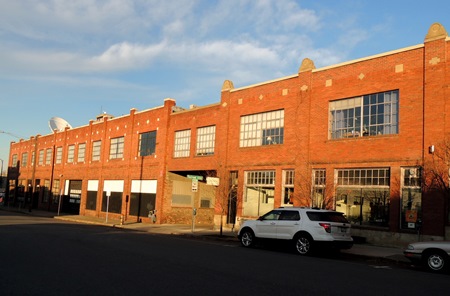
PhotoTitle: The Wells Chevrolet Service Building
PhotoAttribution: Spokane City/County Historic Preservation Office
Listing Status: Spokane Register, National Register
URL: http://properties.historicspokane.org/property/?PropertyID=1970
Display Marker: large_yellow
Title: Wells Chevrolet Service Building
Description: Date Built: 1926
Architect: Unknown
Common Name: Lambert Candy Building
Historically significant for its association with Spokane's first "auto row," this building was constructed as the service department for Wells Chevrolet, located directly to the north. With the completion of this building in 1926, it became possible to unload automobiles at the railroad grade level and convey them directly to the showroom on First Avenue. After the demise of Wells Chevrolet during the Depression, the building continued to house auto-related businesses, including Better Chevrolet Service, Day-Majer Used Cars and Service, and Riegel Bros./Riegel-Becker Truck, Service, and Body/Paint Shop. By the mid-1960s however, auto row had moved south, and the building was occupied by a tobacco wholesaler and a candy wholesaler. The building stood vacant through the early 1990s. It was recently converted into condominiums.
Location: 47.6558, -117.4308
Address: 115 South Adams Street, Spokane WA 99201
PhotoURL:

PhotoTitle: The Wells Chevrolet Service Building
PhotoAttribution: Spokane City/County Historic Preservation Office
Listing Status: Spokane Register, National Register
URL: http://properties.historicspokane.org/property/?PropertyID=1970
Display Marker: large_yellow
ID: 407
Title: Northwest Transport Truck Company
Description: Date Built: 1921
Common Name: Jones Automotive Engines
The one story, vernacular building on the corner of Adams and Second was built in 1921 for the Northwest Transport Truck Company, an auto business founded in Michigan in 1918. While modest in design and style, the simple brick building nonetheless helps document the evolution of the automobile and businesses in Spokane. The 1920s were the first years in which buildings were built downtown specifically to house and sell automobiles and accessories. The Northwest Transport Truck Company had a showroom and garage facility to service the many trucks that worked the streets of Spokane and the fields of the Inland Northwest farm county.
Location: 47.654716, -117.431345
Address: 1302 W 2nd Avenue, Spokane WA 99201
PhotoURL:
PhotoTitle: jones
PhotoAttribution: Spokane City/County Historic Preservation Office
Listing Status: Spokane Register, National Register
URL: http://properties.historicspokane.org/property/?PropertyID=2096
Display Marker: large_yellow
Title: Northwest Transport Truck Company
Description: Date Built: 1921
Common Name: Jones Automotive Engines
The one story, vernacular building on the corner of Adams and Second was built in 1921 for the Northwest Transport Truck Company, an auto business founded in Michigan in 1918. While modest in design and style, the simple brick building nonetheless helps document the evolution of the automobile and businesses in Spokane. The 1920s were the first years in which buildings were built downtown specifically to house and sell automobiles and accessories. The Northwest Transport Truck Company had a showroom and garage facility to service the many trucks that worked the streets of Spokane and the fields of the Inland Northwest farm county.
Location: 47.654716, -117.431345
Address: 1302 W 2nd Avenue, Spokane WA 99201
PhotoURL:

PhotoTitle: jones
PhotoAttribution: Spokane City/County Historic Preservation Office
Listing Status: Spokane Register, National Register
URL: http://properties.historicspokane.org/property/?PropertyID=2096
Display Marker: large_yellow
ID: 425
Title: Wallmark House
Description: The Wallmark House, built in 1963, stands out as one of the premier Mid-Century Modern residences in Spokane County, among many such buildings in an area that was an epi-center of such experimentation. With its shallow-pitched roof, widely-overhanging eaves, massive brick chimney, attached garage, and fixed wood sash windows, it is a classic example of the Contemporary Ranch Style. It was designed by Moritz Kundig, who is among a plethora of Mid-Century modern architects who called Spokane home. The home was built for C. Leonard and Mable Wallmark and has remained in the family since the time of construction. Located on a high bluff overlooking Long Lake (formerly called "Lake Spokane") in the northwest reaches of Spokane County in Nine Mile Falls, the house is an excellent and highly intact example of modern architecture. The Wallmark House was listed on the Spokane Register of Historic Places on 11/29/2016.
Location: 47.792559, -117.574360
Address: 14701 N. Oxford Road, Nine Mile Falls, WA 99026
PhotoURL:
PhotoTitle: Wallmark House
PhotoAttribution: SHPO
Listing Status: Spokane Register
URL: http://properties.historicspokane.org/property/?PropertyID=2110
Display Marker: large_yellow
Title: Wallmark House
Description: The Wallmark House, built in 1963, stands out as one of the premier Mid-Century Modern residences in Spokane County, among many such buildings in an area that was an epi-center of such experimentation. With its shallow-pitched roof, widely-overhanging eaves, massive brick chimney, attached garage, and fixed wood sash windows, it is a classic example of the Contemporary Ranch Style. It was designed by Moritz Kundig, who is among a plethora of Mid-Century modern architects who called Spokane home. The home was built for C. Leonard and Mable Wallmark and has remained in the family since the time of construction. Located on a high bluff overlooking Long Lake (formerly called "Lake Spokane") in the northwest reaches of Spokane County in Nine Mile Falls, the house is an excellent and highly intact example of modern architecture. The Wallmark House was listed on the Spokane Register of Historic Places on 11/29/2016.
Location: 47.792559, -117.574360
Address: 14701 N. Oxford Road, Nine Mile Falls, WA 99026
PhotoURL:

PhotoTitle: Wallmark House
PhotoAttribution: SHPO
Listing Status: Spokane Register
URL: http://properties.historicspokane.org/property/?PropertyID=2110
Display Marker: large_yellow
ID: 426
Title: Manito Methodist Episcopal Church
Description: Built in 1923, and modified in 1959 with the addition of an “educational” wing, Manito Methodist Episcopal Church is a fine example of Italian Renaissance-style influence, and features arched leaded stained-glass windows, red brick cladding with decorative brick patterns, ornamental concrete bas relief sculpture, and a prominent 60-foot-tall square bell tower. According to church archives, the design and materials for the tower at Manito Methodist Episcopal Church were greatly influenced by one of the great historic basilicas in Italy—St. Francis Basilica of Assisi, Umbria, built in the 1200s. In contrast to the 1923 church, the 1959 education addition depicts hallmark characteristics of Mid-Century Modern-style influence with a low-pitched roof, brushed aluminum window frames, horizontal rows of windows with modern designs, and horizontal rows of decorative blue/green-colored ceramic-clad metal wall panels. Both the church and the addition were designed by prominent Spokane architects, Kirtland K. Cutter and George M. Rasque respectively. The Manito Methodist Episcopal Church was listed on the Spokane Register of Historic Place on 12/12/2016.
Location: 47.624866, -117.402241
Address: 3220 S. Grand Boulevard
PhotoURL: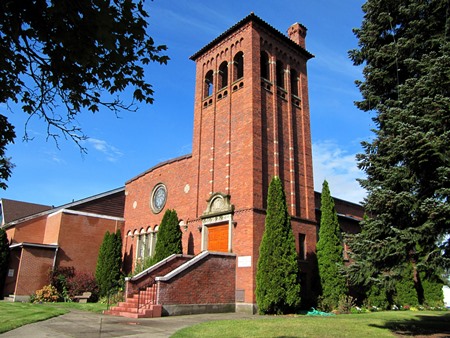
PhotoTitle: Manito Methodist
PhotoAttribution: SHPO
Listing Status: Spokane Register
URL: http://properties.historicspokane.org/property/?PropertyID=2111
Display Marker: large_yellow
Title: Manito Methodist Episcopal Church
Description: Built in 1923, and modified in 1959 with the addition of an “educational” wing, Manito Methodist Episcopal Church is a fine example of Italian Renaissance-style influence, and features arched leaded stained-glass windows, red brick cladding with decorative brick patterns, ornamental concrete bas relief sculpture, and a prominent 60-foot-tall square bell tower. According to church archives, the design and materials for the tower at Manito Methodist Episcopal Church were greatly influenced by one of the great historic basilicas in Italy—St. Francis Basilica of Assisi, Umbria, built in the 1200s. In contrast to the 1923 church, the 1959 education addition depicts hallmark characteristics of Mid-Century Modern-style influence with a low-pitched roof, brushed aluminum window frames, horizontal rows of windows with modern designs, and horizontal rows of decorative blue/green-colored ceramic-clad metal wall panels. Both the church and the addition were designed by prominent Spokane architects, Kirtland K. Cutter and George M. Rasque respectively. The Manito Methodist Episcopal Church was listed on the Spokane Register of Historic Place on 12/12/2016.
Location: 47.624866, -117.402241
Address: 3220 S. Grand Boulevard
PhotoURL:

PhotoTitle: Manito Methodist
PhotoAttribution: SHPO
Listing Status: Spokane Register
URL: http://properties.historicspokane.org/property/?PropertyID=2111
Display Marker: large_yellow
ID: 427
Title: Trogdon House
Description: Located in Spokane’s architecturally prominent Rockwood National Register Historic District, the William & Dorothy Trogdon House was listed on the Spokane Register of Historic Places under Category C for its architectural significance. The property’s area of significance is “architecture,” and its period of significance is 1963, the year the home was constructed. The Trogdon House conveys characteristics of the modern mid-20th century Northwest Regional style through the home’s natural forested site, massive geometric volume, minimal ornamentation, concrete and wood construction, exposed wood structural members, widely overhanging open eaves, open floor plan, open-tread stairs, vaulted ceiling, and window walls that offer broad views of the property’s forested hillside and help integrate the home with its natural surroundings. Further architecturally significant, the Trogdon House is a product of husband-and-wife master architects, William & Dorothy Trogdon, two of Spokane’s most successful design leaders in commercial and domestic architecture from 1953 to 1985. In Spokane, they were honored with several design awards, and founded various architectural firms that grew and matured to successfully larger firms. Together, William & Dorothy Trogdon custom-designed and built the Trogdon House as their personal residence.
Location: 47.63712, -117.3968
Address: 1918 S. Syringa Road
PhotoURL: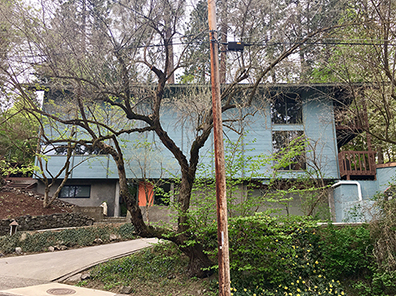
PhotoTitle: Trogdon House
PhotoAttribution:
Listing Status: Spokane Register
URL: http://properties.historicspokane.org/property/?PropertyID=2113
Display Marker: large_yellow
Title: Trogdon House
Description: Located in Spokane’s architecturally prominent Rockwood National Register Historic District, the William & Dorothy Trogdon House was listed on the Spokane Register of Historic Places under Category C for its architectural significance. The property’s area of significance is “architecture,” and its period of significance is 1963, the year the home was constructed. The Trogdon House conveys characteristics of the modern mid-20th century Northwest Regional style through the home’s natural forested site, massive geometric volume, minimal ornamentation, concrete and wood construction, exposed wood structural members, widely overhanging open eaves, open floor plan, open-tread stairs, vaulted ceiling, and window walls that offer broad views of the property’s forested hillside and help integrate the home with its natural surroundings. Further architecturally significant, the Trogdon House is a product of husband-and-wife master architects, William & Dorothy Trogdon, two of Spokane’s most successful design leaders in commercial and domestic architecture from 1953 to 1985. In Spokane, they were honored with several design awards, and founded various architectural firms that grew and matured to successfully larger firms. Together, William & Dorothy Trogdon custom-designed and built the Trogdon House as their personal residence.
Location: 47.63712, -117.3968
Address: 1918 S. Syringa Road
PhotoURL:

PhotoTitle: Trogdon House
PhotoAttribution:
Listing Status: Spokane Register
URL: http://properties.historicspokane.org/property/?PropertyID=2113
Display Marker: large_yellow
ID: 428
Title: Franklin Elementary School
Description: Franklin Elementary School is historically significant under Criterion “A” for its direct contribution to the broad pattern of educational development in Spokane. The 1909 building represents a second phase of school construction in the city and was one of the structures built as part of a quarter-million dollar effort to modernize the school system just after the turn of the 20th century. A later addition in the early 1950s shows how the district adapted to the post-WWII baby boom and the changing needs of its students, teachers and administrators. Today the original building and addition continues to serve their originally intended purpose and both retain a high level of integrity. Franklin Elementary is also eligible under Criterion C as a resource that embodies the distinguishing characteristics of its type and period of construction. Stylistically the school represents a shift from the grand Romanesque Revival structures with bell towers of the 1880s, to the more restrained classical traditions of broken cornices, flat roofs and symmetry of the turn-of-the-century. The school is an outstanding example of early public school architecture in Spokane and is one of a few standing elementary school structures from a second wave of school construction in the city. The school also represents the work of noted Spokane architect, Loren L. Rand whose career spanned more than 30 years.
Location: 47.64116, -117.37153
Address: 2627 E. 17th
PhotoURL: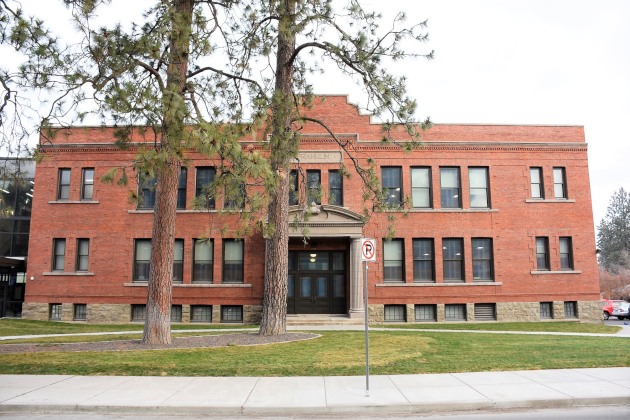
PhotoTitle: Franklin Elementary
PhotoAttribution: SHPO
Listing Status: National Register - pending
URL: http://properties.historicspokane.org/property/?PropertyID=2114
Display Marker: large_yellow
Title: Franklin Elementary School
Description: Franklin Elementary School is historically significant under Criterion “A” for its direct contribution to the broad pattern of educational development in Spokane. The 1909 building represents a second phase of school construction in the city and was one of the structures built as part of a quarter-million dollar effort to modernize the school system just after the turn of the 20th century. A later addition in the early 1950s shows how the district adapted to the post-WWII baby boom and the changing needs of its students, teachers and administrators. Today the original building and addition continues to serve their originally intended purpose and both retain a high level of integrity. Franklin Elementary is also eligible under Criterion C as a resource that embodies the distinguishing characteristics of its type and period of construction. Stylistically the school represents a shift from the grand Romanesque Revival structures with bell towers of the 1880s, to the more restrained classical traditions of broken cornices, flat roofs and symmetry of the turn-of-the-century. The school is an outstanding example of early public school architecture in Spokane and is one of a few standing elementary school structures from a second wave of school construction in the city. The school also represents the work of noted Spokane architect, Loren L. Rand whose career spanned more than 30 years.
Location: 47.64116, -117.37153
Address: 2627 E. 17th
PhotoURL:

PhotoTitle: Franklin Elementary
PhotoAttribution: SHPO
Listing Status: National Register - pending
URL: http://properties.historicspokane.org/property/?PropertyID=2114
Display Marker: large_yellow
ID: 429
Title: McKinley School
Description: Built in 1902, and enlarged in 1903, the McKinley School is an example of the Neoclassical style. The 2.5-story building is embellished with a formal symmetrical design, broad wall expanses of crème-colored face brick cladding, contrasting red brick quoins and red brick window arches, a hipped roof with hipped and gabled dormers, a combination of original arched and rectangular windows, decorative architectural details made of cast-concrete, and an elaborate formal front entrance. Partially recessed at the first floor, the full-height formal front entrance bay is articulated with Neoclassical-style details, including narrow fluted engaged pilasters with decorative Ionic capitals, a custom-designed cast-concrete entablature, a row of round arched windows with radiating brick voussoirs, and a decorative cast-concrete name plate, which spells McKINLEY SCHOOL. Located in a mixed-use commercial, industrial, and residential area in Spokane, Washington’s East Central neighborhood, McKinley School is remarkably well-preserved and retains excellent integrity in original location, design, materials, workmanship, and association. It was last used as an elementary school in the 1961-1962 school years.
Location: 47.65875 -117.38180
Address: 117 N. Napa Street Spokane, WA 99202
PhotoURL: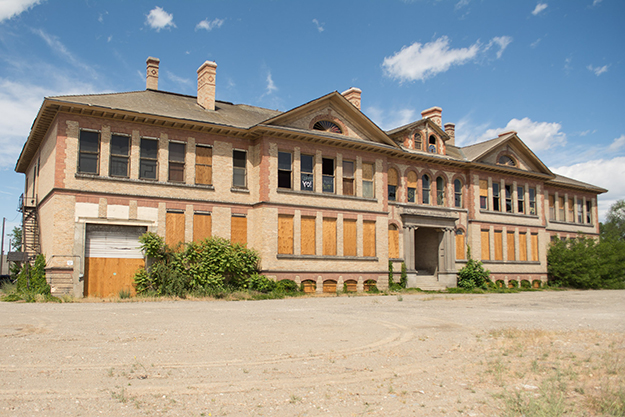
PhotoTitle: McKinley School
PhotoAttribution: SHPO
Listing Status: Spokane Register
URL: http://properties.historicspokane.org/property/?PropertyID=2116
Display Marker: large_yellow
Title: McKinley School
Description: Built in 1902, and enlarged in 1903, the McKinley School is an example of the Neoclassical style. The 2.5-story building is embellished with a formal symmetrical design, broad wall expanses of crème-colored face brick cladding, contrasting red brick quoins and red brick window arches, a hipped roof with hipped and gabled dormers, a combination of original arched and rectangular windows, decorative architectural details made of cast-concrete, and an elaborate formal front entrance. Partially recessed at the first floor, the full-height formal front entrance bay is articulated with Neoclassical-style details, including narrow fluted engaged pilasters with decorative Ionic capitals, a custom-designed cast-concrete entablature, a row of round arched windows with radiating brick voussoirs, and a decorative cast-concrete name plate, which spells McKINLEY SCHOOL. Located in a mixed-use commercial, industrial, and residential area in Spokane, Washington’s East Central neighborhood, McKinley School is remarkably well-preserved and retains excellent integrity in original location, design, materials, workmanship, and association. It was last used as an elementary school in the 1961-1962 school years.
Location: 47.65875 -117.38180
Address: 117 N. Napa Street Spokane, WA 99202
PhotoURL:

PhotoTitle: McKinley School
PhotoAttribution: SHPO
Listing Status: Spokane Register
URL: http://properties.historicspokane.org/property/?PropertyID=2116
Display Marker: large_yellow
ID: 430
Title: Spokane Continental Bakery Building
Description: The Spokane-Continental Bakery Building is a well-preserved example of the industrial/commercial warehouse building type constructed during the first half of the 20th-century. Construction of the building began in 1909, and grew as various additions and modifications were undertaken in 1917,1920,1947,and 1956.The large 49,000- square-foot bakery warehouse is a multi-level, reinforced red brick masonry construction structure that extends through the entire blockfront along Broadway Avenue between Lincoln and Post Streets. Located a few hundred yards north of the Spokane River in an industrial/commercial section of Spokane, Washington, the warehouse building features a symmetrical pattern of tall windows that offer narrow between-building- views of the Spokane River. Common to most early 20th-century industrial/commercial warehouses, the bakery building’s exterior and interior are plain with little articulation or embellishment, and reveal common-bond brick masonry, an open and spacious interior with a combination of concrete-brick-wood plank floors, exposed brick masonry perimeter walls, high ceilings of 12 feet or more, and exposed structural posts and beams made of wood, concrete, and steel. Even with various exterior window and warehouse delivery door modifications during the past century, the Spokane- Continental Bakery Building retains good to excellent integrity in original location, design, materials, workmanship, and association.
Location: 47.66482 -117.42443
Address: 821 W. Mallon Avenue Spokane, WA 99201
PhotoURL: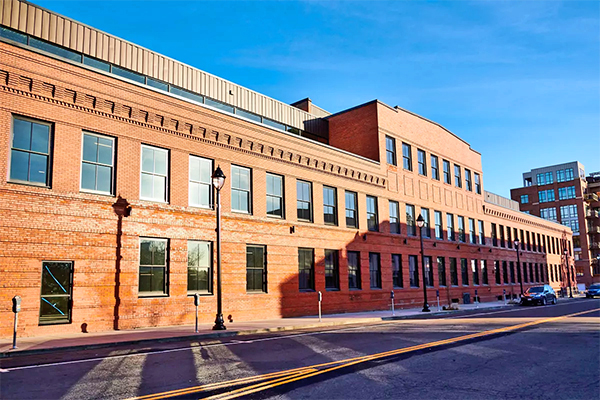
PhotoTitle: Spokane Continental Bakery Building
PhotoAttribution: SHPO
Listing Status: Spokane Register
URL: http://properties.historicspokane.org/property/?PropertyID=2117
Display Marker: large_yellow
Title: Spokane Continental Bakery Building
Description: The Spokane-Continental Bakery Building is a well-preserved example of the industrial/commercial warehouse building type constructed during the first half of the 20th-century. Construction of the building began in 1909, and grew as various additions and modifications were undertaken in 1917,1920,1947,and 1956.The large 49,000- square-foot bakery warehouse is a multi-level, reinforced red brick masonry construction structure that extends through the entire blockfront along Broadway Avenue between Lincoln and Post Streets. Located a few hundred yards north of the Spokane River in an industrial/commercial section of Spokane, Washington, the warehouse building features a symmetrical pattern of tall windows that offer narrow between-building- views of the Spokane River. Common to most early 20th-century industrial/commercial warehouses, the bakery building’s exterior and interior are plain with little articulation or embellishment, and reveal common-bond brick masonry, an open and spacious interior with a combination of concrete-brick-wood plank floors, exposed brick masonry perimeter walls, high ceilings of 12 feet or more, and exposed structural posts and beams made of wood, concrete, and steel. Even with various exterior window and warehouse delivery door modifications during the past century, the Spokane- Continental Bakery Building retains good to excellent integrity in original location, design, materials, workmanship, and association.
Location: 47.66482 -117.42443
Address: 821 W. Mallon Avenue Spokane, WA 99201
PhotoURL:

PhotoTitle: Spokane Continental Bakery Building
PhotoAttribution: SHPO
Listing Status: Spokane Register
URL: http://properties.historicspokane.org/property/?PropertyID=2117
Display Marker: large_yellow
ID: 431
Title: Waldo & Louise Paine House
Description: Listed in 2006 on the National Register of Historic Places in Nettleton’s Historic District, the Waldo & Louise Paine House, built in 1905, is an excellent example of the Arts & Crafts tradition in Spokane, Washington. The property is located in the West Central neighborhood northwest of downtown Spokane on Summit Boulevard, one of the city’s most admired residential streets. As its name implies, Summit Boulevard follows a high, curvilinear ridge at the summit of a wooded basalt bluff that overlooks the Spokane River as it flows northwest. With a stupendous view of the river, forested hillsides, and distant mountain peaks, the well-preserved Paine House is prominently sited on Summit Boulevard and retains excellent integrity in original location, design, materials, workmanship, and association.
Location: 47.67114 -117.44886
Address: 2509 W. Summit Boulevard Spokane, WA 99201
PhotoURL: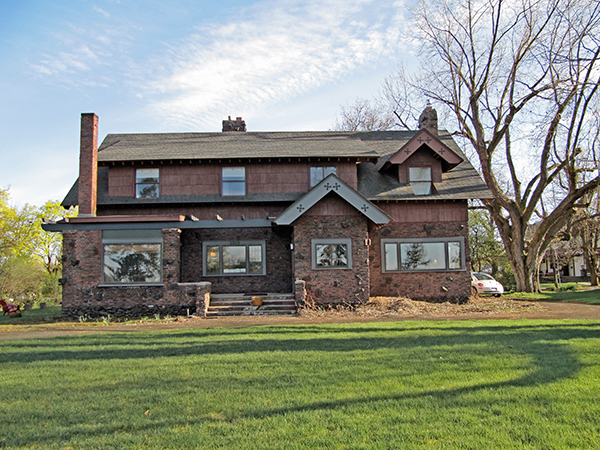
PhotoTitle: Waldo & Louise Paine House
PhotoAttribution: SHPO
Listing Status: Spokane Register
URL: http://properties.historicspokane.org/property/?PropertyID=2118
Display Marker: large_yellow
Title: Waldo & Louise Paine House
Description: Listed in 2006 on the National Register of Historic Places in Nettleton’s Historic District, the Waldo & Louise Paine House, built in 1905, is an excellent example of the Arts & Crafts tradition in Spokane, Washington. The property is located in the West Central neighborhood northwest of downtown Spokane on Summit Boulevard, one of the city’s most admired residential streets. As its name implies, Summit Boulevard follows a high, curvilinear ridge at the summit of a wooded basalt bluff that overlooks the Spokane River as it flows northwest. With a stupendous view of the river, forested hillsides, and distant mountain peaks, the well-preserved Paine House is prominently sited on Summit Boulevard and retains excellent integrity in original location, design, materials, workmanship, and association.
Location: 47.67114 -117.44886
Address: 2509 W. Summit Boulevard Spokane, WA 99201
PhotoURL:

PhotoTitle: Waldo & Louise Paine House
PhotoAttribution: SHPO
Listing Status: Spokane Register
URL: http://properties.historicspokane.org/property/?PropertyID=2118
Display Marker: large_yellow
ID: 164
Title: Jenkins Block
Description: Date Built: 1903
Architect: Hillyard Townsite Company
Common Name: Jenkins Block
This small, one-story brick masonry building features a coursed brick cornice and original recessed storefront configuration. The building has been used by a variety of tenants including the Hillyard Post Office (1903-1911), Squibb Jewelers, Noel & Willmore Grocers, Fitzpatrick Meats, and W.S. Byrant Real Estate.
Location: 47.70398, -117.36509
Address: 5021 North Market Street, Spokane WA 99217
PhotoURL: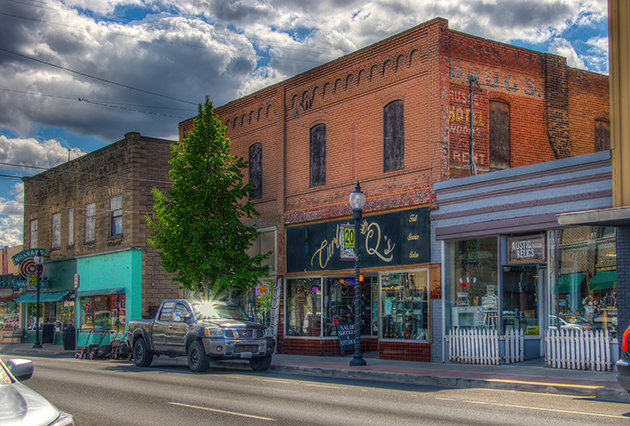
PhotoTitle: The Jenkins Block
PhotoAttribution: Spokane City/County Historic Preservation Office
Listing Status: Spokane Register, National Register
URL: http://properties.historicspokane.org/property/?PropertyID=1845
Display Marker: large_yellow
Title: Jenkins Block
Description: Date Built: 1903
Architect: Hillyard Townsite Company
Common Name: Jenkins Block
This small, one-story brick masonry building features a coursed brick cornice and original recessed storefront configuration. The building has been used by a variety of tenants including the Hillyard Post Office (1903-1911), Squibb Jewelers, Noel & Willmore Grocers, Fitzpatrick Meats, and W.S. Byrant Real Estate.
Location: 47.70398, -117.36509
Address: 5021 North Market Street, Spokane WA 99217
PhotoURL:

PhotoTitle: The Jenkins Block
PhotoAttribution: Spokane City/County Historic Preservation Office
Listing Status: Spokane Register, National Register
URL: http://properties.historicspokane.org/property/?PropertyID=1845
Display Marker: large_yellow
ID: 202
Title: Mearow Block
Description: Date Built: 1905
Architect: Unknown
Common Name: Richmond Hotel
The Mearow Block comprises three buildings: the Bickett Hotel built in 1905, the Richmond Hotel built in 1907 and a smaller one-story brick structure constructed adjacent to and between the rear elevations of the Bickett and Richmond. In 1928 successful Spokane merchant and entrepreneur, Joseph A. Mearow, joined the buildings. The Bickett and Richmond were built as SROs and operated as such for more than 70 years. At the time Mearow owned and operated the Bell Furniture Company, located on the first floor of both buildings from 1925 to 1945. Upon his retirement, Spokane furniture merchant Sylvan Dreifus purchased the Mearow Block where he founded and managed the Sylvan Furniture Company for 58 years until 2003.
Location: 47.65773, -117.41459
Address: 225 West Riverside Avenue, Spokane WA 99201
PhotoURL: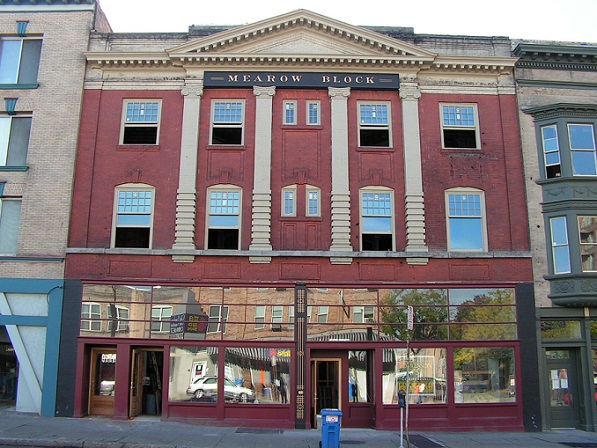
PhotoTitle: The Mearow Block
PhotoAttribution: Spokane City/County Historic Preservation Office
Listing Status: Spokane Register, National Register
URL: http://properties.historicspokane.org/property/?PropertyID=1875
Display Marker: large_yellow
Title: Mearow Block
Description: Date Built: 1905
Architect: Unknown
Common Name: Richmond Hotel
The Mearow Block comprises three buildings: the Bickett Hotel built in 1905, the Richmond Hotel built in 1907 and a smaller one-story brick structure constructed adjacent to and between the rear elevations of the Bickett and Richmond. In 1928 successful Spokane merchant and entrepreneur, Joseph A. Mearow, joined the buildings. The Bickett and Richmond were built as SROs and operated as such for more than 70 years. At the time Mearow owned and operated the Bell Furniture Company, located on the first floor of both buildings from 1925 to 1945. Upon his retirement, Spokane furniture merchant Sylvan Dreifus purchased the Mearow Block where he founded and managed the Sylvan Furniture Company for 58 years until 2003.
Location: 47.65773, -117.41459
Address: 225 West Riverside Avenue, Spokane WA 99201
PhotoURL:

PhotoTitle: The Mearow Block
PhotoAttribution: Spokane City/County Historic Preservation Office
Listing Status: Spokane Register, National Register
URL: http://properties.historicspokane.org/property/?PropertyID=1875
Display Marker: large_yellow
ID: 433
Title: Hobson Building
Description: The Hobson Building is a two-story brick vernacular warehouse on the south side of Railroad Avenue between Jefferson and Adams streets in west downtown Spokane. Built in 1908 for the George H. Gallagher Co., the 60' x 120' building retains its basic form and openings with its primary facade facing north along the railroad. The building is an addition to the west end of a similar two-story brick warehouse that was built in 1906, also by the George H. Gallagher Co.
Resting on basalt rubble basement walls, the unreinforced red brick structure is supported by a wood post and beam structure and topped by a flat roof. The front façade (north) is divided into three bays within a flat brick wall terminated by a brick corbel cornice. Accessed from a raised concrete loading dock, a centered, segmental arch loading bay with large wood doors dominates the first floor. A second floor loading bay door is directly above. Segmental arch window bays flank the loading bays on both floors. The building demonstrates the adaptation from the at grade loading dock to the second story loading platform/bridge after completion of the viaduct in 1916 (1916 concrete bridge removed).
The interior retains the character of the original warehouse, wood plank floors, basalt basement, brick first and second story walls, wood post and beam structure, and exposed wood joists and rafters.
Location: 47.655329, -117.430364
Address: 1213 W. Railroad Ave
PhotoURL: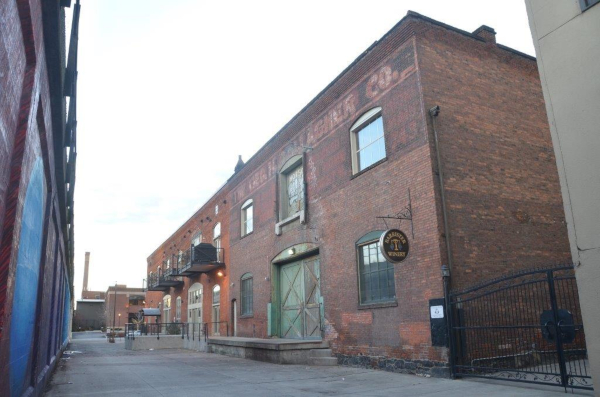
PhotoTitle: Hobson Building
PhotoAttribution: SHPO
Listing Status: Spokane Register
URL: http://properties.historicspokane.org/property/?PropertyID=2124
Display Marker: large_yellow
Title: Hobson Building
Description: The Hobson Building is a two-story brick vernacular warehouse on the south side of Railroad Avenue between Jefferson and Adams streets in west downtown Spokane. Built in 1908 for the George H. Gallagher Co., the 60' x 120' building retains its basic form and openings with its primary facade facing north along the railroad. The building is an addition to the west end of a similar two-story brick warehouse that was built in 1906, also by the George H. Gallagher Co.
Resting on basalt rubble basement walls, the unreinforced red brick structure is supported by a wood post and beam structure and topped by a flat roof. The front façade (north) is divided into three bays within a flat brick wall terminated by a brick corbel cornice. Accessed from a raised concrete loading dock, a centered, segmental arch loading bay with large wood doors dominates the first floor. A second floor loading bay door is directly above. Segmental arch window bays flank the loading bays on both floors. The building demonstrates the adaptation from the at grade loading dock to the second story loading platform/bridge after completion of the viaduct in 1916 (1916 concrete bridge removed).
The interior retains the character of the original warehouse, wood plank floors, basalt basement, brick first and second story walls, wood post and beam structure, and exposed wood joists and rafters.
Location: 47.655329, -117.430364
Address: 1213 W. Railroad Ave
PhotoURL:

PhotoTitle: Hobson Building
PhotoAttribution: SHPO
Listing Status: Spokane Register
URL: http://properties.historicspokane.org/property/?PropertyID=2124
Display Marker: large_yellow
ID: 432
Title: Cooper-George Apartments & Garage
Description: Erected in 1952, the Cooper-George Apartments and Garage is an excellent example of its type—a modern reinforced-concrete, multi-storied, multi-family commercial apartment building and parking garage. The Cooper-George Apartments and Garage are surrounded by a busy hospital/medical center on the South Hill, one mile uphill from downtown Spokane. The 13-floor apartment building is tall, soaring 130 feet in height from a steep hillside, and reveals stylistic influence from the International tradition, a mid-century modern style popular from 1925 to 1965. The building’s International-Style influence is well-displayed by its boxy geometric shape, flat roof, sleek concrete exterior walls, minimal decorative ornamentation, and symmetrically placed vertical bands of windows. Located just west of the apartment building, the two-story Cooper-George Garage was also built in 1952 as part of the apartment complex. The parking garage mimics the boxy shape, flat roof, and smooth concrete cladding of the apartment building. In excellent condition, the Cooper-George Apartments and Garage retain a high degree of exterior integrity in original location, design, materials, workmanship, and association. In 2018, the building received a full rehabilitation as a market-rate apartment building.
Location: 707 W. 5th Ave.
Address: 707 W. 5th Ave.
PhotoURL:
PhotoTitle: Cooper-George
PhotoAttribution: SHPO
Listing Status: Spokane Register
URL: http://properties.historicspokane.org/property/?PropertyID=2123
Display Marker: large_yellow
Title: Cooper-George Apartments & Garage
Description: Erected in 1952, the Cooper-George Apartments and Garage is an excellent example of its type—a modern reinforced-concrete, multi-storied, multi-family commercial apartment building and parking garage. The Cooper-George Apartments and Garage are surrounded by a busy hospital/medical center on the South Hill, one mile uphill from downtown Spokane. The 13-floor apartment building is tall, soaring 130 feet in height from a steep hillside, and reveals stylistic influence from the International tradition, a mid-century modern style popular from 1925 to 1965. The building’s International-Style influence is well-displayed by its boxy geometric shape, flat roof, sleek concrete exterior walls, minimal decorative ornamentation, and symmetrically placed vertical bands of windows. Located just west of the apartment building, the two-story Cooper-George Garage was also built in 1952 as part of the apartment complex. The parking garage mimics the boxy shape, flat roof, and smooth concrete cladding of the apartment building. In excellent condition, the Cooper-George Apartments and Garage retain a high degree of exterior integrity in original location, design, materials, workmanship, and association. In 2018, the building received a full rehabilitation as a market-rate apartment building.
Location: 707 W. 5th Ave.
Address: 707 W. 5th Ave.
PhotoURL:

PhotoTitle: Cooper-George
PhotoAttribution: SHPO
Listing Status: Spokane Register
URL: http://properties.historicspokane.org/property/?PropertyID=2123
Display Marker: large_yellow
ID: 434
Title: Engelhorn Hotel
Description: Rising from an elevated basalt rubble and brick basement, the Danmor is a three-story unreinforced brick apartment building. Built in 1907, as the Engelhorn Hotel, the building is midblock along the north side of Third Avenue between Stevens and Washington streets. The front façade is symmetrically-arranged and divided into three bays: a central first floor entry bay and flanking single window bays. The window bays of the second and third stories are aligned over the first floor bays. Horizontal rusticated brick courses divide the façade into four divisions: basement, first floor, second floor, and third floor. A relatively simple corbeled cornice with corner posts completes the building.
Location: 410 W. Third Ave. Spokane, WA
Address: 410 W. Third Ave. Spokane, WA
PhotoURL:
PhotoTitle: Engelhorn Hotel
PhotoAttribution: Spokane Historic Preservation Office
Listing Status: Spokane Register
URL: http://properties.historicspokane.org/property/?PropertyID=2125
Display Marker: large_yellow
Title: Engelhorn Hotel
Description: Rising from an elevated basalt rubble and brick basement, the Danmor is a three-story unreinforced brick apartment building. Built in 1907, as the Engelhorn Hotel, the building is midblock along the north side of Third Avenue between Stevens and Washington streets. The front façade is symmetrically-arranged and divided into three bays: a central first floor entry bay and flanking single window bays. The window bays of the second and third stories are aligned over the first floor bays. Horizontal rusticated brick courses divide the façade into four divisions: basement, first floor, second floor, and third floor. A relatively simple corbeled cornice with corner posts completes the building.
Location: 410 W. Third Ave. Spokane, WA
Address: 410 W. Third Ave. Spokane, WA
PhotoURL:

PhotoTitle: Engelhorn Hotel
PhotoAttribution: Spokane Historic Preservation Office
Listing Status: Spokane Register
URL: http://properties.historicspokane.org/property/?PropertyID=2125
Display Marker: large_yellow
ID: 435
Title: McAllen Farmhouse
Description: In 1890, George & Rosa McAllen began homesteading 160 acres on Paradise Prairie, and seven years later in 1897, were awarded a USA Patent Warranty Deed for “proving” their homestead land with farming and ranching operations. In 1900, George McAllen increased his land holdings to 315 acres, and six years later in 1906, built the McAllen Farmhouse. A fine representation of the Folk Victorian style and the style’s stepped front-gable-and-wing design, the McAllen Farmhouse survives as one of the few historic homes built at the turn of the 20th century in the early 1900s on Paradise Prairie. Although the farmhouse was moved in 2005 a quarter mile south to its present site, it retains a high degree of exterior integrity in original design, materials, workmanship, and association.
Location: 10602 S. Cedar Road, Spokane, WA
Address: 10602 S. Cedar Road, Spokane, WA
PhotoURL: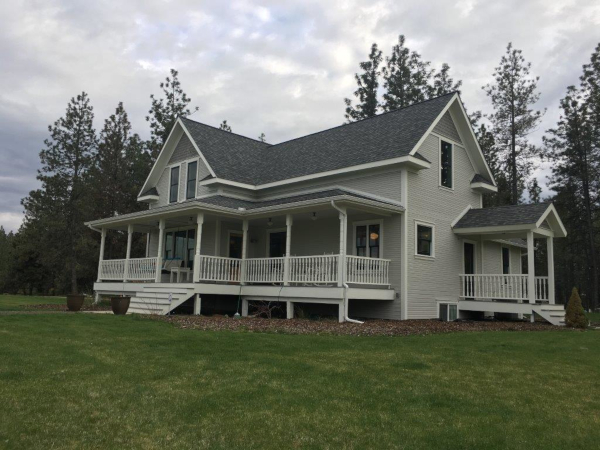
PhotoTitle: McAllen Farmhouse
PhotoAttribution: Spokane Historic Preservation Office
Listing Status: Spokane Register
URL: http://properties.historicspokane.org/property/?PropertyID=2126
Display Marker: large_yellow
Title: McAllen Farmhouse
Description: In 1890, George & Rosa McAllen began homesteading 160 acres on Paradise Prairie, and seven years later in 1897, were awarded a USA Patent Warranty Deed for “proving” their homestead land with farming and ranching operations. In 1900, George McAllen increased his land holdings to 315 acres, and six years later in 1906, built the McAllen Farmhouse. A fine representation of the Folk Victorian style and the style’s stepped front-gable-and-wing design, the McAllen Farmhouse survives as one of the few historic homes built at the turn of the 20th century in the early 1900s on Paradise Prairie. Although the farmhouse was moved in 2005 a quarter mile south to its present site, it retains a high degree of exterior integrity in original design, materials, workmanship, and association.
Location: 10602 S. Cedar Road, Spokane, WA
Address: 10602 S. Cedar Road, Spokane, WA
PhotoURL:

PhotoTitle: McAllen Farmhouse
PhotoAttribution: Spokane Historic Preservation Office
Listing Status: Spokane Register
URL: http://properties.historicspokane.org/property/?PropertyID=2126
Display Marker: large_yellow
ID: 436
Title: McClintock-Trunkey Annex Building
Description: The McClintock-Trunkey Annex Building, at 125 N. Stevens Street, constitutes the remaining portion of a complex of buildings constructed between 1907 and 1917. The Annex occupies the southwest corner of the former complex. It is a 5-story building with concrete superstructure and brick infill that was built to service the elevated railroad viaduct. It is characterized by massive concrete columns that support the weight above them. The windows of the front (west) elevation are symmetrically placed and contain metal sash panes of fixed and casement glass, with vinyl muntins within the double glass panes. The style is a cross between brick commercial and concrete bunker.
Location: 125 S. Stevens Street, Spokane, WA
Address: 125 S. Stevens Street, Spokane, WA
PhotoURL: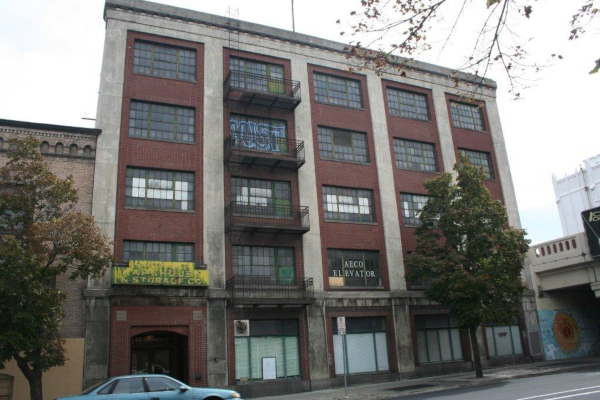
PhotoTitle: McClintock-Trunkey Annex Building
PhotoAttribution: Spokane Historic Preservation Office
Listing Status: Spokane Register
URL: http://properties.historicspokane.org/property/?PropertyID=2127
Display Marker: large_yellow
Title: McClintock-Trunkey Annex Building
Description: The McClintock-Trunkey Annex Building, at 125 N. Stevens Street, constitutes the remaining portion of a complex of buildings constructed between 1907 and 1917. The Annex occupies the southwest corner of the former complex. It is a 5-story building with concrete superstructure and brick infill that was built to service the elevated railroad viaduct. It is characterized by massive concrete columns that support the weight above them. The windows of the front (west) elevation are symmetrically placed and contain metal sash panes of fixed and casement glass, with vinyl muntins within the double glass panes. The style is a cross between brick commercial and concrete bunker.
Location: 125 S. Stevens Street, Spokane, WA
Address: 125 S. Stevens Street, Spokane, WA
PhotoURL:

PhotoTitle: McClintock-Trunkey Annex Building
PhotoAttribution: Spokane Historic Preservation Office
Listing Status: Spokane Register
URL: http://properties.historicspokane.org/property/?PropertyID=2127
Display Marker: large_yellow
ID: 437
Title: Coeur d’Alene Park
Description: Coeur d’Alene Park is an eleven acre park comprised of four residential blocks and, according to original plat maps, measures 675 feet on its north and south sides, and 630 feet on its east and west sides. The park is located within the Browne’s Addition Neighborhood and the Browne's Addition Historic District. The park’s topography is relatively flat and surrounded by residential development (including single-family homes and multifamily apartment buildings), a church, and a few commercial enterprises in adaptively reused historic-period homes.Contributing resources include two stone urns (ca. 1893), one granite and one Tenino sandstone, that were featured in the Washington State art exhibit of the 1893 Chicago World’s Fair; a reconstruction of the original band pavilion (ca. 1891, 2013), designed with original plans; and a restroom building (1948) and drinking fountain (1948), both constructed in the distinctive blind-mortared, native basalt rubble rock style common to City of Spokane parks.
Location: 2111 W. Second Avenue, Spokane, WA
Address: 2111 W. Second Avenue, Spokane, WA
PhotoURL: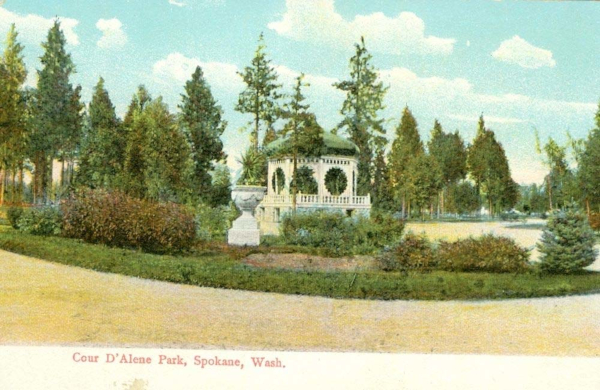
PhotoTitle: Coeur d’Alene Park
PhotoAttribution: Spokane Historic Preservation Office
Listing Status: National Register
URL: http://properties.historicspokane.org/property/?PropertyID=2128
Display Marker: large_yellow
Title: Coeur d’Alene Park
Description: Coeur d’Alene Park is an eleven acre park comprised of four residential blocks and, according to original plat maps, measures 675 feet on its north and south sides, and 630 feet on its east and west sides. The park is located within the Browne’s Addition Neighborhood and the Browne's Addition Historic District. The park’s topography is relatively flat and surrounded by residential development (including single-family homes and multifamily apartment buildings), a church, and a few commercial enterprises in adaptively reused historic-period homes.Contributing resources include two stone urns (ca. 1893), one granite and one Tenino sandstone, that were featured in the Washington State art exhibit of the 1893 Chicago World’s Fair; a reconstruction of the original band pavilion (ca. 1891, 2013), designed with original plans; and a restroom building (1948) and drinking fountain (1948), both constructed in the distinctive blind-mortared, native basalt rubble rock style common to City of Spokane parks.
Location: 2111 W. Second Avenue, Spokane, WA
Address: 2111 W. Second Avenue, Spokane, WA
PhotoURL:

PhotoTitle: Coeur d’Alene Park
PhotoAttribution: Spokane Historic Preservation Office
Listing Status: National Register
URL: http://properties.historicspokane.org/property/?PropertyID=2128
Display Marker: large_yellow
ID: 438
Title: Mount Spokane Vista House
Description: The Vista House sits at the summit of Mount Spokane within Mount Spokane State Park. The park encompasses nearly 14,000 acres, and is the largest in the Washington State Park system. The summit at this location has an elevation of approximately 5,800 feet and is the highest point in the region. This location provides sweeping views of the surrounding areas, particularly to the east and south. The relatively open landscapes on these sides give distant views, while the views to the north and west sides of the building are partially obscured by the surrounding high alpine forest. The building serves multiple functions for the visiting public. At the exterior, the building features an integrated terrace on the east side to provide a defined space for taking in the magnificent views. The large east side terrace continues around the perimeter of the building in the form of a wide sidewalk. At the interior, there are four main areas: the public gathering room, the former store room, toilet rooms, and a former fire lookout room on the upper floor.
Location: 26107 N. Mt. Spokane Park Drive, Spokane, WA
Address: 26107 N. Mt. Spokane Park Drive, Spokane, WA
PhotoURL: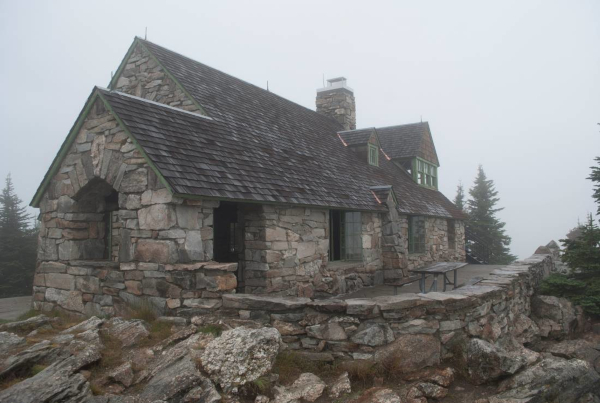
PhotoTitle: Mount Spokane Vista House
PhotoAttribution: Spokane Historic Preservation Office
Listing Status: National Register
URL: http://properties.historicspokane.org/property/?PropertyID=2129
Display Marker: large_yellow
Title: Mount Spokane Vista House
Description: The Vista House sits at the summit of Mount Spokane within Mount Spokane State Park. The park encompasses nearly 14,000 acres, and is the largest in the Washington State Park system. The summit at this location has an elevation of approximately 5,800 feet and is the highest point in the region. This location provides sweeping views of the surrounding areas, particularly to the east and south. The relatively open landscapes on these sides give distant views, while the views to the north and west sides of the building are partially obscured by the surrounding high alpine forest. The building serves multiple functions for the visiting public. At the exterior, the building features an integrated terrace on the east side to provide a defined space for taking in the magnificent views. The large east side terrace continues around the perimeter of the building in the form of a wide sidewalk. At the interior, there are four main areas: the public gathering room, the former store room, toilet rooms, and a former fire lookout room on the upper floor.
Location: 26107 N. Mt. Spokane Park Drive, Spokane, WA
Address: 26107 N. Mt. Spokane Park Drive, Spokane, WA
PhotoURL:

PhotoTitle: Mount Spokane Vista House
PhotoAttribution: Spokane Historic Preservation Office
Listing Status: National Register
URL: http://properties.historicspokane.org/property/?PropertyID=2129
Display Marker: large_yellow
ID: 439
Title: Trade Winds Motel
Description: The Trade Winds Motel is located at 907 W. 3rd Avenue, in central Spokane directly north of the I-90 freeway. It is situated on the southwest corner where W. 3rd intersects S. Lincoln Street. The plan of the 4-story building is a graceful curve, with rows of rooms with balconies which face an inner court. It was designed in 1962 by Donald E. Neraas, a prolific local architect who was noted for his many Mid-Century Modern designs for buildings throughout the Pacific Northwest. The building displays characteristics of the International Style, with its horizontal bands of compartmentalized units. It is significant for its association with the flourishing of Mid-Century Modern architecture experienced in Spokane in the 1950s and 1960s.
Location: 907 W. 3rd Ave
Address: 907 W. 3rd Ave
PhotoURL: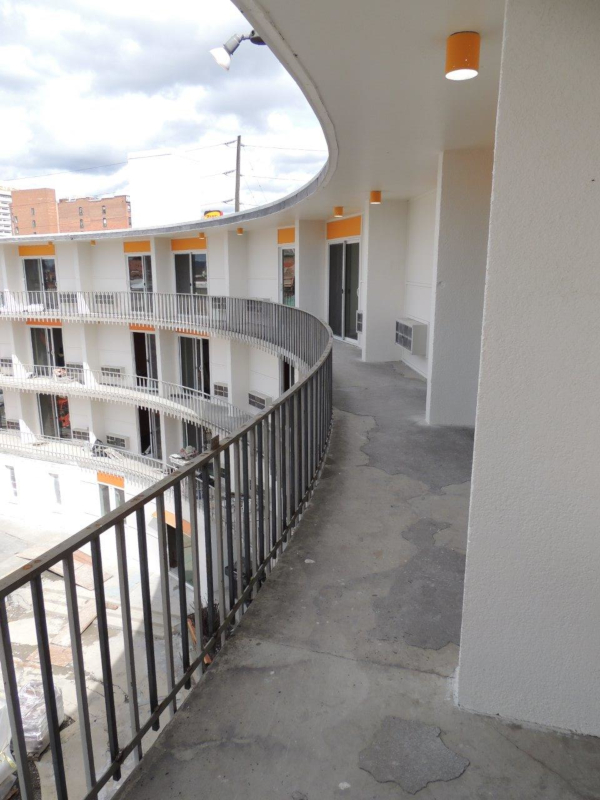
PhotoTitle: Trade Winds Motel
PhotoAttribution: Spokane Historic Preservation Office
Listing Status: Spokane Register
URL: http://properties.historicspokane.org/property/?PropertyID=2130
Display Marker: large_yellow
Title: Trade Winds Motel
Description: The Trade Winds Motel is located at 907 W. 3rd Avenue, in central Spokane directly north of the I-90 freeway. It is situated on the southwest corner where W. 3rd intersects S. Lincoln Street. The plan of the 4-story building is a graceful curve, with rows of rooms with balconies which face an inner court. It was designed in 1962 by Donald E. Neraas, a prolific local architect who was noted for his many Mid-Century Modern designs for buildings throughout the Pacific Northwest. The building displays characteristics of the International Style, with its horizontal bands of compartmentalized units. It is significant for its association with the flourishing of Mid-Century Modern architecture experienced in Spokane in the 1950s and 1960s.
Location: 907 W. 3rd Ave
Address: 907 W. 3rd Ave
PhotoURL:

PhotoTitle: Trade Winds Motel
PhotoAttribution: Spokane Historic Preservation Office
Listing Status: Spokane Register
URL: http://properties.historicspokane.org/property/?PropertyID=2130
Display Marker: large_yellow
ID: 389
Title: The Spokane Ponderosa
Description: Species: Ponderosa Pine
Smelling of vanilla and growing nearly 200 feet tall, the Ponderosa Pine has become a local icon and is, in fact, the official tree of the City of Spokane. This towering Ponderosa is found in the Browne's Addition Historic District and is the largest in the city! **A sad update on the Spokane Ponderosa** - a strong rain and subsequent windstorm loosened the tree's roots so much that it fell and was lost on 5/19/19.
Location: 47.654660, -117.443045
Address: 2028 West 2nd Avenue, Spokane WA 99201
PhotoURL:
PhotoTitle: Ponderosa Pine
PhotoAttribution: City of Spokane Parks and Recreation
Listing Status: Spokane Heritage Tree Register
URL: https://my.spokanecity.org/urbanforestry/programs/heritage-tree/
Display Marker: large_green
Title: The Spokane Ponderosa
Description: Species: Ponderosa Pine
Smelling of vanilla and growing nearly 200 feet tall, the Ponderosa Pine has become a local icon and is, in fact, the official tree of the City of Spokane. This towering Ponderosa is found in the Browne's Addition Historic District and is the largest in the city! **A sad update on the Spokane Ponderosa** - a strong rain and subsequent windstorm loosened the tree's roots so much that it fell and was lost on 5/19/19.
Location: 47.654660, -117.443045
Address: 2028 West 2nd Avenue, Spokane WA 99201
PhotoURL:

PhotoTitle: Ponderosa Pine
PhotoAttribution: City of Spokane Parks and Recreation
Listing Status: Spokane Heritage Tree Register
URL: https://my.spokanecity.org/urbanforestry/programs/heritage-tree/
Display Marker: large_green